Palm 830 PDA W/ WiFi and Bluetooth Capabilities User Manual User Guide for the LifeDrive Mobile Manager
Palm Inc PDA W/ WiFi and Bluetooth Capabilities User Guide for the LifeDrive Mobile Manager
Palm >
Contents
- 1. User Manual 1 of 2
- 2. User Manual 2 of 2
- 3. Users Manual 1 of 2
- 4. Users Manual 2 of 2
Users Manual 1 of 2

FPO
User Guide
for the
LifeDrive™ Mobile
Manager
SECOND DRAFT palmOne, Inc. Confidential

LifeDrive from palmOne ii
Copyright and Trademark
© 2005 palmOne, Inc. All rights reserved.
palmOne, Addit, Blazer, Graffiti, HotSync, LifeDrive, Palm, Palm Powered, Palm OS, the Palm logo, and
VersaMail are among the trademarks or registered trademarks owned by or licensed to palmOne, Inc. All
other brand and product names are or may be trademarks of, and are used to identify products or services of,
their respective owners.
palmOne, Inc. uses the Bluetooth wireless technology trademark under express license from Bluetooth SIG,
Inc. and uses the Wi-Fi wireless technology trademark under express license from the Wi-Fi Alliance. Pocket
Tunes is a trademark of NormSoft, Inc. MPEG Layer-3 audio decoding technology is licensed from Fraunhofer
IIS and Thomson. This product is licensed under the MPEG-4 systems patent portfolio license for encoding in
compliance with the MPEG-4 systems standard, except that an additional license and payment of royalties
are necessary for encoding in connection with (i) data stored or replicated in physical media which is paid for
on a title-by-title basis and/or (ii) data which is paid for on a title-by-title basis and is transmitted to an end
user for permanent storage and/or use. Such additional license may be obtained from MPEG, LLC. See
www.mpegla.com for additional details. This product includes technology owned by Microsoft Corporation
and cannot be used or distributed without a license from Microsoft Licensing, GP.
Disclaimer and Limitation of Liability
palmOne, Inc. assumes no responsibility for any damage or loss resulting from the use of this guide.
palmOne, Inc. assumes no responsibility for any loss or claims by third parties which may arise through the
use of this software. palmOne, Inc. assumes no responsibility for any damage or loss caused by deletion of
data as a result of malfunction, dead battery, or repairs. Be sure to make backup copies of all important data
on other media to protect against data loss.
Please read the End User Software License Agreement with this product before using the
accompanying software program(s). Using any part of the software indicates that you accept the terms of the
End User Software License Agreement.
Software Download Available
Palm®Desktop software is supplied on a CD. If you do not have access to a CD drive for your computer, you
can download Palm Desktop software from www.palmOne.com/lifedrive-userguide/
IMPORTANT
[!]
SECOND DRAFT palmOne, Inc. Confidential

LifeDrive from palmOne iii
Table of Contents
About This Guide ..................................................................xxi
Tips for viewing this guide.........................................................................xxi
What’s in this guide? .................................................................................xxii
Step-by-step instructions................................................................... xxii
Links..................................................................................................... xxii
Sidebars.....................................................................................................xxiii
Chapter 1: Setting Up Your Device and Your Computer ......1
What’s in the box? ........................................................................................2
System requirements ...................................................................................2
Step 1: Charging your device.......................................................................4
What you should know about your device’s battery.......................... 5
Step 2: Turning on your device for the first time .......................................6
Step 3: Installing your software...................................................................7
Step 4: Connecting your device to your computer ....................................8
Switching to another desktop software application ................................10
Using user profiles......................................................................................11
Creating a user profile .........................................................................12
Synchronizing with a user profile ......................................................14
Related topics..............................................................................................17
Chapter 2: Your Mobile Manager .........................................18
What’s on my device? ................................................................................19
Front ..................................................................................................... 19
Top........................................................................................................ 21
Side....................................................................................................... 22
Back ...................................................................................................... 23
Bottom.................................................................................................. 24
Using the power switch..............................................................................25
Using the status bar....................................................................................26
SECOND DRAFT palmOne, Inc. Confidential

LifeDrive from palmOne iv
Rotating the screen.....................................................................................27
What’s on the screen? ................................................................................28
Input area ............................................................................................. 28
Application controls ............................................................................ 29
What software is on my device?................................................................30
What’s on the CD? ......................................................................................32
Related topics..............................................................................................35
Chapter 3: Moving Around in Applications.........................37
Opening applications..................................................................................38
Using Favorites.................................................................................... 38
Using Applications .............................................................................. 39
Using Files............................................................................................ 40
Working with files and folders ........................................................... 42
Sorting Files ......................................................................................... 44
Opening files and folders from within an application...................... 45
Switching between applications ........................................................ 45
Using the 5-way navigator .........................................................................46
Highlighting items ............................................................................... 47
Moving around in Favorites View ...................................................... 48
Moving around in Applications View ................................................ 48
Moving around in list screens ............................................................ 49
Moving around in entry screens ........................................................ 50
Moving around in dialog boxes ......................................................... 50
Moving around in menus ................................................................... 51
Using menus ..............................................................................................52
Using the Command stroke................................................................ 53
Using the Command toolbar .............................................................. 53
Finding information ...................................................................................54
Related topics..............................................................................................55
Chapter 4: Entering Information on Your Device ................56
How can I enter information on my device?.............................................57
Entering information with Graffiti 2 writing .............................................57
Writing in the Graffiti 2 input area ..................................................... 57
SECOND DRAFT palmOne, Inc. Confidential

LifeDrive from palmOne v
Using full-screen writing..................................................................... 58
Writing Graffiti 2 characters ...............................................................60
Graffiti 2 alphabet................................................................................ 62
Graffiti 2 numbers ............................................................................... 63
Graffiti 2 gestures................................................................................ 67
Writing Graffiti 2 symbols and other special characters ..................68
Graffiti 2 symbols and special characters ......................................... 69
Writing Graffiti 2 ShortCuts ................................................................70
Graffiti 2 ShortCuts.............................................................................. 71
Entering information with the onscreen keyboard ..................................72
Entering info from Contacts into another application .............................74
Editing information.....................................................................................76
Selecting information.......................................................................... 76
Copying and pasting information ......................................................77
Deleting information ...........................................................................78
Related topics..............................................................................................79
Chapter 5: Moving and Managing Info Between
Your Device and Your Computer ...........................................80
Program memory and the hard drive .......................................................81
How can I work with information? ............................................................82
LifeDrive Manager and Drive Mode ..........................................................83
LifeDrive Manager ............................................................................... 83
Drive Mode........................................................................................... 83
Using LifeDrive Manager ...........................................................................84
Transferring information using the LifeDrive Manager icon ...........85
Transferring information using the LifeDrive Manager window .....88
Renaming a file or folder ....................................................................91
Deleting a file or folder .......................................................................92
Deleting sync items from your computer when they are
deleted from your device .............................................................93
Using Drive Mode ......................................................................................94
Synchronizing information ........................................................................98
Doing a full sync ..................................................................................98
Synchronizing using the cable .........................................................100
SECOND DRAFT palmOne, Inc. Confidential

LifeDrive from palmOne vi
Synchronizing using LifeDrive Manager ......................................... 101
Creating sync items ...........................................................................101
Doing a folder sync ...........................................................................102
Locating sync items on your computer ........................................... 103
Entering information using desktop software ................................ 104
Customizing your synchronization settings .................................... 107
Choosing how your computer responds to
synchronization requests ...........................................................108
Setting synchronization options ......................................................110
Choosing whether application information is updated ..................111
Installing applications to your device .............................................. 116
Using Quick Install .............................................................................117
Installing applications from a Mac computer ................................. 118
Using the Send To Handheld droplet .............................................. 118
Using commands in the HotSync menu ..........................................119
Other ways of managing information.....................................................120
Importing information from other applications.............................. 121
Restoring archived items on your computer .................................. 123
Installing the additional software from the CD ............................... 124
Checking space and version numbers .............................................125
Removing information .............................................................................127
Removing an application from your device .................................... 127
Removing Palm Desktop software from your computer ............... 128
Related topics............................................................................................130
Chapter 6: Managing Your Contacts ..................................131
Adding a contact ......................................................................................132
Entering additional contact information ..........................................135
Selecting contact field types .............................................................136
Defining custom fields ......................................................................137
Selecting a contact as your business card ......................................138
Copying contact information into multiple contacts ............................139
Locating a contact on your list ................................................................140
Deleting a contact ....................................................................................141
Customizing the Contacts list .................................................................142
SECOND DRAFT palmOne, Inc. Confidential

LifeDrive from palmOne vii
Making connections from Contacts.........................................................144
Using Quick Connect .........................................................................144
Customizing Quick Connect settings ...............................................146
Using Tap-to-Connect .......................................................................147
Working with Contacts on your computer..............................................149
Related topics............................................................................................150
Chapter 7: Managing Your Calendar ..................................151
Scheduling events ....................................................................................152
Scheduling an appointment .............................................................152
Scheduling an event without a start time .......................................154
Scheduling a repeating event—standard interval ..........................156
Scheduling a repeating event—unusual interval ............................157
Scheduling an event that is longer than a day ...............................159
Entering a location or a note for an event .......................................160
Scheduling an event with a time zone .............................................161
Color-coding your schedule.....................................................................163
Managing your color-codes ..............................................................163
Assigning a color-code to an event .................................................165
Setting an alarm .......................................................................................166
Rescheduling an event ............................................................................167
Deleting events .........................................................................................169
Deleting a specific event ...................................................................169
Deleting all your old events ..............................................................171
Checking your schedule ...........................................................................172
Viewing your appointments and tasks together .............................172
Viewing your daily schedule ............................................................174
Viewing your weekly schedule .........................................................176
Viewing your monthly schedule ......................................................177
Viewing a yearly calendar .................................................................178
Finding events that overlap .............................................................. 179
Customizing your calendar ......................................................................179
Customizing display options for your calendar ..............................180
Setting alarm and time options ........................................................183
Working with Calendar on your computer .............................................185
Related topics............................................................................................186
SECOND DRAFT palmOne, Inc. Confidential

LifeDrive from palmOne viii
Chapter 8: Your Microsoft Office File Manager .................187
Creating and managing Office files.........................................................188
Opening files from within Documents ....................................................189
Related Topics...........................................................................................190
Chapter 9: Viewing Your Photos and Videos ....................191
Reformatting files and copying supported file types.............................192
Viewing photos or videos .......................................................................193
Viewing a slide show ........................................................................ 200
Rotating a photo ................................................................................ 202
Viewing and editing photo or video details............................................204
Organizing photos and videos.................................................................207
Organizing photos or videos into albums .......................................207
Moving a photo or video within and between albums ..................209
Sorting photos and videos ............................................................... 211
Personalizing a photo ...............................................................................212
Drawing on a photo ...........................................................................212
Adding audio to a photo ...................................................................214
Copying a photo or video ........................................................................215
Deleting a photo or video ........................................................................216
Sharing photos and videos ......................................................................217
Related topics............................................................................................218
Chapter 10: Managing Your Camera Card Media..............219
Copying photos and videos from your camera card ............................220
Viewing photos or videos ......................................................................222
Related topics............................................................................................223
Chapter 11: Listening to Music...........................................224
Benefits ......................................................................................................224
Transferring music from a CD to your device .......................................230
Transferring music from a CD to your device .......................................232
Managing playlists....................................................................................236
Creating a playlist ..............................................................................236
Playing songs from a playlist ...........................................................238
SECOND DRAFT palmOne, Inc. Confidential

LifeDrive from palmOne ix
Editing a playlist ................................................................................239
Deleting a playlist ..............................................................................241
Customizing your player ..........................................................................242
Turning off the screen .......................................................................242
Setting background preferences ......................................................243
Flashing the LED when the pTunes console is turned off ..............244
Working with Windows Media Player on your computer .....................245
Related topics............................................................................................246
Chapter 12: Managing Your Tasks ......................................247
Creating a task ..........................................................................................248
Setting an alarm ................................................................................249
Scheduling a repeating task—standard interval .............................250
Scheduling a repeating task—unusual interval ..............................252
Organizing your tasks ..............................................................................254
Marking a task complete .........................................................................255
Deleting tasks ...........................................................................................256
Deleting a specific task ......................................................................256
Deleting all your completed tasks ....................................................257
Customizing your Tasks list ....................................................................258
Working with Tasks on your computer...................................................260
Related topics............................................................................................261
Chapter 13: Writing Memos................................................262
Creating a memo .....................................................................................263
Viewing and editing a memo ..................................................................264
Moving memos in your memos list .......................................................265
Deleting a memo ......................................................................................266
Working with Memos on your computer................................................267
Related topics............................................................................................268
Chapter 14: Writing Notes in Note Pad..............................269
Creating a note .........................................................................................270
Choosing the pen and paper (background) colors .........................271
Setting an alarm ................................................................................272
SECOND DRAFT palmOne, Inc. Confidential

LifeDrive from palmOne x
Viewing and editing a note .....................................................................274
Deleting a note .........................................................................................275
Working with Note Pad on your computer.............................................276
Related topics............................................................................................277
Chapter 15: Recording Voice Memos.................................278
Creating a voice memo ...........................................................................279
Creating a quick voice memo using the application button ..........279
Creating a longer voice memo using the pause control ................280
Listening to a voice memo ......................................................................283
Setting an alarm for a voice memo ........................................................285
Saving a voice memo to an expansion card .........................................287
Saving a specific memo to an expansion card ...............................287
Automatically storing all voice memos on an expansion card .....288
Related topics............................................................................................289
Chapter 16: Making Wi-Fi Wireless Connections..............290
What can I do with the built-in Wi-Fi wireless technology? ..................291
What types of connections can I make?..................................................291
Wi-Fi signal strength indicator.................................................................292
Setting up a Wi-Fi network connection ..................................................293
Accessing email and the web with Wi-Fi ...............................................299
Setting up a Wi-Fi device-to-device network .........................................301
Related topics............................................................................................307
Chapter 17: Making Bluetooth Wireless Connections .....308
What can I do with the built-in Bluetooth wireless technology? ..........309
What types of connections can I make? .......................................... 309
What is device discovery? ................................................................ 310
Entering basic Bluetooth settings ...........................................................311
Setting up a Bluetooth phone connection .............................................312
Accessing email and the web with Bluetooth .......................................317
Setting up a connection for Bluetooth synchronization .......................319
Setting up a connection to a network ....................................................324
Creating trusted devices ..........................................................................326
SECOND DRAFT palmOne, Inc. Confidential

LifeDrive from palmOne xi
Setting advanced Bluetooth features .....................................................328
Storing recently found device names ..............................................328
Allowing your device to wake up when it is turned off ..................329
Related topics............................................................................................330
Chapter 18: Sending and Receiving Email Messages ......331
Upgrading an existing email account ....................................................332
About email accounts...............................................................................333
Using an email provider ................................................................... 333
Using a corporate email account ..................................................... 334
VPNs ................................................................................................... 335
Connecting to a VPN .........................................................................336
Creating an account..................................................................................337
Transferring settings from an existing account ..............................338
Setting up an account on your computer: Common providers .....340
Setting up an account on your computer: Other providers ...........343
Entering advanced account settings on your computer ................346
Setting up an account on your device .............................................351
Setting advanced mail options on your device ..............................354
Testing your new account ................................................................ 355
Editing an account............................................................................. 356
Editing an account on your computer .............................................356
Editing an account on your device ...................................................357
Deleting an account ...........................................................................358
Adding ESMTP to an account ...........................................................359
Getting and reading messages................................................................360
Auto Sync with notification .............................................................. 361
Scheduling Auto Sync .......................................................................361
Auto Sync notifications..................................................................... 363
Setting alert options ..........................................................................364
Viewing and using the Reminders screen....................................... 365
Auto Sync retries ............................................................................... 366
Resource issues with Auto Sync ...................................................... 366
Inbox icons in the VersaMail application ........................................ 367
Setting preferences for getting messages ......................................367
SECOND DRAFT palmOne, Inc. Confidential

LifeDrive from palmOne xii
Reading email messages .................................................................. 370
Adding or updating a contact directly from a message................. 371
Sending an email message......................................................................372
Entering an address using Smart Addressing ................................374
Entering an address directly in the To field ....................................375
Entering an address using Contacts ................................................376
Attaching a personal signature ........................................................377
Send retry ...........................................................................................378
Send retry notifications..................................................................... 378
Modifying messages in the Outbox................................................. 379
Outbox icons in the VersaMail applications.................................... 379
Working with email folders......................................................................380
Viewing another folder .....................................................................380
Customizing the appearance of the message list ...........................381
Moving messages between folders ................................................383
Creating and editing mail folders .....................................................385
Working with email messages ................................................................386
Forwarding an email message .........................................................386
Replying to an email message .........................................................387
Setting reply preferences ..................................................................388
Working with URLs, email addresses, and phone numbers in a
message....................................................................................... 390
Deleting a message ...........................................................................390
Deleting old messages ......................................................................391
Emptying the trash ............................................................................393
Setting the trash to be emptied automatically ................................394
Marking messages as read or unread .............................................395
Working with attachments .......................................................................396
Working with a downloaded attachment ........................................397
Saving attachments ...........................................................................400
Attaching files to outgoing messages .............................................401
Advanced VersaMail application features ..............................................403
Creating and using filters.................................................................. 403
Turning filters on and off ..................................................................406
Editing or deleting a filter .................................................................408
SECOND DRAFT palmOne, Inc. Confidential

LifeDrive from palmOne xiii
Setting connection preferences .......................................................409
Setting server preferences ................................................................410
Changing email header details......................................................... 412
Synchronizing IMAP mail folders wirelessly................................... 413
Prerequisites for wireless IMAP folder synchronization ................ 414
Turning IMAP folder synchronization on or off ..............................414
Synchronizing device and mail server IMAP folders from the
Options menu ..............................................................................415
Working with root folders................................................................. 415
Using Secure Sockets Layer (SSL)................................................... 415
Working with Microsoft Exchange ActiveSync® ...................................416
What do I need to use Microsoft Exchange ActiveSync?............... 416
How does a Microsoft Exchange ActiveSync email account differ
from other accounts?.................................................................. 417
Setting up a Microsoft Exchange ActiveSync account................... 417
Setting up a Microsoft Exchange ActiveSync account on your
computer .....................................................................................418
Setting up an account on your device .............................................421
Setting advanced mail options on your device ..............................424
Getting email messages ................................................................... 425
Previewing attachments ................................................................... 427
Working with meeting invitations ....................................................427
Working with Calendar events ......................................................... 430
Synchronizing Calendar events using Microsoft Exchange
ActiveSync................................................................................... 431
Updating Calendar events when you delete a Microsoft Exchange
ActiveSync account .................................................................... 431
Related topics............................................................................................432
Chapter 19: Sending and Receiving Text Messages.........433
Creating and sending a text message ....................................................434
Receiving and viewing a text message ..................................................437
Editing a draft text message ...................................................................439
Setting advanced messaging features ...................................................440
Related Topics...........................................................................................442
SECOND DRAFT palmOne, Inc. Confidential

LifeDrive from palmOne xiv
Chapter 20: Browsing the Web...........................................443
Accessing a web page ..............................................................................444
Accessing a web page using the action bar ....................................444
Accessing a web page using the address field ...............................445
Using a password to access a web page .........................................446
Finding information on a web page .................................................447
Quickly jumping to a page .......................................................................448
Following a link.................................................................................. 448
Returning to your home page or a page you recently visited ....... 448
Changing how you view a page .............................................................449
Bookmarking your favorite pages ...........................................................451
Adding a bookmark ...........................................................................451
Viewing a bookmarked or saved page ............................................452
Editing information about a bookmark or saved page ...................453
Arranging the bookmark list .............................................................454
Disconnecting from and connecting to the Internet ..............................455
Disconnecting from the Internet ......................................................455
Connecting to the Internet ................................................................456
Downloading files and pages ..................................................................457
Downloading a file ............................................................................457
Saving a web page ............................................................................458
Viewing a saved file ..........................................................................459
Communicating with other users ............................................................460
Sending email by means of an Internet email account ..................460
Returning to a web page you recently visited .......................................461
Changing your home and start pages.....................................................462
Changing your home page ...............................................................462
Changing your start page .................................................................464
Setting advanced browser options .........................................................465
Changing how images are downloaded ..........................................465
Setting whether to automatically complete web addresses and
form fields ...................................................................................466
Allowing websites to remember personal information .................467
Setting preferences for storing web pages .....................................468
Setting preferences for using a proxy server ..................................470
SECOND DRAFT palmOne, Inc. Confidential

LifeDrive from palmOne xv
Setting whether to accept JavaScript ..............................................472
Related topics............................................................................................473
Chapter 21: Dialing Phone Numbers from Your Device ...474
Dialing a number .....................................................................................475
Entering a number .............................................................................475
Redialing the most recently used number ......................................476
Dialing a number from the Call History List ....................................477
Using speed dial ......................................................................................478
Adding a speed-dial entry .................................................................478
Dialing a number using speed dial ..................................................479
Editing a speed-dial entry .................................................................480
Related topics............................................................................................481
Chapter 22: Sharing Information........................................482
Using the Send command ......................................................................483
Sending information from within an application using Bluetooth
technology ...................................................................................483
Sending a category using Bluetooth technology ...........................485
Sending an application using Bluetooth technology .....................486
Using the Send command with the VersaMail® application ......... 487
Using the Send command with SMS .............................................. 487
Beaming ....................................................................................................488
Beaming information from within an application ..........................488
Beaming a category ..........................................................................490
Beaming an application ....................................................................491
Other ways of sharing information .........................................................492
Related topics............................................................................................493
Chapter 23: Managing Your Expenses ...............................494
Adding an expense ...................................................................................495
Choosing currency options ......................................................................497
Customizing the currency pick list ...................................................497
Presetting the currency symbol .......................................................498
Creating a currency symbol ..............................................................499
SECOND DRAFT palmOne, Inc. Confidential

LifeDrive from palmOne xvi
Deleting expenses.....................................................................................501
Deleting an individual expense ........................................................501
Deleting an entire category of expenses .........................................502
Customizing the expense list ...................................................................503
Working with Expense on your computer ..............................................504
Related topics............................................................................................505
Chapter 24: Performing Calculations .................................506
Calculator buttons.....................................................................................507
Viewing recent calculations ....................................................................508
Accessing different calculators ...............................................................509
Related topics............................................................................................510
Chapter 25: Keeping Your Information Private.................. 511
Choosing a security level .........................................................................512
Marking information as private ...............................................................513
Setting the level of privacy ......................................................................514
Hiding or masking private entries ....................................................514
Viewing an entry that is masked ...................................................... 515
Using a password .....................................................................................515
Creating a password .........................................................................516
Changing a password .......................................................................517
Deleting a password.......................................................................... 519
Deleting a forgotten password .........................................................520
Locking your device..................................................................................522
Locking your device automatically ..................................................522
Locking your device manually ..........................................................524
Using Quick Unlock ..................................................................................525
Creating a Quick Unlock combination ............................................. 525
Deleting your Quick Unlock combination........................................ 527
Encrypting your information....................................................................528
Limiting the number of password attempts ...........................................530
Related topics............................................................................................533
SECOND DRAFT palmOne, Inc. Confidential

LifeDrive from palmOne xvii
Chapter 26: Using Categories to Organize Information ...534
Adding a category.....................................................................................535
Renaming a category ...............................................................................536
Deleting a category ..................................................................................537
Placing information in a category ...........................................................538
Placing an entry in a category ..........................................................538
Placing an application in a category ................................................540
Viewing information by category ...........................................................541
Related topics............................................................................................542
Chapter 27: Managing Clock Settings ...............................543
Checking the current date and time ........................................................544
Setting the primary location ....................................................................544
Setting the date and time for the primary location ........................545
Choosing secondary locations for other time zones .............................547
Modifying the locations list......................................................................548
Adding new locations .......................................................................548
Deleting a location .............................................................................550
Setting the alarm clock.............................................................................551
Responding to the alarm clock......................................................... 552
Changing the clock display ......................................................................553
Related topics............................................................................................554
Chapter 28: Customizing Your Device ...............................555
Customizing Favorites View ....................................................................556
Changing the background photo in Favorites View .......................556
Changing entries in Favorites ...........................................................557
Customizing Applications View ..............................................................559
Making the screen easier to read ............................................................561
Changing the screen fonts ................................................................561
Adjusting the brightness ...................................................................563
Changing screen colors ....................................................................564
Changing handedness orientation of the screen ............................565
Assigning a button to your frequently used applications ....................566
Setting the date and time ........................................................................568
SECOND DRAFT palmOne, Inc. Confidential

LifeDrive from palmOne xviii
Selecting a location ...........................................................................568
Resetting the date and time ..............................................................570
Selecting formats for dates, times, and numbers ..........................572
Customizing the way you enter information ..........................................574
Customizing the input area ...............................................................574
Customizing Graffiti 2 strokes ..........................................................575
Setting up ShortCuts .........................................................................577
Changing ShortCuts ..........................................................................579
Correcting problems with tapping ...................................................580
Selecting sound settings .........................................................................581
Entering your owner information ...........................................................582
Conserving battery power .......................................................................583
Selecting power-saving settings ......................................................583
Connecting your device to other devices ...............................................585
Changing the preset connection settings ........................................585
Creating your own connection settings ...........................................587
Connecting your device to a mobile phone ....................................590
Customizing network settings .................................................................591
Setting up a service profile ...............................................................591
Connecting to your service ...............................................................594
Adding details to a service profile ...................................................595
Deleting a service profile ..................................................................597
Creating login scripts ........................................................................598
Adding plug-in applications .............................................................601
Setting up a VPN.......................................................................................602
Setting up a VPN account on your device .......................................602
Establishing a VPN connection ........................................................604
Ending a VPN connection .................................................................605
Related topics............................................................................................606
Chapter 29: Expanding Your Device...................................607
What type of expansion cards can I use? ...............................................608
How can expansion cards help me?........................................................608
Removing an expansion card .................................................................609
Inserting an expansion card ....................................................................610
SECOND DRAFT palmOne, Inc. Confidential

LifeDrive from palmOne xix
Opening an application on an expansion card ......................................611
Opening files on an expansion card .......................................................612
Viewing card information.........................................................................613
Renaming a card ......................................................................................614
Copying applications to an expansion card ..........................................615
Removing all information from a card ...................................................616
Related topics............................................................................................617
Chapter 30: Maintaining Your Device ...............................618
Device do’s and don’ts .............................................................................618
Device do’s......................................................................................... 618
Device don’ts ..................................................................................... 619
Resetting your device ...............................................................................620
Doing a soft reset .............................................................................. 620
Doing a hard reset ............................................................................. 621
Restoring your information after a hard reset........................................622
Related topics............................................................................................624
Chapter 31: Common Questions .......................................625
Setup..........................................................................................................625
Device ........................................................................................................627
Moving around..........................................................................................630
Entering information ................................................................................631
Synchronizing ...........................................................................................633
LifeDrive Manager/Drive Mode................................................................639
Calendar.....................................................................................................641
Memos .......................................................................................................642
Note Pad ....................................................................................................643
Media .........................................................................................................643
Pocket Tunes™..........................................................................................644
Tasks ..........................................................................................................644
Connecting wirelessly ..............................................................................645
The VersaMail® application.....................................................................647
Privacy .......................................................................................................650
Sharing ......................................................................................................651
Problems with incompatible applications ..............................................653
SECOND DRAFT palmOne, Inc. Confidential

LifeDrive from palmOne xx
Chapter 32: Getting Help ...................................................656
Self-help resources ...................................................................................656
Technical support .....................................................................................657
Product Regulatory Information .........................................658
Index ......................................................................................664
SECOND DRAFT palmOne, Inc. Confidential

LifeDrive from palmOne xxi
About This Guide
This guide tells you everything you need to know about your device: the things
you’ll do every day, the advanced features that let you get the most out of your
device, and the things that make your device not only useful, but fun.
Tips for viewing this guide
Here are some helpful tips for making it easier to read and find information in this guide as you
view it in Adobe Reader:
• To magnify the page, click the magnifying glass , move the cursor (which is now a
magnifying glass) over the page, and click repeatedly. Click Previous View ( or depending
on your version of Reader) to return to the original view.
• Click an entry in the Table of Contents or Index to go directly to that section of the guide.
• If you click a link and go to a page, in the guide click Previous View ( or depending on your
version of Reader) to return to the page you were on before you clicked the link.
• If you click a link and go to a web page, the page may open in Adobe Reader instead of in your
web browser. To specify whether pages open in Reader or in your web browser, go to the Edit
menu in Reader, select Preferences, and then select Web Capture. In the Open Web Links drop-
down list, select either In Acrobat or In Web Browser, and then click OK.
• When selecting the page(s) to print, be sure to use the file page number shown at the bottom of
your computer screen, not the printed page number. For example, to print the first page of
Chapter 2, “Your Mobile Manager,” select page 41 (the file page), not page 18 (the printed page).
SECOND DRAFT palmOne, Inc. Confidential
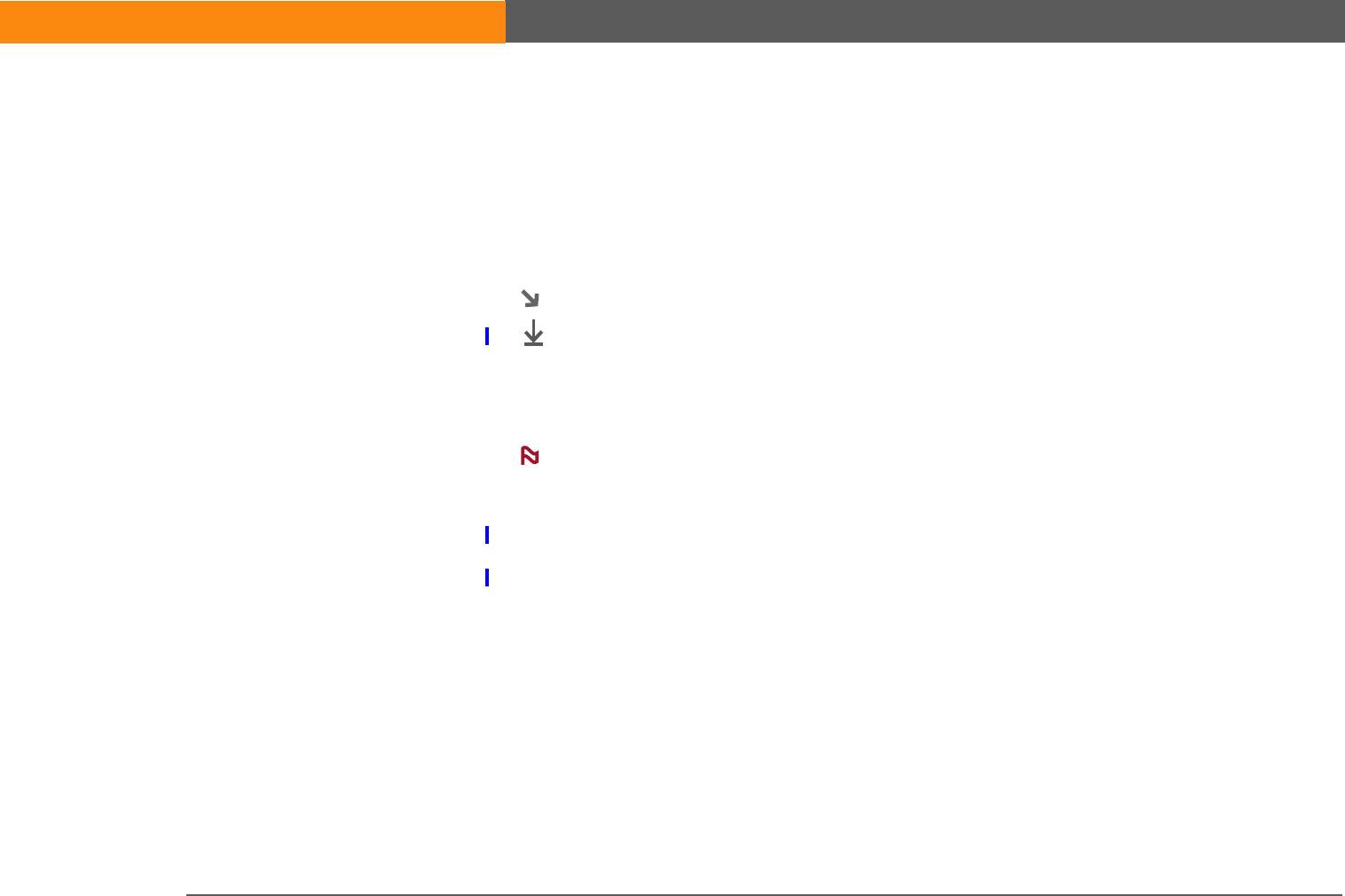
LifeDrive from palmOne xxii
What’s in this guide?
The info in this guide includes step-by-step instructions, links to cross-references, and sidebars.
Step-by-step instructions
Here you’ll find how-to information. Look for these cues in instructions:
Links
Links that appear as underlined words in body text and in sidebars take you to other sections of
this guide. Links also appear in the following sections:
Cue that means the procedure continues on the next page.
Cue that signals the end of the procedure. You’re done.
A step that you must follow; otherwise, you could experience an
error or even lose information.
[ & ] OPTIONAL A step you might find useful.
Information that applies only in certain cases or that tells more about
a procedure step.
WINDOWS ONLY
MAC ONLY
A procedure or text that applies to one platform only. In most cases,
if you see one heading check the following or preceding sections for
the other. Sometimes, there is no Mac counterpart for a Windows
procedure or text; this feature is not available to Mac users.
In this chapter Links on the first page of each chapter that send you to a specific section.
Related topics Links that send you to other topics in this guide to learn about more
things you can do with an application or feature.
Continued
Done
IMPORTANT
[!]
NOTE
SECOND DRAFT palmOne, Inc. Confidential

LifeDrive from palmOne xxiii
Sidebars
Before You Begin
[!]
Things you must complete before you can do the steps described in a procedure or group of
procedures.
Tip
A suggestion on how to use a feature more fully; a shortcut; a pointer to a related feature.
Did You Know?
An interesting fact about the topic being described; may include a link to more information.
»
Key Term
A technical term related to the topic being described. The term may appear in this guide or only
on your device.
Tips & Tricks
A pointer to a website where you can obtain general information about your device and learn
the latest tips, tricks, and more.
Support
A pointer to a website where you can find help if you experience problems with a specific
feature or with your device.
SECOND DRAFT palmOne, Inc. Confidential
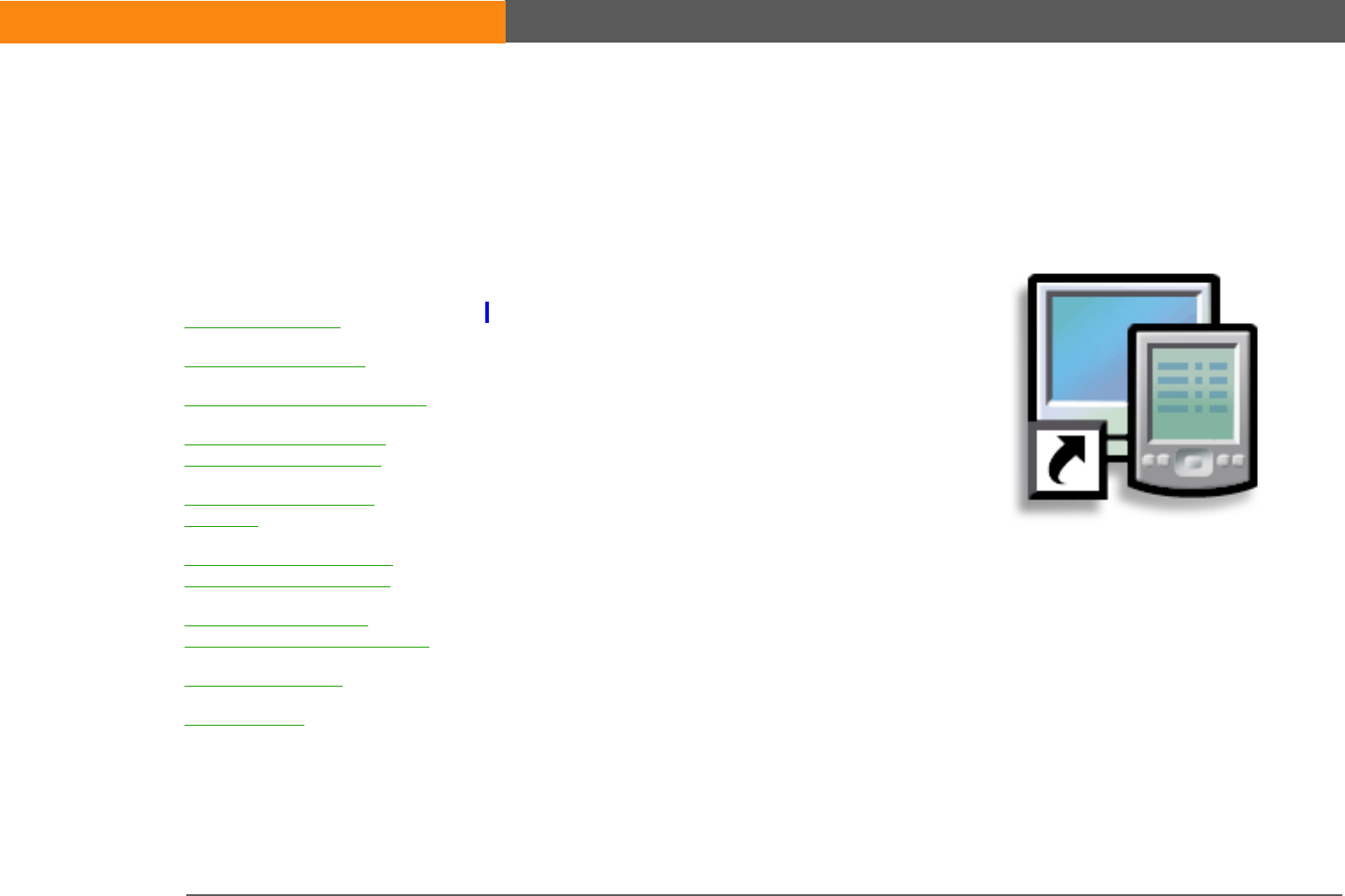
LifeDrive from palmOne 1
CHAPTER 1
Setting Up Your Device and Your Computer
Congratulations on the purchase of
your new LifeDrive™ mobile manager
from palmOne! You’re about to
discover so many things about your
device that will help you better manage
your life and have fun, too. As you
become more familiar with your
device, you’ll probably personalize the
settings and add applications to make
it uniquely yours.
While you’re likely to get years of
enjoyment from your device, it takes
only four easy steps to get up and
running.
Benefits
• Start using your device right away
• Establish a link between your device
and your computer
• Set up your device for optimal use
I
n t
hi
s c
h
apter
What’s in the box?
System requirements
Step 1: Charging your device
Step 2: Turning on your
device for the first time
Step 3: Installing your
software
Step 4: Connecting your
device to your computer
Switching to another
desktop software application
Using user profiles
Related topics
SECOND DRAFT palmOne, Inc. Confidential
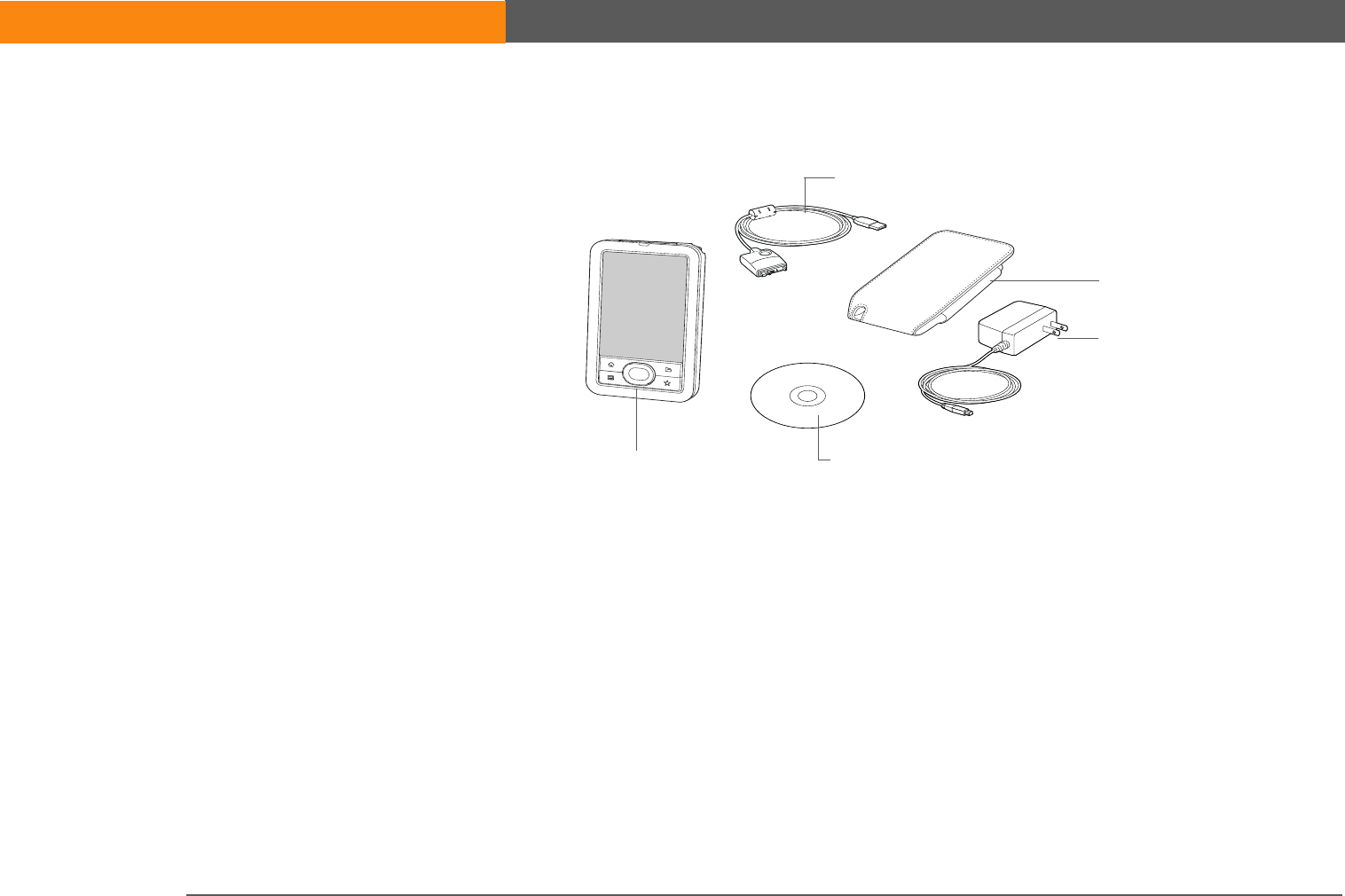
LifeDrive from palmOne 2
CHAPTER 1 Setting Up Your Device and Your Computer
What’s in the box?
System requirements
The installation CD contains Palm®Desktop software and other applications you need to set up
and use your device. To use Palm Desktop software, your desktop computer must meet these
requirements:
WINDOWS ONLY
• A PC with a Pentium II processor or later, and one of the following operating systems:
• Windows 2000 (requires administrator rights to install Palm Desktop software)
• Windows XP (requires administrator rights to install Palm Desktop software)
• Internet Explorer 5.0 or later
• 32 megabyte (MB) available RAM (64MB recommended)
»
Key Term
Palm Desktop software
The software that lets you
enter, update, review, and
synchronize information
on your computer.
AC charger
Software installation CD
USB sync cable
LifeDrive™ from palmOne
Pouch
SECOND DRAFT palmOne, Inc. Confidential

LifeDrive from palmOne 3
CHAPTER 1 Setting Up Your Device and Your Computer
• 170MB available hard disk space
• One available USB port
• USB sync cable (included with your device)
• CD or DVD drive for installing Palm Desktop software from the CD that came with your device
MAC ONLY
• Mac computer or compatible with a PowerPC processor
• Mac OS X, version 10.2 or 10.3 (requires administrator rights to install Palm Desktop software)
• 128MB total RAM
• 190MB available hard disk space
• Monitor that supports screen resolution of 800 X 600 or better
• One available USB port
• USB sync cable (included with your device)
• CD or DVD drive for installing Palm Desktop software from the CD that came with your device
SECOND DRAFT palmOne, Inc. Confidential
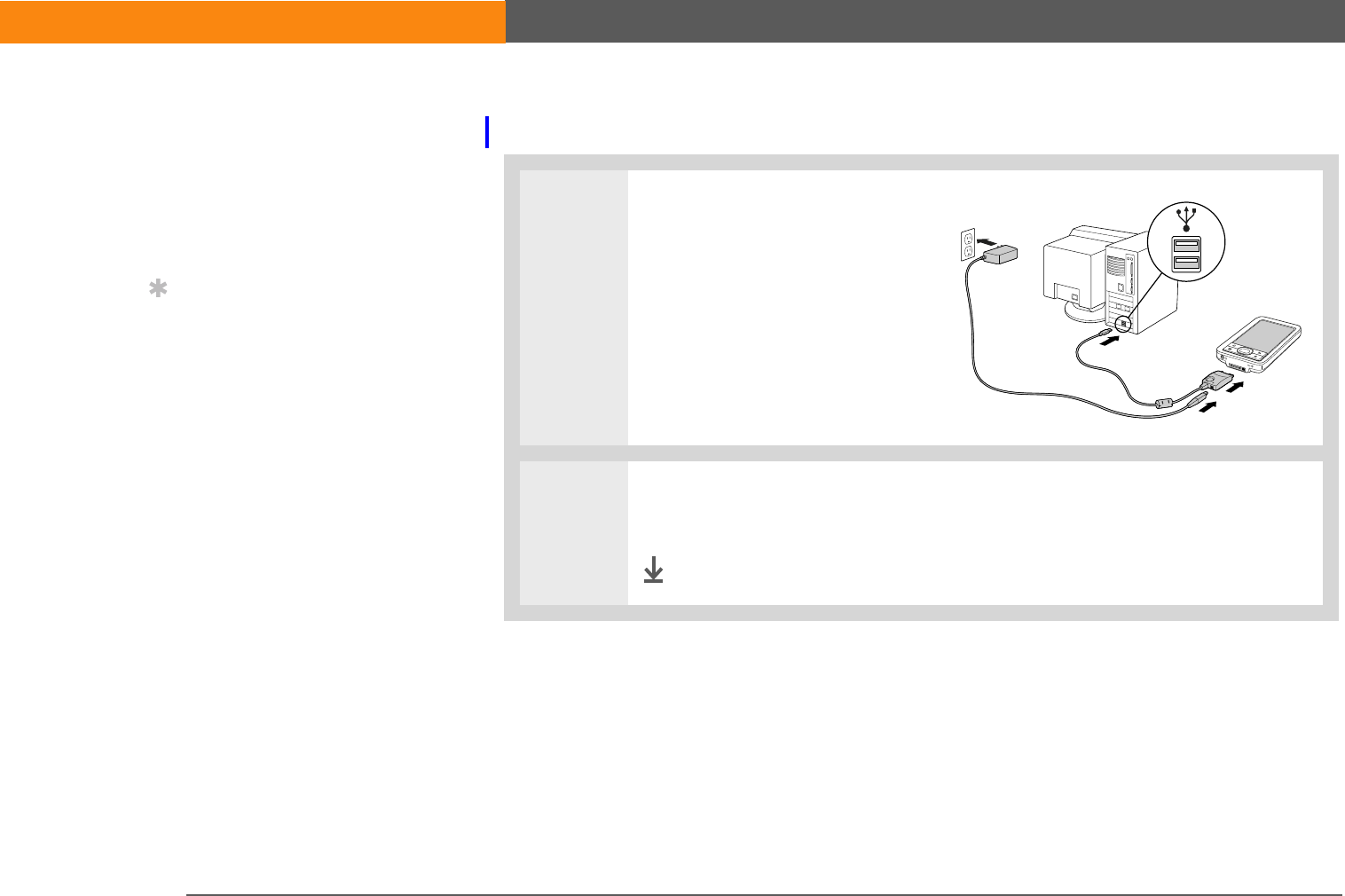
LifeDrive from palmOne 4
CHAPTER 1 Setting Up Your Device and Your Computer
Step 1: Charging your device
0
1Connect your device:
a. Plug the USB sync cable into
your device and into a USB
port on the back of your
computer.
b. Plug the AC charger into the
Multi-connector on the sync
cable and into an outlet.
2Charge your device for three hours. Be sure your device is fully charged before
going on to Step 2.
Done
Before You Begin
[!]
If you’re upgrading from
another Palm Powered™
device, synchronize your
old device with your old
desktop software.
Tip
After the initial charge,
charge your device at
least half an hour every
day.
SECOND DRAFT palmOne, Inc. Confidential

LifeDrive from palmOne 5
CHAPTER 1 Setting Up Your Device and Your Computer
What you should know about your device’s battery
While your device is charging, take a minute to learn about the battery:
• If you see an alert on the screen warning you that the battery is low, recharge your device. Also
recharge your device if it doesn’t turn on when you press the power button.
The memory on your device is designed to store your information even if the battery
becomes drained to the point that you cannot turn on your device. When you recharge your
device, all of your existing information, both in program memory and on the internal drive, should
appear.
• Conserve battery life by doing any of the following:
•Adjust the screen brightness.
•Reduce the Auto-off setting.
•Use Keylock to prevent your device from turning on by accident.
•Stop music or video playback when not in use.
• Keep your device connected to the AC charger plugged into a power outlet when using Drive
Mode or Camera Companion for an extended period of time.
•Respond to or cancel alerts promptly.
•Turn off Bluetooth® wireless technology and Wi-Fi functionality when not in use.
• If using Auto Sync to automatically retrieve email messages, set the time interval to one hour
or less often.
•Minimize use of the expansion slot.
Tip
Also take a minute to
learn about proper care
and handling of your
device.
NOTE
SECOND DRAFT palmOne, Inc. Confidential
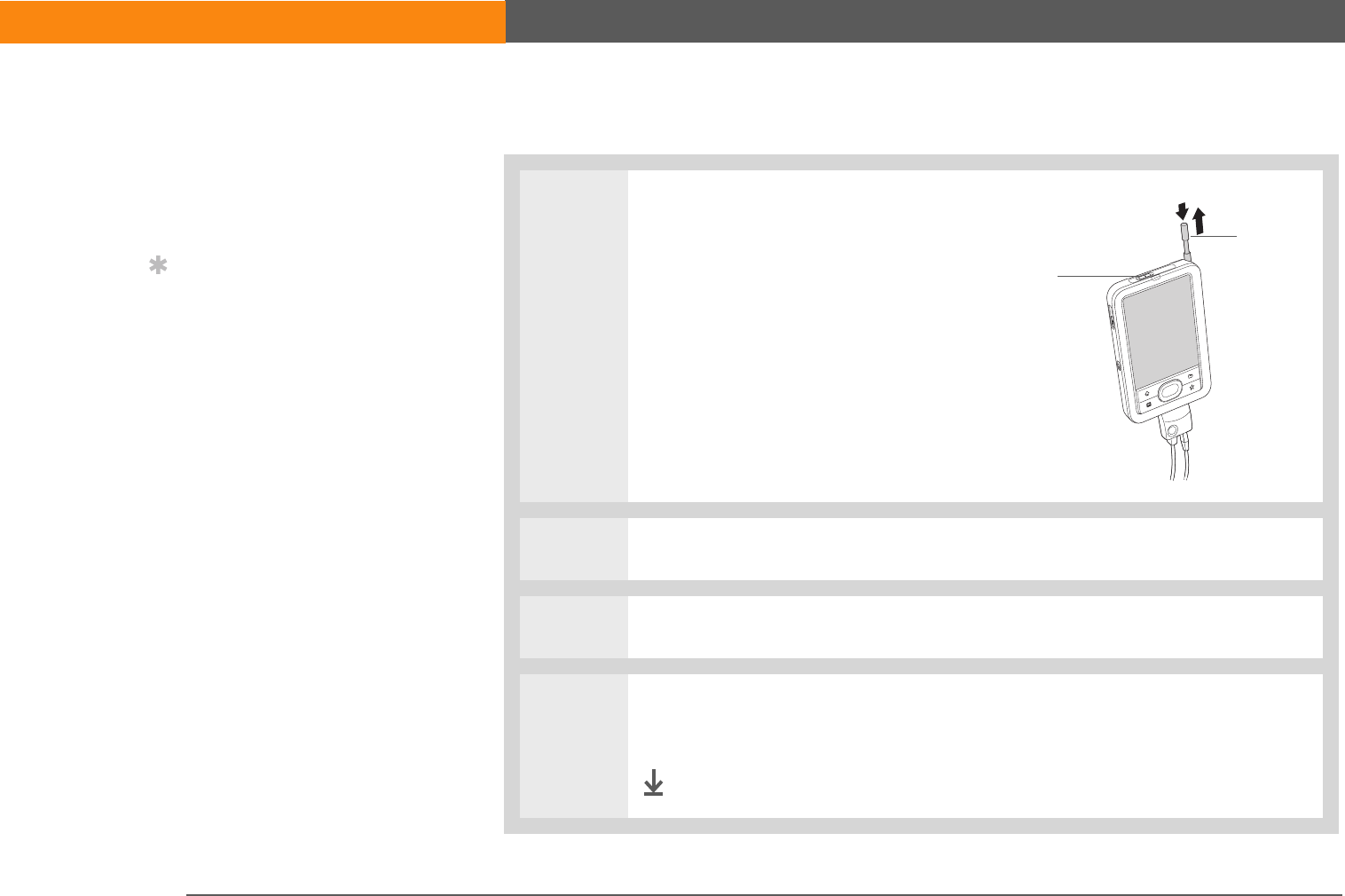
LifeDrive from palmOne 6
CHAPTER 1 Setting Up Your Device and Your Computer
Step 2: Turning on your device for the first time
0
1Unplug the USB sync cable from
your device.
2Slide the power switch to the right.
3Press and release the stylus, and then slide it out of the slot.
4Hold the stylus as you would hold a pen, and follow the onscreen instructions
to set up your device.
Done
Before You Begin
[!]
Be sure to fully charge
your device, as described
in the preceding
procedure.
Tip
After you set up your
device, review the Quick
Tour on your device and
take the tutorial on the CD
to learn the basics.
Power switch
Stylus
SECOND DRAFT palmOne, Inc. Confidential
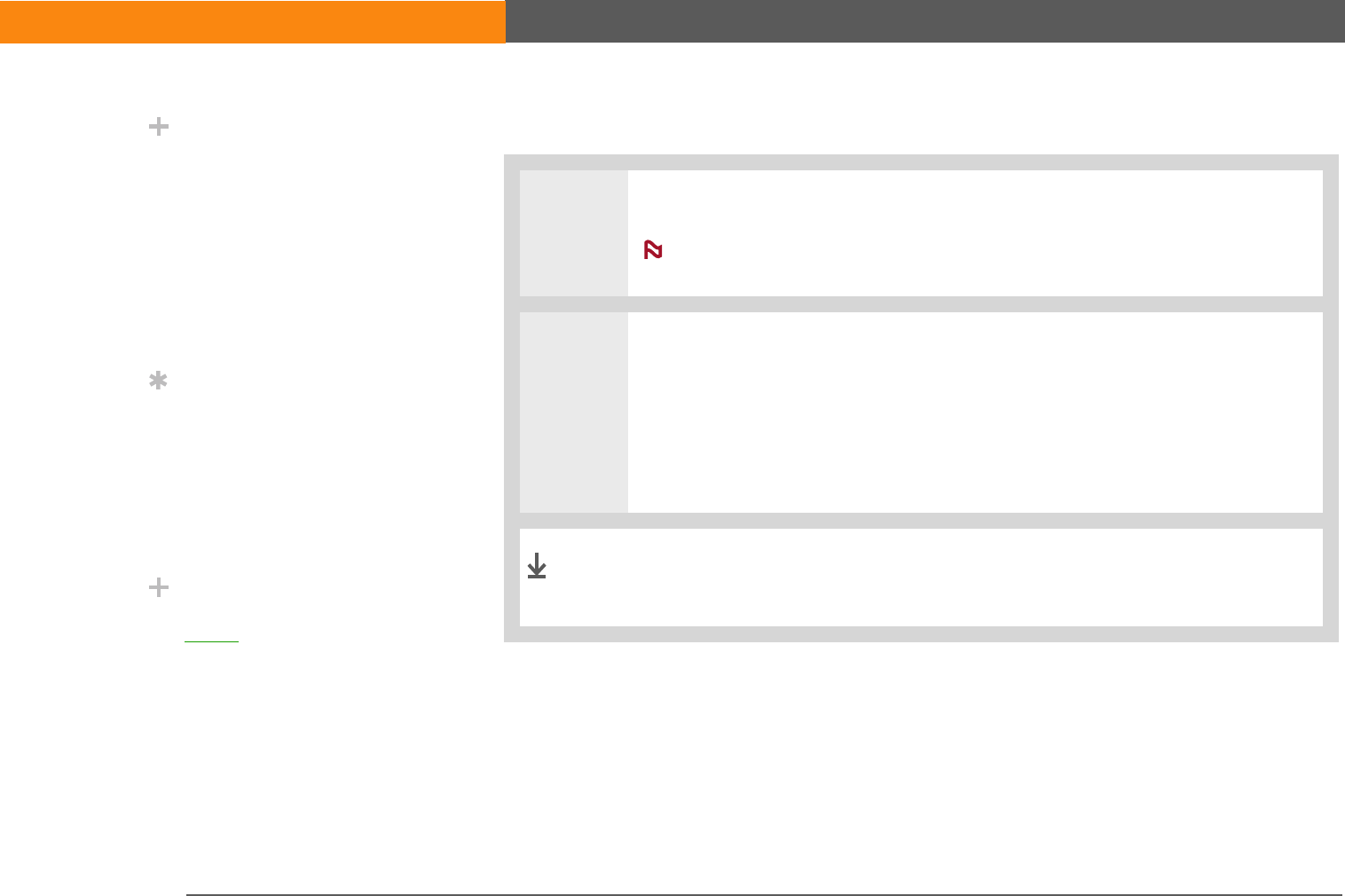
LifeDrive from palmOne 7
CHAPTER 1 Setting Up Your Device and Your Computer
Step 3: Installing your software
0
1Insert the CD into your computer.
You need administrator rights to install Palm Desktop software on a
computer running Windows 2000/XP or Mac OS X.
2WINDOWS ONLY
Follow the onscreen instructions. If you’re upgrading, select the username that
you assigned to your old device.
MAC ONLY
Double-click the CD icon, and then double-click palmOneSoftware.pkg.
During installation, you’re asked to connect your computer to your
device. See Step 4.
Did You Know?
When you upgrade,
there’s no need to delete
the old desktop software
first. When you install the
new Palm Desktop
software, all of your
information transfers
automatically to the new
software.
Tip
Take the interactive
tutorial on the CD to learn
how to create an
appointment; set up your
device’s features for
photos, video, and music;
and more.
Did You Know?
IT managers can set up a
profile if they want to
install the same set of
information on several
devices.
NOTE
Done
SECOND DRAFT palmOne, Inc. Confidential
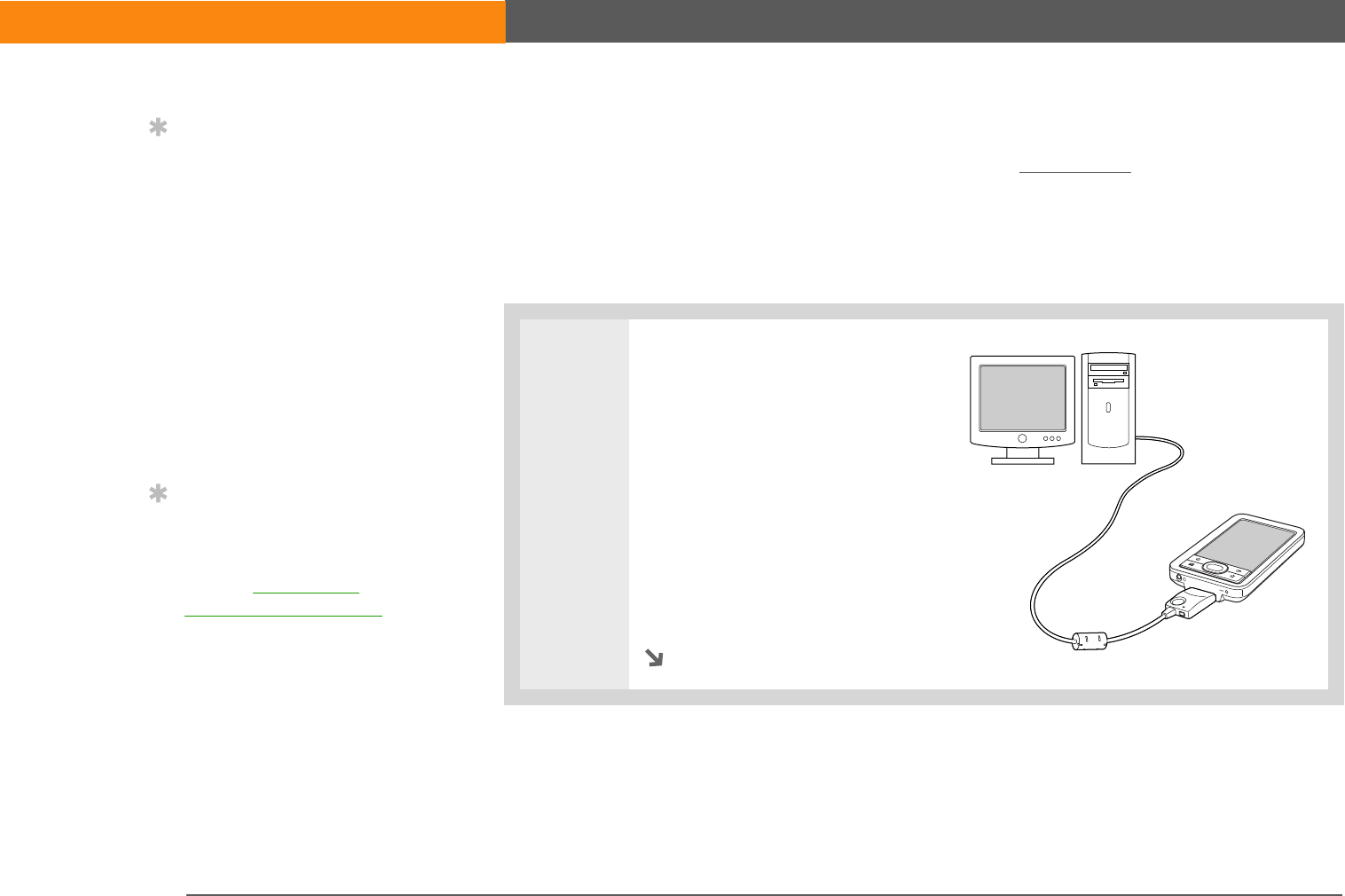
LifeDrive from palmOne 8
CHAPTER 1 Setting Up Your Device and Your Computer
Step 4: Connecting your device to your computer
In this step, you connect your device to your computer and do a full sync for the first time.
Synchronizing simply means that any information you enter in one place (your device or
computer) is automatically updated in the other.
Be sure to do a full sync of the info on your device at least once a day so that
you always have an up-to-date backup copy of this info on your computer.
0
1Connect your device to your
computer:
a. Plug the USB sync cable into a
USB port on the back of your
computer.
b. Plug the cable into your
device.
Continued
IMPORTANT
[!]
Tip
If the Select User dialog
box appears during
synchronization, select
the username of the
device you want to
synchronize, and click OK.
»
Key Term
Third-party application
A software program that
runs on a Palm Powered
device but is not created
or supported by
palmOne, Inc.
Tip
If you have problems with
your new device after you
synchronize, you may
need to update your
third-party applications.
SECOND DRAFT palmOne, Inc. Confidential
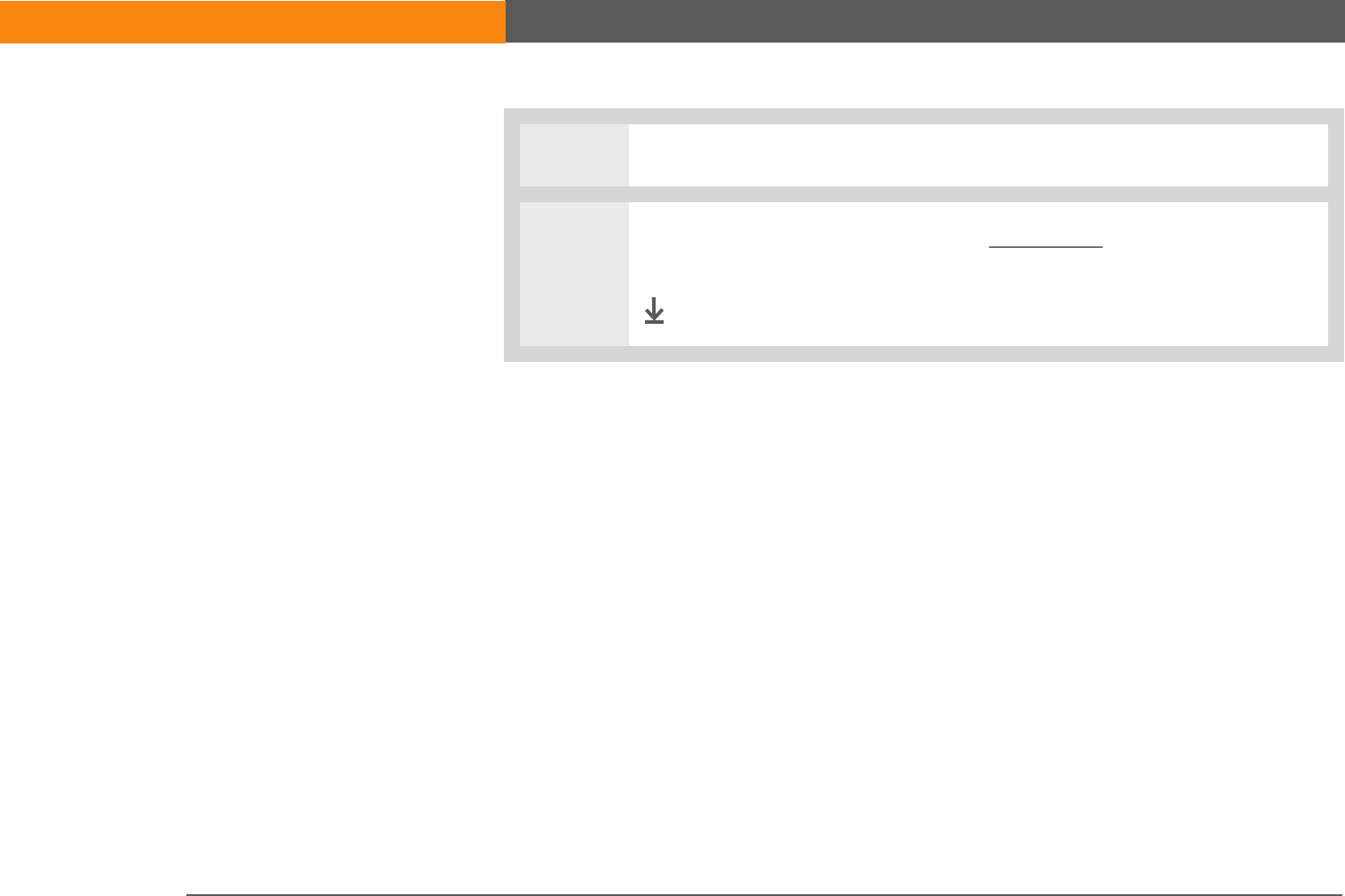
LifeDrive from palmOne 9
CHAPTER 1 Setting Up Your Device and Your Computer
2Slide the power switch to the right to turn on your device.
3Continue with the onscreen instructions. Do a full sync by pressing the sync
button on the USB sync cable.
Done
SECOND DRAFT palmOne, Inc. Confidential
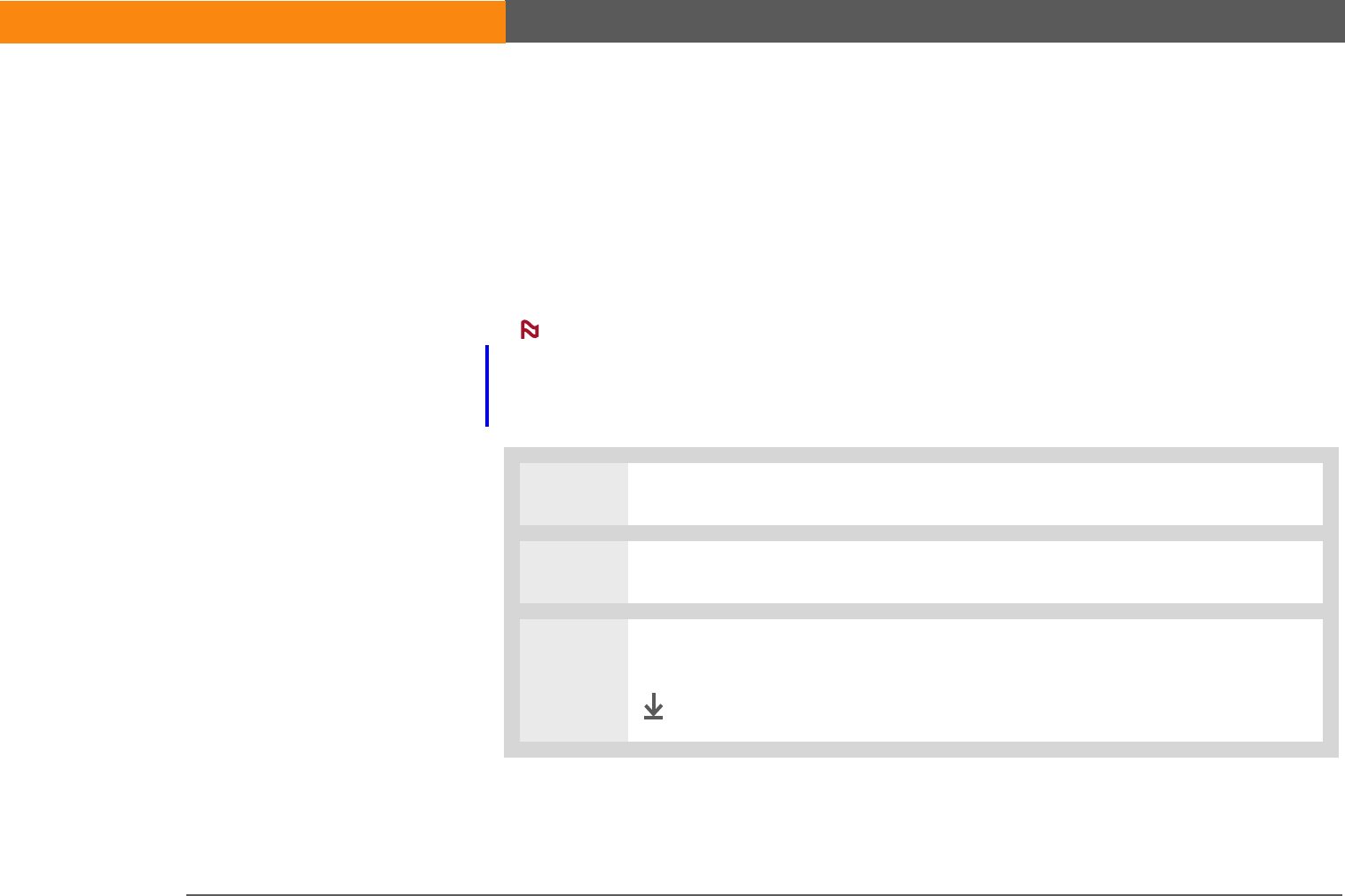
LifeDrive from palmOne 10
CHAPTER 1 Setting Up Your Device and Your Computer
Switching to another desktop software application
WINDOWS ONLY
During CD installation, you chose a desktop software application to synchronize with your device.
You may have chosen Palm Desktop software at that time. But if Microsoft Outlook already
contains all of your contacts, appointments, tasks, and notes, you can change your
synchronization method so that your device synchronizes with Outlook instead. You can also
change from Outlook to Palm Desktop software.
If you choose to synchronize with Outlook, info from Contacts, Calendar, Tasks, and
Memos is synchronized with the corresponding application in Outlook. (Memos is called Notes in
Outlook.) You can also set up the VersaMail® application to synchronize email on your device with
email in Outlook. Other info, such as voice memos and notes, is synchronized with info in
Palm Desktop software.
0
1Insert the CD into your computer.
2From the screen that appears, select Change your synchronization method.
3Follow the onscreen instructions for the desktop software you want to use.
Done
NOTE
SECOND DRAFT palmOne, Inc. Confidential

LifeDrive from palmOne 11
CHAPTER 1 Setting Up Your Device and Your Computer
Using user profiles
Only IT managers may need to use user profiles for their company. If you are not
an IT manager, you can skip this section.
Suppose your sales organization wants to distribute two dozen devices that all have a common
company phone list, a set of memos, and several key applications. A user profile can be created to
install this information before the devices are distributed to employees. When the employees
synchronize for the first time, this common information becomes part of their user-specific
information.
A user profile enables you to install the same information onto multiple devices before each
device is individualized with a unique username and user-specific information. A device that has a
user profile installed can be given to anyone, because the device is not yet identified by a unique
username. When the new user synchronizes for the first time, he or she gives the device a unique
username.
Devices that are synchronized with a user profile must be either new devices that have
never been synchronized or devices that have had their usernames and information removed by a
hard reset.
IMPORTANT
[!]
NOTE
SECOND DRAFT palmOne, Inc. Confidential
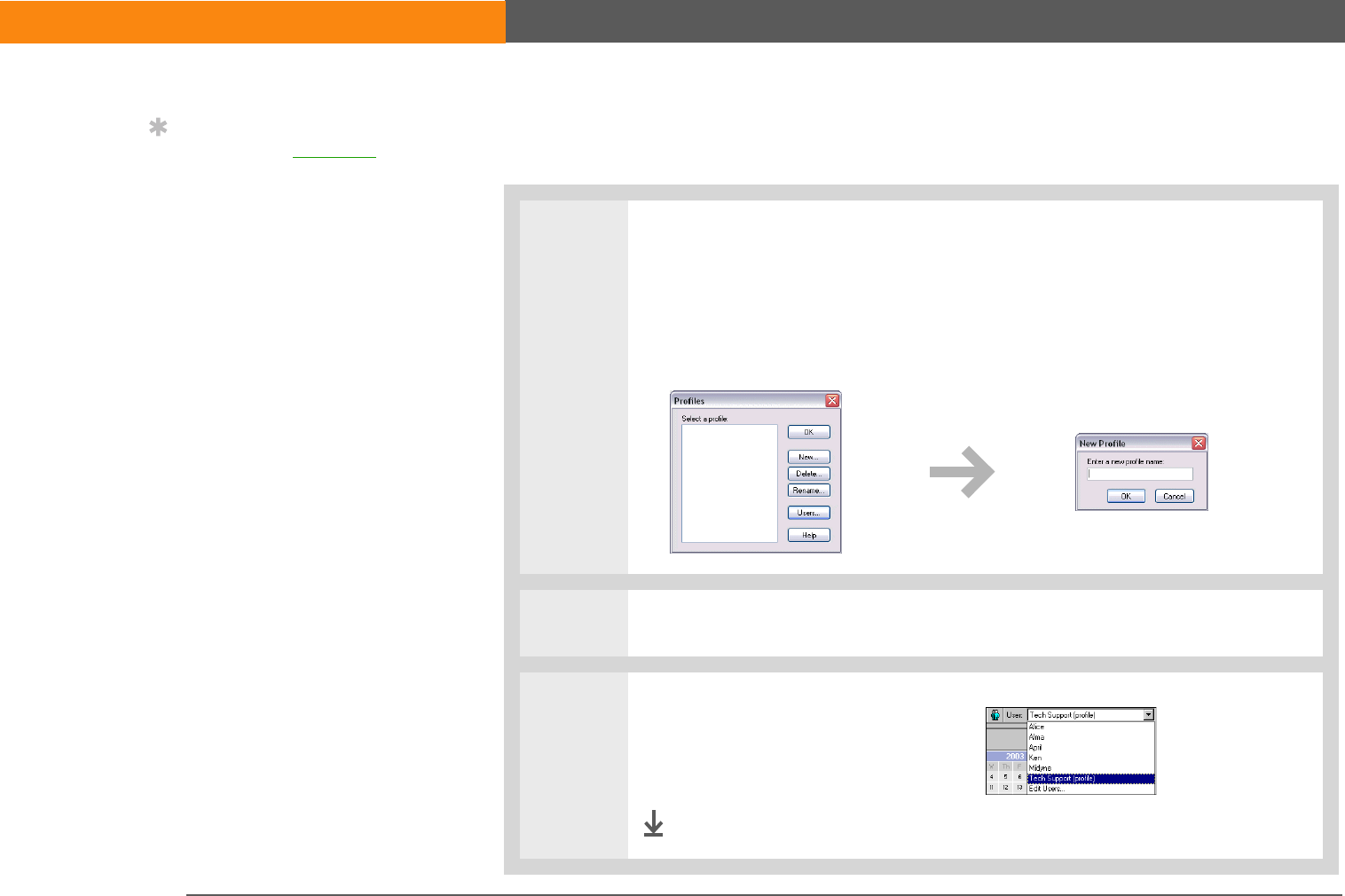
LifeDrive from palmOne 12
CHAPTER 1 Setting Up Your Device and Your Computer
Creating a user profile
WINDOWS ONLY
0
1Open the New Profile screen:
a. Open Palm Desktop software.
b. From the Tools menu, select Users.
c. Click Profiles, and then click New.
2Enter a unique name for the profile, and click OK twice.
3Select the profile from the User
list, and create the info in
Palm Desktop software for the
profile.
Done
Tip
Save time by importing to
quickly add information
to a profile.
SECOND DRAFT palmOne, Inc. Confidential
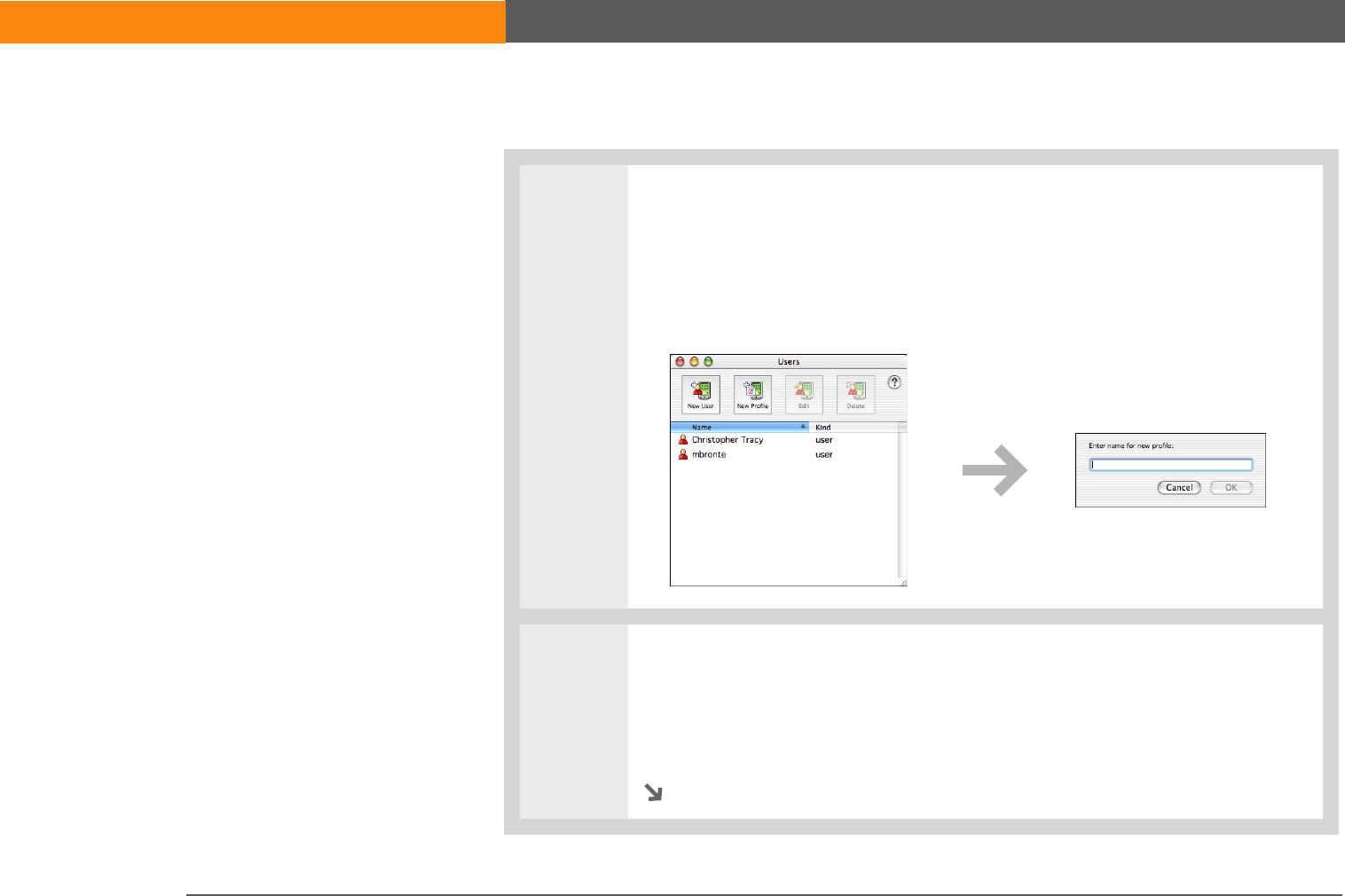
LifeDrive from palmOne 13
CHAPTER 1 Setting Up Your Device and Your Computer
MAC ONLY
0
1Open the New Profile screen:
a. Open Palm Desktop software.
b. From the User pop-up menu, select Edit Users.
c. Click New Profile.
2Create the profile:
a. Enter a unique name for the profile, and click OK.
b. Close the Users window.
Continued
SECOND DRAFT palmOne, Inc. Confidential
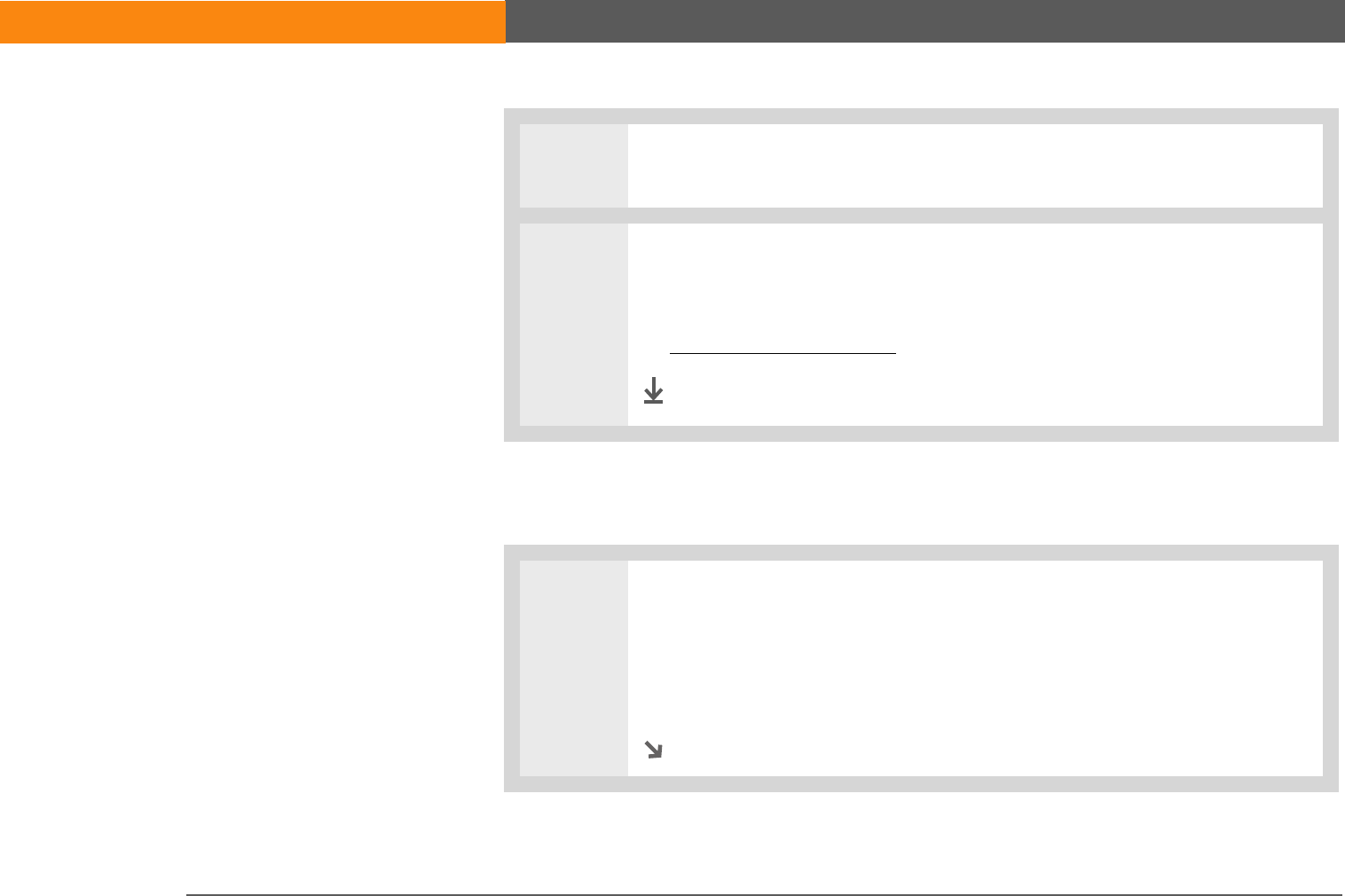
LifeDrive from palmOne 14
CHAPTER 1 Setting Up Your Device and Your Computer
Synchronizing with a user profile
WINDOWS ONLY
0
3Select the profile from the User pop-up menu, and create the info in
Palm Desktop software for the profile.
4Set the profile’s conduit settings:
a. From the HotSync menu, select Conduit Settings.
b. Select the conduit settings for the profile.
Done
1Begin synchronization:
a. Connect the USB sync cable to the USB port on the back of your computer,
and then insert the other end into the Multi-connector on your device.
b. Press the sync button on the USB sync cable.
Continued
SECOND DRAFT palmOne, Inc. Confidential
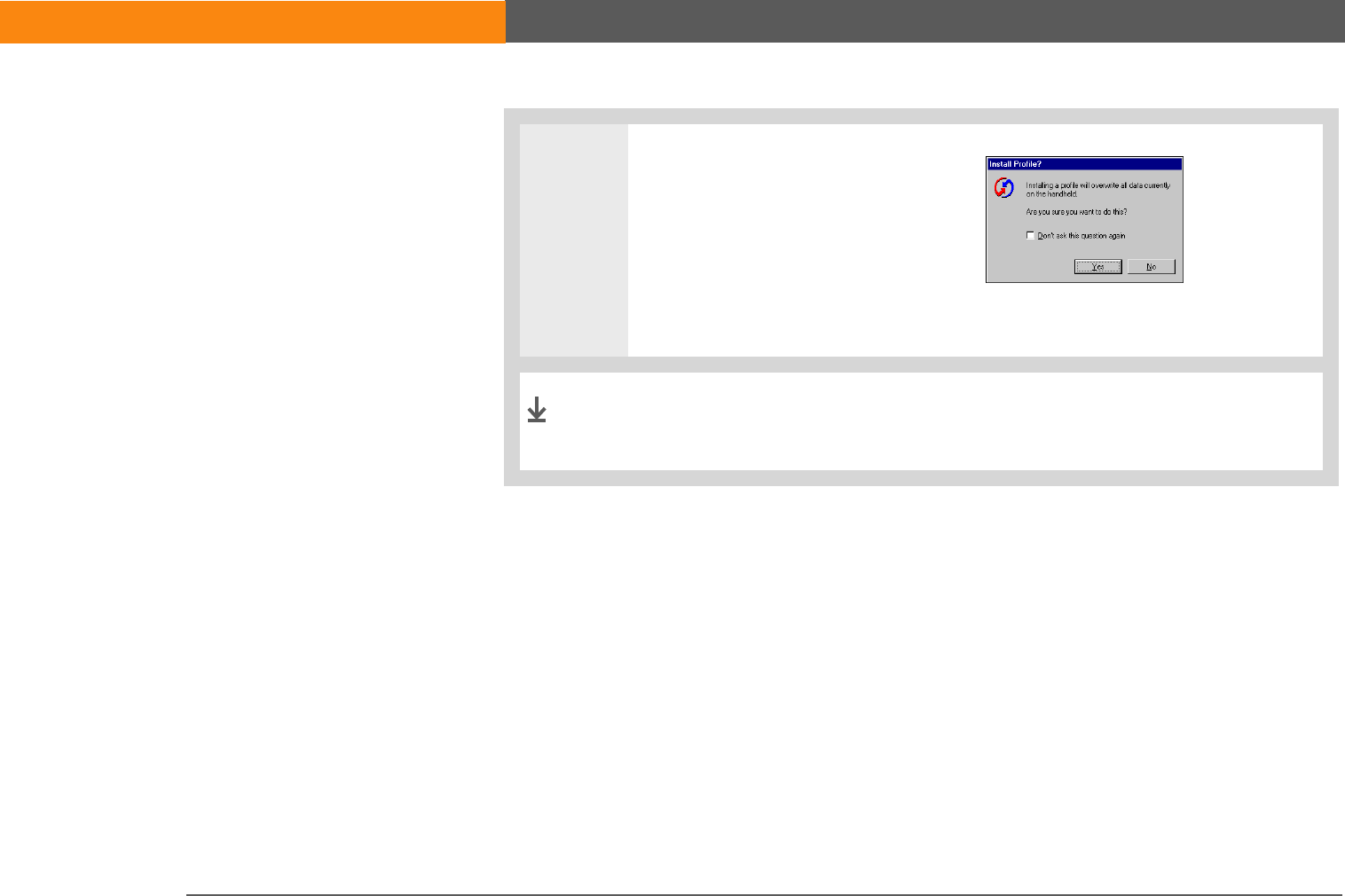
LifeDrive from palmOne 15
CHAPTER 1 Setting Up Your Device and Your Computer
2Transfer the profile information:
a. Click Profiles.
b. Select the profile you want to
load on the device, and click
OK.
c. Click Yes.
The next time you synchronize that device, Palm Desktop
software prompts you to assign a username to the device.
Done
SECOND DRAFT palmOne, Inc. Confidential
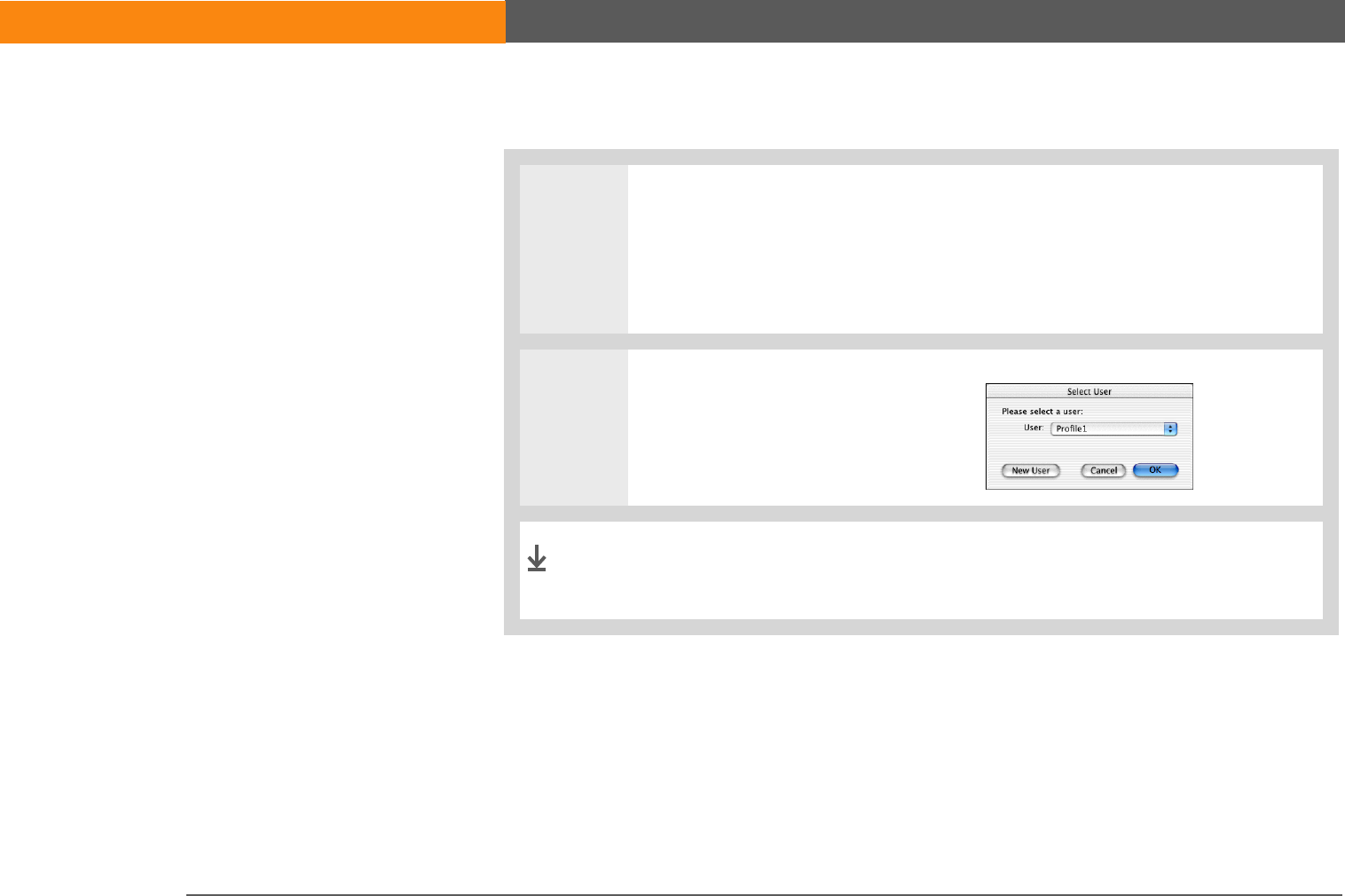
LifeDrive from palmOne 16
CHAPTER 1 Setting Up Your Device and Your Computer
MAC ONLY
0
1Begin synchronization:
a. Connect the USB sync cable to the USB port on the back of your computer,
and then insert the other end into the Multi-connector on your device.
b. Press the sync button on the USB sync cable.
2Select the profile you want to
load on the device, and click OK.
The next time you synchronize that device, Palm Desktop
software prompts you to assign a username to the device.
Done
SECOND DRAFT palmOne, Inc. Confidential

LifeDrive from palmOne 17
CHAPTER 1 Setting Up Your Device and Your Computer
Related topics
Click a link below to learn about these related topics:
Your Mobile
Manager
Keeping your device from turning on accidentally
Managing Info • Synchronizing your device with Palm Desktop software or Microsoft
Outlook on your computer
• Synchronizing wirelessly using the built-in Bluetooth technology or
Wi-Fi capabilities on your device
• Using your company’s network to synchronize information
• Choosing whether or not to synchronize information for a specific
application
• Transferring information to your device from an outside source, such as
a file containing your company’s phone list
• Adding applications to and deleting applications from your device
• Installing additional software from the CD
• Viewing application information
Customizing • Adjusting the screen display
• Reducing the Auto-off setting
Common
Questions
Answers to frequently asked questions about setup
Tips & Tricks
Make your device uniquely
yours. For great tips,
software, accessories, and
more, visit
www.palmOne.com/
mylifedrive.
Support
If you’re having problems
with setup or anything else
on your device, go to
www.palmOne.com/
support.
SECOND DRAFT palmOne, Inc. Confidential
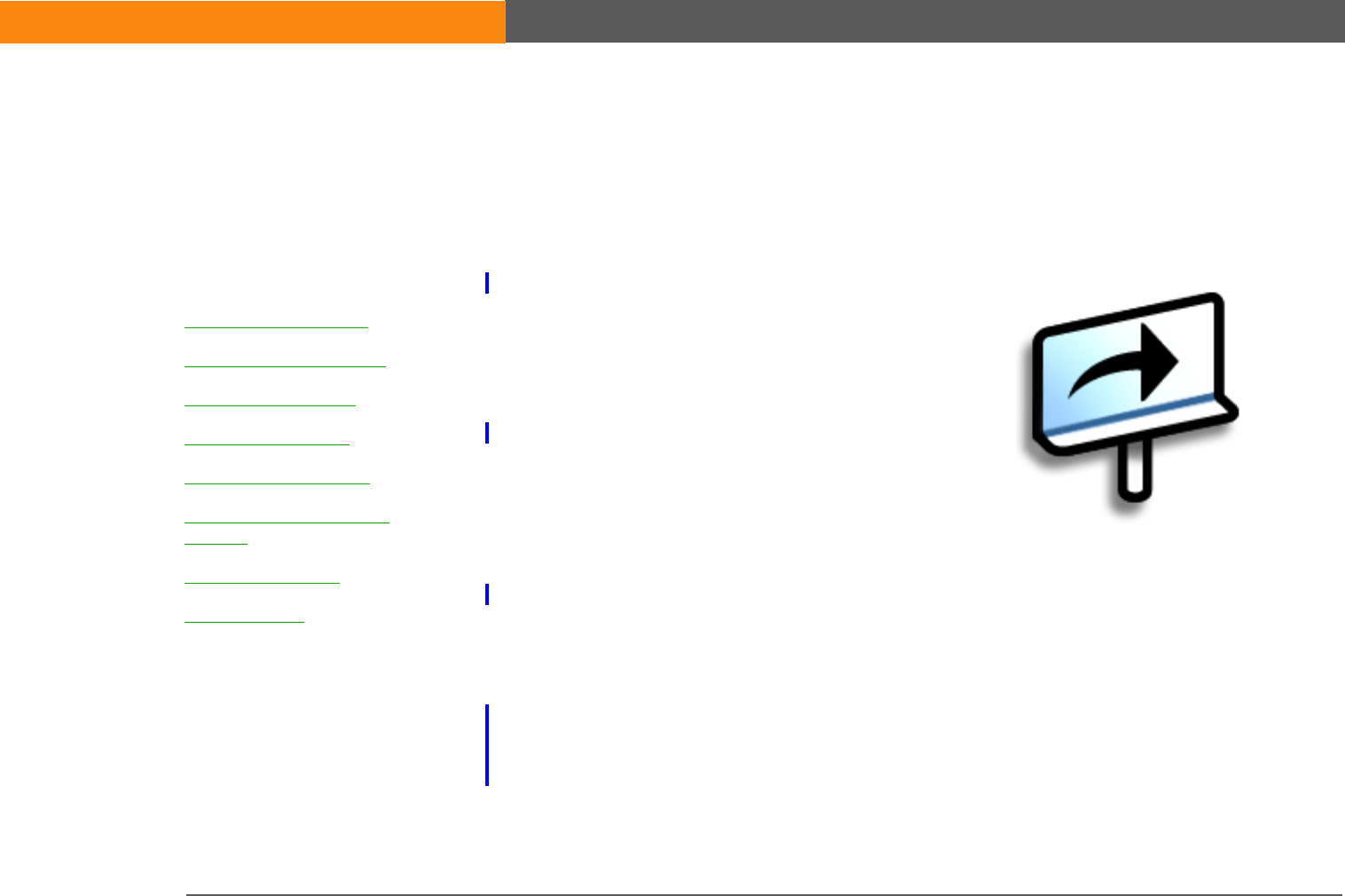
LifeDrive from palmOne 18
CHAPTER 2
Your Mobile Manager
Your new LifeDrive™ mobile manager
from palmOne takes mobile computing
to a whole new level. As always, it
helps you keep track of your schedule,
your business and personal contacts,
your to-do list, and even your
Microsoft Office and multimedia files.
But the device offers much more—like
a 4GB hard drive that lets you carry all
your crucial Office files, plus hours of
your favorite music, photos, and
videos. Transfer information in real
time between your device and your
computer and, on a Windows
computer, select which files and
folders to synchronize. Import photos
and videos from your digital camera’s
memory card, or connect wirelessly to
a Wi-Fi® network.
Benefits
• Carry files and folders on an internal
hard drive containing nearly 4GB of
storage, and work with them on the
go
• Save time and stay organized
• Travel light
• Never lose important information
• Stay in touch using wireless
connectivity
I
n t
hi
s c
h
apter
What’s on my device?
Using the power switch
Using the status bar
Rotating the screen
What’s on the screen?
What software is on my
device?
What’s on the CD?
Related topics
SECOND DRAFT palmOne, Inc. Confidential
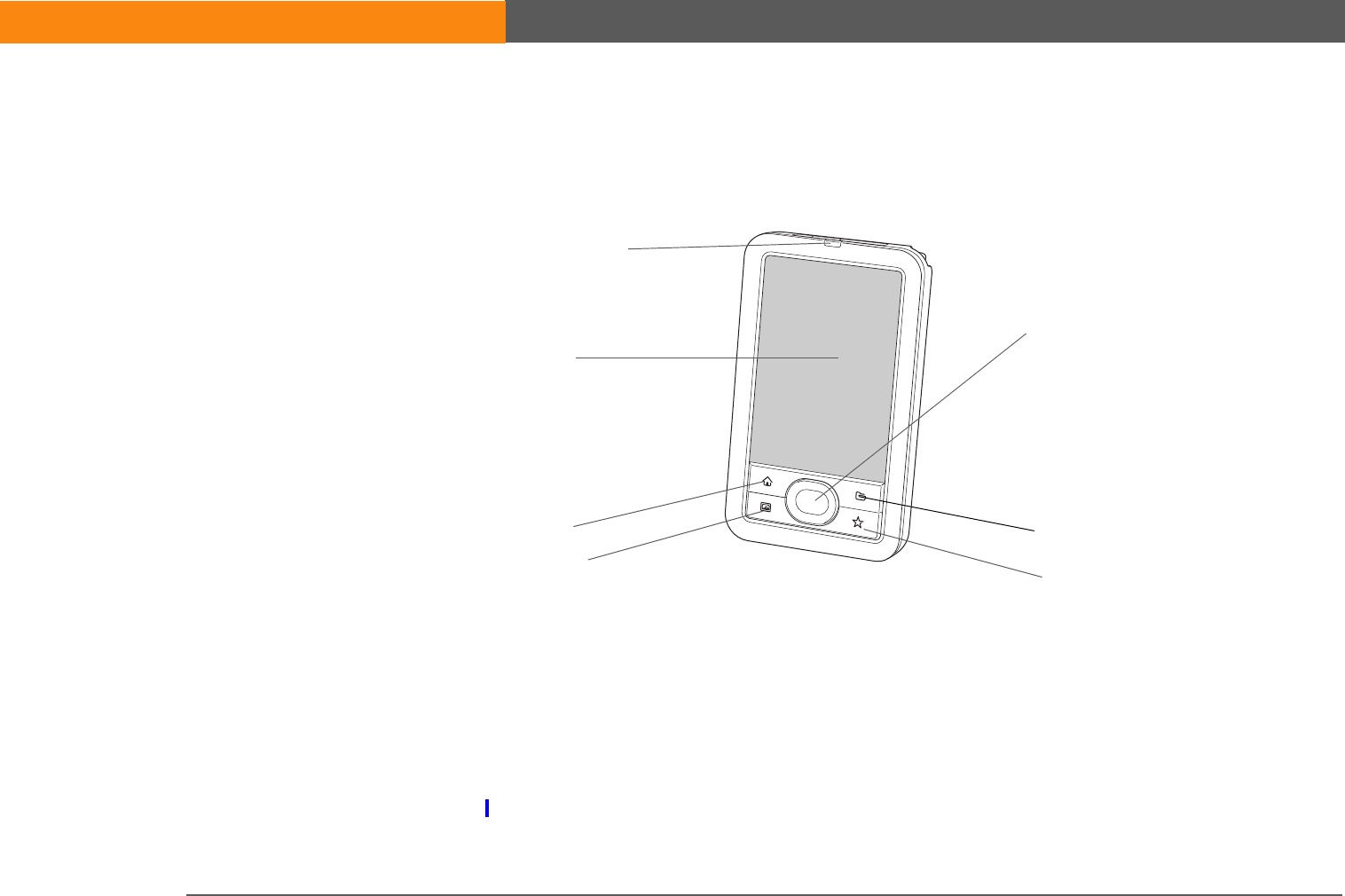
LifeDrive from palmOne 19
CHAPTER 2 Your Mobile Manager
What’s on my device?
Front
Indicator light Notifies you of various functions. A solid amber light indicates that the
device is charging; a solid green light indicates that the device is fully
charged.
A flashing amber light indicates that the device’s hard drive is currently
processing information—opening a file, saving changes, and so on. Be
especially careful not to drop, bang, or otherwise cause a strong
impact to your device while the indicator light is blinking; you may
damage the hard drive.
Screen
5-way navigator
Home
Media
Files
Star
Quick buttons
Indicator light
SECOND DRAFT palmOne, Inc. Confidential

LifeDrive from palmOne 20
CHAPTER 2 Your Mobile Manager
Screen Displays the applications and information on your device. The screen
is touch-sensitive.
Display the input area by tapping the Input icon on the status bar.
Use the input area to enter info with Graffiti® 2 writing or the onscreen
keyboard.
5-way navigator Helps you move around and select info to display on the screen.
Quick buttons Turn on your device and open the corresponding application. Press the
Home button once to open Favorites, twice to open Applications. The
Star button opens the Pocket Tunes™ music application by default, but
you can customize it to open any application you choose.
Tip
The Favorites application
offers four pages of
favorites. Pressing Home
once opens the first page
of Favorites; use the
buttons in the upper-right
corner of the Favorites
screen to go to the other
pages.
SECOND DRAFT palmOne, Inc. Confidential
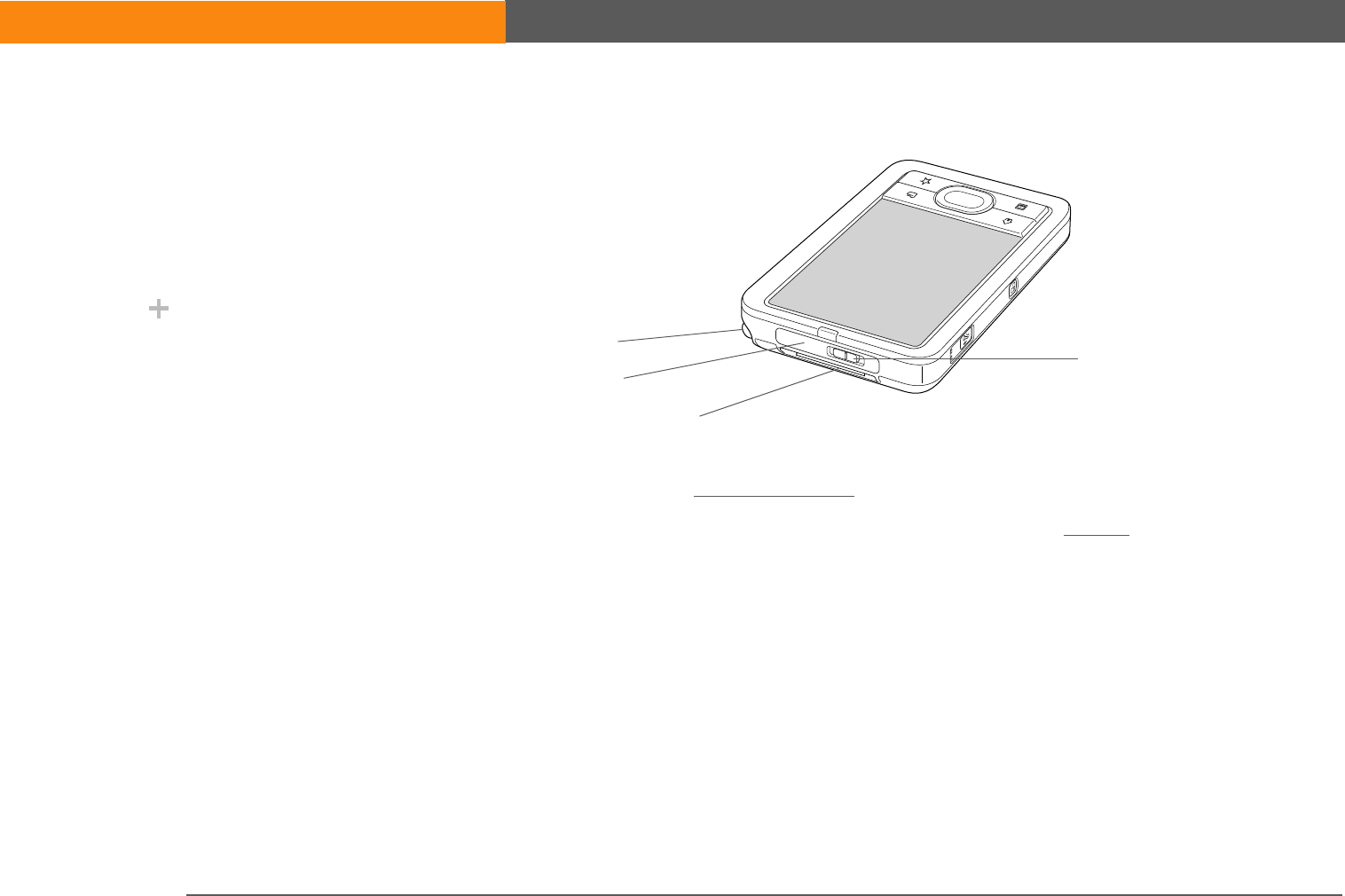
LifeDrive from palmOne 21
CHAPTER 2 Your Mobile Manager
To p
IR port Beams information to and from other devices that have an IR port.
Power switch Turns your device on or off and lets you turn Keylock on. A red indicator is
displayed on the switch when Keylock is on.
Stylus Lets you enter information on your device by writing or tapping. To use
the stylus, press down on the top, release to let it pop out of the slot, and
then slide it out. Hold the stylus as you would a pen or pencil. Using your
fingertip instead of the stylus is OK, but don’t use your fingernail, a real
pen, or any other sharp object to touch the screen.
Expansion card
slot
Lets you insert an expansion card (sold separately) to back up info and
add memory, applications, and accessories to your device.
»
Key Term
IR Short for infrared.
Beaming uses infrared
technology to send
information between two
IR ports that are within a
few feet of each other.
Did You Know?
Beaming lets you quickly
share appointments,
addresses, phone
numbers, files, photos,
and more.
Stylus Three-position
power switch
IR port
Expansion card slot
SECOND DRAFT palmOne, Inc. Confidential

LifeDrive from palmOne 22
CHAPTER 2 Your Mobile Manager
Side
0
Screen rotation
button
Rotates the screen between portrait and landscape views.
Voice Memo
button
Opens the Voice Memo application when you press and release the
button. Records a voice memo when you press and hold the button.
Microphone Lets you record sound to create a voice memo.
Microphone
Voice Memo
button
Screen rotation button
SECOND DRAFT palmOne, Inc. Confidential
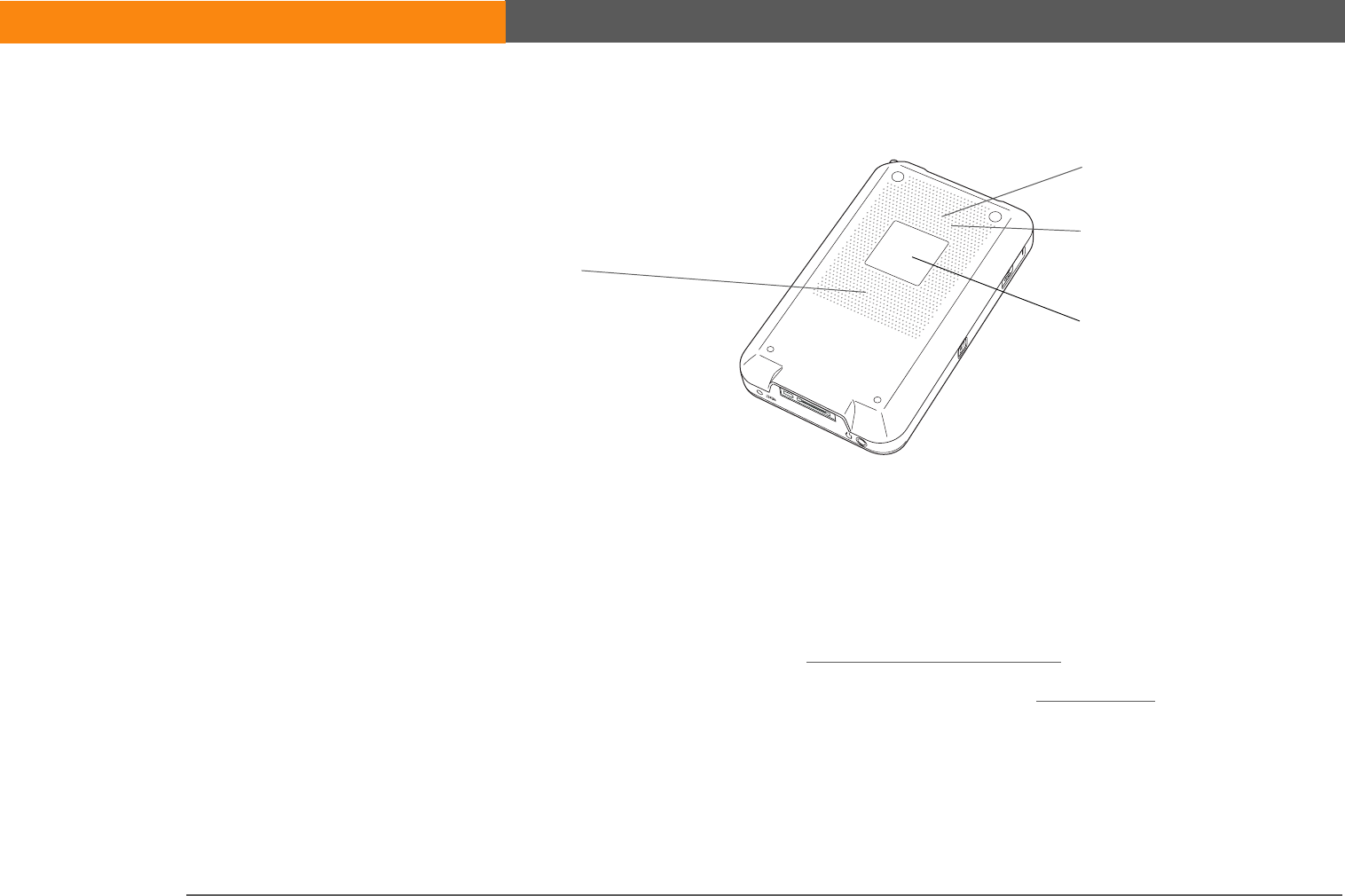
LifeDrive from palmOne 23
CHAPTER 2 Your Mobile Manager
Back
Hard drive (internal) Provides 4GB of storage to carry and manage all of your crucial work
information, music and media files, and more.
Speaker Lets you listen to alarms, game and system sounds, music, and
voice memos.
Bluetooth® radio
(internal)
Enables your device to connect with other devices (sold separately)
that use Bluetooth wireless technology.
Wi-Fi radio (internal) Enables your device to connect to a Wi-Fi network to wirelessly
access email, browse the web, and synchronize.
Bluetooth radio
(internal)
Speaker
Hard drive
(internal)
Wi-Fi radio (internal)
SECOND DRAFT palmOne, Inc. Confidential
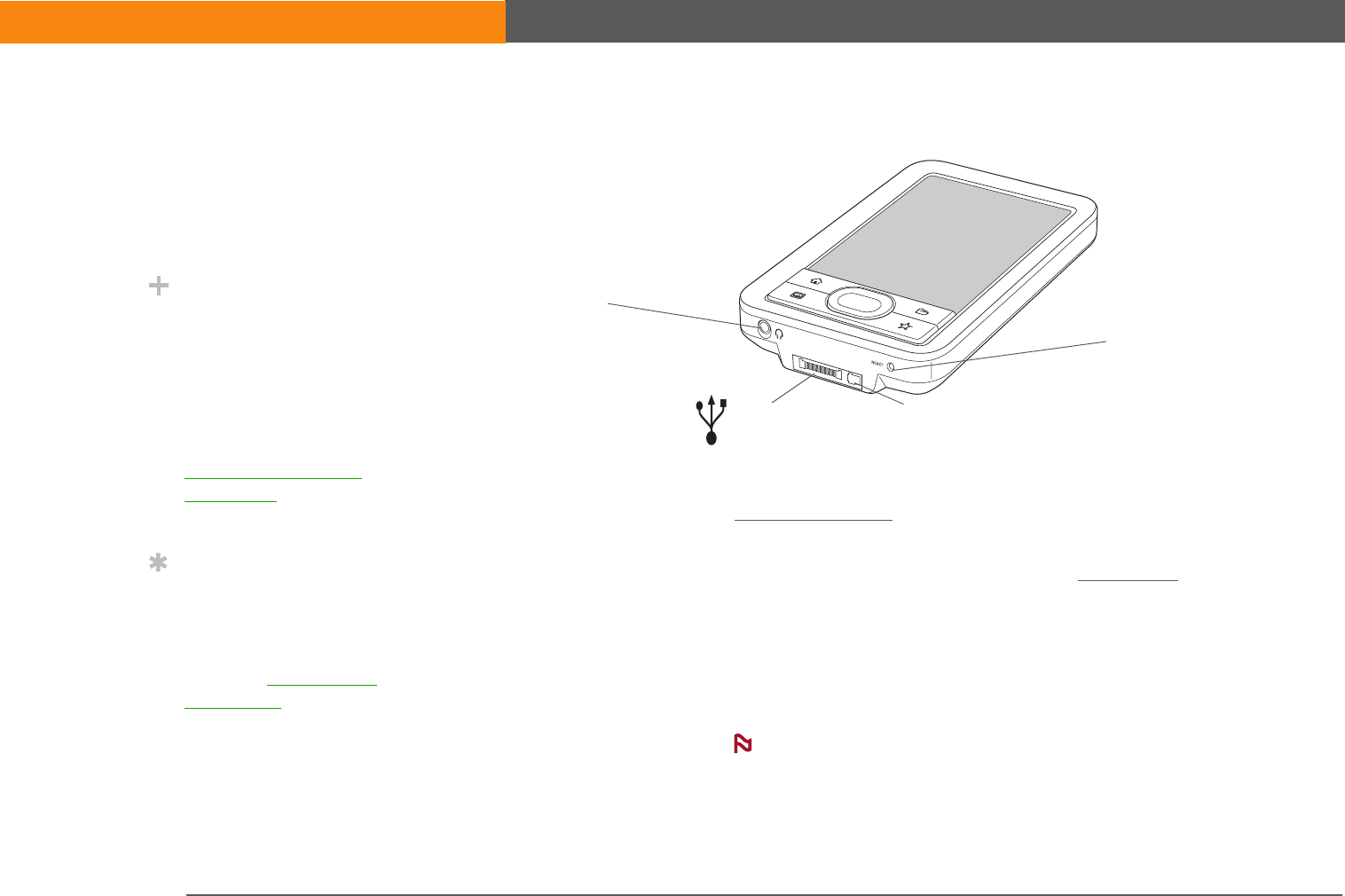
LifeDrive from palmOne 24
CHAPTER 2 Your Mobile Manager
Bottom
Reset button Resets your device if it freezes (stops responding).
Multi-connector Lets you connect a USB sync cable (included) or a cradle (sold
separately) to your computer so you can synchronize or exchange
information. You can also charge your device by connecting it to
your computer using the USB sync cable.
The Multi-connector also lets you connect the AC charger to your
device—either directly to the connector or through the USB sync
cable—so you can charge it.
Be sure to plug in the sync cable with the arrow on the
cable connector facing the front of the device.
Headphone jack Lets you connect standard 3.5mm stereo headphones (sold
separately) to your device so you can listen to music and other audio
applications.
»
Key Term
USB The type of
connector or cable that’s
commonly used to
connect accessories to a
computer.
Did You Know?
You can purchase a cradle
accessory that lets you
connect external
speakers (sold
separately) to hear audio
from your device through
the Multi-connector. Visit
www.palmOne.com/
mylifedrive and click the
Accessories link.
Tip
It takes a little while for
your device to reset when
you press the reset
button. Resetting is done
when the Date & Time
Preferences screen
appears.
Connector
port
Reset
button
Headphone
jack
Multi-connector
AC charger
NOTE
SECOND DRAFT palmOne, Inc. Confidential
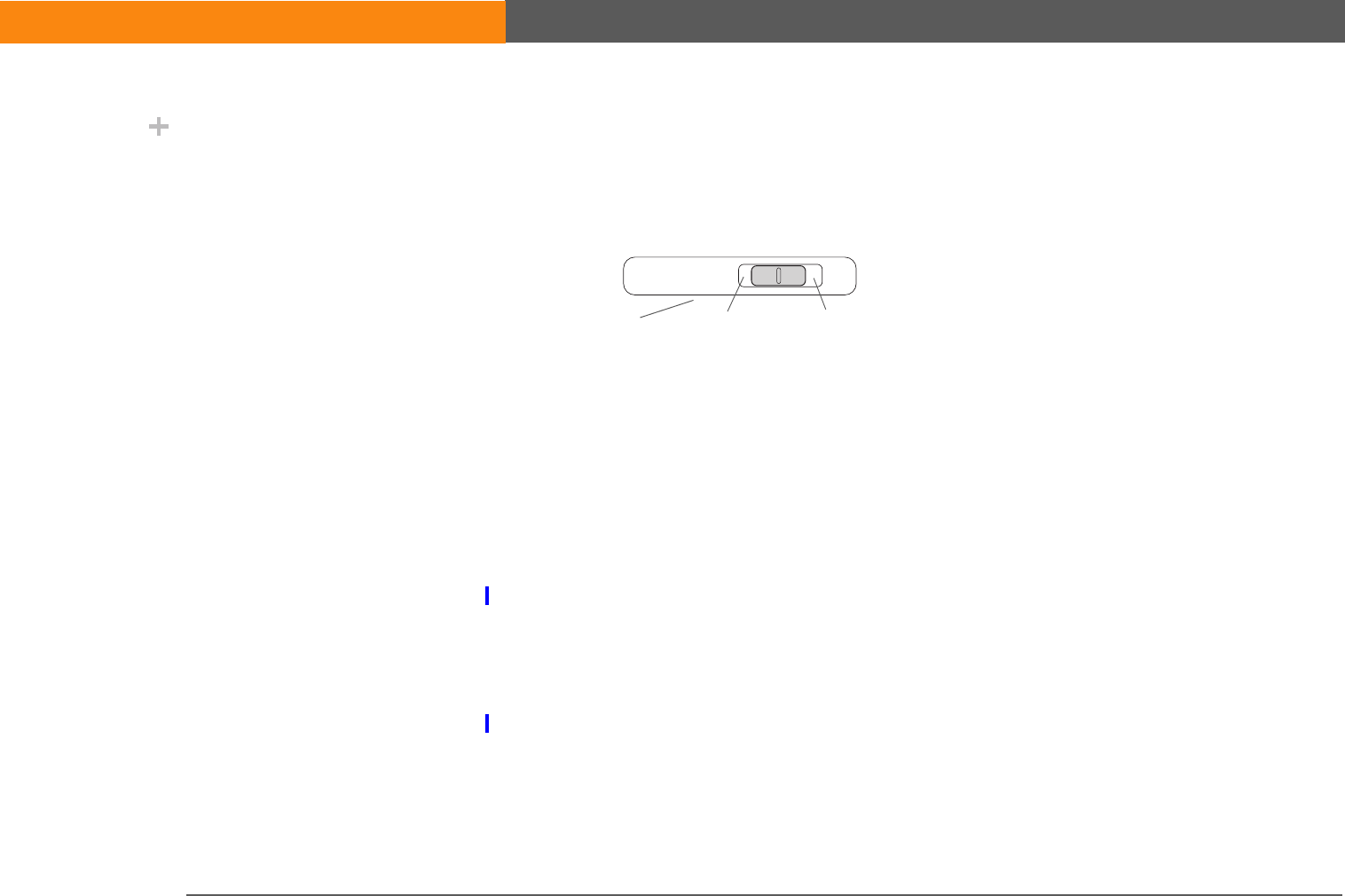
LifeDrive from palmOne 25
CHAPTER 2 Your Mobile Manager
Using the power switch
Your device’s power switch turns your device on and off, and also lets you lock your device so that
it does not respond to taps, 5-way presses, or presses on the buttons on the front and side of your
device.
Use the power switch for the following actions:
• To turn on your device, slide the switch to the right and let it return to the center. To turn your
device off, slide the switch to the right again.
• If your device is off, slide the switch to the left to lock your device. Your device does not respond
to button presses, taps, or 5-way presses and cannot turn on until you slide the switch to the
center position. Locking your device when it is off is useful if you carry your device in a bag and
want to prevent it from turning on accidentally when something presses against it.
• If your device is on, slide the switch to the left to lock your device at the current screen. Your
device does not respond to button presses, taps, or 5-way presses, and the current screen
cannot be changed until you slide the switch to the center position. Locking your device at a
current screen is useful, for example, if you want to pass your device around to show a photo to
a group of people and you do not want someone to accidentally tap or press something that
causes the photo to disappear.
Did You Know?
A red indicator is
displayed on the power
switch when Keylock is
on.
On/Off
Keylock
Front of device
SECOND DRAFT palmOne, Inc. Confidential
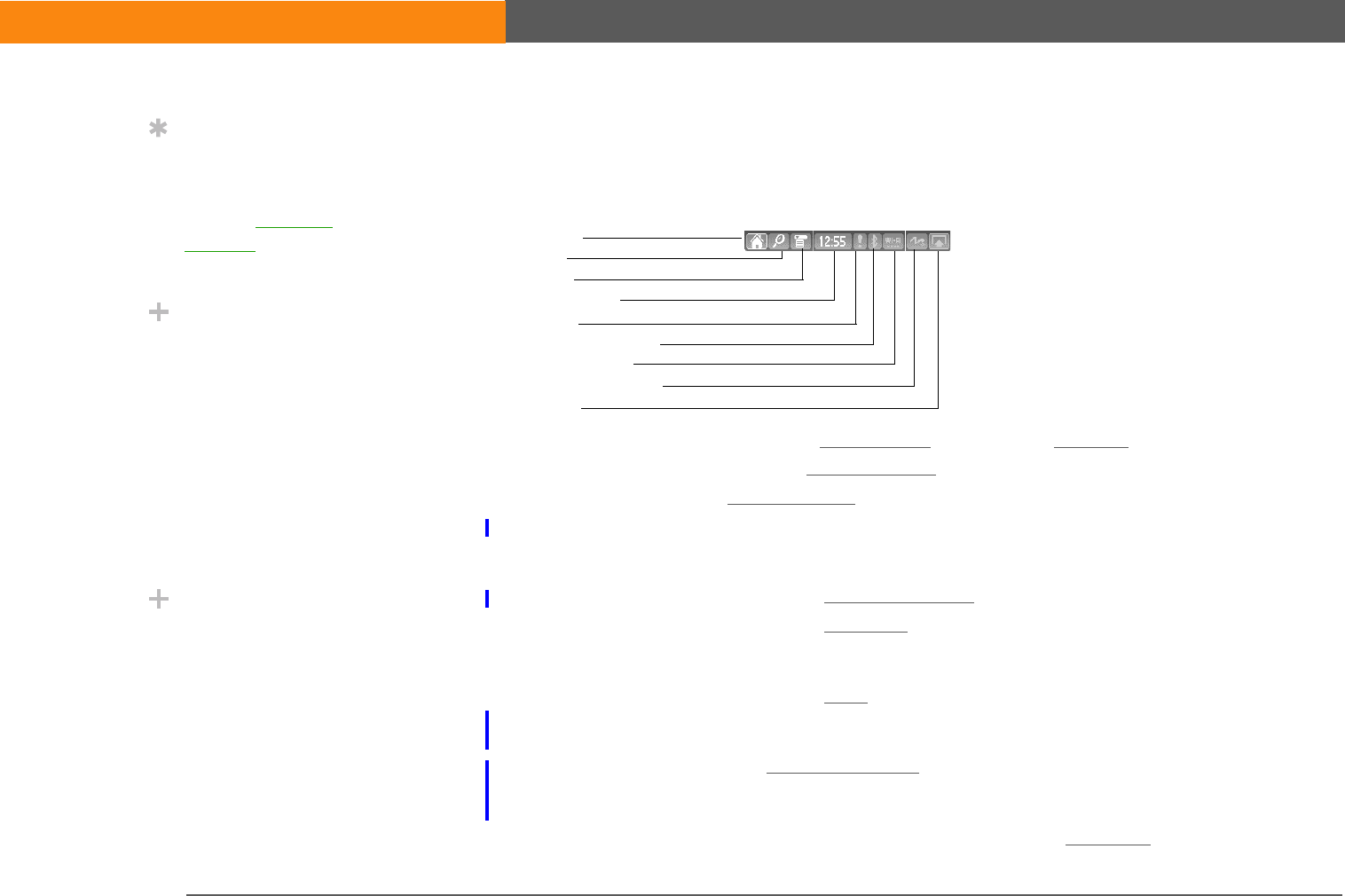
LifeDrive from palmOne 26
CHAPTER 2 Your Mobile Manager
Using the status bar
The status bar at the bottom of the device screen gives you access to valuable tools and is
accessible in all views.
0
Home Tap once to open Applications, twice to open Favorites.
Find Tap to open the Find dialog box.
Menu Tap t o open the menu for the current screen.
System info Tap to open the System information dialog box. The dialog box shows the
date and time, available memory, and battery level, and allows you to turn
system sounds on and off and to adjust screen brightness.
Alert Tap to display the Reminders screen when the icon is blinking.
Bluetooth
controls
Tap to display the Bluetooth dialog box, where Bluetooth functionality can
be turned on and off and you can connect to another Bluetooth device. The
icon color changes from blue to white when Bluetooth is turned on.
Wi-Fi controls Tap to display the Wi-Fi dialog box, where you can make a wireless
connection to a Wi-Fi network. The icon displays “Wi-Fi” when Wi-Fi is
turned off, and a signal strength indicator when Wi-Fi is turned on.
Full-screen
writing
Tap t o tu rn full-screen writing on and off. When it is on, you can write
Graffiti® 2 characters anywhere onscreen. The icon color changes from blue
to white when full-screen writing is turned on.
Input Tap to switch between showing and hiding the input area. Tap and hold to
display the input area selection menu.
H
ome
Find
Menu
System info
Alert
Bluetooth controls
Wi-Fi controls
Full-screen writing
Input
Tip
Use the Find dialog box to
locate specific items of
information in your
device’s program
memory—for example, a
name or a phone number.
Did You Know?
The System info icon
shows the current time on
the status bar.
In the System info dialog
box, both the hard drive
and the program memory
are labeled Device. The
hard drive is indicated by
the larger available
memory size.
Did You Know?
When Wi-Fi is on, the
signal strength indicator
shows an alert symbol
when the device is not
connected to a network,
and an arrow symbol
when the device is
connected. The number
of bars indicates the
signal strength when
connected.
SECOND DRAFT palmOne, Inc. Confidential
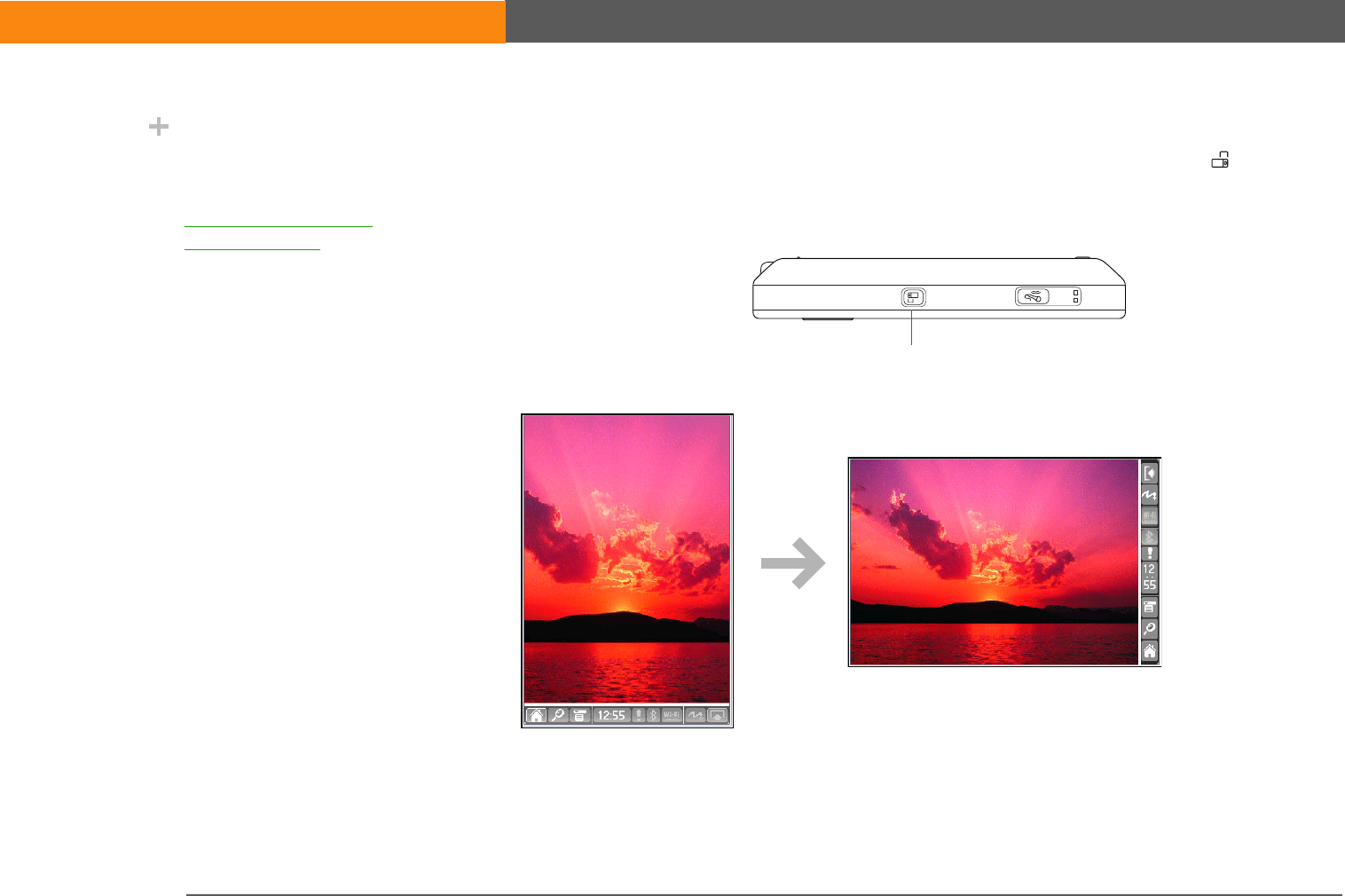
LifeDrive from palmOne 27
CHAPTER 2 Your Mobile Manager
Rotating the screen
You can switch between landscape and portrait views by pressing Screen rotation on the side
of your device. Landscape view is useful for viewing spreadsheets, email, web pages, and photos.
Did You Know?
You can customize which
way the screen rotates in
landscape mode by
choosing right- or left-
handed rotation.
Screen rotation button
SECOND DRAFT palmOne, Inc. Confidential
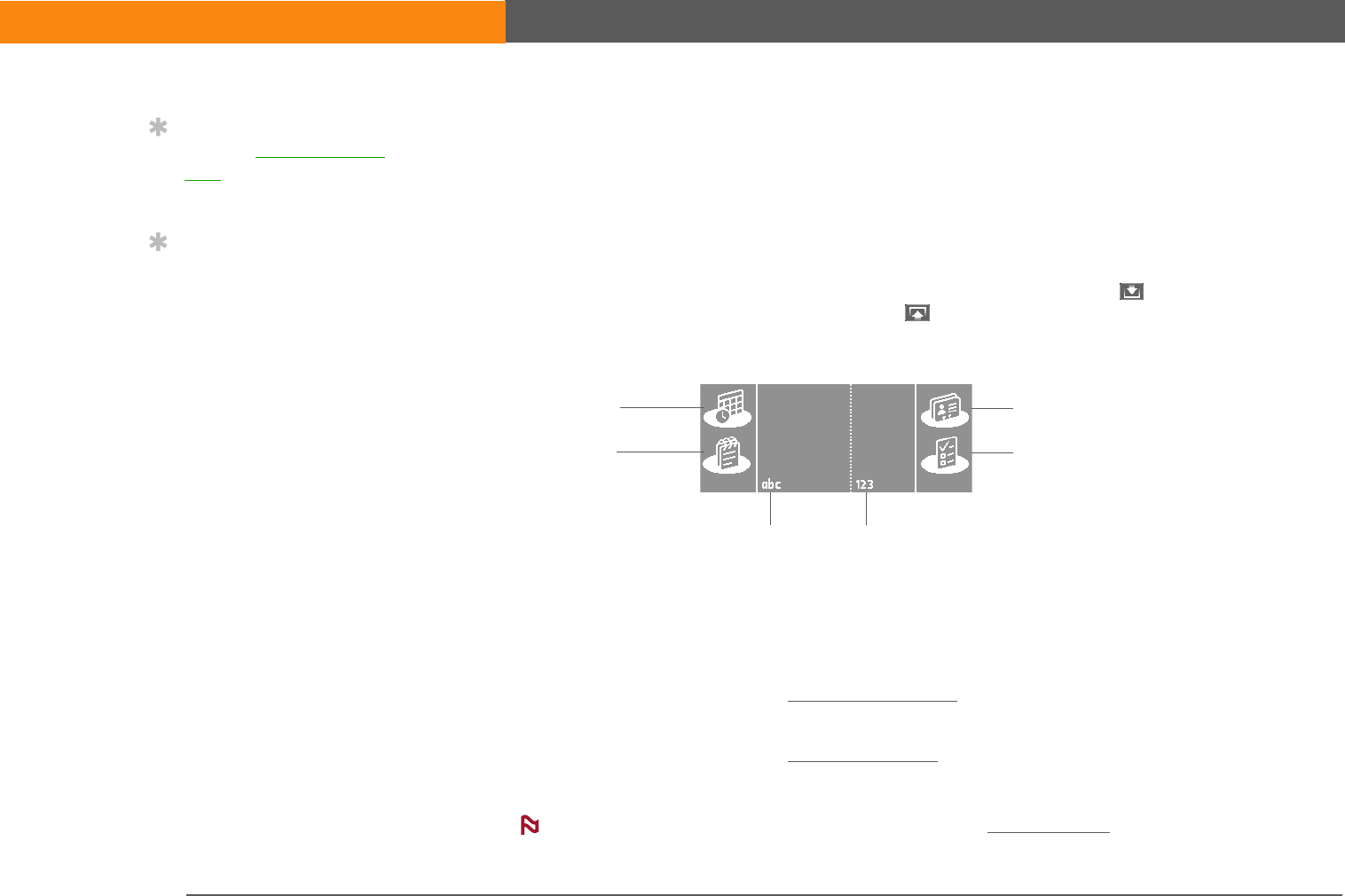
LifeDrive from palmOne 28
CHAPTER 2 Your Mobile Manager
What’s on the screen?
Your device includes many features that make it easy to use. Among them are the input area and
the common elements that appear on the screen in each of the applications. Once you learn how
to use them in one application you can easily use them in all the others.
Input area
By default, the input area is displayed. To hide the input area, tap Input on the status bar. To
display the input area if it is hidden, tap Input again. Tapping the icons in the input area opens
the following applications:
You cannot display the input area in the main Favorites View. However, if you perform a
task such as adding or deleting a favorite, you can display the input area.
Application
icons: Calendar,
Contacts,
Memos, Tasks
Open the corresponding application.
Letter keyboard
icon
Opens the alphabetic keyboard.
Number
keyboard icon
Opens the numeric keyboard.
Tip
You can select an input
area that does not display
the application icons.
Tip
If you use another
application frequently,
customize the input area
to display that
application’s icon. Tap
and hold any of the four
application icons, and
select the new application
you want from the list.
The new application’s
icon replaces the icon you
tapped.
Contacts icon
Letter keyboard
Icon
Tasks icon
Calendar icon
Memos icon
Number keyboard
Icon
NOTE
SECOND DRAFT palmOne, Inc. Confidential
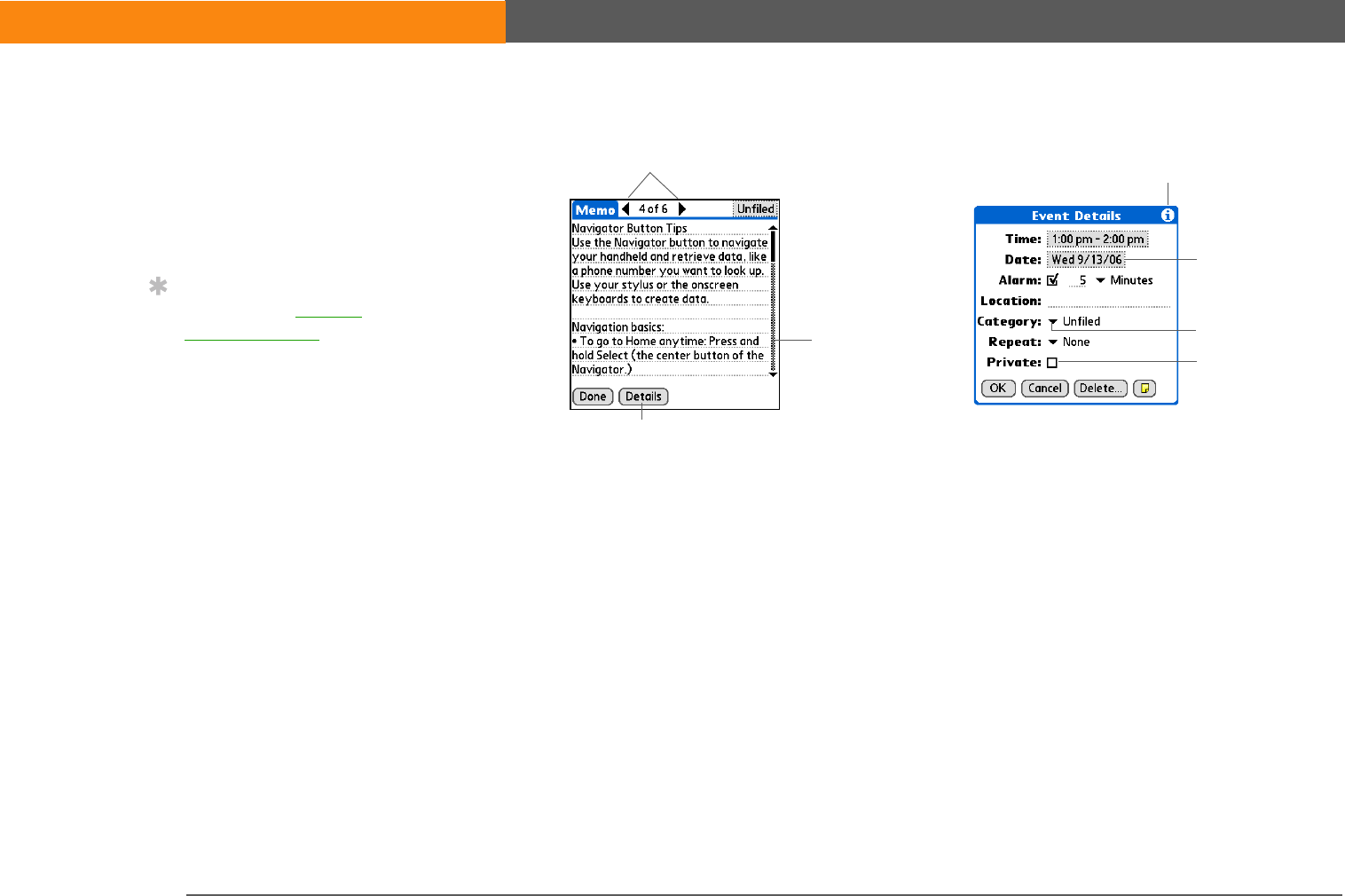
LifeDrive from palmOne 29
CHAPTER 2 Your Mobile Manager
Application controls
Previous/next
arrows
Select the left and right arrows to view the previous and next entry; where
up and down arrows appear, select them to view the previous and next
screens of information.
Scroll bar Drag the slider, or tap the top or bottom arrow, to scroll the display one line
at a time. To scroll to the previous screen, tap the scroll bar just above the
slider. To scroll to the next screen, tap the scroll bar just below the slider.
Command
button
Select a button, such as OK, Cancel, or Details, to perform a command or to
open a dialog box. Command buttons appear at the bottom of dialog boxes
and application screens.
Tips icon Tap the Tips icon to view shortcuts and other useful information for the
screen where the icon is located. When you have finished viewing the tip,
select Done.
Entry box Tap an entry box to open a dialog box where you can enter info for that field.
Pick list Select the arrow to display a list of choices, and then select an item in the
list.
Box Check or uncheck a box to select or deselect it. When a box is checked, the
corresponding option is selected and active. When a box is unchecked, the
corresponding option is deselected and inactive.
Scroll bar
Previous/next arrows
Command button
Pick list
Entry box
Box
Tips icon
»
Key Term
Slider The solid area on
the scroll bar. The slider
moves to indicate the
relative position within
the entry or list.
Tip
You can also use the
5-way navigator to select
an item from a pick list
and to select some
command buttons.
SECOND DRAFT palmOne, Inc. Confidential
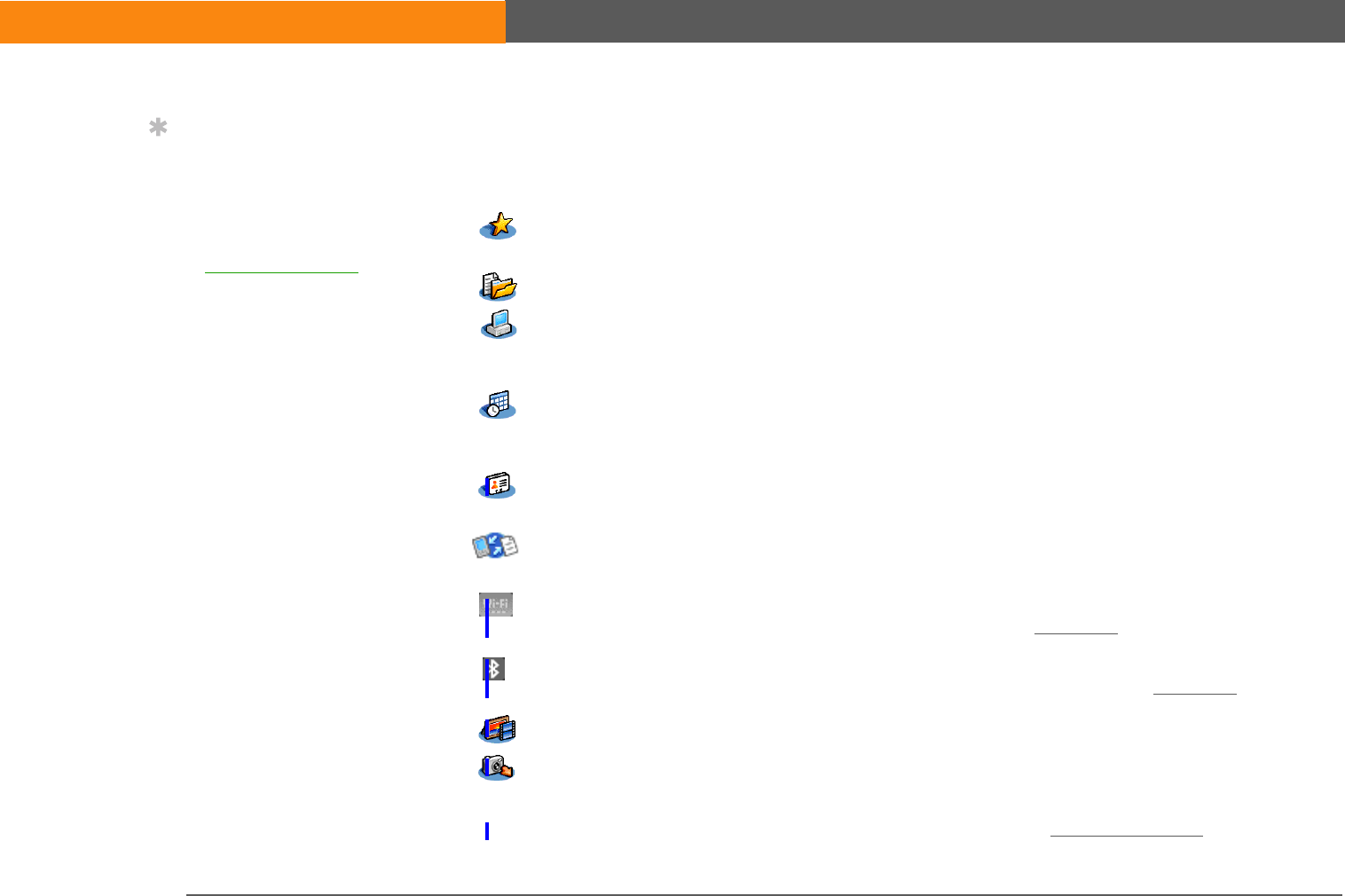
LifeDrive from palmOne 30
CHAPTER 2 Your Mobile Manager
What software is on my device?
Your device comes with many applications preinstalled and ready to use.
0
Favorites Customize a list of your favorite applications, files, and folders so that you can
locate and open them quickly.
Files View, organize, and open files and folders on your device’s drive.
Drive Mode Connect your device as a USB removable drive on another computer. Open files
stored on your device on the computer, and move, copy, and manage files
between your device and the computer.
Calendar Manage your schedule from single entries, like lunch with a friend, to repeating
and extended events, like weekly meetings and holidays. Even color-code your
schedule by category.
Contacts Store names and addresses, phone numbers, email and website addresses; even
add a birthday alarm or a contact’s photo.
Documents Create, view, and edit Microsoft Word and Excel files. View and manage
PowerPoint files.
Wi-Fi controls Set up wireless connections to a Wi-Fi network for sending and receiving
information. Access these controls from the status bar.
Bluetooth
controls
Set up wireless connections to a mobile phone, network, or computer for sending
and receiving information. Access these controls from the status bar.
Media View, share, and organize photos and videos.
Camera
Companion
Import photos and videos from your digital camera’s memory card, open them
and work with them on your device, or copy them to your computer. After
importing items, delete them from the card to make room there for more photos
and videos. This icon is named Companion in Applications View.
Tip
Can’t find some of these
applications? Press the
Home button twice and
use the Category pick list
to view more applications
in Applications View.
SECOND DRAFT palmOne, Inc. Confidential
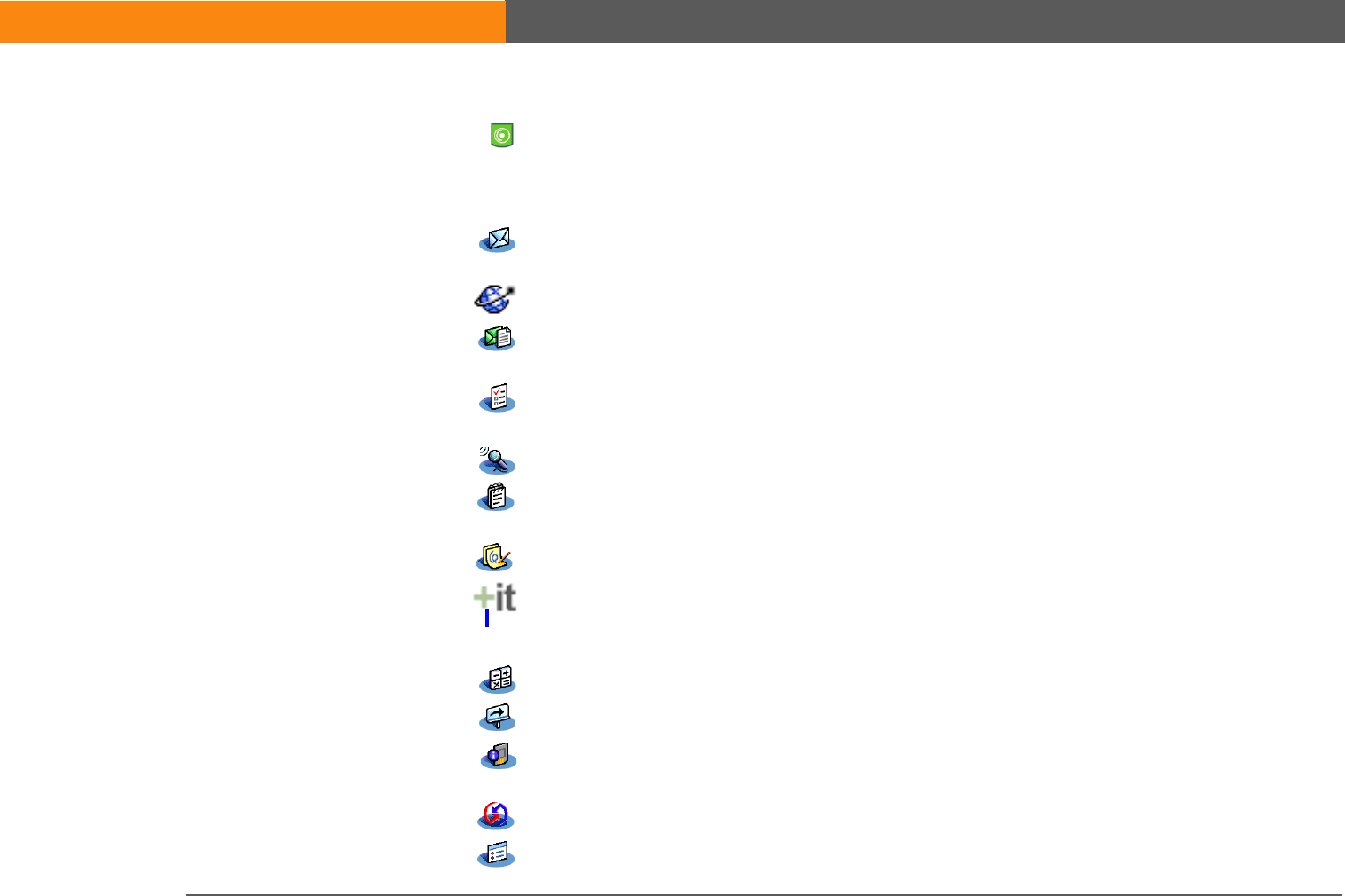
LifeDrive from palmOne 31
CHAPTER 2 Your Mobile Manager
Pocket Tunes™ Carry music, create playlists, and listen to music on your device. This application
works with the Windows Media Player desktop application that you can install
from the CD (Windows only). Both Mac and Windows users can use Pocket Tunes
on the device.
VersaMail®Send, receive, and manage email messages wirelessly using your device’s
wireless capabilities or by synchronizing with your Windows computer.
Web Browse your favorite sites on the web using your device’s wireless capabilities.
SMS Send and receive short text (SMS) messages using your device’s wireless
capabilities.
Ta s k s Stay on top of your to-do list. Enter things you need to do, prioritize them, set
alarms, and then monitor your deadlines.
Voice Memo Record short voice clips using the built-in microphone.
Memos Capture information such as meeting notes, lists of books to read, movies to see,
recipes, and anything else you need to write down.
Note Pad Write on the screen in your own handwriting or draw a quick sketch.
Addit™ Preview, try, and buy software for your device. (Windows only for downloads
using the sync cable; both Windows and Mac users can download software using
your device’s wireless capabilities. Internet connection required.)
Calculator Do basic math calculations such as splitting restaurant bills and figuring tips.
Quick Tour Learn about your device and how to enter information.
Card Info View information about your device’s drive or about an expansion card seated in
the expansion card slot.
HotSync®Synchronize info on your device with the info on your computer.
Prefs Customize your device’s sound levels, colors, security, and more.
SECOND DRAFT palmOne, Inc. Confidential
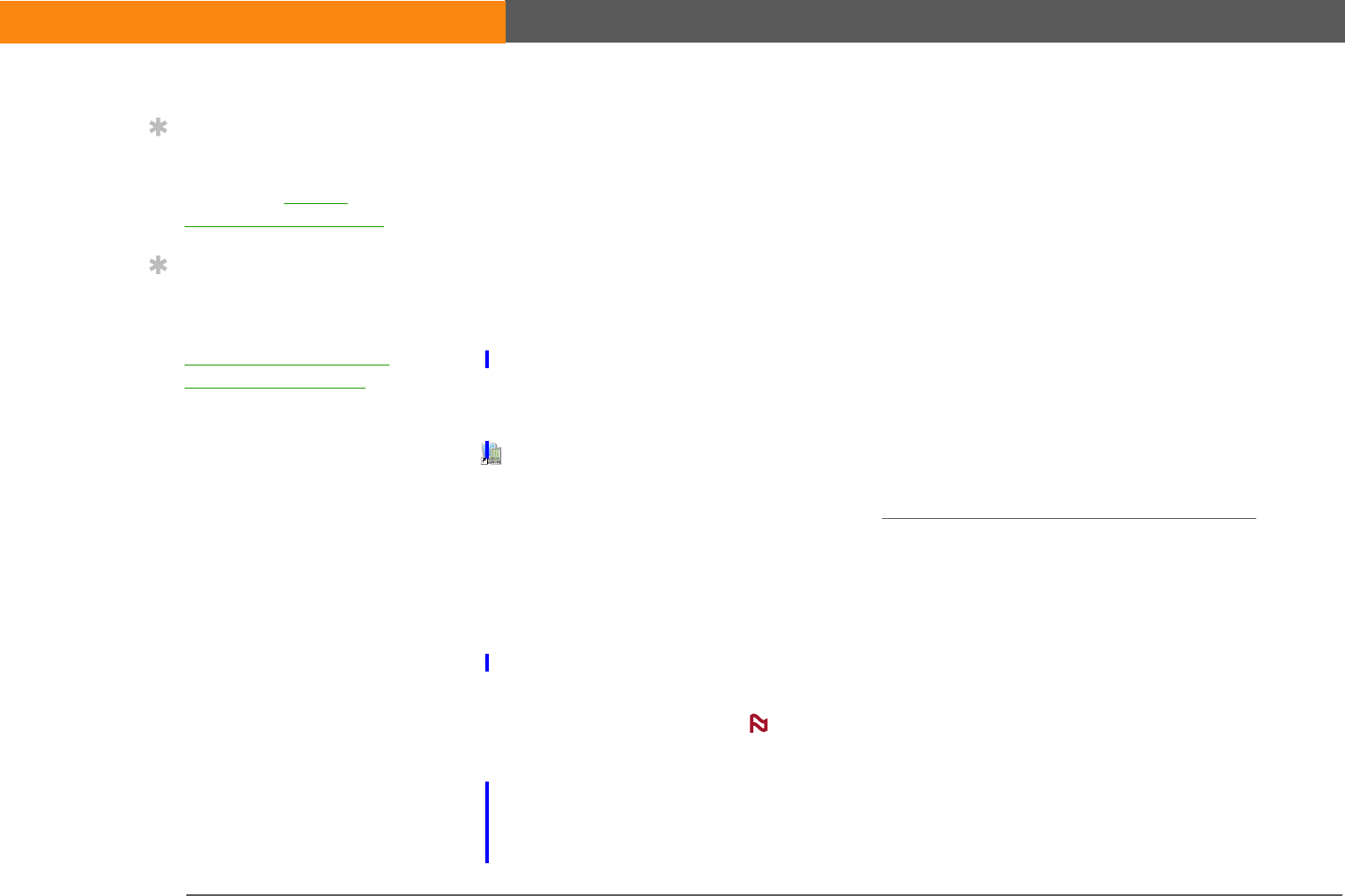
LifeDrive from palmOne 32
CHAPTER 2 Your Mobile Manager
What’s on the CD?
The LifeDrive™ software installation CD includes desktop software for your computer and
additional software for your device.
The desktop software lets you use your computer to view, enter, and manage info for many of the
applications on your device. Make sure you install the desktop software so that you can back up
and save the info on your device onto your computer.
The additional device software lets you do more things with your device. When you set up your
device you may install some (or all) of these applications. You can install any of the applications at
any time after you set up your device, as well.
The software installation CD includes titles such as the following:
0
Palm®Desktop software View, enter, manage, and back up info for Calendar, Contacts, Tasks,
Memos, Expense, and Voice Memo on your computer (Expense is
Windows only). You can also view, manage, and back up info for Note
Pad. When you synchronize your device with your computer, this info
is updated in both places.
On a Windows computer, use Quick Install within Palm Desktop
software to install applications (PRC) to your device or to an expansion
card that is seated in the expansion card slot.
Palm Desktop is installed automatically during the initial CD
installation process.
During CD installation, you can choose to synchronize your
device with Microsoft Outlook on your computer (Windows only). If
you do, information from Contacts, Calendar, Tasks, and Memos is
synchronized with info in the corresponding application in Outlook.
(Memos is called Notes in Outlook.) Information for Expense, Note
Pad, and Voice Memo is still synchronized with the corresponding info
in Palm Desktop software.
Tip
To learn how to install the
desktop software from
the CD, see Step 3:
Installing your software.
Tip
To learn how to install
additional device
software from the CD, see
Installing the additional
software from the CD.
NOTE
SECOND DRAFT palmOne, Inc. Confidential
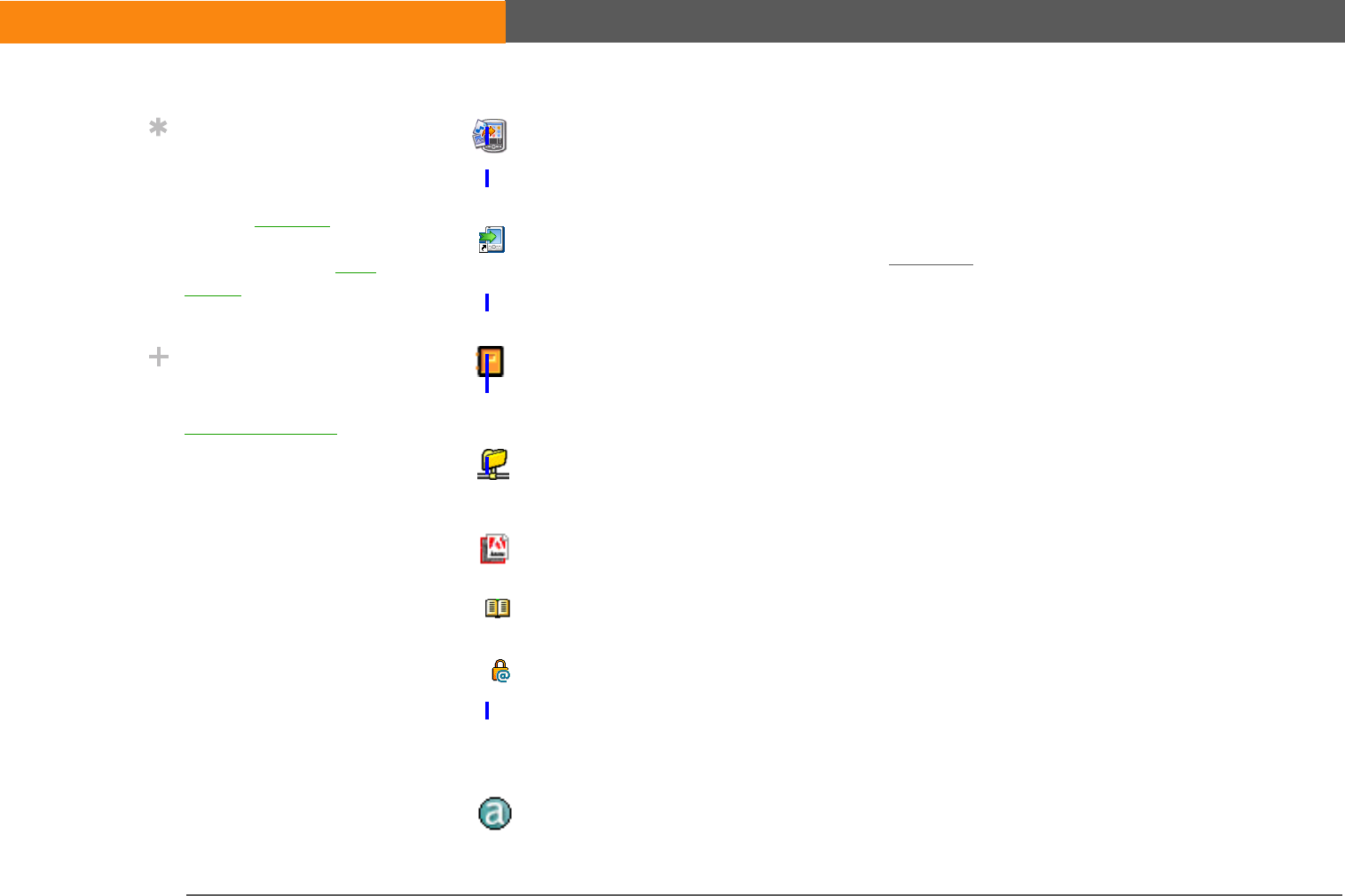
LifeDrive from palmOne 33
CHAPTER 2 Your Mobile Manager
Send To Handheld droplet
(Mac only)
Install applications from your Mac computer to your device or to an
expansion card that is seated in the expansion card slot for use on your
device. This application is installed automatically during the initial CD
installation process.
LifeDrive Manager
(Windows only)
Install applications and transfer folders and files from your Windows
computer to the hard drive on your device or to an expansion card,
synchronize files and folders, and convert photos and videos for
viewing on your device. This application is installed automatically
during the software CD installation process.
Manual Install a version of the Getting Started guide on your device. You can
also access the full Acrobat version (PDF) of Getting Started from the
Help menu of Palm Desktop software, where it’s added during the
initial installation process.
WiFile™ Access your wireless network so that you can open photos, music files,
and documents that are located in shared folders on a networked
computer.
Adobe Reader
for Palm OS®
View PDF files that are tailored to fit your device’s screen.
Power by Hand eReader Purchase and download eBooks from the web so you can read them
when you want, where you want.
Enterprise Software link Create a secure wireless connection to your corporate network in order
to safely send and receive email messages and access the corporate
intranet with a VPN client. Enable robust security for secure Wi-Fi
authentication and connection to a network. Encrypt individual files
and folders to protect your critical information (download requires
Internet connection).
AudiblePlayer Listen to newspapers, books, public radio, language instruction, and
more (Windows only; download requires Internet connection;
additional fees may apply).
Tip
After you install an app
and discover how
valuable it is, be sure to
add it to Favorites. Assign
your most important
application to the Star
button so that you can
open it with one press.
Did You Know?
You can categorize
applications in
Applications View. Some
apps are automatically
assigned to a category
when you install them;
others are assigned to the
Unfiled category. Apps
from all categories
appear in the All
category. Assign an
application to a category
in Applications by
selecting Category in the
App menu. Select the pick
list next to the
application’s name; then
select a category.
SECOND DRAFT palmOne, Inc. Confidential
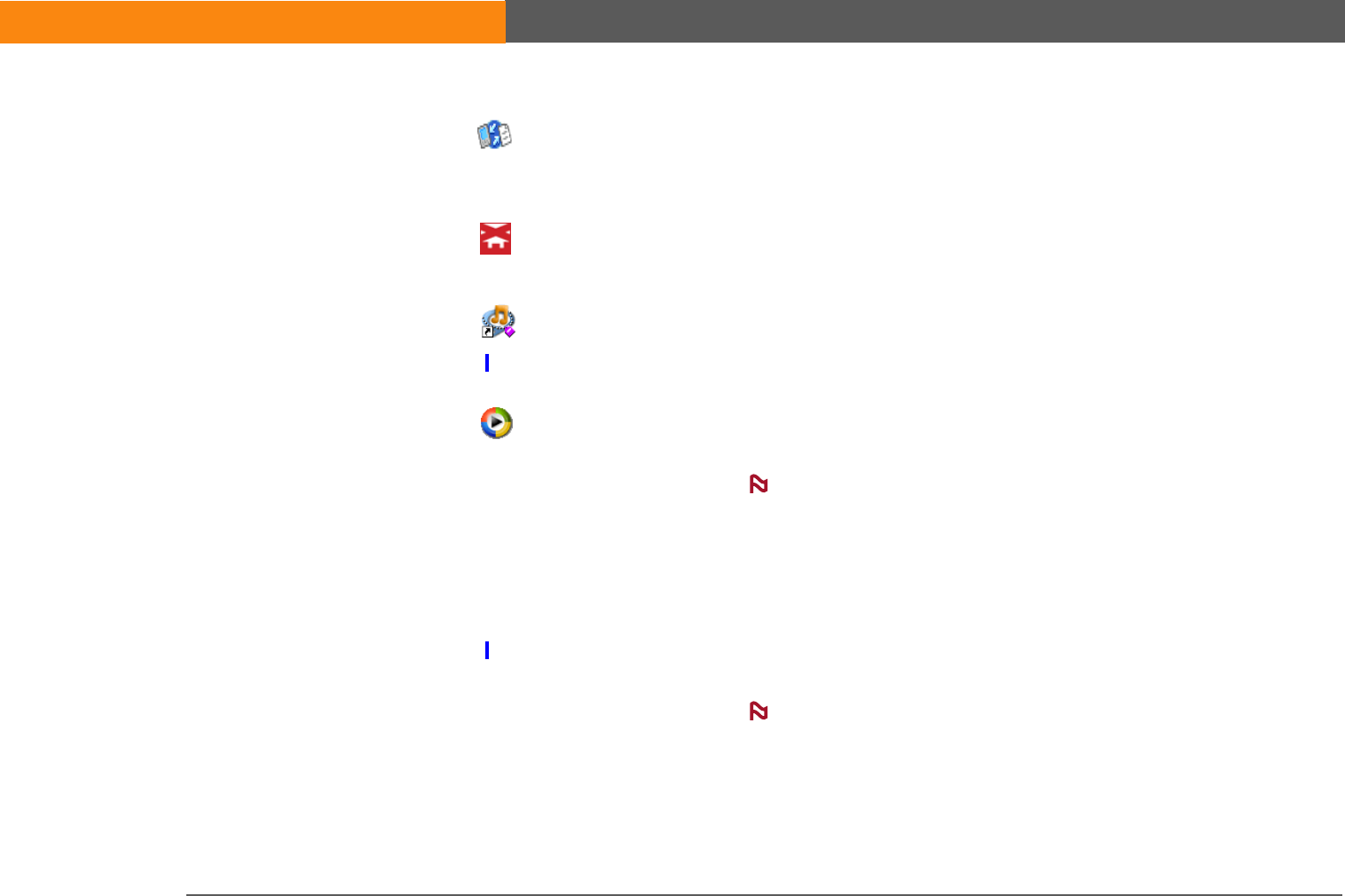
LifeDrive from palmOne 34
CHAPTER 2 Your Mobile Manager
Documents To Go Companion desktop software for the Documents application on your
device. Lets you move or copy Microsoft Word, Excel, and PowerPoint
files to the Documents folder on your device’s drive, as well as create
and edit files.
Handmark Express Download current news as well as information on the weather, stocks,
sports, movies, and more (download requires Internet connection and
subscription to service with Handmark).
RealRhapsody Transfer MP3 music files from your computer to your device or to an
expansion card (sold separately), and copy music from your CDs to
your computer. This is the desktop companion for the Pocket Tunes
music application on your device (Windows only).
Windows Media Player
link/Direct X
Required to prepare videos for playback on your device (Windows
only).
We recommend that you install the Windows Media Player/
Direct X software from the CD, even if you already have Windows
Media Player on your computer. The version on the CD contains all of
the components needed to prepare videos for playback on your device.
Windows Media Player
plug-in
Works with Windows Media Player to convert music files for playback
using the Pocket Tunes application on your device.
QuickTime Required for preparing videos in certain formats for viewing on your
device.
QuickTime is included on the CD for Windows computers
only. For Mac computers, QuickTime is included in OS X.
NOTE
NOTE
SECOND DRAFT palmOne, Inc. Confidential

LifeDrive from palmOne 35
CHAPTER 2 Your Mobile Manager
Related topics
Click a link below to learn about these related topics:
Setup Installing the desktop software from the CD
Entering
Information
• Entering information with Graffiti 2 characters and shortcuts
• Entering information with the onscreen letter and number keyboards
Moving
Around
• Opening applications and using menus
• Finding information
Managing Info • Synchronizing your device with your computer
• Using LifeDrive Manager and Drive Mode to manage information
between your device and your computer
• Installing additional software from the CD
Sharing • Beaming information and applications to other Palm Powered™ devices
• Sending information and applications to other Bluetooth devices by using
Bluetooth technology on your device
World Clock Viewing the current date and time
Customizing • Setting the current date and time
• Adjusting the brightness of the display
Tips & Tricks
Make your device uniquely
yours. For great tips,
software, accessories, and
more, visit
www.palmOne.com/
mylifedrive.
Support
If you’re having problems
with your device, go to
www.palmOne.com/
support.
SECOND DRAFT palmOne, Inc. Confidential

LifeDrive from palmOne 36
CHAPTER 2 Your Mobile Manager
Maintaining • Caring for your device
• Resetting your device
Common
Questions
Answers to frequently asked questions about your device
SECOND DRAFT palmOne, Inc. Confidential
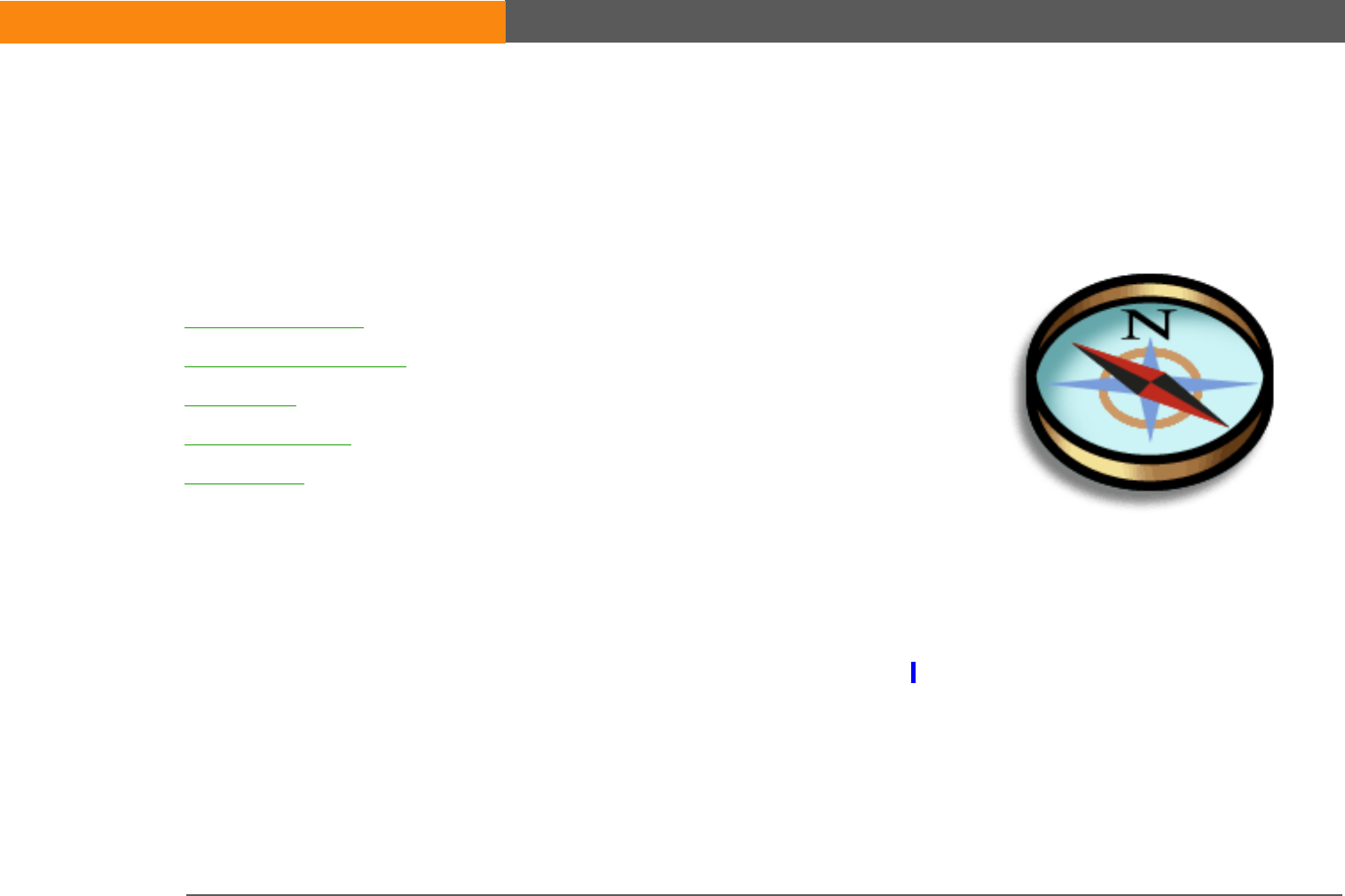
LifeDrive from palmOne 37
CHAPTER 3
Moving Around in Applications
Have you ever been to a new city and
felt a bit lost until you figured out that
the numbered streets run north/south
and the avenues run east/west?
Learning to move around on your
device is similar. Most Palm OS®
applications use the same set of
application controls. So once you learn
how to use these standard controls,
you’ll be driving all over town and you
won’t even need a map. Benefits
• Find and open applications quickly
• Access extra features with menus
• Move around in applications with one
hand, using the 5-way navigator
• Locate information in any application
with the Find feature
I
n t
hi
s c
h
apter
Opening applications
Using the 5-way navigator
Using menus
Finding information
Related topics
SECOND DRAFT palmOne, Inc. Confidential
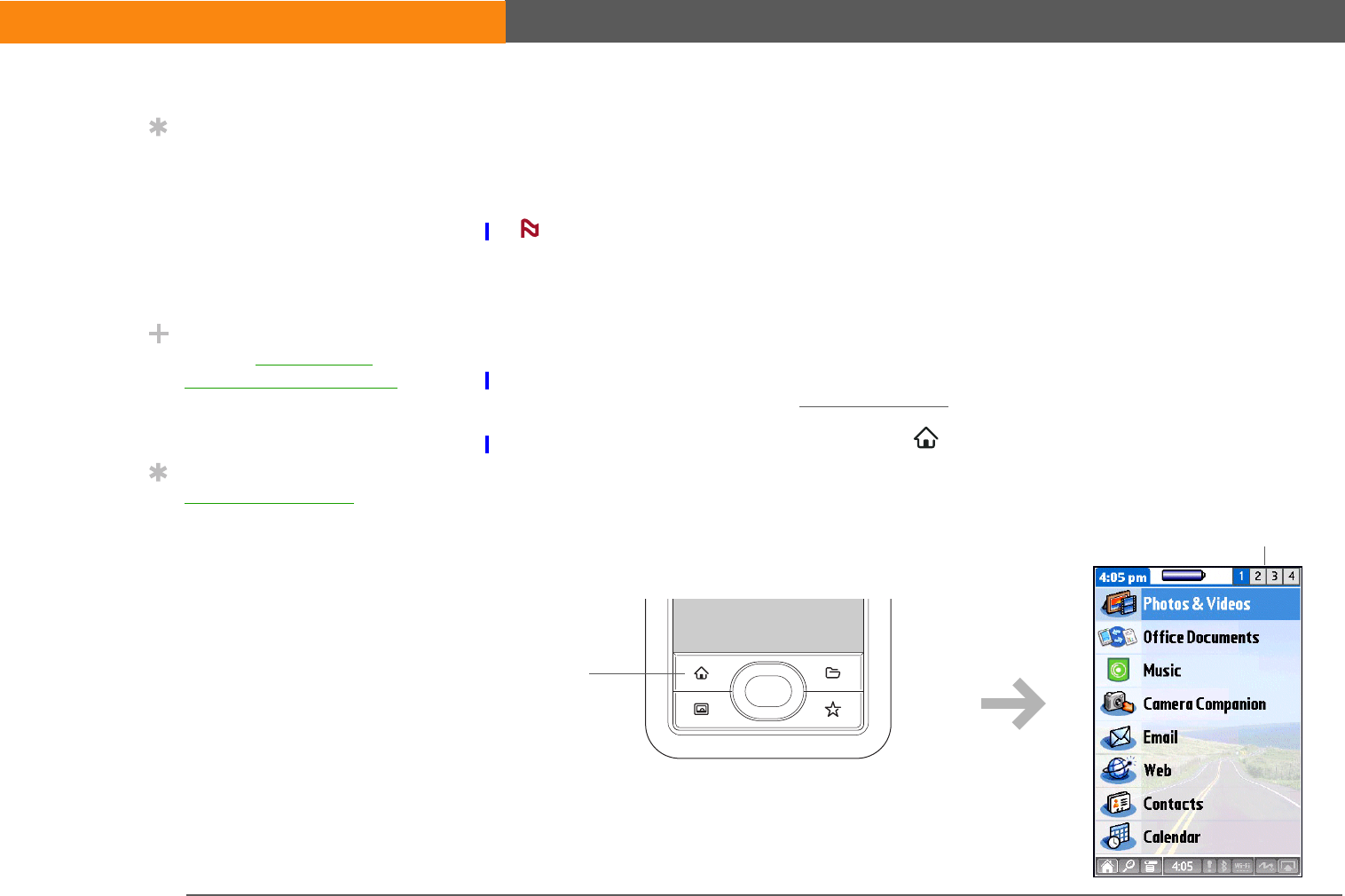
LifeDrive from palmOne 38
CHAPTER 3 Moving Around in Applications
Opening applications
You can open applications from Favorites View or Applications View, or by using the Files
application.
Some applications are listed differently in Favorites and Applications views. For
example, the Photos & Videos entry in Favorites opens the Media application, which is listed as
Media in Applications View. The application icons are similar in both Favorites and Applications.
Using Favorites
Favorites View contains up to 32 items—four pages of eight items each—and can include
applications, specific files, folders, and even links to the web. Certain items are included in
Favorites by default, but you can customize the list to contain any items you want.
To access an item from Favorites, press Home and select an item from the list. Use the 5-way
navigator or tap the buttons in the upper-right corner of the screen to move to another page of
favorites.
Tip
Press Home once to open
Favorites; press Home
twice to open
Applications. Switch
between Favorites and
Applications by pressing
Home.
Did You Know?
You can use a favorite
photo as the background
for your Favorites or
Applications View.
Tip
Customize Favorites to
display folders—for
example, a project folder
that you access often.
Select the folder to view
its contents.
NOTE
Home
Tap to move to other pages of favorites
SECOND DRAFT palmOne, Inc. Confidential
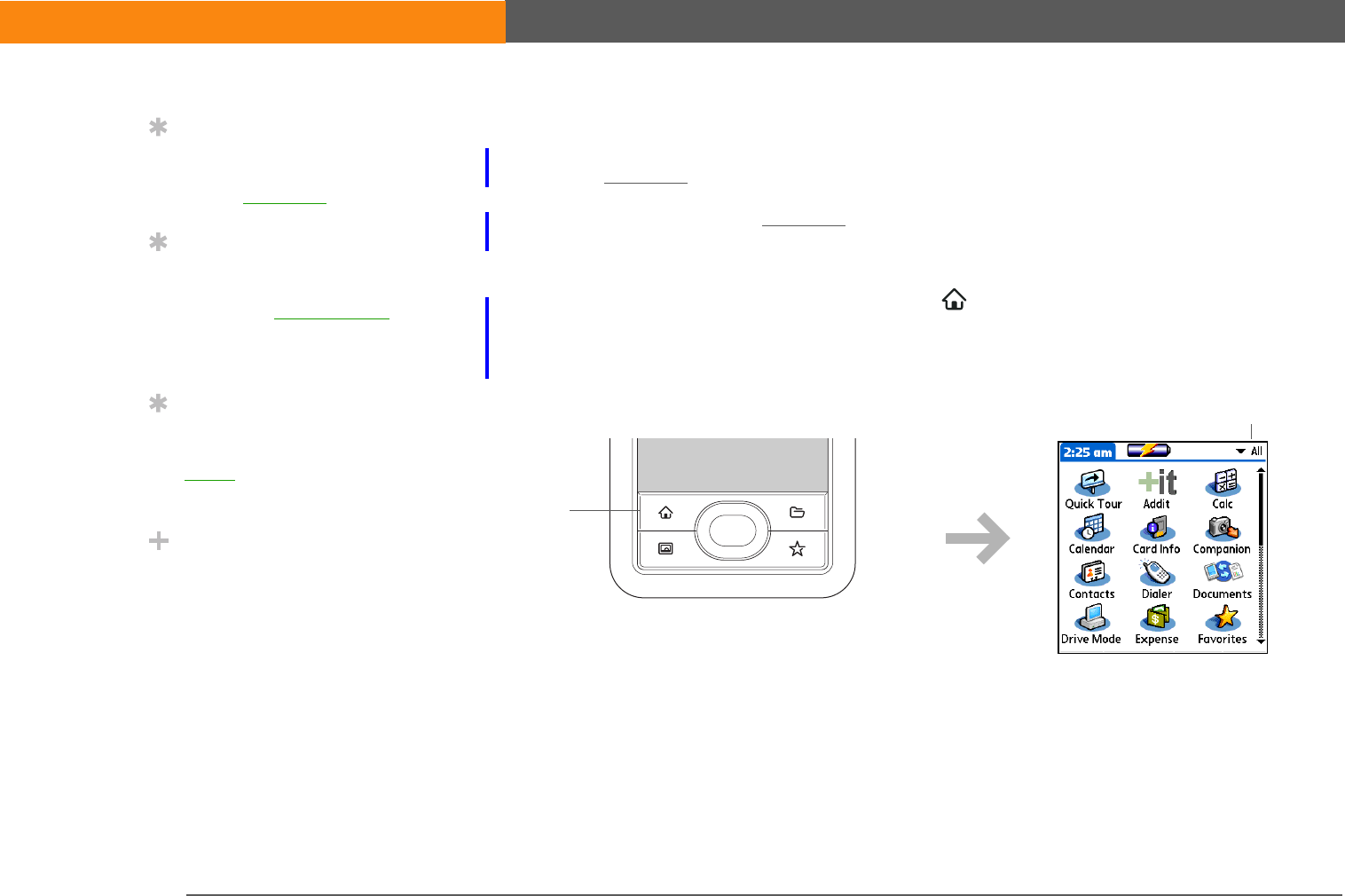
LifeDrive from palmOne 39
CHAPTER 3 Moving Around in Applications
Using Applications
Applications View shows all of the applications on your device, except those that are accessed
using the status bar. Use the category pick list in the upper-right corner of the screen to view
applications by category or to see all applications. From the pick list, you can also select to view
the contents of your device’s hard drive (it’s called Internal Drive on the pick list) or of an expansion
card (it’s called Card1 or whatever you’ve named the card) if one is inserted into the expansion
slot.
To access an item from Applications, press Home twice and select an icon. When you press
Home twice, it displays the same category of applications that was displayed the last time
Applications was open. Use the category pick list to view another category or to see all
applications, the contents of the hard drive, or the contents of an expansion card.
Tip
Also open Applications
by tapping the Home icon
on the status bar.
Tip
You can also open a
specific application using
one of the quick buttons
on the front of your
device.
Tip
When no item is selected,
press Right or Left on the
5-way to scroll through
application categories.
Did You Know?
Applications View
displays an icon for
opening Favorites.
Favorites View contains
an entry for opening
Applications.
Home
C
ategory p
i
c
k
li
st
SECOND DRAFT palmOne, Inc. Confidential
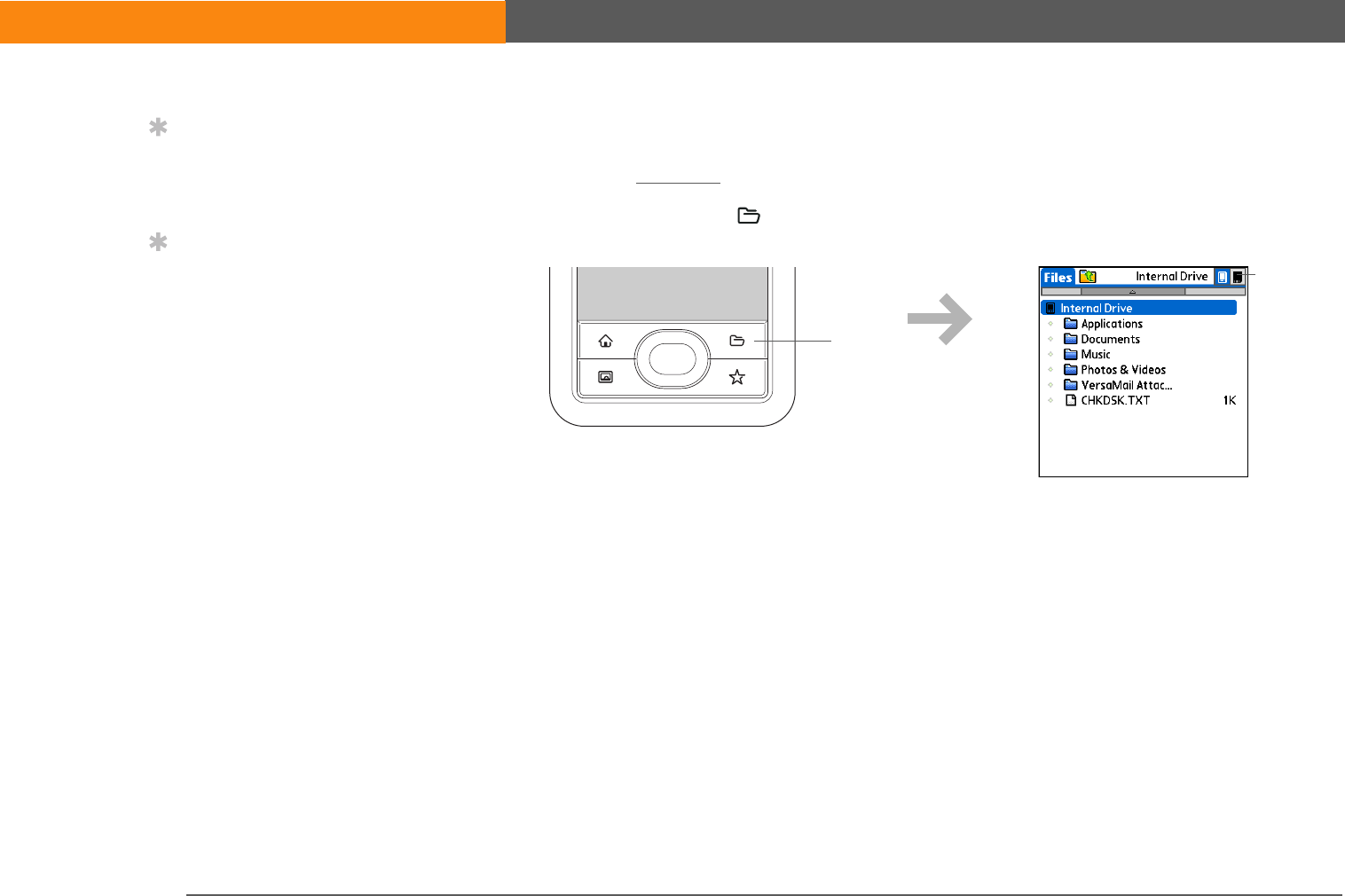
LifeDrive from palmOne 40
CHAPTER 3 Moving Around in Applications
Using Files
The Files application enables you to easily open, view, and move among the files and folders on
your device’s hard drive or on an expansion card inserted into your device’s expansion slot.
To open Files, press Files on the front of your device.
Tip
You can also open Files
by selecting Files in
Applications View.
Tip
If you have an expansion
card (sold separately)
inserted into your
device’s expansion slot,
select the card icon in
Files to view the contents
of the card.
Files
C
ar
d
icon
SECOND DRAFT palmOne, Inc. Confidential
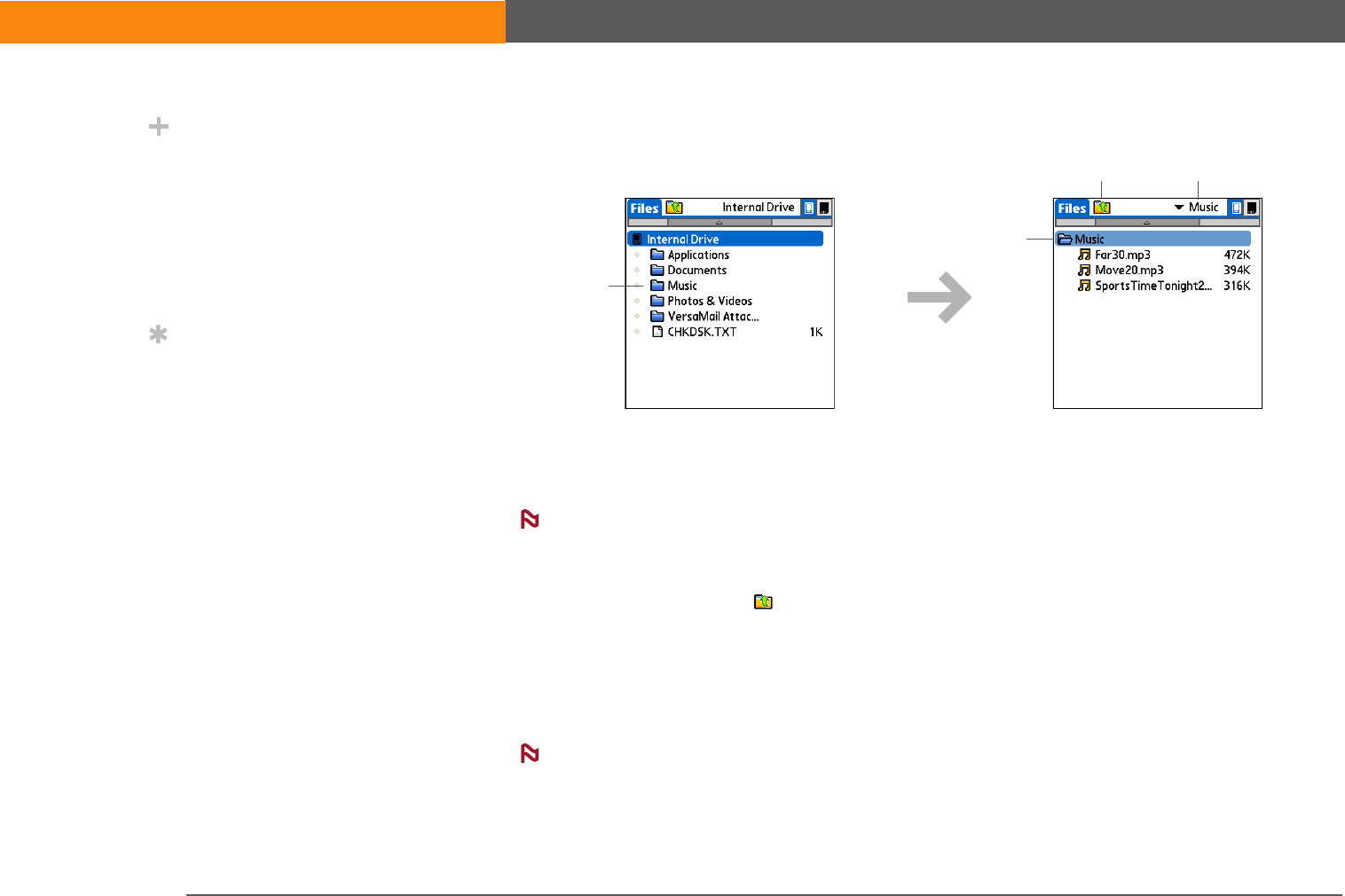
LifeDrive from palmOne 41
CHAPTER 3 Moving Around in Applications
Navigate within Files by doing any of the following:
• Select a file or folder to open it. The file opens in the corresponding application—for example,
Documents for Word, Excel, or PowerPoint files.
If your device contains an application that can open a file, a file-specific icon appears to
the left of the file name in the Files list. If a generic icon appears to the left of a file name, you
cannot open the file on your device.
• Select the Folder Up icon to move up one level of folders.
• Select the pick list at the top of the files screen to view and jump to the top-level folder and any
subfolders.
• Select the top-level folder on the files screen to move up one level of folders.
Files always displays these five folders at the top of the folder list: Applications,
Documents, Music, Photos & Videos, and VersaMail Attachments. Place your applications and files
in the correct folder so that you can easily locate them.
Did You Know?
If you select a file from
within Files, it
automatically opens in
the correct application on
your device. If there is no
application for that file, a
beep alert sounds.
Tip
Tap and hold the stylus
on a file or folder to open
a menu of actions you
can do with that item—
copy, delete, and so on.
Select folder
F
o
ld
er up
F
o
ld
er p
i
c
k
li
st
Top-level folder
NOTE
NOTE
SECOND DRAFT palmOne, Inc. Confidential
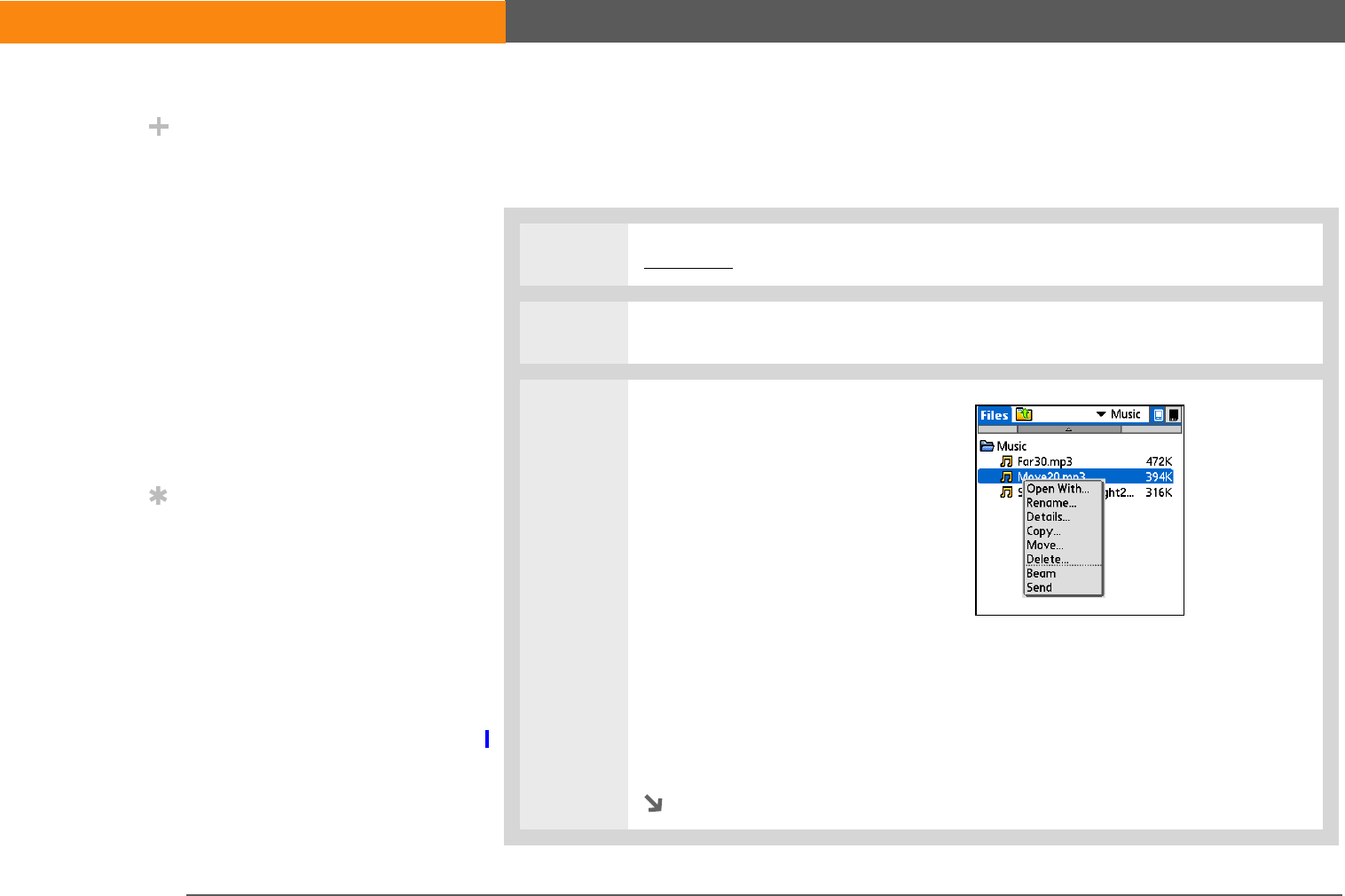
LifeDrive from palmOne 42
CHAPTER 3 Moving Around in Applications
Working with files and folders
You can work with the files and folders in the Files application—create new folders; copy, beam,
and delete files and folders; and more. You can work with one file or folder at a time.
0
1Open Files.
2Navigate to the file or folder you want.
3Work with the file or folder:
a. Tap and hold the item name to
open a menu that lets you
perform any of the following
tasks:
Open With Select the application
to use to open a file.
Rename Rename the selected item.
Details View details such as name, including extension for files; location on
the hard drive or expansion card; last date modified; and, for files only, size.
Check the box to make the selected item read-only, meaning that it cannot be
changed by a user. You can rename or delete a file or folder from the Details
dialog box.
Continued
Did You Know?
If you select Open With,
only applications that can
open the file you have
selected are displayed.
You can select one of the
applications displayed to
make it the default
application for opening
this file type. If no
application appears, that
means there is no
application on your
device that can open the
selected file.
Tip
You can also highlight a
file or folder and then
press Right on the 5-way
to open the menu of
tasks.
SECOND DRAFT palmOne, Inc. Confidential
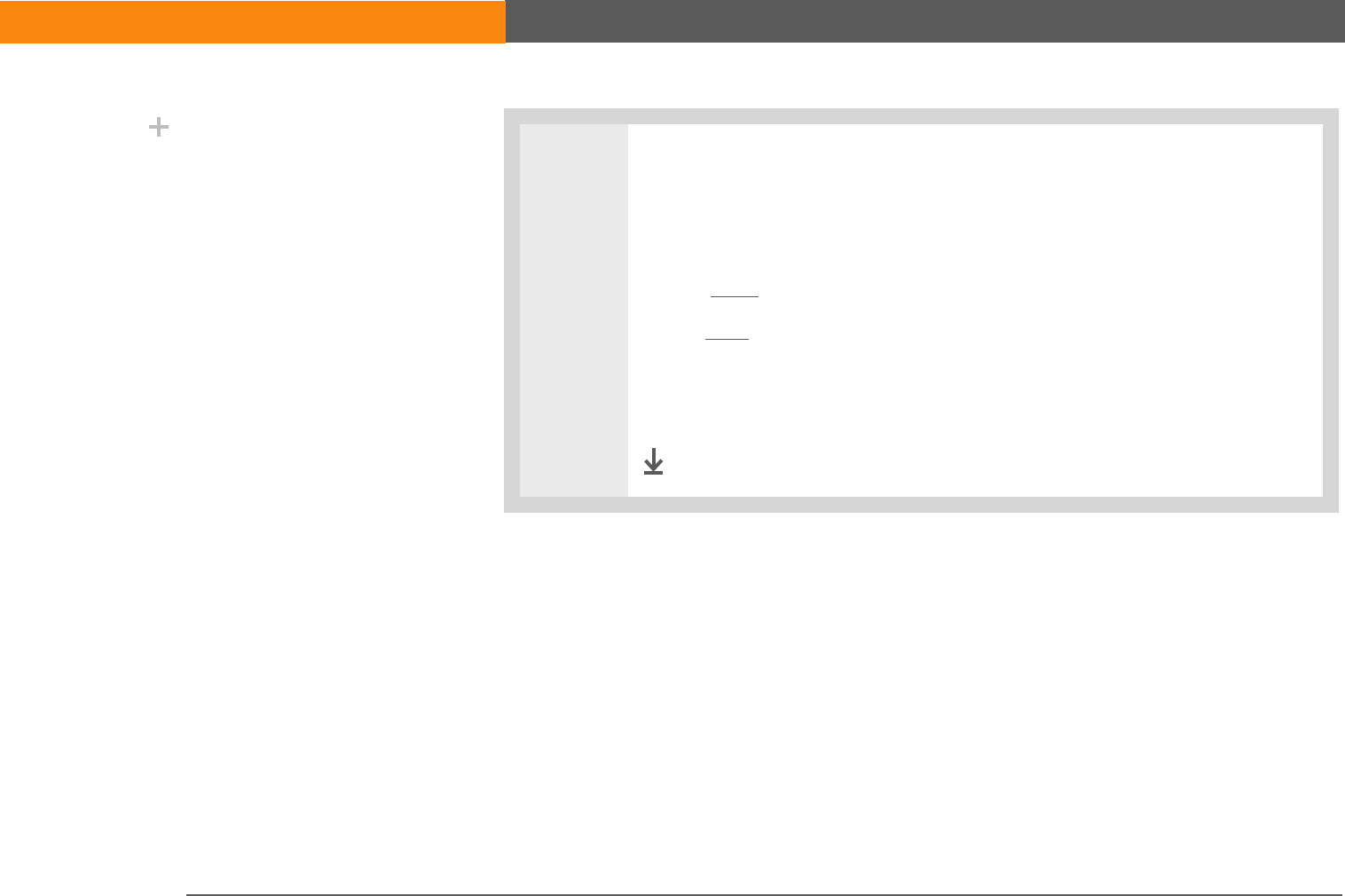
LifeDrive from palmOne 43
CHAPTER 3 Moving Around in Applications
Cont’d.
Copy Copy the item to another location on the drive or an expansion card.
Move Move the item to another location on the drive or an expansion card.
Delete Delete the current file or folder.
Beam Beam the file or folder.
Send Send the current file or folder using your device’s built-in Bluetooth®
wireless technology or as an attachment to a text message or email message.
b. Select the task you want to perform on the file or folder, and follow any
onscreen instructions.
Done
Did You Know?
If you select Delete, you
get a message asking you
to confirm the deletion.
SECOND DRAFT palmOne, Inc. Confidential
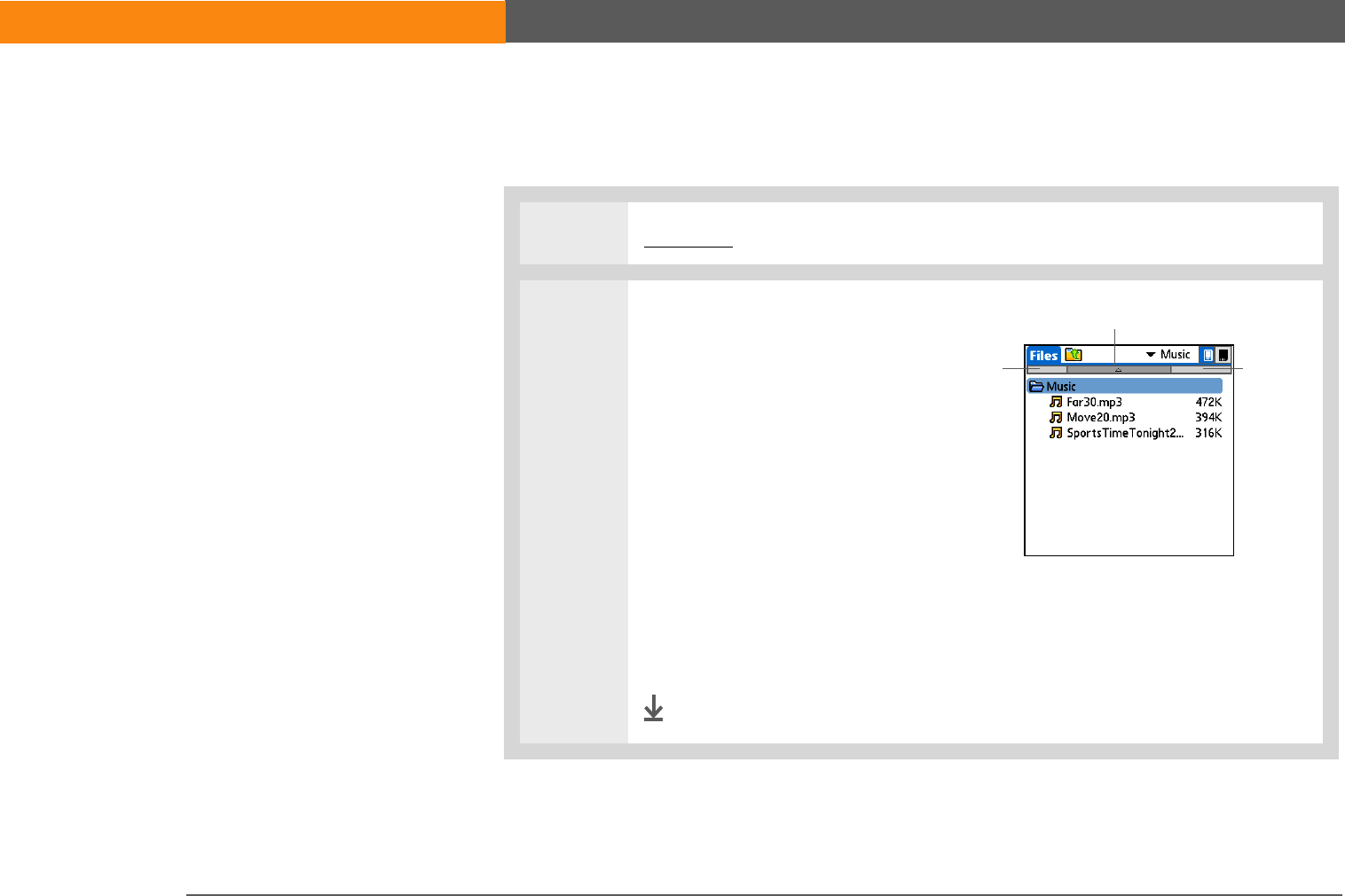
LifeDrive from palmOne 44
CHAPTER 3 Moving Around in Applications
Sorting Files
You can sort your files and folders by icon, name, date, or size.
0
1Open Files.
2Select your sort options:
Sort display Select the column
you want to sort by. From the left
side of the screen, the columns
are icon, name, and size/date.
Sort in ascending or descending
order Select the column you
want to sort by to switch
between ascending and
descending sort order.
Switch between sorting by date
or by size Tap and hold the
rightmost column until the
heading you want appears.
Done
Sort by
icon
Sort by name
Sort by
date or
size
SECOND DRAFT palmOne, Inc. Confidential

LifeDrive from palmOne 45
CHAPTER 3 Moving Around in Applications
Opening files and folders from within an application
In certain applications—for example, Documents, Media, and Pocket Tunes™—you can open a file
or folder directly from within the application. The application automatically displays files located
in the appropriate folder on your device’s hard drive—for example, when you open the Pocket
Tunes application, files in the Music folder on the drive are displayed—but you can browse for files
located elsewhere on the drive. See the application chapters for information on opening files.
Switching between applications
You can switch between applications at any time. Just press Home and select an icon from
Favorites or Applications, or press a quick button. Your device automatically saves your work in
the current application and switches to the other application.
Did You Know?
If you use a command to
open a file from within an
application, only files that
can be opened by that
application are displayed.
For example, in Pocket
Tunes, only music files
such as MP3 files are
displayed.
Tip
You must use the stylus
to tap icons in the input
area or on the status bar.
SECOND DRAFT palmOne, Inc. Confidential
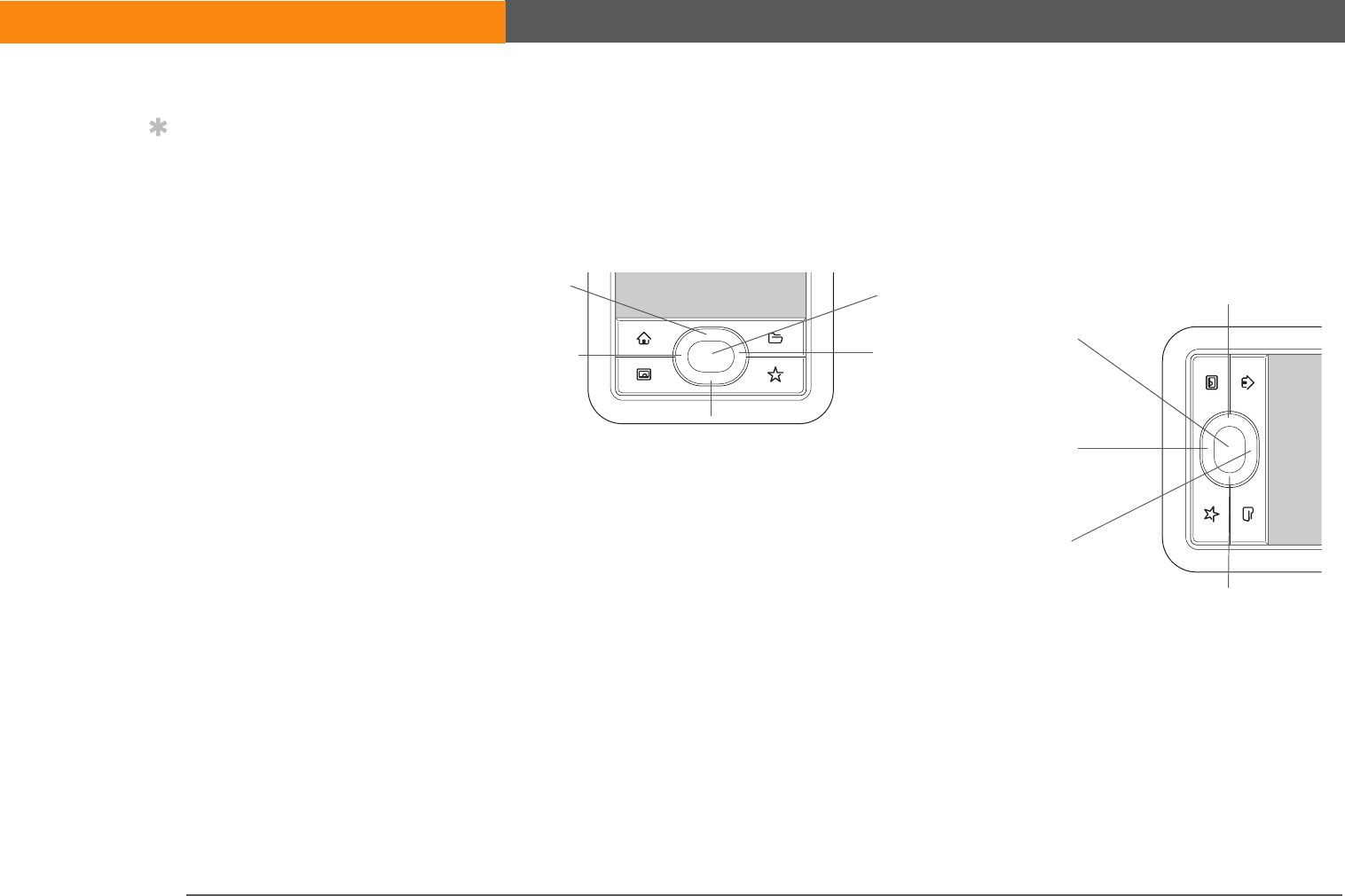
LifeDrive from palmOne 46
CHAPTER 3 Moving Around in Applications
Using the 5-way navigator
The 5-way navigator, located at the bottom of the front panel, lets you access information quickly
with one hand and without the stylus. To use the 5-way, press Up, Down, Right, Left, or Center.
The 5-way does various things based on which type of screen you’re viewing.
Tip
In landscape view, not
only does screen
orientation change, but
so does the orientation of
the 5-way. For example,
in right-handed
landscape view, what was
Up in portrait view
becomes Right in
landscape view.
Up
Down
Right
Left
Center Up
Center
Left
Right
Down
Portrait view
Right-handed
landscape view
SECOND DRAFT palmOne, Inc. Confidential
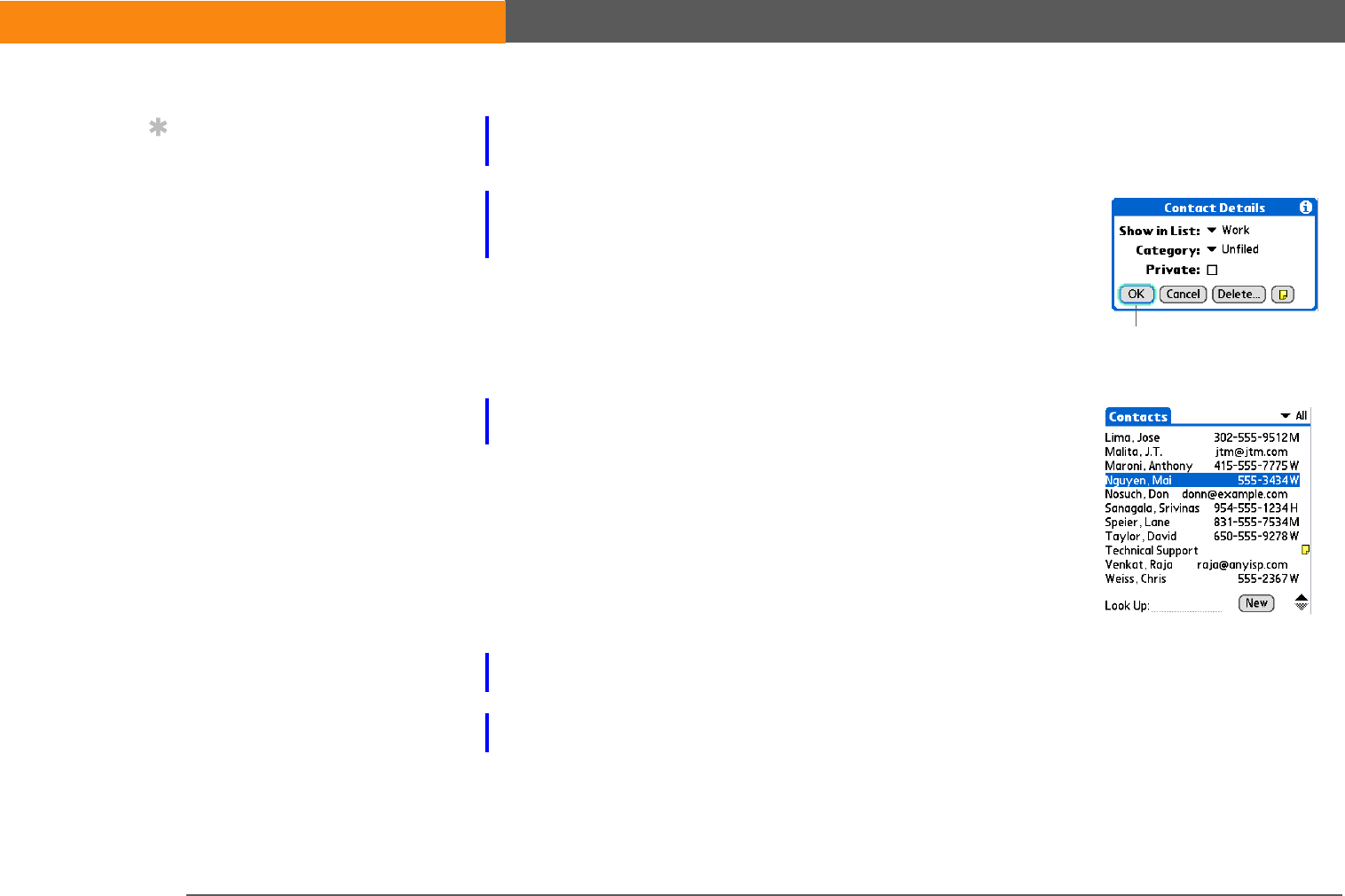
LifeDrive from palmOne 47
CHAPTER 3 Moving Around in Applications
Highlighting items
The 5-way lets you highlight items before opening or selecting them.
• When an onscreen button (OK, Cancel, and so on) or pick
list is highlighted, the button acquires a glow around its
border.
• When an entry on a list screen is highlighted, the text
appears in reverse type (light text on a dark background).
• When a phone number, email address, or web link is highlighted on a web page or in a
message, the text appears in reverse type (light text on a dark background).
• When an entire text entry field is highlighted, you can press Center to edit the text. After you
edit the text, press Center again to highlight the entire field.
Button with
highlight
Tip
You can also use the
stylus to highlight text on
the screen. Drag the
stylus across the text you
want to highlight, double-
tap a word to highlight it,
or triple-tap a line of text
to highlight it.
SECOND DRAFT palmOne, Inc. Confidential
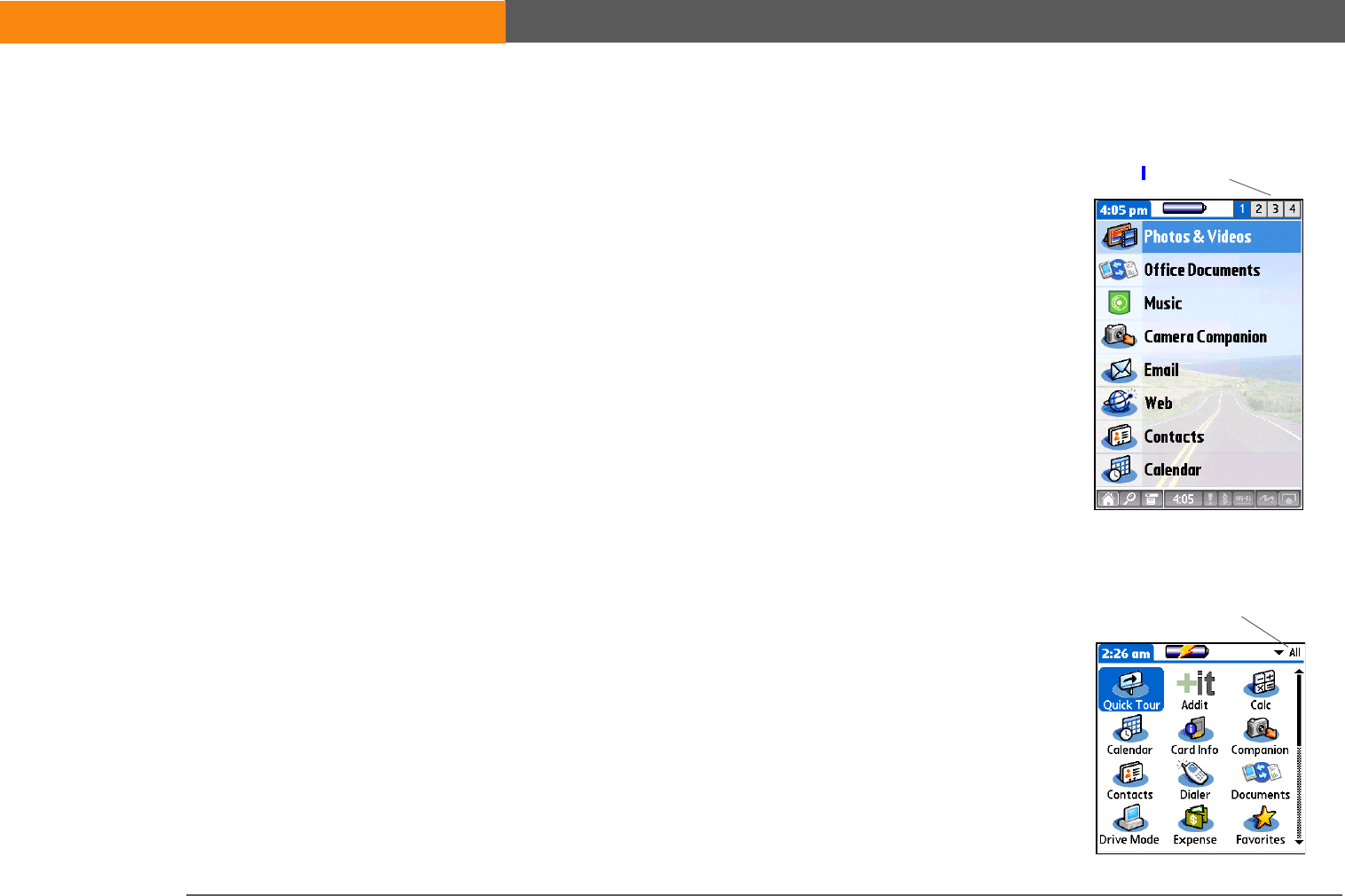
LifeDrive from palmOne 48
CHAPTER 3 Moving Around in Applications
Moving around in Favorites View
Moving around in Applications View
Up or Down Scrolls to the next favorite in the
corresponding direction.
Right or Left Displays the next or previous page of
favorites.
Center Opens the selected item.
Up or Down Scrolls up or down in Applications View.
Right or Left Scrolls to the next or previous application
category.
Center Inserts the selection highlight. When the
selection highlight is present:
Up, Down, Right, or Left Scrolls to the next
item in the corresponding direction.
Center Opens the selected item.
P
ages o
f
f
avor
i
tes
C
ategory
SECOND DRAFT palmOne, Inc. Confidential
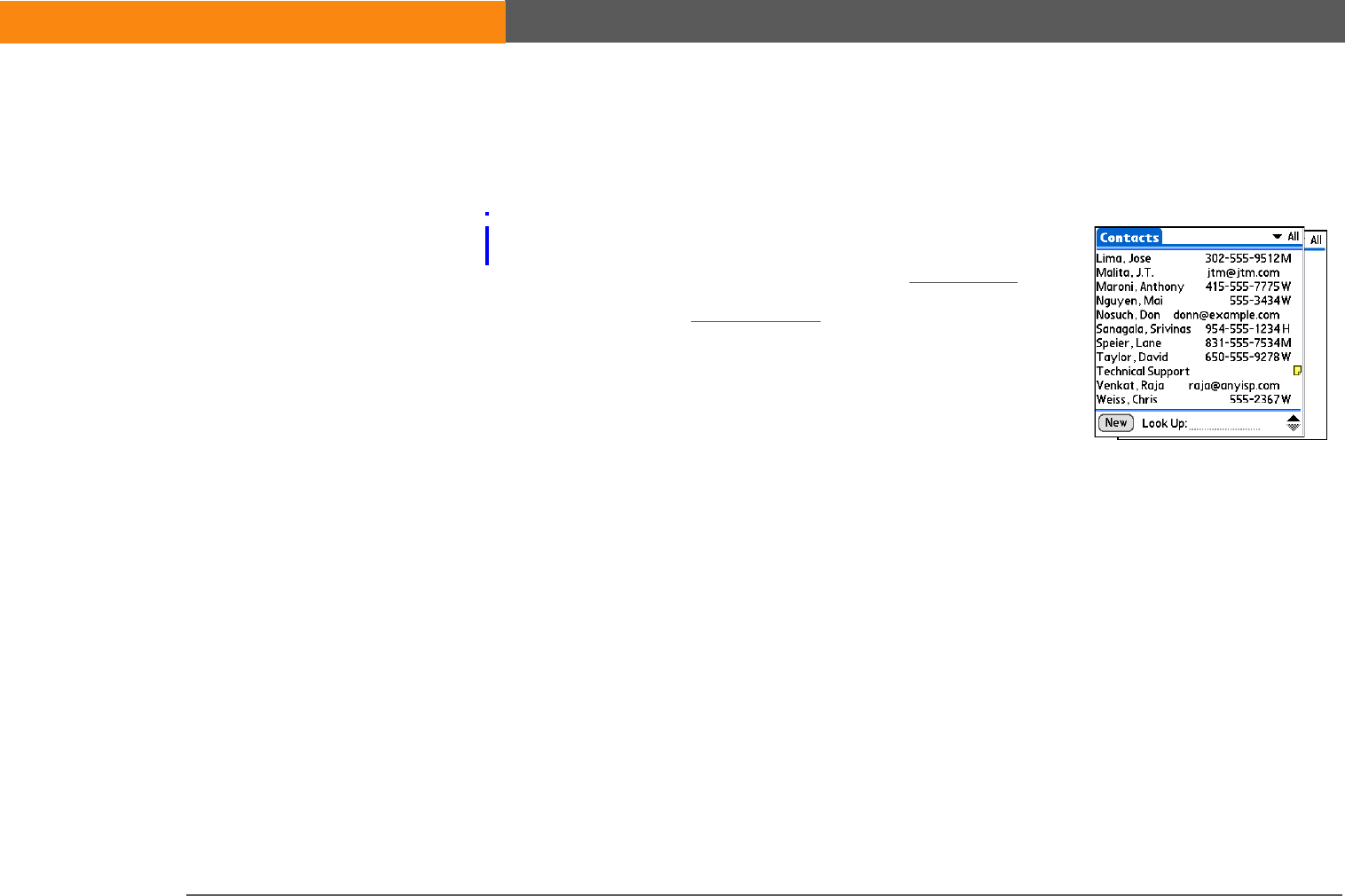
LifeDrive from palmOne 49
CHAPTER 3 Moving Around in Applications
Moving around in list screens
In list screens, use the 5-way to select and move between entries such as notes, memos, contacts,
or photos.
0
Up or Down Scrolls an entire screen of entries when the
entire list is highlighted. Press and hold to
accelerate scrolling when in portrait view.
Left or Right In landscape view, accelerates scrolling
when you press and hold.
Center Inserts the selection highlight. When the
selection highlight is present:
Up or Down Scrolls to the previous or next
entry.
Center Displays the selected entry.
Left Removes the selection highlight.
SECOND DRAFT palmOne, Inc. Confidential
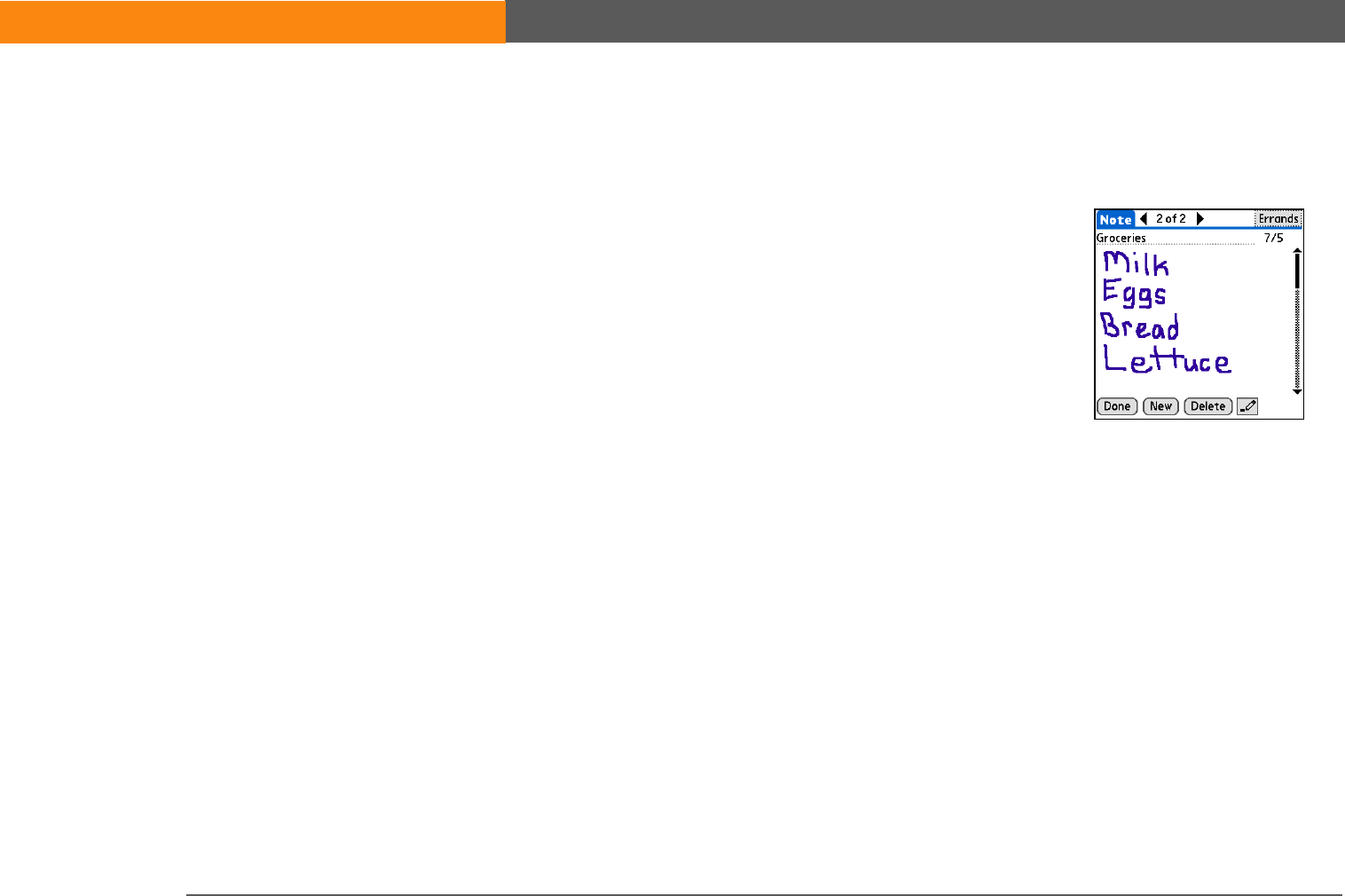
LifeDrive from palmOne 50
CHAPTER 3 Moving Around in Applications
Moving around in entry screens
In entry screens, use the 5-way to scroll within the current entry or between entries.
Moving around in dialog boxes
Dialog boxes appear when you select a button or option that requires you to provide additional
information. In dialog boxes, use the 5-way to select a button or to make a selection from items
such as boxes and pick lists.
Up, Down,
Right, or Left
Scrolls to the next item in the corresponding
direction.
If there is no “up” entry, pressing Up scrolls
left. Likewise if there is no “left” entry,
pressing Left scrolls up.
If there is no “down” entry, pressing Down
scrolls right. If there is no “right” entry,
pressing Right scrolls down.
On some entry screens, pressing Left
highlights the leftmost button at the bottom
of the screen.
Center Inserts or removes the selection highlight.
If a button is highlighted, pressing Center
activates the button.
SECOND DRAFT palmOne, Inc. Confidential

LifeDrive from palmOne 51
CHAPTER 3 Moving Around in Applications
Read dialog boxes carefully. Selecting a button such as OK or Yes may cancel an
action or delete information.
Moving around in menus
After you open the menus you can use the 5-way to move between and to select menu items:
Up, Down,
Right, or Left
Highlights the next item in the dialog box
(pick list, box, button) in the corresponding
direction.
Center • If highlight is on a box: Checks or
unchecks the box.
• If highlight is on a pick list: Opens the pick
list. When a pick list is open:
Up or Down Scrolls to the previous or
next entry.
Center Selects the highlighted entry.
• If highlight is on a button: Activates the
button, and then closes the dialog box.
Up or Down Scrolls within the current menu list.
Right or Left Scrolls to the next or previous menu on the
menu bar.
Center Selects the highlighted menu item.
Box
Pick list
Button with
highlight
IMPORTANT
[!]
SECOND DRAFT palmOne, Inc. Confidential
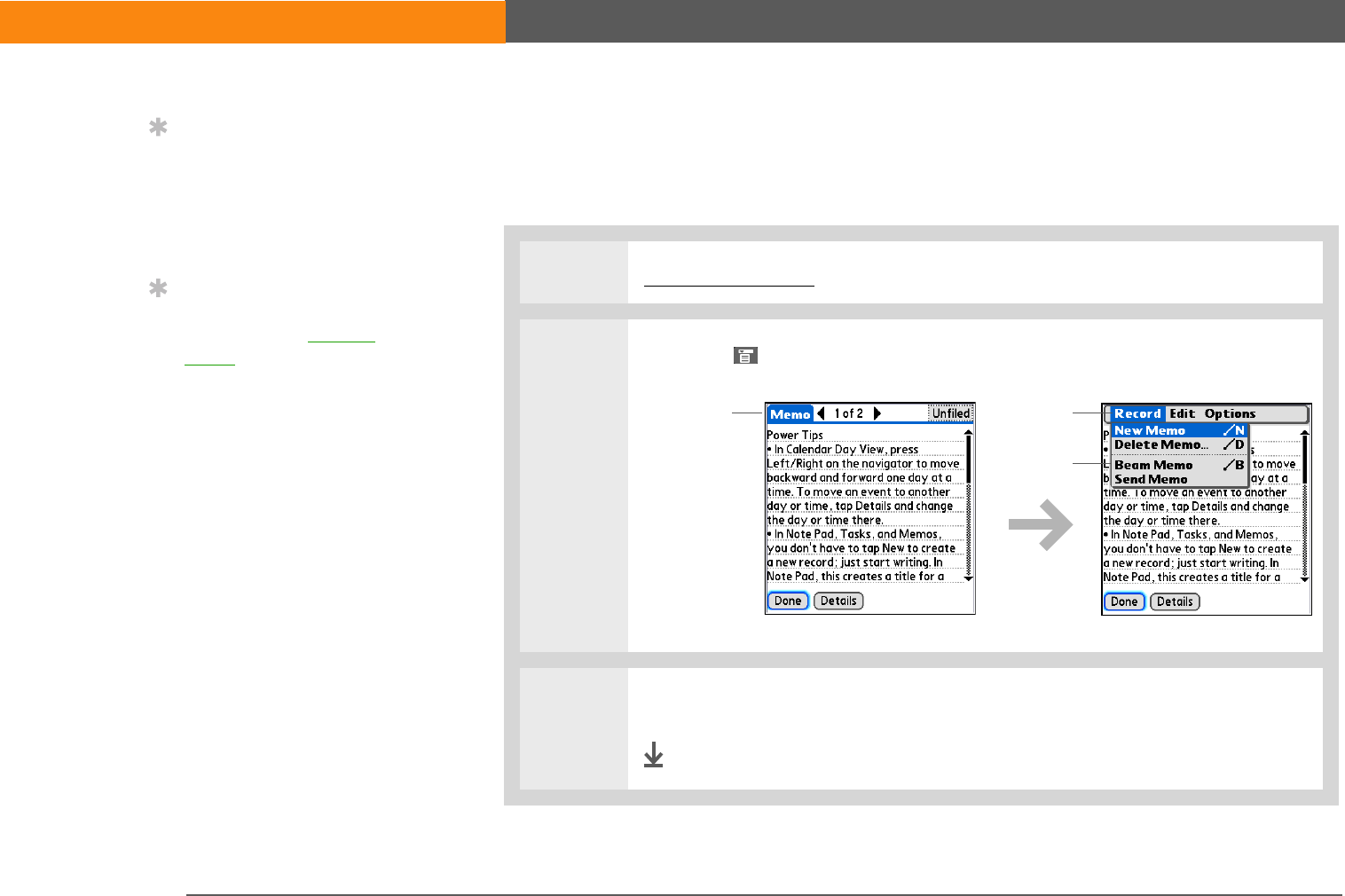
LifeDrive from palmOne 52
CHAPTER 3 Moving Around in Applications
Using menus
Menus let you access additional features and settings. They are easy to use, and once you master
them in one application, you know how to use them in all your applications.
0
1Open an application.
2Tap Menu on the status bar.
.
3Select a menu title, and then select a menu item.
Done
Tip
You can also open the
device menus by tapping
the application title in the
upper-left corner of the
screen.
Tip
When the menus are
open, you can use the
5-way to select menus
and menu items.
Application
title
Menu
item
Menu
SECOND DRAFT palmOne, Inc. Confidential
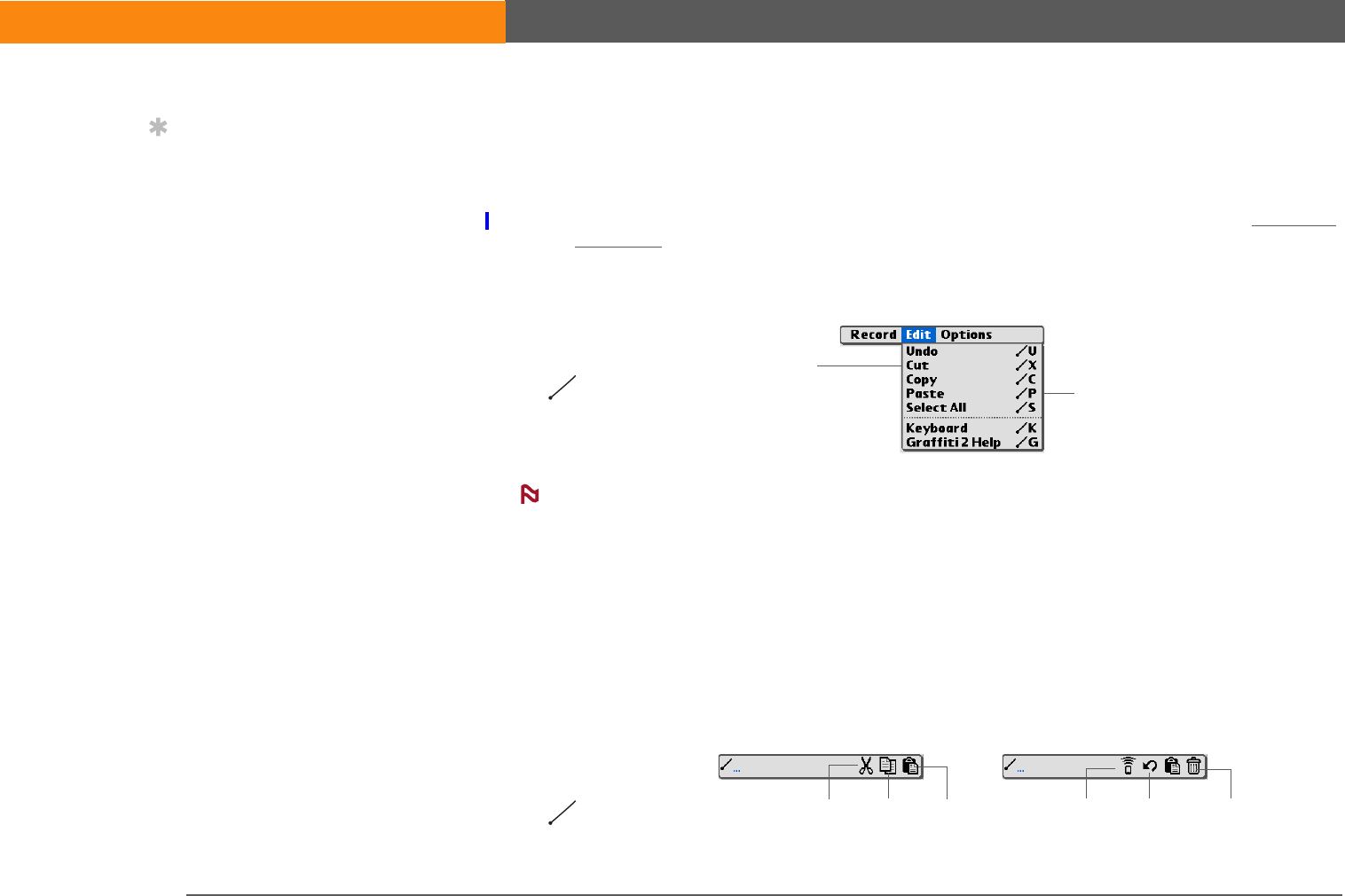
LifeDrive from palmOne 53
CHAPTER 3 Moving Around in Applications
Using the Command stroke
Most menu items also have a menu shortcut, which is similar to the keyboard shortcuts used on
computers. The menu shortcut appears to the right of the menu item.
To use a menu shortcut, first write the Graffiti® 2 Command stroke on the left side of the input area
or the full screen, and then write the shortcut letter. For example, to select Paste from the Edit
menu, write the Command stroke, followed by the letter p. You do not have to open a menu to use
the command stroke.
When you write the Command stroke, the Command toolbar appears. See the next
section for info on using the Command toolbar.
Using the Command toolbar
The Command toolbar displays different icons based on the active screen. For example, if you
have text selected, the icons might be Cut, Copy, and Paste. If no text is selected, the icons might
be Beam, Undo, and Delete.
To use the Command toolbar, write the Command stroke to display the Command toolbar, and
then tap an icon to select its command.
Tip
Command mode is active
for just a few seconds, so
write the menu shortcut
or tap an icon on the
Command toolbar
quickly.
Menu shortcuts
Menu items
C
omman
d
stroke
NOTE
Cut UndoCopy Paste Beam Delete
C
omman
d
stroke
SECOND DRAFT palmOne, Inc. Confidential
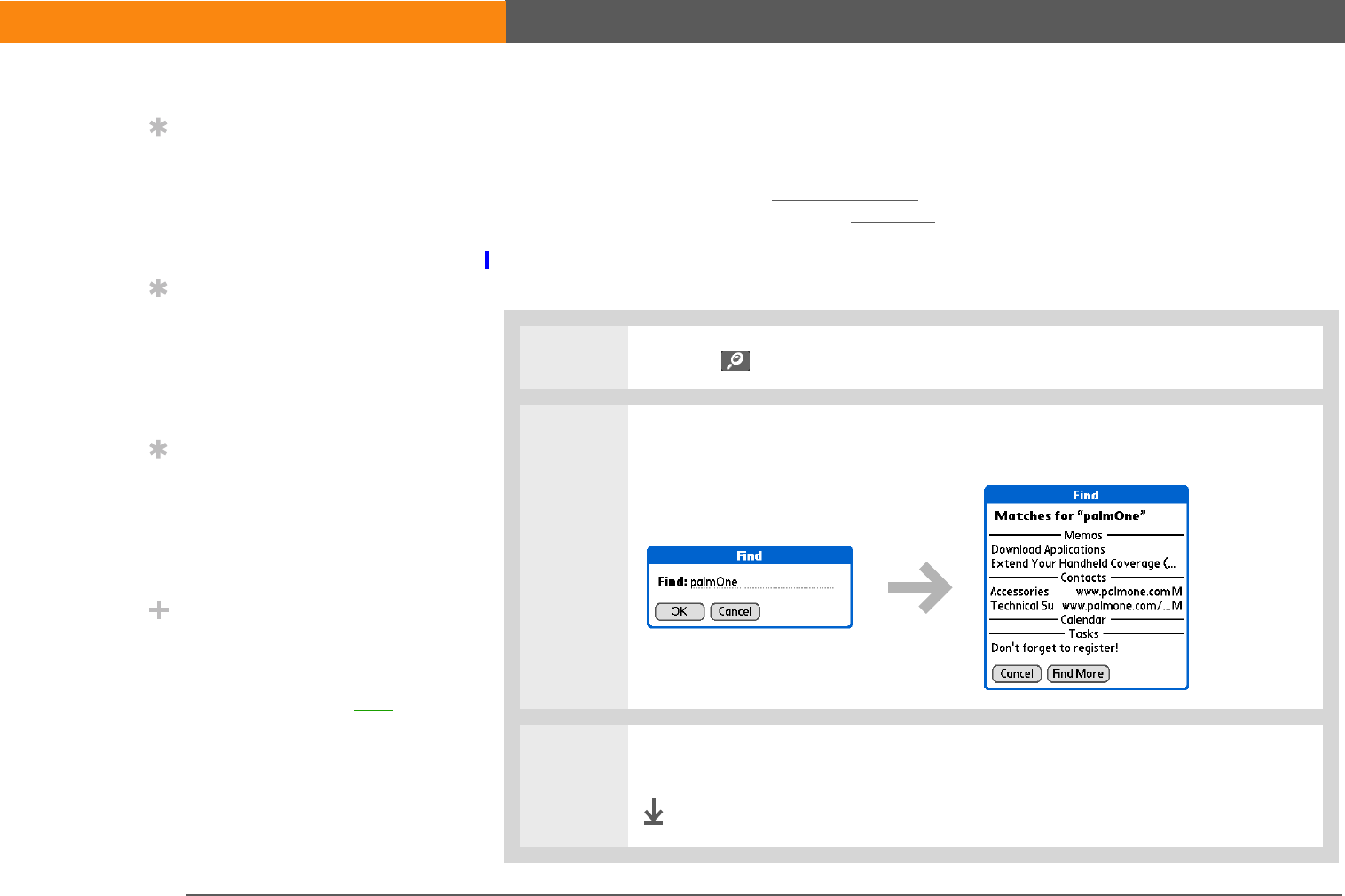
LifeDrive from palmOne 54
CHAPTER 3 Moving Around in Applications
Finding information
You can use Find to locate any word or phrase in any application—either as part of a file name or
within a file—in your device’s program memory. Find also locates words that begin a file name
only (not within a file) on your device’s hard drive or on an expansion card.
Find locates any words that begin with the text you enter and is not case-sensitive. For example,
searching for “plane” finds “planet” but not “airplane.” Searching for “bell” also finds “Bell.”
0
1Tap Find on the status bar.
2Enter the text that you want to find, and then select OK.
3Select the text that you want to review.
Done
Tip
If you select text in an
application before you
tap Find, the selected text
automatically appears in
the Find dialog box.
Tip
Open an application
before you tap Find to
display results from that
application at the top of
the results list.
Tip
Want to stop searching?
Select Stop at any time
during a search. To
continue the search,
select Find More.
Did You Know?
If you select a result that
is a file located on the
hard drive or on an
expansion card, the Files
application opens,
displaying the selected
file. Select the file name
to open it.
SECOND DRAFT palmOne, Inc. Confidential

LifeDrive from palmOne 55
CHAPTER 3 Moving Around in Applications
Related topics
Click a link below to learn about these related topics:
Your
LifeDrive™
• Locating the controls on your device
• Discovering the built-in software on your device and the additional
software on the CD
• Getting familiar with the input area and onscreen application controls
Entering
Information
• Entering information with Graffiti 2 characters and shortcuts
• Entering contact information in other applications
Sharing • Beaming information and applications to other Palm Powered™ devices
• Sending information and applications to other Bluetooth devices by using
Bluetooth technology on your device
Privacy Keeping information private by turning on security options
Categories Creating categories and organizing your applications and information
Managing
Info
• Adding and deleting applications on your device
• Viewing application information
Customizing • Using a photo as the background for Applications and Favorites views
• Displaying Applications View in list format
Maintaining Caring for your device
Common
Questions
Answers to frequently asked questions about using your device and its
applications
Tips & Tricks
Make your device uniquely
yours. For great tips,
software, accessories, and
more, visit
www.palmOne.com/
mylifedrive.
Support
If you’re having problems
with your device, go to
www.palmOne.com/
support.
SECOND DRAFT palmOne, Inc. Confidential

LifeDrive from palmOne 56
CHAPTER 4
Entering Information on Your Device
Whether you’re scheduling a meeting
with your daughter’s teacher or adding
a new restaurant to your Contacts list,
you need to get that information into
your device. There are several ways to
do this.
You may find that you prefer one
method if you’re entering a small
amount of information, while another
works best for large amounts. Choose
the one that fits your situation. Benefits
• Quickly enter important information
• Choose the method that works best
for your situation
I
n t
hi
s c
h
apter
How can I enter information
on my device?
Entering information with
Graffiti 2 writing
Entering information with
the onscreen keyboard
Entering info from Contacts
into another application
Editing information
Related topics
SECOND DRAFT palmOne, Inc. Confidential
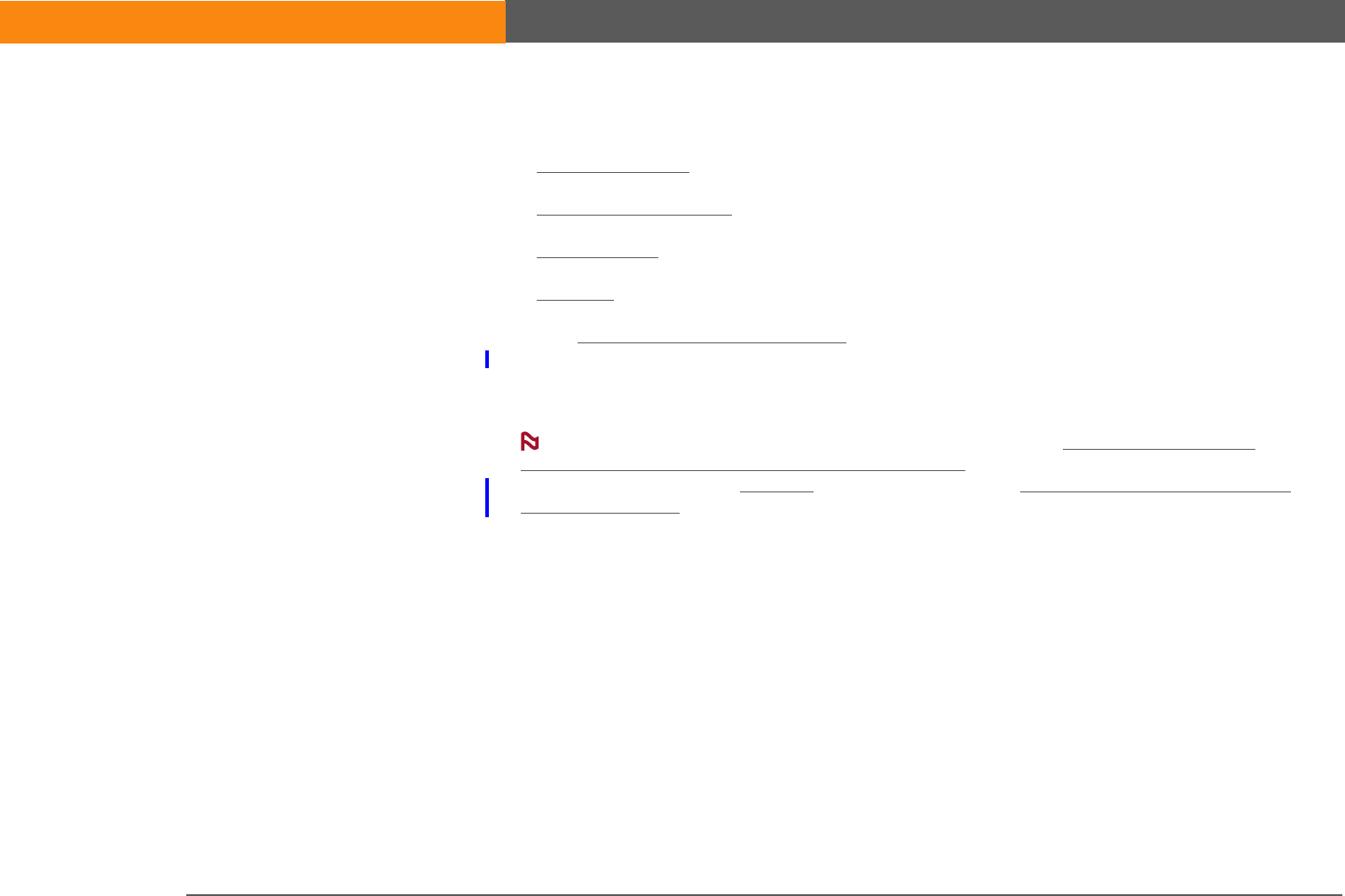
LifeDrive from palmOne 57
CHAPTER 4 Entering Information on Your Device
How can I enter information on my device?
• Graffiti® 2 writing.
•The onscreen keyboard.
•Phone Lookup.
•Note Pad.
• Visit www.palmOne.com/mylifedrive and click the Accessories link to get an accessory keyboard
(sold separately).
The most popular methods are using Graffiti 2 writing and the onscreen keyboard.
You can also enter information on your computer and move and manage the
information between your device and your computer. Or you can send and receive information
from other devices, using beaming or your device’s built-in Bluetooth® wireless technology or
Wi-Fi® capabilities.
Entering information with Graffiti 2 writing
You can enter info directly on your device with Graffiti 2 writing. Graffiti 2 writing includes any
character you can type on a standard keyboard. Entering these characters on your device is very
similar to the way you naturally write letters, numbers, and symbols. But instead of using a pen
and paper, you use the stylus and the input area on your device. With only a few minutes of
practice, you can learn to use Graffiti 2 writing.
Writing in the Graffiti 2 input area
You can write Graffiti 2 characters in the input area, or you can turn on full-screen writing and
write anywhere on the screen.
NOTE
SECOND DRAFT palmOne, Inc. Confidential
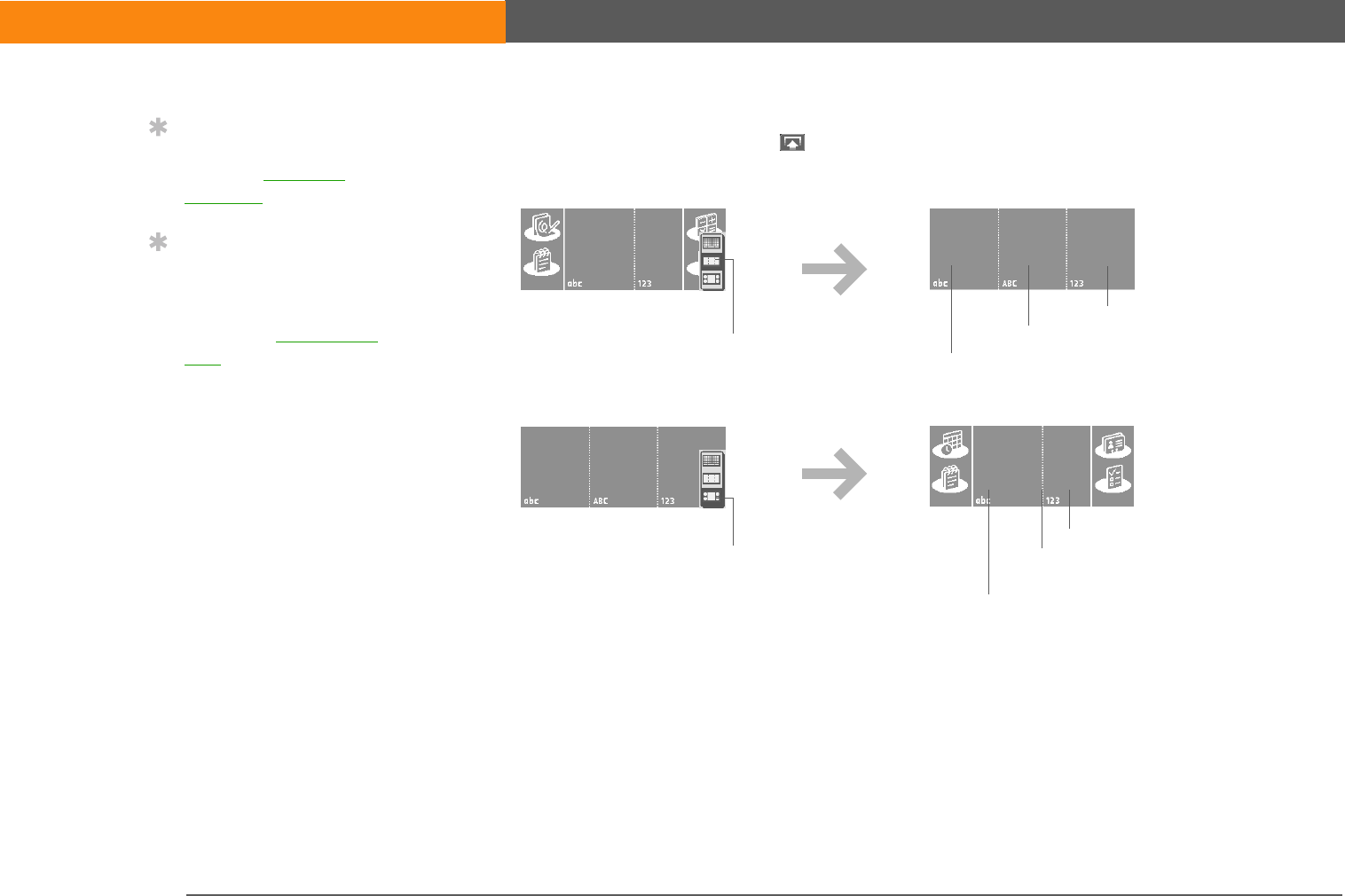
LifeDrive from palmOne 58
CHAPTER 4 Entering Information on Your Device
Your device has two different input area displays that you can use to enter Graffiti 2 characters. To
open them, tap and hold Input on the status bar, and then select the icon of the input area you
want.
In either layout of the input area, write lowercase letters, uppercase letters, and numbers in the
sections shown. If you write characters in the wrong area, they are not recognized correctly and an
incorrect character is written.
Using full-screen writing
When full-screen writing is turned on, you can write anywhere on the screen. When full-screen
writing is turned off, you must write character strokes in the Graffiti 2 input area for your device to
recognize them.
Tip
Select the top icon to
open the onscreen
keyboard.
Tip
You can choose whether
the Graffiti 2 strokes you
enter appear as white
characters in the input
area.
Uppercase letters
Lowercase letters
Numerals
Uppercase letters
straddling line
Lowercase letters
Numerals
Select
middle icon
Select
bottom icon
SECOND DRAFT palmOne, Inc. Confidential

LifeDrive from palmOne 59
CHAPTER 4 Entering Information on Your Device
You can write letters or characters in the following areas:
Left side of the screen Write letters or characters that are assigned to the abc input area.
Right side of the screen Write numbers or characters that are assigned to the 123 input area.
Middle of the screen straddling the imaginary dividing line between the left and right sides
Write uppercase letters.
For a brief period of time after writing a character, a quick tap on the screen is
interpreted as a period character. Wait a second to tap buttons or place the cursor so that the
action is not interpreted as a period character.
Turn full-screen writing on and off by tapping Full-screen writing on the status bar. When
full-screen writing is on, the icon turns from gray to white.
NOTE
Full-screen writing
Write numerals on
the right side
Write letters on
the left side
W
r
i
te cap
i
ta
l
or uppercase
letters in the middle
SECOND DRAFT palmOne, Inc. Confidential
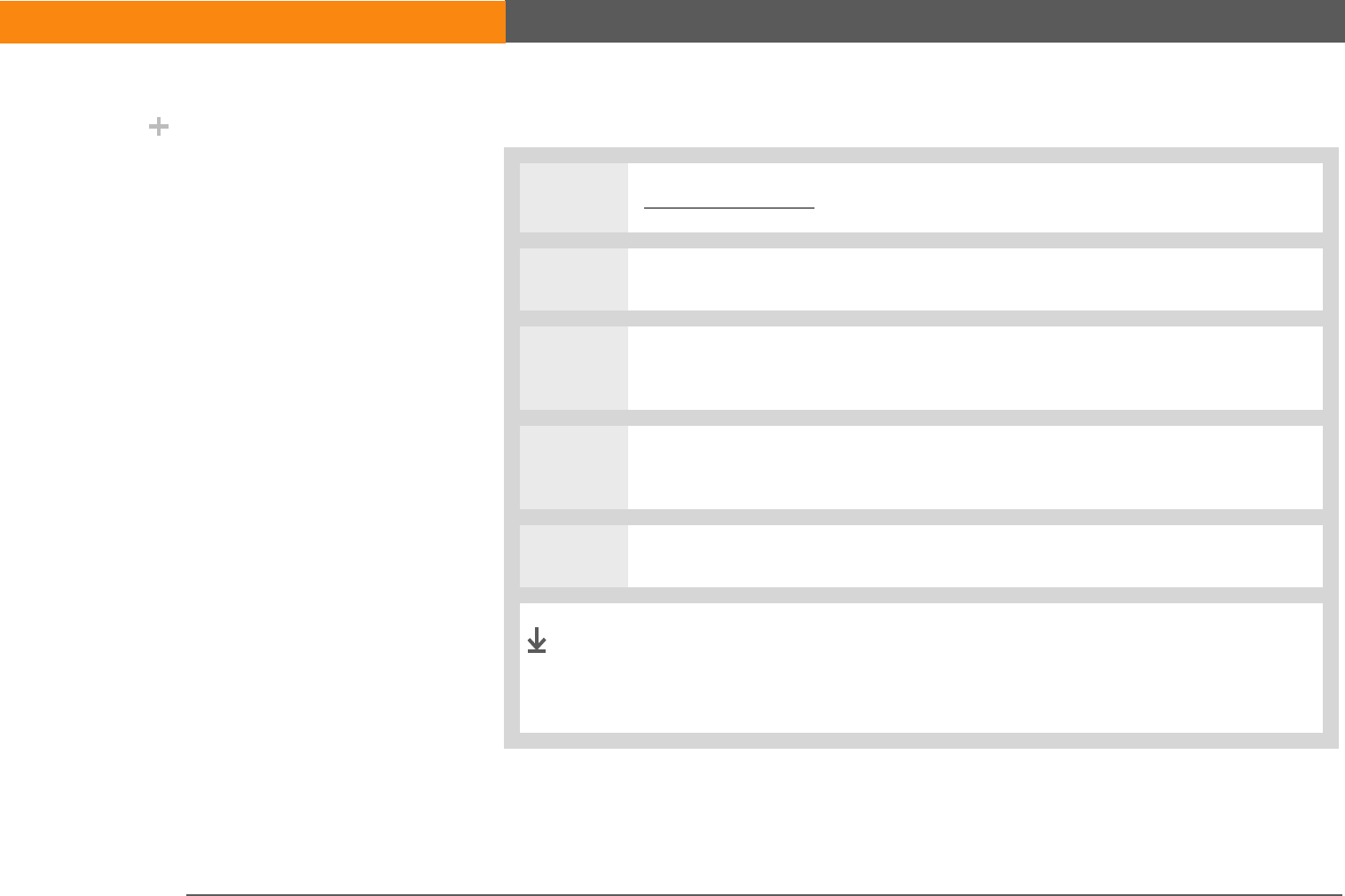
LifeDrive from palmOne 60
CHAPTER 4 Entering Information on Your Device
Writing Graffiti 2 characters
0
1Open an application you use to enter information, like Calendar.
2Tap the screen where you want your character to appear.
3Position the stylus in the correct part of the input area, if selected, or in the
correct part of the screen if full-screen writing is on.
4Write the characters exactly as shown in the tables that follow these steps. Be
sure to start each stroke at the heavy dot.
5Lift the stylus at the end of the stroke.
When you lift the stylus from the screen, your device recognizes
the stroke immediately and prints the character at the insertion
point on the screen.
Did You Know?
Graffiti 2 writing
automatically capitalizes
the first letter of a
sentence or a new entry.
Done
SECOND DRAFT palmOne, Inc. Confidential

LifeDrive from palmOne 61
CHAPTER 4 Entering Information on Your Device
Keys to success with Graffiti 2 writing
Keep these guidelines in mind when using Graffiti 2 writing:
• Write the characters exactly as shown in the following tables. Don’t write the dot. It’s only there
to show you where to begin writing the character.
• The Graffiti 2 writing area has two sections. Write lowercase letters on the left, numbers on the
right, and capital letters across the middle.
• Write at a natural speed, and do not write on a slant.
• Press firmly.
• Write large characters.
If you’re already familiar with Graffiti writing from an older Palm Powered™ device, Graffiti 2
writing will be easy to master. Characters are entered in exactly the same way, except for i, t, k,
and the number 4. These letters are now made with two strokes, just the way you would write
them if you were using a pen and paper.
Also, you no longer have to use the punctuation shift stroke for common punctuation like periods,
commas, or @. Just write these characters on the correct side of the input area and your device
immediately recognizes them.
Did You Know?
Graffiti 2 characters made
with two strokes are
recognized after the
second stroke. Make the
second stroke quickly
after the first so that the
correct character is
recognized.
Did You Know?
Write uppercase letters
the same way you write
lowercase ones. The only
difference is where you
write them.
Tip
Your device has tables
displaying all of the
Graffiti 2 characters, short
cuts, and commands.
Customize your device so
you can display these
tables by drawing a line
from the bottom of the
screen to the top.
SECOND DRAFT palmOne, Inc. Confidential
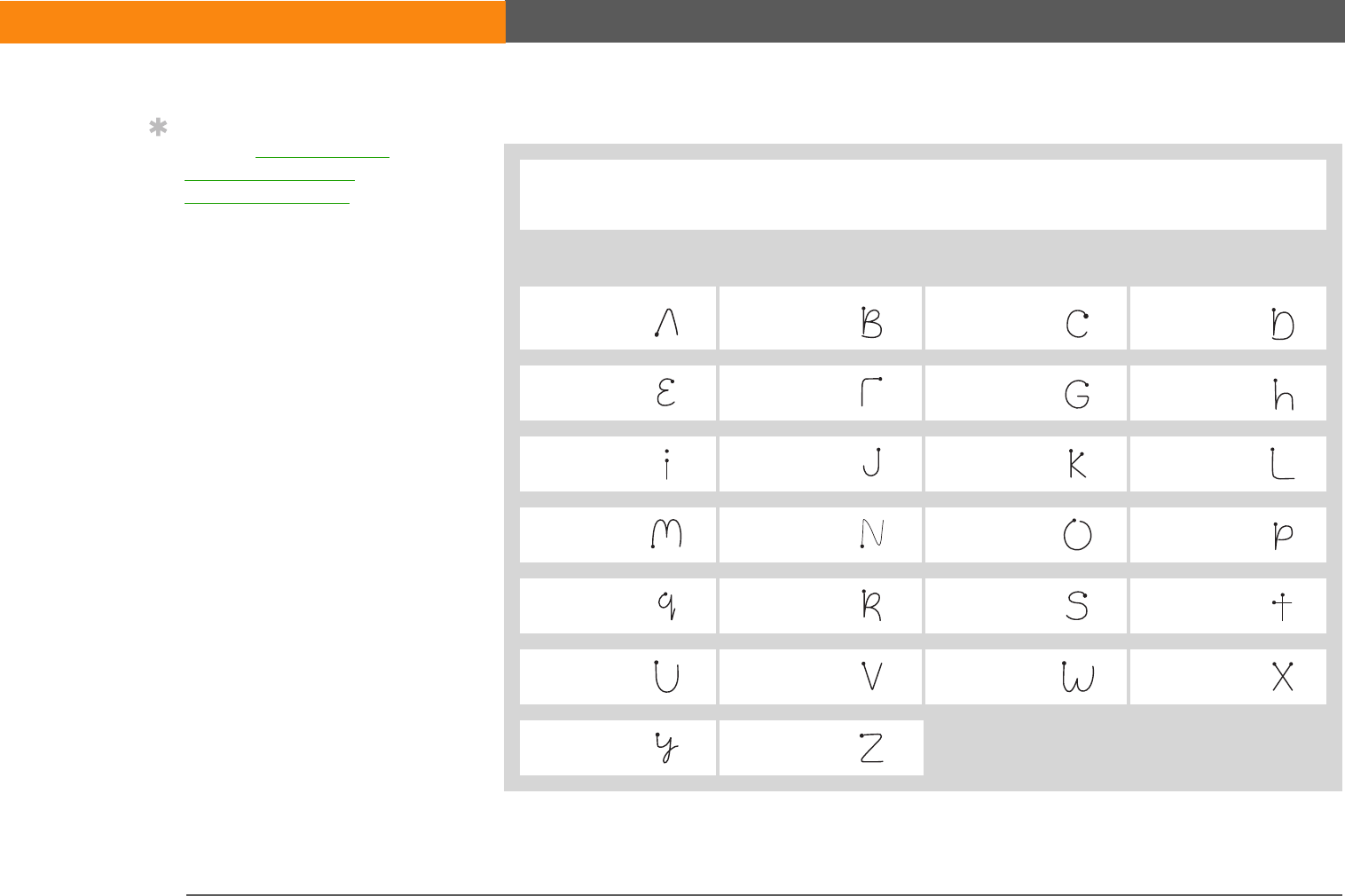
LifeDrive from palmOne 62
CHAPTER 4 Entering Information on Your Device
Graffiti 2 alphabet
0
Write lowercase letters on LEFT side,
and capital letters across MIDDLE of input area
Letter Stroke Letter Stroke Letter Stroke Letter Stroke
ABCD
EFGH
IJKL
MNO P
QRST
UVWX
YZ
Tip
You can select alternate
ways to write some
Graffiti 2 characters.
Choose the method that’s
most natural for you.
SECOND DRAFT palmOne, Inc. Confidential
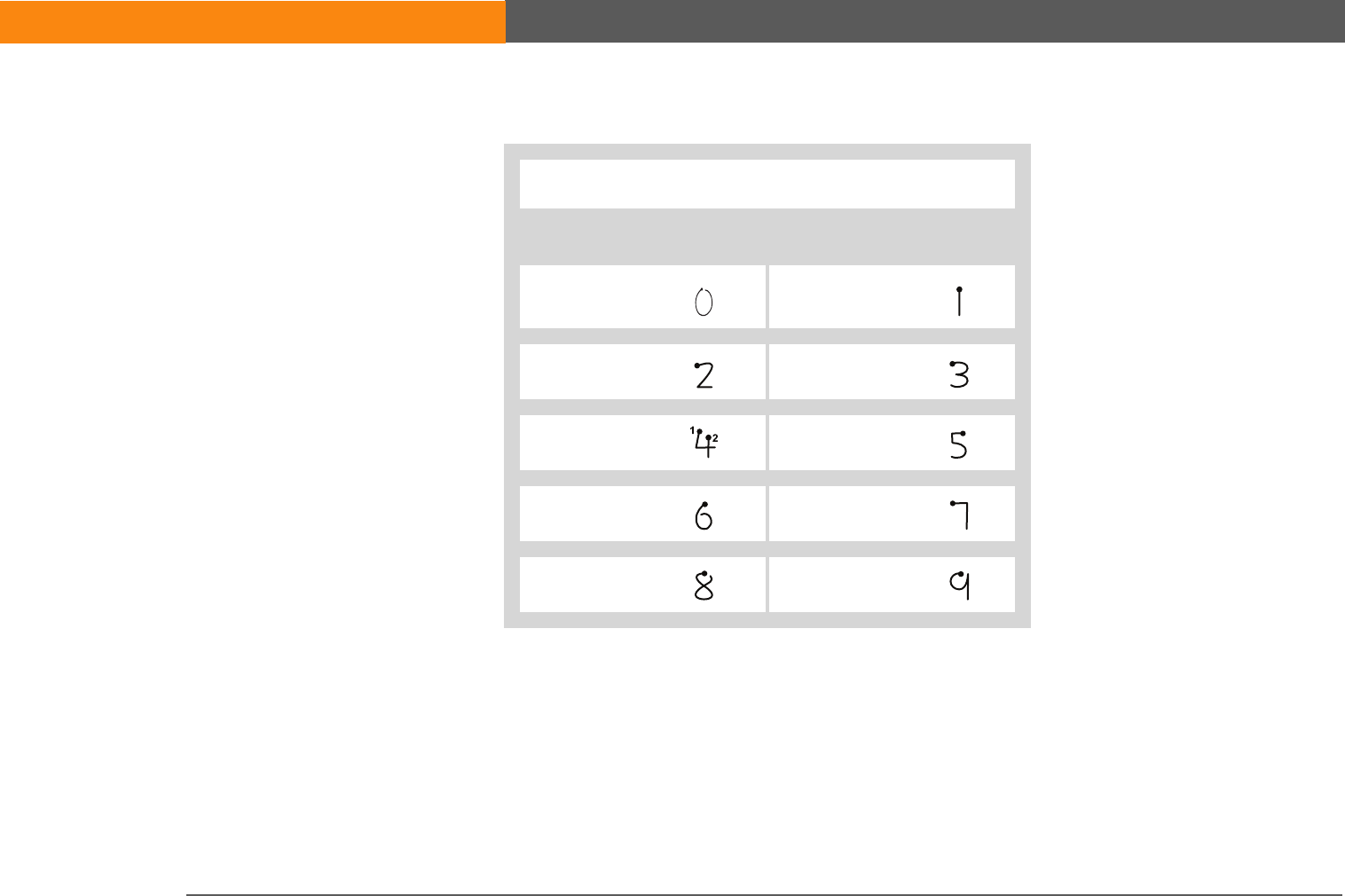
LifeDrive from palmOne 63
CHAPTER 4 Entering Information on Your Device
Graffiti 2 numbers
0
Write numbers on RIGHT side of input area
Number Stroke Number Stroke
01
23
45
67
89
SECOND DRAFT palmOne, Inc. Confidential
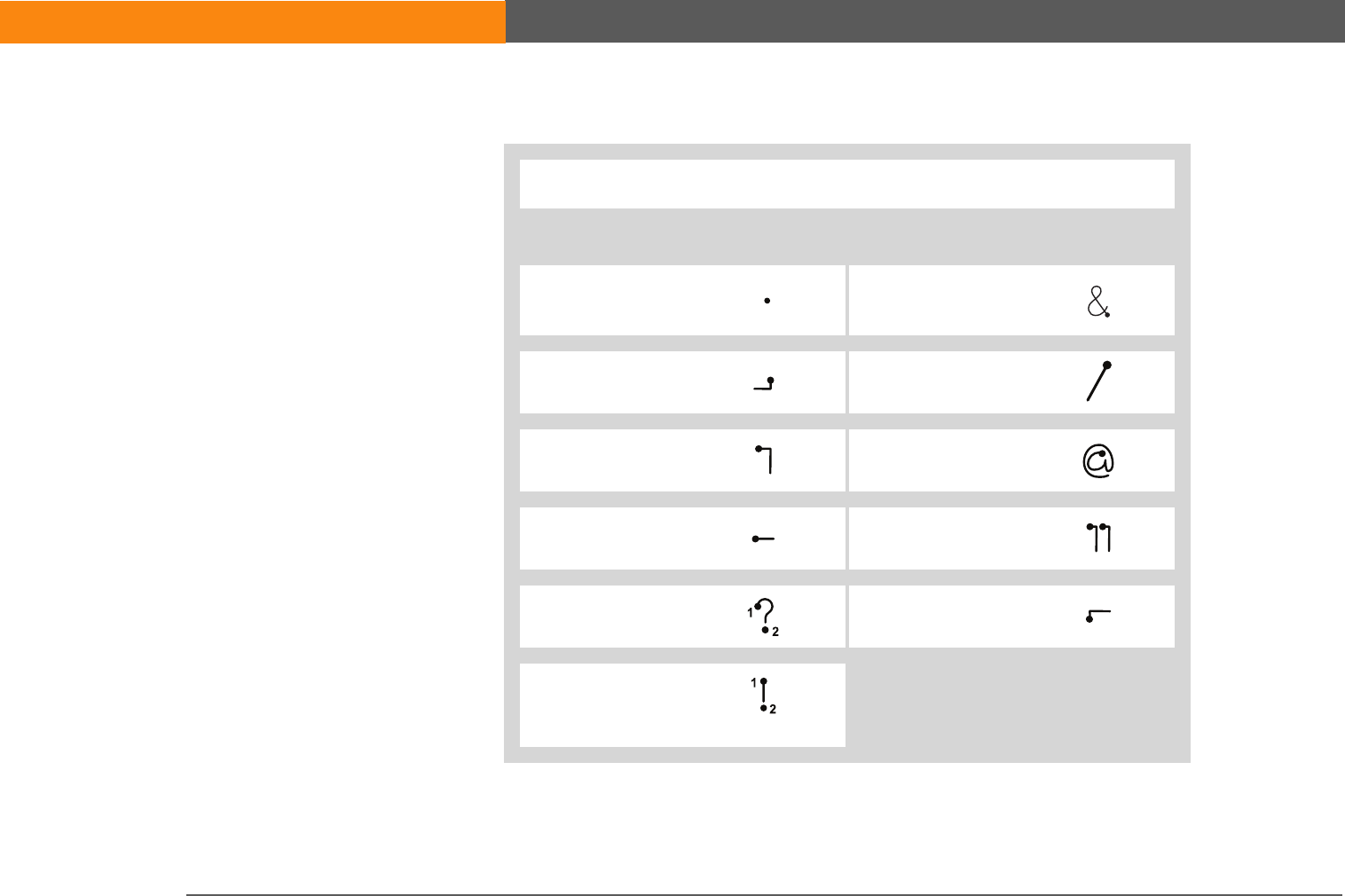
LifeDrive from palmOne 64
CHAPTER 4 Entering Information on Your Device
Graffiti 2 punctuation marks
0
0
Write these marks on LEFT side of input area
Mark Stroke Mark Stroke
Period
.
Ampersand
&
Comma
,
Carriage
return
Apostrophe
‘
At
@
Space Quotation mark
“
Question mark
?
Tab
Exclamation
point
!
SECOND DRAFT palmOne, Inc. Confidential
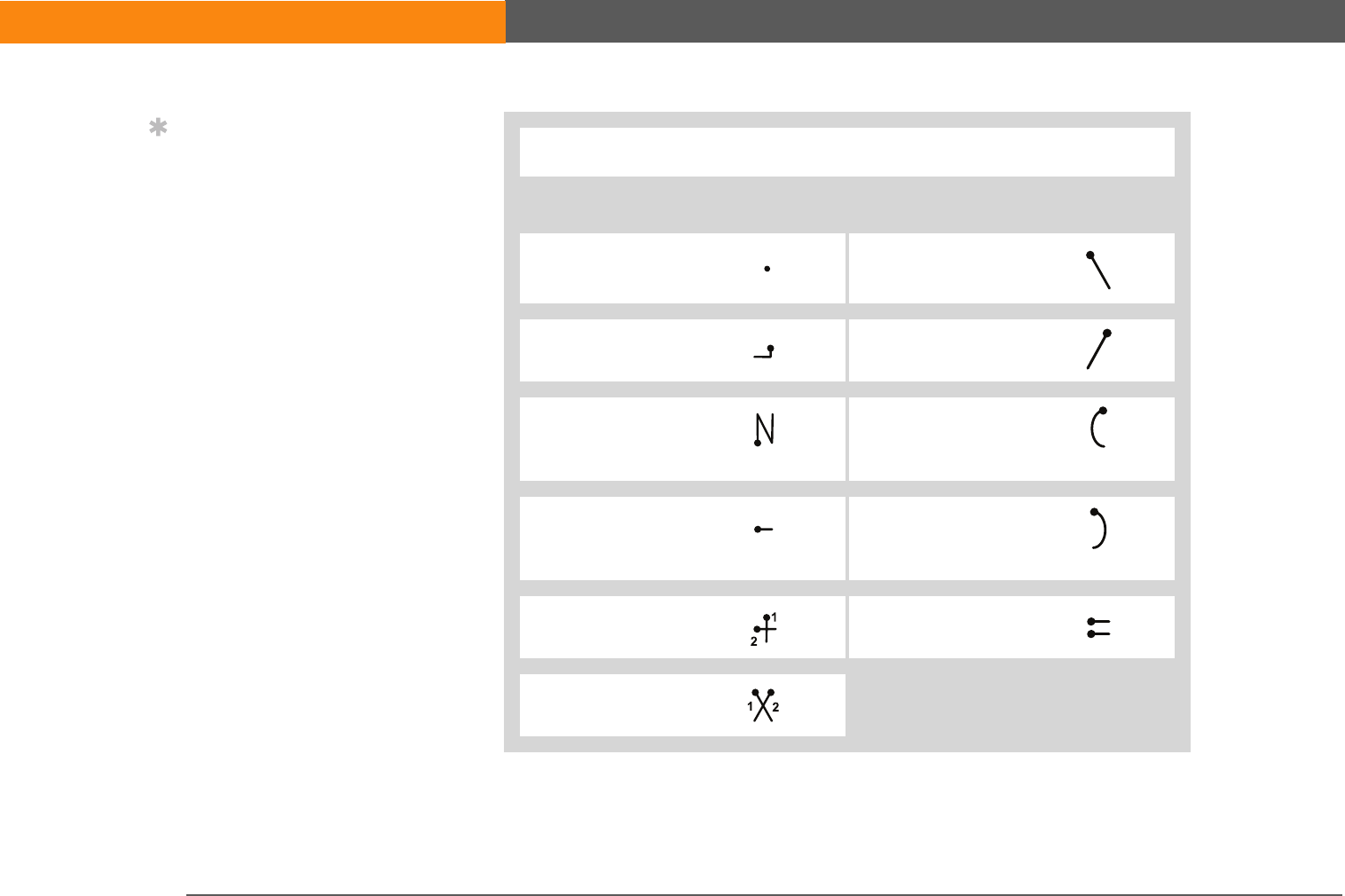
LifeDrive from palmOne 65
CHAPTER 4 Entering Information on Your Device
0
Write these marks on RIGHT side of input area
Mark Stroke Mark Stroke
Period
.
Backslash
\
Comma
,
Slash
/
Tilde
ñ
Left
parenthesis
(
Dash
–
Right
parenthesis
)
Plus
+
Equal sign
=
Asterisk
*
Tip
Having trouble with the
plus sign? Use the
punctuation shift first and
then make the character.
SECOND DRAFT palmOne, Inc. Confidential
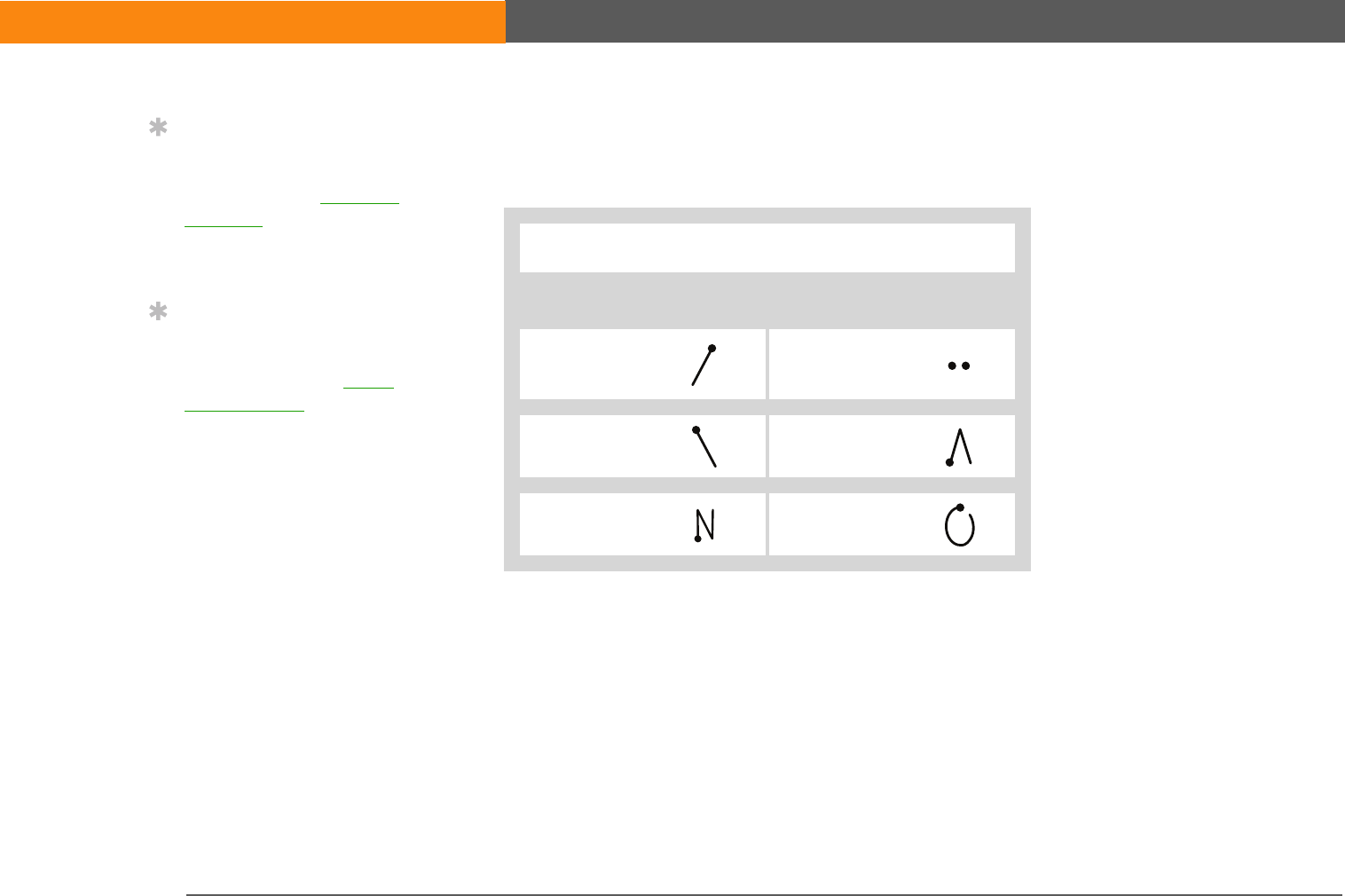
LifeDrive from palmOne 66
CHAPTER 4 Entering Information on Your Device
Graffiti 2 accented characters
For accented characters, write the letter on the left side of the input area, and then write the accent
on the right side of the input area.
0
Write these marks on RIGHT side of input area
Accent Stroke Accent Stroke
Acute
á
Dieresis
ä
Grave
à
Circumflex
â
Tilde
ã
Ring
å
Tip
Having trouble accenting
characters? You can
always open the onscreen
keyboard, tap int., and
then tap the character you
need.
Tip
Get help writing any of
the Graffiti 2 characters in
most applications. Open
the Edit menu and select
Graffiti 2 Help.
SECOND DRAFT palmOne, Inc. Confidential
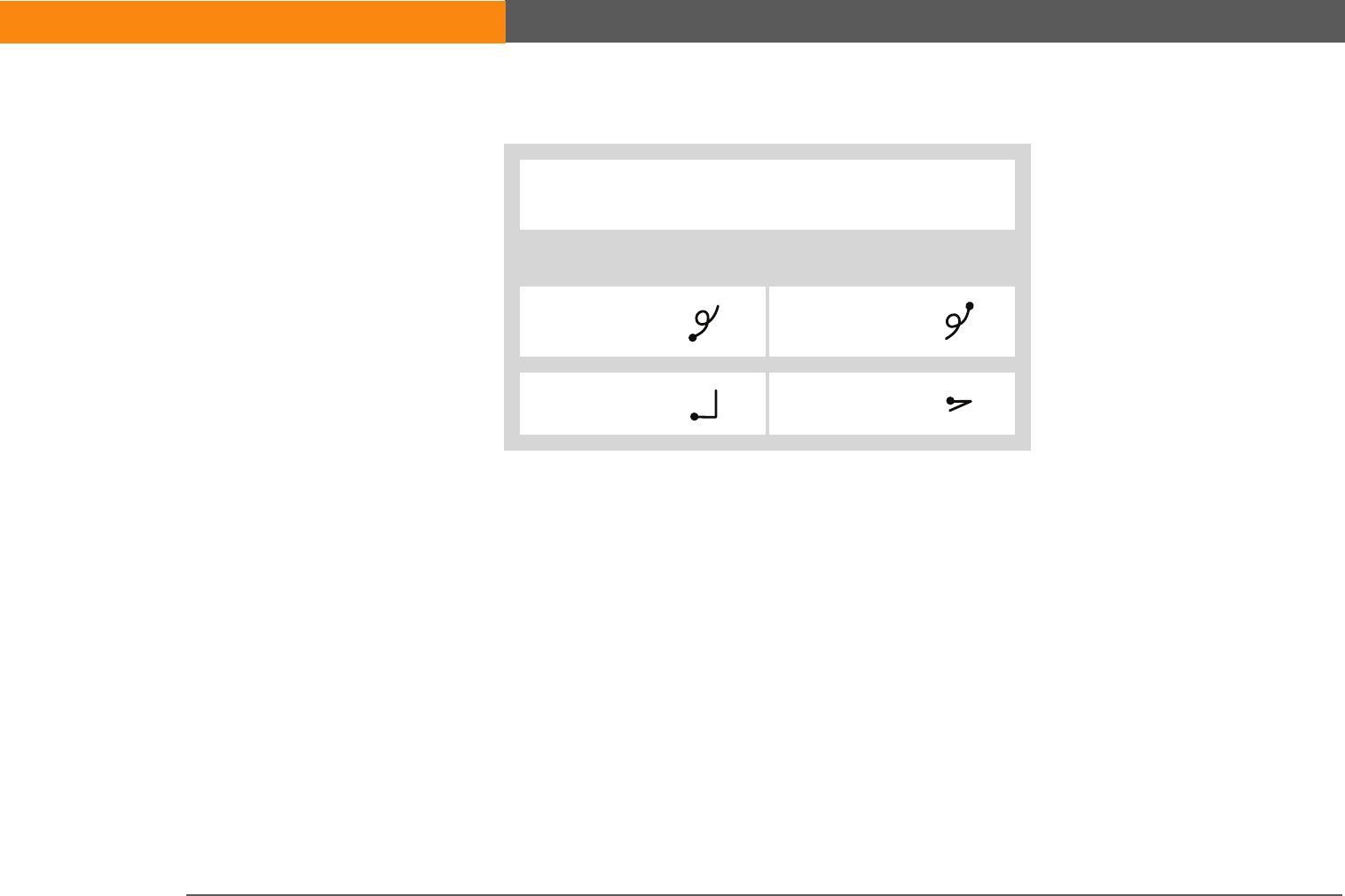
LifeDrive from palmOne 67
CHAPTER 4 Entering Information on Your Device
Graffiti 2 gestures
0
Write gestures on LEFT side,
or across the middle of input area
Gesture Stroke Gesture Stroke
Cut Paste
Copy Undo
SECOND DRAFT palmOne, Inc. Confidential
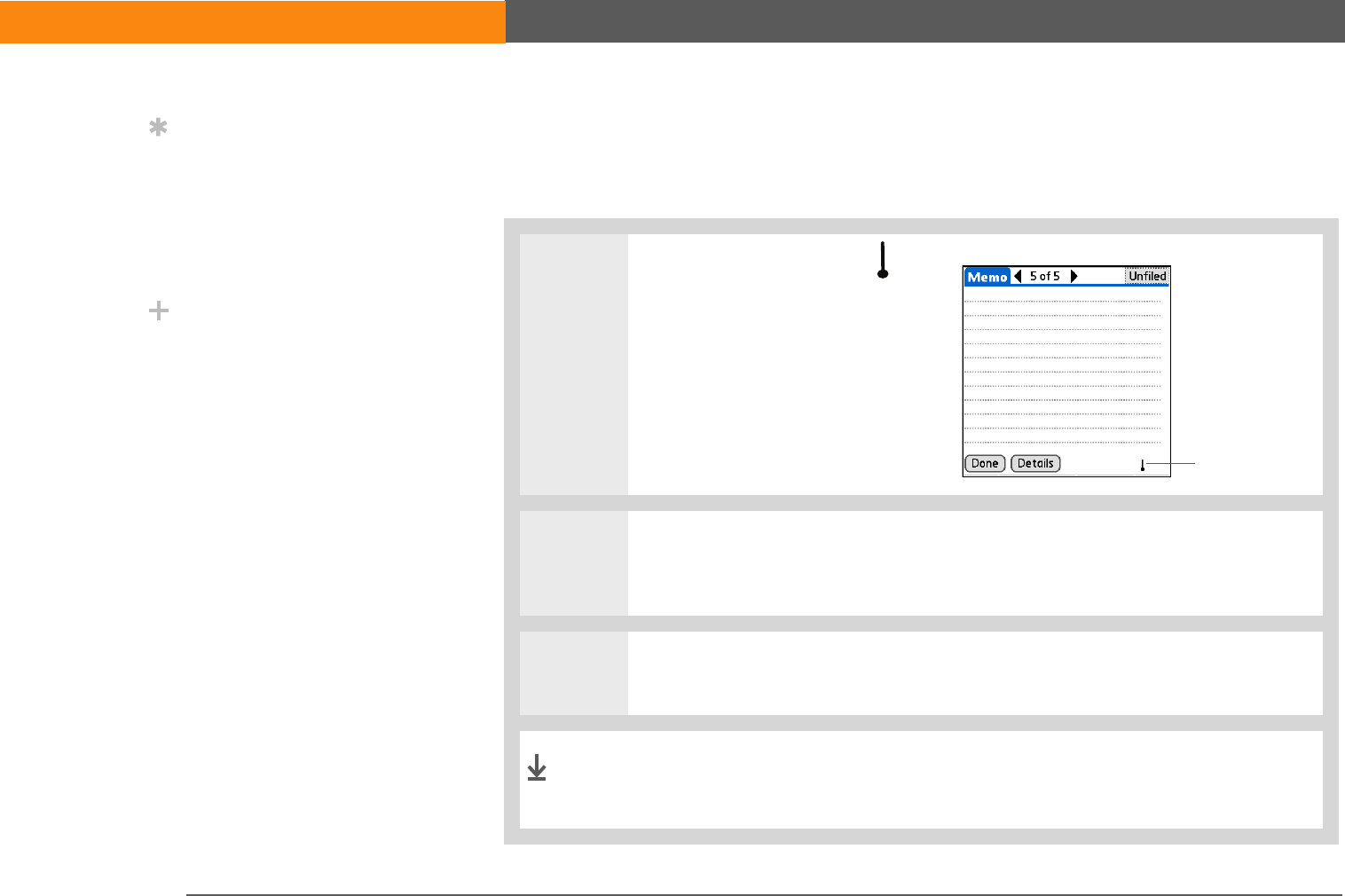
LifeDrive from palmOne 68
CHAPTER 4 Entering Information on Your Device
Writing Graffiti 2 symbols and other special characters
Symbols and other special characters can be written on either side of the input area, using the
Punctuation Shift stroke.
0
0
1Enter the Punctuation Shift .
stroke.
When Punctuation Shift is active,
an indicator appears in the lower-
right corner of the screen.
2Write the symbol or other special character shown in the following table.
You can write a symbol or special character anywhere in the input area.
3Enter another Punctuation Shift stroke to finish the character and to make it
appear more quickly.
Once the Punctuation Shift indicator disappears, you see the
character.
Tip
If you accidentally enter
the Punctuation Shift
stroke, enter it again to
cancel it, or wait a
moment and it
automatically disappears.
Did You Know?
Writing two Punctuation
Shift strokes cancels the
automatic capitalization
of the first letter of a new
entry or sentence. Punctuation
shift indicator
Done
SECOND DRAFT palmOne, Inc. Confidential
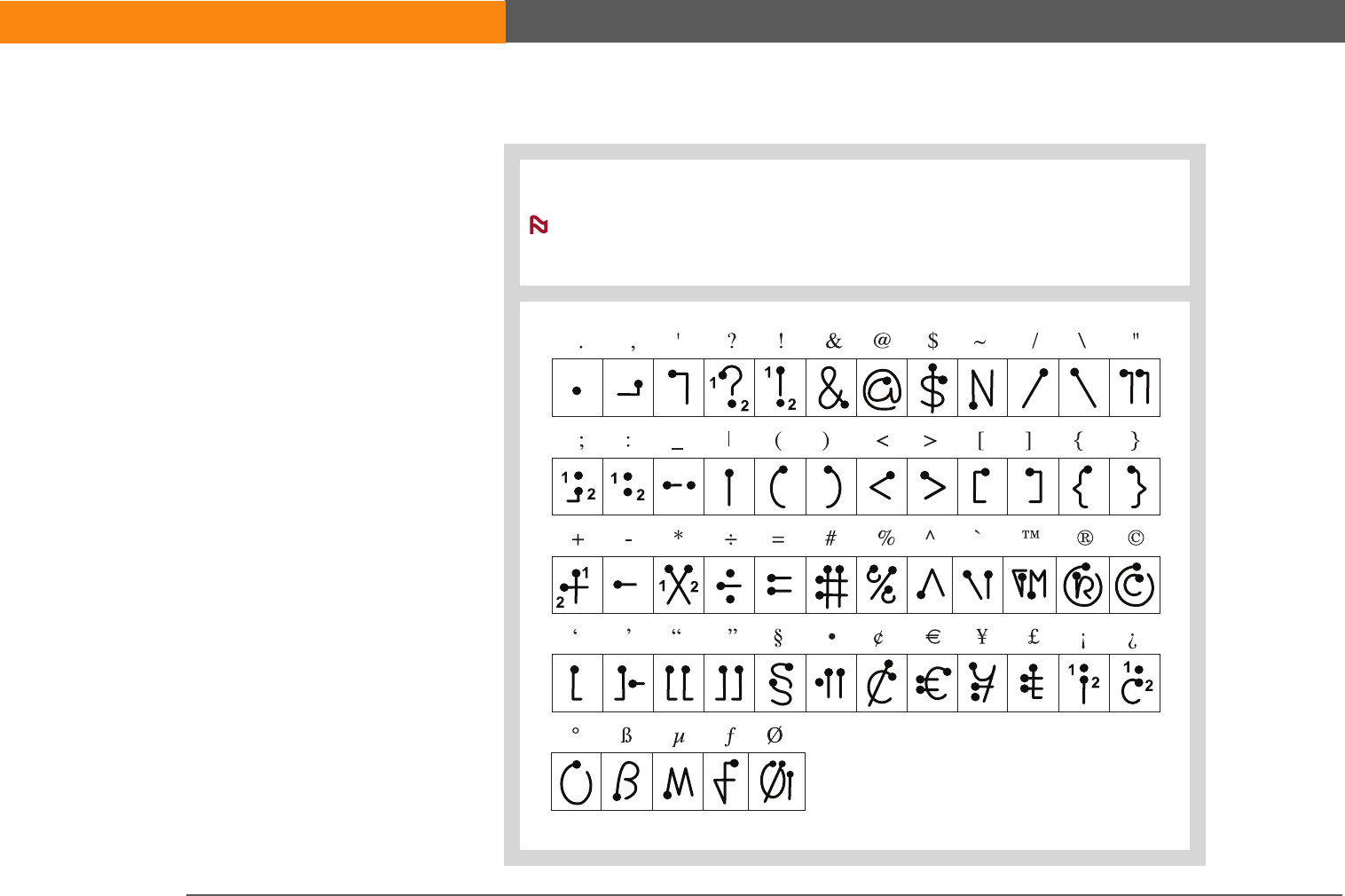
LifeDrive from palmOne 69
CHAPTER 4 Entering Information on Your Device
Graffiti 2 symbols and special characters
0
Write symbols on EITHER side of input area
The asterisk character appears only if you write the strokes on the
right side of the input area. If you write the strokes on the left side, a
lowercase x appears.
NOTE
SECOND DRAFT palmOne, Inc. Confidential
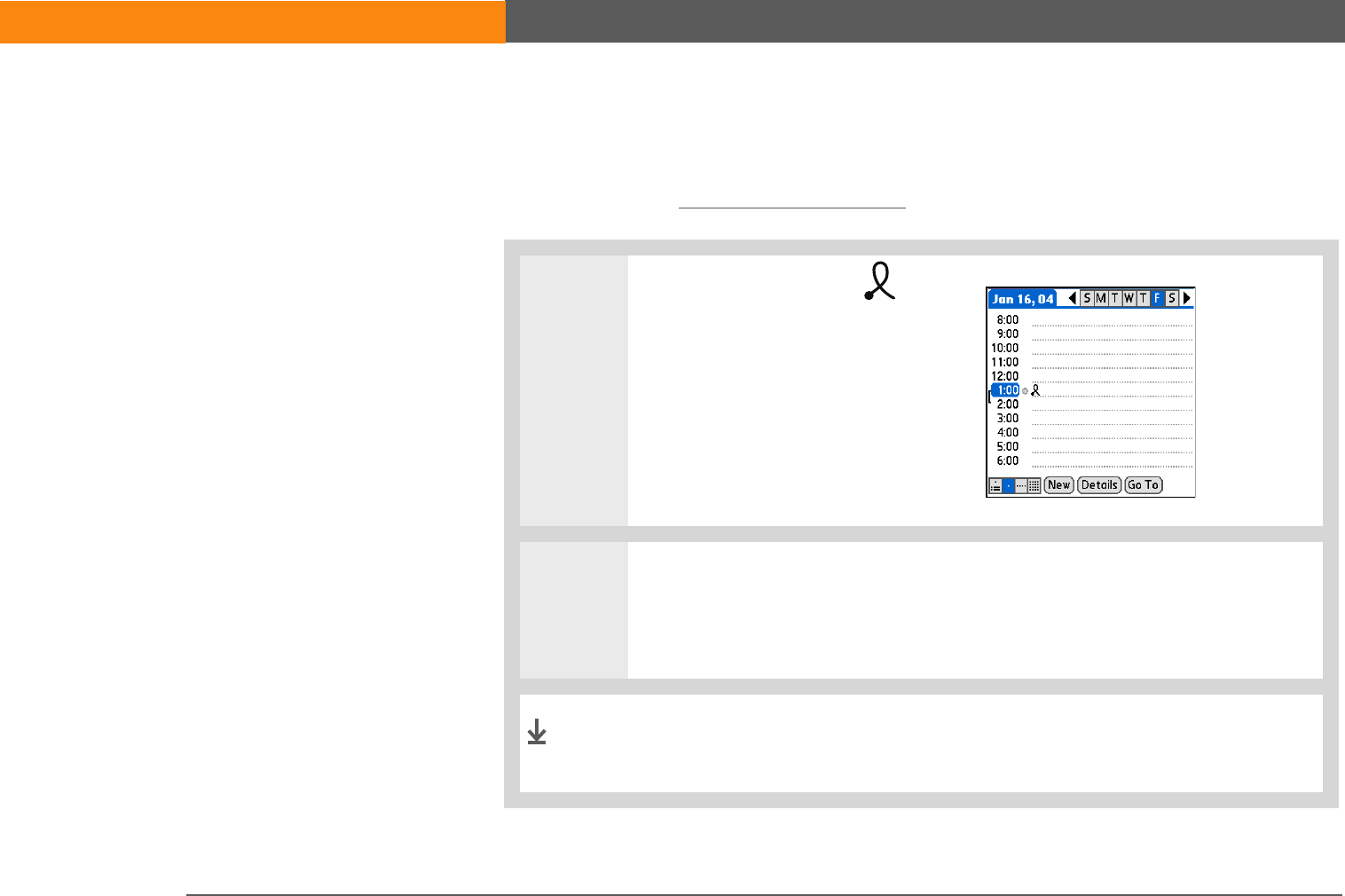
LifeDrive from palmOne 70
CHAPTER 4 Entering Information on Your Device
Writing Graffiti 2 ShortCuts
Graffiti 2 contains several ShortCuts to make entering common information easier. For example,
when you write the ShortCut stroke followed by dts, you automatically enter the current date and
time. You can also create your own ShortCuts.
0
0
1Write the ShortCut stroke .
This stroke appears at the
insertion point.
2Write the ShortCut character from the following table.
You can write ShortCuts on the left side of the input area, or across the middle.
The ShortCut stroke is replaced by the text the character
represents.
Done
SECOND DRAFT palmOne, Inc. Confidential

LifeDrive from palmOne 71
CHAPTER 4 Entering Information on Your Device
Graffiti 2 ShortCuts
0
Write ShortCuts on LEFT side, or across MIDDLE of input area
Entry ShortCut Entry ShortCut
Date stamp ds Time stamp ts
Date/time stamp dts Meeting me
Breakfast br Lunch lu
Dinner di
SECOND DRAFT palmOne, Inc. Confidential
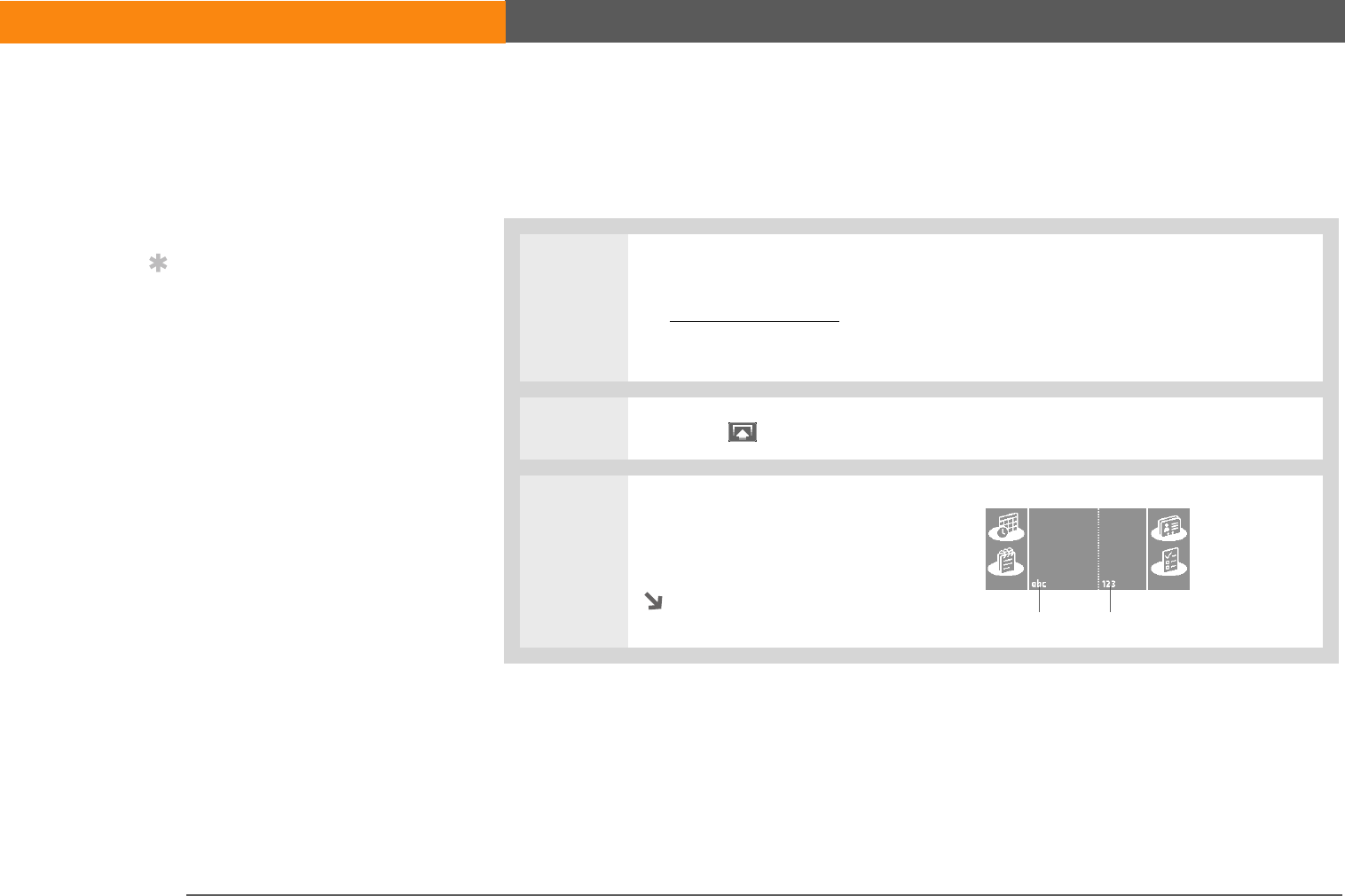
LifeDrive from palmOne 72
CHAPTER 4 Entering Information on Your Device
Entering information with the onscreen keyboard
You can use the onscreen keyboard in any application where you need to enter text, numbers, or
symbols on your device.
0
1Open an entry:
a. Open an application.
b. Select an entry or select New.
2Tap Input on the status bar to open the input area.
3Tap abc or 123 to open the
alphabetic or numeric keyboard,
respectively.
Continued
»
Key Term
Entry An item in an
application such as a
contact in Contacts or an
appointment in Calendar.
Tip
You can enter text
whenever you see a
blinking cursor on the
screen.
Tap to open keyboards
SECOND DRAFT palmOne, Inc. Confidential
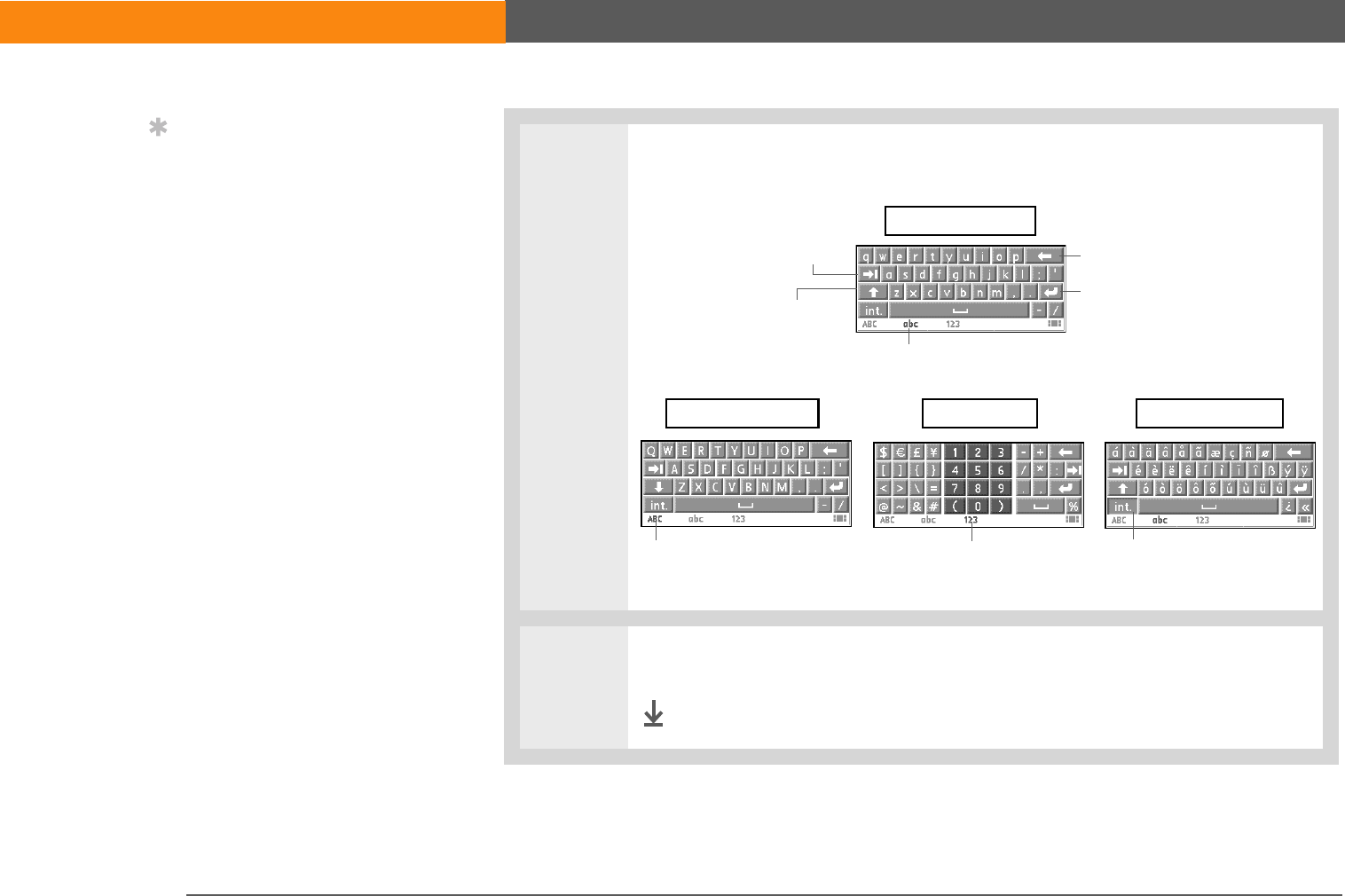
LifeDrive from palmOne 73
CHAPTER 4 Entering Information on Your Device
4[ & ] OPTIONAL Select from among four different keyboards.
5Tap the characters to enter text, numbers, and symbols.
Done
Backspace
Carriage return
Tab
Caps shift
Tap here to display
lowercase keyboard
Tap here to display
uppercase keyboard
Tap here to display
international keyboard
abc - lowercase
ABC - uppercase int. - international
123 - numeric
Tap here to display
numeric keyboard
Tip
When a keyboard is open,
you can tap abc, 123, or
int. to open any of the
other keyboards.
SECOND DRAFT palmOne, Inc. Confidential
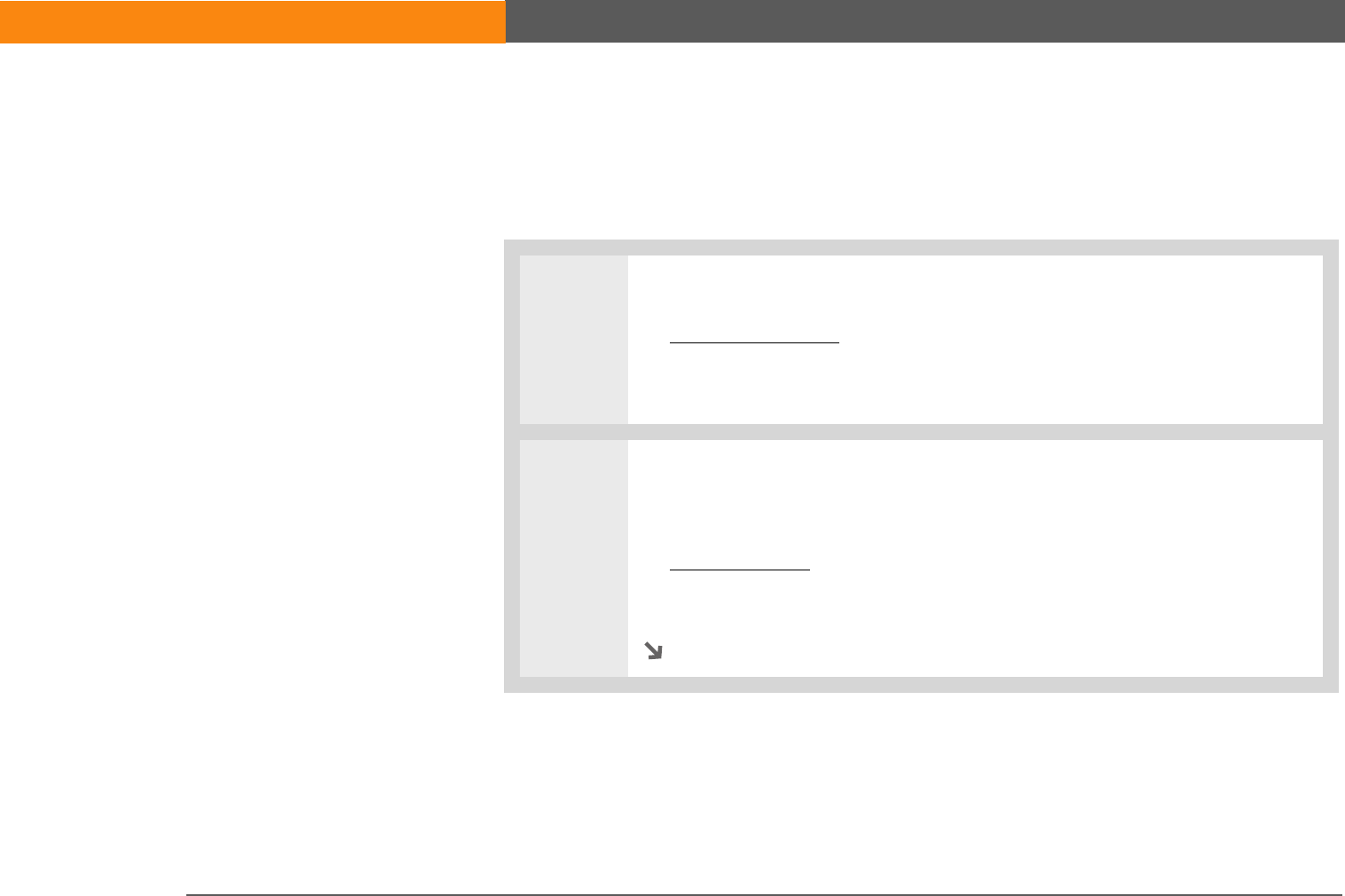
LifeDrive from palmOne 74
CHAPTER 4 Entering Information on Your Device
Entering info from Contacts into another application
Having lunch with someone whose info you have in Contacts? Use Phone Lookup to quickly enter
their name and phone number into the appointment you create in Calendar. This feature is
available in Calendar, Memos, Tasks, and Expense.
0
1Open an entry:
a. Open an application.
b. Select an entry or select New.
In Expense only: Select Details, and then select Attendees.
2Add the contact from Phone Lookup:
a. Tap where you want to enter the contact.
b. Open the menus.
c. Select Options, and then select Phone Lookup.
Continued
SECOND DRAFT palmOne, Inc. Confidential
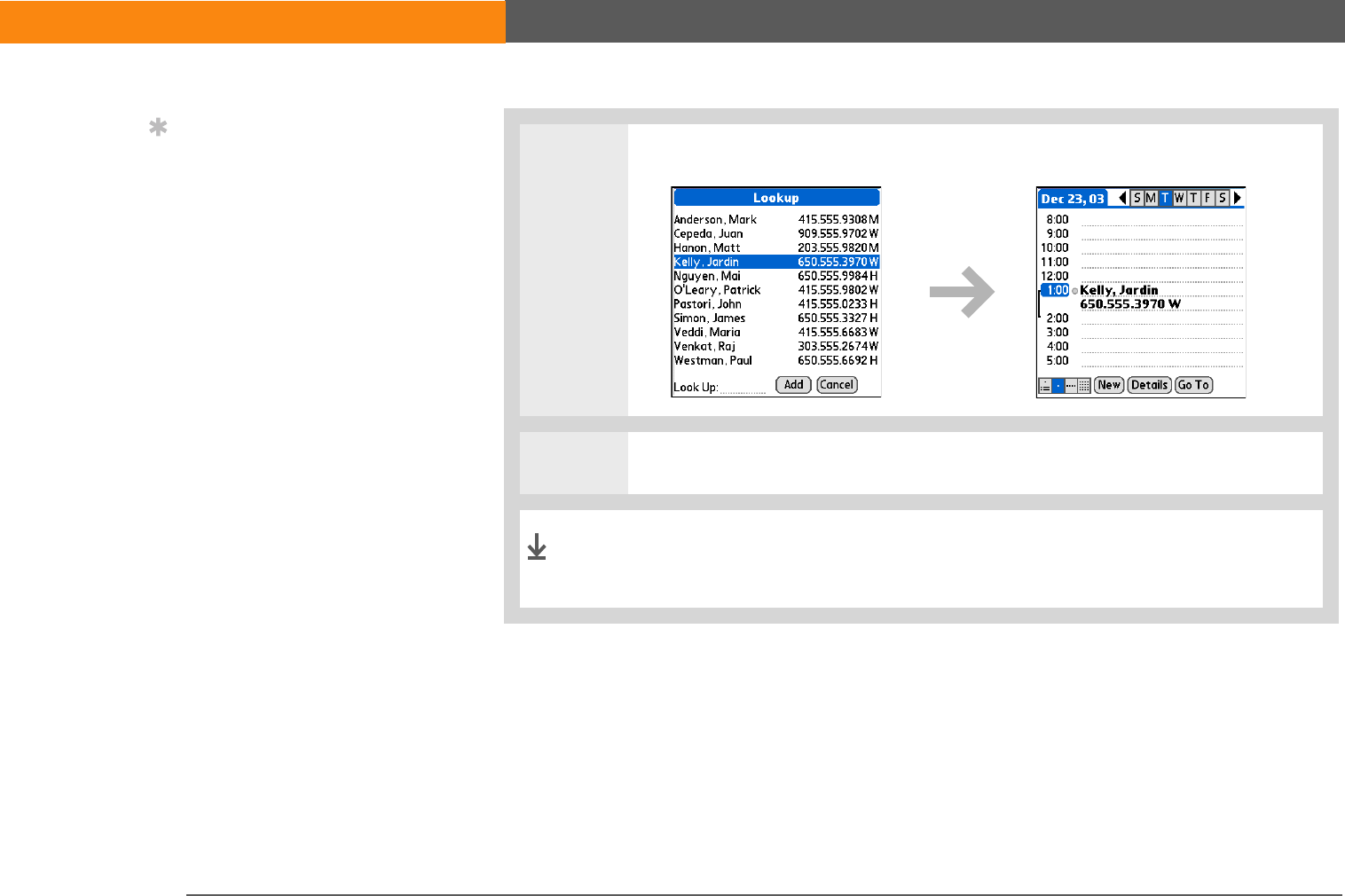
LifeDrive from palmOne 75
CHAPTER 4 Entering Information on Your Device
Cont’d.
d. Select the contact, and then select Add.
3[ & ] OPTIONAL To add another contact, repeat step 2.
The name and phone number of the contact are automatically
entered.
Tip
You can also enter the
first few letters of the
contact’s name, and the
open Phone Lookup. The
first contact name
matching the letters you
entered is highlighted.
Done
SECOND DRAFT palmOne, Inc. Confidential

LifeDrive from palmOne 76
CHAPTER 4 Entering Information on Your Device
Editing information
Editing information on your device is similar to editing with word-processing applications on your
computer. Select the information, and then apply the correct command.
Selecting information
There are several ways to select information that you want to edit or delete.
Selecting text Place the cursor before or after the text you want to select, and drag
the cursor over all the text you want to select.
Selecting a word • Tap twice on a word to select it.
• Place the cursor before or after the word, and drag it over the word
to select it.
Selecting a line • Tap three times anywhere in a line to select it. This selects the final
return character or space as well as any text.
• Place the cursor before or after the line, and drag it over the line to
select it. Drag up or down to select the final return character or
space as well as any text. Drag left to right to select text only.
SECOND DRAFT palmOne, Inc. Confidential
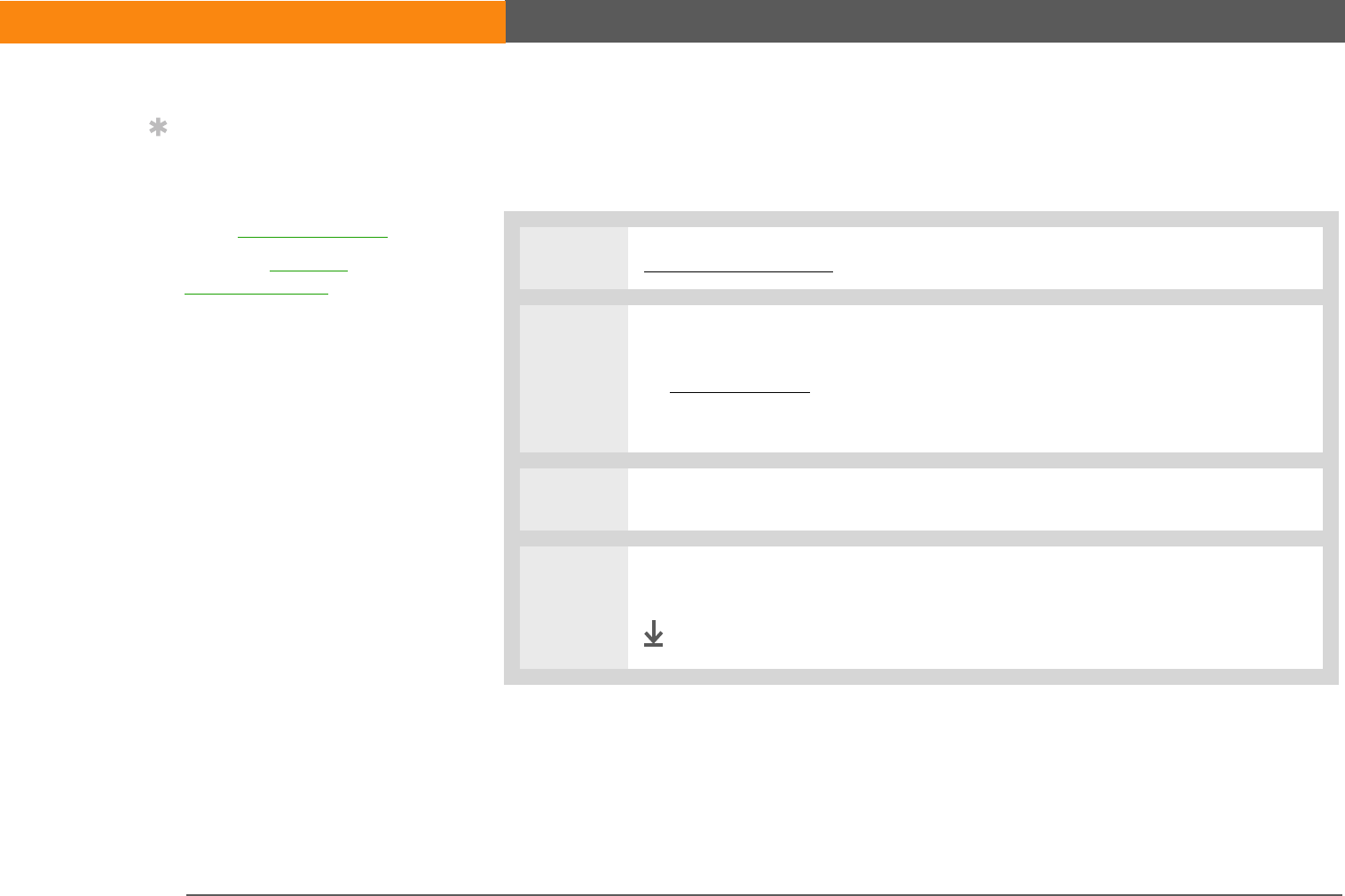
LifeDrive from palmOne 77
CHAPTER 4 Entering Information on Your Device
Copying and pasting information
Copying and pasting information on your device is similar to editing with word-processing
applications on your computer.
0
1Select the information you want to copy.
2Copy the information:
a. Open the menus.
b. Select Edit, and then select Copy.
3Tap where you want to paste the information.
4Select Edit, and then select Paste.
Done
Tip
There are even faster
ways to copy and paste
information:
• Use Graffiti 2 gestures.
•Use the Graffiti 2
Command stroke and the
menu shortcut for cut,
copy, or paste (/X, /C, /P).
• Select the text, write the
command stroke, and
then tap the icon for cut
or copy from the
command toolbar that
appears.
SECOND DRAFT palmOne, Inc. Confidential
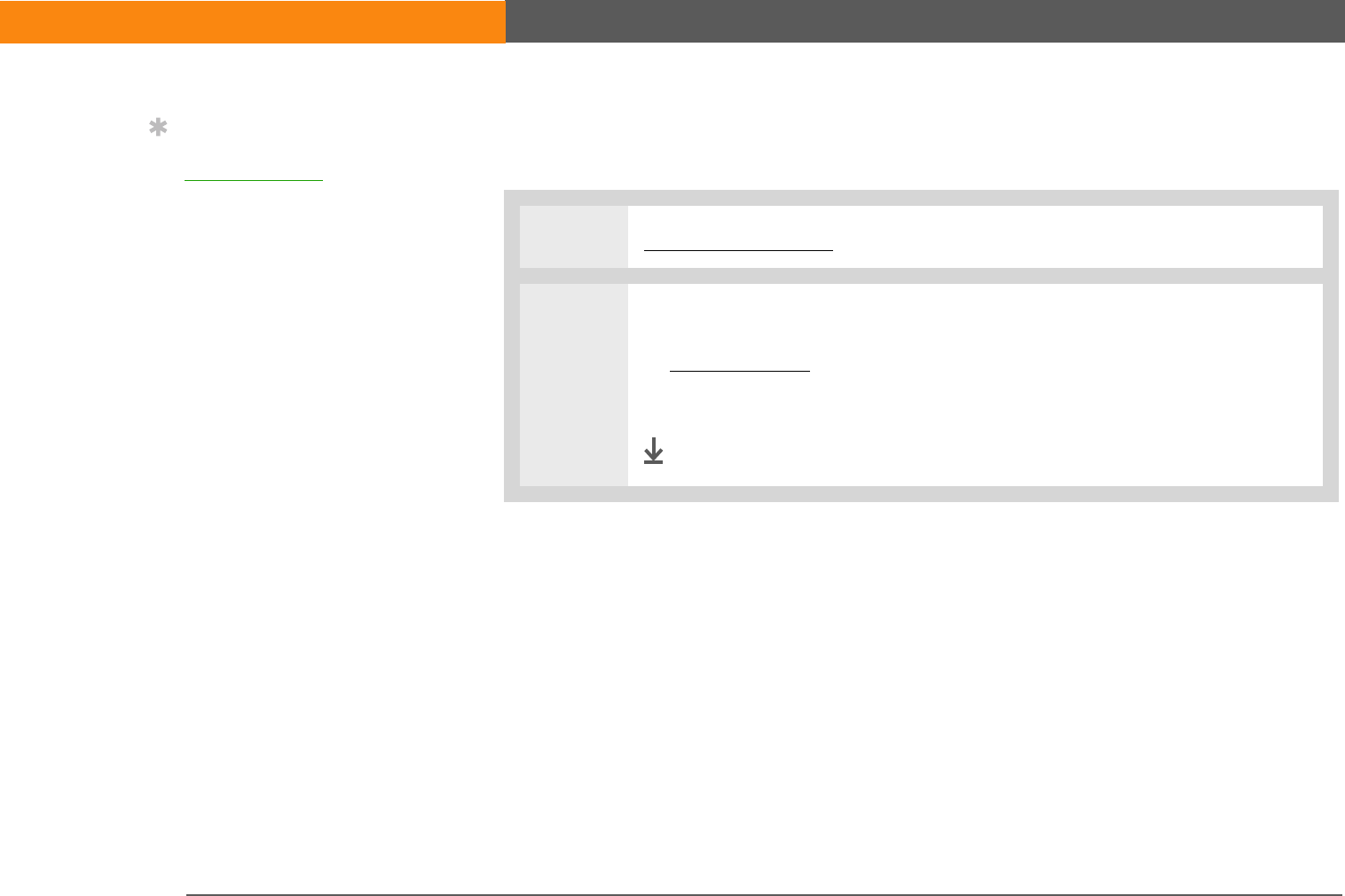
LifeDrive from palmOne 78
CHAPTER 4 Entering Information on Your Device
Deleting information
Delete all or part of an entry with the Cut command.
0
1Select the information you want to delete.
2Delete the information:
a. Open the menus.
b. Select Edit, and then select Cut.
Done
Tip
Delete information with
Graffiti 2 writing. Select
the information, and then
draw a line from right to
left in the input area.
SECOND DRAFT palmOne, Inc. Confidential

LifeDrive from palmOne 79
CHAPTER 4 Entering Information on Your Device
Related topics
Click a link below to learn about these related topics:
Moving Around • Opening applications
• Using menus
Sharing Beaming or sending information to another Palm Powered device
Customizing • Selecting alternate ways to write some Graffiti 2 characters
• Creating your own Graffiti 2 ShortCuts
Common
Questions
Answers to frequently asked questions about entering information
Tips & Tricks
Make your device uniquely
yours. For great tips,
software, accessories, and
more, visit
www.palmOne.com/
mylifedrive.
Support
If you’re having problems
entering information or with
anything else on your device,
go to www.palmOne.com/
support.
SECOND DRAFT palmOne, Inc. Confidential
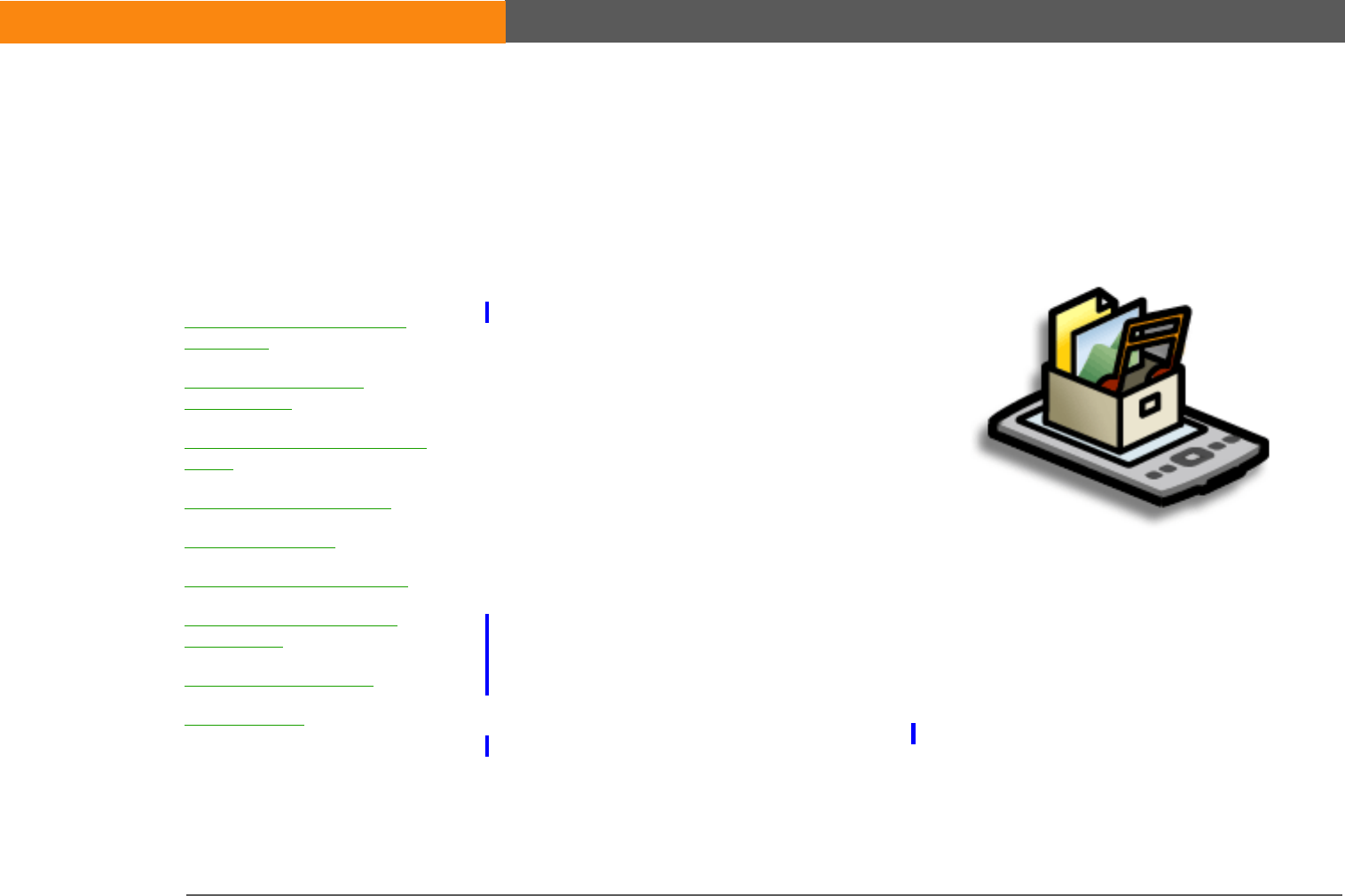
LifeDrive from palmOne 80
CHAPTER 5
Moving and Managing Info Between
Your Device and Your Computer
With its large hard drive, your device
becomes a four-gigabyte (4GB)
extension of your computer that you
can take with you on the go. This extra
capacity lets you carry many more of
your documents, folders, photos, and
music files with you.
But the drive offers more than just
storage capacity. With the LifeDrive™
Manager application, you can simply
drag and drop files and folders to
transfer them from your Windows
computer to the drive, organize them
the way you want, and work with them
directly on the device. Any time you
make changes, you can synchronize to
ensure that the most current version of
your information exists on both your
device and your computer.
Benefits
• Quickly enter and update information
on your device and your computer
• Transfer and work with applications,
files, and folders on your device
• Synchronize individual files or entire
folders with one button
• Protect your information by quickly
backing up and saving files and
folders to your computer
I
n t
hi
s c
h
apter
Program memory and the
hard drive
How can I work with
information?
LifeDrive Manager and Drive
Mode
Using LifeDrive Manager
Using Drive Mode
Synchronizing information
Other ways of managing
information
Removing information
Related topics
SECOND DRAFT palmOne, Inc. Confidential
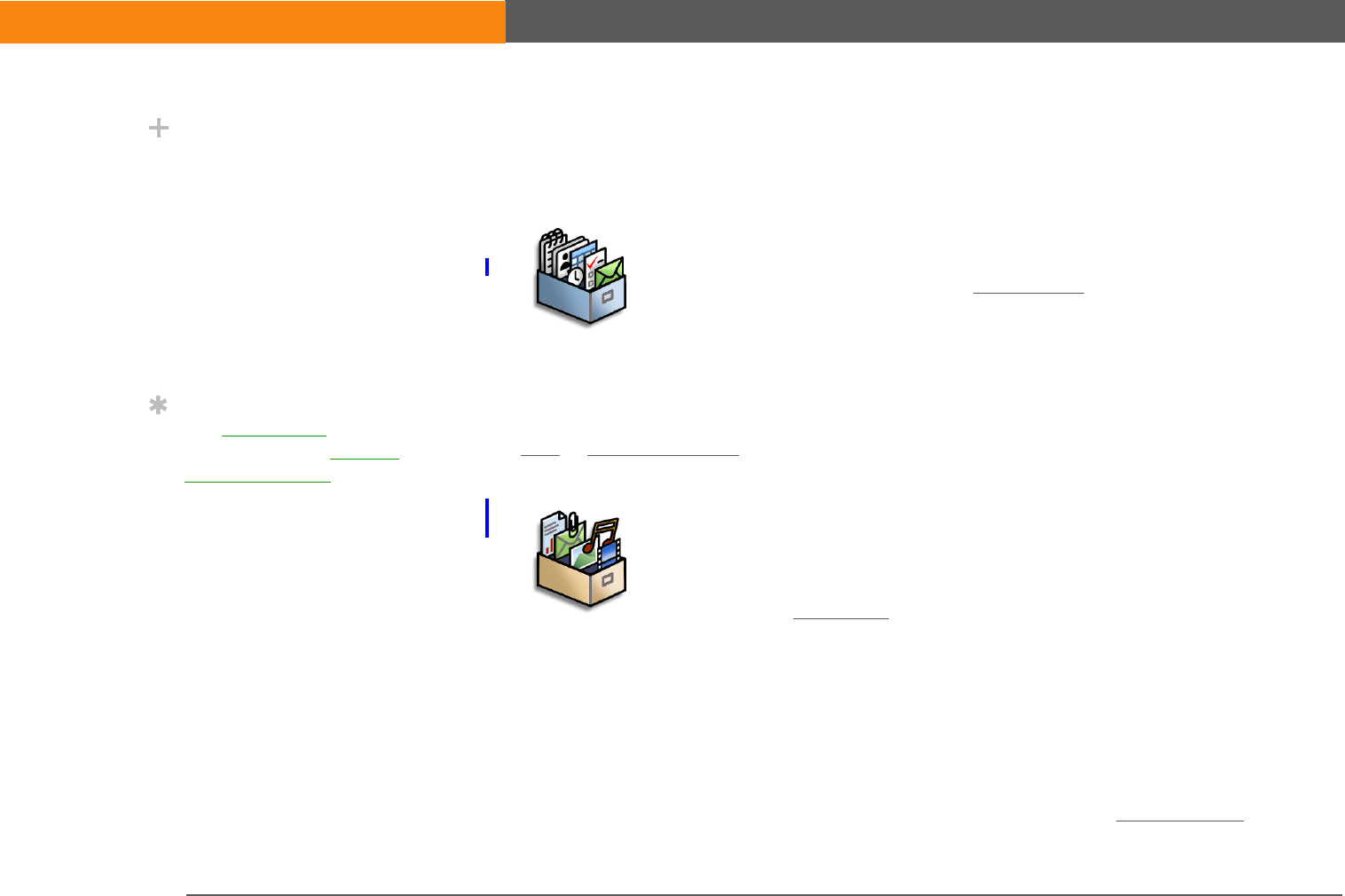
LifeDrive from palmOne 81
CHAPTER 5 Moving and Managing Info Between Your Device and Your Computer
Program memory and the hard drive
Your device contains two types of storage: program memory and the 4GB hard drive.
0
The info for each Palm OS application—for example, individual contact entries—may be stored in
your device’s program memory. You can view and work with this information from within the
application itself. You cannot, however, view any info stored in program memory directly using
Files or LifeDrive Manager.
0
When you copy a file or folder from your computer to your device using LifeDrive Manager, you
can choose to synchronize that file or folder.
Another method of storage that you may already be familiar with is an expansion card. You can
view and access files or folders on an expansion card using the Files application on your device,
and manage your files on a card using LifeDrive Manager or Drive Mode.
Program memory Your device includes 64MB of program memory
for Palm OS® applications such as Contacts, Calendar, Tasks, and
Memos, as well as email messages. Information in program memory
is automatically updated when you do a full sync. For example, if
you enter contact information on your computer, you can
synchronize to update the info in Contacts on your device.
Hard drive The 4GB hard drive (approximately 3.85GB of memory
available to the user) works similarly to other standard USB drives.
You can store any type of file, folder, or application on this drive.
View and access the contents of the drive using the Files application
on your device, or view the contents using LifeDrive Manager
(Windows) or Drive Mode (Mac and Windows) on your computer.
You can manage items on the drive in various ways: copying,
moving, deleting, renaming, and so on, by using LifeDrive Manager
(Windows) or Drive Mode (Mac and Windows), or Files on your
device.
Did You Know?
Your device saves all
information, including
information on the drive
and in program memory,
even if the battery drains
completely; none of your
information is lost.
Simply recharge to
access the information
again.
Tip
Use Quick Install
(Windows) or the Send To
Handheld droplet (Mac)
to install applications to
program memory.
SECOND DRAFT palmOne, Inc. Confidential

LifeDrive from palmOne 82
CHAPTER 5 Moving and Managing Info Between Your Device and Your Computer
You can also access the files on the drive or on an expansion card by opening the corresponding
application and browsing to the file.
How can I work with information?
There are three main methods for moving and managing information between your device and a
computer. These methods are discussed in detail in this chapter.
LifeDrive Manager (Windows only) Use LifeDrive Manager to transfer files and folders to your
device’s drive. LifeDrive Manager instantly copies or moves the items you select. You can choose
whether to synchronize items you move using LifeDrive Manager, as well as whether to convert
photos and videos for best viewing on your device.
Drive Mode Use Drive Mode when your device connected to a Mac computer to move files
between a computer and your device’s hard drive. Also use Drive Mode to open, move, or copy
files on your device when it’s connected to a Windows computer that does not have LifeDrive
Manager installed.
While you’re using Drive Mode, you cannot use any other feature of your device.
Synchronization Synchronization updates and backs up information between your device and
your computer. Information entered in one place is automatically updated in the other, and info in
your device’s program memory and on the hard drive is backed up on your computer.
You can synchronize in one of two ways: do a full sync of everything on your device using the sync
button on the USB sync cable, or sync selected items on the hard drive using the LifeDrive
Manager.
You can also synchronize to install applications to your program memory.
Tip
Be sure to take your USB
sync cable with you so
that you can connect your
device to another
computer to synchronize,
use LifeDrive Manager, or
use Drive Mode. It’s a
good idea to take your AC
charger with you as well,
especially if you plan to
use Drive Mode to
transfer files to another
computer.
Tip
Enter information for
applications such as
Calendar, Contacts,
Memos, and Tasks in
Palm®Desktop software
or Microsoft Outlook on
your computer, then do a
full sync to transfer the
information to your
device.
SECOND DRAFT palmOne, Inc. Confidential

LifeDrive from palmOne 83
CHAPTER 5 Moving and Managing Info Between Your Device and Your Computer
LifeDrive Manager and Drive Mode
Both LifeDrive Manager and Drive Mode let you work with files and folders between your device
and your computer. So when would you use one method or the other? Here are some common
situations in which you would choose LifeDrive Manager or Drive Mode.
LifeDrive Manager
LifeDrive Manager is available only on Windows computers. Use it in the following situations:
• You are transferring files or folders to your device and want to be able to synchronize them.
• You are transferring photos or videos and want to convert them for best viewing on your device.
• You are carrying a file that cannot be opened on your device and you want to work with it on
another computer.
• You want to work on your device during the transfer process. With LifeDrive Manager, you can
continue to work with information on your device as files or folders are being moved or copied.
You cannot use any of the features of your device when it is in Drive Mode.
Drive Mode
You can use Drive Mode on both Windows and Mac computers. Use it in the following situations:
• You are transferring files or folders to or from a Mac computer.
• You are transferring items using a Windows computer that does not have LifeDrive Manager.
• You have a file on your device that you want to work with using a computer, but you don't want
to copy the file to the computer. With LifeDrive Manager, you must first transfer a file or folder to
your computer before you can open or edit the item. With Drive Mode, you can use the
Windows Explorer or Finder window to open a file or folder directly from your device. So, for
example, if you are a guest at a computer and do not want to put a copy of a confidential file on
that computer, you can use Drive Mode to open and work with the file directly on your device.
Tip
If you are transferring a
large video file and
choose the Format for
device option, you can
interrupt the formatting
process if, for example,
you need to take your
device with you away
from you desk. When you
reconnect your device
and your computer, the
formatting process picks
up where it left off.
SECOND DRAFT palmOne, Inc. Confidential
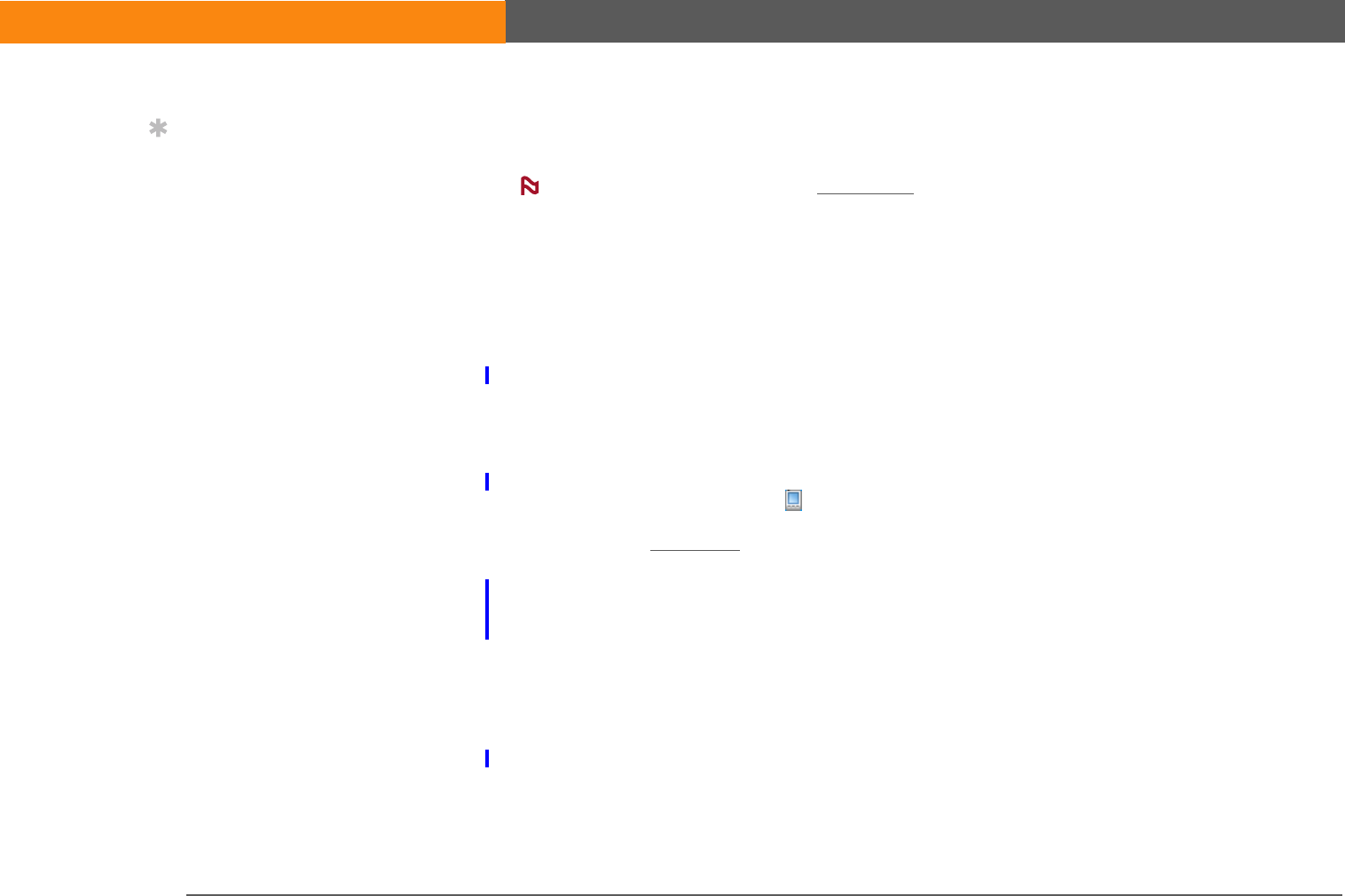
LifeDrive from palmOne 84
CHAPTER 5 Moving and Managing Info Between Your Device and Your Computer
Using LifeDrive Manager
On a Mac computer, use Drive Mode to move files to your device’s hard drive.
WINDOWS ONLY
On a Windows computer, LifeDrive Manager provides a live window to your device’s hard drive.
Use LifeDrive Manager to copy, move, and manage files and folders on your device. LifeDrive
Manager copies and moves items instantly; you do not need to synchronize to transfer the
information. With LifeDrive Manager you can work on your device even while transferring files.
Using LifeDrive Manager, quickly move and carry large numbers of your important Office files,
photos, music, videos, and other files on your device. Use the Files application to access and edit
information on your device, or use Drive Mode to access and edit that information when you’re
connected to a computer that supports external flash drives.
LifeDrive Manager is installed automatically when you install Palm Desktop software. When the
application is installed, an icon appears in the taskbar in the lower-right corner of your
computer screen. Right-click the icon and select menu commands to open LifeDrive Manager or to
synchronize all sync items on the drive.
When you connect your device to your computer and transfer one or more files or folders into the
LifeDrive Manager window, a dialog box appears, asking you how you want the item to be treated.
Select one of the following options:
Copy The items are simply copied to your device and are not updated during synchronization.
Format for device If you transfer photo or video files to your device, you can choose to convert
them to a format that works best on (is optimized for) your device. Converting a photo or video
does any or all of the following, if necessary: changes the item to a format that your device can
display; rotates the item so that it’s displayed correctly; and reduces the file to a size that fits your
device’s screen, resulting in a smaller file size. In some cases, conversion might result in a lower
resolution for the photo or video.
Tip
When you copy a photo
or video to your device,
select the option Format
for device if you plan to
view the item on your
device only. Formatting
reduces the file size and
fits the photo or video to
your device’s screen.
Use the Copy or Keep
Synchronized option if
you plan to transfer the
photo from your device to
another computer. This
keeps the original file
size, resolution, and file
type intact.
NOTE
SECOND DRAFT palmOne, Inc. Confidential
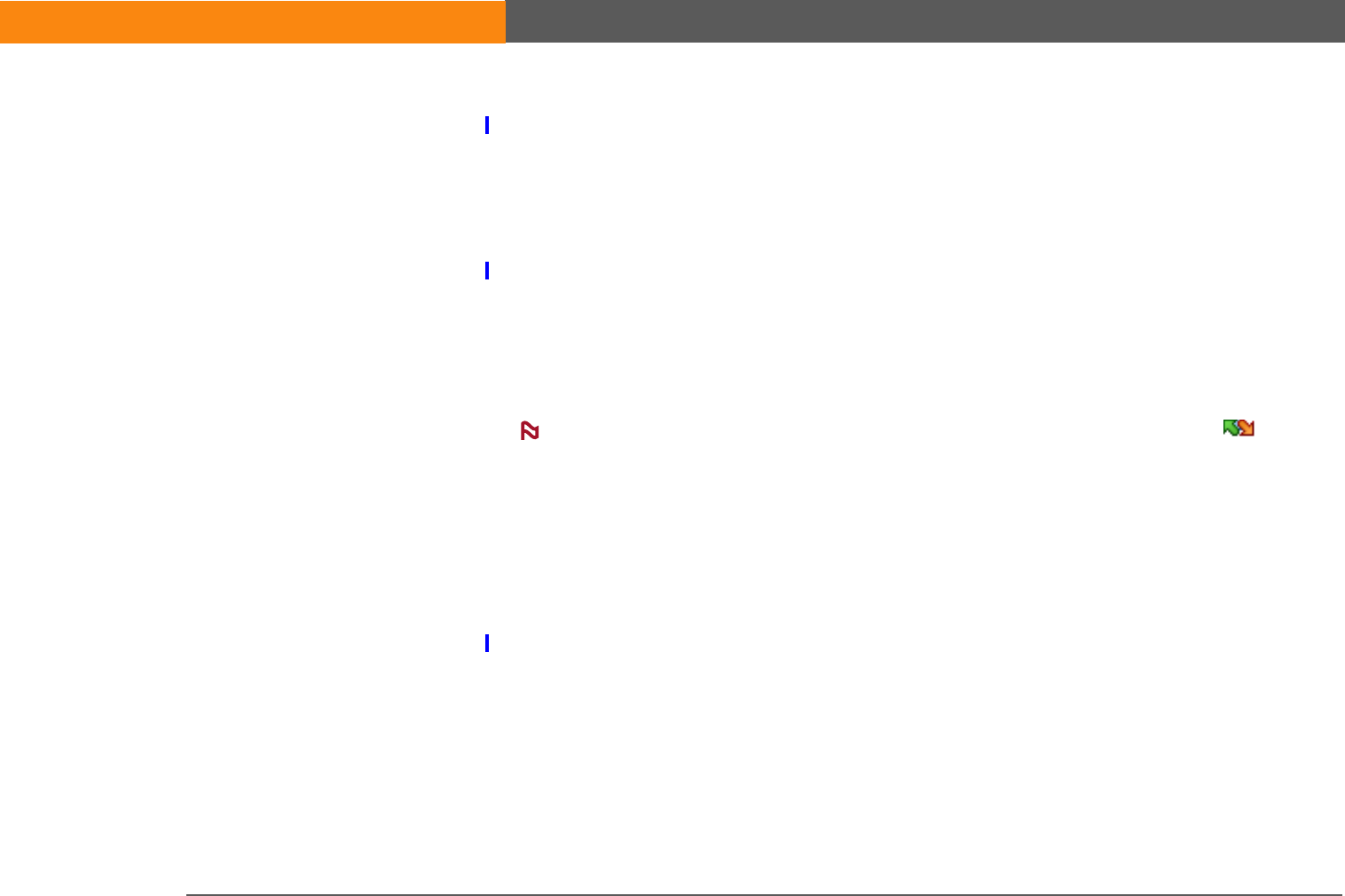
LifeDrive from palmOne 85
CHAPTER 5 Moving and Managing Info Between Your Device and Your Computer
If you choose the Format for device option, the original photo or video remains in its unchanged
format on your computer.
If you are transferring a group of photo and/or video files at once—for example, if you select and
drag them all together or if the files are all in one folder—your formatting choice applies to all of
the files. You cannot choose to format some files transferred as a group and not others.
Keep Synchronized You can choose to make the items you copy sync items—that is, items that
are updated when you synchronize your device with your computer. If you select this option, any
changes you make to the file or folder in one location (device or computer) are made automatically
in the other the next time you synchronize.
If you transfer multiple files or folders at once, your synchronization choice applies to all of the
items; you cannot choose to synchronize some but not others.
If you transfer a file or folder into a folder that displays the sync item icon , the item
becomes a sync item even if you choose Copy or Format for device. However, the item
synchronizes to the corresponding sync folder on your computer, not to the original file or folder.
So you have two versions of the file or folder on your computer: the original one in its original
location (which does not sync), and the new one in the sync folder (which does sync).
For example, suppose you copy a music file called MySong in the MyMusic folder on your
computer to the Music folder on your device, which you have set as a sync folder. You choose
Copy during the transfer. Because the Music folder is a sync folder, when you synchronize, a copy
of the Music folder containing the file MySong appears on your computer. However, the original
file MySong remains in the MyMusic folder on your computer and is not synchronized.
Transferring information using the LifeDrive Manager icon
If you want your files or folders to go to a default location on your device, you can simply drag the
items onto the LifeDrive Manager icon on your computer. LifeDrive Manager copies the items to a
specific location on your device’s drive depending on the file types.
NOTE
»
Key Term
Sync item A file or
folder on your device’s
hard drive that you
choose to synchronize. If
you create a sync folder,
all items in the folder—
including any
subfolders—are
automatically sync items.
SECOND DRAFT palmOne, Inc. Confidential
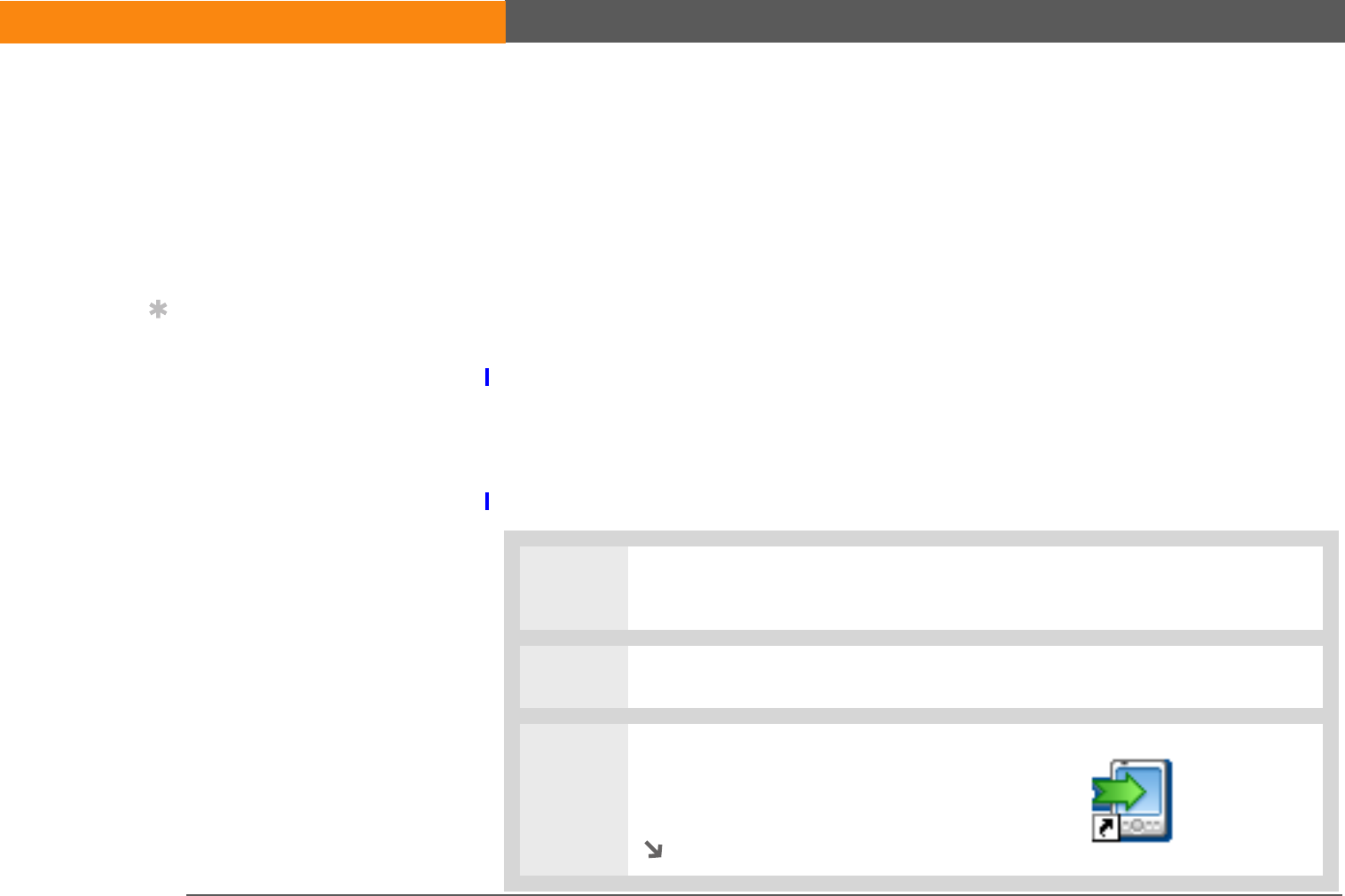
LifeDrive from palmOne 86
CHAPTER 5 Moving and Managing Info Between Your Device and Your Computer
Default folders: Applications, Documents, Music, Photos & Videos LifeDrive Manager copies the
items to one of these four folders if both of the following are true:
•All of the items you drag to the LifeDrive Manager icon are of a type associated with one of
these folders—for example, JPG, BMP, and ASF files that are associated with the Photos & Video
folder.
• You select the Copy or the Format for device option.
Root level of the drive LifeDrive Manager copies all of the items to the root level of the hard
drive—not to a specific folder—if any of the following are true:
•Any of the items you drag is not associated with a default folder—for example, you transfer
photos, videos, and also a graphic that is not a recognized file type for the Photos & Videos
folder.
• The items are associated with more than one default folder—for example, you are transferring
both photos and music files at the same time.
• You select the Keep Synchronized option.
0
1Connect the USB sync cable to the USB port on the back of your computer, and
then insert the other end into your device.
2Select the item or items you want to copy to your device’s drive.
3Drag the items onto the LifeDrive
Manager icon on your computer
desktop.
Continued
»
Key Term
Root level The “top”
level of the hard drive,
that is, the level of files
and folders you see when
you click the drive icon
itself.
Tip
If you copy a group of
files or folders to the root
level of your device’s
drive, you can then use
the LifeDrive Manager
window to move those
items to the locations you
want on the drive.
SECOND DRAFT palmOne, Inc. Confidential
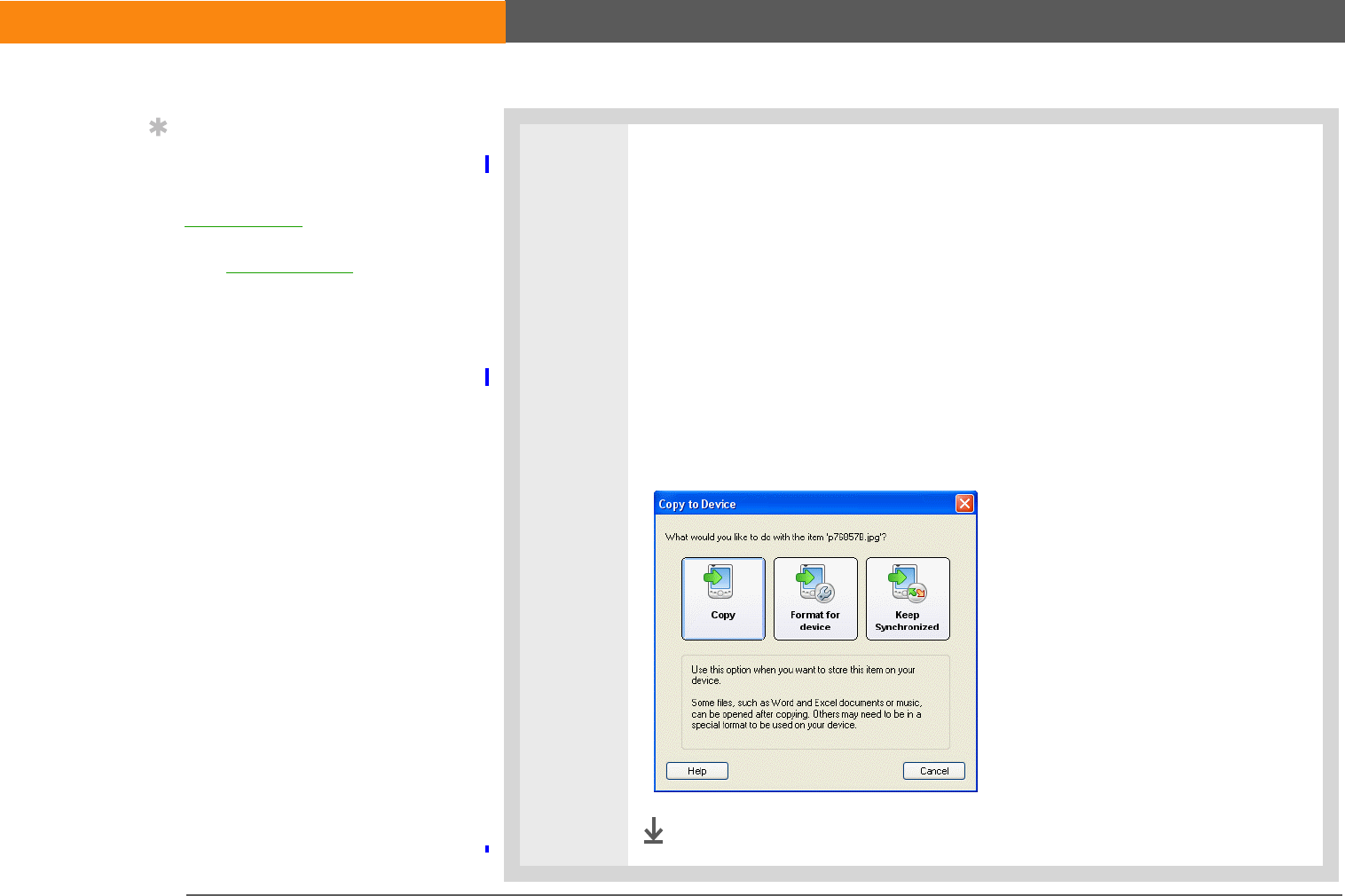
LifeDrive from palmOne 87
CHAPTER 5 Moving and Managing Info Between Your Device and Your Computer
4Select one of the following options:
Copy The items are copied to the correct default folder or to the root level of
your device’s drive. With this option, photos and videos are transferred in their
original format.
Format for device Photos and videos are converted to a format that works best
on your device. This option is available only if the files or folders you are
transferring include one or more photos or videos.
Keep Synchronized The items are copied to the root level of your device’s
drive and are included in synchronization. This means that when an item is
updated on your device, it is automatically updated on your computer, and vice
versa, when you synchronize.
Done
Tip
If another task is running
that uses the USB sync
cable—such as
synchronizing or
transferring music files
with Pocket™ Tunes—
LifeDrive Manager waits
until the task is complete
before the file transfer
takes place.
SECOND DRAFT palmOne, Inc. Confidential
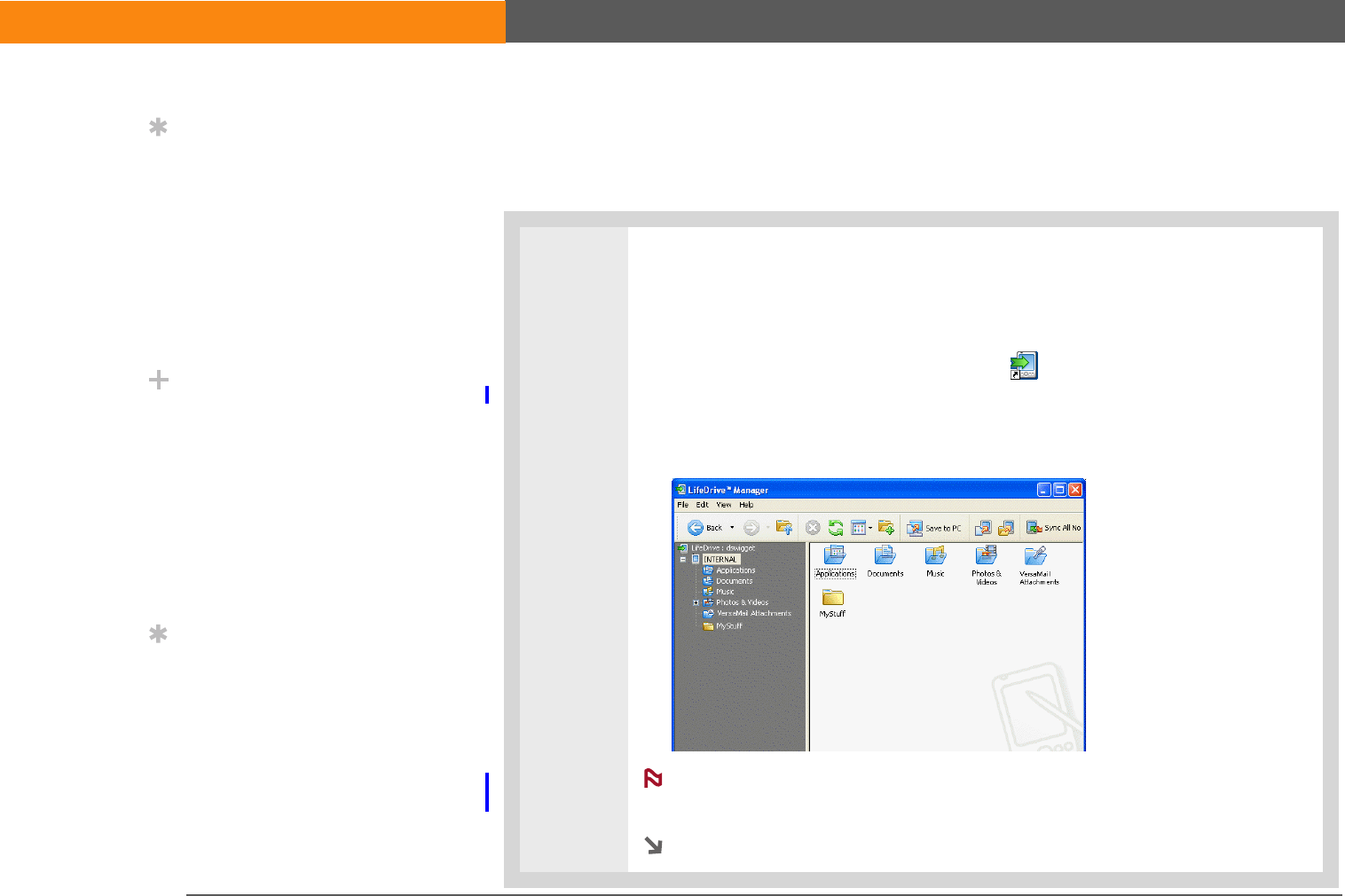
LifeDrive from palmOne 88
CHAPTER 5 Moving and Managing Info Between Your Device and Your Computer
Transferring information using the LifeDrive Manager window
The LifeDrive Manager window lets you place files or folders anywhere on your device’s drive,
regardless of file type.
0f
1Open LifeDrive Manager:
a. Connect the USB sync cable to the USB port on the back of your computer,
and then insert the other end into your device.
b. Double-click the LifeDrive Manager icon on your computer desktop to
open the LifeDrive Manager window. The window opens to display the
contents of the drive on your device; if an expansion card is inserted into
your device’s expansion slot, the window displays the card’s contents as
well.
If your device is not connected to your computer or is unavailable,
a message appears.
Continued
Tip
You can also open the
LifeDrive Manager
window by right-clicking
the LifeDrive Manager
icon in the taskbar in the
lower-right corner of your
computer screen and
then selecting Open
LifeDrive Manager.
Did You Know?
Your device’s drive
appears in the LifeDrive
Manager window as an
icon named INTERNAL,
but you can rename it
anything you want. Right-
click the icon, click
Rename, and then enter a
new name for the drive.
Tip
If you do not see any files
or folders on the drive or
an expansion card, click
the plus-sign icon to the
left of the drive/card
name in the left pane of
the LifeDrive Manager
window.
NOTE
SECOND DRAFT palmOne, Inc. Confidential
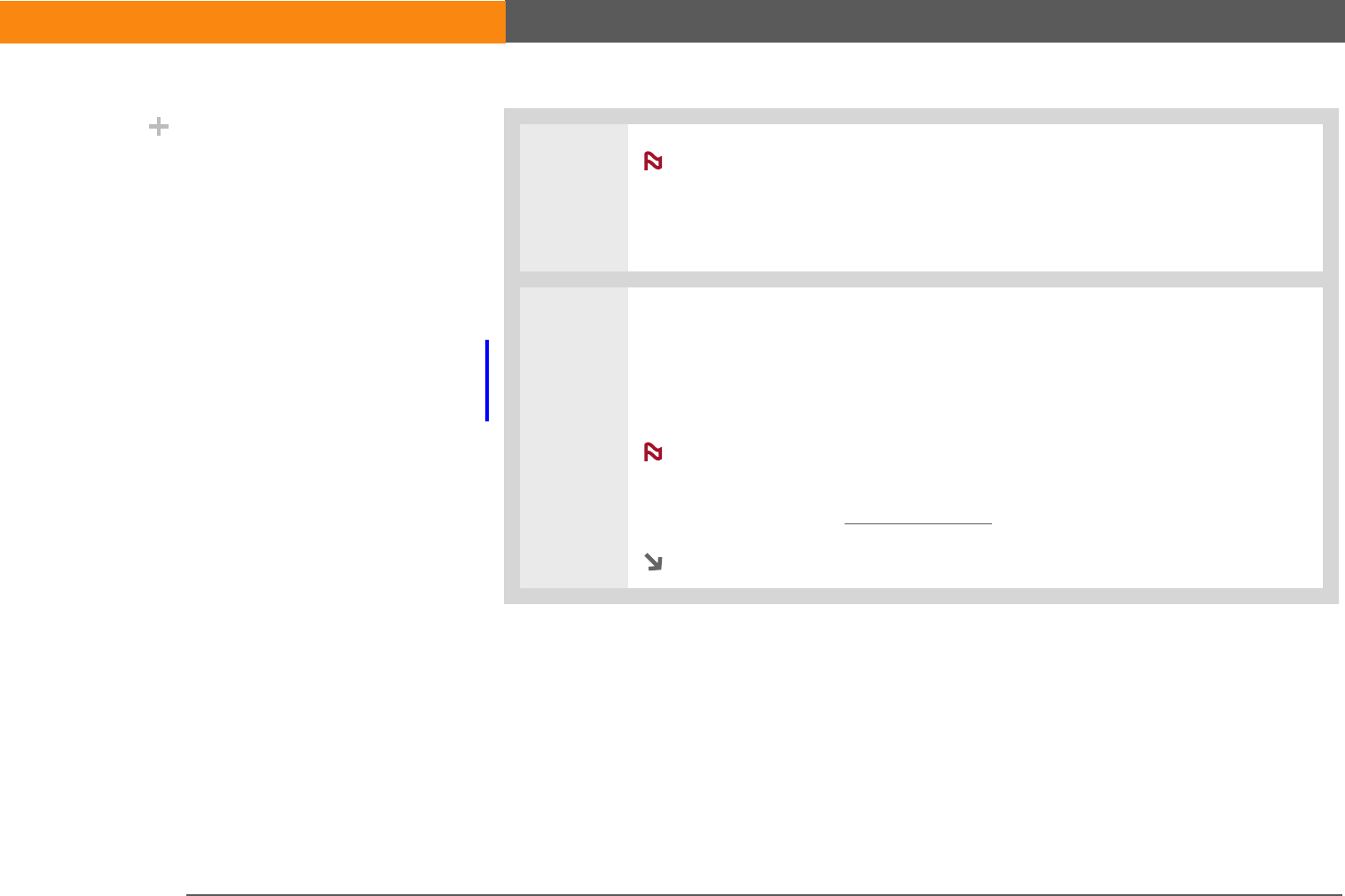
LifeDrive from palmOne 89
CHAPTER 5 Moving and Managing Info Between Your Device and Your Computer
Cont’d.
LifeDrive Manager recognizes any security preferences you set for
your device. For example, if your device is locked, LifeDrive Manager displays
an alert message stating that you must unlock your device before using
LifeDrive Manager. A message also appears if your device is not connected to
your computer or is unavailable for any other reason.
2Drag, copy, or move files or folders from the desktop into the LifeDrive Manager
window to the location you want on your device’s drive. You can also open the
folder to which you want to move the files on your device’s drive, and then click
the Copy Files from PC <ICON> or Copy Folder from PC <ICON> button on the
LifeDrive Manager toolbar.
You can use LifeDrive Manager to install an application in the
Applications folder on your drive, but only some applications are designed to
run on your device from that location. To ensure that the application will run on
your device, install it to program memory.
Continued
NOTE
Did You Know?
You can work with files
and folders in the
LifeDrive Manager
window in many of the
same ways that you work
with files and folders in
Windows Explorer. For
example, click a plus sign
to the left of a folder
name to view the
contents of a folder;
select multiple items
using the Control or Shift
buttons on your
keyboard; or click the
Refresh button to view
updated contents of the
device’s internal drive or
expansion card.
You can also manage files
or folders by right-
clicking a file or folder
name to open a menu
that lets you rename,
move, copy, delete, and
perform other tasks on
the file or folder.
NOTE
SECOND DRAFT palmOne, Inc. Confidential
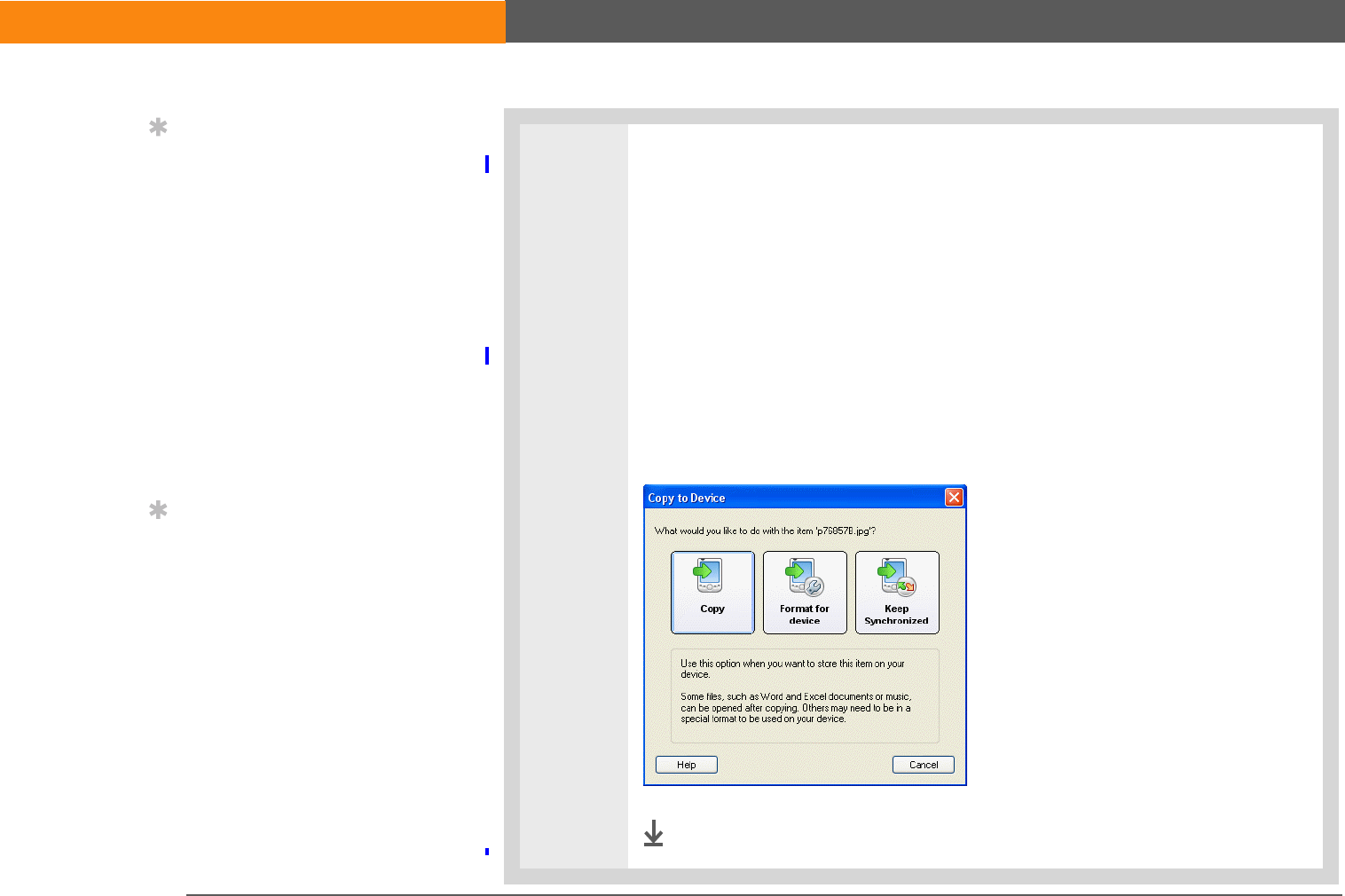
LifeDrive from palmOne 90
CHAPTER 5 Moving and Managing Info Between Your Device and Your Computer
3Select one of the following options:
Copy The items are copied to the location you specify. With this option,
photos and videos are transferred in their original format.
Format for device Photos and videos are converted to a format that works best
on your device. This option is available only if the files or folders you are
transferring include one or more photos or videos.
Keep Synchronized The items are copied to the root level of your device’s
drive and are included in synchronization. This means that when an item is
updated on your device, it is automatically updated on your computer, and vice
versa. This option is available only if you are transferring files or folders to the
root level of your device’s drive.
Done
Tip
You can also transfer files
or folders from your
device to your computer
by dragging the item
from the LifeDrive
Manager window onto
your computer desktop.
Likewise, you can drag an
item from folder to
another on your device’s
drive in the LifeDrive
Window to transfer it—or
right-click on an item and
select Copy, then right-
click on the destination
folder and click Paste.
Tip
You cannot double-click a
file in LifeDrive Manager
to open it, as you do in
Windows Explorer. If you
double-click a file in
LifeDrive Manager, you
are prompted to save the
file to your computer
before opening and
working on it on your
computer. After working
on the file on your
computer, use LifeDrive
Manager to move or copy
the file back to your
device.
SECOND DRAFT palmOne, Inc. Confidential
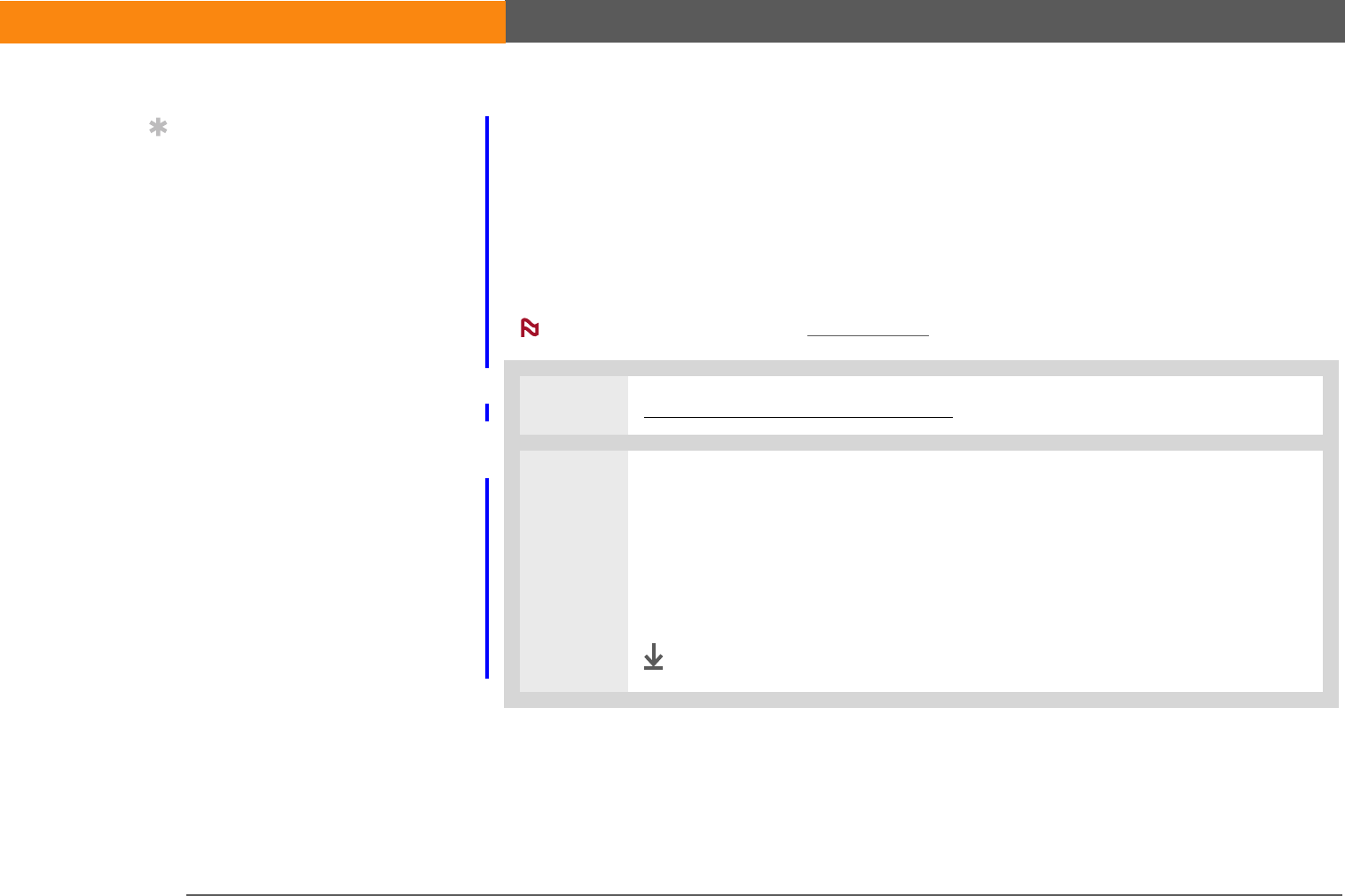
LifeDrive from palmOne 91
CHAPTER 5 Moving and Managing Info Between Your Device and Your Computer
Renaming a file or folder
You can use LifeDrive Manager to change the name of a file that is on your device. For example,
you may want to add the date or your initials at the end of a file that you have changed.
If you rename a sync item—either a file or a folder—on your device, the next time you synchronize,
the item is renamed on your computer. If you rename a sync item on your computer, the next time
you synchronize, both the original item with the original name and the renamed item are located
on your computer.
You cannot rename the default folders on your device drive.
0
1Open the LifeDrive Manager window.
2Rename the item:
a. Right-click the item you want to rename.
b. Select Rename.
c. Type the new name, and then press Enter on your computer keyboard.
Done
NOTE
Tip
You can also select the
item you want to rename
and then press F2 on your
computer keyboard to
enter the new name.
SECOND DRAFT palmOne, Inc. Confidential
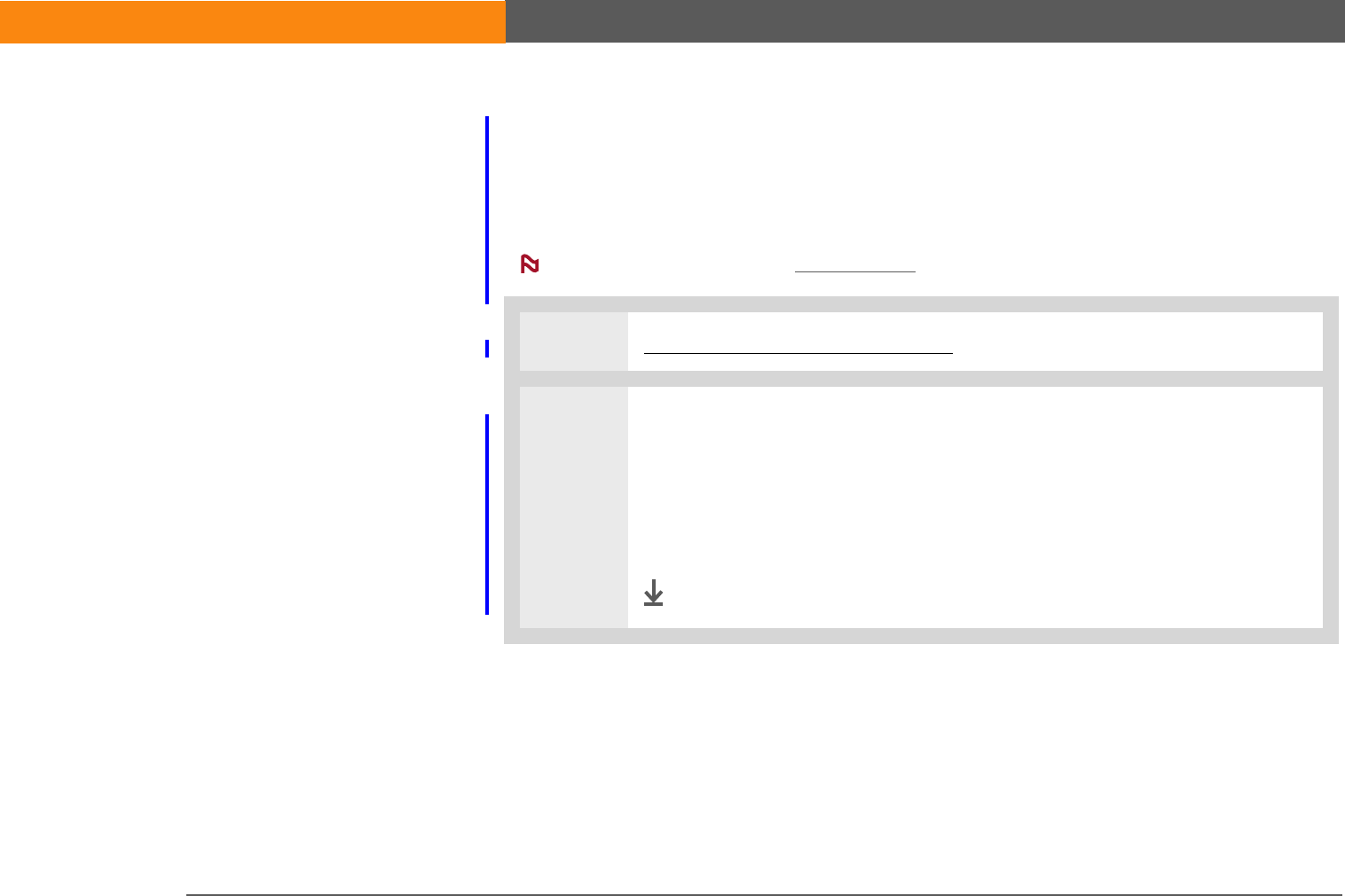
LifeDrive from palmOne 92
CHAPTER 5 Moving and Managing Info Between Your Device and Your Computer
Deleting a file or folder
When you delete a file or folder in the LifeDrive Manager window, you only delete it from your
device. If the file or folder is a sync item, however, and you don't want it to show up on your
device again the next time you synchronize, you need to turn on a setting to delete the item from
your computer as well.
You cannot delete the default folders on your device drive.
0
1Open the LifeDrive Manager window.
2Delete the item:
a. Right-click the item you want to delete.
b. Select Delete.
c. Select Yes to confirm that you want to delete the file.
Done
NOTE
SECOND DRAFT palmOne, Inc. Confidential
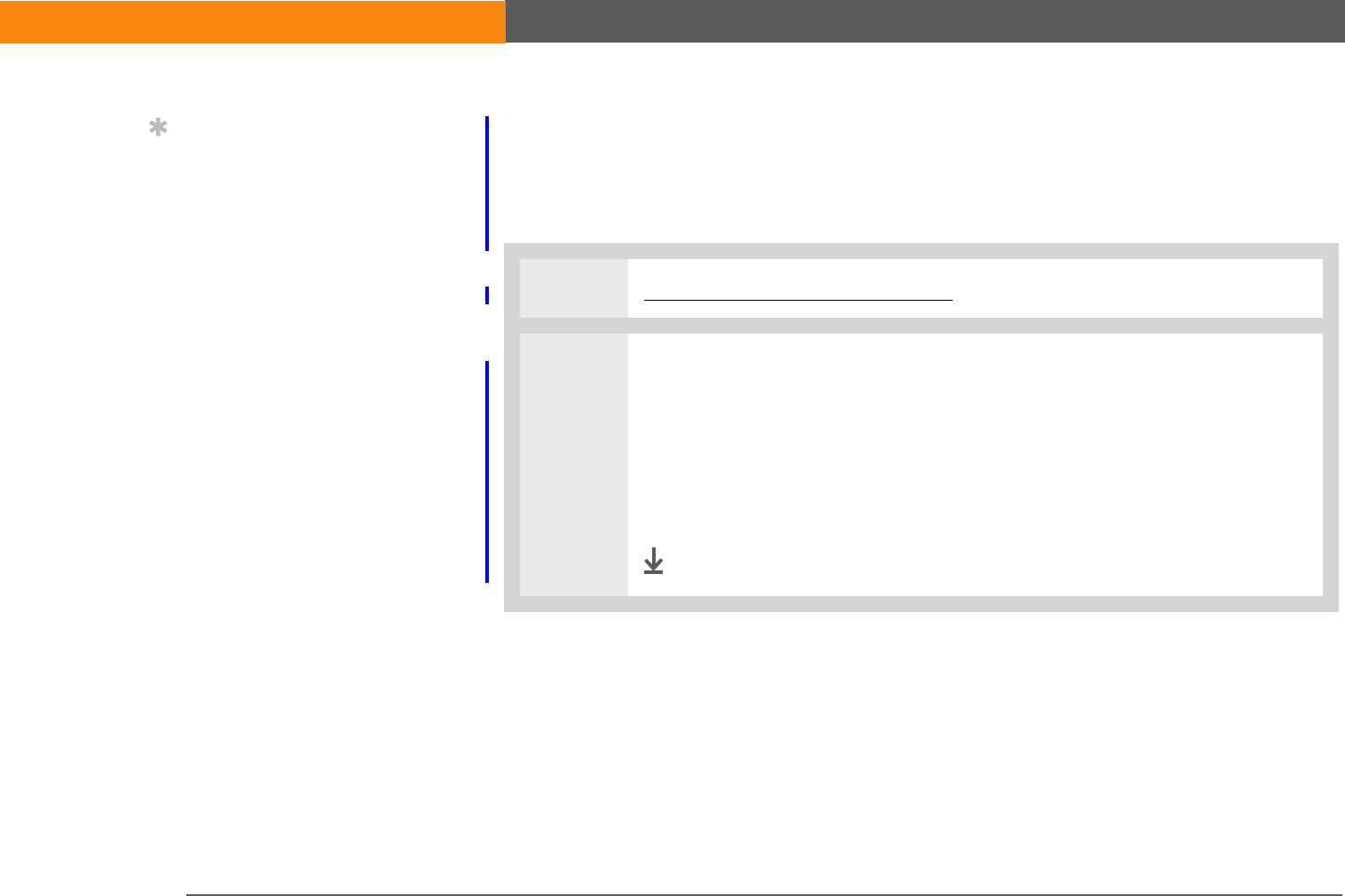
LifeDrive from palmOne 93
CHAPTER 5 Moving and Managing Info Between Your Device and Your Computer
Deleting sync items from your computer when they are deleted from
your device
When you turn on the setting to delete a sync item from your computer and then delete the item
from your device, the item is deleted from your computer the next time you synchronize.
0
1Open the LifeDrive Manager window.
2Set up automatic deletion:
a. Right-click a folder containing the item or items you want to delete. The
folder must be a sync item.
b. Select Properties, and then click the Synchronize tab.
c. Select Delete Files on Your PC, and then click OK.
Done
Tip
The Properties dialog box
contains a Properties tab
that displays information
about the selected files or
folders and lets you
change file or folder
attributes. See the
LifeDrive Manager online
Help for detailed
information. In the
LifeDrive Manager
window, open the Help
menu and select
LifeDrive Manager Help.
SECOND DRAFT palmOne, Inc. Confidential
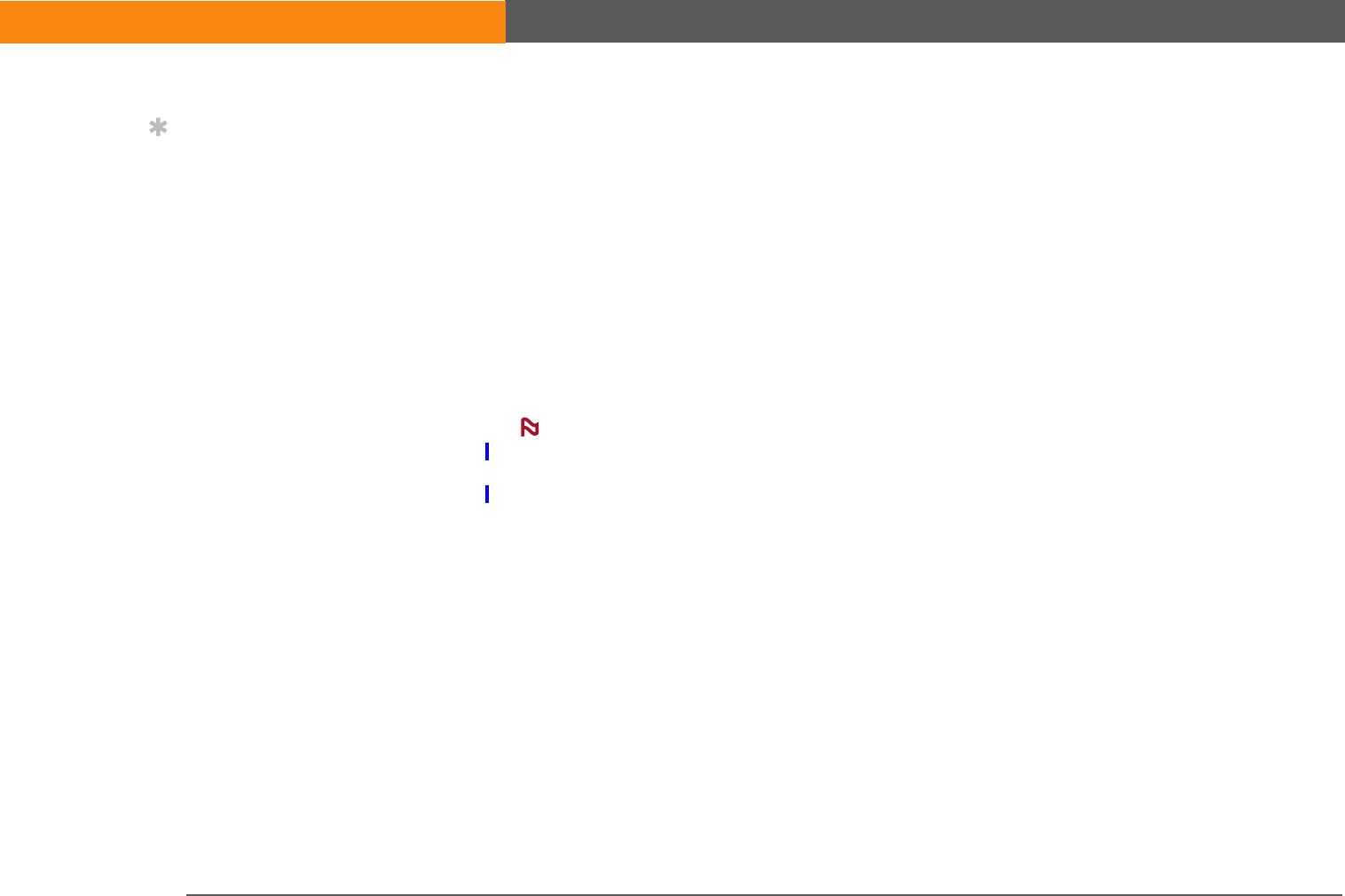
LifeDrive from palmOne 94
CHAPTER 5 Moving and Managing Info Between Your Device and Your Computer
Using Drive Mode
On a Mac computer, use Drive Mode to move files between a computer and your device’s hard
drive.
If you are at a Windows computer that doesn’t have LifeDrive Manager installed—a computer at a
hotel or your friend’s house, for example—use Drive Mode to open, move, or copy files on your
device. With Drive Mode, your device connects to your computer like an external removable drive
such as a CD drive.
The computer must support external removable drives in order for you to use Drive Mode with the
computer. Most current operating systems such as Windows 2000, Windows XP, and Mac OS X
support external removable drives.
While you’re using Drive Mode, you cannot use any other feature of your device,
including LifeDrive Manager and synchronization. You can, however, continue to receive alerts
such as notifications of appointments or new email messages. If you select an alert or attempt to
use your device in some other way—for example, by pressing a quick button—a message appears,
asking if you want to continue using Drive Mode or disconnect from Drive Mode to use your
device.
NOTE
Tip
If you plan to use Drive
Mode, remember to bring
your USB sync cable and
AC charger with you, so
you can connect to other
computers.
SECOND DRAFT palmOne, Inc. Confidential
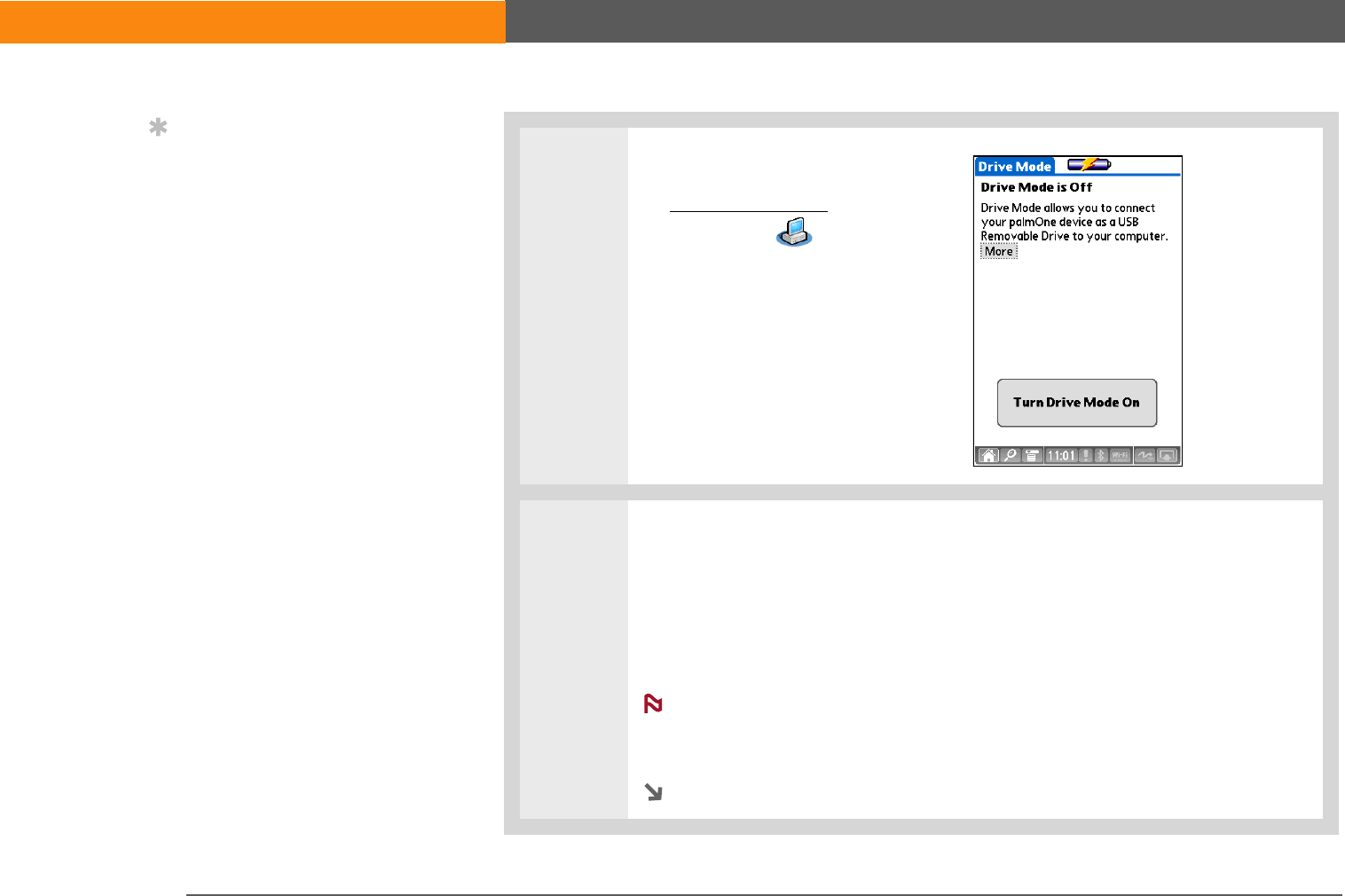
LifeDrive from palmOne 95
CHAPTER 5 Moving and Managing Info Between Your Device and Your Computer
0
1Turn on Drive Mode:
a. Go to Applications and select
Drive Mode .
b. Select Turn Drive Mode On.
2Prepare your device and your computer:
a. Connect the USB sync cable to the USB port on the back of the computer,
and then insert the other end into your device.
b. Connect the AC charger cable to the USB sync cable, and then plug it into a
power outlet.
You can use Drive Mode without plugging your device into a power
outlet, but we recommend that you keep it plugged in to avoid losing
information.
Continued
Tip
If you format your
device’s hard drive or an
expansion card while in
Drive Mode, be sure to
select the file system type
FAT; do not select FAT32
or any other file system
type. If you select any
other file system type,
your device cannot
recognize the information
on the internal drive or on
the card. Note that if you
reformat the hard drive,
all information on the
drive is deleted—and if
there are sync items and
you have selected the
Delete on PC option,
those items are deleted
on your computer as well
the next time you
synchronize.
NOTE
SECOND DRAFT palmOne, Inc. Confidential
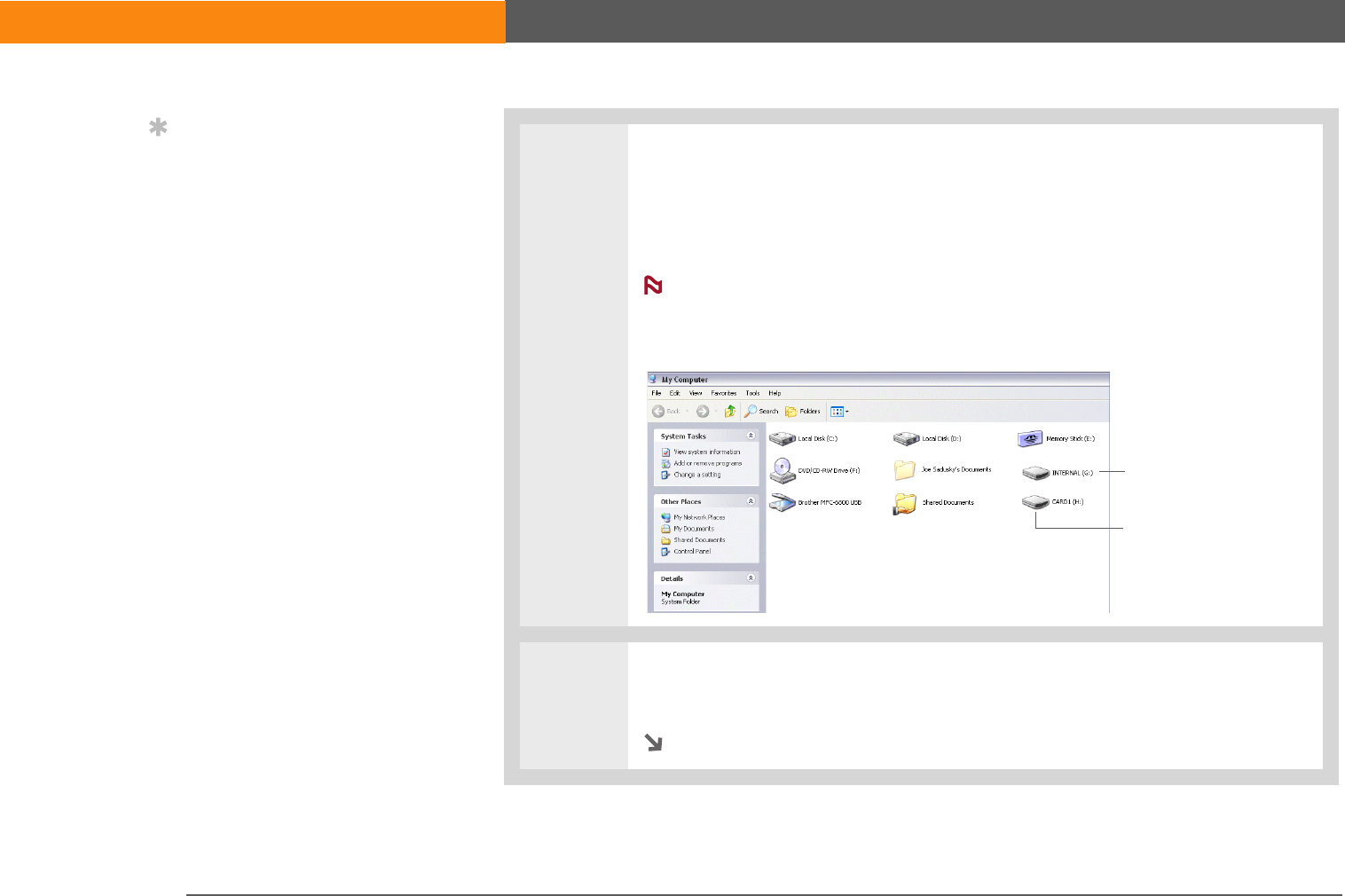
LifeDrive from palmOne 96
CHAPTER 5 Moving and Managing Info Between Your Device and Your Computer
3Open My Computer or Windows Explorer on a Windows computer, or Finder on
a Mac computer. Look for the icon named INTERNAL, representing your device
in the list of available drives on the computer. If there is an expansion card
inserted into your device’s expansion slot, it may appear as a drive named
CARD.
On a Windows computer, the expansion card icon may appear even if
there is no card inserted into your device’s expansion card slot. If you try to
work with the icon, an error message appears.
4Work with the files on your device as you would on any other external
removable drive.
Continued
Tip
You can work with files
and folders on your
device in Drive Mode in
exactly the same way that
you work with any other
file or folder in My
Computer, Windows
Explorer, or Finder.
Unlike in LifeDrive
Manager, you can
double-click a file from
the computer’s window
to open it from your
device in Drive Mode, as
long as your computer
has software that can
open the file.
NOTE
Device appears as
drive named
INTERNAL
Expansion card
appears as drive
named CARD
SECOND DRAFT palmOne, Inc. Confidential
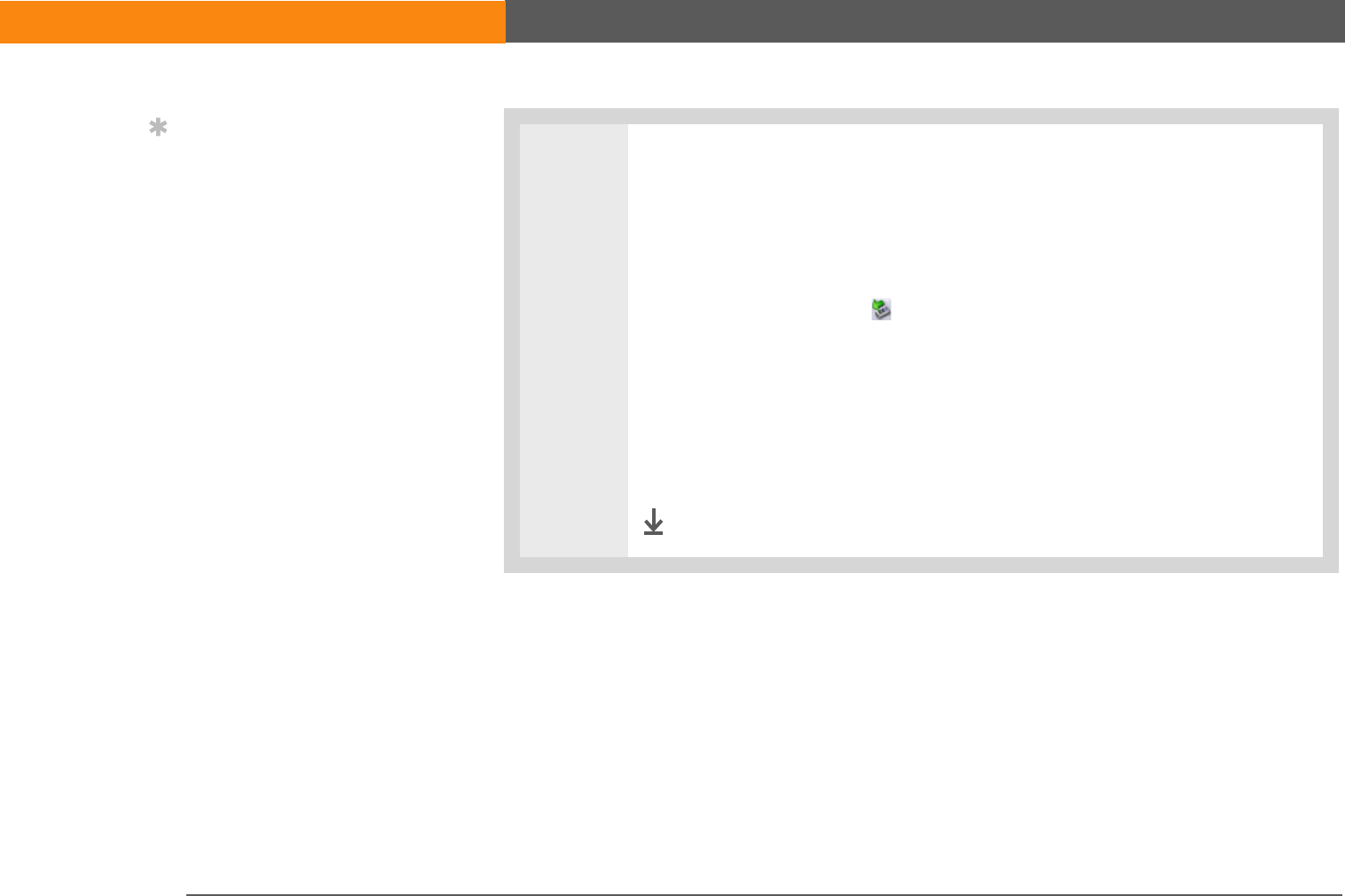
LifeDrive from palmOne 97
CHAPTER 5 Moving and Managing Info Between Your Device and Your Computer
5When you have finished working with Drive Mode, do the following:
To avoid losing any information that was transferred, be sure
to follow these steps to disconnect from Drive Mode before you unplug your
device from your computer.
a. Eject the device from your Windows computer by selecting the Safely
Remove Hardware icon in the taskbar in the lower-right corner of your
computer screen. Select the option Stop Mass Storage USB Device that
contains the drive letter for the device or the expansion card, and then wait
for the message that says you can safely remove your device from your
computer. On a Mac computer, select the Eject command from the File menu
or drag the drive icon to the Eject icon on the Dock. If a confirmation
message appears, click OK.
b. Select Turn Drive Mode Off on your device screen, and then select Turn Off.
Done
Tip
If you are working with an
expansion card, you must
eject the device from the
computer before
removing the card in
order to avoid losing info
on the card.
IMPORTANT
[!]
SECOND DRAFT palmOne, Inc. Confidential
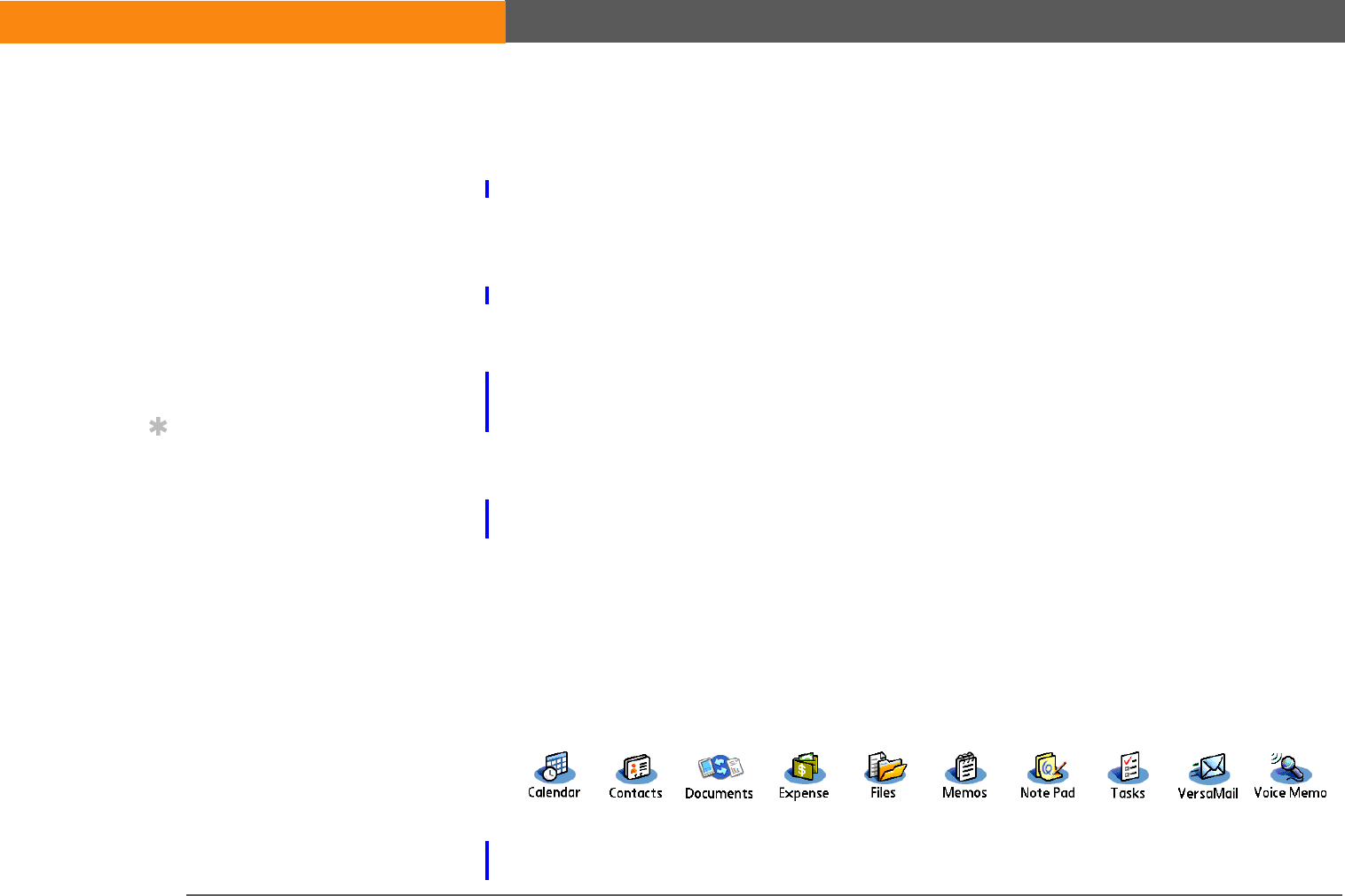
LifeDrive from palmOne 98
CHAPTER 5 Moving and Managing Info Between Your Device and Your Computer
Synchronizing information
Synchronizing means that information that is entered or updated in one place (your device or your
computer) is automatically updated in the other. There’s no need to enter information twice.
You can synchronize in one of two ways:
Full sync Press the sync button on the USB sync cable to synchronize all information in your
device’s program memory, as well as all sync items on the hard drive, with info on your computer.
Full sync also backs up any files or folders on your hard drive that are not sync items to your
computer.
Folder sync (Windows only) Use the sync commands in the LifeDrive Manager window to
synchronize a single sync item, a group of sync items, or all sync items on your device’s drive, with
the corresponding info on your computer. Sync items can be individual files or entire folders,
including subfolders. You cannot synchronize info in program memory using the LifeDrive
Manager window.
Be sure to synchronize your device with your computer frequently so that you
always have an up-to-date backup copy of the info on your device on your computer.
Doing a full sync
When you perform a full sync, the following information is updated between your device and your
computer:
Program memory If you use the default settings, information from all the following applications
in program memory is transferred each time you synchronize your device with your computer
using the button:
If you choose to synchronize with Outlook, info from Contacts, Calendar, Tasks, and Memos is
synchronized with info in the same application in Outlook (Memos is called Notes in Outlook). You
can also set up the VersaMail® application to synchronize email on your device with email in
»
Key Term
HotSync®Techn ol ogy
that allows you to
synchronize the
information in your
device’s program
memory and any files or
folders on the drive that
you selected to copy and
synchronize with the
information on your
computer.
Tip
Folder sync is faster than
a full sync, because it
only synchronizes the
items you select. IMPORTANT
[!]
SECOND DRAFT palmOne, Inc. Confidential
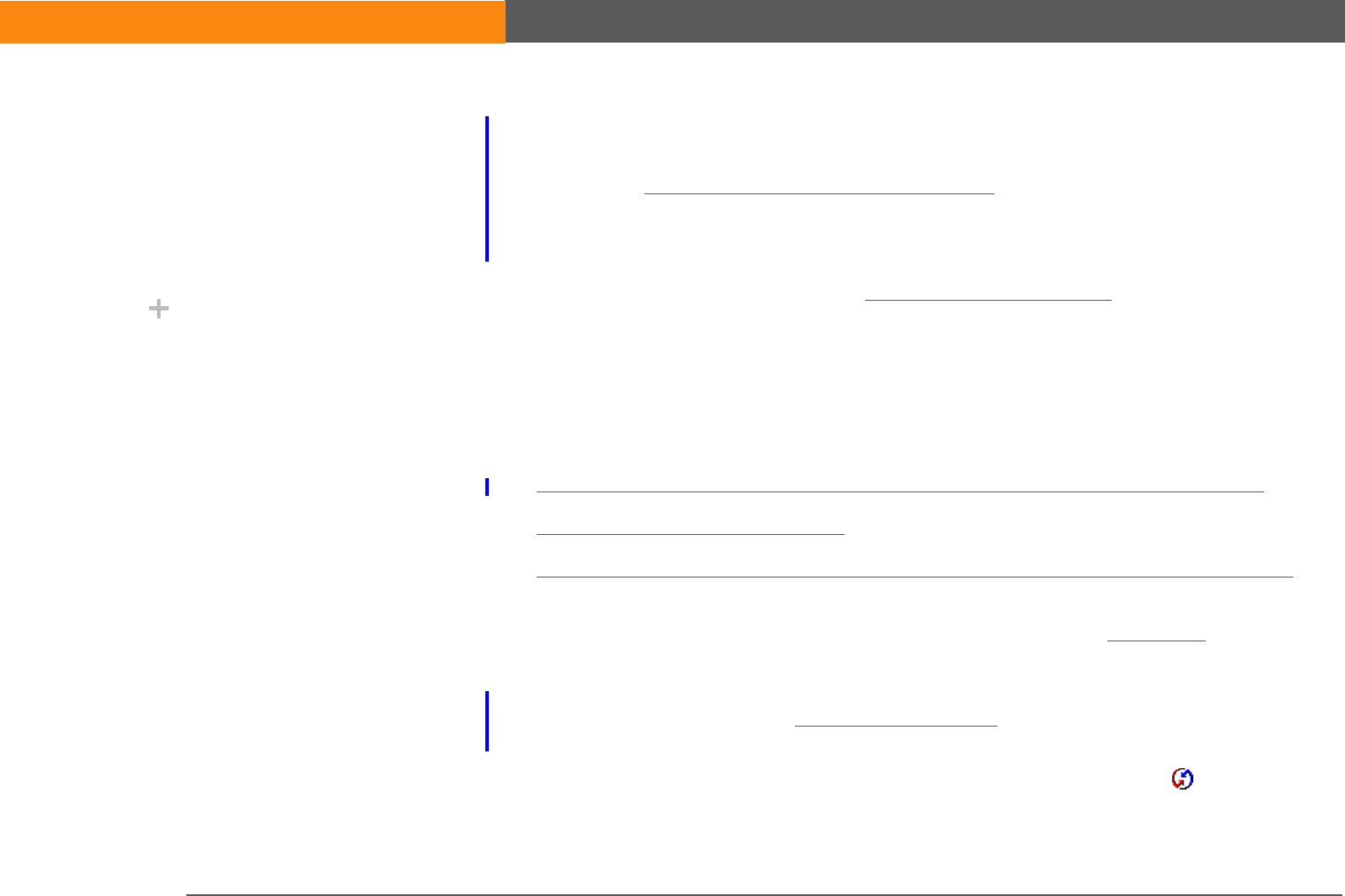
LifeDrive from palmOne 99
CHAPTER 5 Moving and Managing Info Between Your Device and Your Computer
Outlook. Other info, such as voice memos and notes, is synchronized with the corresponding info
in Palm Desktop software.
If you set up a Microsoft Exchange ActiveSync® account so that you can synchronize email and
Calendar information with info in Microsoft Exchange Server 2003, info from those applications is
synchronized with info in Microsoft Exchange, while information from the other applications listed
previously is synchronized with info in Outlook or Palm Desktop.
Desktop software Any information you enter using desktop software is updated with info in
your device’s program memory.
Sync items Any sync items on your device’s hard drive are updated.
You can do a full sync in the following ways:
• Using the USB sync cable attached to your device and your computer
•Wirelessly using Bluetooth® wireless technology or Wi-Fi® capabilities on your device
• Using your device’s infrared (IR) port
• Connecting to your company’s network, either wirelessly or using a cable (Windows only)
The first time you synchronize, you must use the USB sync cable or your
device’s IR port. If you followed the instructions to synchronize during initial setup, you’ve already
covered this requirement.
To synchronize, HotSync Manager must be active. HotSync Manager is installed when you install
Palm Desktop software from the software installation CD. If you haven’t run the install program
from the CD, you don't have HotSync Manager on your computer.
On a Windows computer, you know HotSync Manager is active when its icon appears in the
lower-right corner of your screen. If the icon is not there, turn it on by clicking Start and then
selecting Programs. Navigate to the palmOne program group, and select HotSync Manager.
»
Key Term
HotSync®
Manager Software you
use to select
synchronization settings
and that must be active
when you synchronize.
Did You Know?
Everybody in your family
can synchronize their
device with the same
copy of Palm Desktop
software. Just make sure
that each device has its
own username; Palm
Desktop software reads
the username and
recognizes the device
during synchronization.
IMPORTANT
[!]
SECOND DRAFT palmOne, Inc. Confidential
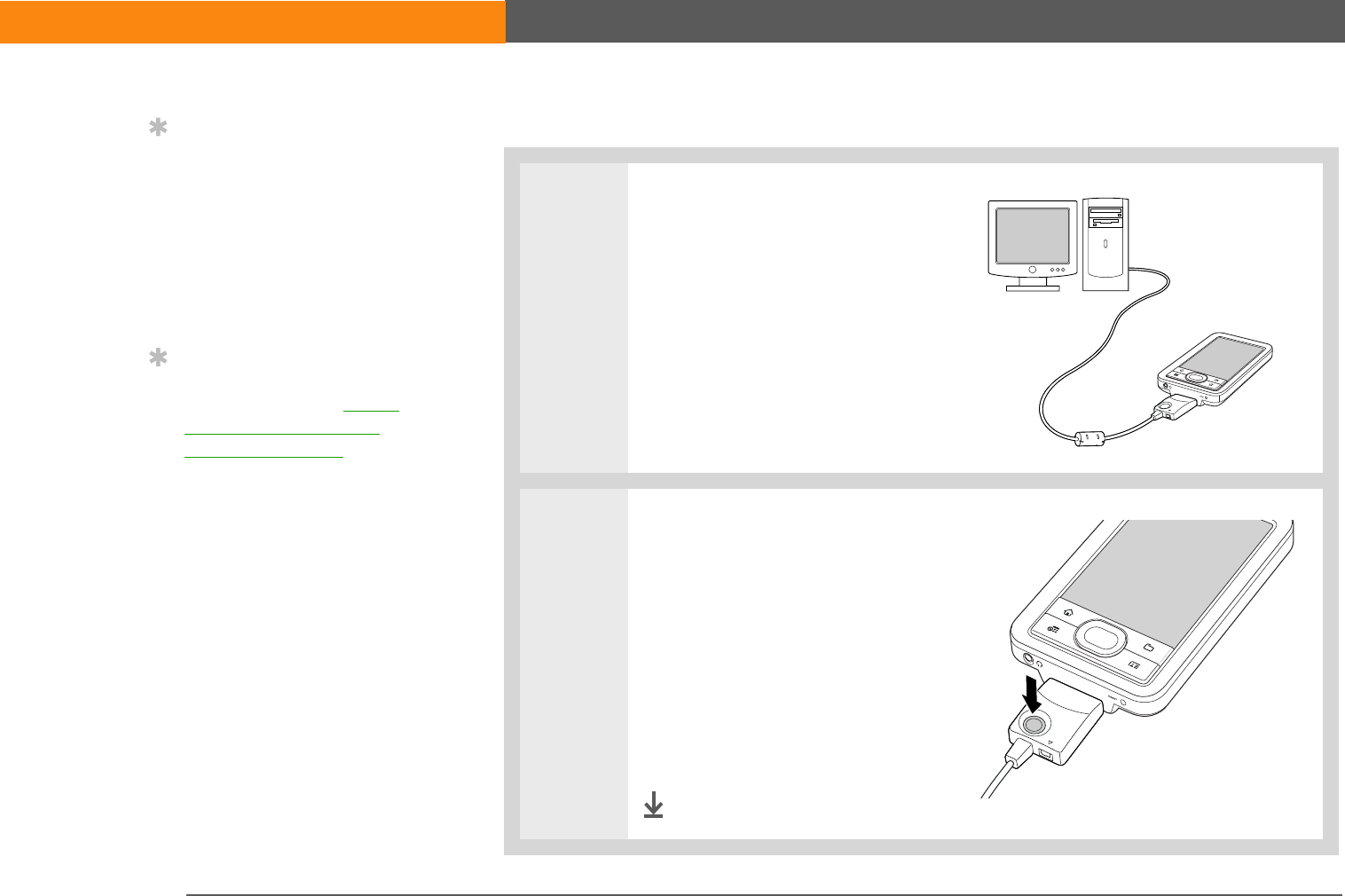
LifeDrive from palmOne 100
CHAPTER 5 Moving and Managing Info Between Your Device and Your Computer
Synchronizing using the cable
0
1Connect the USB sync cable to
the USB port on the back of your
computer, and then insert the
other end into your device.
2Synchronize your device with
your computer:
a. Press the sync button on the
USB sync cable.
b. When synchronization is
complete, a message appears
at the top of your device
screen, and you can
disconnect your device from
the cable.
Done
Tip
If the Select User dialog
box appears during
synchronization, select
the username of the
person whose
information you want to
synchronize, and then
click OK.
Tip
If you need help with
synchronizing, see I can’t
synchronize my device
with my computer.
SECOND DRAFT palmOne, Inc. Confidential
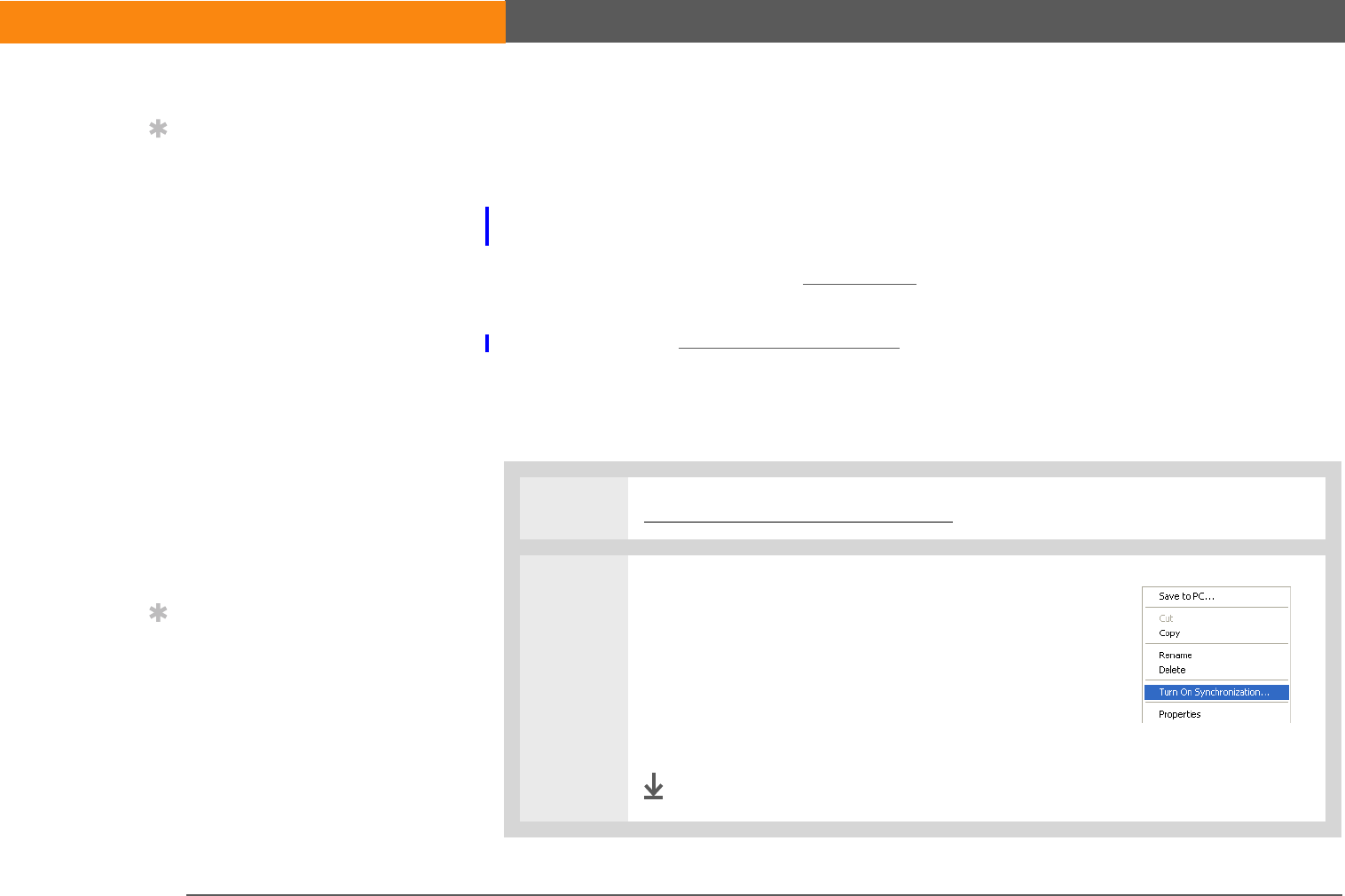
LifeDrive from palmOne 101
CHAPTER 5 Moving and Managing Info Between Your Device and Your Computer
Synchronizing using LifeDrive Manager
WINDOWS ONLY
When you transfer an item into the LifeDrive Manager window, you can identify whether you want
to keep the item synchronized with its original on the computer. When you’re ready to do a folder
sync, you can select whether to sync selected items, or all sync items on your device's hard drive.
LifeDrive Manager synchronizes only the items you select on the hard drive, not any of the
information in program memory. Do a full sync to synchronize both hard drive sync items and
program memory info.
If you selected the Keep Synchronized option when you transferred a file or folder to your device,
that item is already a sync item. However, you can turn off synchronization for any such folder or
file.
Creating sync items
0
1Open the LifeDrive Manager window.
2Select items to synchronize:
a. Navigate to the file or folder you want in the
LifeDrive Manager window.
b. Right-click the item’s icon, and then select Turn on
synchronization. The file or folder is now a sync
item.
Done
Tip
When you synchronize,
any items on the hard
drive that are not sync
items are backed up to
your computer. Backing
up puts a copy of the file
or folder on your
computer, but it doesn't
keep the two versions in
sync. You can manually
back up an item in
LifeDrive Manager by
right-clicking the file or
folder and selecting Save
to PC, or by clicking the
item and selecting the
Save to PC icon from the
LifeDrive Manager
toolbar.
Tip
To tu rn o ff
synchronization for a file
or folder, right-click the
item’s icon, and then
select Turn off
synchronization.
SECOND DRAFT palmOne, Inc. Confidential
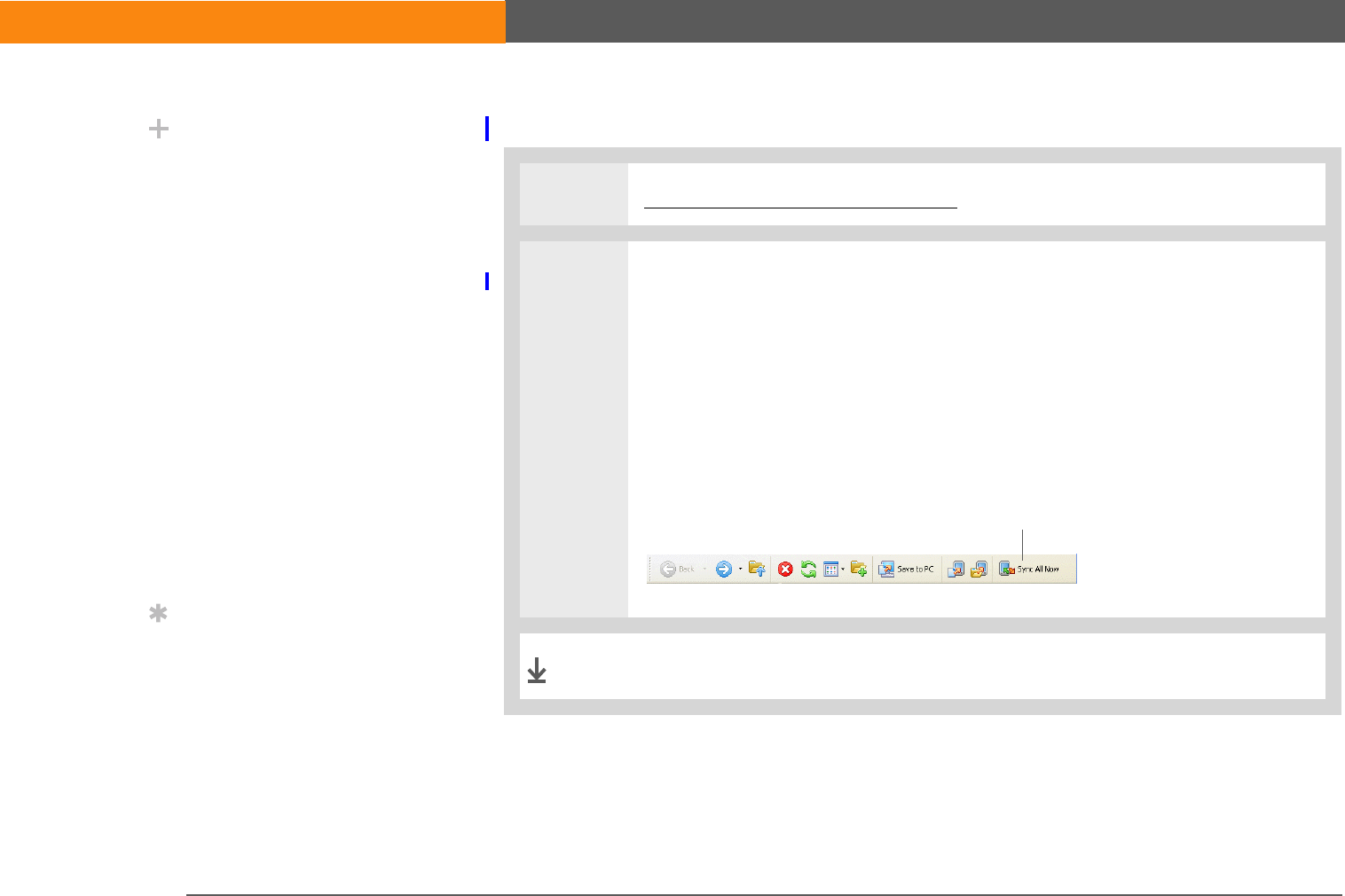
LifeDrive from palmOne 102
CHAPTER 5 Moving and Managing Info Between Your Device and Your Computer
Doing a folder sync
0
1Open the LifeDrive Manager window.
2Select one of the following synchronization options:
Synchronize a single file or folder Right-click the item’s icon, select Sync
actions, and then select Synchronize this item now.
Synchronize multiple files or folders Select the items you want, right-click any
item’s icon, select Sync actions, and then select Synchronize this item now.
Synchronize all sync items on the drive Click Sync All Now on the toolbar at
the top of the LifeDrive Manager window.
A synchronization progress screen appears.
Did You Know?
If you put a file or folder
that you chose not to
make a sync item into a
folder that is a sync
folder, the item is
synchronized regardless
of your choice. After the
next sync, a copy of the
sync folder appears on
both your device and
your computer, with the
sync version of the item
inside. The original file or
folder that you
transferred using the
Copy or Format for device
option remains in its
original location and is
not synchronized.
Tip
You can also synchronize
all sync items by right-
clicking the LifeDrive
Manager icon in the
taskbar in the lower-right
corner of your computer
screen and then selecting
Sync All Now.
Cli
c
k
h
ere
Done
SECOND DRAFT palmOne, Inc. Confidential

LifeDrive from palmOne 103
CHAPTER 5 Moving and Managing Info Between Your Device and Your Computer
Locating sync items on your computer
LifeDrive Manager can quickly open the folder on your computer where a sync item is stored.
0
1Open the LifeDrive Manager window.
2Locate the item on your computer:
a. In the LifeDrive Manager window, right-click the item you want to locate on
your computer.
b. Select Sync Actions.
c. Select Locate on PC. LifeDrive Manager opens the folder where the item is
located.
Done
Tip
To check when an item
was last synchronized,
right-click the item, select
Sync Actions, and then
select Check Sync Status.
SECOND DRAFT palmOne, Inc. Confidential
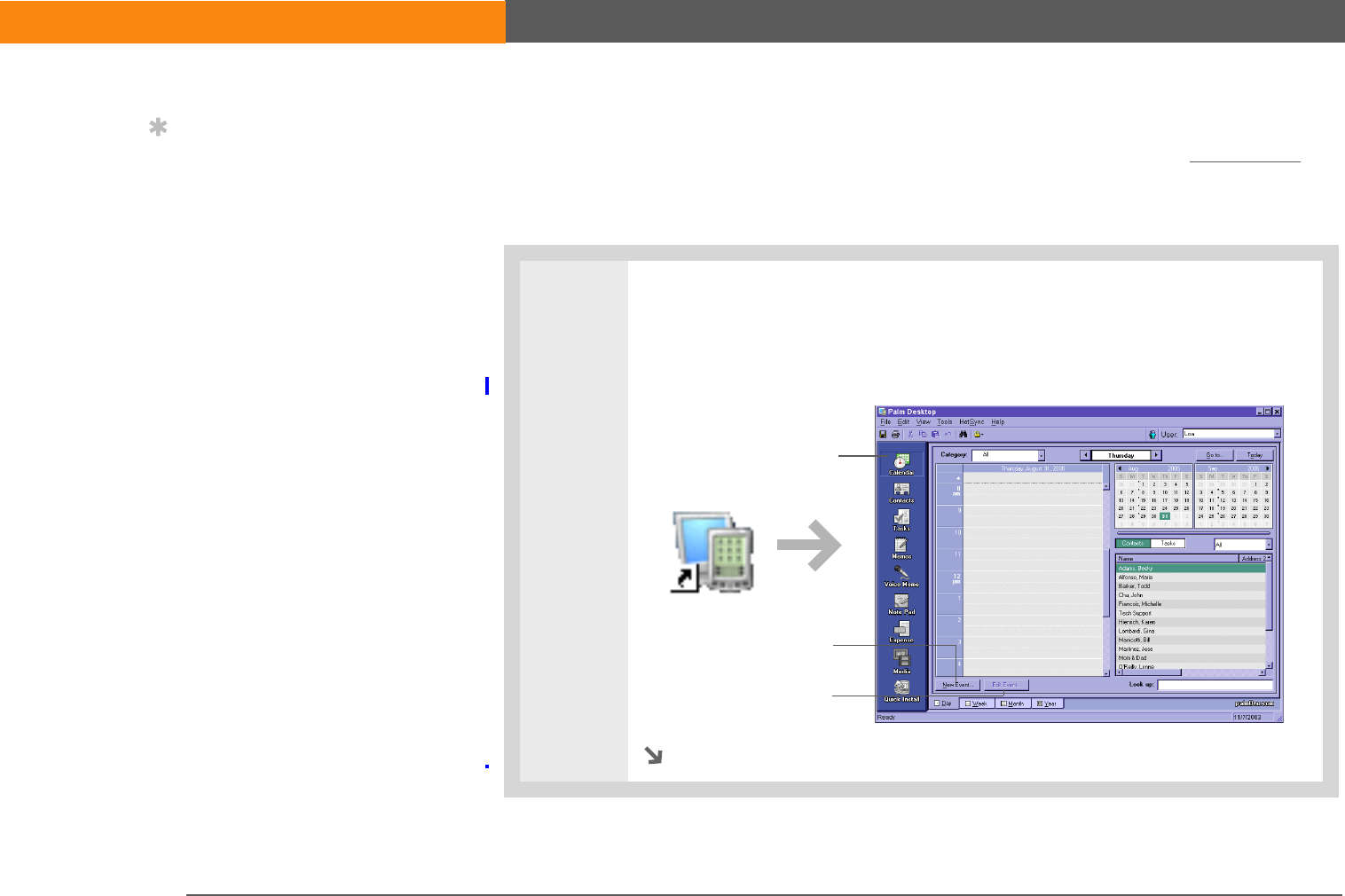
LifeDrive from palmOne 104
CHAPTER 5 Moving and Managing Info Between Your Device and Your Computer
Entering information using desktop software
Use Palm Desktop or Outlook to enter information on your computer. When you do a full sync, the
information is updated on your device.
WINDOWS ONLY
0
1Open an application in Palm Desktop software:
a. Double-click the Palm Desktop icon on your computer desktop.
b. Click the icon in the Launch bar to open the application.
Continued
Tip
The Palm Desktop online
Help has lots of info
about how to use
Palm Desktop software.
Open the Help menu and
select Palm Desktop Help.
Launch bar
New
Edit
SECOND DRAFT palmOne, Inc. Confidential
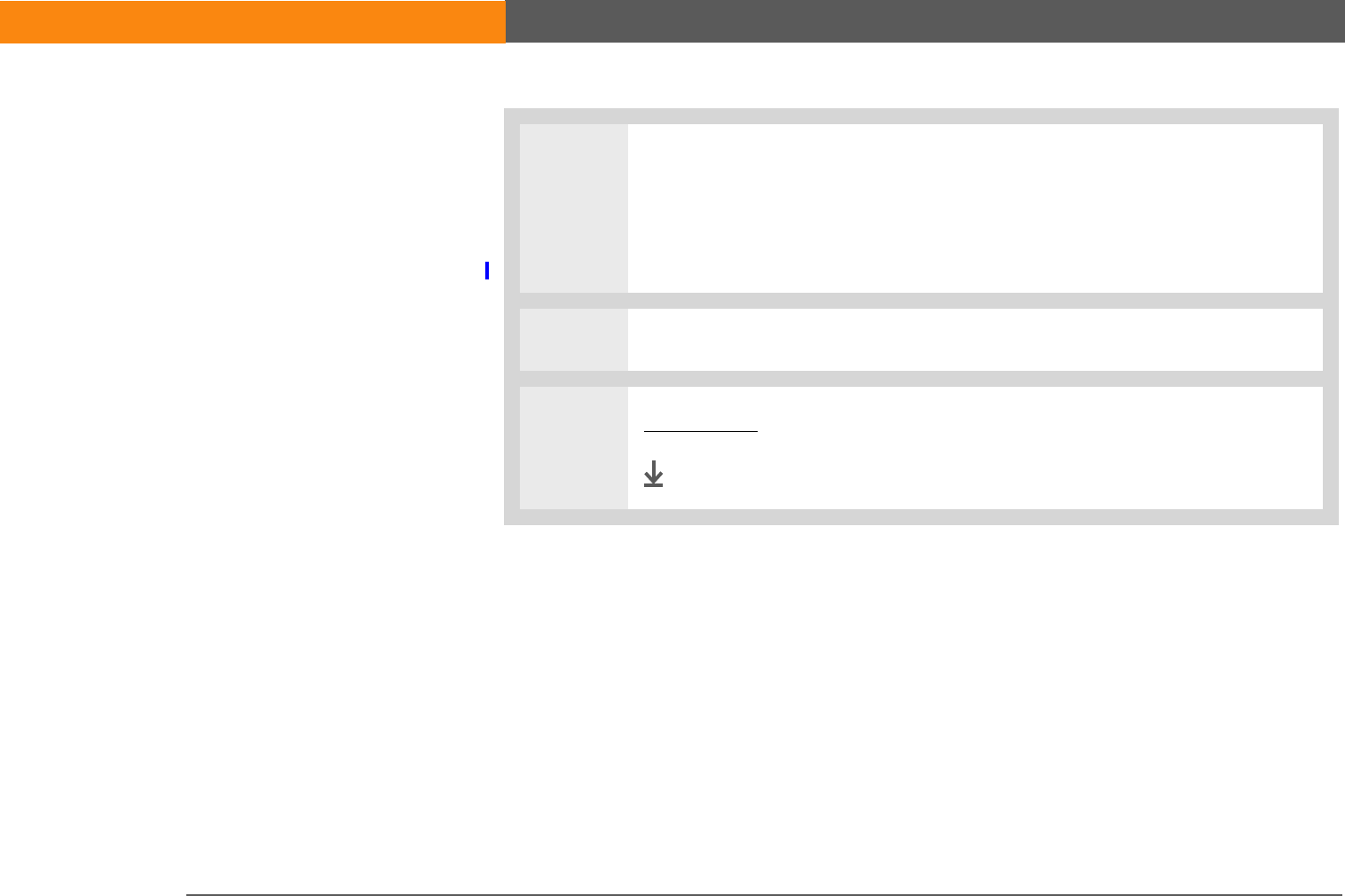
LifeDrive from palmOne 105
CHAPTER 5 Moving and Managing Info Between Your Device and Your Computer
2Do one of the following:
• Click New in the lower-left corner of the screen to create a new entry.
• Click an existing entry, and then click Edit in the lower-left corner of the
screen.
3Enter the information, and then click OK.
4Do a full sync to transfer the information to your device.
Done
SECOND DRAFT palmOne, Inc. Confidential
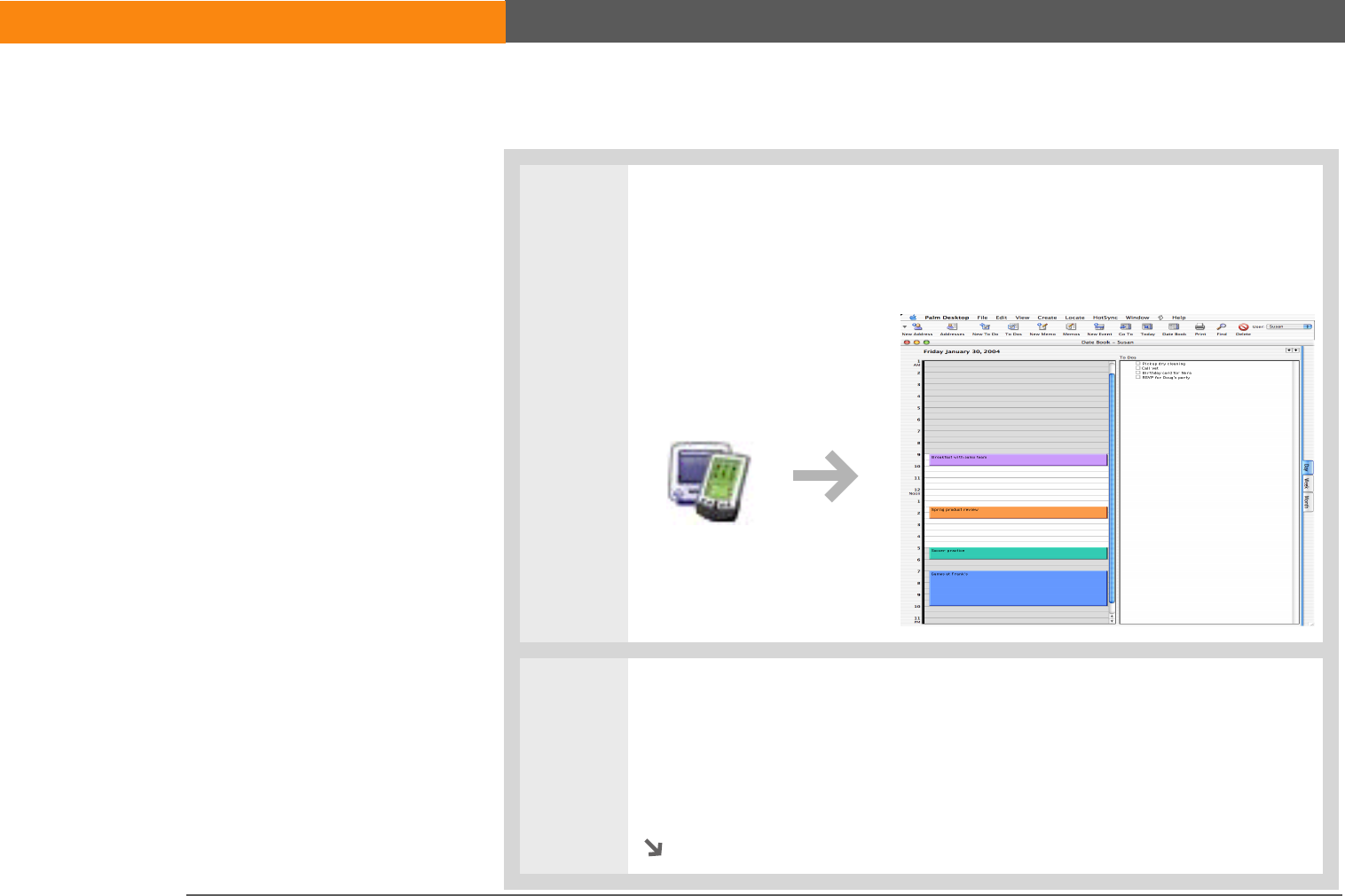
LifeDrive from palmOne 106
CHAPTER 5 Moving and Managing Info Between Your Device and Your Computer
MAC ONLY
0
1Open an application:
a. Double-click the Palm Desktop icon in the Palm folder on your computer.
b. Click the icon in the toolbar to open the application.
2Do one of the following:
• Click New in the upper-left corner of the screen to create a new entry.
• Click an existing entry, and then click Edit in the upper-left corner of the
screen.
Continued
SECOND DRAFT palmOne, Inc. Confidential
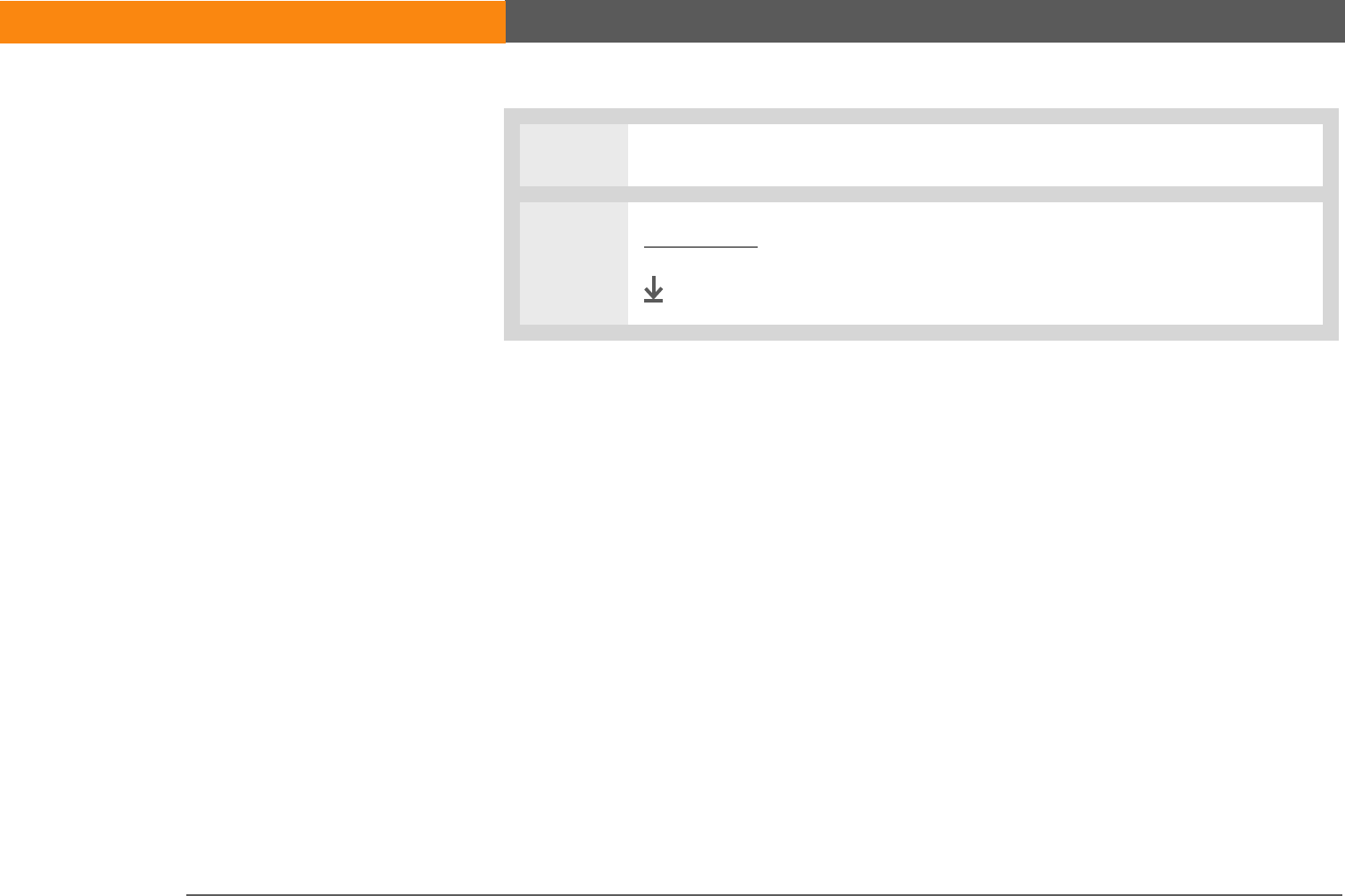
LifeDrive from palmOne 107
CHAPTER 5 Moving and Managing Info Between Your Device and Your Computer
Customizing your synchronization settings
You can set the following options for synchronization:
• Choosing how your computer responds when you initiate synchronization on your device
(Windows only)
• Enabling or disabling synchronization on your computer, setting whether synchronization is
enabled automatically when you start your computer, and choosing how much information to
include in the synchronization troubleshooting log (Mac only)
• Choosing how application information is updated during a full sync
3Enter the information, and then click OK.
4Do a full sync to transfer the information to your device.
Done
SECOND DRAFT palmOne, Inc. Confidential
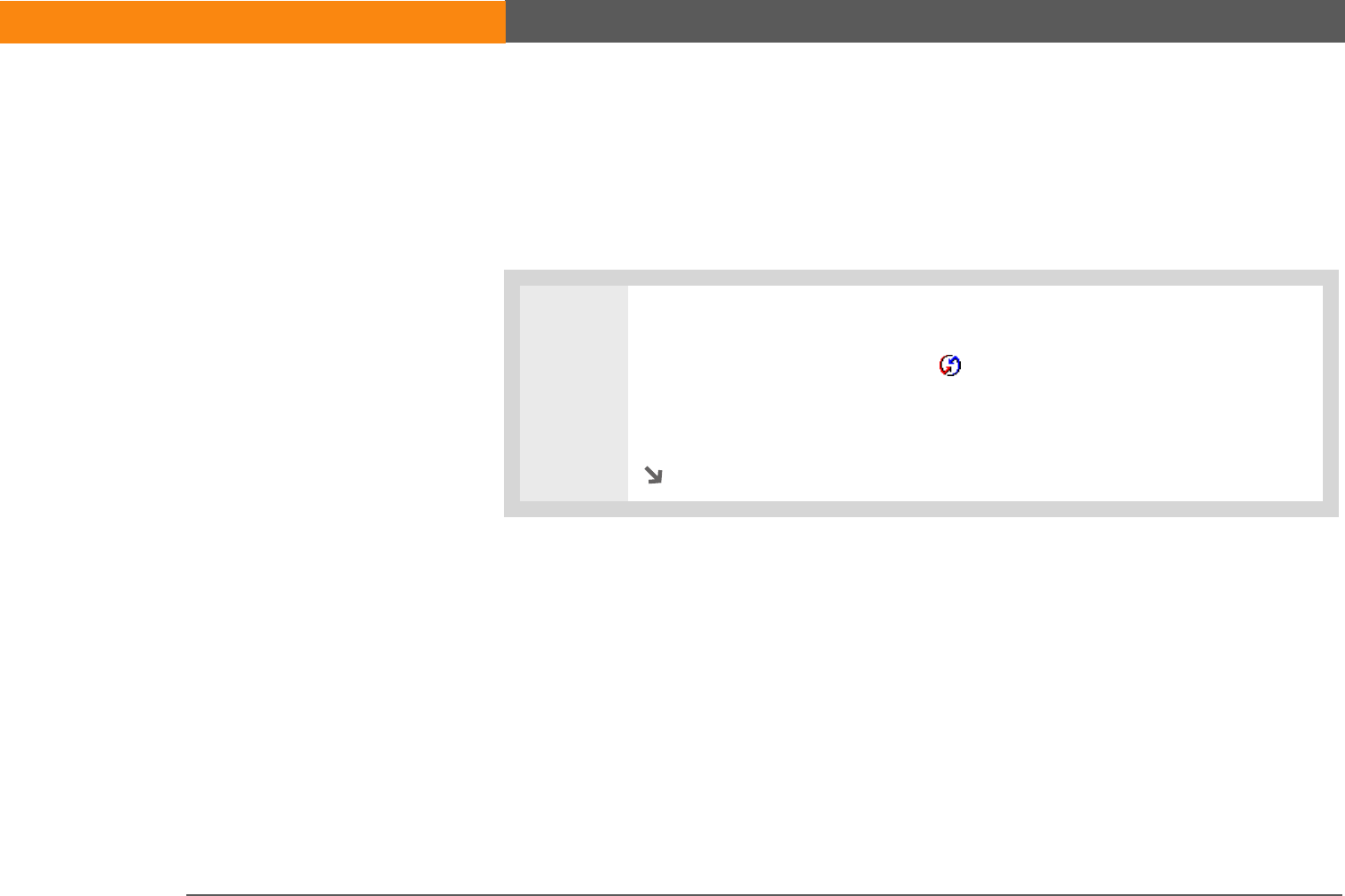
LifeDrive from palmOne 108
CHAPTER 5 Moving and Managing Info Between Your Device and Your Computer
Choosing how your computer responds to synchronization requests
WINDOWS ONLY
In order for your computer to respond when you initiate synchronization on your device, HotSync
Manager must be running. You can choose whether HotSync Manager always runs automatically,
or whether you must perform some action to start HotSync Manager.
0
1Open the synchronization options screen:
a. Click the HotSync Manager icon in the taskbar in the lower-right corner of
your screen.
b. Select Setup.
Continued
SECOND DRAFT palmOne, Inc. Confidential
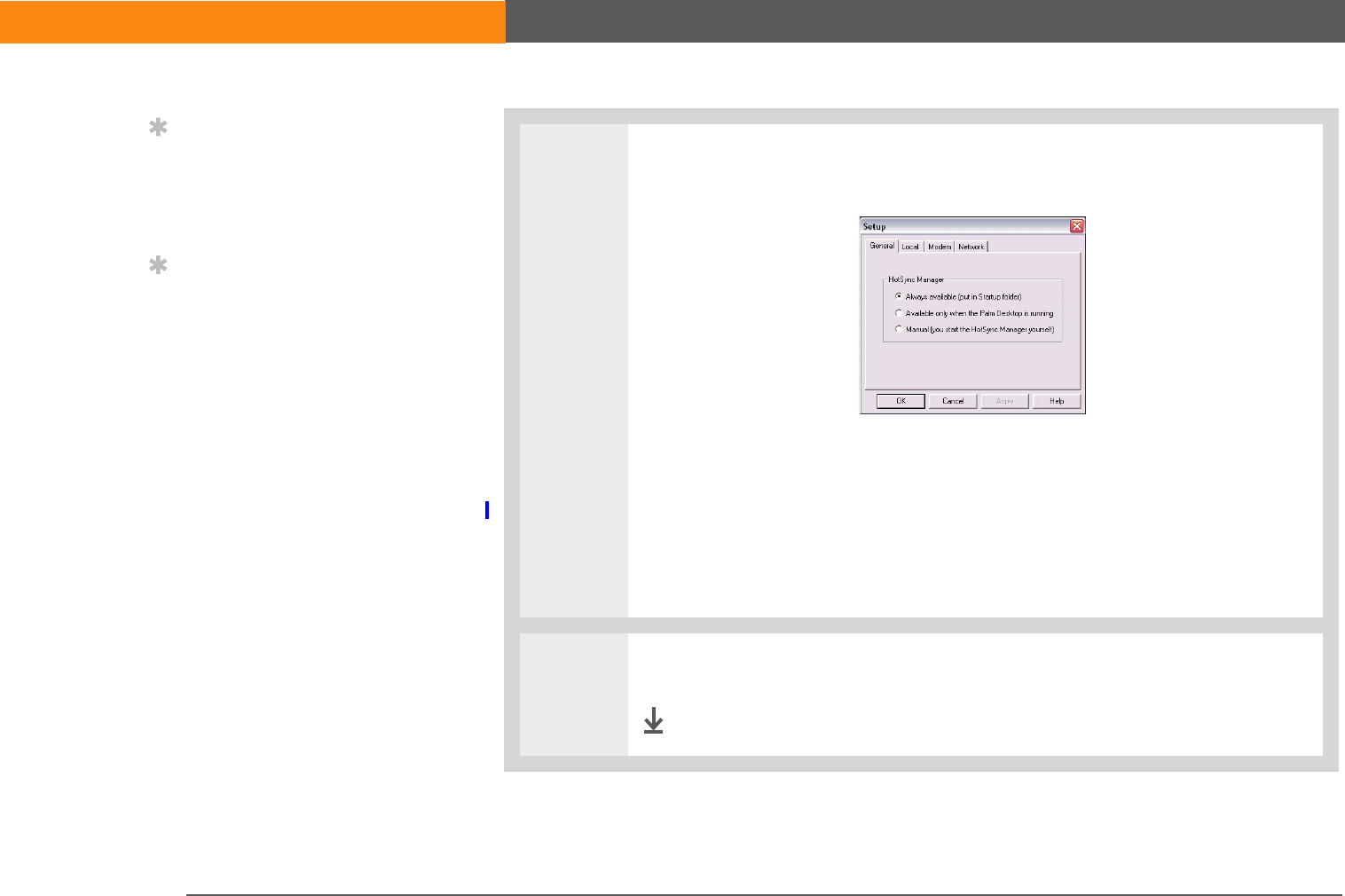
LifeDrive from palmOne 109
CHAPTER 5 Moving and Managing Info Between Your Device and Your Computer
2Select how your computer responds when you initiate synchronization on your
device:
Always available HotSync Manager runs automatically every time you initiate
synchronization on your device.
Available only when the Palm Desktop is running You must open
Palm Desktop software in order for HotSync Manager to run.
Manual You must manually turn HotSync Manager on each time you want
your computer to respond to a synchronization request.
3Click OK.
Done
Tip
Use the default setting
Always available if you’re
not sure which option you
want.
Tip
If you select Manual, you
must turn off HotSync
Manager, which is always
on by default. Click the
HotSync Manager icon in
the taskbar in the lower-
right corner of your
screen, and then click
Exit. To start HotSync
Manager when you want
to synchronize, click Start,
and then select
Programs. Navigate to
the palmOne program
group, and select
HotSync Manager.
Note that if you turn
HotSync Manager on, it
stays on until you turn off
your computer.
SECOND DRAFT palmOne, Inc. Confidential
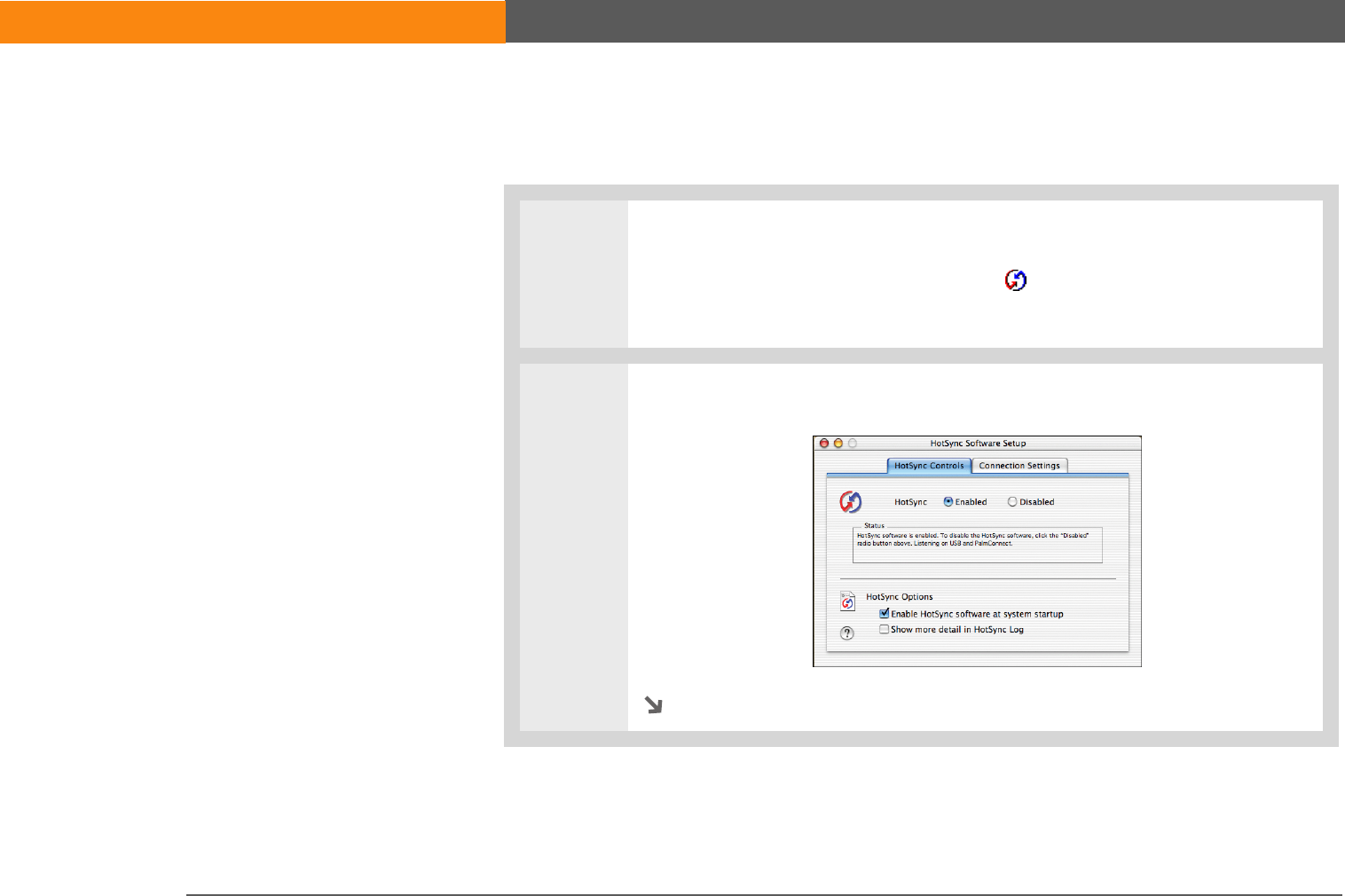
LifeDrive from palmOne 110
CHAPTER 5 Moving and Managing Info Between Your Device and Your Computer
Setting synchronization options
MAC ONLY
0
1Open the synchronization options screen:
a. Double-click the HotSync Manager icon in the Palm folder.
b. Click the HotSync Controls tab.
2Select the synchronization options you want:
Continued
SECOND DRAFT palmOne, Inc. Confidential
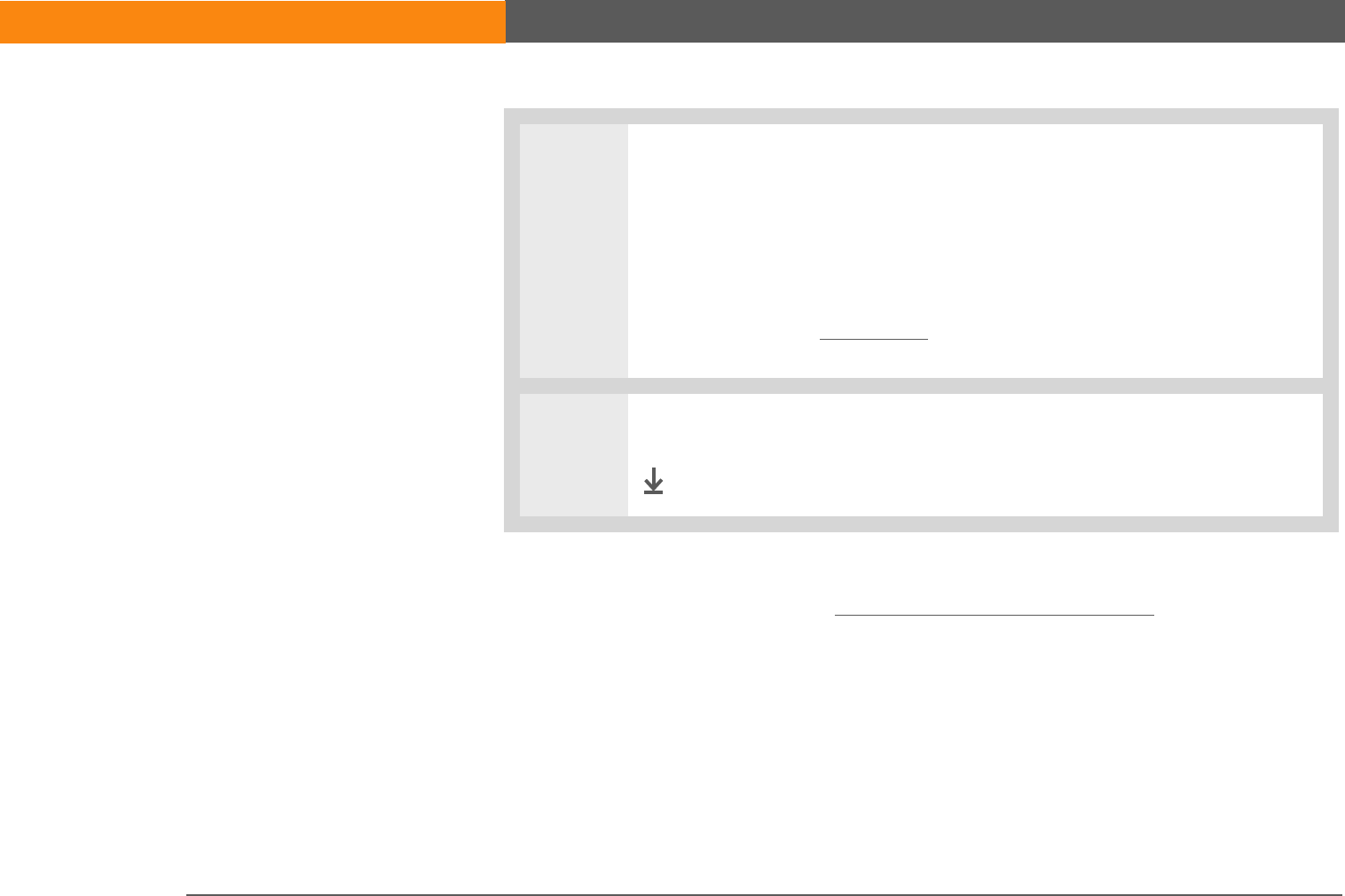
LifeDrive from palmOne 111
CHAPTER 5 Moving and Managing Info Between Your Device and Your Computer
Choosing whether application information is updated
By default, when information in each application included during a full sync is updated in one
place (your device or your computer), it is updated in the other. However, for each application, you
can choose whether information that has been updated in one place is updated in the other during
the next full sync.
Cont’d.
HotSync Enabled/Disabled Sets your computer to respond to synchronization
requests from your device.
Enable HotSync software at system startup Sets your computer to
automatically respond to synchronization requests each time you start your
computer. If this option is not selected, you must open HotSync Manager and
select the Enabled option before you can synchronize.
Show more detail in HotSync Log Includes more troubleshooting information
in the log that is generated when you synchronize.
3Close the HotSync Software Setup window.
Done
»
Key Term
Conduit The
synchronization software
that transfers information
between an application
on your computer and the
same application on your
device.
SECOND DRAFT palmOne, Inc. Confidential
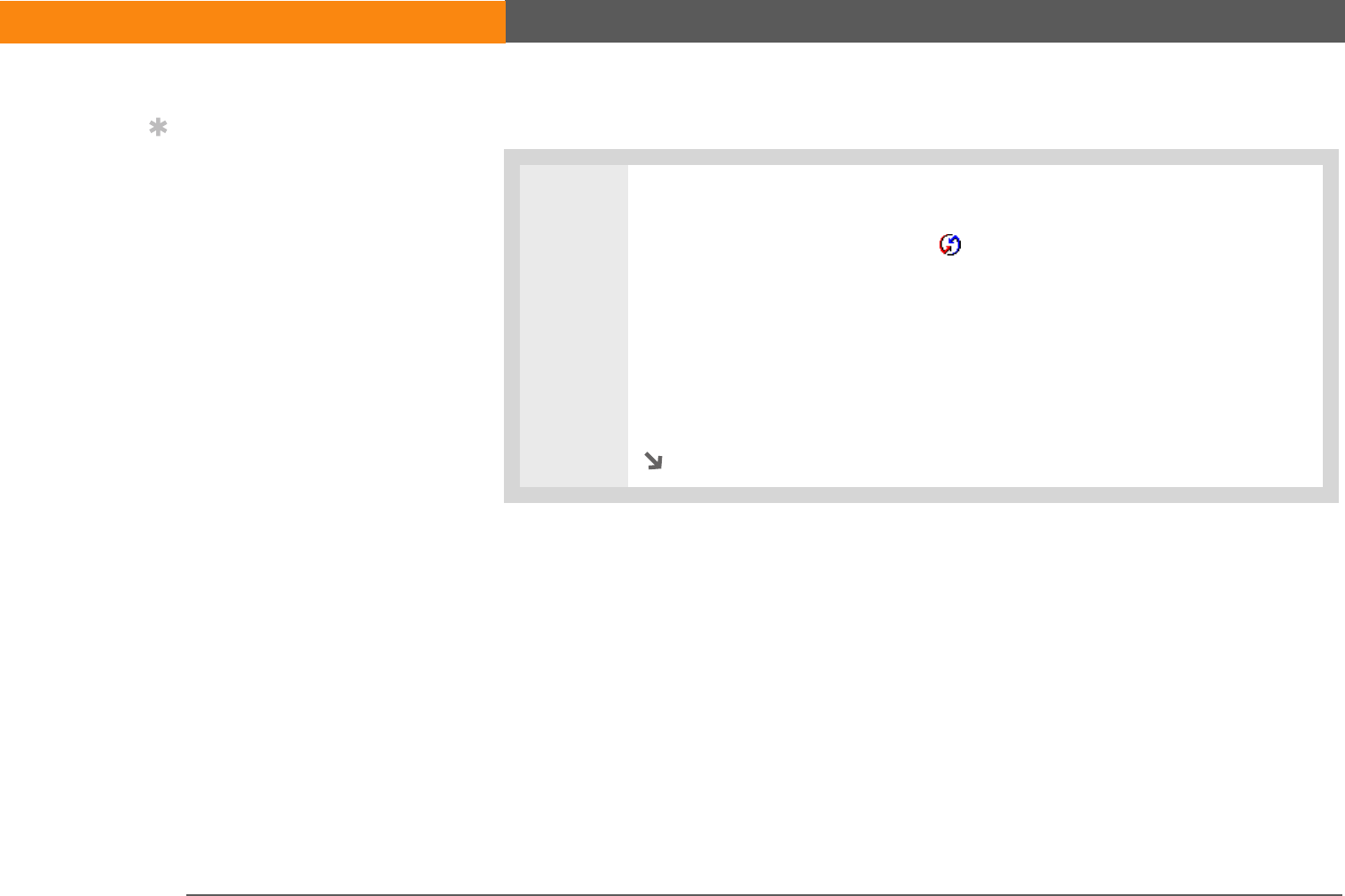
LifeDrive from palmOne 112
CHAPTER 5 Moving and Managing Info Between Your Device and Your Computer
WINDOWS ONLY
0
1Select the application you want to customize:
a. Click the HotSync Manager icon in the taskbar in the lower-right corner of
your screen.
b. Select Custom.
c. Select the appropriate username from the drop-down list at the top of the
screen.
d. Select the application you want, and then click Change.
Continued
Tip
Windows For
information on choosing
whether application
information is updated if
you are synchronizing
your device with Outlook,
see the online Outlook
synchronization Help.
Click the HotSync
Manager icon in the
taskbar in the lower-right
corner of your screen,
select Custom, and then
select one of the Outlook
applications from the list.
Select Change, and then
select one of the
applications from the list.
SECOND DRAFT palmOne, Inc. Confidential
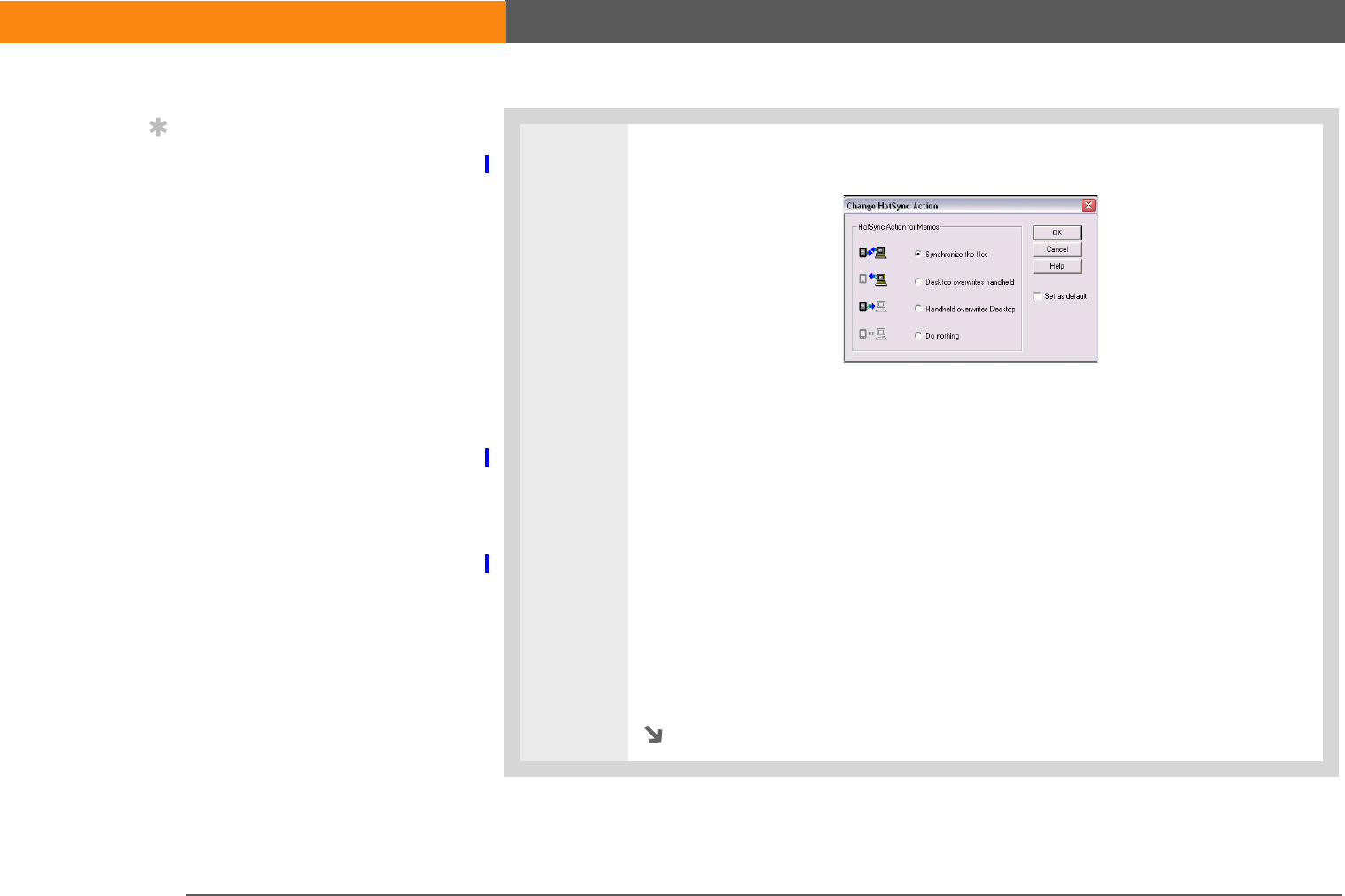
LifeDrive from palmOne 113
CHAPTER 5 Moving and Managing Info Between Your Device and Your Computer
2Select how information is updated during the next synchronization:
Synchronize the files Information that is changed in one place (your device or
computer) is updated in the other during synchronization.
Desktop overwrites handheld Information that has been changed on your
computer is updated on your device during synchronization. If information has
been changed on your device, it will be replaced by the information from your
computer, and you will lose the changes you made on your device.
Handheld overwrites Desktop Information that has been changed on your
device is updated on your computer during synchronization. If information has
been changed on your computer, it will be replaced by the information from
your device, and you will lose the changes you made on your computer.
Do Nothing No synchronization occurs, so any changes made on either your
device or your computer are not updated in the other location.
Continued
Tip
You should generally
keep the default setting
(Synchronize the files) for
all applications. Choose
an overwrite option only
if you have a specific
reason for sending
updates only one way.
Choose Do Nothing if you
never use an application.
SECOND DRAFT palmOne, Inc. Confidential
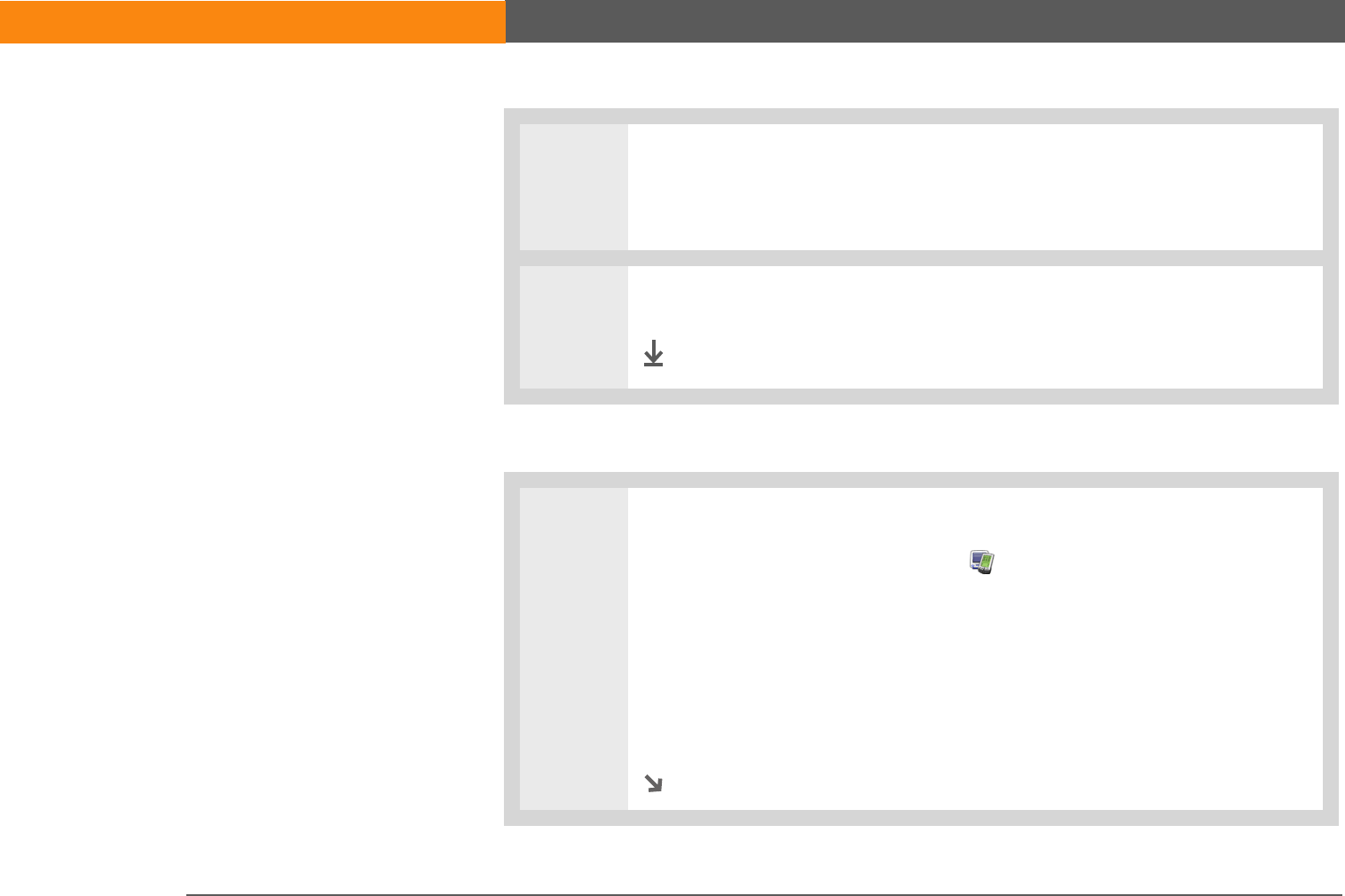
LifeDrive from palmOne 114
CHAPTER 5 Moving and Managing Info Between Your Device and Your Computer
MAC ONLY
0
3To use the option you select on an ongoing basis, check the Set as default box. If
you do not select this box, the option you select applies only the next time you
synchronize. Thereafter, information is updated according to the default setting
(Synchronize the files).
4Click OK, and then click Done.
Done
1Select the application you want to customize:
a. Double-click the Palm Desktop icon in the Palm folder.
b. From the HotSync menu, select Conduit Settings.
c. From the User pop-up menu, select the appropriate username.
d. Select an application.
e. Click Conduit Settings.
Continued
SECOND DRAFT palmOne, Inc. Confidential
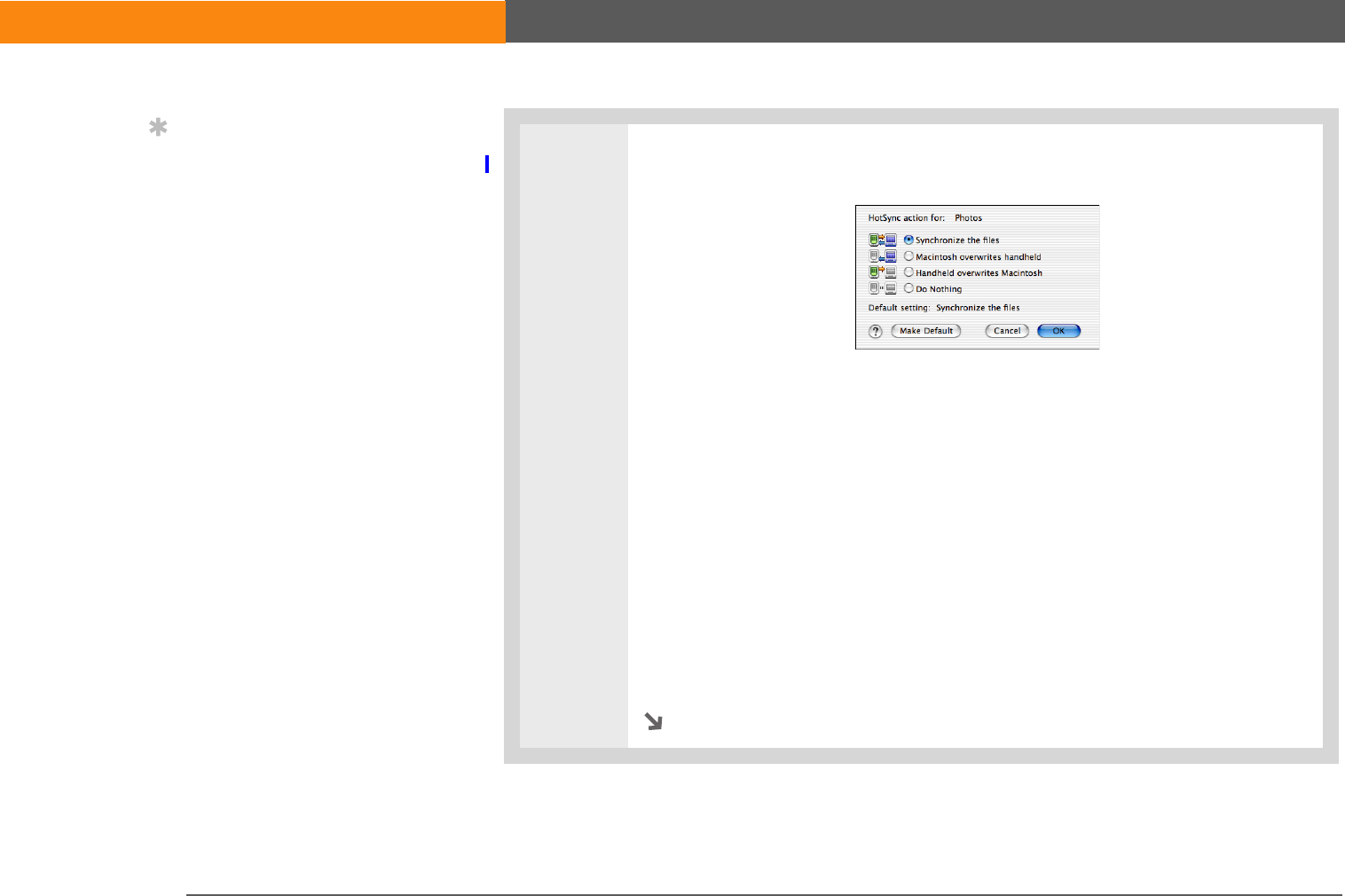
LifeDrive from palmOne 115
CHAPTER 5 Moving and Managing Info Between Your Device and Your Computer
2Select how information is updated during the next synchronization:
Synchronize the files Information that is changed in one place (your device or
computer) is updated in the other during synchronization.
Macintosh overwrites handheld Information that has been changed on your
computer is updated on your device during synchronization. If information has
been changed on your device, it will be replaced by the information from your
computer, and you will lose the changes you made on your device.
Handheld overwrites Macintosh Information that has been changed on your
device is updated on your computer during synchronization. If information has
been changed on your computer, it will be replaced by the information from
your device, and you will lose the changes you made on your computer.
Do Nothing No synchronization occurs, so any changes made on either your
device or your computer are not updated in the other location.
Continued
Tip
You should generally
keep the default setting
(Synchronize the files) for
all applications. Choose
an overwrite option only
if you have a specific
reason for sending
updates only one way.
Choose Do Nothing if you
never use an application.
SECOND DRAFT palmOne, Inc. Confidential
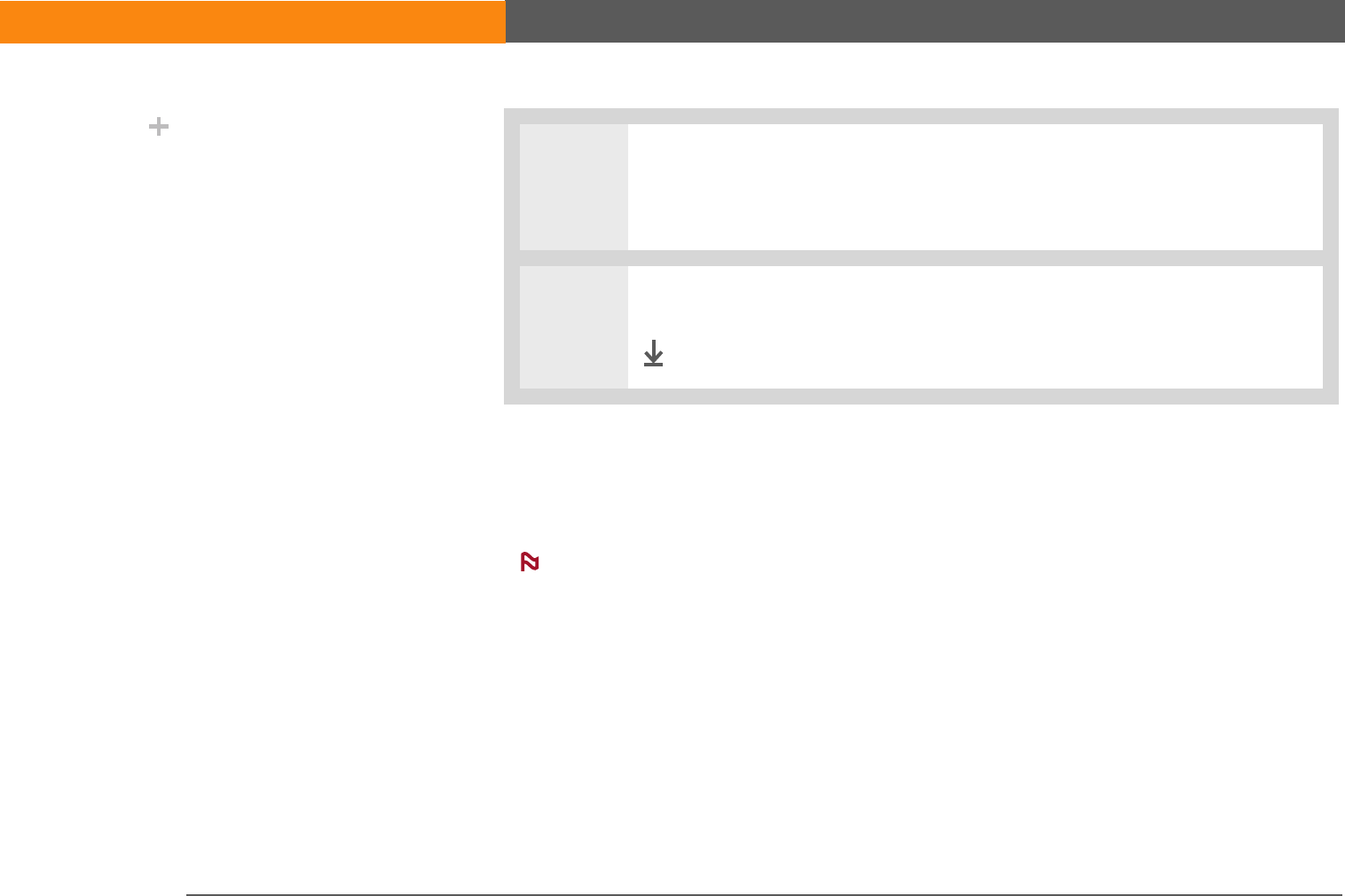
LifeDrive from palmOne 116
CHAPTER 5 Moving and Managing Info Between Your Device and Your Computer
Installing applications to your device
Use Quick Install (Windows) or the Send To Handheld droplet (Mac) to install applications on your
device when you synchronize. The applications are stored in program memory and are optimized
for use on the device.
You can also use LifeDrive Manager to install applications to the Applications folder on
your hard drive. This is useful if your program memory becomes full and you cannot install any
more applications there. However, some applications are not designed to run from the
Applications folder and must be installed to program memory to run correctly.
3To use the option you select on an ongoing basis, click Make Default. If you do
not click this button, the option you select applies only the next time you
synchronize. Thereafter, information is updated according to the default setting
(Synchronize the files).
4Click OK, and then close the Conduit Settings window.
Done
Did You Know?
Most device application
files have the extension
PRC or PDB.
NOTE
SECOND DRAFT palmOne, Inc. Confidential
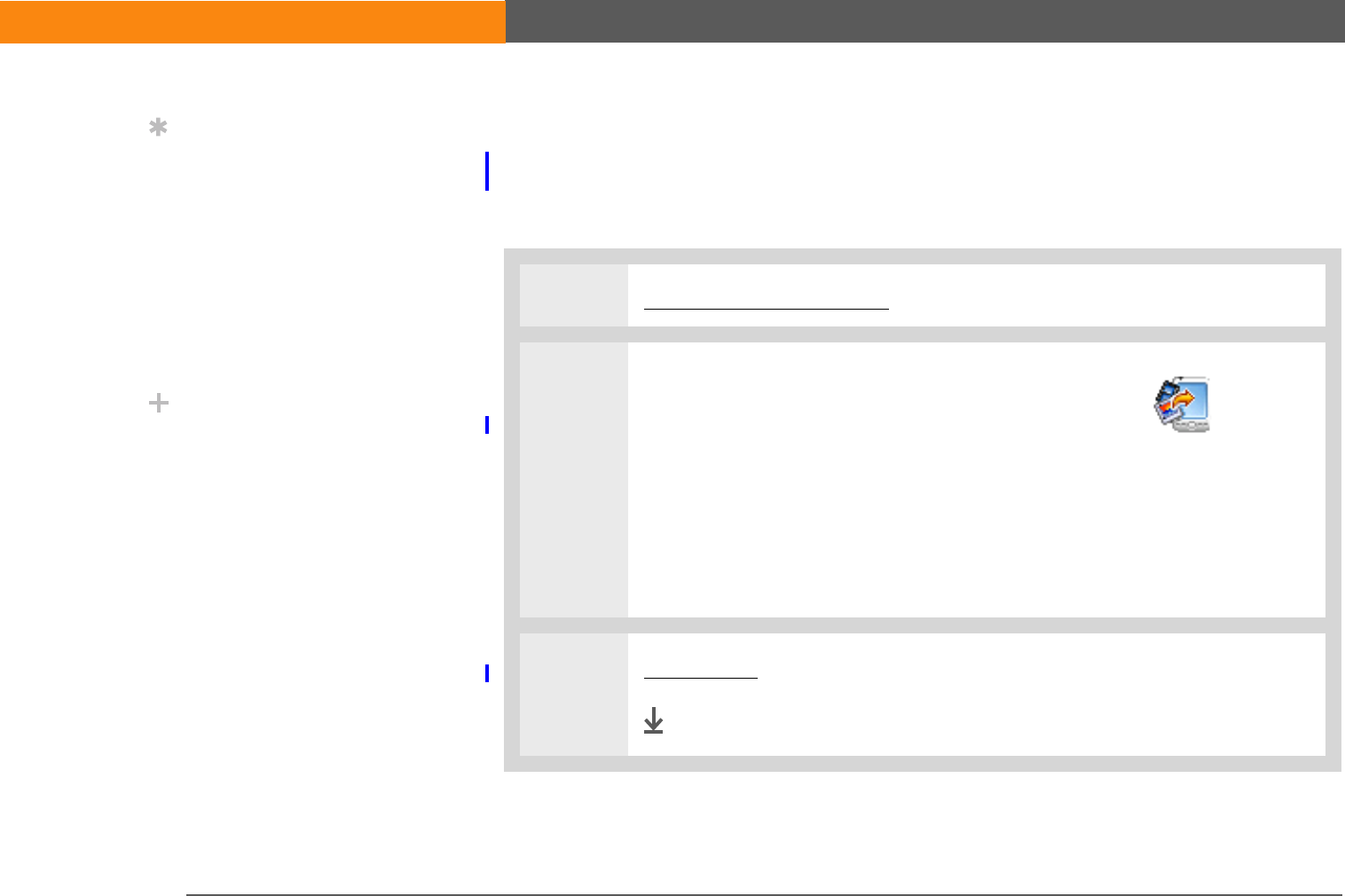
LifeDrive from palmOne 117
CHAPTER 5 Moving and Managing Info Between Your Device and Your Computer
Using Quick Install
When you install Palm Desktop software on your Windows computer, you also automatically
install Quick Install. This tool makes it easy to install applications when you synchronize.
WINDOWS ONLY
0
1Open Palm Desktop software.
2Copy the application:
a. Click the Quick Install icon in the Launch bar at the
left of the window.
b. Drag and drop the application onto the Quick Install
window.
c. When the confirmation dialog box appears, confirm
your username, the application name, and the
destination, and then click OK.
3Do a full sync to install the file on your device.
Done
Tip
A confirmation dialog
box shows whether the
items will be copied to
your device or to an
expansion card. You can
choose which device will
receive the items by
selecting the username in
the User drop-down box
in the upper-right corner.
Did You Know?
You can move multiple
applications into the
Quick Install window to
have them ready for
installation the next time
you synchronize.
SECOND DRAFT palmOne, Inc. Confidential
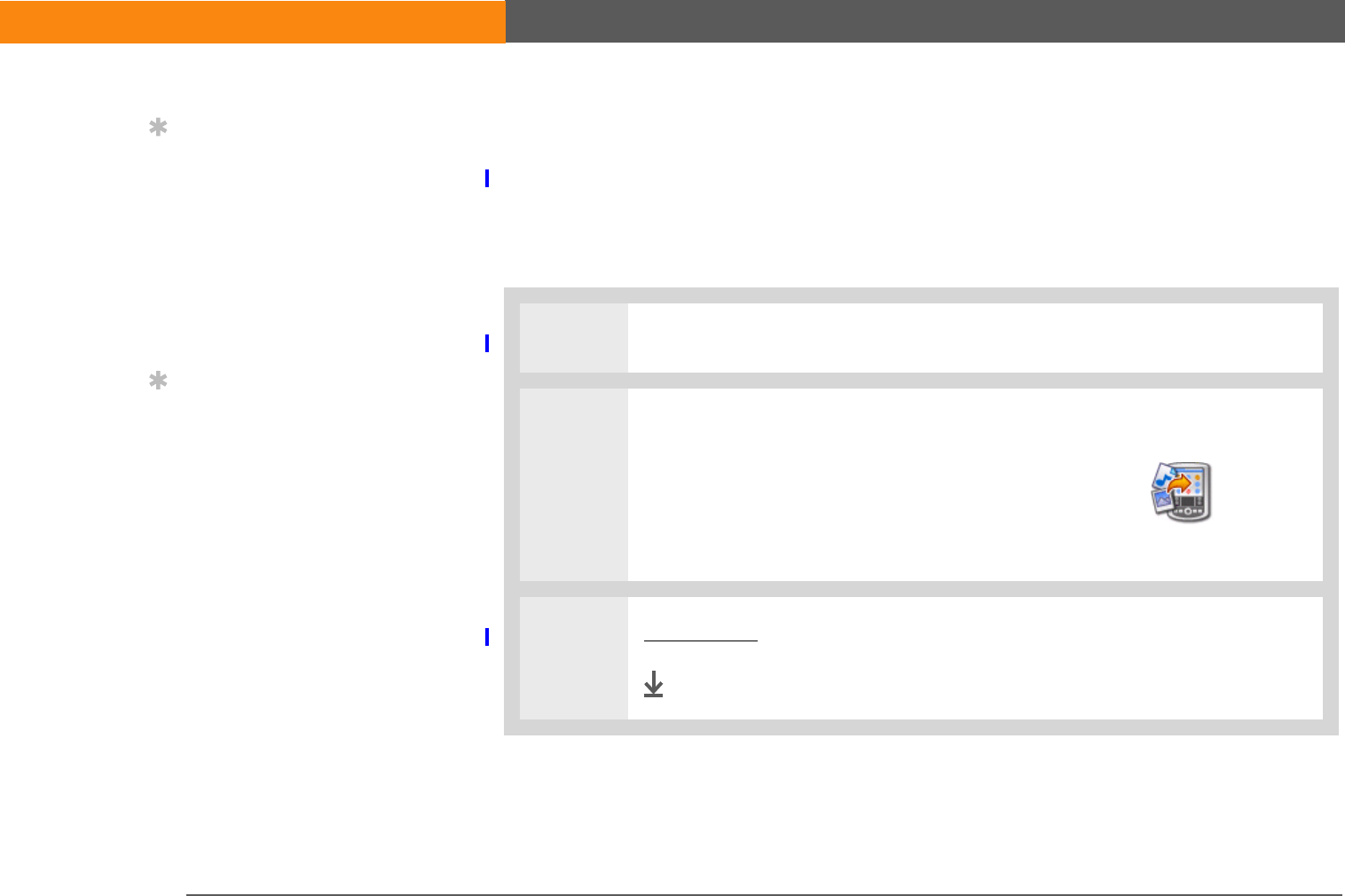
LifeDrive from palmOne 118
CHAPTER 5 Moving and Managing Info Between Your Device and Your Computer
Installing applications from a Mac computer
You can install applications from a Mac computer by dragging and dropping them onto the Send
To Handheld droplet, or by using the commands on the HotSync menu.
Using the Send To Handheld droplet
MAC ONLY
0
1Copy or download the application(s) you want to install on your computer.
2Drag and drop the files onto the Send To Handheld droplet:
a. Drag and drop the file(s) or folder onto the
Send To Handheld droplet in the Palm folder.
b. In the Send to Handheld dialog box, select
your username and click OK.
3Do a full sync to install the file on your device.
Done
Tip
In Mac OS X, you can make
the Send To Handheld
droplet a permanent part
of your desktop by
dragging the droplet to the
Dock. Then simply drag
files you want to transfer to
your device onto the
droplet in the Dock.
Tip
Use the Send To
Handheld droplet to
install music files, photos,
and videos to your device
SECOND DRAFT palmOne, Inc. Confidential
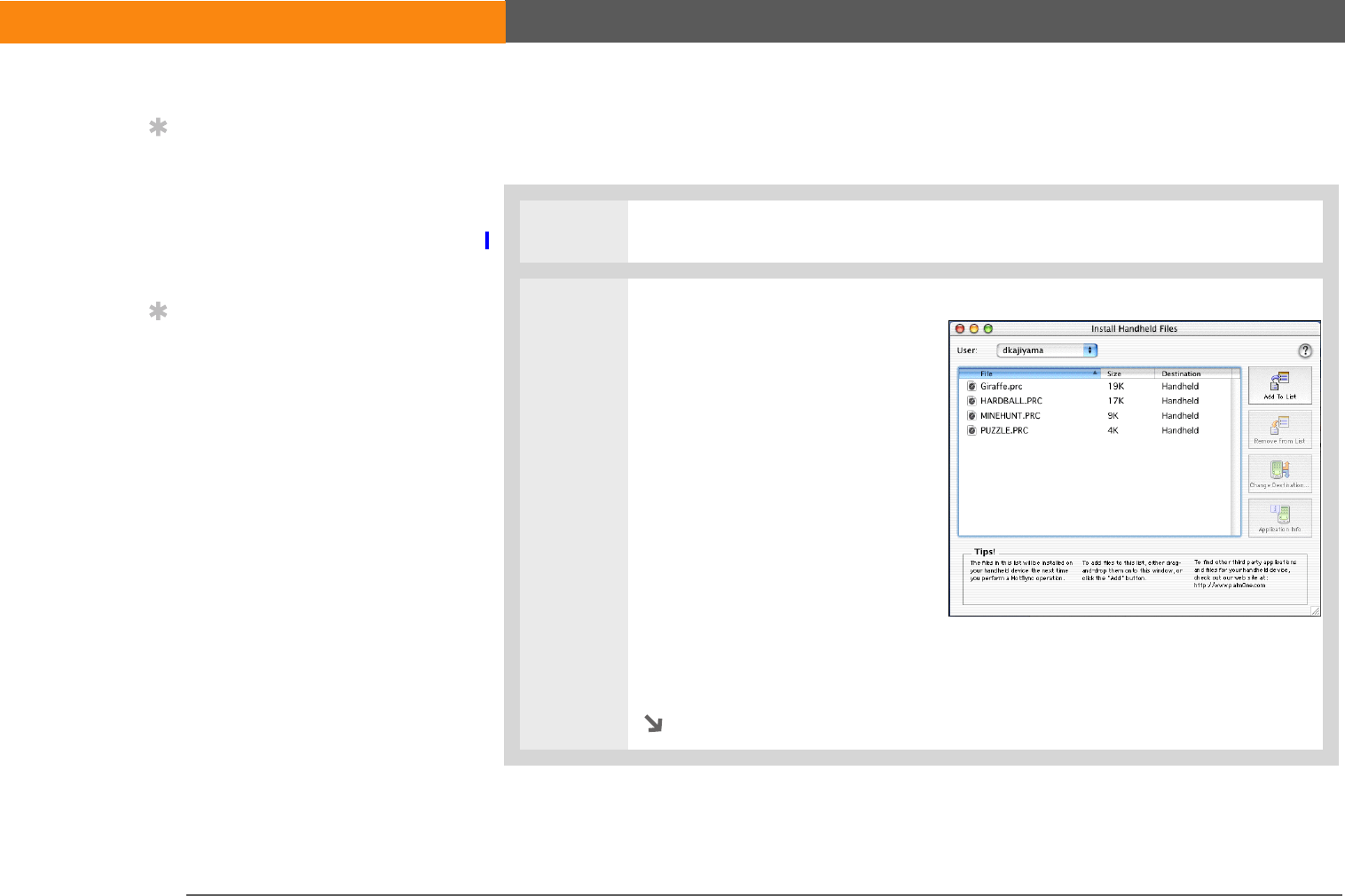
LifeDrive from palmOne 119
CHAPTER 5 Moving and Managing Info Between Your Device and Your Computer
Using commands in the HotSync menu
MAC ONLY
0
1Copy or download the application you want to install on your computer.
2Select the files to install on your
device:
a. In the Palm folder, double-
click the HotSync Manager.
b. Select the HotSync menu, and
then select Install Handheld
files.
c. In the User pop-up menu,
select the name that
corresponds to your device.
d. Click Add to List.
e. Select the file(s) you want to
install.
Continued
Tip
To move applications
between your device and
the expansion card, click
Change Destination. Use
the arrows to move the
files, and then click OK.
Tip
If you do not see the
application or file in the
folder, go to the folder
that contains the
application you want to
install.
SECOND DRAFT palmOne, Inc. Confidential
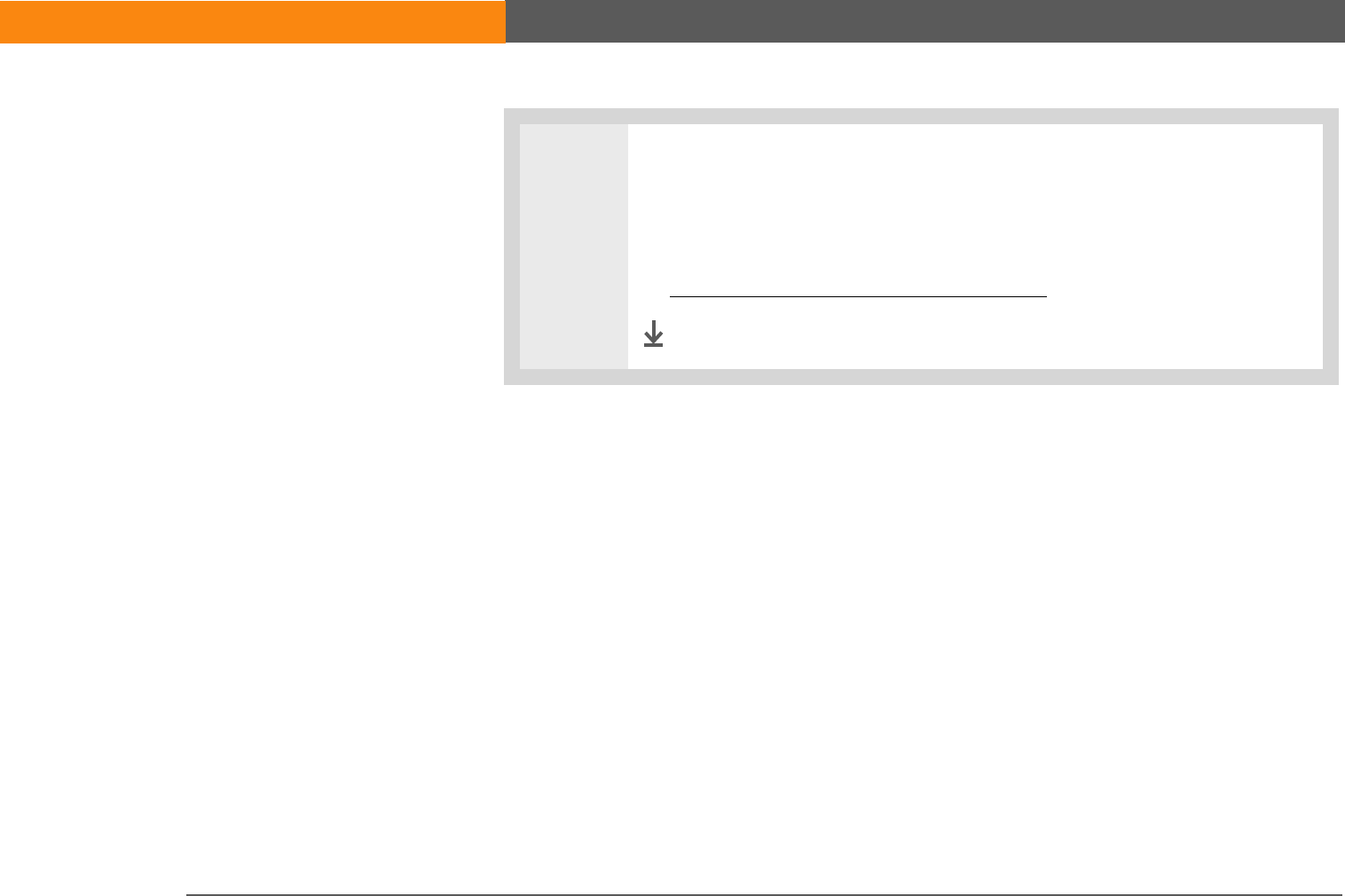
LifeDrive from palmOne 120
CHAPTER 5 Moving and Managing Info Between Your Device and Your Computer
Other ways of managing information
You can move and manage information on your device and your computer in the following
additional ways:
• Importing information from other applications into Palm Desktop software
• Restoring archived info on your computer
• Installing additional applications from the software installation CD
• Checking space and version numbers of applications on your device
3Install the files on your device:
a. Click Add File.
b. Close the Install Device Files window.
c. Synchronize your device with your computer.
Done
SECOND DRAFT palmOne, Inc. Confidential
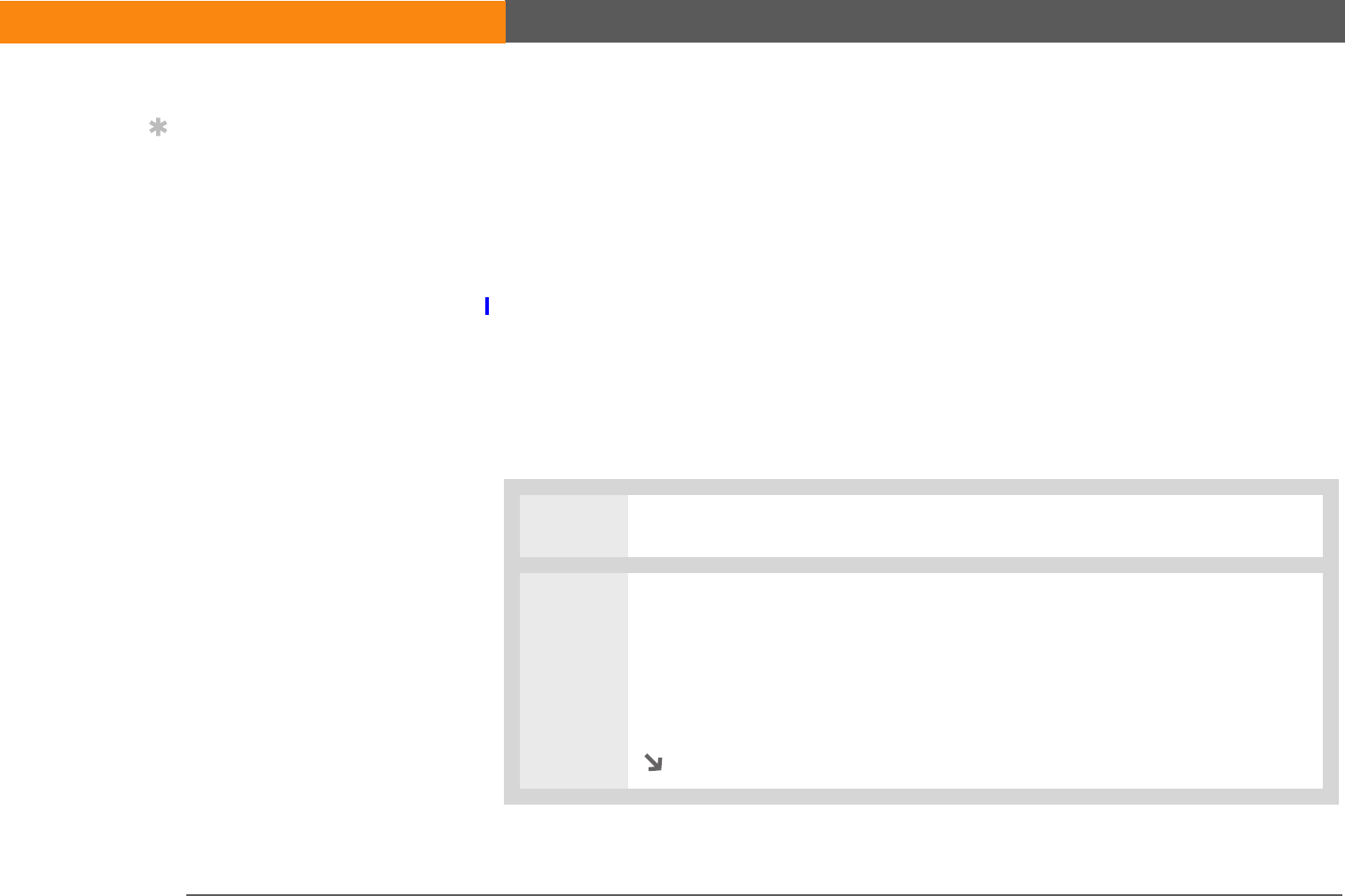
LifeDrive from palmOne 121
CHAPTER 5 Moving and Managing Info Between Your Device and Your Computer
Importing information from other applications
Do you have information on your computer in spreadsheets or databases and want to transfer it to
your device? Don’t spend time retyping it. Instead, import the info into Palm Desktop software.
Palm Desktop software can import the following types of files:
Calendar vCal/iCal (VCS/ICS) and Calendar archive (DBA)
Contacts vCard (VCF), Contacts archive (ABA)
Memos Comma-delimited (CSV, TXT), tab-delimited (TAB, TSV, TXT), Memos archive (MPA),
Text (T XT )
Ta s k s Tasks archive (TDA)
WINDOWS ONLY
0
1Save the file on your computer in one of the accepted formats.
2Import the file into Palm Desktop software:
a. Double-click the Palm Desktop icon on your computer desktop.
b. Click the icon in the launch bar for the application you want to import the
information into.
Continued
Tip
Palm Desktop Help has
lots of information about
importing from other
applications, including
step-by-step instructions.
Open the Help menu in
Palm Desktop software
and select Palm Desktop
Help for more details.
SECOND DRAFT palmOne, Inc. Confidential
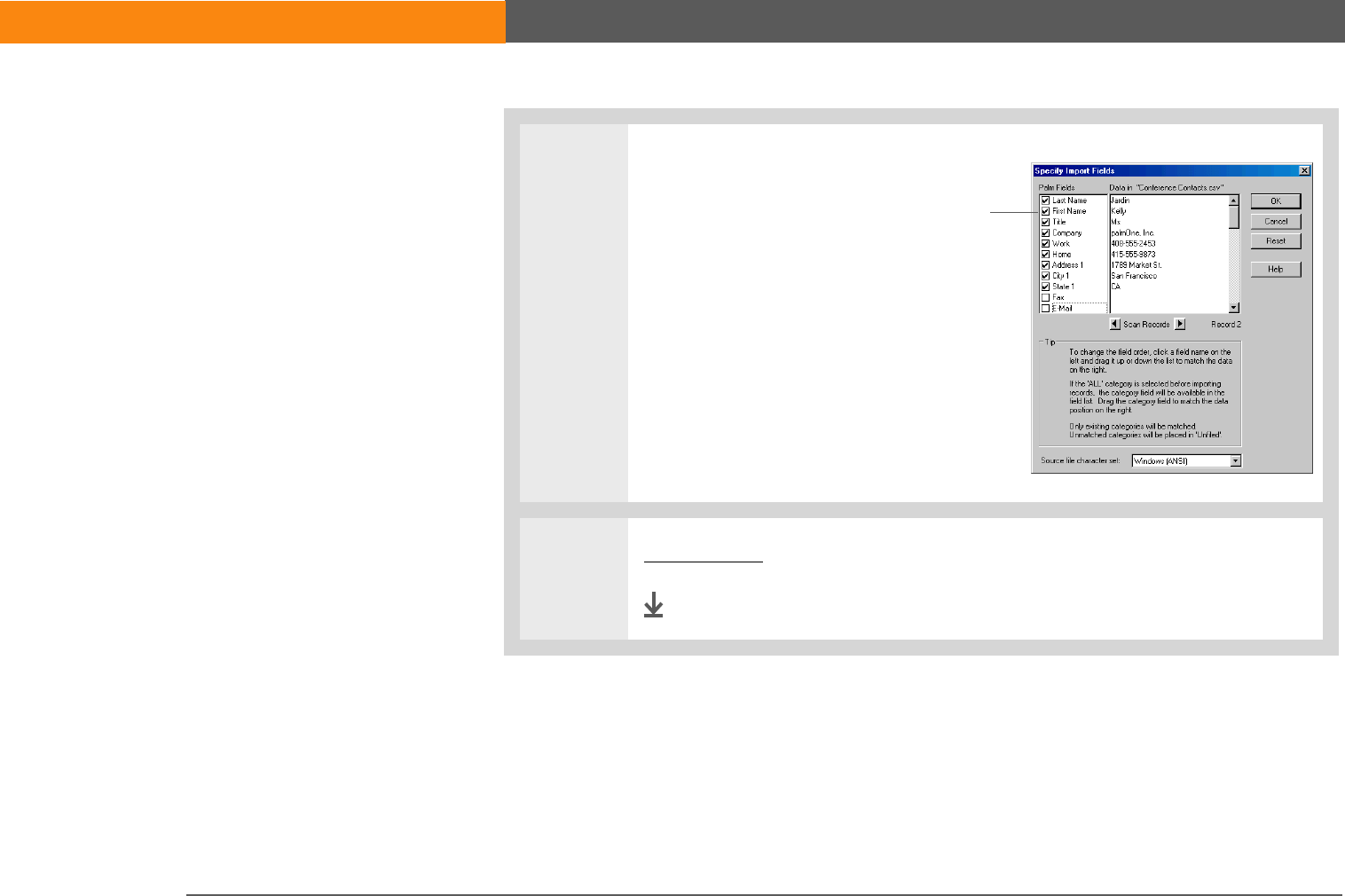
LifeDrive from palmOne 122
CHAPTER 5 Moving and Managing Info Between Your Device and Your Computer
Cont’d.
c. Click File, and then click
Import.
d. Follow the onscreen
instructions to map the fields
in your file to the fields in
Palm Desktop software, and
import the file.
3Do a full sync.
Done
Imported
fields
SECOND DRAFT palmOne, Inc. Confidential

LifeDrive from palmOne 123
CHAPTER 5 Moving and Managing Info Between Your Device and Your Computer
MAC ONLY
0
Restoring archived items on your computer
In many applications, you can save a copy of an item that you deleted from your device or desktop
software to an archive folder on your computer. This frees up space on your device, while
ensuring the information is available if you need it in the future.
You can restore individual entries or an entire archive file to the related application in your desktop
software. The Palm Desktop online Help and the Microsoft Outlook online Help have lots of info
about how to restore archived files. Refer to these Help files for details.
1Save the file on your computer in one of the accepted formats.
2Import the file into Palm Desktop software:
a. Double-click the Palm Desktop icon in the Palm folder on your computer.
b. Click the icon on the toolbar for the application into which you want to
import information.
c. Click File, and then click Import.
d. Follow the onscreen instructions to import the file.
3Do a full sync.
Done
SECOND DRAFT palmOne, Inc. Confidential
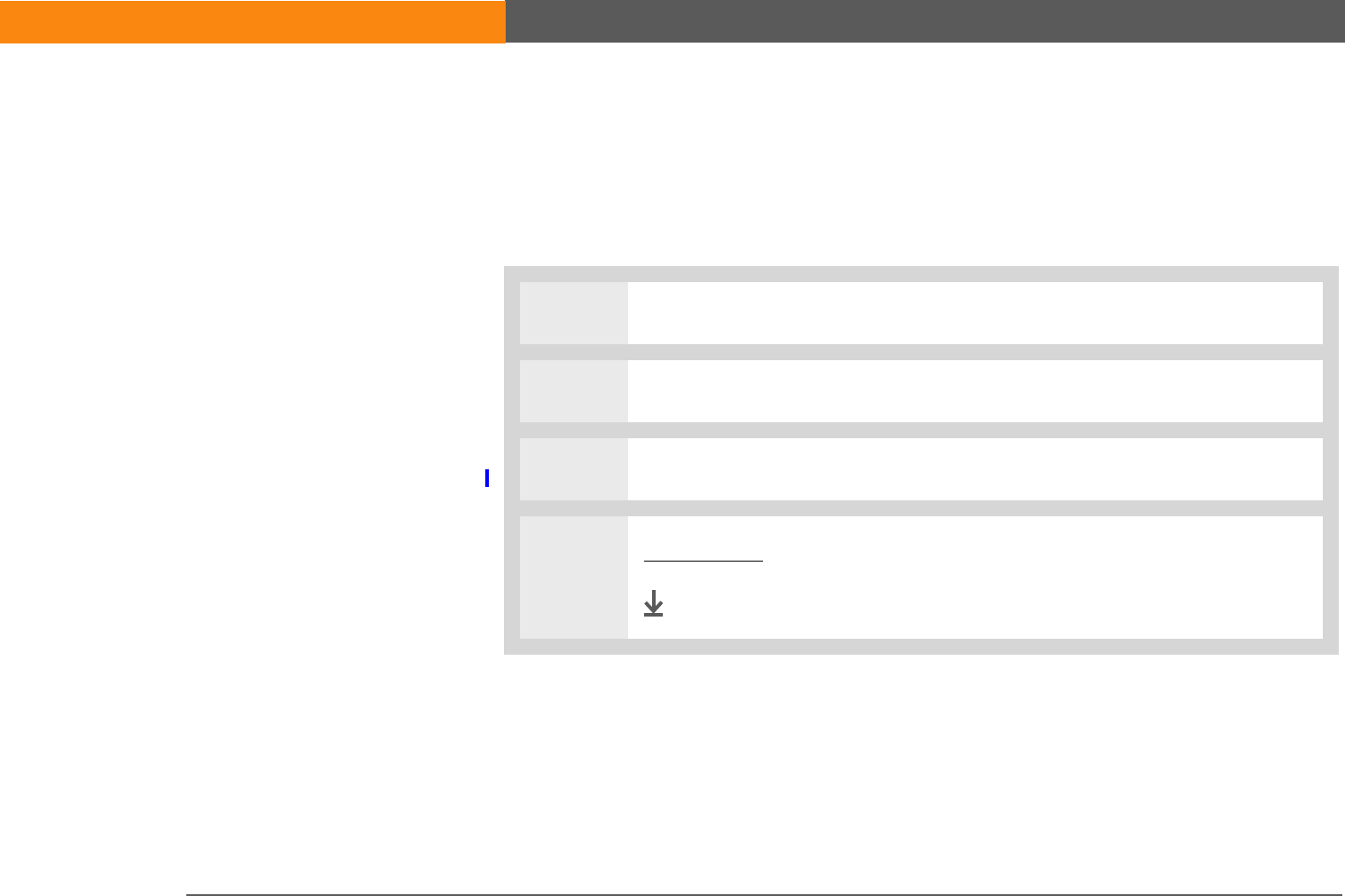
LifeDrive from palmOne 124
CHAPTER 5 Moving and Managing Info Between Your Device and Your Computer
Installing the additional software from the CD
Your device comes with many applications that are already installed and ready to use. The CD that
came with your device includes lots of other applications to make your device even more useful
and more fun. You can install these applications at any time.
WINDOWS ONLY
0
1Insert the CD into your computer.
2On the Discover your device screen, click Add software to your device.
3Follow the onscreen instructions to install the applications you want.
4Do a full sync.
Done
SECOND DRAFT palmOne, Inc. Confidential
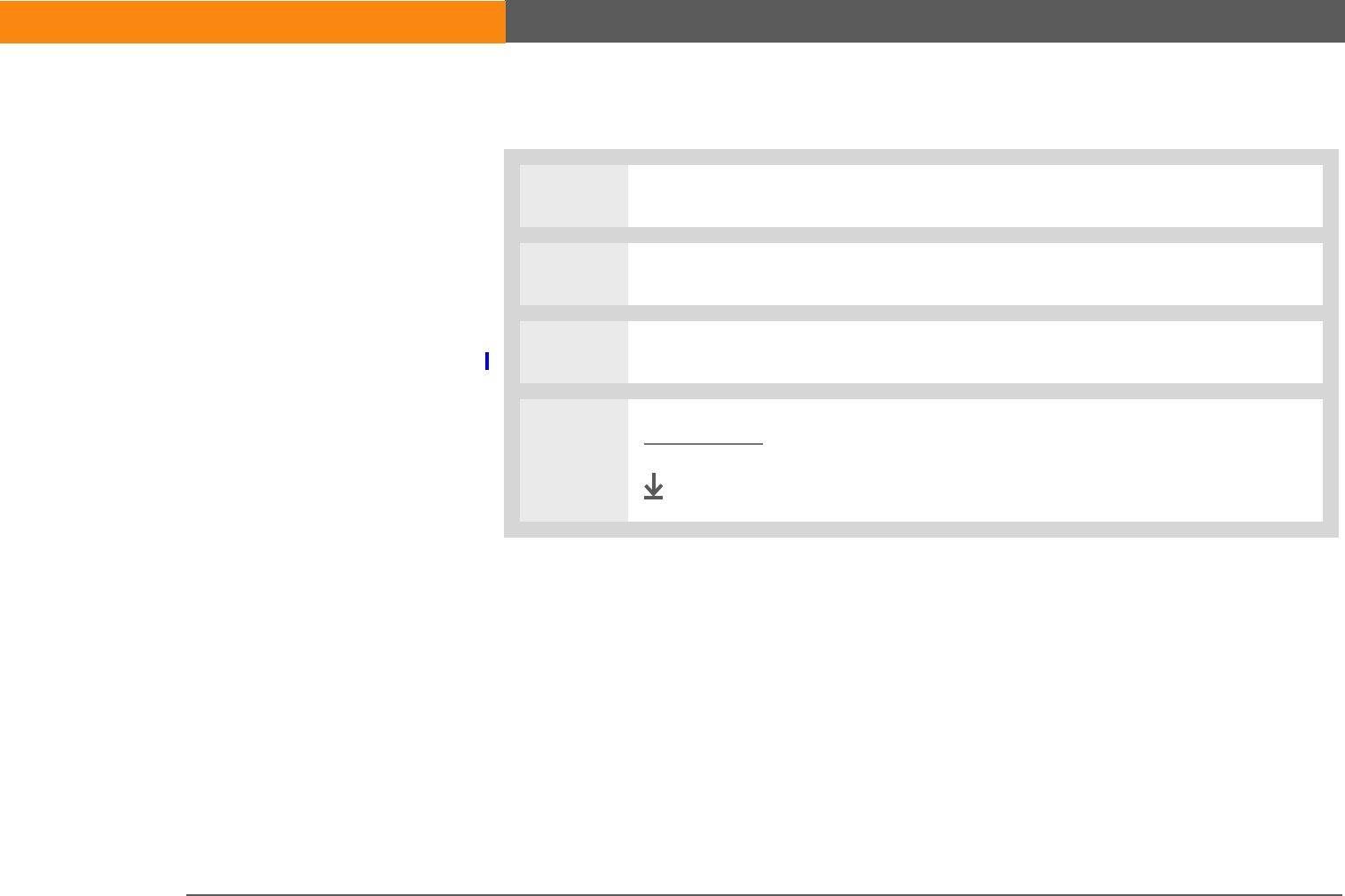
LifeDrive from palmOne 125
CHAPTER 5 Moving and Managing Info Between Your Device and Your Computer
MAC ONLY
0
Checking space and version numbers
Before you install a file or an application, it’s important to make sure you have enough space for it.
You may also want to check the version number of applications that are already on your device or
expansion card, in case you’re interested in upgrading them.
1Insert the CD into your computer.
2Double-click the Essential Software folder.
3Install the applications you want.
4Do a full sync.
Done
SECOND DRAFT palmOne, Inc. Confidential
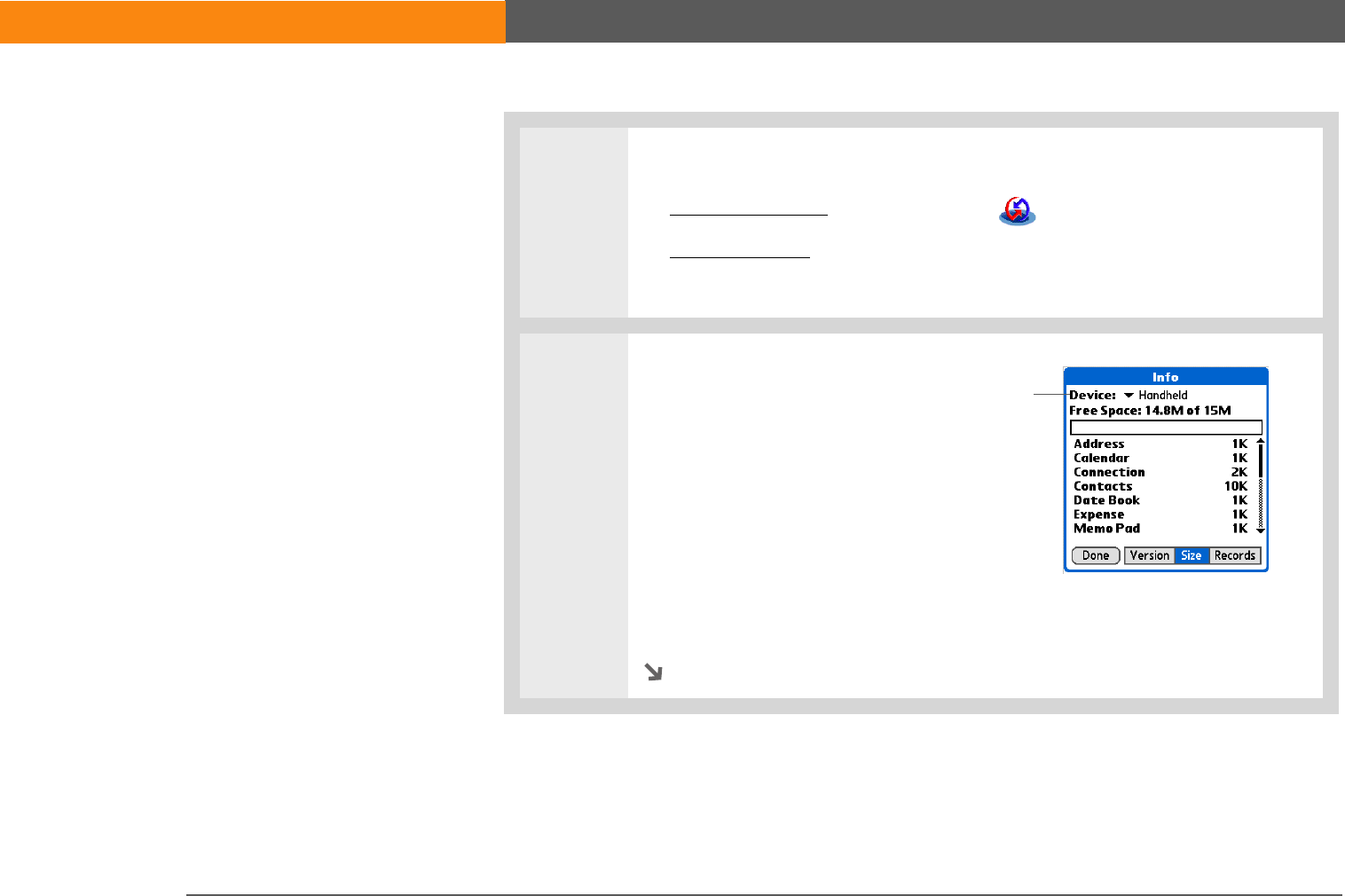
LifeDrive from palmOne 126
CHAPTER 5 Moving and Managing Info Between Your Device and Your Computer
0
1Open the Info dialog box:
a. Go to Applications and select HotSync .
b. Open the menus.
c. Select Info on the App menu.
2View space info and version
numbers:
a. Select the Device pick list and
select one of these options:
Device Get information about
applications stored on your
device.
Expansion card name Get
information about applications
stored on your expansion card.
Continued
Pick list
SECOND DRAFT palmOne, Inc. Confidential
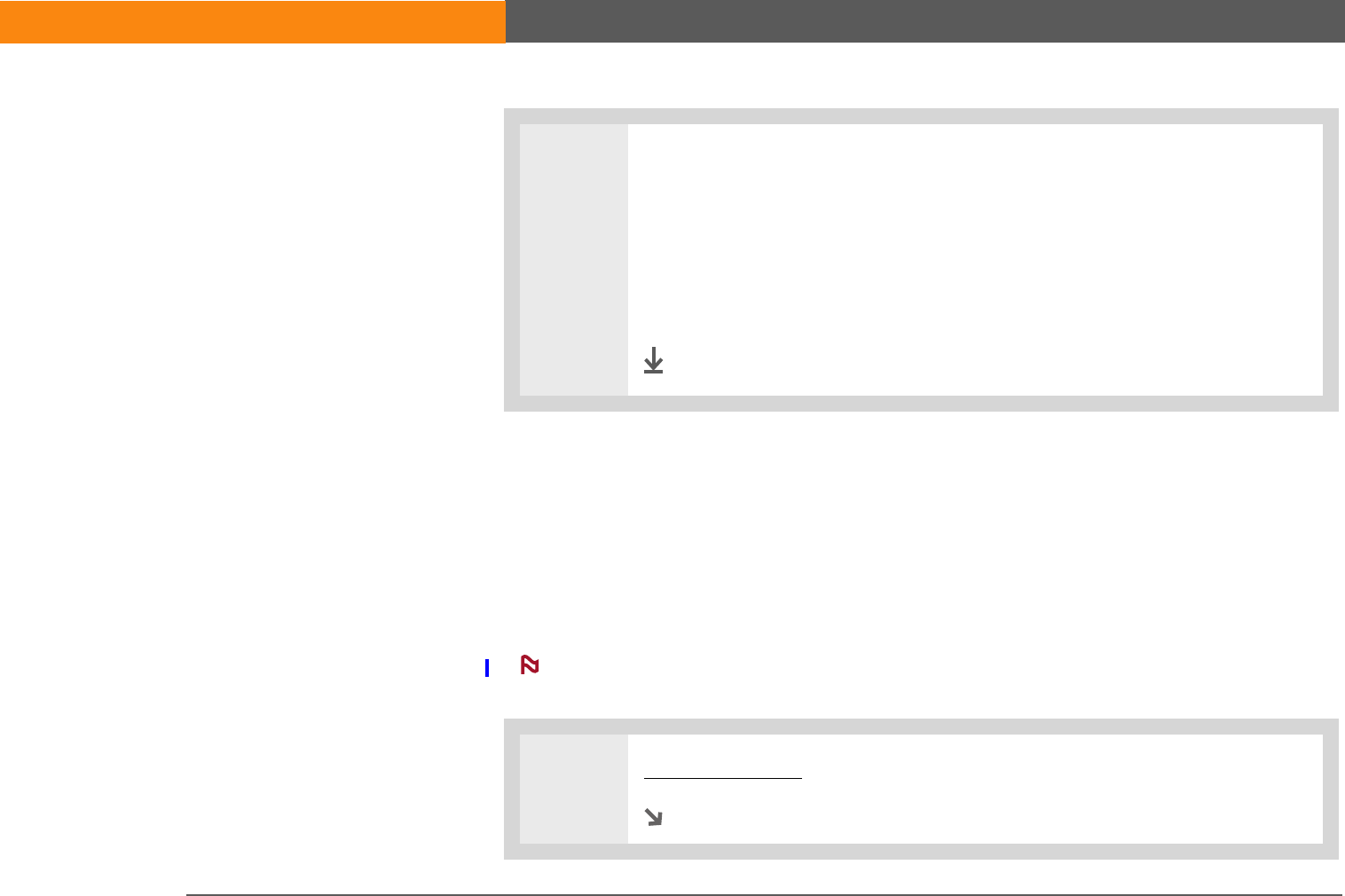
LifeDrive from palmOne 127
CHAPTER 5 Moving and Managing Info Between Your Device and Your Computer
Removing information
You can remove applications from your device, and remove Palm Desktop software from your
computer.
Removing an application from your device
If you run out of memory or decide that you no longer want some applications you installed, you
can remove them from your device or from an expansion card.
You can remove only add-on applications, patches, and extensions that you install. You
cannot remove the applications that are part of the operating system of your device.
0
Cont’d.
b. Select one of the following options, and then select Done:
Version Displays the version numbers of all of your applications.
Size Shows how much space each application occupies. The bar at the top
shows the total space currently in use on your device or expansion card.
Records Shows the number of records in an application.
Done
1Go to Applications.
Continued
NOTE
SECOND DRAFT palmOne, Inc. Confidential
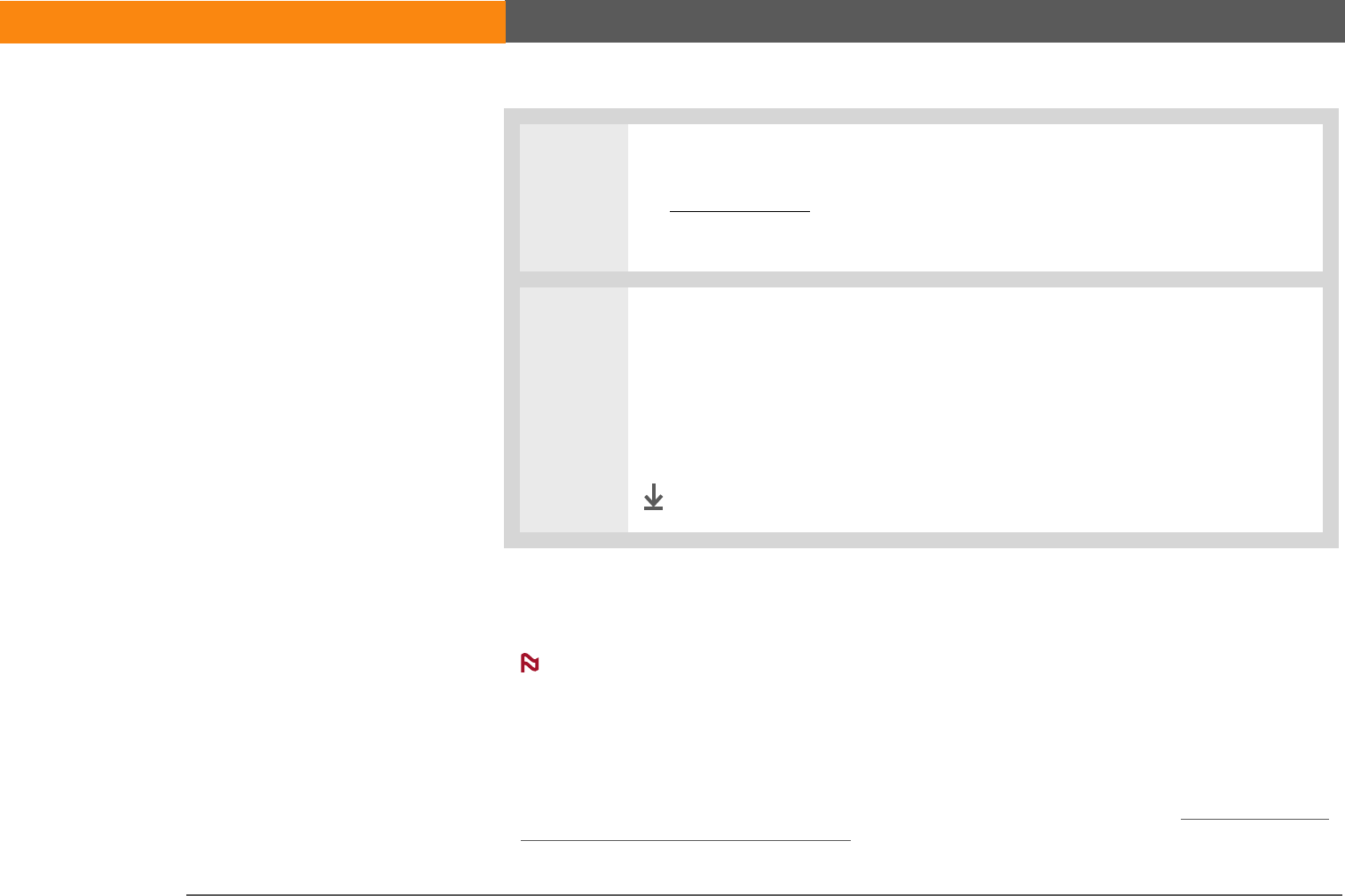
LifeDrive from palmOne 128
CHAPTER 5 Moving and Managing Info Between Your Device and Your Computer
Removing Palm Desktop software from your computer
WINDOWS ONLY
Mac computers do not provide an option for uninstalling Palm Desktop software.
If you think you’ll never want to synchronize your device with your computer again, you can
remove Palm Desktop software from your computer. This process removes only the application
files. The information in your Users folder remains untouched.
If you remove Palm Desktop software, you also remove the synchronization
software and can no longer synchronize your information. Even if you want to synchronize with
another personal information manager, like Microsoft Outlook, you must leave Palm Desktop
software installed on your computer.
2Open the Delete dialog box:
a. Open the menus.
b. Select Delete from the App menu.
3Delete the application:
a. Select the Delete From pick list, and then select Device or an expansion card.
b. Select the application that you want to remove, and then select Delete.
c. Select Yes, and then select Done.
Done
NOTE
IMPORTANT
[!]
SECOND DRAFT palmOne, Inc. Confidential
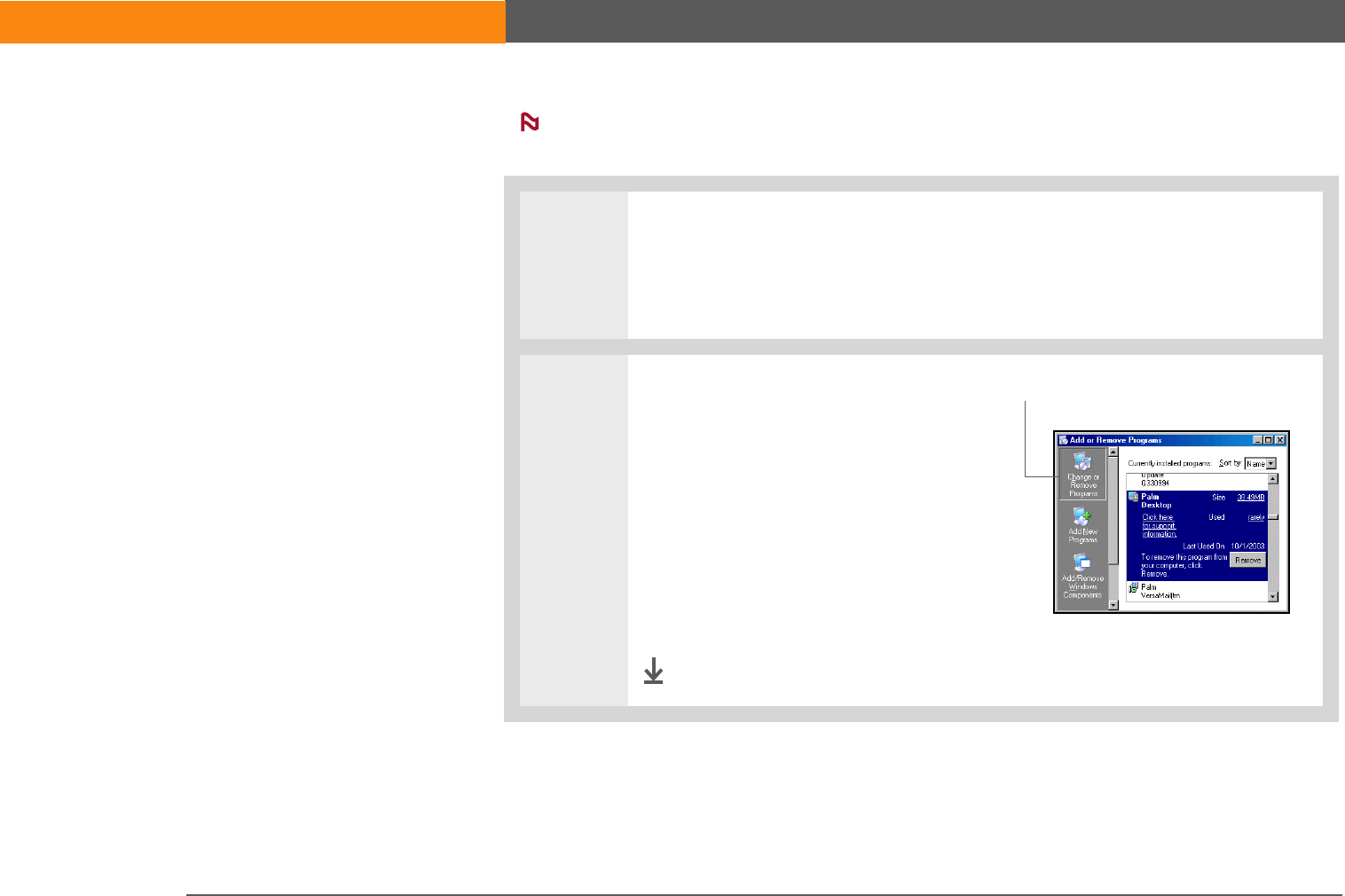
LifeDrive from palmOne 129
CHAPTER 5 Moving and Managing Info Between Your Device and Your Computer
You may have to modify these steps to correspond with the operating system on your
computer.
0
1Open Add/Remove Programs:
a. From the Start menu, select Settings, and then select Control Panel.
b. Double-click the Add/Remove programs icon.
2Remove Palm Desktop software:
a. Click Change or Remove
Programs.
b. Select Palm Desktop software,
and then click Remove.
c. Click Yes in the Confirm File
Deletion box.
d. Click OK, and then click Close.
Done
NOTE
Change or Remove Programs
SECOND DRAFT palmOne, Inc. Confidential

LifeDrive from palmOne 130
CHAPTER 5 Moving and Managing Info Between Your Device and Your Computer
Related topics
Click a link below to learn about these related topics:
0
Setting Up Switching between Palm Desktop software and Microsoft Outlook
Moving Around • Opening applications
• Using menus
Pocket Tunes • Transferring files from a CD to your device or to an expansion card
• Listening to audio files on your device
VersaMail Synchronizing email messages on your device with email messages on
your computer
Common
Questions
Answers to frequently asked questions about moving and managing
information between your device and your computer
Tips & Tricks
Make your device uniquely
yours. For great tips,
software, accessories, and
more, visit
www.palmOne.com/
mylifedrive.
Support
If you’re having problems
with moving and managing
information or with anything
else on your device, go to
www.palmOne.com/
support.
SECOND DRAFT palmOne, Inc. Confidential

LifeDrive from palmOne 131
CHAPTER 6
Managing Your Contacts
Say good-bye to a paper address book
that you need to update manually
every time someone moves, changes
their email address, or gets a new work
extension. With Contacts, not only is it
easy to enter information such as
names, addresses, and phone
numbers, but it is just as quick to view,
update, and organize contact
information.
You can easily share info with other
devices and dial phone numbers or
send messages directly from a contact
entry using your device’s built-in
wireless technology. You can even add
photos of your loved ones directly to
their contact information screen.
Benefits of Contacts
• Carry all your business and personal
contact information in your hand
• Keep track of who’s who
• Keep in touch
I
n t
hi
s c
h
apter
Adding a contact
Copying contact information
into multiple contacts
Locating a contact on your
list
Deleting a contact
Customizing the Contacts
list
Making connections from
Contacts
Working with Contacts on
your computer
Related topics
SECOND DRAFT palmOne, Inc. Confidential
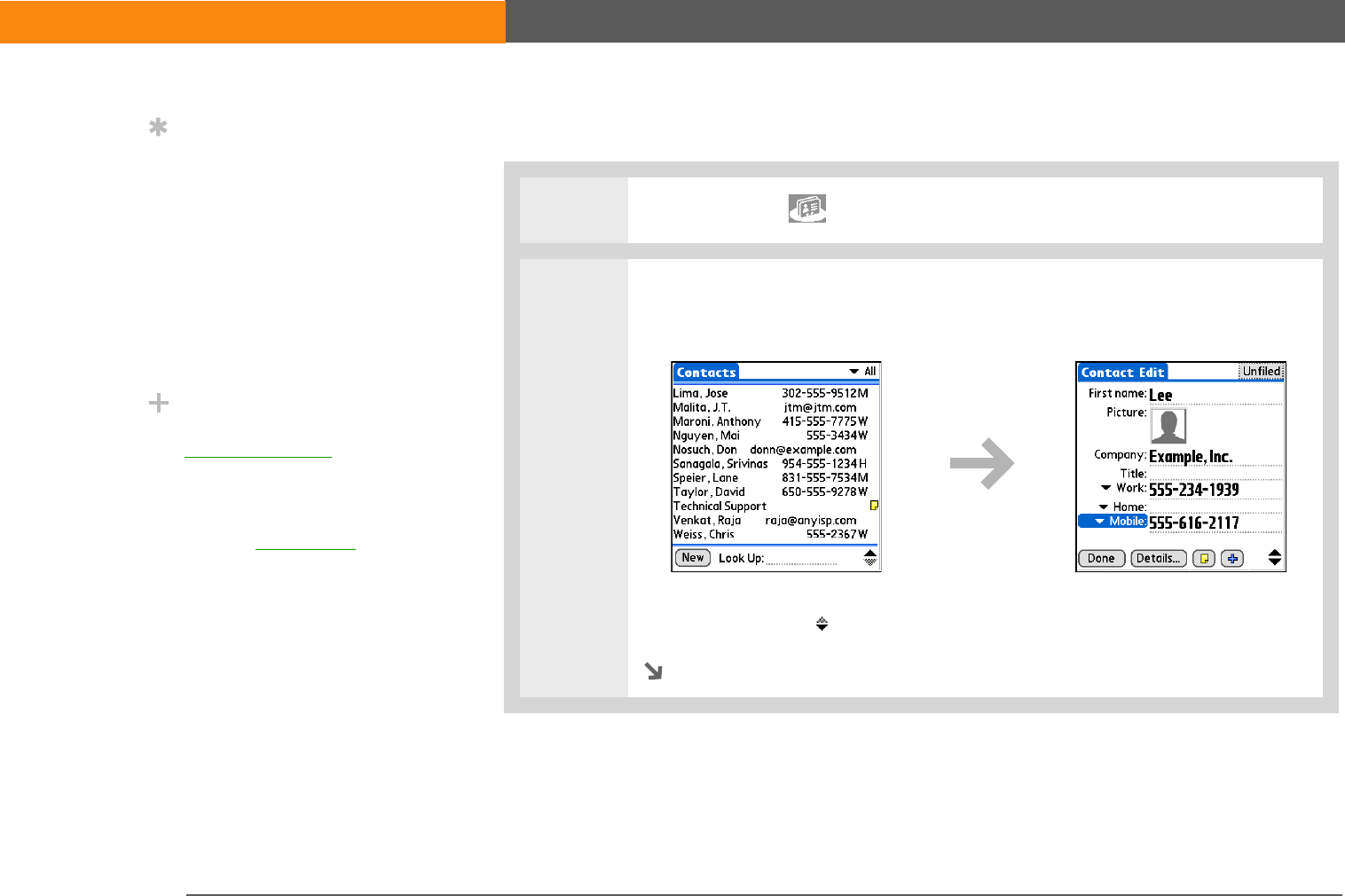
LifeDrive from palmOne 132
CHAPTER 6 Managing Your Contacts
Adding a contact
0
1Tap the Contacts icon.
2Add your contact information:
a. Select New.
b. Select each field where you want to enter information, and enter it. Select
the scroll arrows to view more fields.
Continued
Tip
If the first character you
enter in the Last Name or
Company field is an
asterisk (*) or another
symbol, that record
always appears at the top
of the Contacts list. That’s
useful for an entry like “If
Found Call [your phone
number].”
Did You Know?
Contacts info is stored in
program memory. This
means that you can view
the info only by looking at
it in the application and
you can synchronize the
information by pressing
the sync button on the
USB cable. Info in
contacts can be
synchronized with info in
either Palm®Desktop
software or Outlook.
SECOND DRAFT palmOne, Inc. Confidential
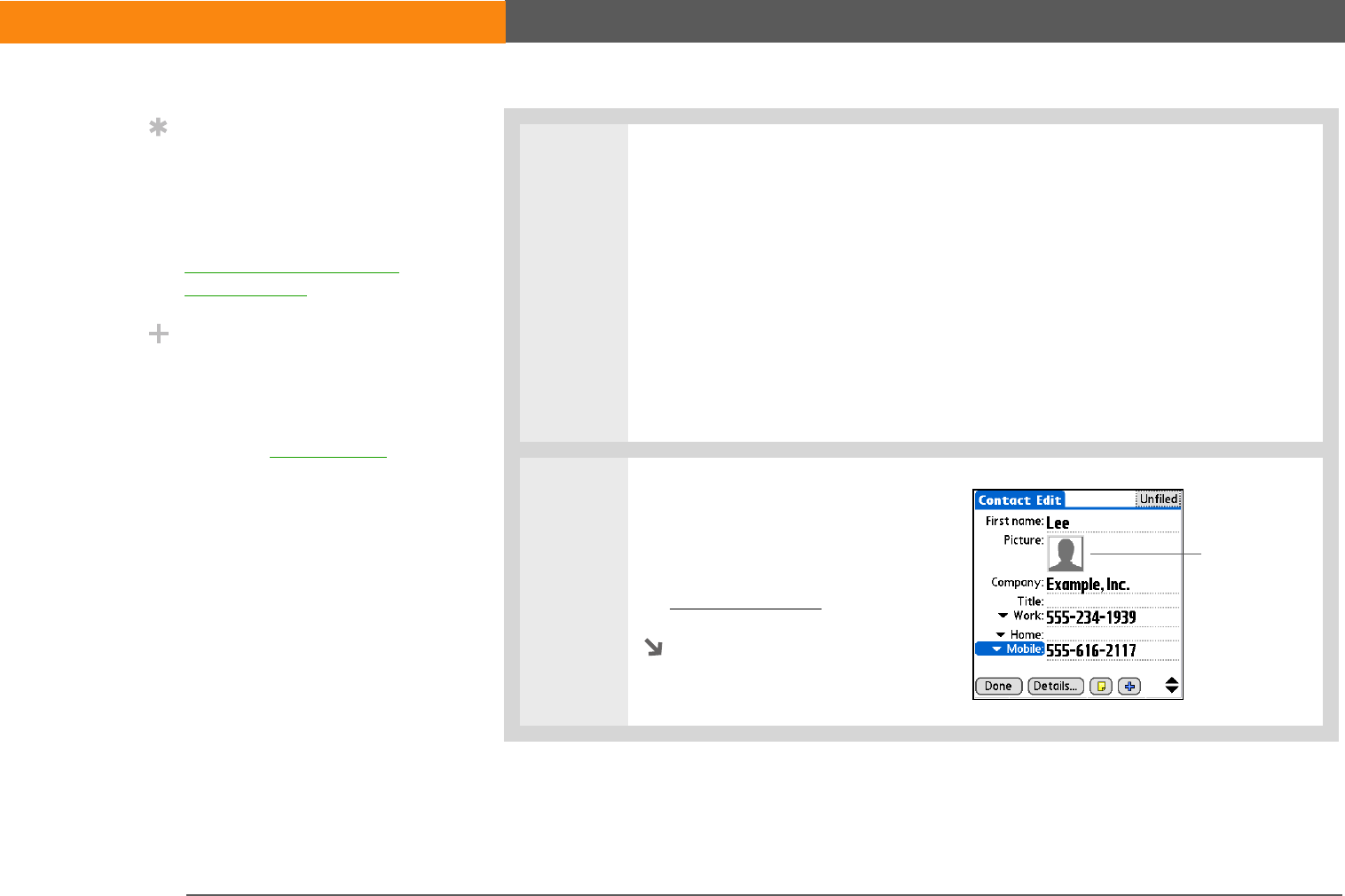
LifeDrive from palmOne 133
CHAPTER 6 Managing Your Contacts
Cont’d.
The following fields contain features to help you enter information quickly:
All fields except numeric and email fields The first letter is automatically
capitalized.
Title, Company, City, and State As you enter letters, a match appears if you
have one on your Contacts list. For example, if you enter S, Sacramento might
appear, and if you then enter a and n, San Francisco might replace Sacramento.
When the word you want appears, select the next field.
Address You can enter up to three addresses, each containing five fields: Addr,
City, State, Zip Code, and Country. You can designate an address as work (W),
home (H), or other (O). By default, the first address is designated as work.
3[ & ] OPTIONAL Add a photo:
a. Select the Picture box.
b. Select and add a photo from
palmOne™ Media.
Continued
Tip
If multiple contacts share
information, such as a
company name and
address, you can enter
the first contact, and then
copy the information into
other contacts.
Did You Know?
You can also enter one or
more contacts on your
desktop computer, and
then copy them to your
device by synchronizing.
Select
here
SECOND DRAFT palmOne, Inc. Confidential
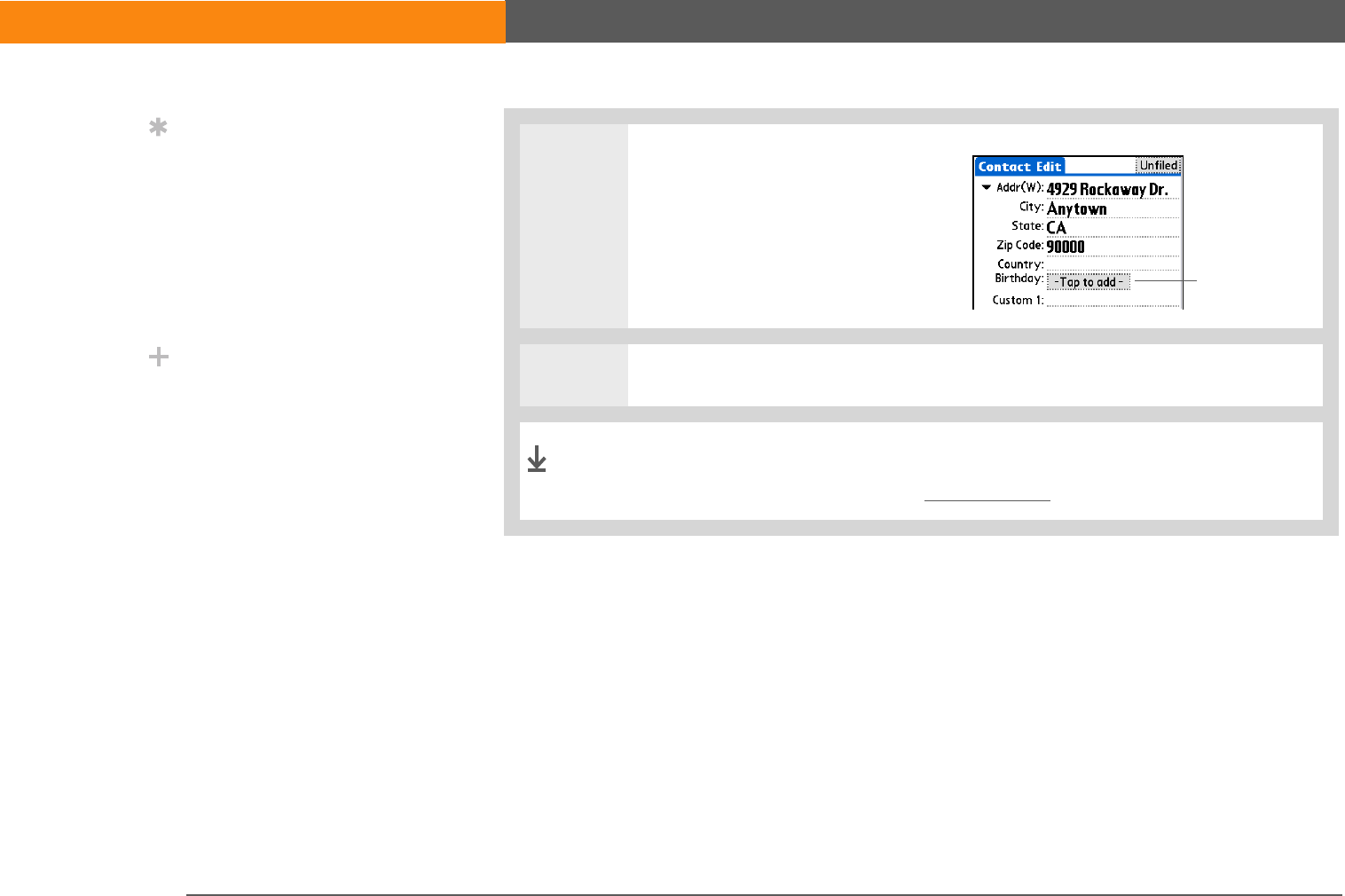
LifeDrive from palmOne 134
CHAPTER 6 Managing Your Contacts
4[ & ] OPTIONAL Add a
birthday:
a. Select the Birthday box.
b. Select the birth year, month,
and date.
5After you finish entering all the information you want, select Done.
That's it. Your device automatically saves the contact. Make sure
you have a current backup. Synchronize often.
Tip
If you want a reminder
about a birthday, check
the Reminder box, enter
the number of days
before the birthday that
you want to see the
reminder, and then select
OK.
Did You Know?
Birthdays you enter in
Contacts appear as
untimed events in
Calendar. If you update
the birthday in Contacts,
it automatically updates
in Calendar as well.
Select
here
Done
SECOND DRAFT palmOne, Inc. Confidential
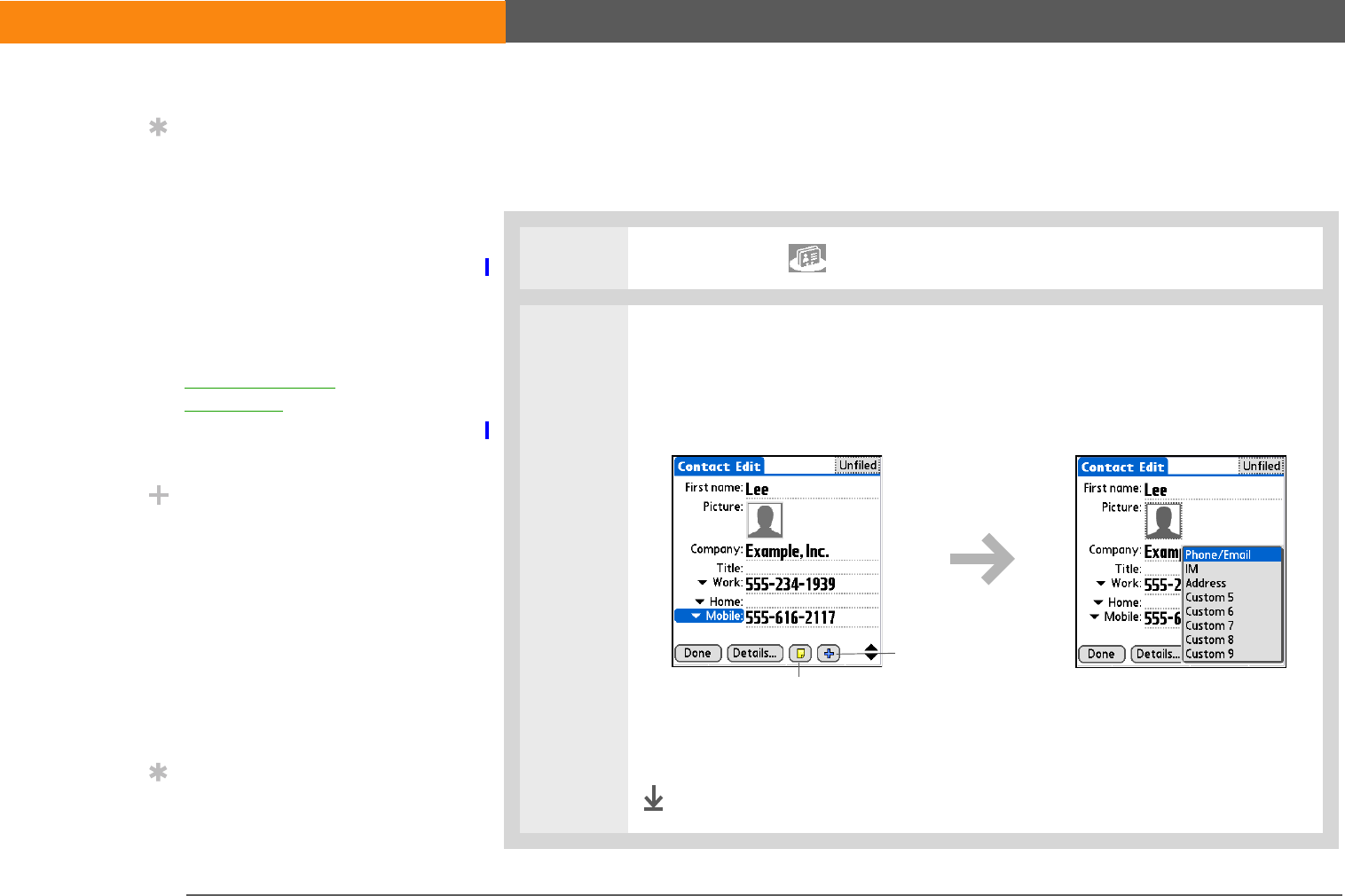
LifeDrive from palmOne 135
CHAPTER 6 Managing Your Contacts
Entering additional contact information
The Contact Edit screen displays certain fields by default. You can customize the Contact Edit
screen to display additional fields.
0
1Tap the Contacts icon in the input area.
2Display additional contact fields:
a. Select the contact you want, and then select Edit.
b. Select the plus button in the lower-right corner of the Contact Edit screen.
c. Select the field you want displayed from the list. The field appears in a preset
location on the Contact Edit screen.
Done
Tip
Additional fields appear
in a contact only if you
enter info into them. If
you leave a field blank, it
does not appear the next
time you open the
Contact screen. Also,
additional fields apply
only to the current
contact; you can
duplicate contact
information if you need to
apply the same fields to
multiple contacts.
Did You Know?
Each field type can be
displayed a certain
number of times, up to a
preset maximum. Once
you reach this maximum,
the field type no longer
appears on the pop-up
list. For example, you can
display up to seven
Phone/Email fields.
Tip
Select the Note icon next
to the plus button to add a
note to the contact.
Select here
Note icon
SECOND DRAFT palmOne, Inc. Confidential
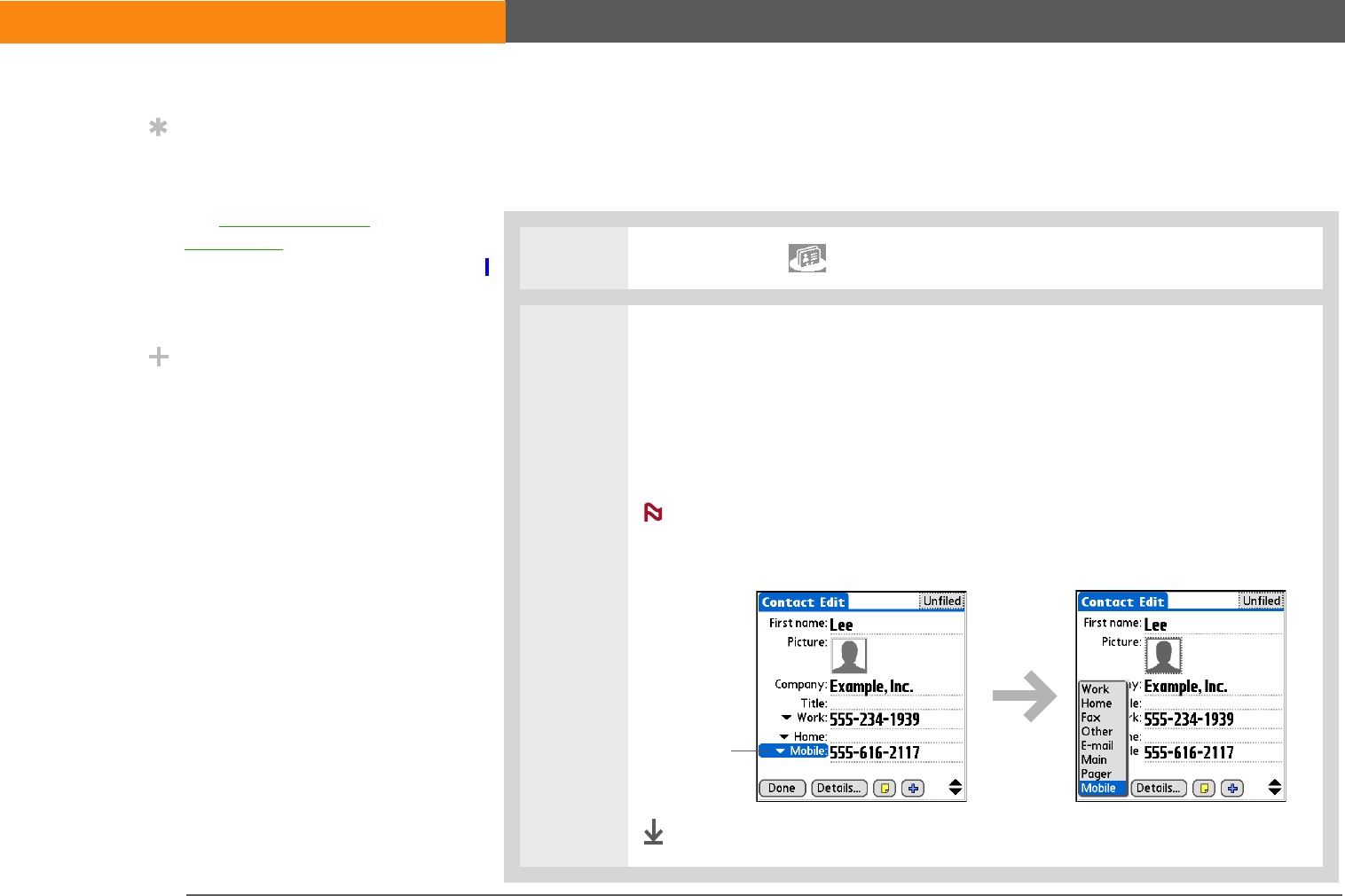
LifeDrive from palmOne 136
CHAPTER 6 Managing Your Contacts
Selecting contact field types
You can select the types of phone numbers (work, home, mobile, pager, and so on), as well as
specify the instant messenger (IM) account, that you associate with a contact.
0
1Tap the Contacts icon in the input area.
2Customize the contact field type:
a. Select the contact you want, and then select Edit.
b. Select the pick list next to the field you want to change and select the new
field type you want. Available fields include phone number, email address,
and instant messenger (IM) fields.
You must set up an instant messenger account with a service
provider and download instant messaging software to use instant messaging
on your device.
Done
Tip
Any changes you make to
field types apply only to
the current contact. You
can duplicate contact
information if you need to
apply the same contact
fields to multiple
contacts.
Did You Know?
The email address field
type is located on the
same pick list as the
phone number fields. IM
field types are located on
a separate pick list. NOTE
Select
triangle
SECOND DRAFT palmOne, Inc. Confidential
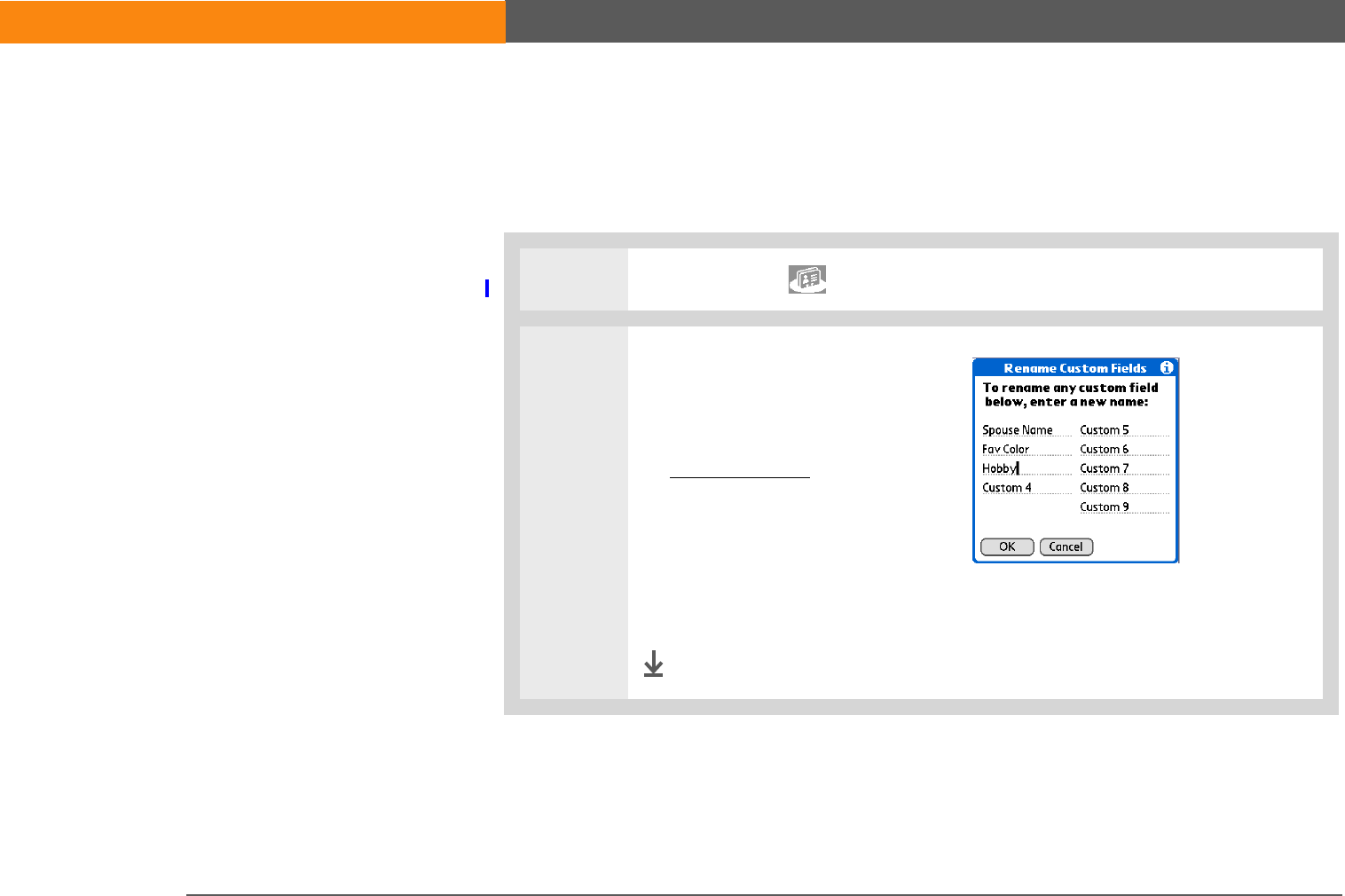
LifeDrive from palmOne 137
CHAPTER 6 Managing Your Contacts
Defining custom fields
You can define the custom fields that appear at the end of the Contact Edit screen to display any
additional contact information you want, such as spouse’s or children’s names, favorite color, or
any other information.
0
1Tap the Contacts icon in the input area.
2Define the custom fields:
a. Select the contact you want,
and then select Edit.
b. Open the menus.
c. Select Options, and then
select Rename Custom Fields.
d. Enter names for up to nine
custom fields, and then select
OK.
Done
SECOND DRAFT palmOne, Inc. Confidential
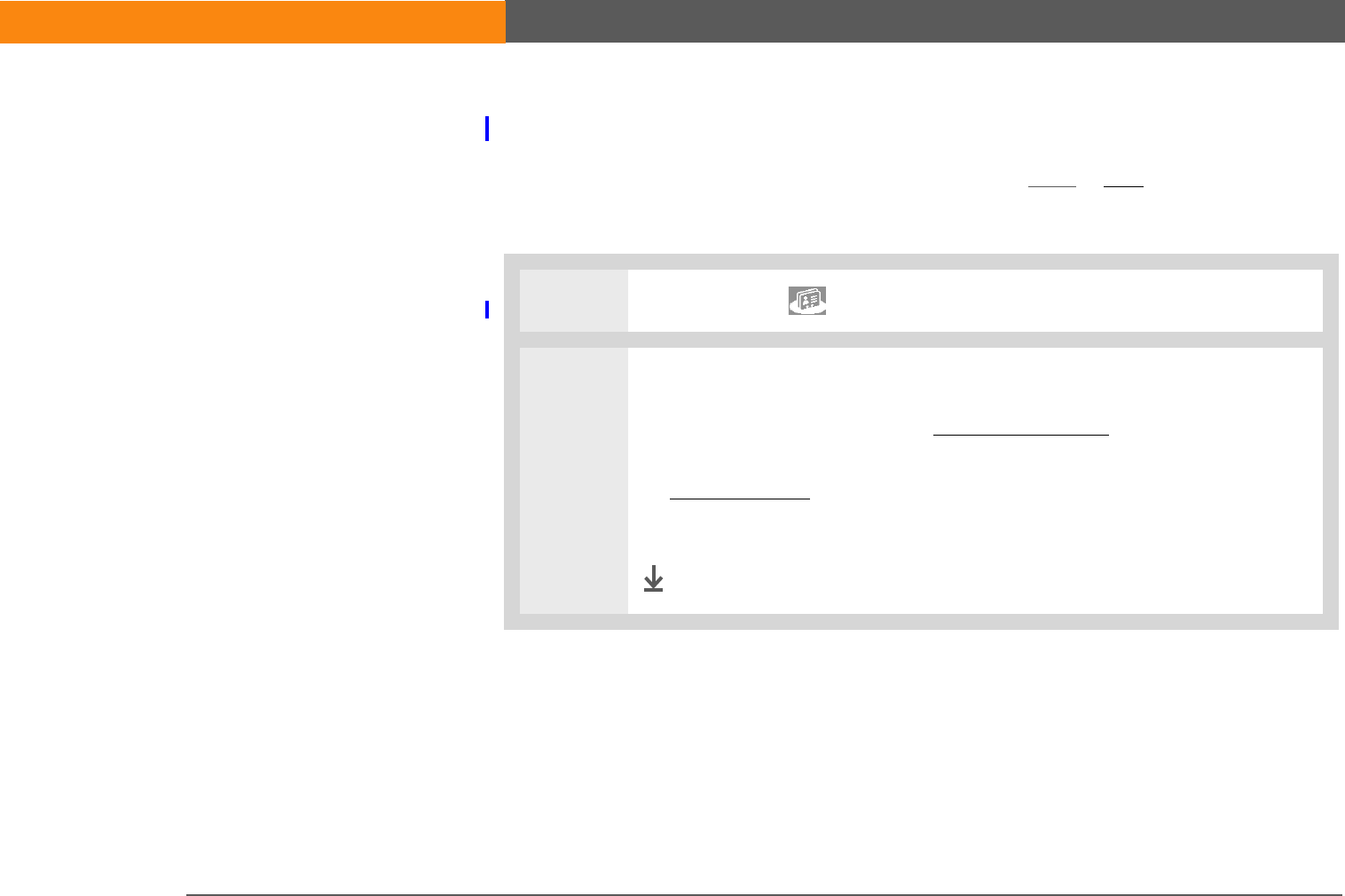
LifeDrive from palmOne 138
CHAPTER 6 Managing Your Contacts
Selecting a contact as your business card
You can create a contact with your own information and select it as your business card by opening
the Record Menu and selecting Business Card. You can then beam or send your business card to
other devices. To beam your business card quickly, press and hold the Contacts application button
for approximately two seconds.
0
1Tap the Contacts icon in the input area.
2Create a business card:
a. Select the contact you want, or create a new contact with your own contact
information.
b. Open the menus.
c. Select Business Card on the Record menu.
Done
SECOND DRAFT palmOne, Inc. Confidential
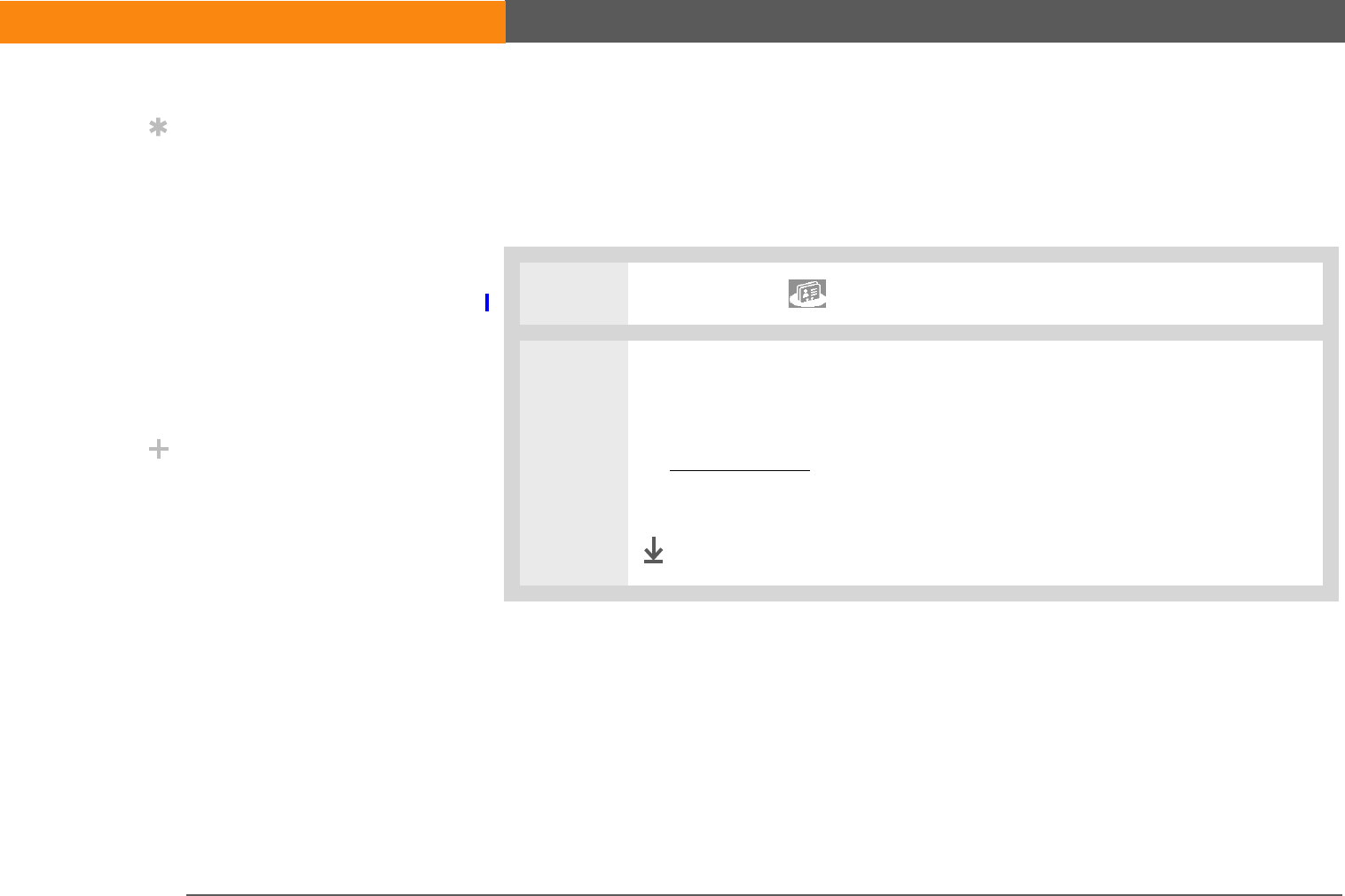
LifeDrive from palmOne 139
CHAPTER 6 Managing Your Contacts
Copying contact information into multiple contacts
You can quickly make a copy of a contact so that you can edit only the fields you need to change.
For example, if two of your contacts have the same work address or phone number, duplicating
the first contact simplifies entering information in the second.
0
1Tap the Contacts icon in the input area.
2Duplicate a contact:
a. Select the contact you want, and then select Edit.
b. Open the menus.
c. Select Record, and then select Duplicate Contact.
Done
Tip
You can also duplicate a
contact in the Contacts
desktop application by
highlighting a contact in
the Contacts list, and then
selecting Edit Copy.
Create a new contact,
select the Note icon, and
then paste the info into a
note. Then cut and paste
the text into the correct
field in the new contact.
Did You Know?
If you duplicate a contact
and do not edit the name,
the contact appears in the
Contacts list as “<Last
name>, <First name>
Copy.”
SECOND DRAFT palmOne, Inc. Confidential
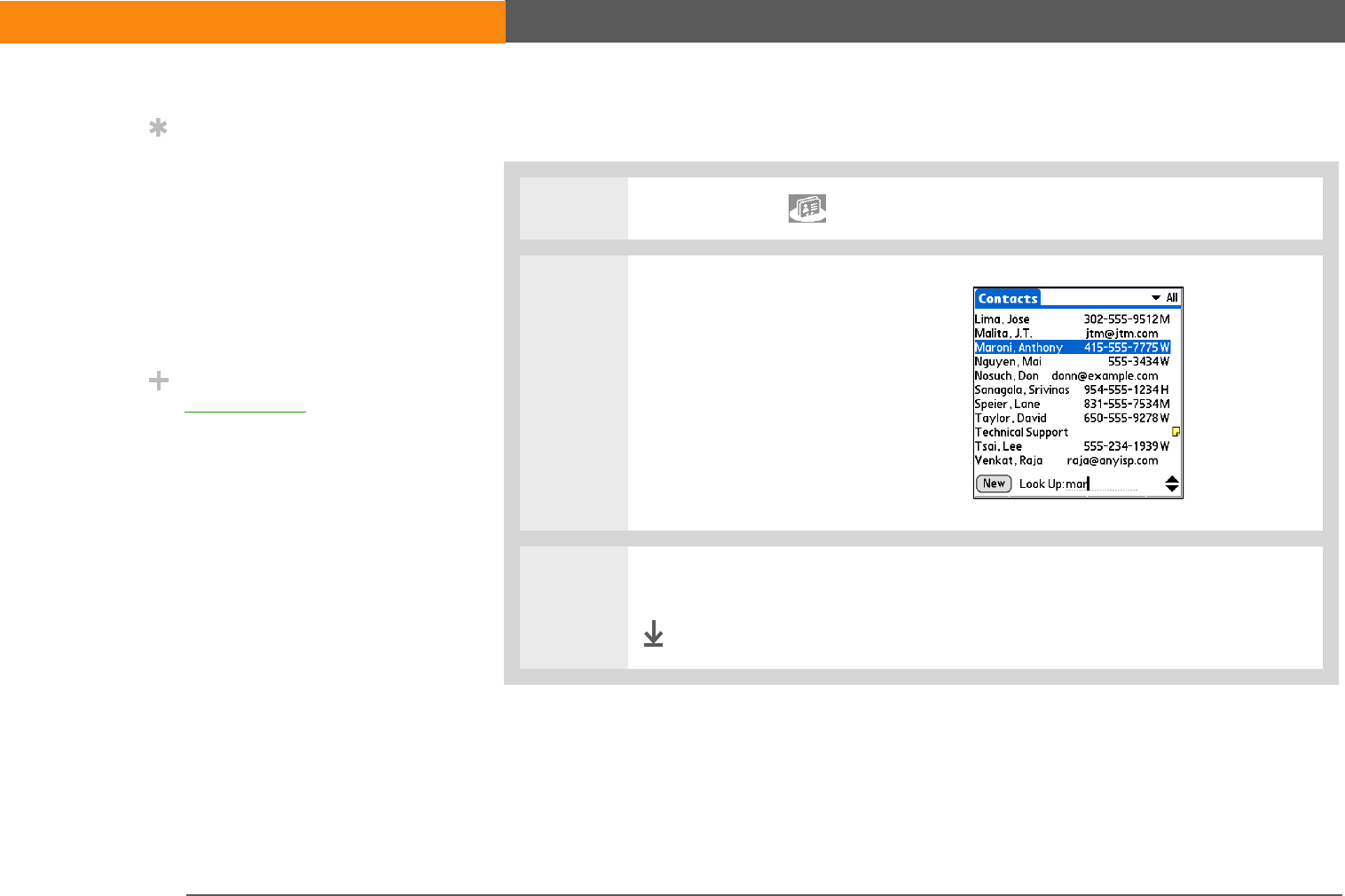
LifeDrive from palmOne 140
CHAPTER 6 Managing Your Contacts
Locating a contact on your list
0
1Tap the Contacts icon.
2Search for the contact:
a. Select the Look Up line at the
bottom of the screen and
enter the first letter of the
name you want to find.
b. Enter the second letter of the
name, and so on, until you
can easily scroll to the contact
you want.
3Select the contact to open it.
Done
Tip
In the Contacts list view,
you can also press Right
on the 5-way navigator to
open the Quick Look Up
line. Press Up and Down
to select the letter of the
name you want in each
box, and press Right to
move to the next box.
Did You Know?
Phone Lookup in the
Options menu of many
apps lets you add contact
information when you are
creating an entry in
another application or
addressing an email in
the VersaMail app, where
it's called Address
Lookup.
SECOND DRAFT palmOne, Inc. Confidential
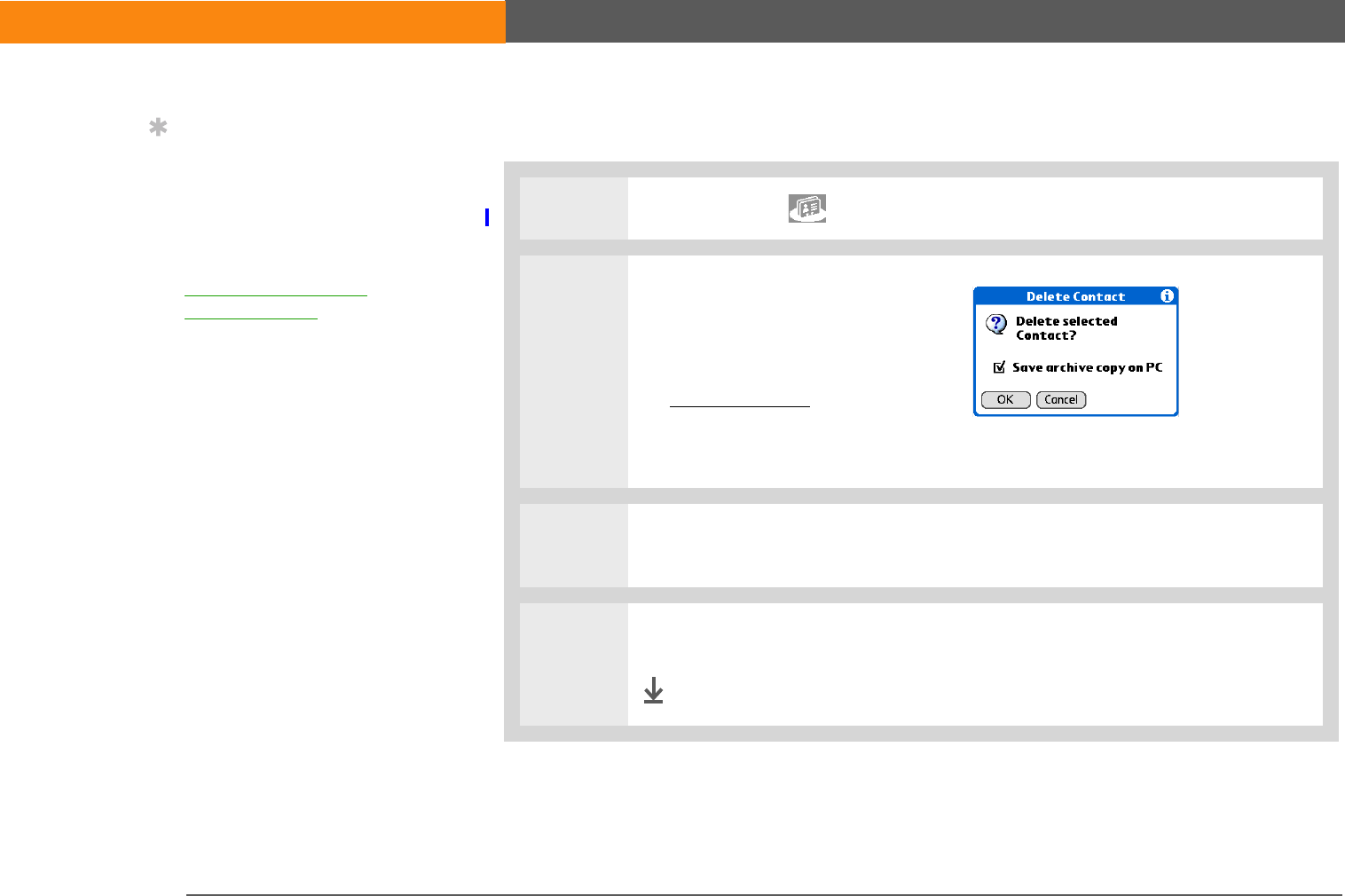
LifeDrive from palmOne 141
CHAPTER 6 Managing Your Contacts
Deleting a contact
0
1Tap the Contacts icon in the input area.
2Open the Delete Contact dialog
box:
a. Select the contact you want.
b. Open the menus.
c. Select Delete Contact on the
Record menu.
3[ & ] OPTIONAL Check the box to save an archive copy of the contact on your
computer.
4Select OK.
Done
Tip
You never know when
you’re going to need to
look up an old business
associate. If you save an
archive copy of your
deleted contacts, you can
refer to them later by
importing them.
SECOND DRAFT palmOne, Inc. Confidential
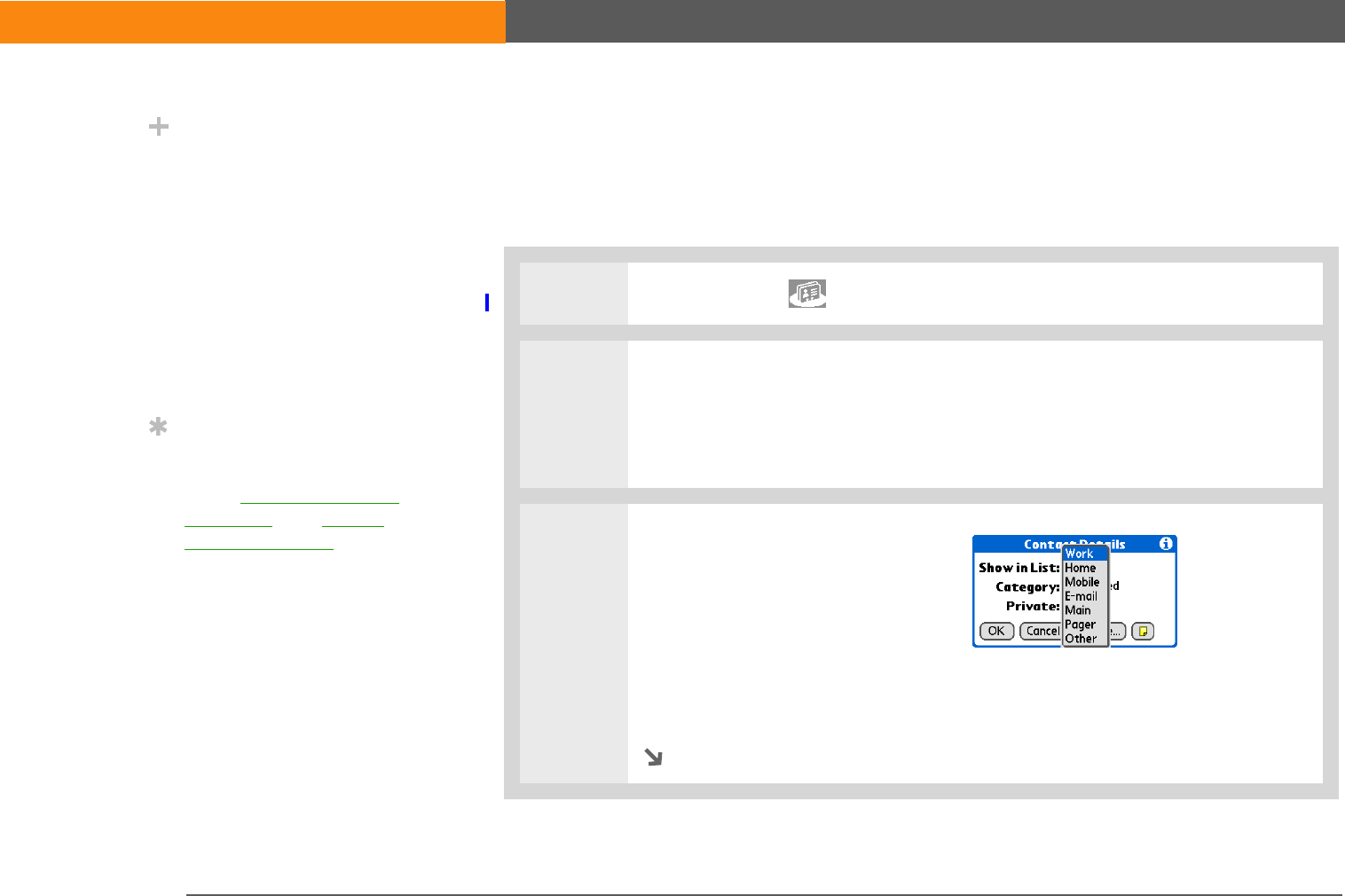
LifeDrive from palmOne 142
CHAPTER 6 Managing Your Contacts
Customizing the Contacts list
By default, the Contacts list displays the work phone number for a contact; if no work phone
number is entered, another entry is displayed. You can customize a contact’s settings to display
different information on the Contacts list. You can also customize the appearance of the list.
0
1Tap the Contacts icon in the input area.
2Open the Contact Details dialog box:
a. Select the contact you want.
b. Select Edit, and then select Details.
3Specify the information
displayed with a contact:
a. Select the Show in List pick
list, and select the information
that you want to appear in the
Contacts list for this contact.
b. Select OK.
Continued
Did You Know?
If you select Work, Home,
Fax, Other, Main, Pager,
or Mobile from the pick
list, the first letter of your
selection appears next to
the contact in the
Contacts list—for
example, W for Work. If
you select email, no letter
appears next to the
contact.
Tip
You can also use the
Contact Details dialog
box to assign a contact to
a category or to mark a
contact as private.
SECOND DRAFT palmOne, Inc. Confidential
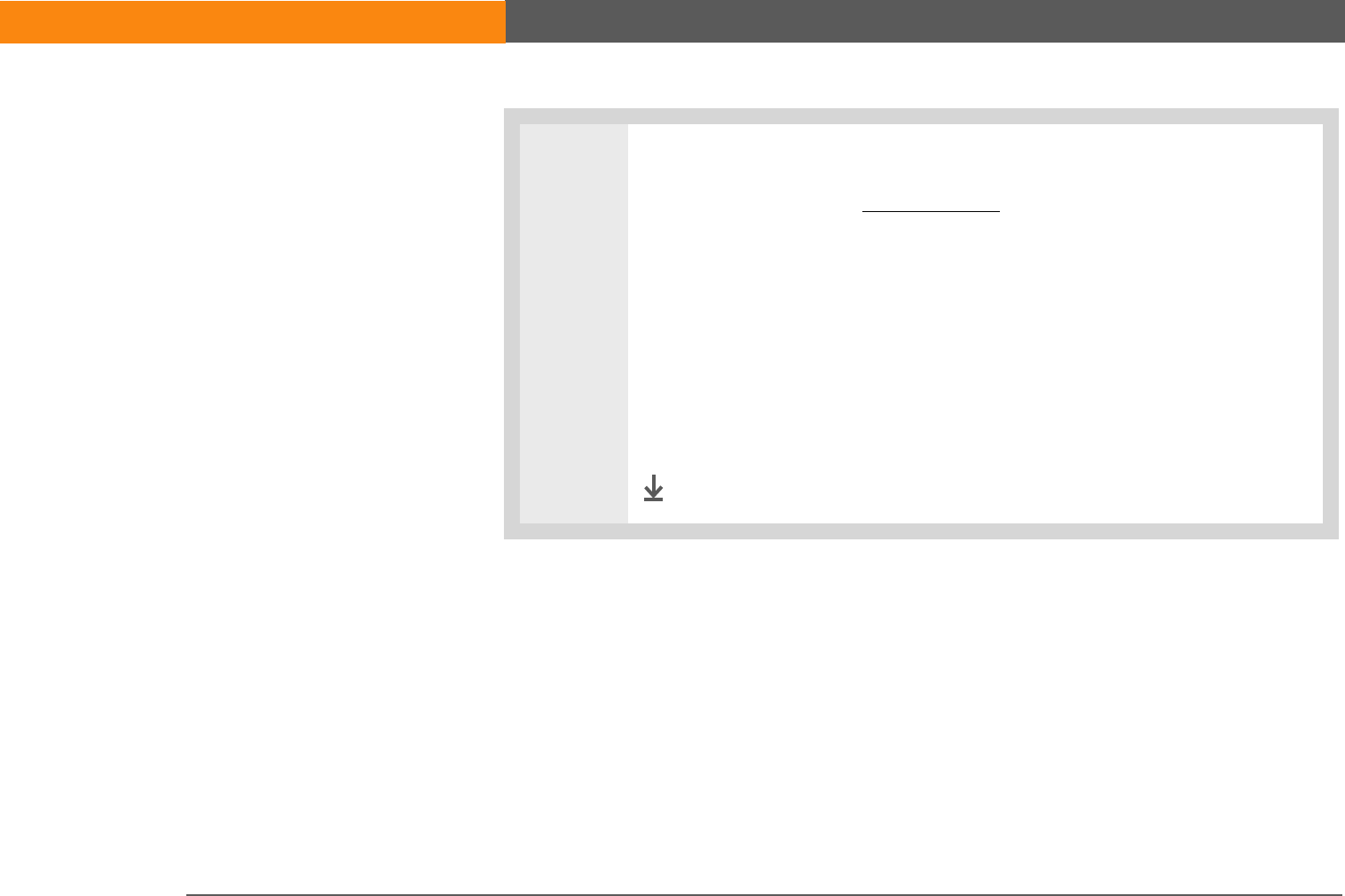
LifeDrive from palmOne 143
CHAPTER 6 Managing Your Contacts
4Customize the appearance of the Contacts list:
a. From the Contacts list, open the menus.
b. Select Options, and then select Preferences.
c. Select the display options you want:
Remember last category Check the box if you want Contacts to display the
last category shown when you return to it from another application. If the
box is unchecked, Contacts opens to the All category.
List by Select whether to sort the Contacts list by last name and first name
or by company and last name.
Done
SECOND DRAFT palmOne, Inc. Confidential
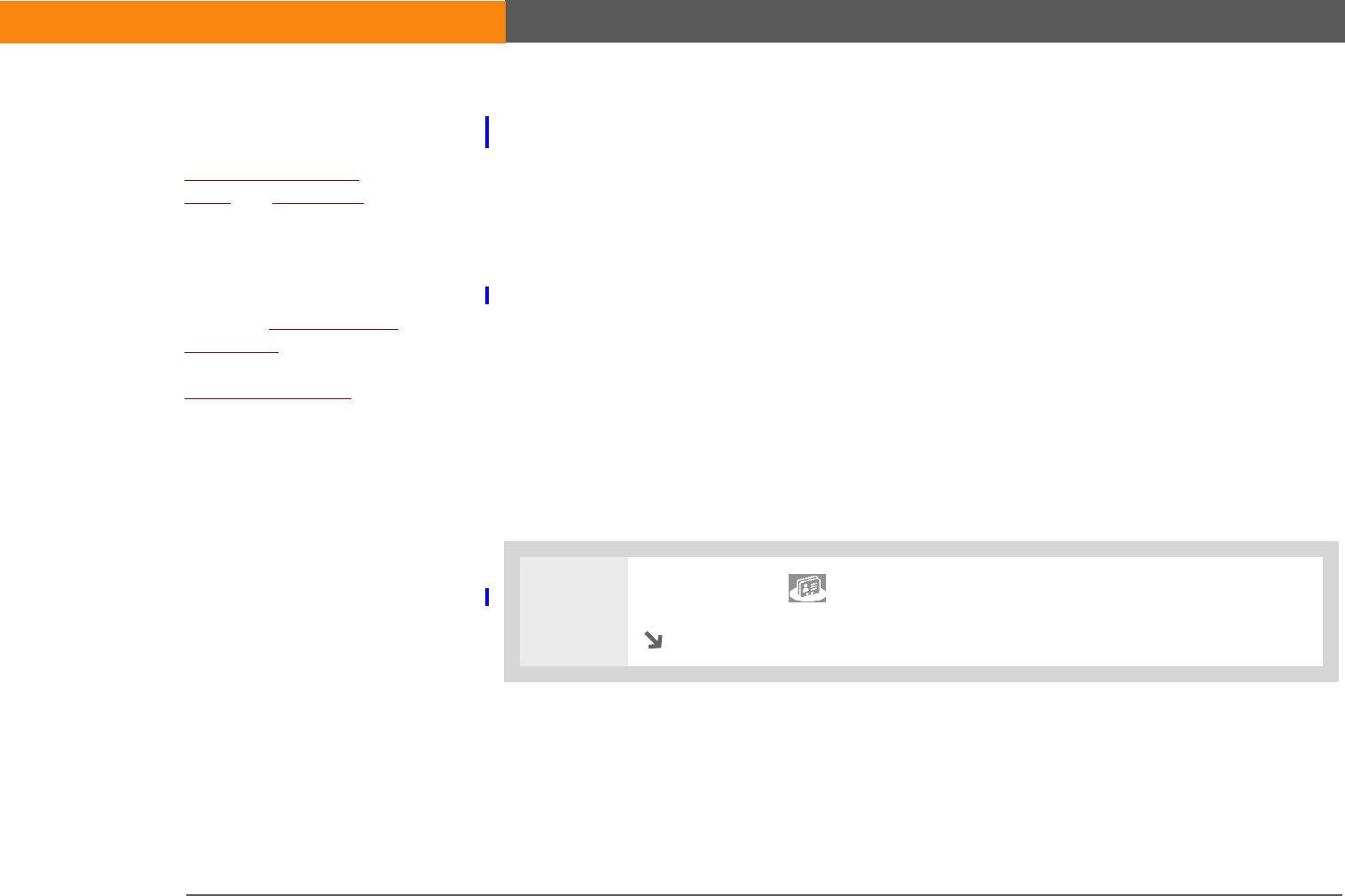
LifeDrive from palmOne 144
CHAPTER 6 Managing Your Contacts
Making connections from Contacts
You can set up your contacts so that you can do tasks like dialing a phone number; creating an
email or text message; accessing the web; or sending an instant message (requires additional
software, sold separately) directly from a contact screen. Contacts gives you two tools to perform
these tasks:
Quick Connect Lets you select a connection type and opens the application for making that type
of connection directly from the Contacts list view and contact’s information screen.
Tap-to-Connect Opens the application to perform a connection task directly by selecting the
appropriate entry (phone number, email address, and so on) from a contact’s information screen.
Using Quick Connect
If you have a compatible mobile phone (sold separately) that includes Bluetooth technology, you
can use Quick Connect to dial a phone number; address an email or a text message, go to a
website, or send an instant message (requires additional software, sold separately) directly from a
contact.
0
1Tap the Contacts icon in the input area.
Continued
Before You Begin
[!]
You must complete all the
prerequisites for the
email and messaging
applications.
To use Quick Connect
with your device’s built-in
Bluetooth technology,
you must set up a phone
connection. To use it with
your device’s IR port, run
Phone Link Updater, and
then use the Phone Link
application to set up a
phone connection.
SECOND DRAFT palmOne, Inc. Confidential
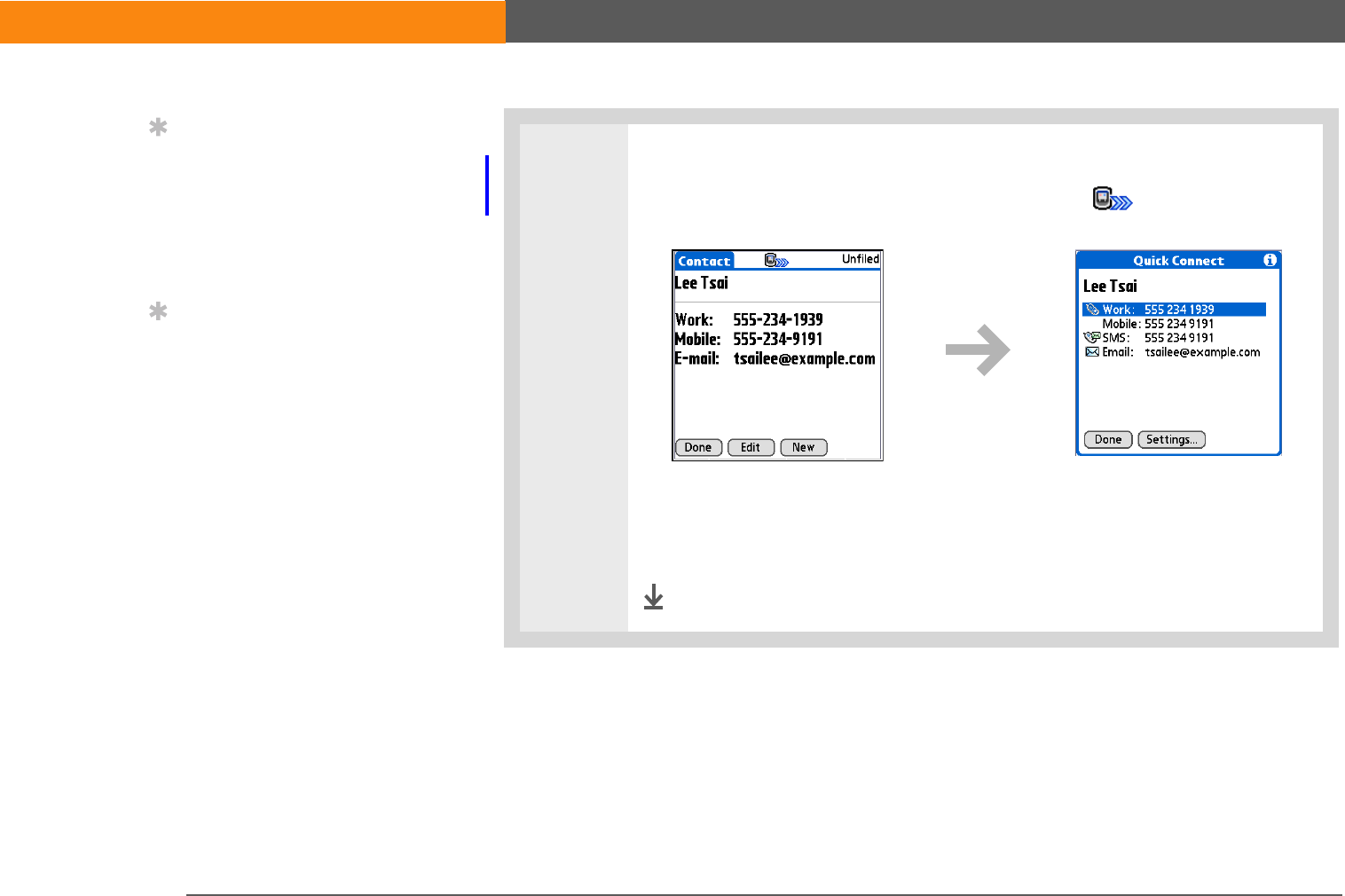
LifeDrive from palmOne 145
CHAPTER 6 Managing Your Contacts
2Make a connection using Quick Connect:
a. In the Contact view, select the Quick Connect icon at the top of the
screen to open the Quick Connect dialog box.
b. Select the type of connection you want. For example, select a phone number
to dial the number on your mobile phone, or select an email address to open
the email application to a new message containing that address in the To
field.
Done
Tip
You can also open Quick
Connect from the Contact
List view by highlighting
the contact you want and
then pressing right on the
5-way navigator.
Tip
If you want to close the
Quick Connect dialog box
without making a
connection, press Left on
the 5-way.
SECOND DRAFT palmOne, Inc. Confidential
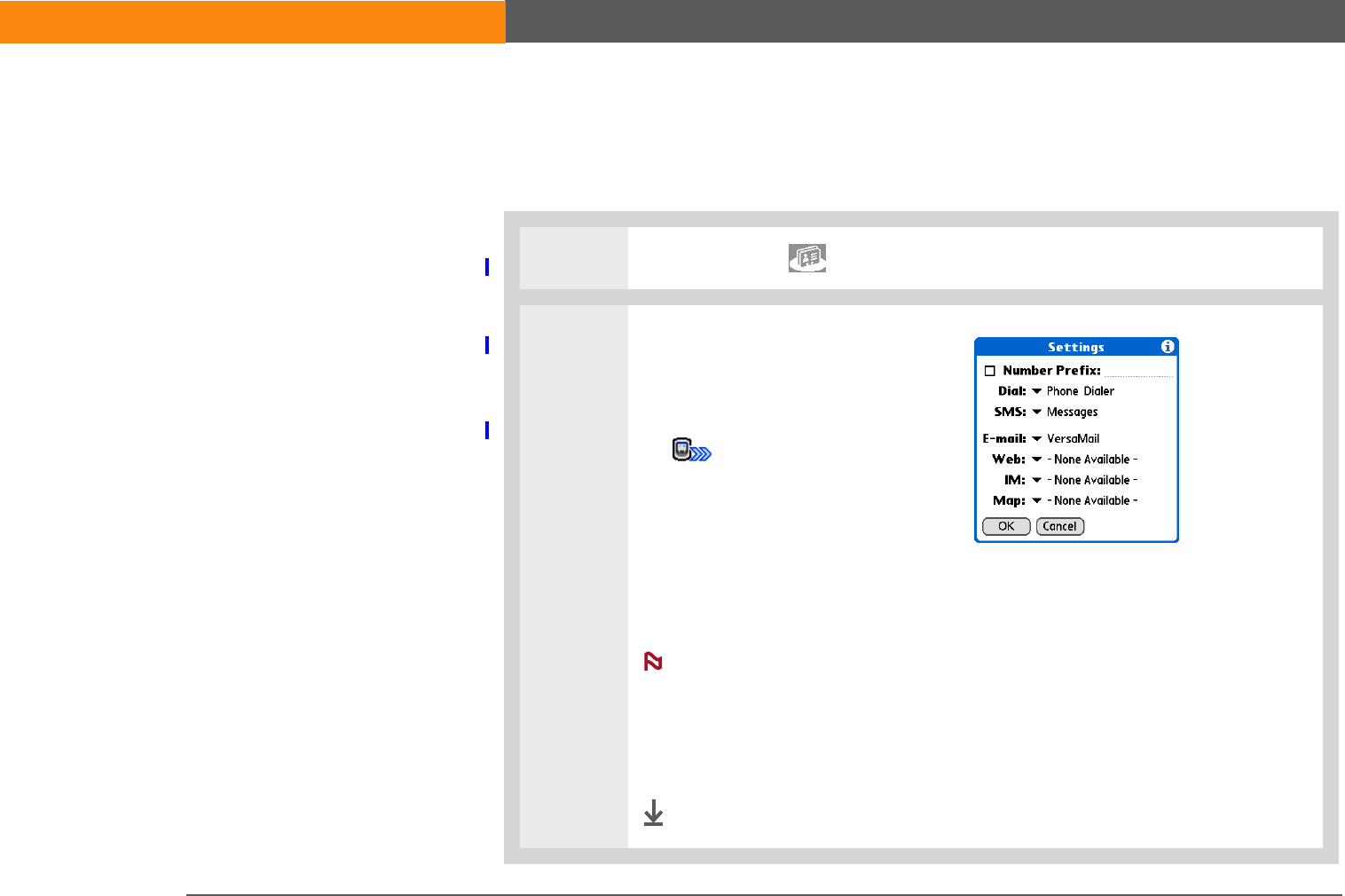
LifeDrive from palmOne 146
CHAPTER 6 Managing Your Contacts
Customizing Quick Connect settings
You can specify which application opens when you choose a Contacts record field, and whether to
add a prefix to each phone number.
0
1Tap the Contacts icon in the input area.
2Customize Quick Connect settings:
a. Select the contact you want.
b. Select the Quick Connect icon
at the top of the screen
to open the Quick Connect
dialog box.
c. Select Settings and enter the
settings you want:
Number prefix Check the box and enter a prefix to add a prefix to all dialed
phone numbers.
A prefix is not added to any number that begins with a “+” character.
All other fields Select each pick list and select the application you want to use
to connect by that method.
d. Select OK.
Done
NOTE
SECOND DRAFT palmOne, Inc. Confidential
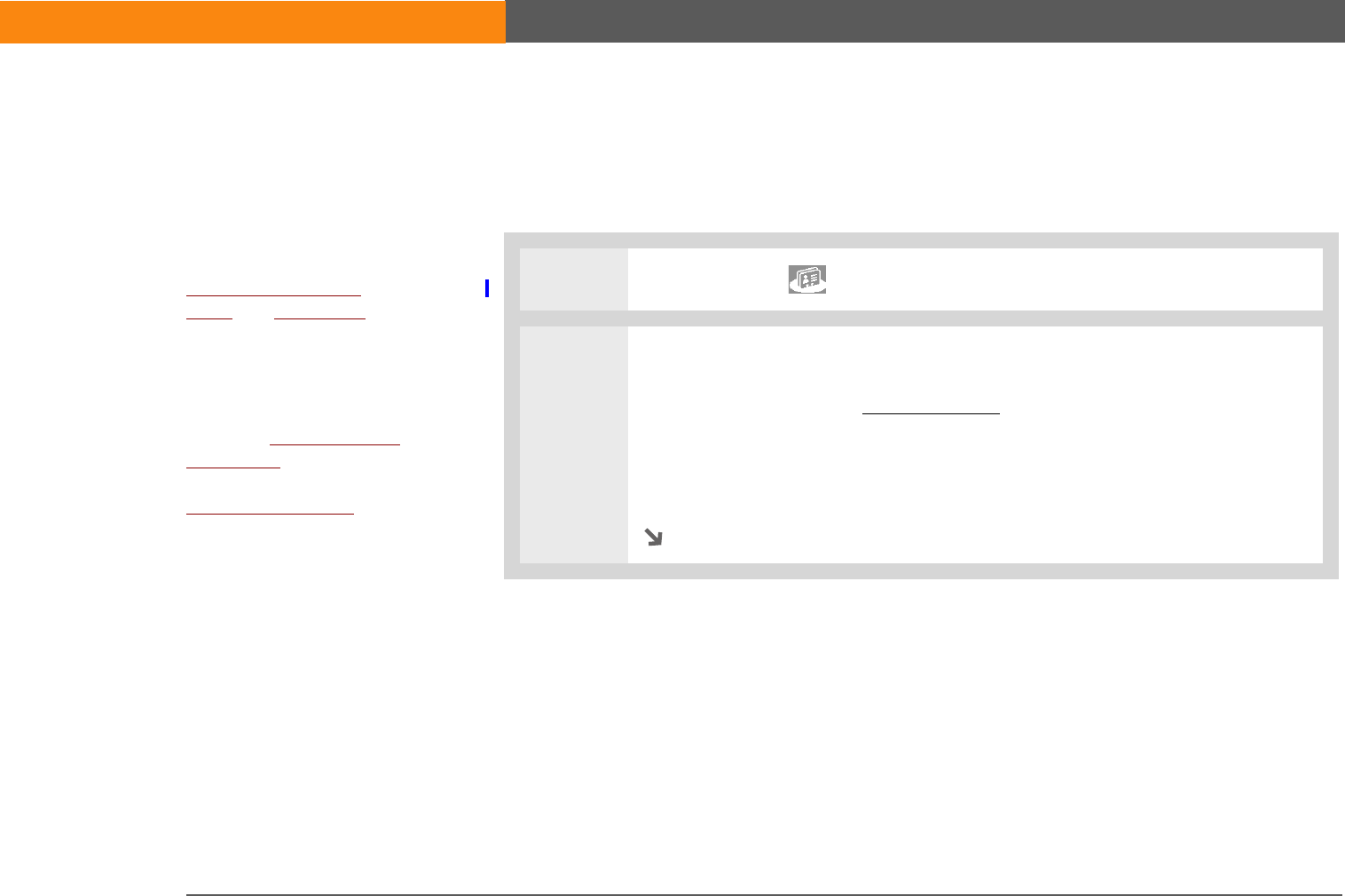
LifeDrive from palmOne 147
CHAPTER 6 Managing Your Contacts
Using Tap-to-Connect
With Tap-to-Connect, you can select a contact and dial a phone number or address an email or text
message by selecting the appropriate entry on the contact screen. By default, Tap-to-Connect is
not enabled.
0
1Tap the Contacts icon in the input area.
2Enable Tap-to-Connect:
a. From the Contacts list, open the menus.
b. Select Options, and then select Preferences.
c. Select Enable Tap-to-Connect, and then select OK.
Continued
Before You Begin
[!]
You must have a
compatible mobile phone
(sold separately) that
includes Bluetooth
wireless technology, and
you must complete all the
prerequisites for the
email and messaging
applications.
To use Tap-to-Connect
with your device’s built-in
Bluetooth technology,
you must set up a phone
connection. To use it with
your device’s IR port, run
Phone Link Updater and
then use the Phone Link
application to set up a
phone connection.
SECOND DRAFT palmOne, Inc. Confidential
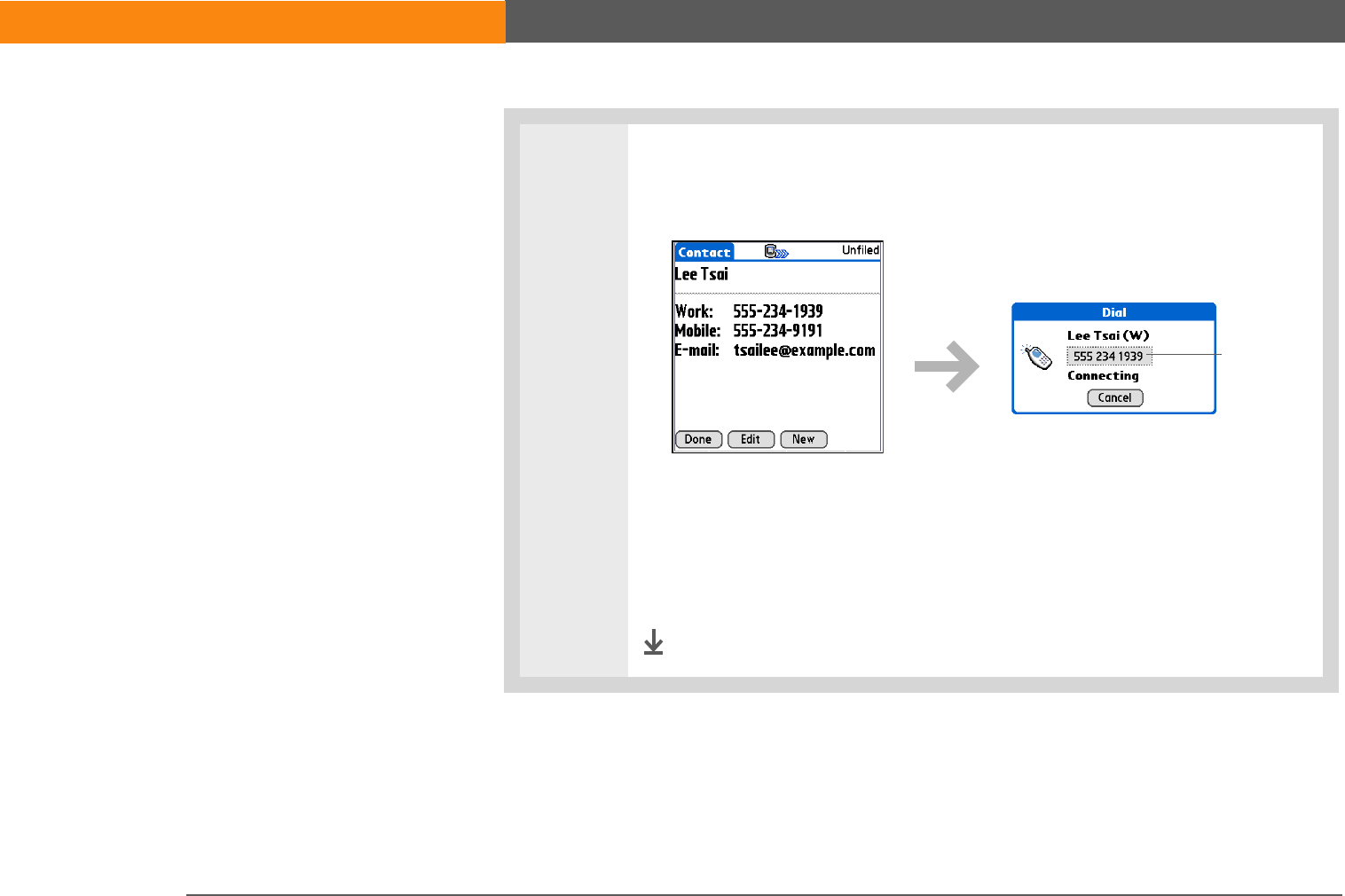
LifeDrive from palmOne 148
CHAPTER 6 Managing Your Contacts
3Make a connection with Tap-to-Connect:
a. Select the contact you want.
b. Select the entry you want to use to connect. For example, to dial a phone
number, select the number you want to dial. To address an email message,
select an email address.
c. Select the entry to edit it if necessary. For example, you might need to add
an area code or country code to a phone number.
Done
Select to edit
SECOND DRAFT palmOne, Inc. Confidential

LifeDrive from palmOne 149
CHAPTER 6 Managing Your Contacts
Working with Contacts on your computer
Use Contacts on your computer to view and manage the contacts you create on your device.
Check out the online Help in Palm®Desktop software to learn how to use Contacts on your
computer. The online Help includes info about the following topics:
• Viewing, copying, and deleting contacts
• Editing contact details
• Marking contacts private
• Showing, masking, and hiding private contacts
• Printing contacts
• Changing between the list, contact info, and Contact Edit views
• Adding notes to a contact
• Adding a date and time stamp to a contact
• Organizing contacts into categories
• Sharing contacts
WINDOWS ONLY
To open Contacts on your computer, double-click the Palm Desktop icon on the Windows desktop,
and then click Contacts on the Launch bar.
MAC ONLY
To open Contacts on your computer, launch Palm Desktop software from the Palm folder, and then
click Addresses.
SECOND DRAFT palmOne, Inc. Confidential

LifeDrive from palmOne 150
CHAPTER 6 Managing Your Contacts
Related topics
Click a link below to learn about these related topics:
Moving
Around
• Opening applications
• Using menus
• Synchronizing with Palm Desktop software and Outlook
Categories Organizing contacts by type and sorting them
Entering
Information
Transferring contact information from other applications such as databases,
spreadsheets, and other organizer software
Privacy Keeping contacts private by turning on security options
Sharing Sending contacts to other Bluetooth devices by using Bluetooth wireless
technology on your device
VersaMail Sending contacts as attachments to email messages
SMS Sending contacts as part of a text message
Tips & Tricks
Make your device uniquely
yours. For great tips,
software, accessories, and
more, visit
www.palmOne.com/
mylifedrive.
Support
If you’re having problems
with Contacts or with
anything else on your device,
go to www.palmOne.com/
support.
SECOND DRAFT palmOne, Inc. Confidential
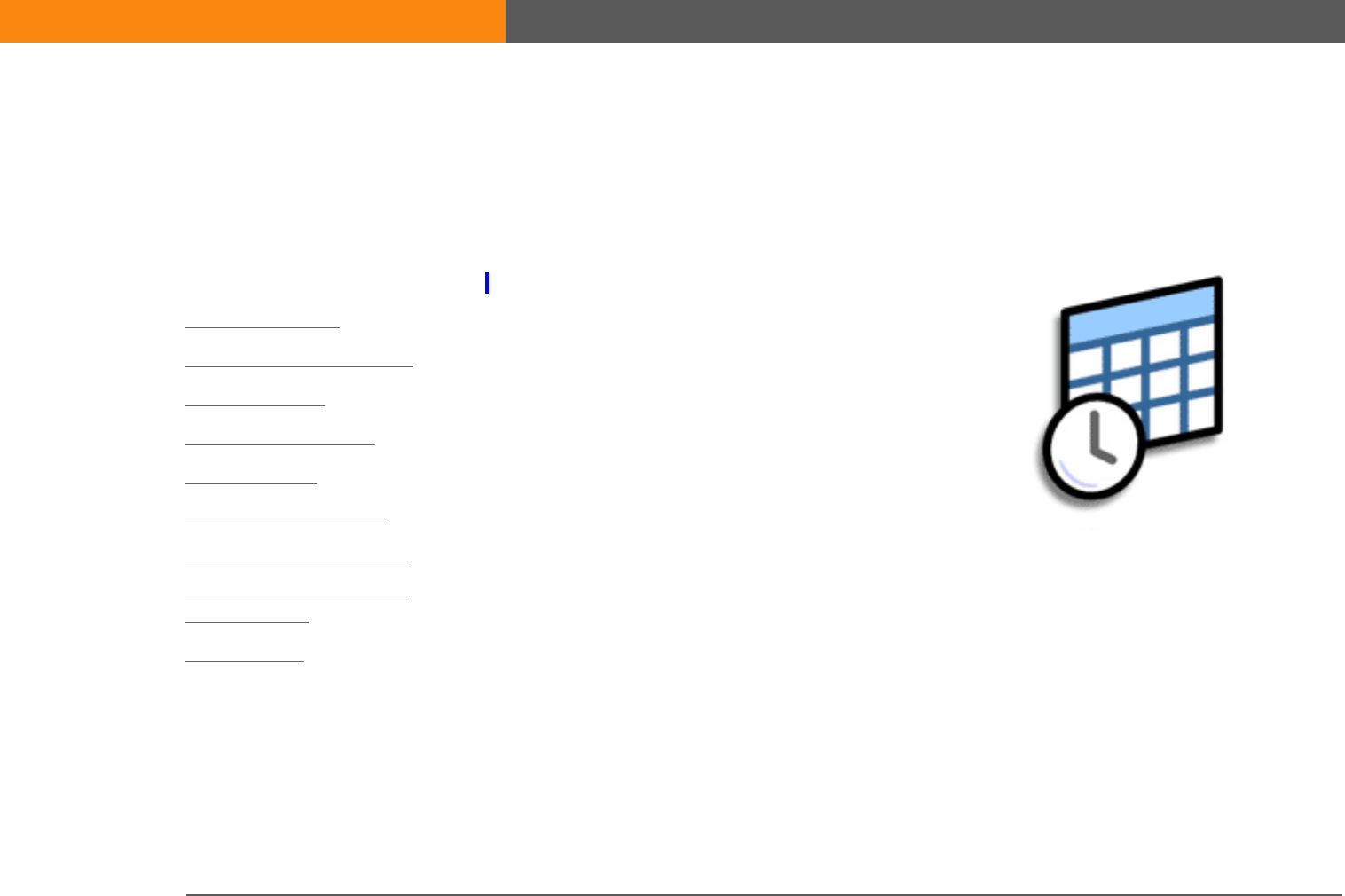
LifeDrive from palmOne 151
CHAPTER 7
Managing Your Calendar
Stay on top of your schedule by
creating appointments, setting alarms,
and spotting conflicts in Calendar. You
can view your calendar by day, week,
or month, or as an agenda list that
combines your list of tasks and email
notifications with your appointments.
Schedule repeating meetings or block
out a vacation by creating one event
set to repeat at an interval you specify.
Color-code your appointments by
category and add notes with helpful
information.
Benefits of Calendar
• Track current, future, and past
appointments
• Stay on top of deadlines
• Set reminders for appointments
• Spot schedule conflicts
I
n t
hi
s c
h
apter
Scheduling events
Color-coding your schedule
Setting an alarm
Rescheduling an event
Deleting events
Checking your schedule
Customizing your calendar
Working with Calendar on
your computer
Related topics
SECOND DRAFT palmOne, Inc. Confidential
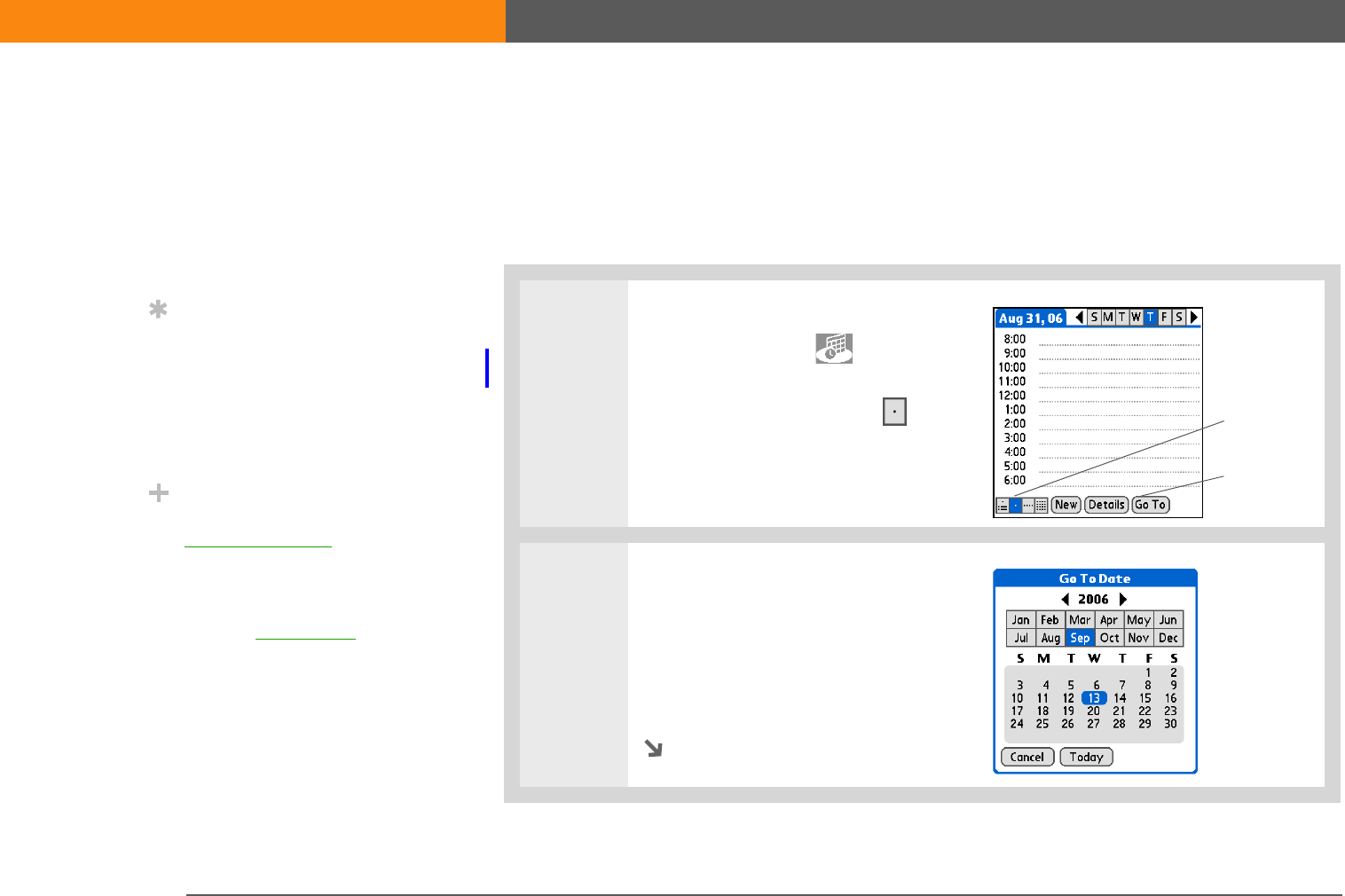
LifeDrive from palmOne 152
CHAPTER 7 Managing Your Calendar
Scheduling events
Use Calendar to manage your schedule. You can enter appointments, events without a start time,
events that repeat at regular intervals, and events that span a period of time.
Scheduling an appointment
0
1Open Day View:
a. Tap the Calendar icon in
the input area.
b. Select the Day View icon .
2[ & ] OPTIONAL If the
appointment is not for today, select
the date of the appointment:
a. Tap Go To.
b. Select the year, month, and date.
Continued
»
Key Term
Event The name for an
entry in the Calendar
application, including
appointments, birthdays,
reminders, recurring
meetings, and so on.
Tip
You can also scroll to a
date by pressing Right or
Left on the 5-way or by
selecting the arrows at
the top of the Day View
screen.
Did You Know?
Calendar info is stored in
program memory. This
means that you can view
the info only by looking at
it in the application and
you can synchronize the
info only by pressing the
sync button on the USB
cable or with Exchange
ActiveSync. Info in
Calendar can be
synchronized with info in
either Palm®Desktop
software or Outlook.
Day View
icon
Go To
SECOND DRAFT palmOne, Inc. Confidential
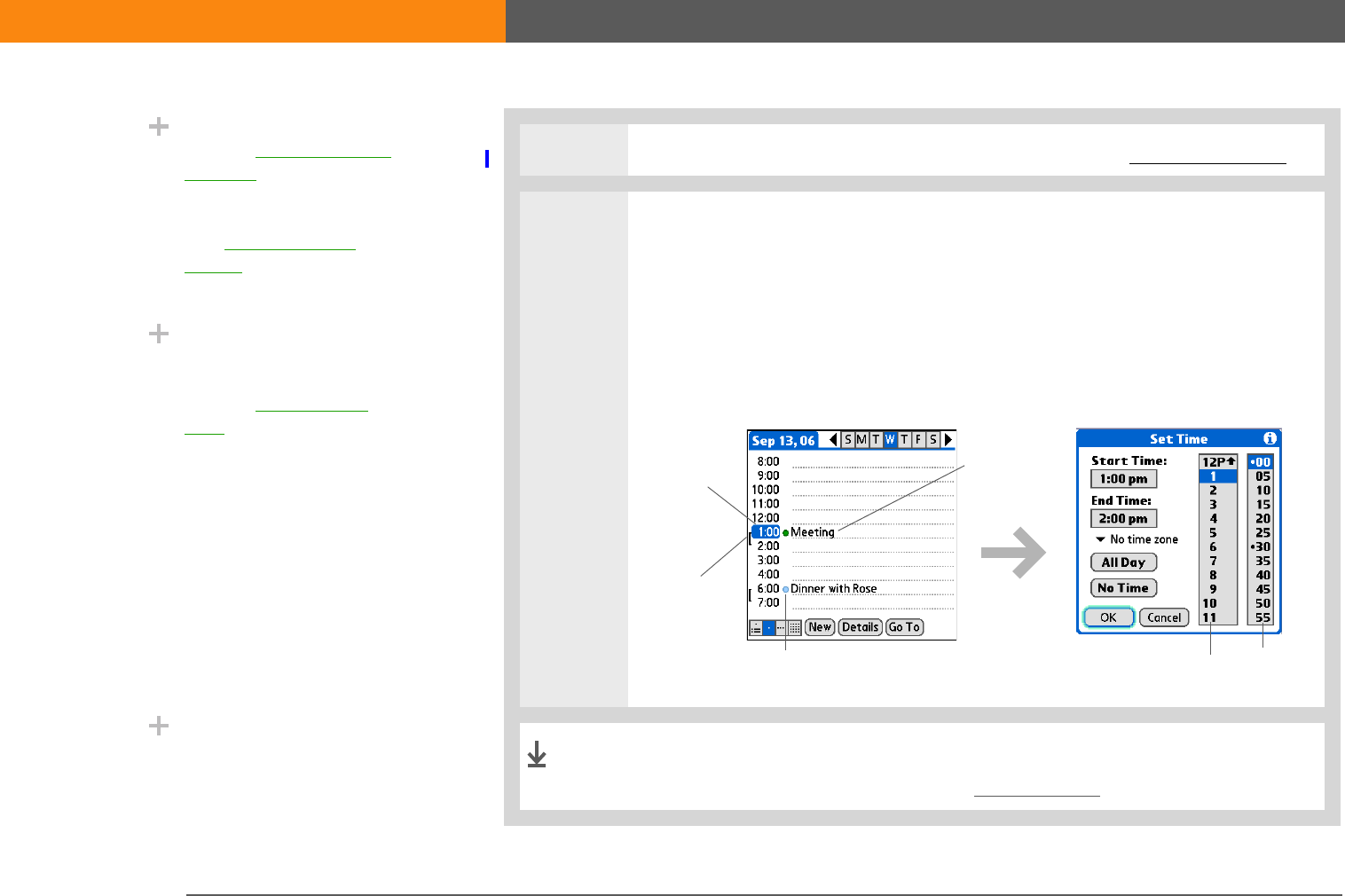
LifeDrive from palmOne 153
CHAPTER 7 Managing Your Calendar
3Tap the line next to the time the appointment begins, and enter a description.
4If the appointment is longer or shorter than an hour, set the duration:
a. In Day View, tap the start time.
b. In the Set Time dialog box, tap End Time.
c. Tap the hour and minute lists to select the time the appointment ends.
d. Select OK.
That’s it. Your device automatically saves the appointment. Make
sure you have a current backup. Synchronize often.
Did You Know?
You can color-code your
calendar to file events in
categories. Each category
has its own color. You can
also mark events as
private to hide them from
prying eyes.
Did You Know?
If you are synchronizing
with Outlook on your PC,
you can select a time
zone when creating a
new event. Also, if you
created appointments in
Outlook that include
more than one person,
these persons’ names
appear when you
synchronize your
computer with your
device. You cannot edit
this information on your
device.
Did You Know?
You can use more than
one line to describe an
appointment.
Hour
list
Minute
list
Duration
Start time Description
Color-coded bullet
Done
SECOND DRAFT palmOne, Inc. Confidential
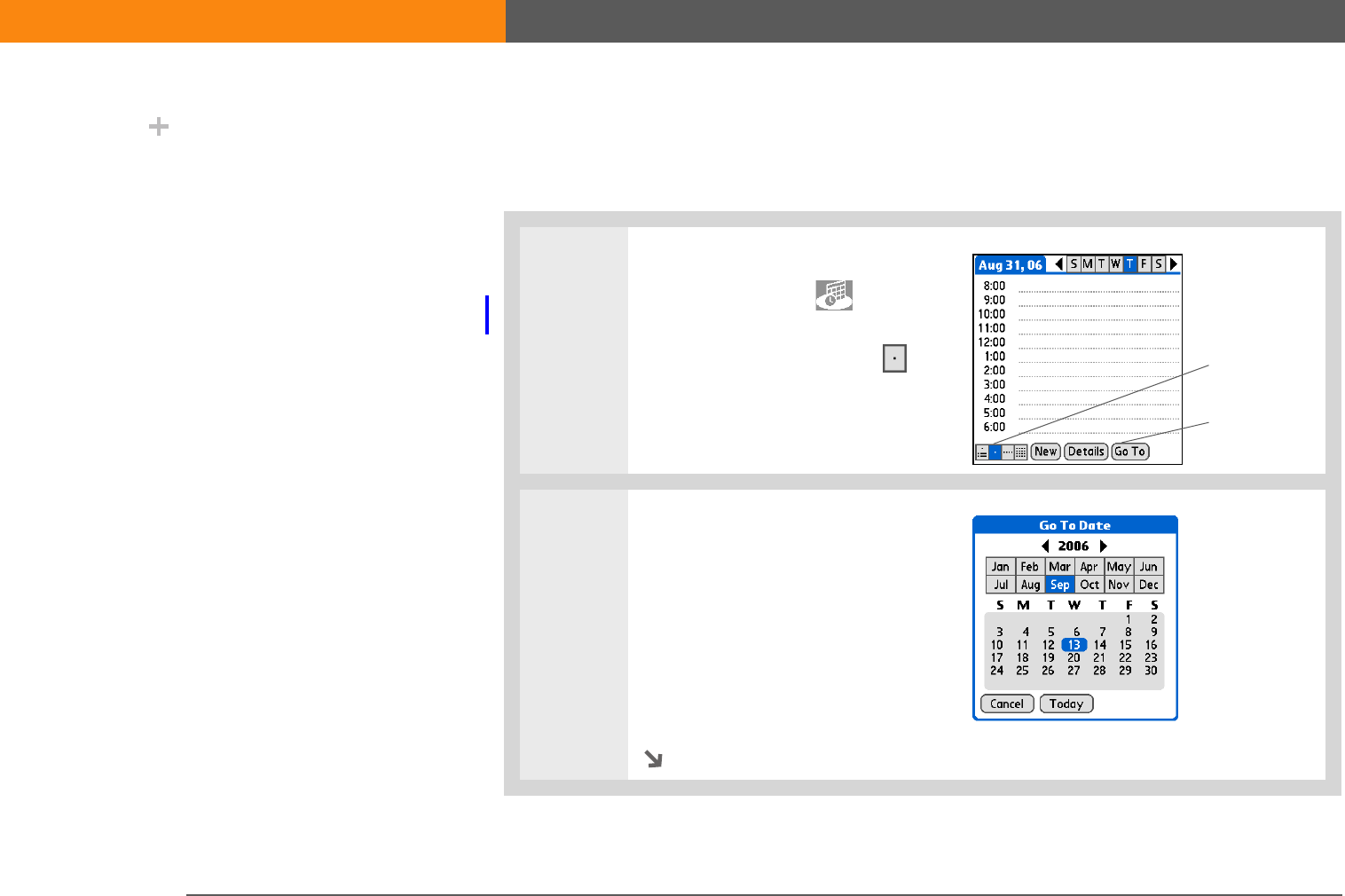
LifeDrive from palmOne 154
CHAPTER 7 Managing Your Calendar
Scheduling an event without a start time
Keep track of events that take place on a particular date but not at a particular time. For example,
you may want to enter holidays, anniversaries, and deadlines.
0
1Open Day View:
a. Tap the Calendar icon in
the input area.
b. Select the Day View icon .
2Select the date of the event:
a. Select Go To.
b. Select the arrows to select the
year.
c. Select the month.
d. Select the date.
Continued
Did You Know?
Need to reserve a date
before you know the
details of the
appointment? Schedule
an event without a start
time.
Day View icon
Go To
SECOND DRAFT palmOne, Inc. Confidential
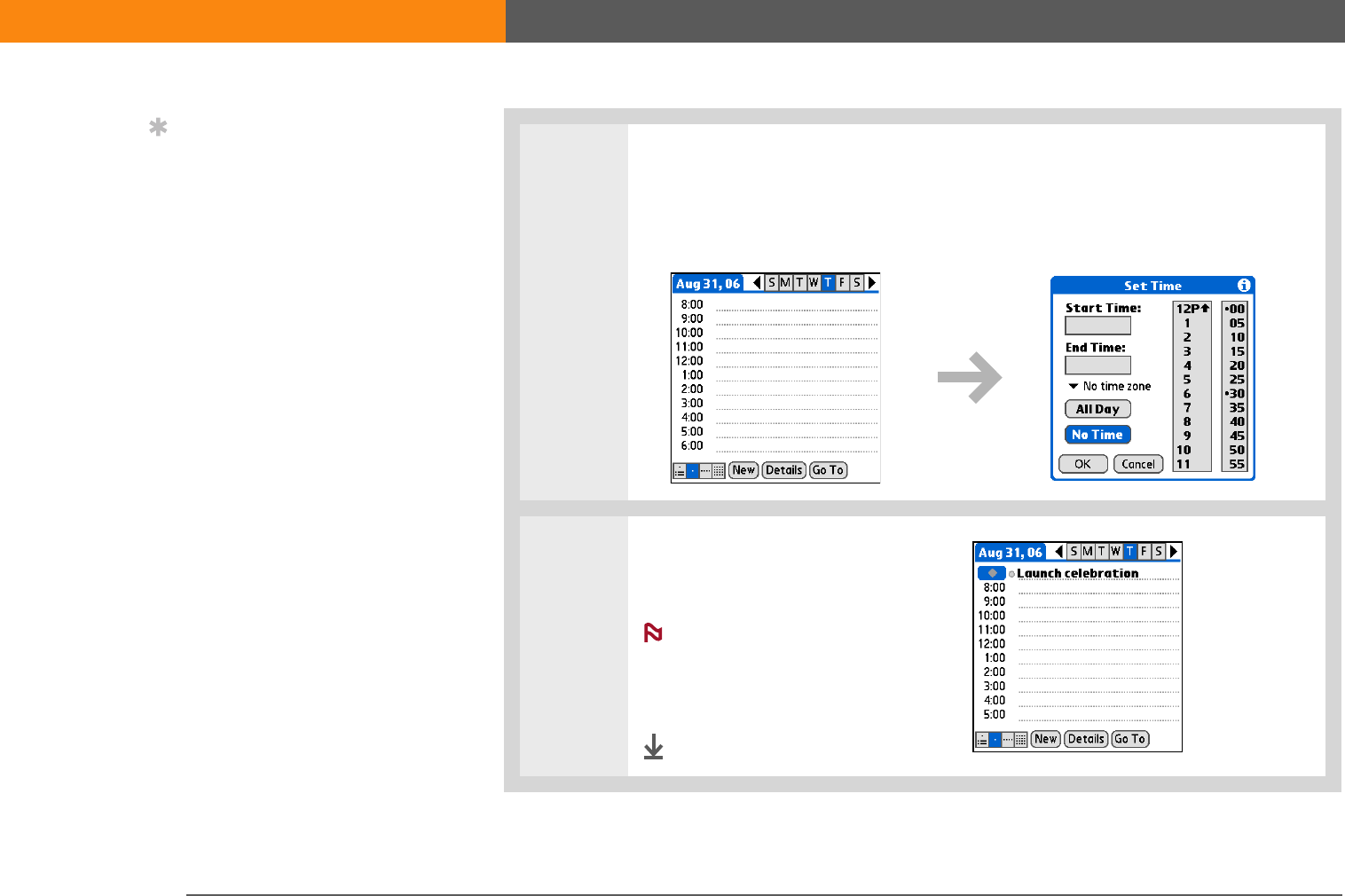
LifeDrive from palmOne 155
CHAPTER 7 Managing Your Calendar
3Add an unscheduled event line:
a. Select New.
b. Select No Time.
4Enter a description on the line
that appears at the top of the
screen.
A diamond appears in
the time column to show that the
event doesn’t start at a specific
time.
Done
Tip
You can change an event
without a time to a
scheduled appointment.
Select the event
description, select
Details, select the Time
box, and select the start
and end times.
NOTE
SECOND DRAFT palmOne, Inc. Confidential
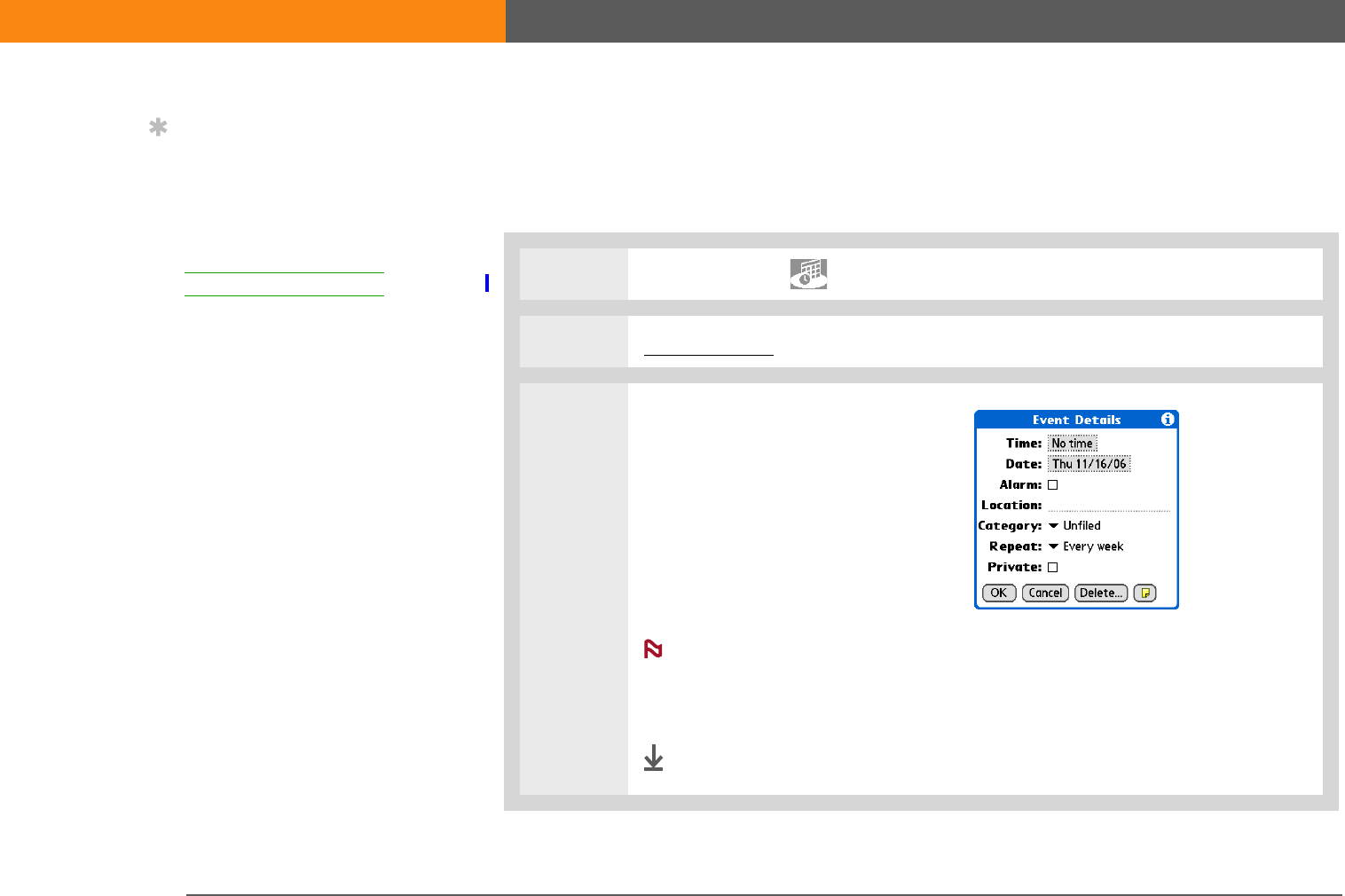
LifeDrive from palmOne 156
CHAPTER 7 Managing Your Calendar
Scheduling a repeating event—standard interval
There’s no need to re-enter events that take place on a regular basis. Just set up a repeating event.
This is a great way to block out time for things like a daily walk with the dog, a weekly team
meeting, a monthly game night with friends, and annual events like anniversaries and holidays.
0
1Tap the Calendar icon in the input area.
2Enter the event you want to repeat, and then select the event description.
3Set the repeat interval:
a. Select Details.
b. Select the Repeat pick list and
select how often the event
repeats: Daily until, Every week,
Every other week, Every month,
or Every year.
If you select Daily, a dialog box appears for you to select the end
date.
c. Select OK.
Done
Tip
To select intervals such as
the 2nd Tuesday of every
month or the 3rd
Thursday in November of
every year, see
Scheduling a repeating
event—unusual interval.
NOTE
SECOND DRAFT palmOne, Inc. Confidential
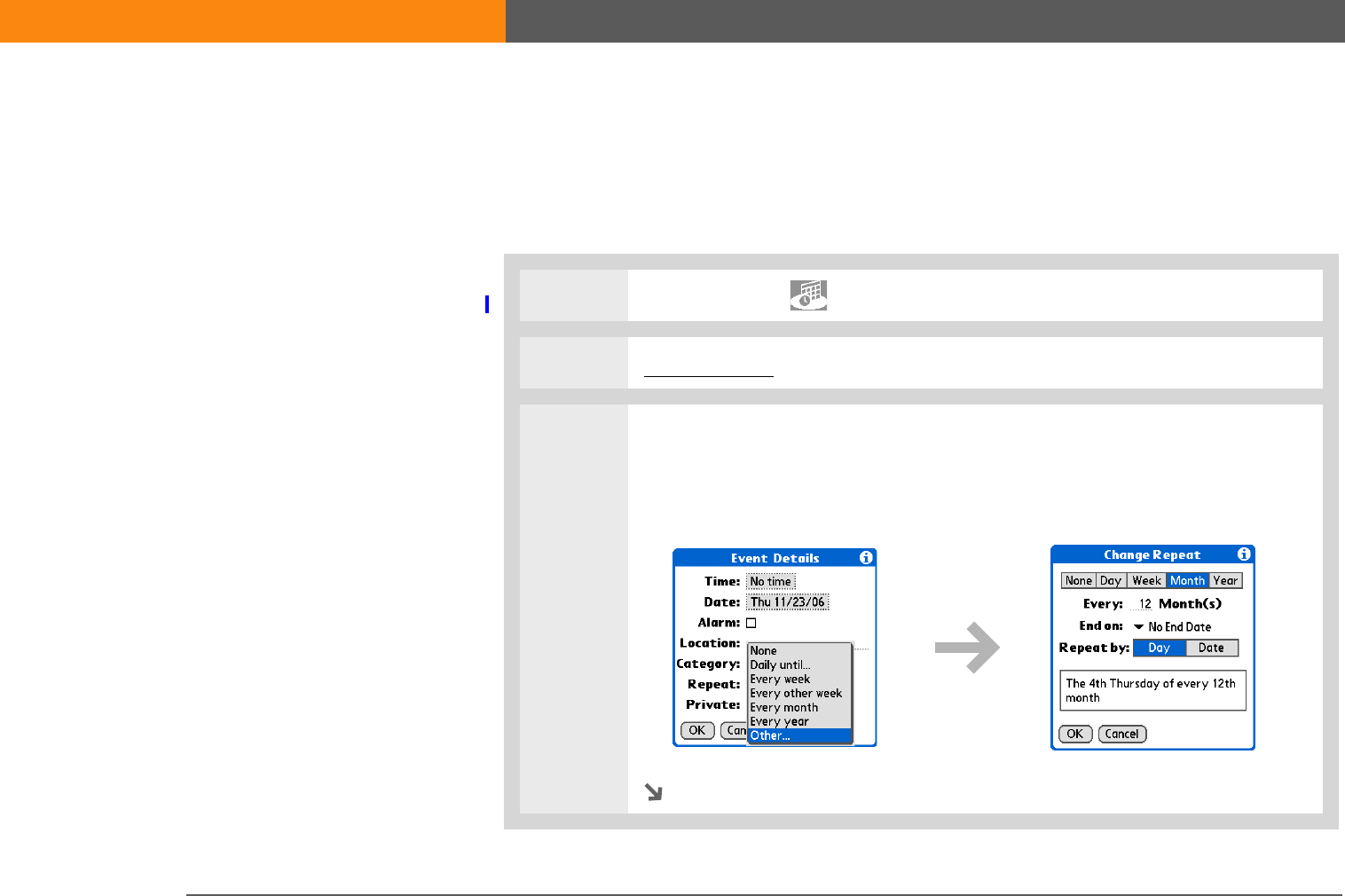
LifeDrive from palmOne 157
CHAPTER 7 Managing Your Calendar
Scheduling a repeating event—unusual interval
Some events don’t fit neatly into the preset repeat intervals, so you need to set up your own
repeat intervals. For example, set aside time for a trip to the gym every other day, schedule a class
that meets on the 1st Wednesday of each month, or enter annual holidays that occur during a
particular time of month such as the 1st Monday in September or the 3rd week of November.
0
1Tap the Calendar icon in the input area.
2Enter the event you want to repeat, and then select the event description.
3Open the Change Repeat dialog box:
a. Select Details.
b. Select the Repeat pick list and select Other.
Continued
SECOND DRAFT palmOne, Inc. Confidential
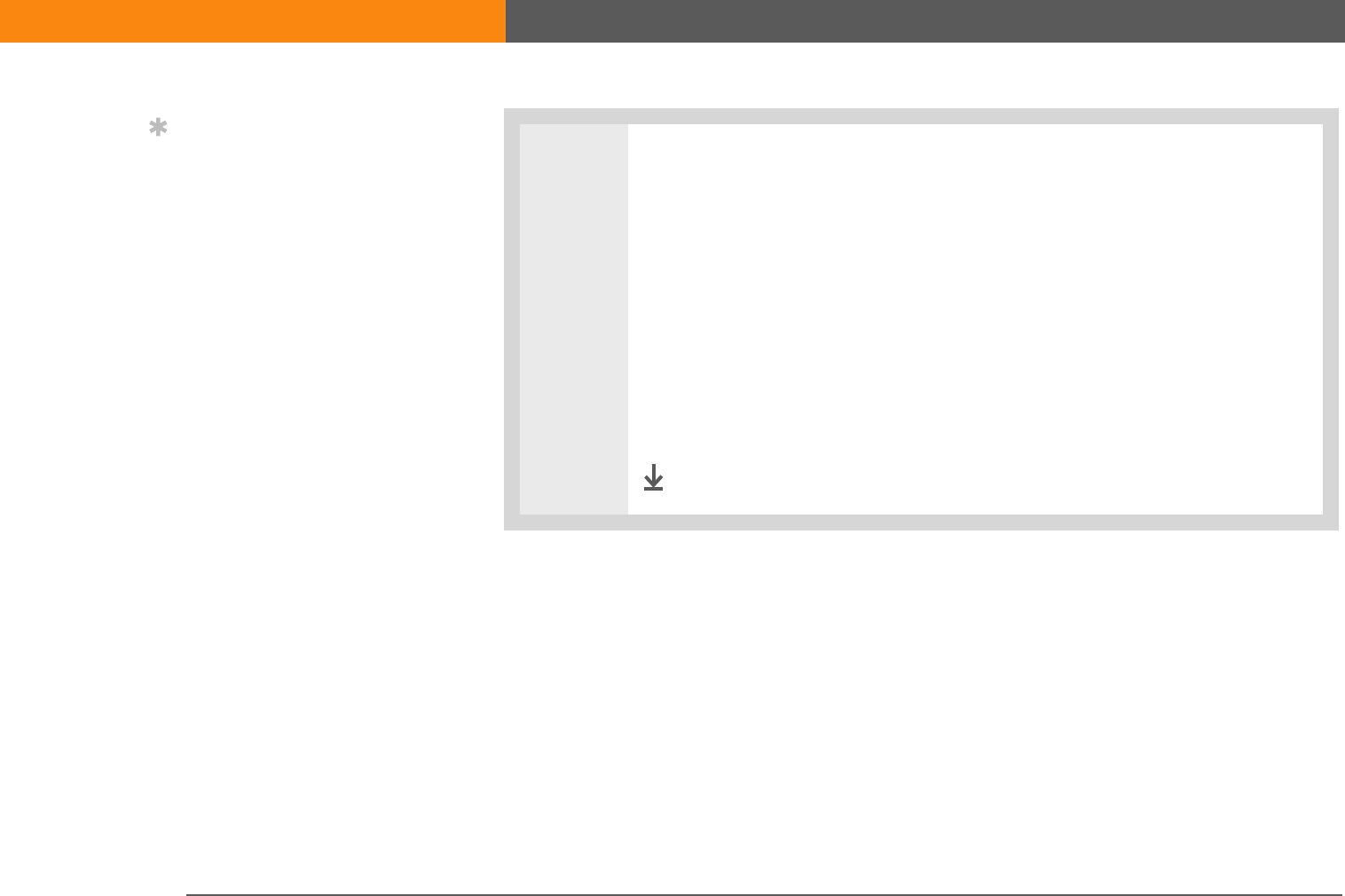
LifeDrive from palmOne 158
CHAPTER 7 Managing Your Calendar
4Set the repeat interval:
a. Select Day, Week, Month, or Year as the repeat unit.
b. Select the Every line and enter the frequency at which the event repeats.
c. Select the End on pick list and select an end date, if needed.
d. If you selected Week in step c, select the day of the week the event repeats. If
you selected Month in step c, select Day to select the week within the month,
such as the 4th Thursday, or select Date to select the same date within the
month, such as the 15th.
e. Select OK.
Done
Tip
To enter holidays such as
Labor Day, select Month,
enter 12 on the Every line,
and then select Day as the
Repeat By setting.
SECOND DRAFT palmOne, Inc. Confidential
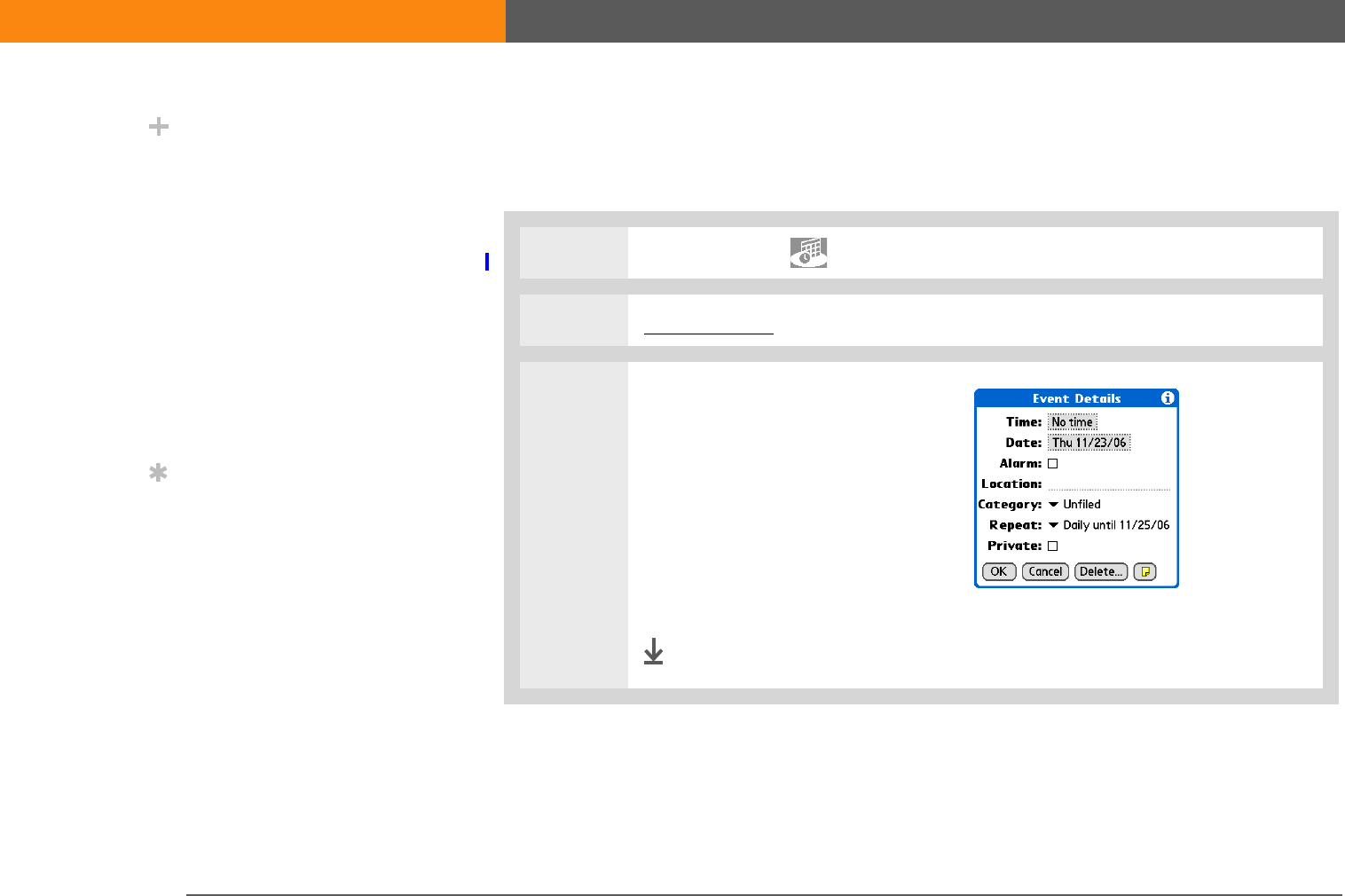
LifeDrive from palmOne 159
CHAPTER 7 Managing Your Calendar
Scheduling an event that is longer than a day
Reserve a block of time for events that span several days such as a vacation, conference, training
class, or an extended project.
0
1Tap the Calendar icon in the input area.
2Enter the event, and then select the event description.
3Set the repeat interval:
a. Select Details.
b. Select the Repeat pick list and
select Daily until.
c. Select the year, month, and date
when the event ends.
d. Select OK.
Done
Did You Know?
Reserve a specific block
of time during the day or
use events without times
to flag a series of dates.
For example, you can
reserve vacation time
from 6/23—6/30 using a
repeating event without a
time, and then schedule a
specific excursion from
9:00 to 3:00 on 6/24 and
dinner with a friend at
6:00 on 6/25.
Tip
Need to enter an event
that extends beyond
midnight? Enter an end
time that is earlier than
the start time.
SECOND DRAFT palmOne, Inc. Confidential
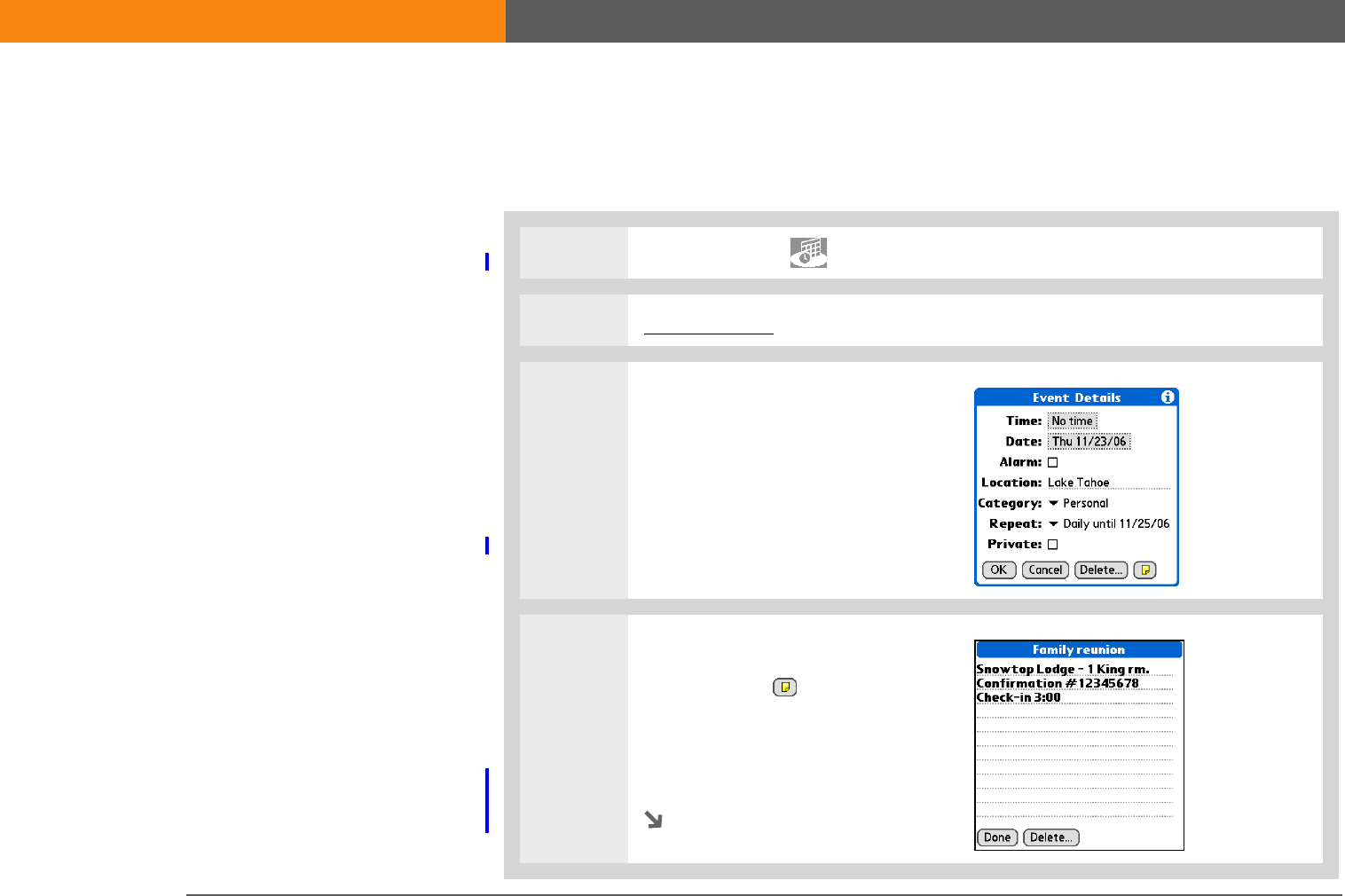
LifeDrive from palmOne 160
CHAPTER 7 Managing Your Calendar
Entering a location or a note for an event
Enter a description of the event’s location such as a restaurant, a conference room, or your friend’s
house. Enter a note such as dial-in info for a conference call or directions to a location.
0
1Tap the Calendar icon in the input area.
2Enter the event, and then select the event description.
3[ & ] OPTIONAL Enter the
location:
a. Select Details.
b. Select the Location field and
enter a description of the
location.
4[ & ] OPTIONAL Enter the note:
a. Select Note .
b. Enter the note text.
c. Select Done.
Continued
SECOND DRAFT palmOne, Inc. Confidential
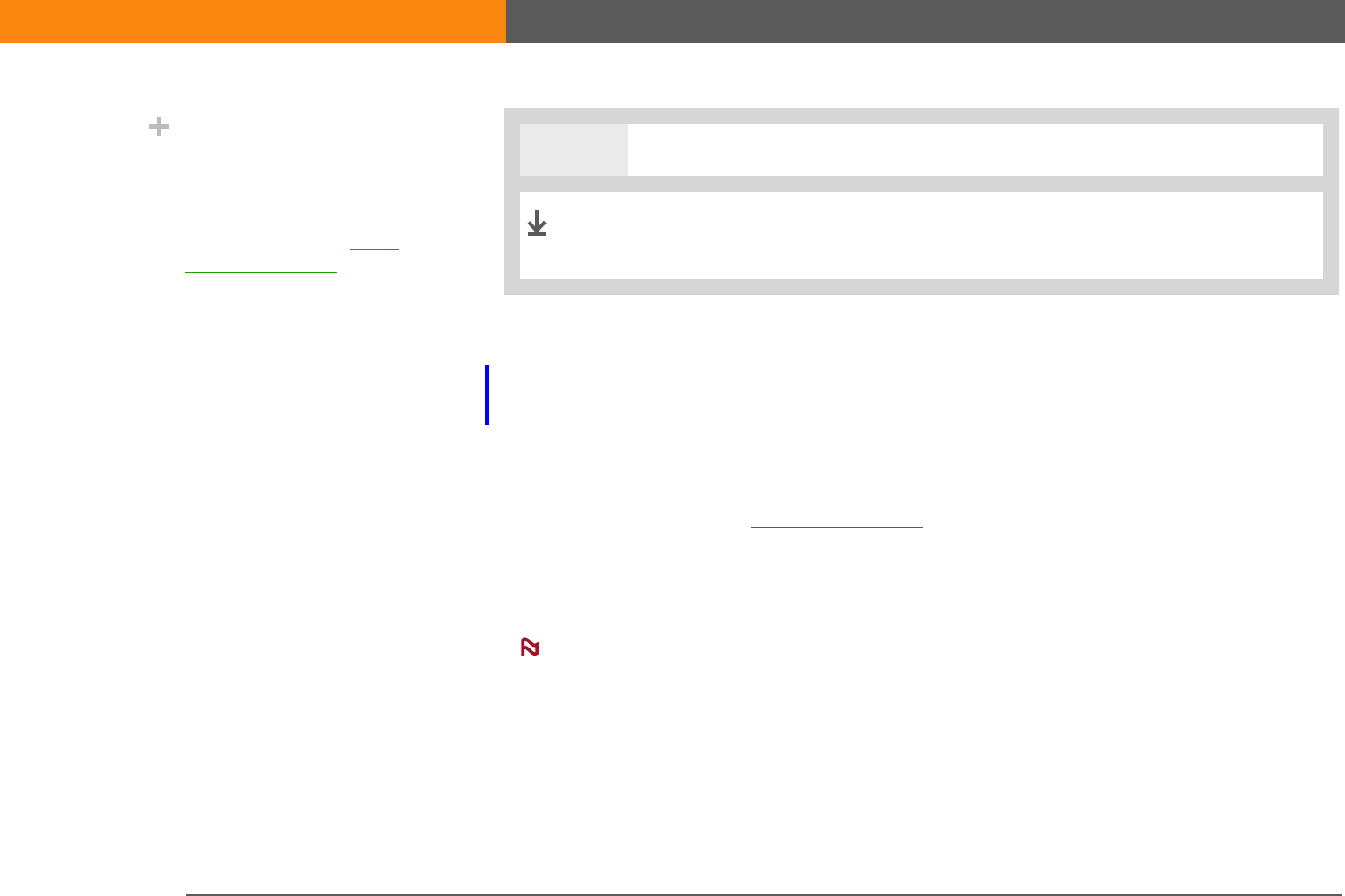
LifeDrive from palmOne 161
CHAPTER 7 Managing Your Calendar
Scheduling an event with a time zone
Do not use times zones if you are synchronizing with Palm®Desktop
software. Time zones work only if you are synchronizing with Outlook or Exchange ActiveSync.
Palm Desktop software does not recognize time zones.
Selecting a time zone when creating a new event allows you to travel and have your events
automatically adjust to the time zone in your new location. When you schedule an event, set the
time zone and time the event occurs in the location of the event. The event automatically adjusts
on your schedule based on the primary location you have set on your device.
When you travel, you can change the primary location on your device and the event automatically
adjusts on your schedule to the correct time according to the time zone of the new primary
location.
Only events that have a time zone setting adjust when you change the primary time
zone on your device. Events that do not have a time zone setting remain at their set time.
5Select OK.
The location name and a note icon appear next to the event
description in the Agenda View and in the Day View.
Done
IMPORTANT
[!]
Did You Know?
You can also set a
preference to
automatically include a
time zone whenever you
create a new event. Open
the Options menu and
select Preferences. Select
New events use time
zones. Only new events
created after the
preference is set are
affected.
NOTE
SECOND DRAFT palmOne, Inc. Confidential
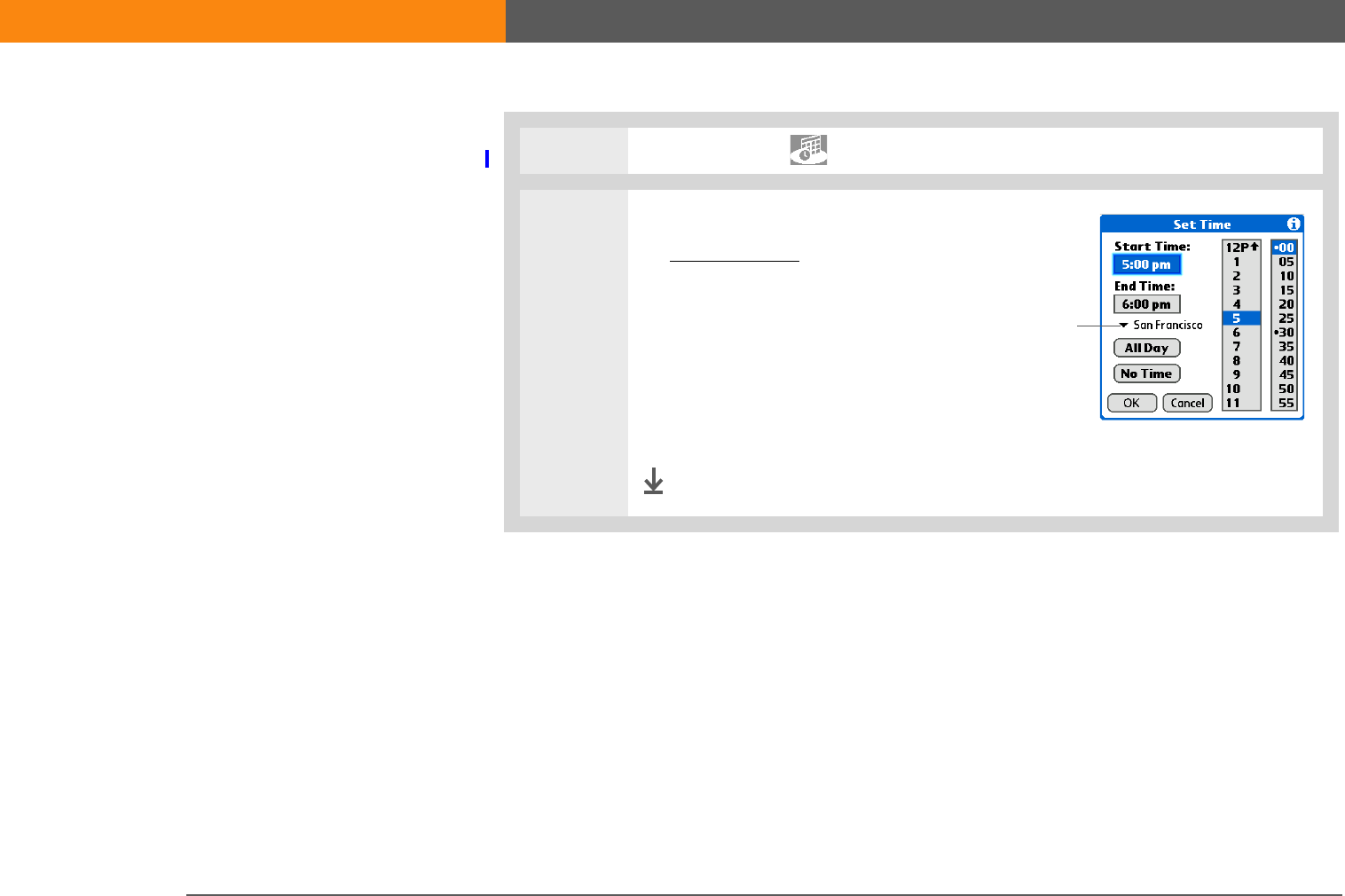
LifeDrive from palmOne 162
CHAPTER 7 Managing Your Calendar
0
1Tap the Calendar icon in the input area.
2Set the time and the time zone:
a. Enter the event.
b. Set the time for the event as it is
scheduled at the location where it
occurs.
c. Select the time zone pick list and
select a city within the time zone that
the event is located.
d. Select OK.
Done
Time zone
pick list
SECOND DRAFT palmOne, Inc. Confidential
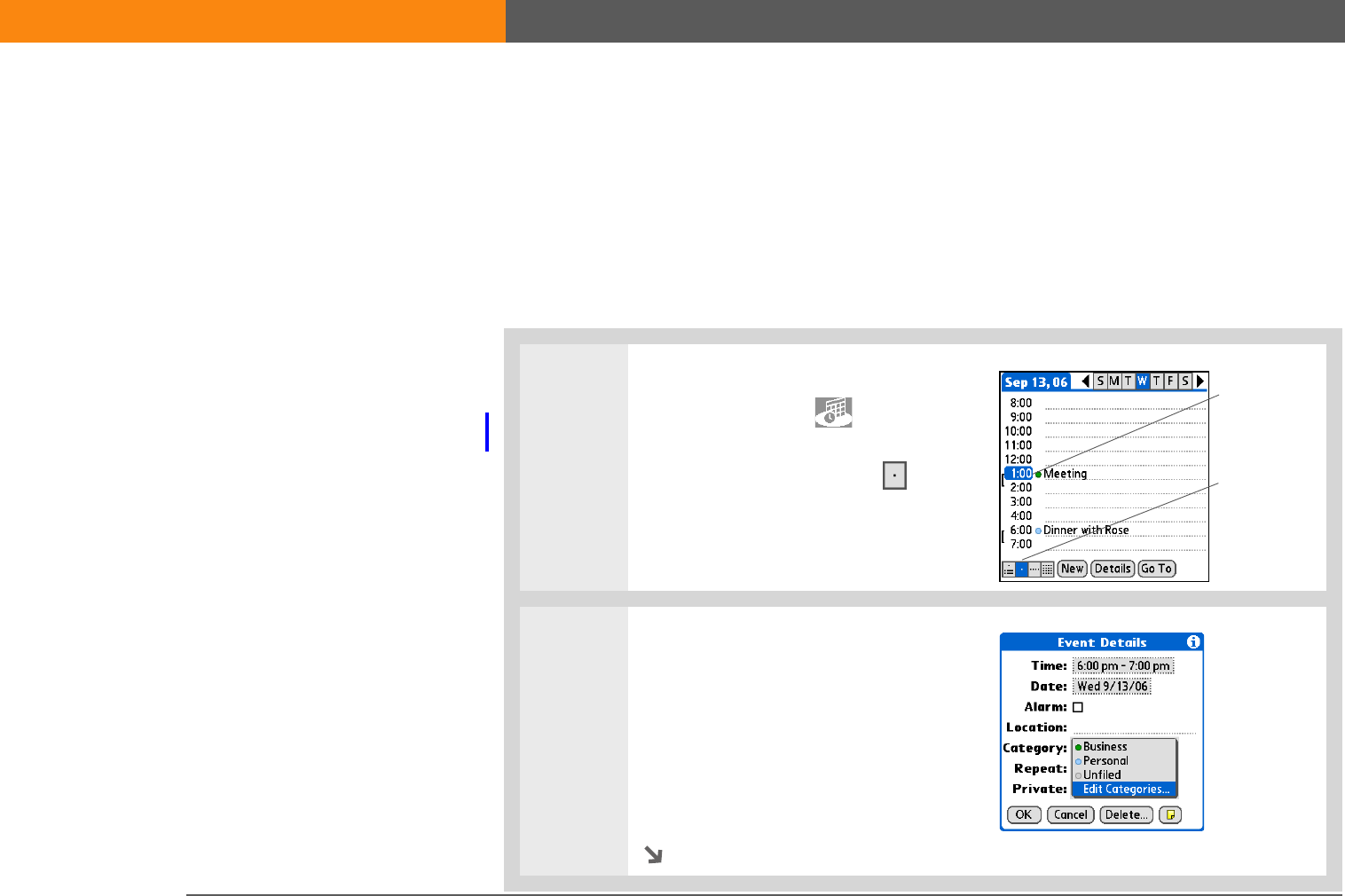
LifeDrive from palmOne 163
CHAPTER 7 Managing Your Calendar
Color-coding your schedule
Use color-coding to quickly spot different types of events. For example, make all your family
appointments green, your work appointments blue, and your appointments with friends yellow.
Managing your color-codes
Each color-code represents a category of events. You can assign each category a name and select
which color you want to assign to it.
0
1Open Day View:
a. Tap the Calendar icon in the
input area.
b. Select the Day View icon
2Open the Edit Categories dialog box:
a. From Day View, select the event
description.
b. Select Details.
c. Select the Category pick list and
select Edit Categories.
Continued
Day View icon
Category
marker
SECOND DRAFT palmOne, Inc. Confidential
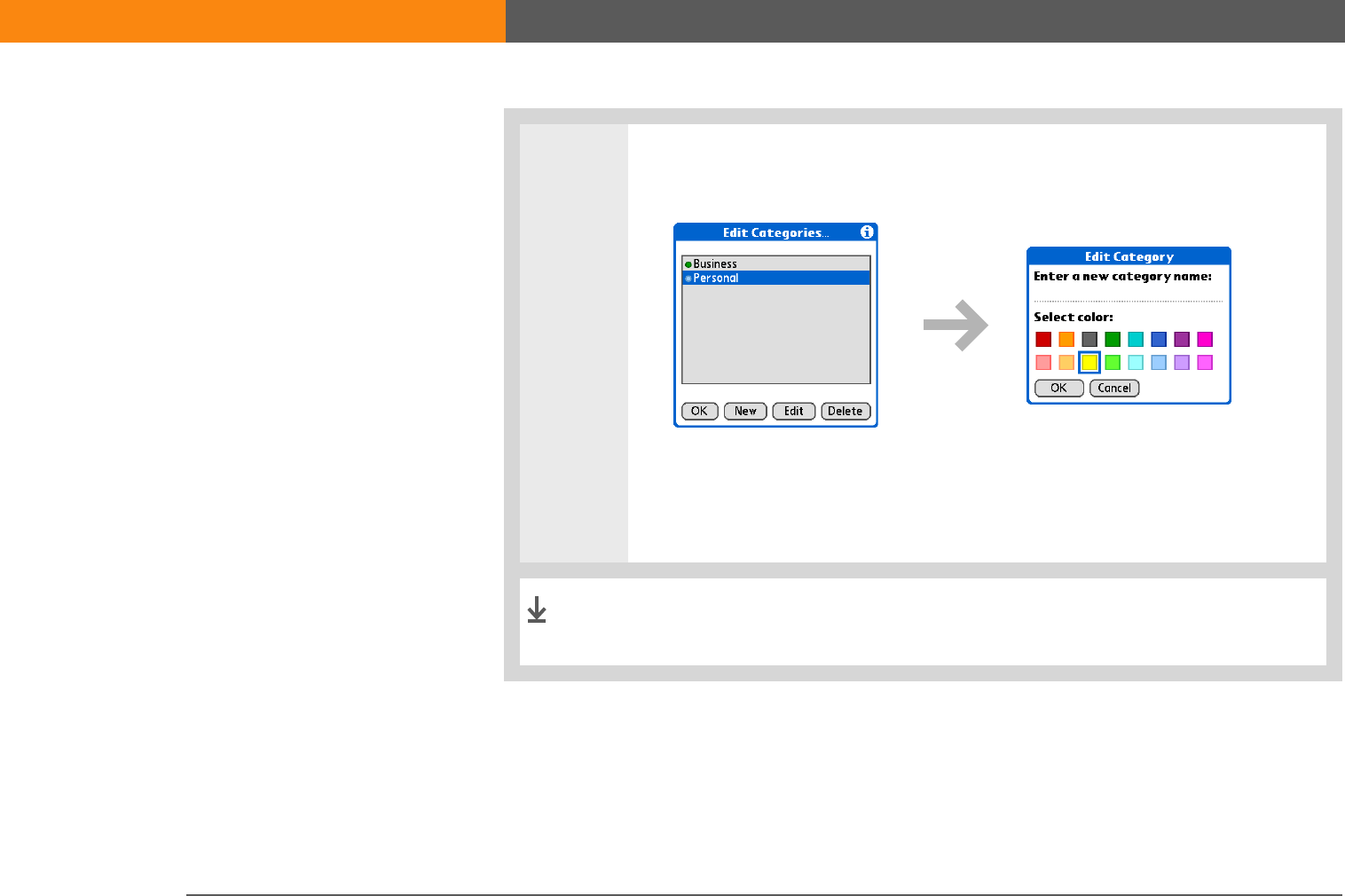
LifeDrive from palmOne 164
CHAPTER 7 Managing Your Calendar
3Select the color-code for the category:
a. Select New or select a category, and then select Edit.
b. Enter or edit the category name.
c. Select the color you want to give this category.
d. Select OK, and then select OK two more times.
The category name and its color-coded marker appear on the
category list.
Done
SECOND DRAFT palmOne, Inc. Confidential
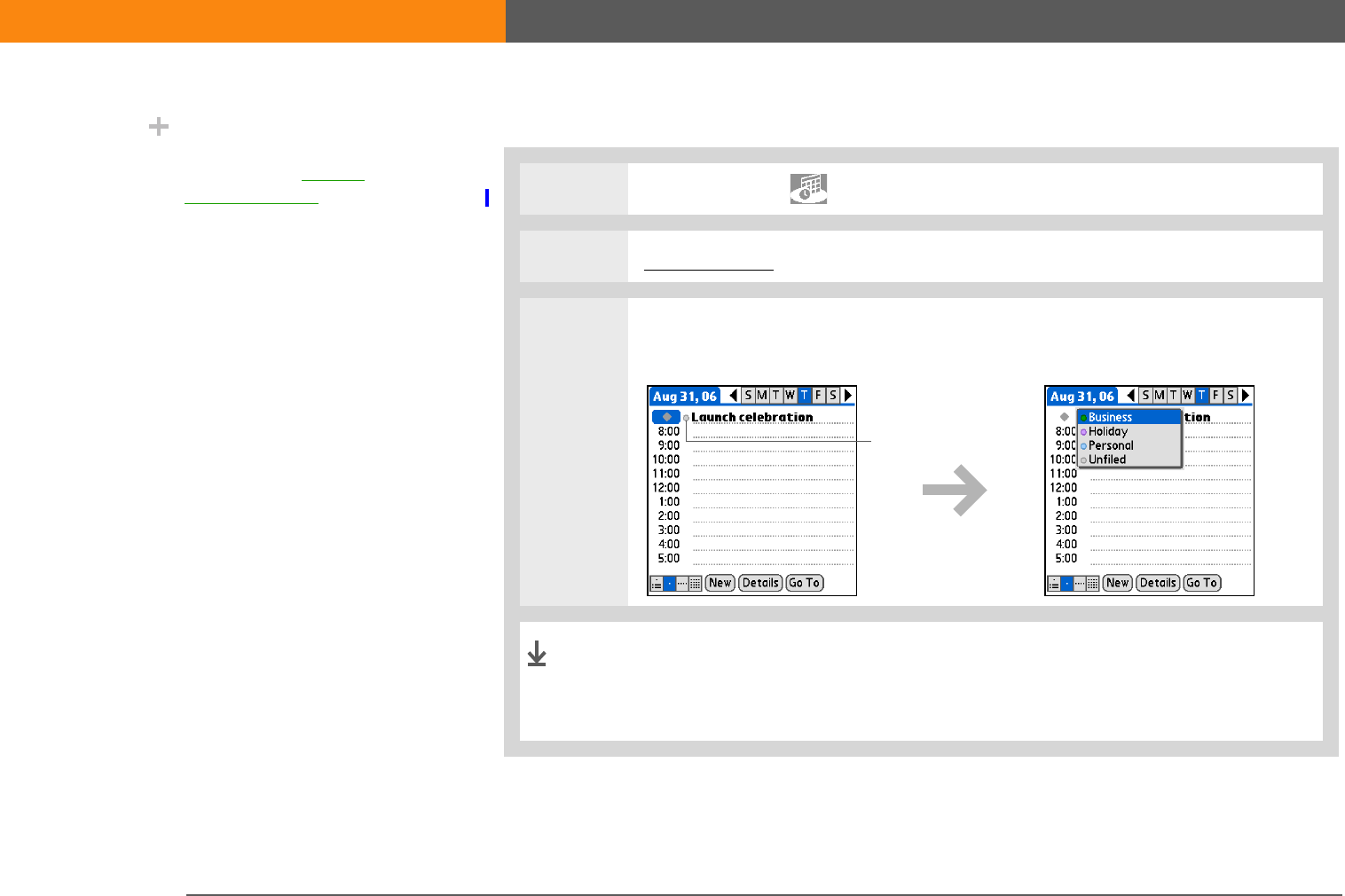
LifeDrive from palmOne 165
CHAPTER 7 Managing Your Calendar
Assigning a color-code to an event
0
1Tap the Calendar icon in the input area.
2Enter the event you want to color-code.
3Select the category marker next to the description, and then select a category
from the list.
In Agenda View and Day View the category marker next to the
event is color-coded. In Week View and Month View the symbol
for the event is color-coded.
Did You Know?
In Day View and Month
View you can set the
Display Options to show
the category list so that
you can view all your
events or just the events
for a single color-code.
Category
marker
Done
SECOND DRAFT palmOne, Inc. Confidential
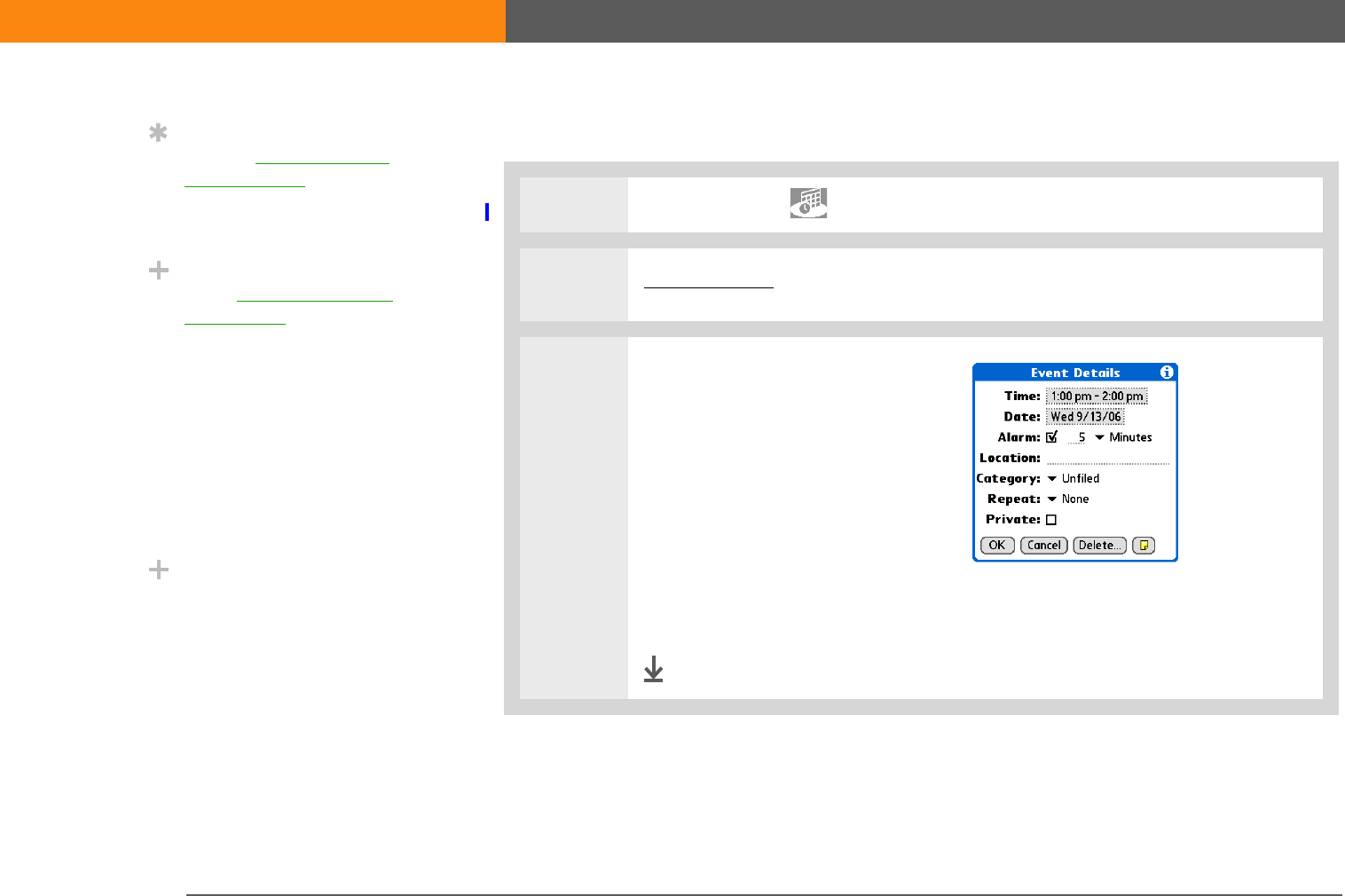
LifeDrive from palmOne 166
CHAPTER 7 Managing Your Calendar
Setting an alarm
0
1Tap the Calendar icon in the input area.
2Enter the event you want to assign an alarm to, and then select the event
description.
3Set the alarm:
a. Select Details.
b. Check the Alarm box.
c. Select the pick list and select
Minutes, Hours, or Days.
d. Enter how many minutes,
hours, or days before the
event you want the alarm to
sound, and then select OK.
Done
Tip
You can customize your
alarm settings in the
Calendar Preferences
dialog box.
Did You Know?
If you set your alarms in
World Clock instead of
Calendar, you have
different alarm sound
choices. Keep in mind
that since World Clock
alarms aren’t tied to a
specific event, you won’t
see an event description
when a World Clock alarm
sounds.
Did You Know?
When you set an alarm, a
little alarm clock appears
to the right of the event
description.
SECOND DRAFT palmOne, Inc. Confidential
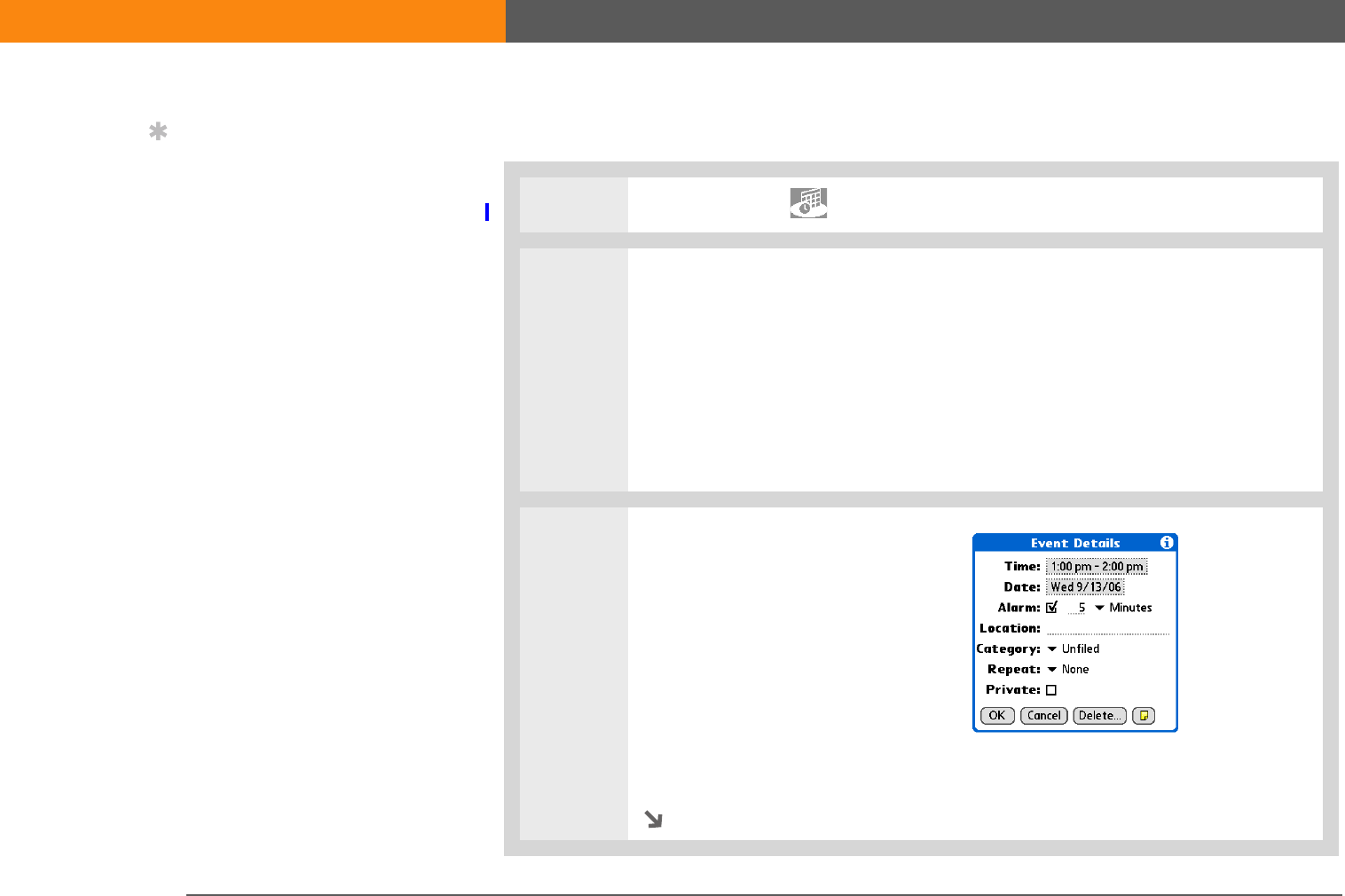
LifeDrive from palmOne 167
CHAPTER 7 Managing Your Calendar
Rescheduling an event
0
1Tap the Calendar icon in the input area.
2Go to the event you want to reschedule:
a. From Day View, select Go To.
b. Select the year, month, and date of the event.
c. Select the event description, and edit it if necessary.
If you edit the description of a repeating event, the new
description appears in all instances of the event.
3Change the date and time:
a. Select Details.
b. Select the Time box and
select the new start and end
times.
c. Select the Date box and select
the new date.
d. Select OK.
Continued
Tip
You can also use the
Event Details dialog box
to change the alarm,
location, category, repeat,
and privacy settings.
IMPORTANT
[!]
SECOND DRAFT palmOne, Inc. Confidential
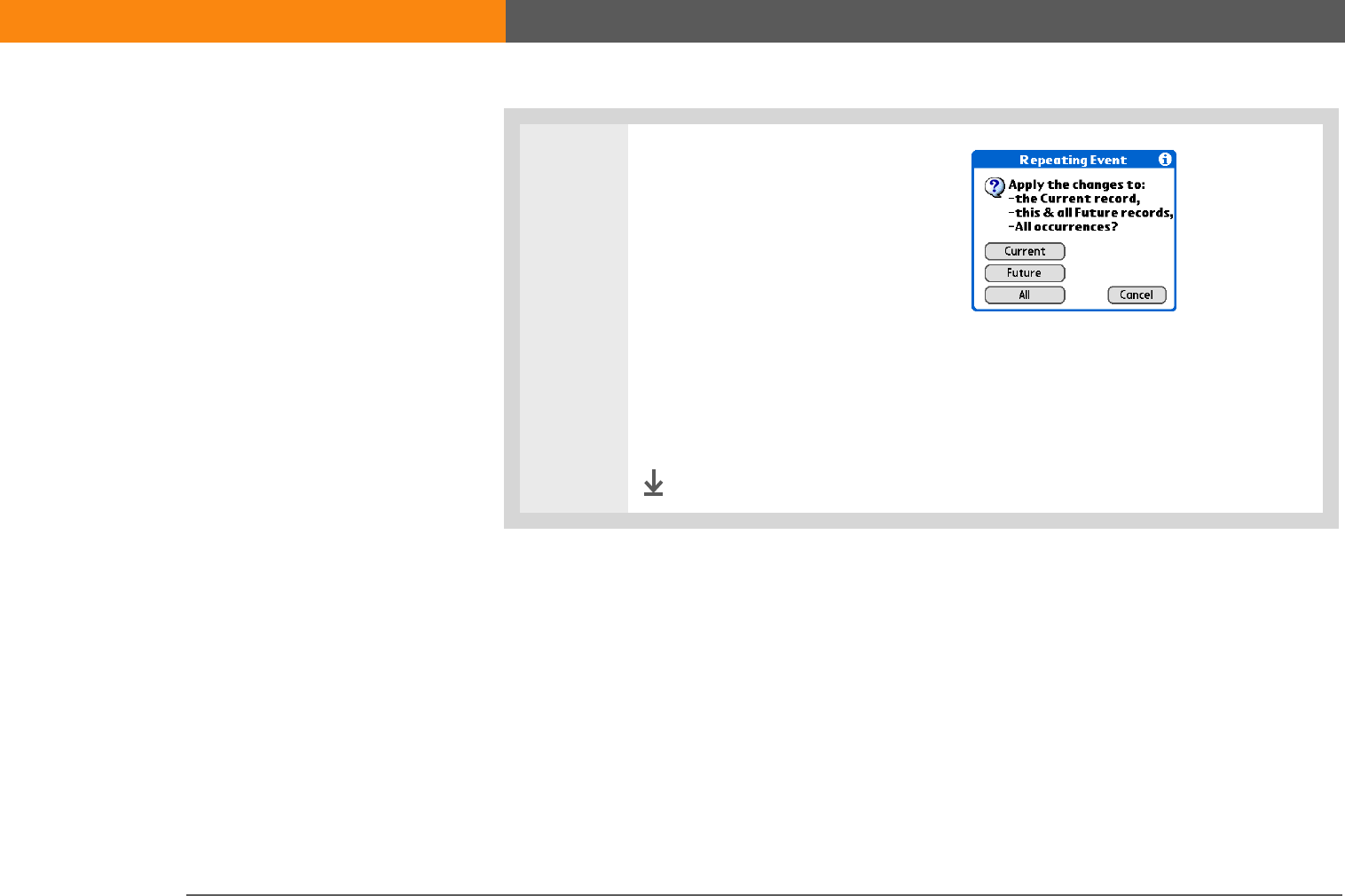
LifeDrive from palmOne 168
CHAPTER 7 Managing Your Calendar
4If you’re changing a repeating
event, select one of the following
to select the event(s) you want to
apply the changes to:
Current Apply your changes to
only the selected instance of the
repeating event.
Future Apply your changes to the selected event and all instances of the
repeating event that occur at a later date.
All Apply your changes to the selected event and all past and future instances
of the repeating event.
Done
SECOND DRAFT palmOne, Inc. Confidential
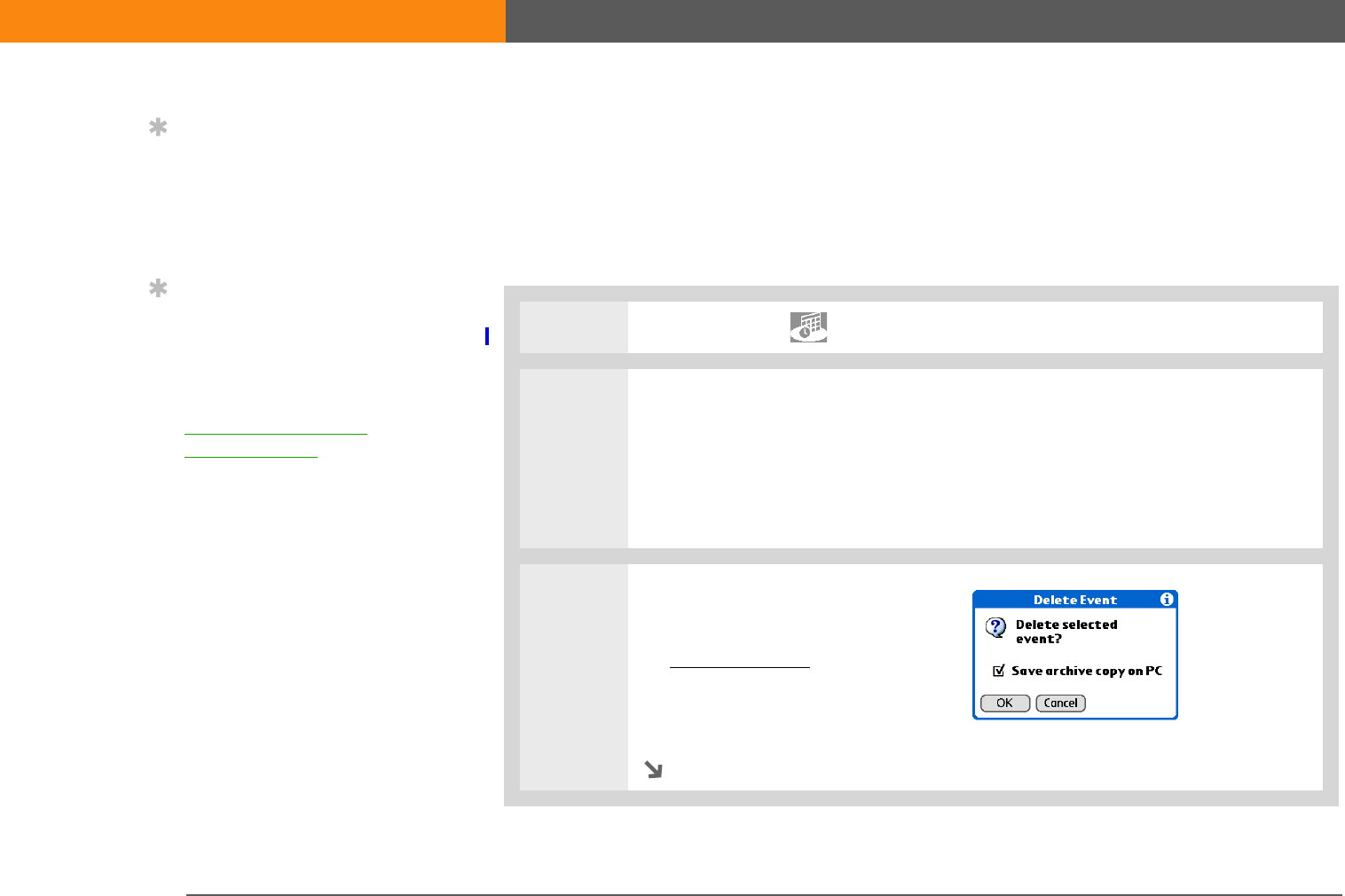
LifeDrive from palmOne 169
CHAPTER 7 Managing Your Calendar
Deleting events
If an appointment is cancelled, you can delete it from your schedule. When deleting a repeating
event, you can indicate you want to delete just the selected event, or to include other instances of
the event. You can also delete all your old events that are before a selected time frame.
Deleting a specific event
0
1Tap the Calendar icon in the input area.
2Go to the event you want to delete:
a. From Day View, select Go To.
b. Select the year, month, and date of the event.
c. Select the event description.
3Open the Delete Event dialog
box:
a. Open the menus.
b. Select Delete Event on the
Record menu.
Continued
Tip
You can also delete a
specific event by
selecting the event,
selecting Details, and
then selecting Delete.
Tip
Many people find it useful
to refer to old events for
tax purposes. If you save
an archive copy of your
deleted events, you can
refer to them later by
importing them.
SECOND DRAFT palmOne, Inc. Confidential
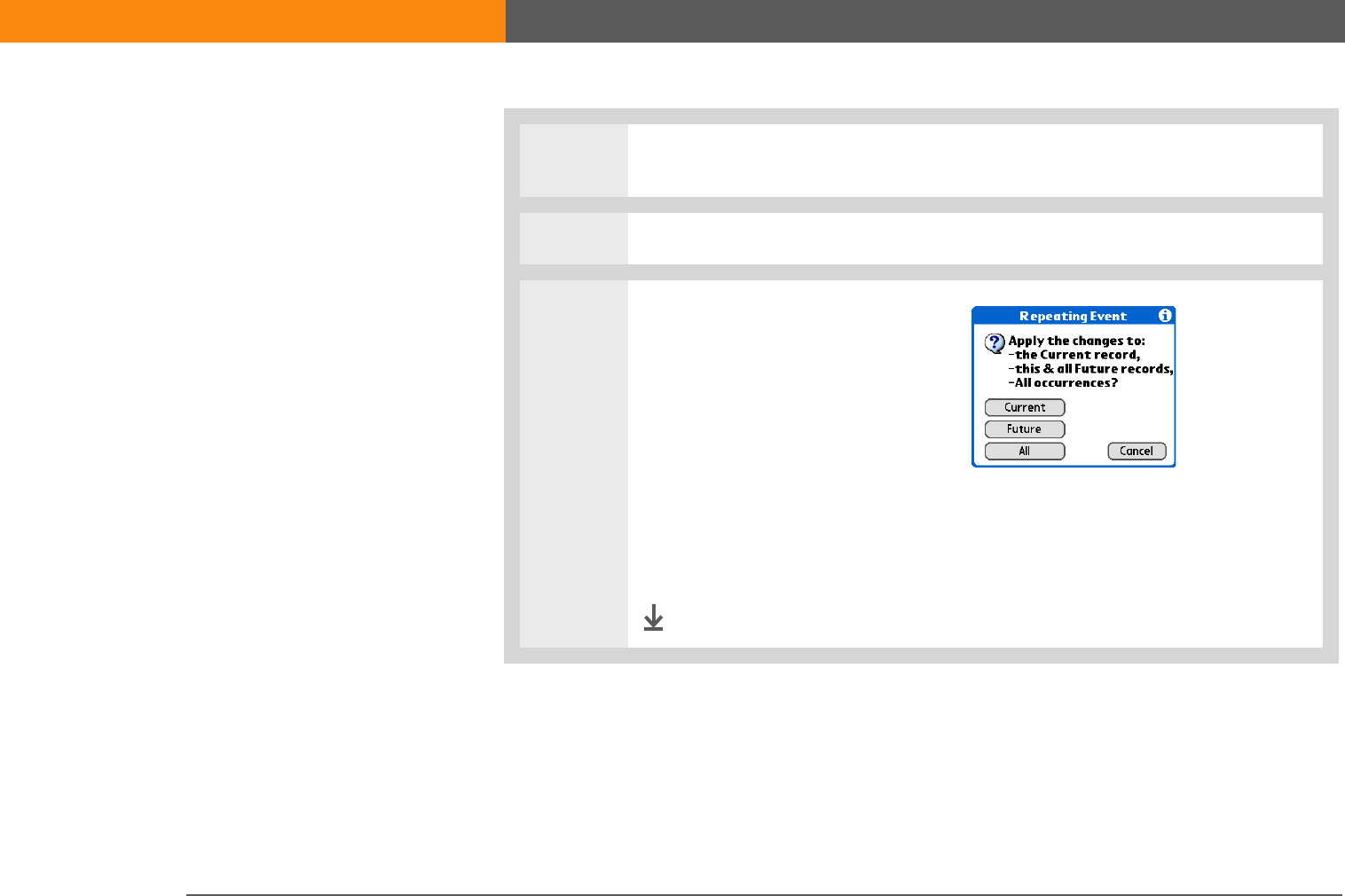
LifeDrive from palmOne 170
CHAPTER 7 Managing Your Calendar
4[ & ] OPTIONAL Check the box to save an archive copy of the event on your
computer.
5Select OK.
6If you’re deleting a repeating
event, select one of the following
to select the event(s) you want to
delete:
Current Delete only the selected
instance of the repeating event.
Future Delete the selected event
and all instances of the repeating event that occur at a later date.
All Delete the selected event and all past and future instances of the repeating
event.
Done
SECOND DRAFT palmOne, Inc. Confidential
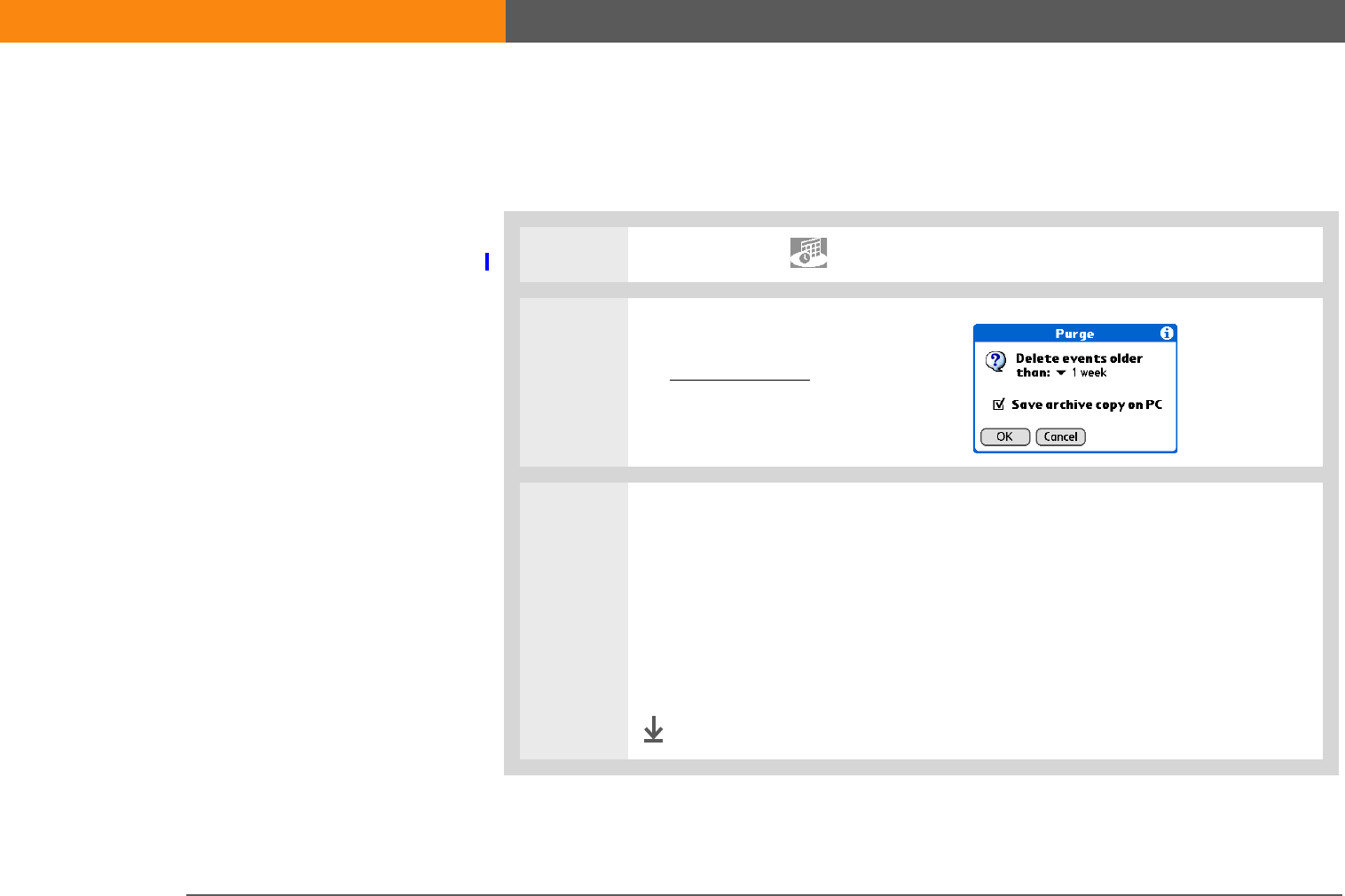
LifeDrive from palmOne 171
CHAPTER 7 Managing Your Calendar
Deleting all your old events
When you need more space on your device, or you just want to do some “housekeeping,” you can
delete all your old events.
0
1Tap the Calendar icon in the input area.
2Open the Purge dialog box:
a. Open the menus.
b. Select Purge on the Record
menu.
3Select the events to purge:
a. Select the Delete events older than pick list and select a time frame.
b. Check the Save archive copy on PC box if you want to place a copy of the
deleted events in an archive file on your computer the next time you
synchronize.
c. Select OK.
Done
SECOND DRAFT palmOne, Inc. Confidential
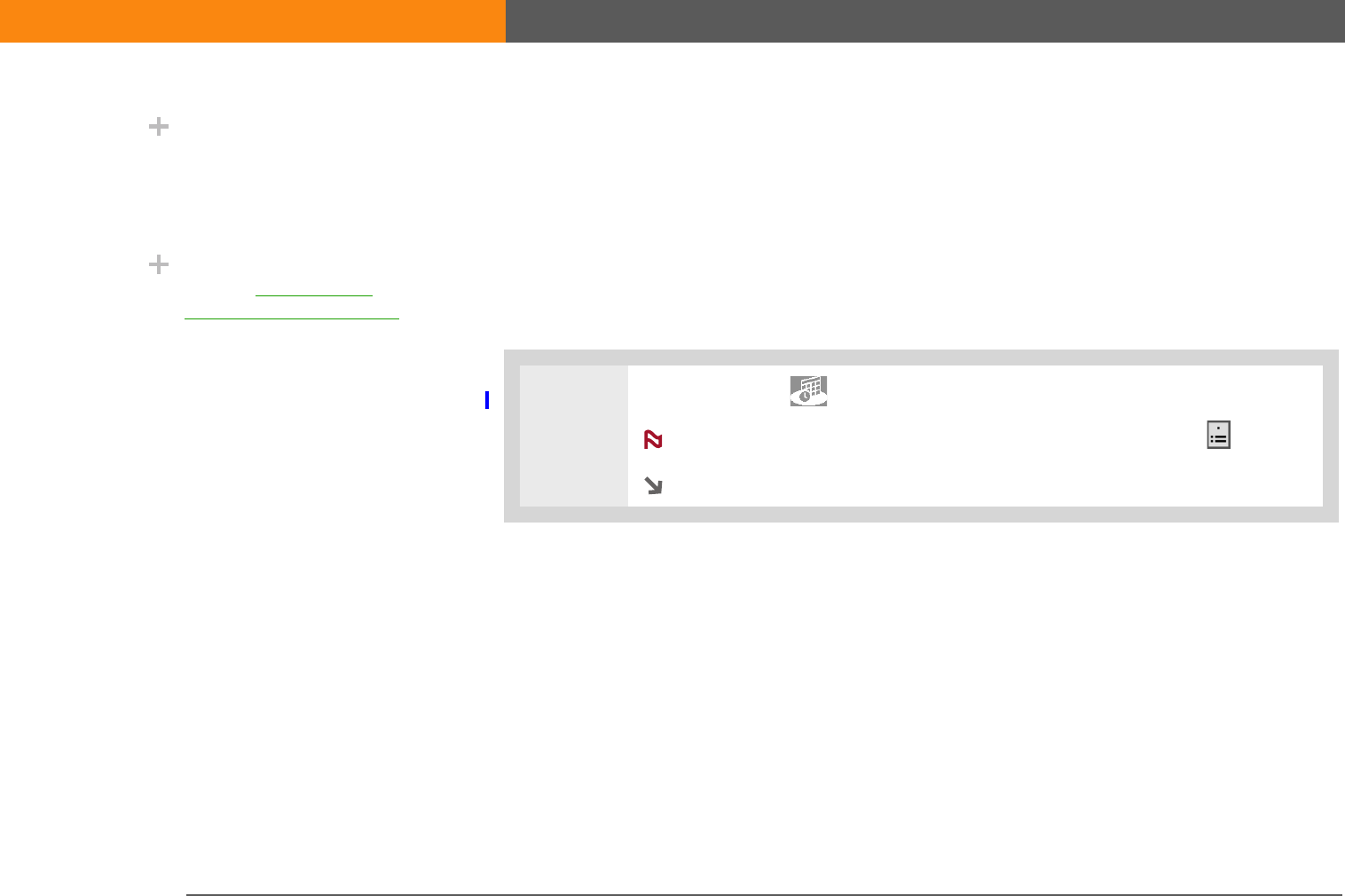
LifeDrive from palmOne 172
CHAPTER 7 Managing Your Calendar
Checking your schedule
Sometimes you want to look at your schedule for a particular date, while other times you want to
see an overview of a week or month.
Viewing your appointments and tasks together
The Agenda View shows your daily schedule and any items on your Tasks list that are overdue or
due today. If there’s room on the screen, the Agenda View also shows your schedule for the next
dates that have events scheduled on them.
0
1Tap the Calendar icon in the input area.
If Calendar is already open, select the Agenda View icon instead.
Continued
Did You Know?
The Agenda View shows
how many unread
messages you have in the
VersaMail® application.
Did You Know?
You can use a favorite
photo as the background
for your Agenda View.
NOTE
SECOND DRAFT palmOne, Inc. Confidential
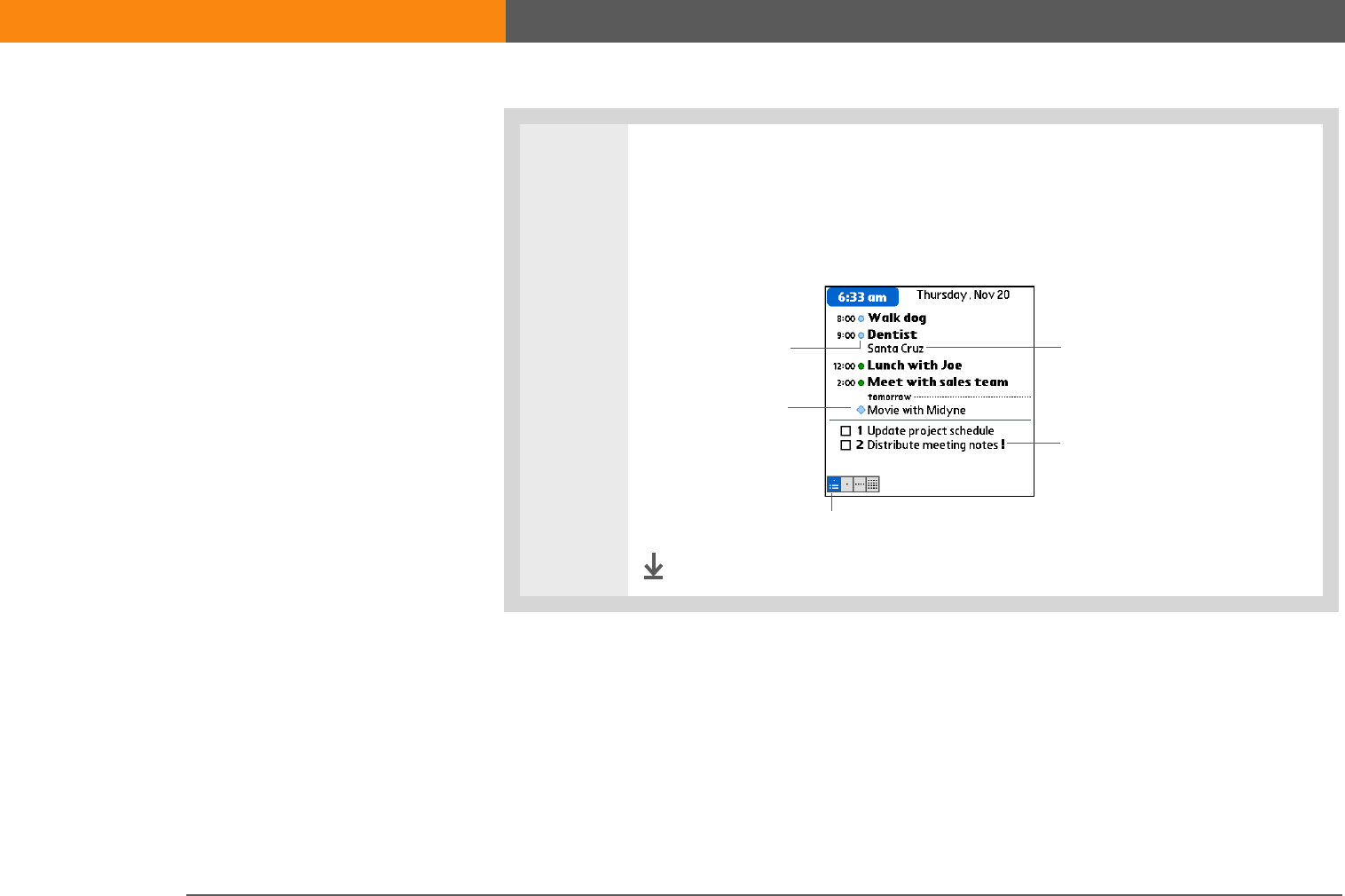
LifeDrive from palmOne 173
CHAPTER 7 Managing Your Calendar
2Do one of the following to view your schedule:
• Select an appointment to go to it in Day View.
• Select a task to go to it in Tasks.
Done
Agenda View icon
Location
No-time icon
Overdue task icon
Category marker
SECOND DRAFT palmOne, Inc. Confidential
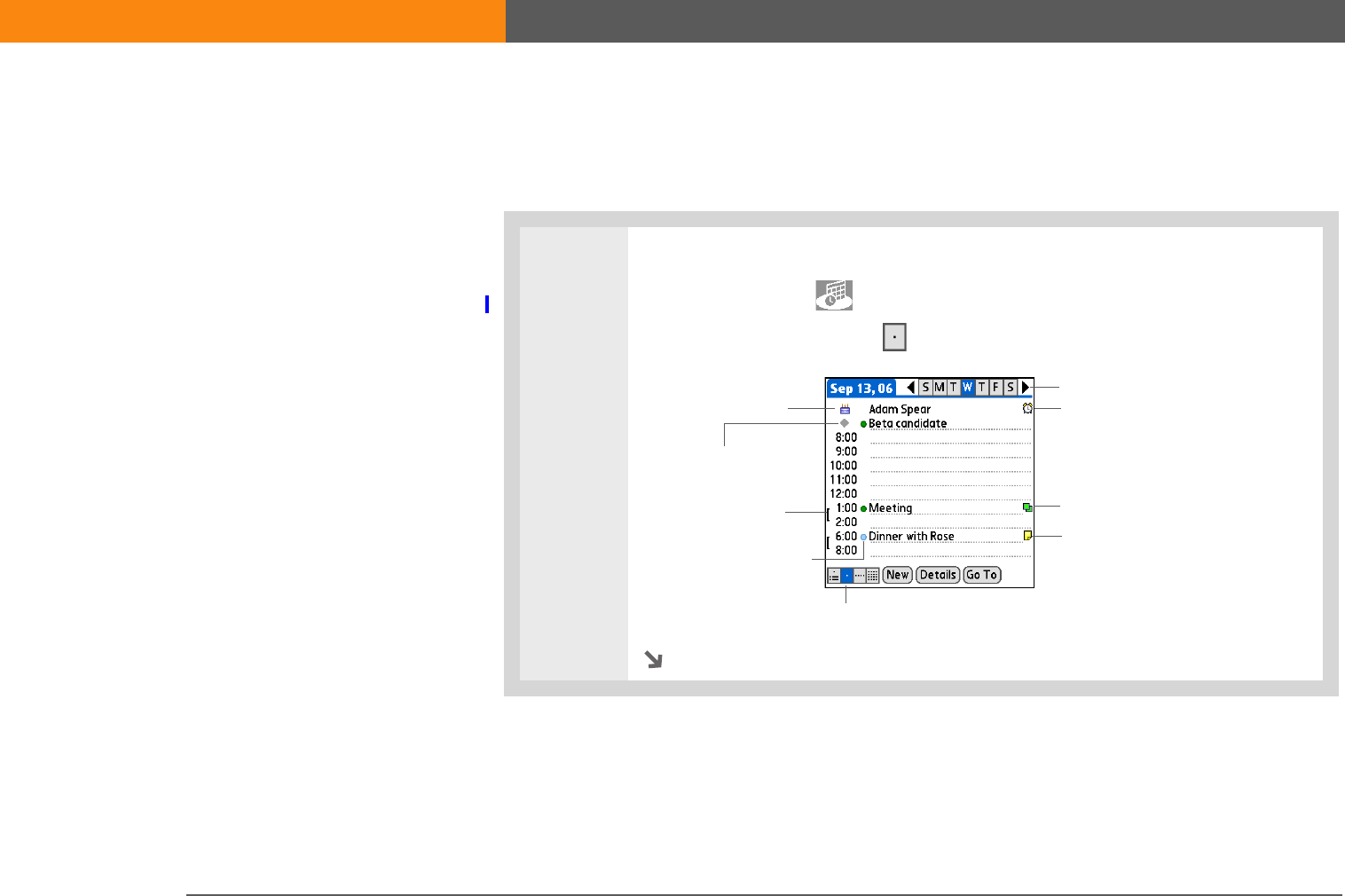
LifeDrive from palmOne 174
CHAPTER 7 Managing Your Calendar
Viewing your daily schedule
Day View shows your daily schedule one day at a time. You can scroll between days in the current
week or jump to any other date.
0
1Open Day View:
a. Tap the Calendar icon in the input area.
b. Select the Day View icon .
Continued
Day View icon
Repeat icon
No-time icon
Alarm icon
Day selector
Note icon
Event duration
Birthday icon
Category marker
SECOND DRAFT palmOne, Inc. Confidential
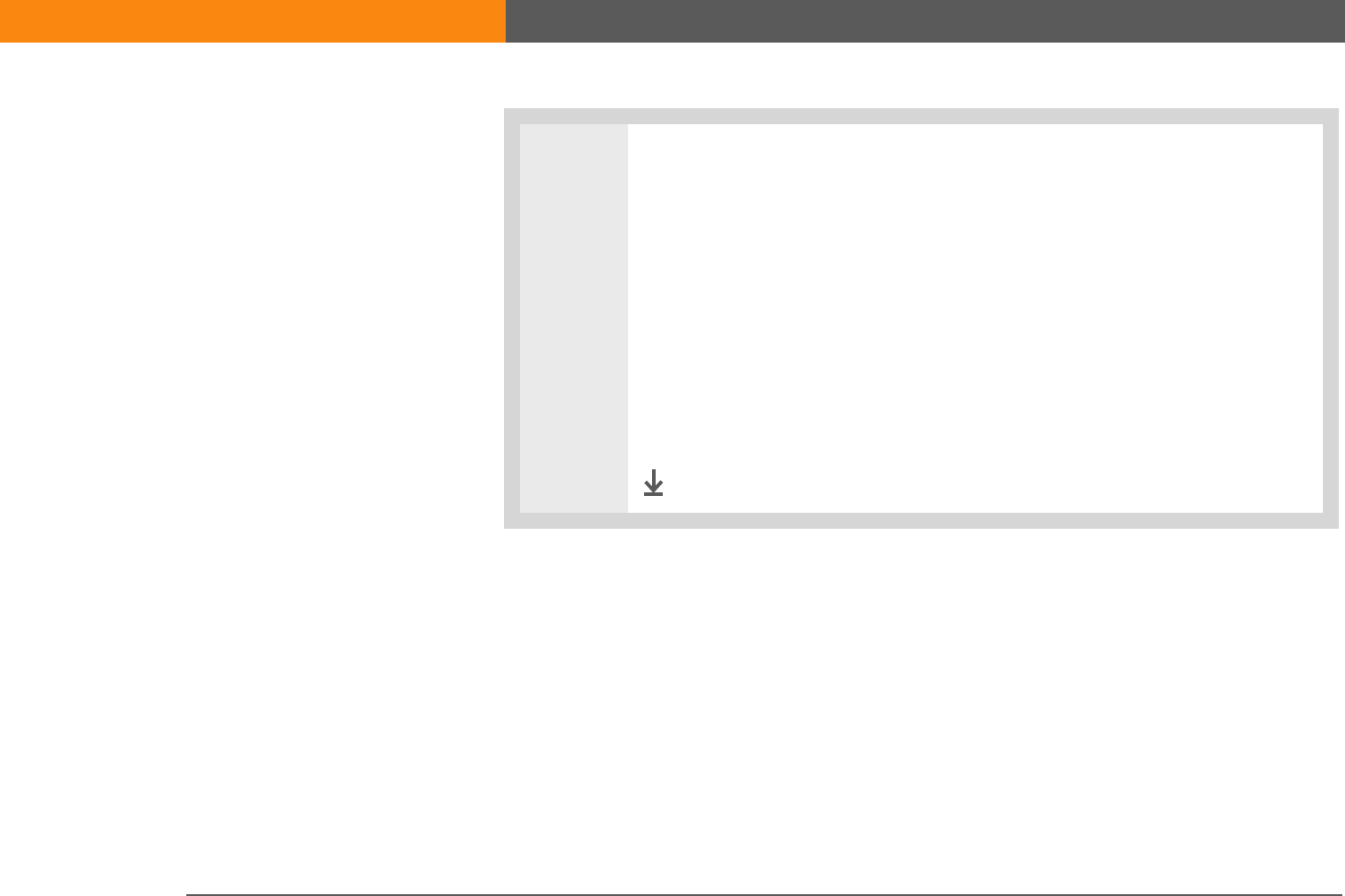
LifeDrive from palmOne 175
CHAPTER 7 Managing Your Calendar
2Do any of the following to view your daily schedule:
• Select the day selector to view another day in the same week, select the
arrows to scroll to the previous or next week, or select Go To to choose a
specific date.
• Select the Repeat icon, the Alarm icon, or Details to open the Details dialog
box.
• Select the Note icon to view the note text.
• Select the Birthday icon to view the birthday entry.
• Select the category marker to assign the event to a color-code.
Done
SECOND DRAFT palmOne, Inc. Confidential
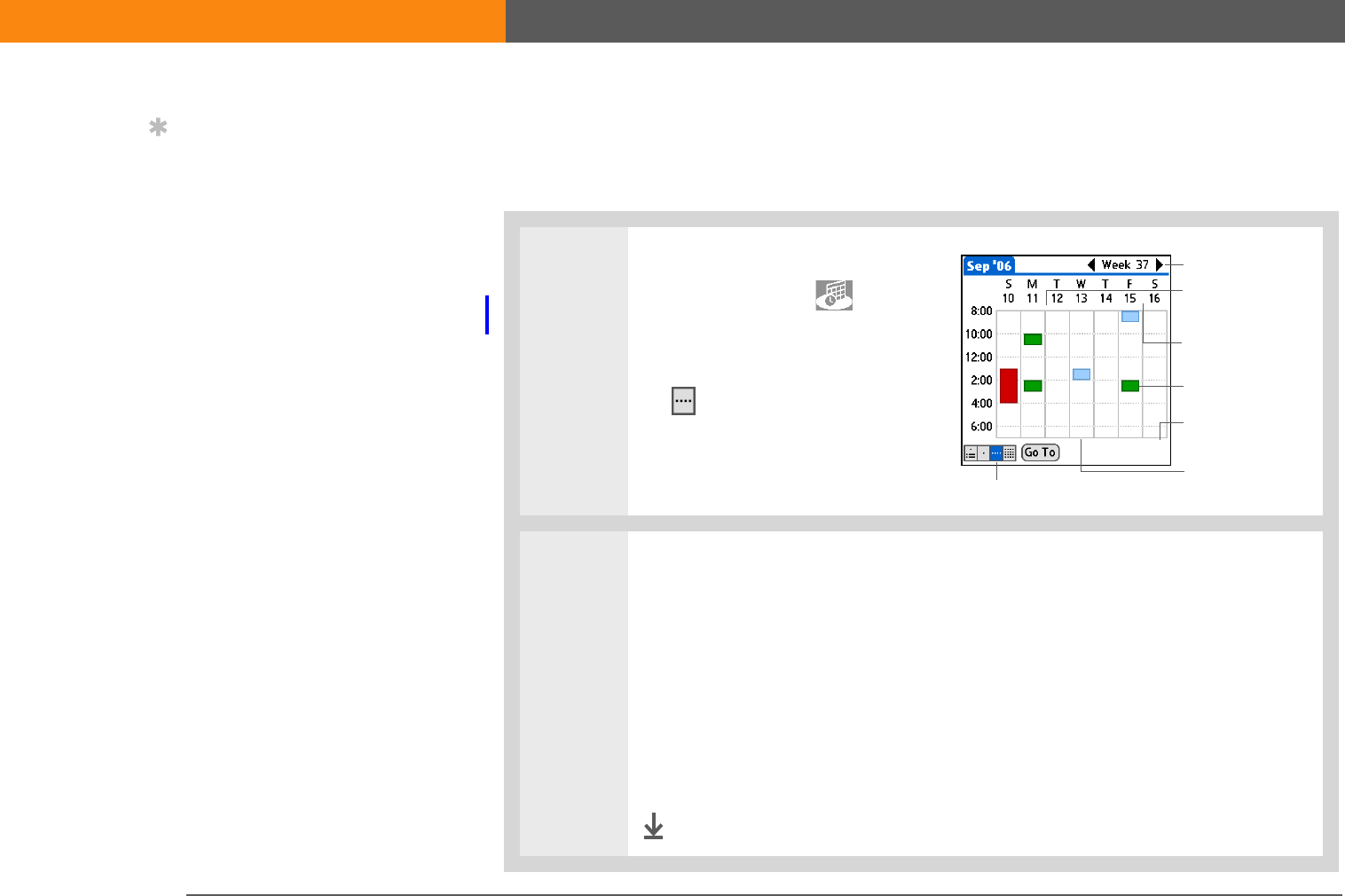
LifeDrive from palmOne 176
CHAPTER 7 Managing Your Calendar
Viewing your weekly schedule
Week View shows your schedule for an entire week. The time frames that appear on the screen are
based on the Start Time and End Time settings in Calendar Preferences.
0
1Open Week View:
a. Tap the Calendar icon in
the input area.
b. Select the Week View icon
.
2Do any of the following to view your weekly schedule:
• Select the week selector to scroll between weeks, or select Go To to choose a
week.
• Select a date to go to that day in Day View.
• Select an event to view the event description and location.
• Select the scroll arrows to view events scheduled earlier or later in the day
during the selected week.
Done
Tip
You can also press Right
and Left on the 5-way to
scroll to the next or
previous week. To go to
Day View for a particular
day, press Center on the
5-way to insert a
highlight, press Right or
Left to select a day, and
then press Center on the
5-way again.
Week View icon
Event
No-time icon
Week selector
After-hours event
Multi-day event
Scroll arrows
SECOND DRAFT palmOne, Inc. Confidential
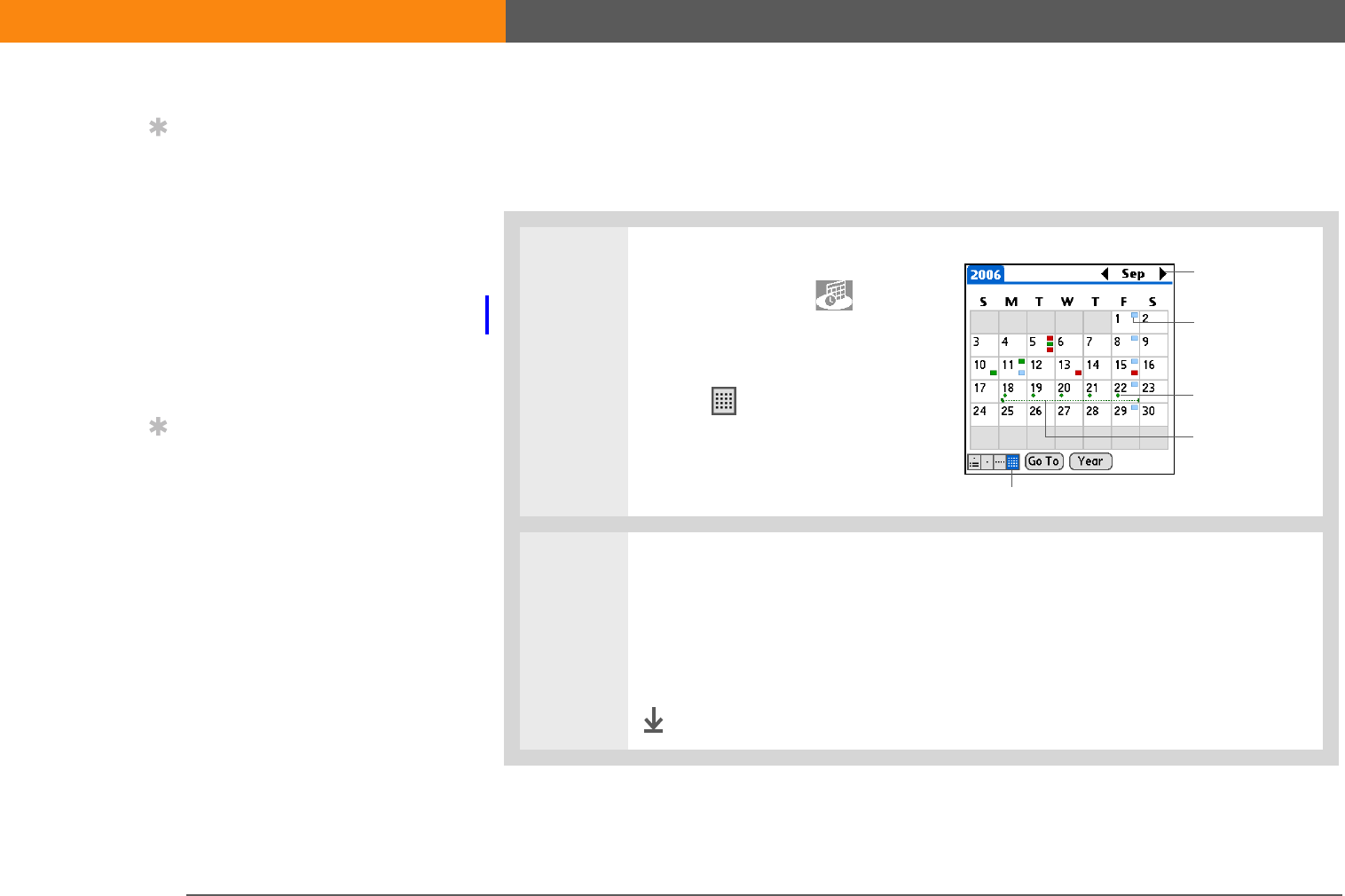
LifeDrive from palmOne 177
CHAPTER 7 Managing Your Calendar
Viewing your monthly schedule
Month View shows your schedule for a whole month. You can scroll between months or jump to
any other month.
0
1Open Month View:
a. Tap the Calendar icon in
the input area.
b. Select the Month View
icon .
2Do any of the following to view your monthly schedule:
• Select the month selector to scroll to the previous or next month, or select Go
To to choose a specific month.
• Select a date to go to that day in Day View.
Done
Tip
You can also press Right
and Left on the 5-way to
scroll to the next or
previous month. To go to
Day View for a particular
date, press Center on the
5-way to insert a
highlight, press Right or
Left to select a date, and
then press Center on the
5-way again.
Tip
When you turn off the
input area, you can see
the month before and the
month after the currently
selected month.
Month View icon
Event
No-time icon
Month selector
Multi-day event
SECOND DRAFT palmOne, Inc. Confidential
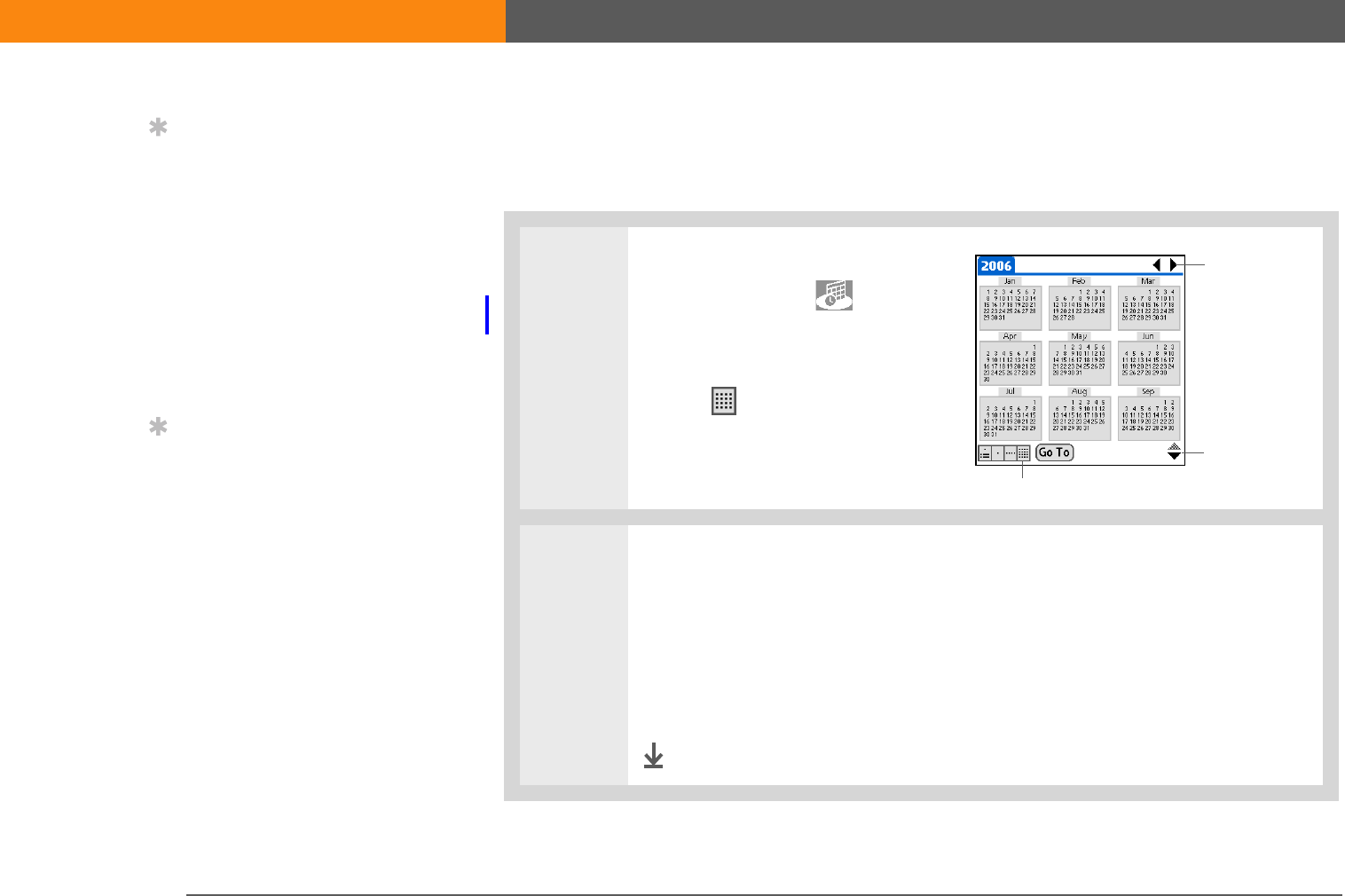
LifeDrive from palmOne 178
CHAPTER 7 Managing Your Calendar
Viewing a yearly calendar
Year View shows a calendar for an entire year. You can scroll between years or jump to any other
year.
0
1Open Year View:
a. Tap the Calendar icon in
the input area.
b. Select the Month View
icon .
c. Select Year.
2Do any of the following to view a yearly calendar:
• Select the year selector to scroll to the previous or next year, or select Go To
to choose a specific year.
• Select the scroll arrows to see months that don’t fit on the screen.
• Select a month to go to that month in Month View.
Done
Tip
You can also press Right
and Left on the 5-way to
scroll to the next or
previous month. To go to
Day View for a particular
date, press Center on the
5-way to insert a
highlight, press Right or
Left to select a date, and
then press Center on the
5-way again.
Tip
When you turn off the
input area, you can see
the entire year. Month View icon
Scroll arrows
Year selector
SECOND DRAFT palmOne, Inc. Confidential
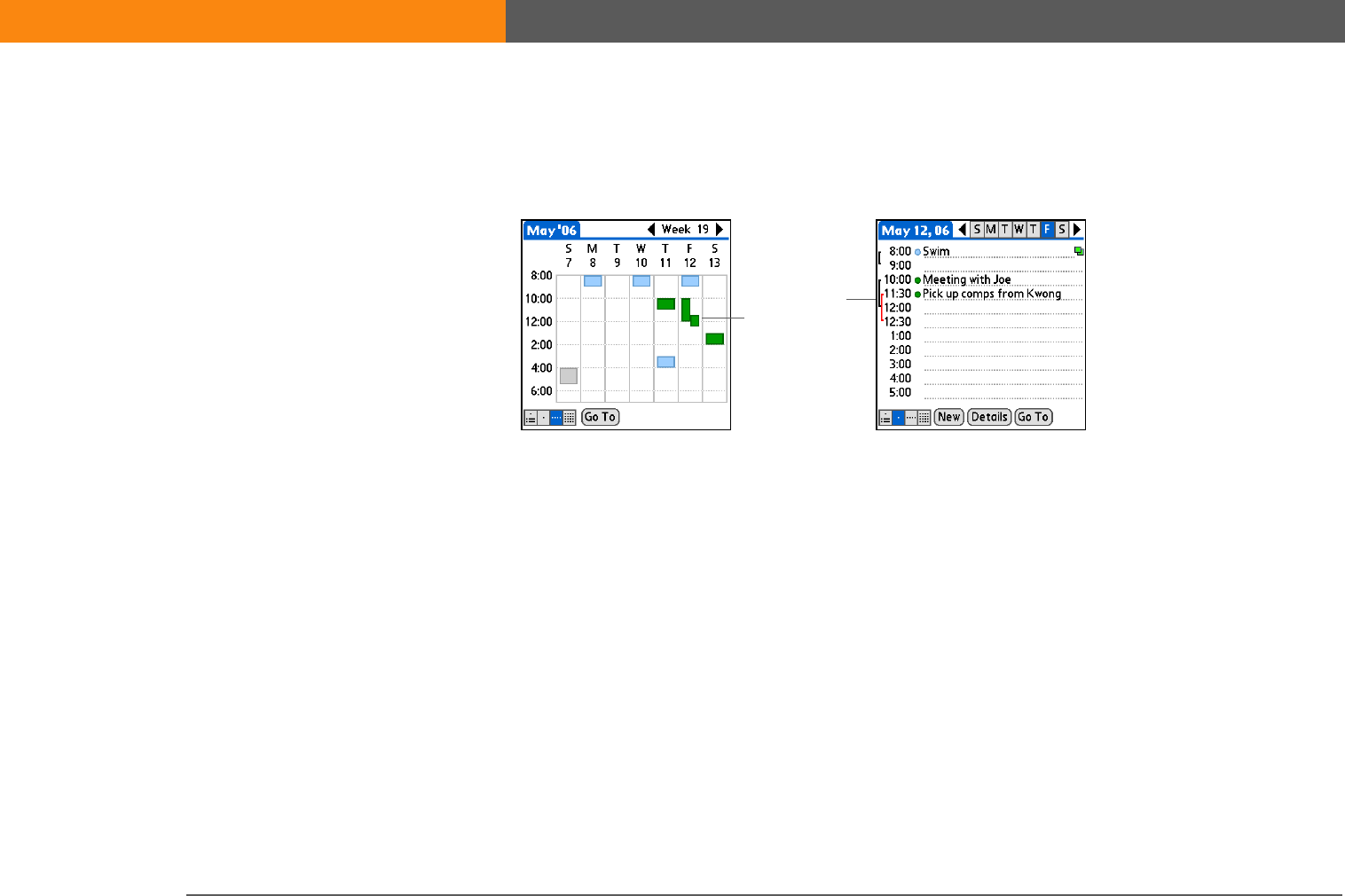
LifeDrive from palmOne 179
CHAPTER 7 Managing Your Calendar
Finding events that overlap
When an event starts before a previous event finishes, the events overlap. You can spot events
that overlap in Week View and in Day View.
Customizing your calendar
Control the appearance of your Calendar screens. Select display options for the Agenda View, Day
View, and Month View. The options you select for each view apply only to that view. You can also
choose alarm and start and end time settings.
Overlapping
events
SECOND DRAFT palmOne, Inc. Confidential
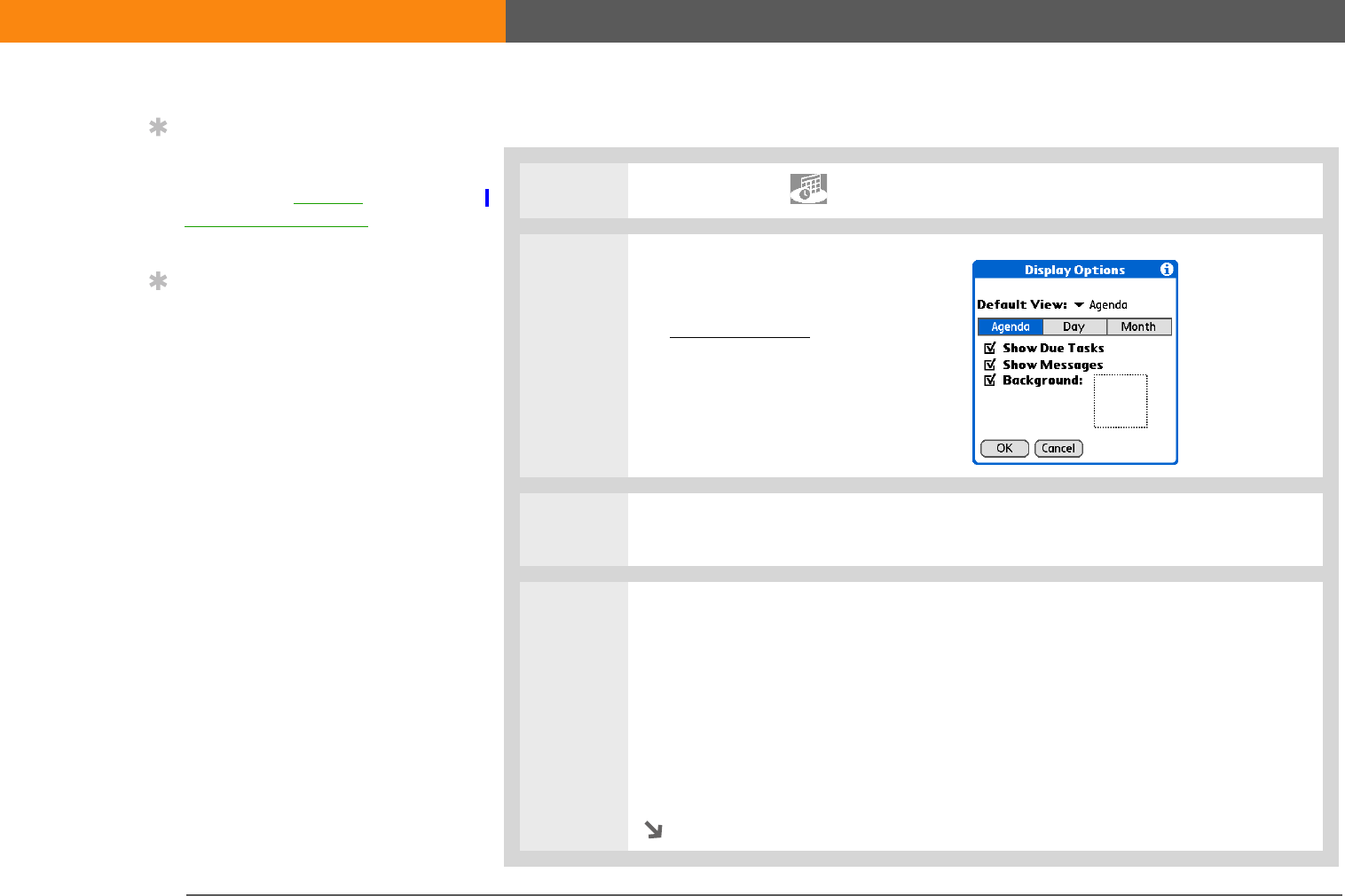
LifeDrive from palmOne 180
CHAPTER 7 Managing Your Calendar
Customizing display options for your calendar
0
1Tap the Calendar icon in the input area.
2Open the Display Options dialog
box:
a. Open the menus.
b. Select Options, and then
select Display Options.
3Select the Default View pick list and select the view you want to see when you
open Calendar.
4Set any of the following Agenda View display options:
Show Due Tasks Display tasks that are due today and tasks that are overdue.
Show Messages Display the number of read and unread email messages.
Background Use your favorite photo as the Agenda View background. Check
the Background box, select the photo thumbnail, and then select a photo.
Adjust the fade setting so that the text is easy to read against the photo.
Continued
Tip
If the text is difficult to see
against your new
background, select a
different Color Theme to
change the text color.
Tip
If you want to see the
hours when you have
nothing scheduled as well
as your appointments,
deselect Compress Day
View. But don’t forget to
scroll down to see the
events at the end of your
day, or hide the input area
and display as much of
Day View as possible.
SECOND DRAFT palmOne, Inc. Confidential
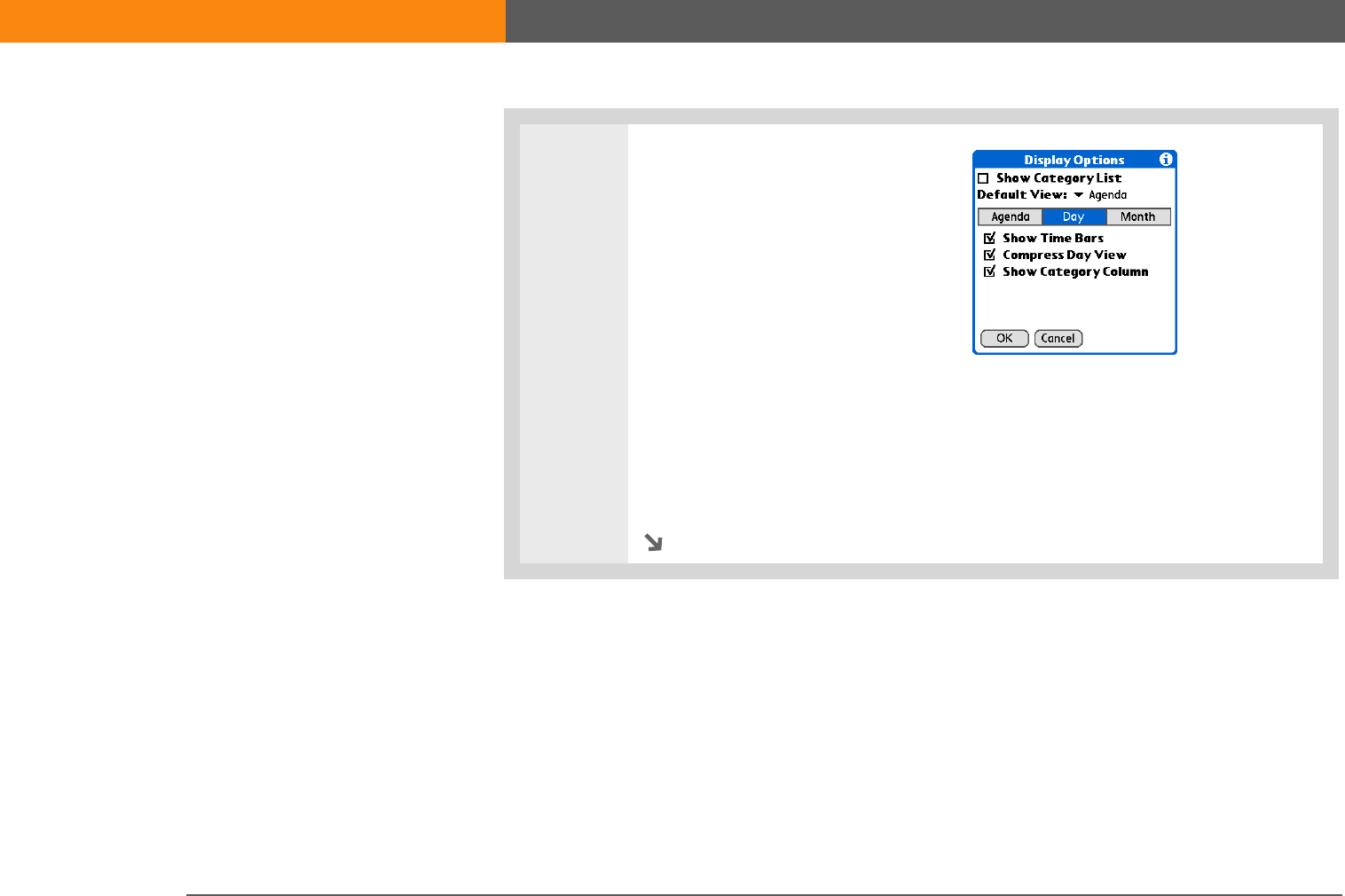
LifeDrive from palmOne 181
CHAPTER 7 Managing Your Calendar
5Select Day and set any of the
following Day View options:
Show Category List Display the
category pick list. By default, the
Category pick list doesn’t appear.
Show Time Bars Display the bars
that show the duration of an event
and event conflicts.
Compress Day View Avoid scrolling and display only the time period with
scheduled events.
Show Category Column Display the category marker between the time and
description. The color of the category marker indicates which category the
event is filed under.
Continued
SECOND DRAFT palmOne, Inc. Confidential
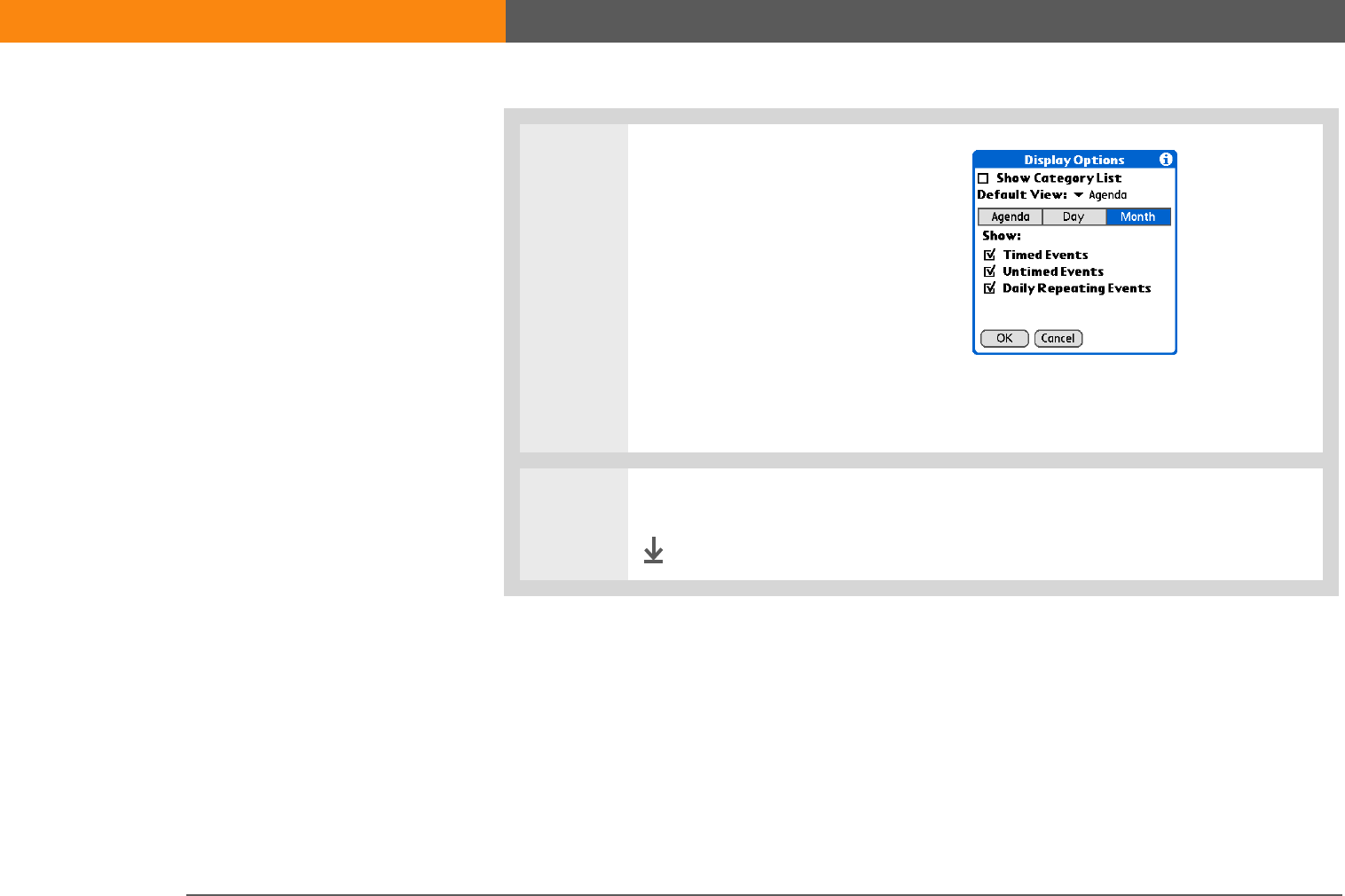
LifeDrive from palmOne 182
CHAPTER 7 Managing Your Calendar
6Select Month and set any of the
following Month View options:
Show Category List Display the
category pick list. By default, the
Category pick list doesn’t appear.
Timed Events Show events that
are scheduled for a specific time.
Untimed Events Show events
that are scheduled for a specific date, but not a specific time.
Daily Repeating Events Show events that repeat every day.
7Select OK.
Done
SECOND DRAFT palmOne, Inc. Confidential
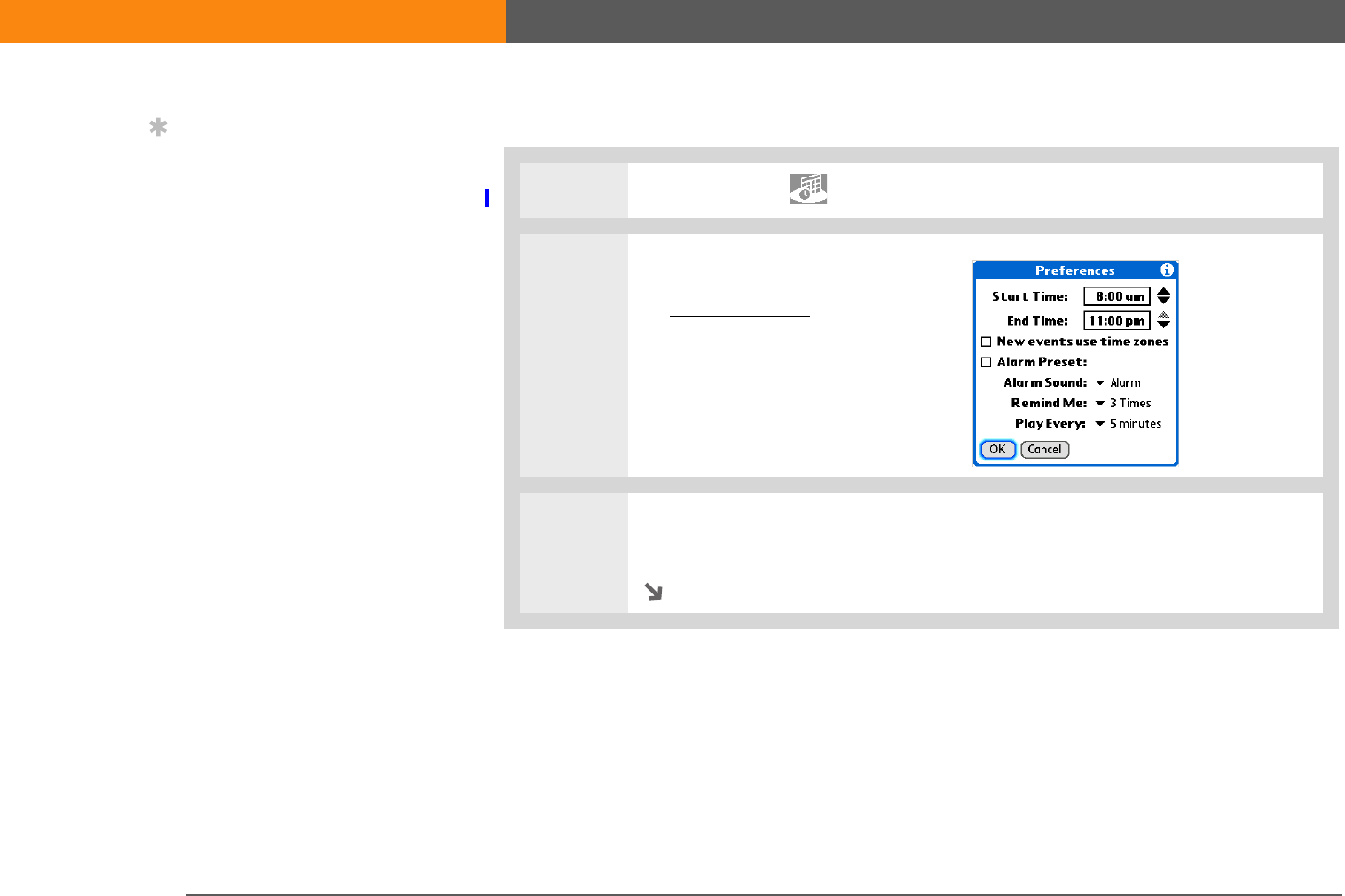
LifeDrive from palmOne 183
CHAPTER 7 Managing Your Calendar
Setting alarm and time options
0.
1Tap the Calendar icon in the input area.
2Open the Preferences dialog box:
a. Open the menus.
b. Select Options, and then
select Preferences.
3Select the start and end times of your typical day.This time frame appears in
your Day View and Week View:
Continued
Tip
You can view and
schedule events in time
slots that are before or
after the start or end time.
You just need to scroll to
those time slots.
SECOND DRAFT palmOne, Inc. Confidential
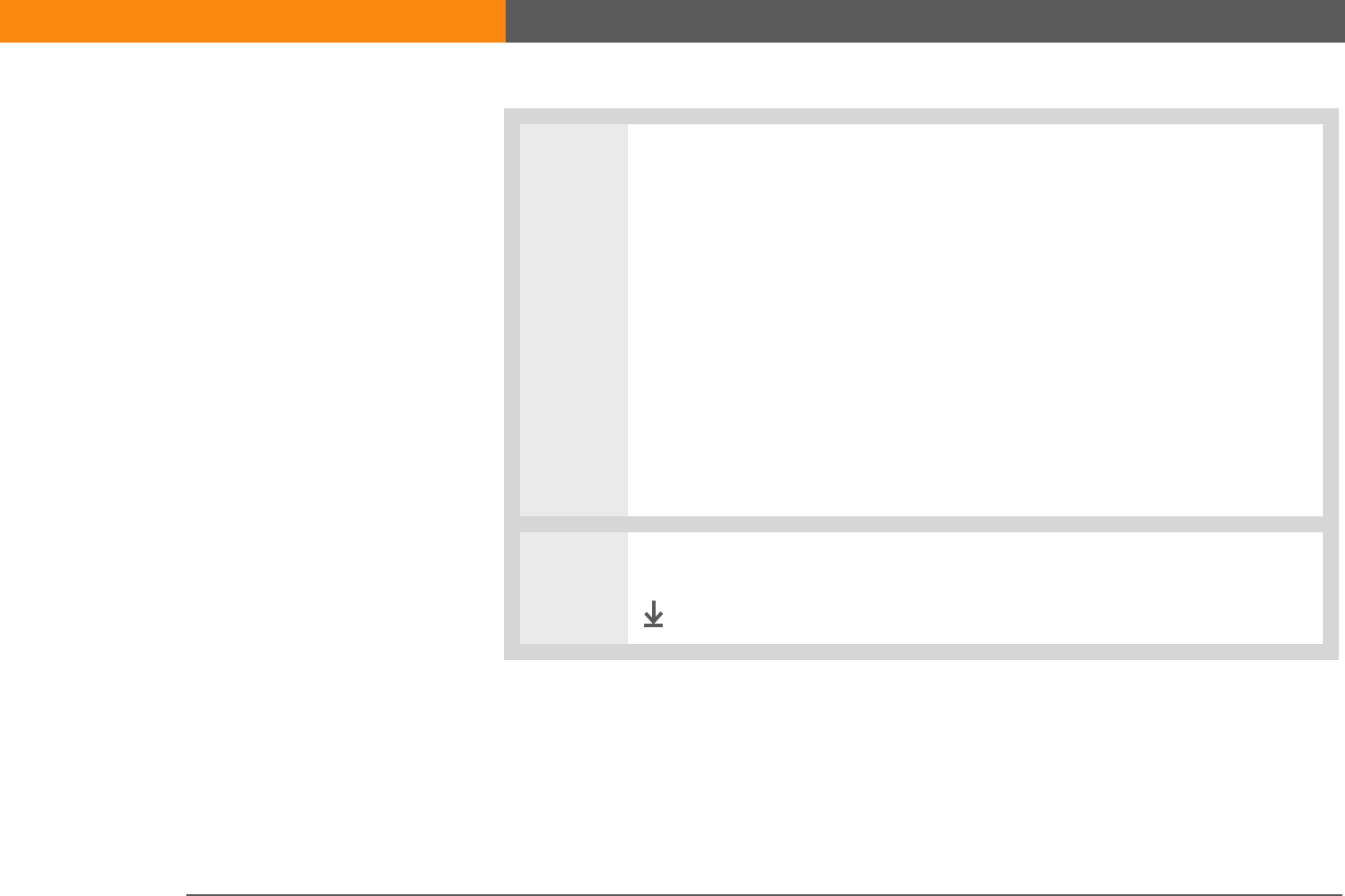
LifeDrive from palmOne 184
CHAPTER 7 Managing Your Calendar
4Set any of the following alarm settings:
Alarm Preset Set an alarm for each new event. When you check this box, you
also need to enter the default number of minutes, days, or hours before the
event that the alarm sounds. For events without a time, the alarm settings are
based on midnight of the date of the event. The Alarm Preset settings appear as
defaults for each new event, but you can change these settings in the Details
dialog box for individual events. If you don’t want to use alarms for most of
your events, don’t check this box.
Alarm Sound Select the sound the alarm makes when it goes off.
Remind Me Select how many times the alarm sounds after the first time it
goes off: Once, Twice, 3 Times, 5 Times, and 10 Times.
Play Every Select how often the alarm sounds: Minute, 5 minutes, 10 minutes,
and 30 minutes.
5Select OK.
Done
SECOND DRAFT palmOne, Inc. Confidential

LifeDrive from palmOne 185
CHAPTER 7 Managing Your Calendar
Working with Calendar on your computer
If you use Microsoft Exchange ActiveSync®, your email and calendar information
synchronize directly with your info on your company's Exchange server. You must retrieve email
and calendar updates from the VersaMail application; they do not update when you synchronize
your device with your computer.
Use Calendar on your computer to view and manage your schedule. Check out the online Help in
Palm®Desktop software to learn how to use Calendar on your computer. The online Help includes
info about the following topics:
• Scheduling events
• Rescheduling events
• Setting alarms
• Deleting events
• Marking events as private and hiding them
• Printing your schedule
• Working with Day View, Week View, Month View, and Year View
WINDOWS ONLY
To open Calendar on your computer, double-click the Palm Desktop icon on the Windows desktop,
and then click Calendar on the Launch bar.
MAC ONLY
To open Calendar on your computer, double-click the Palm Desktop icon in the Palm folder, and
then click Date Book.
IMPORTANT
[!]
Did You Know?
Mac Check out the
Holiday Files folder in the
Palm folder. It contains
various holidays that you
can import into
Palm Desktop software
on your computer.
SECOND DRAFT palmOne, Inc. Confidential

LifeDrive from palmOne 186
CHAPTER 7 Managing Your Calendar
Related topics
Click a link below to learn about these related topics:
Sharing • Beaming events to other Palm Powered™ devices
• Sending events to other Bluetooth® devices by using Bluetooth wireless
technology on your device
• Synchronizing with Palm Desktop software and Outlook
VersaMail Sending events as attachments to email messages
Privacy Keeping events private by turning on security options
Categories • Editing and deleting categories
• Viewing events by category
Common
Questions
Answers to frequently asked questions about Calendar
Tips & Tricks
Make your device uniquely
yours. For great tips,
software, accessories, and
more, visit
www.palmOne.com/
mylifedrive.
Support
If you’re having problems
with Calendar or with
anything else on your device,
go to www.palmOne.com/
support.
SECOND DRAFT palmOne, Inc. Confidential
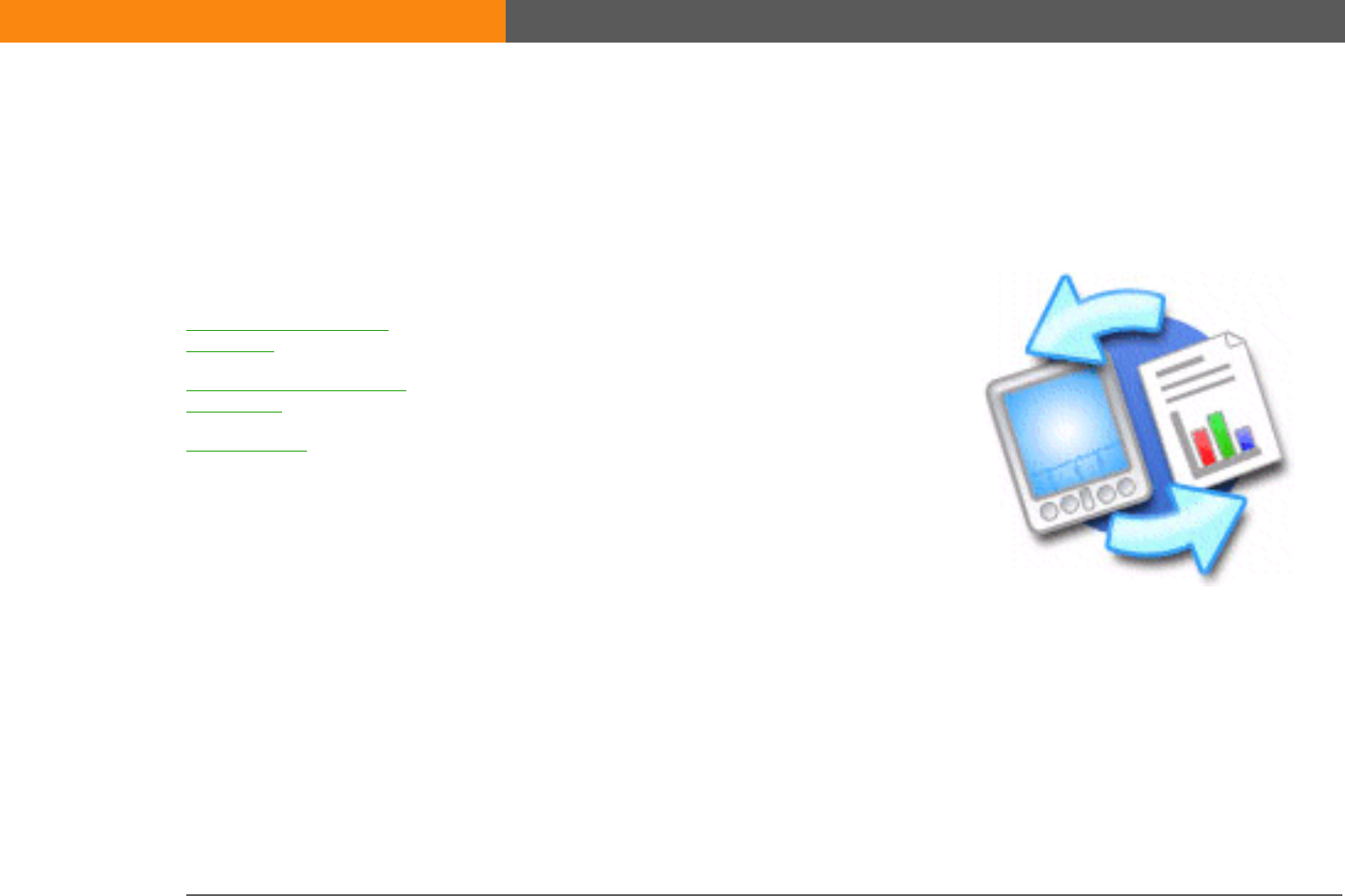
LifeDrive from palmOne 187
CHAPTER 8
Your Microsoft Office File Manager
With its ability to store large amounts
of important information, your device
lets you take your office with you—
including your Microsoft Office files.
With the Documents application, you
can carry, create, view, and edit
Microsoft Word and Excel files directly
on your device. You can also view,
carry, and manage PowerPoint files on
your device.
You can keep updated copies of the
files on both your device and your
computer so that you can work on
them in the most convenient location
any time.
Benefits
• Manage Word, Excel, and PowerPoint
files on your device
• Improve productivity by taking
important docs, spreadsheets, and
presentations with you on the go
In this chapter
Creating and managing
Office files
Opening files from within
Documents
Related Topics
SECOND DRAFT palmOne, Inc. Confidential

CHAPTER 8 Your Microsoft Office File Manager
LifeDrive from palmOne 188
Creating and managing Office files
The Documents application provides powerful editing and file management features for Office
files on your device. What’s more, Documents makes it easy for you to share files between your
computer and your device.
Here are some of the capabilities of Documents:
• View Word, Excel, and PowerPoint files in their native format (DOC, XLS, or PPT); no conversion
needed.
• Create or edit a Word document or Excel spreadsheet on your device and save it in native
format. Create or edit a PowerPoint presentation that is automatically converted for optimal
viewing on your device.
• Open Office files received as attachments to incoming email messages, and attach files to
outgoing messages.
• Transfer Office files to a Bluetooth or Wi-Fi printer using your device’s built-in wireless
technology.
You can store and synchronize your Office files and folders in the Documents folder of your
device's hard drive. View and access the files and folders using the Files application on your
device. You can also view the files and folders using LifeDrive™ Manager (Windows) or Drive
Mode (Mac and Windows) on your computer. You can manage items on the hard drive in various
ways: copying, moving, deleting, renaming, and so on, using LifeDrive Manager (Windows) or
Drive Mode (Mac and Windows), or Files on your device.
If you drop Office files into the Documents folder in LifeDrive Manager, they are automatically set
to be synchronized.
Tip
The Documents
application has a
companion application
on your computer called
Documents To Go. Use
Documents To Go to
move or copy files to your
device when you
synchronize.
For complete information
on this application, click
the Documents To Go
icon on your computer
and then click Help, or go
to www.dataviz.com.
SECOND DRAFT palmOne, Inc. Confidential
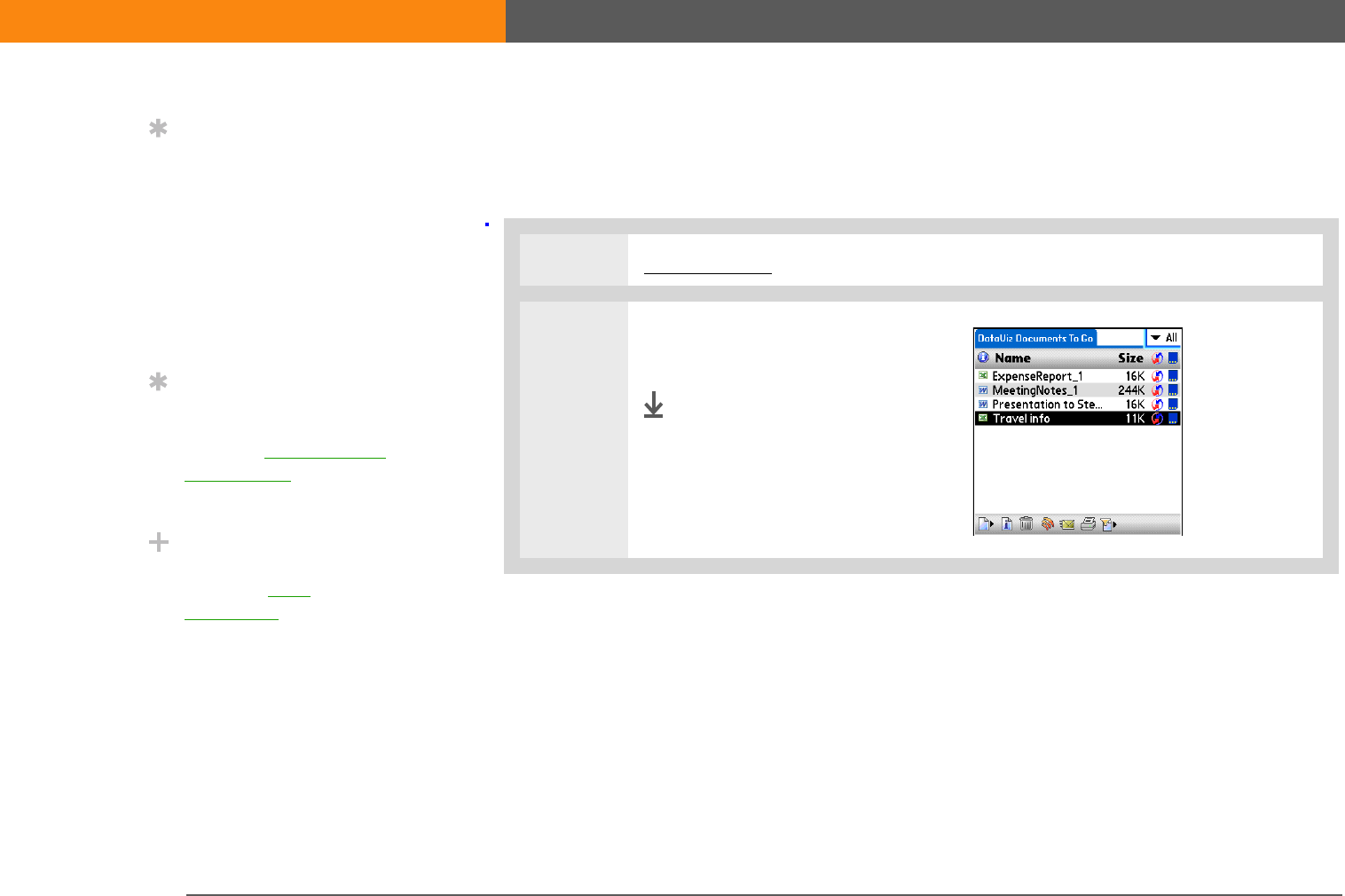
CHAPTER 8 Your Microsoft Office File Manager
LifeDrive from palmOne 189
Opening files from within Documents
In the Documents application, you can view and open any Word, Excel, or PowerPoint file on your
device.
0
1Go to Favorites and select Documents.
2Select the file you want from the
list.
Done
Tip
When you are working on
a file, save it to your
device or your expansion
card by selecting Menu,
selecting Save As from
the File menu, and then
selecting the location
where you want to save
the file.
Tip
Do you have a file or
folder you are always
viewing? Add it to your
Favorites list for easy
access.
Did You Know?
You can also open files
using the Files
application. By default,
Documents application
files are located in the
Documents folder.
SECOND DRAFT palmOne, Inc. Confidential

LifeDrive from palmOne 190
CHAPTER 8 Your Microsoft Office File Manager
Related Topics
Click the link below to learn about these related topics:
VersaMail Sending and receiving Office files as attachments to email messages
Tips & Tricks
Make your device uniquely
yours. For great tips,
software, accessories, and
more, visit
www.palmOne.com/
mylifedrive.
Support
If you’re having problems
with Documents, click the
Documents To Go icon on
your computer, and then click
Help; or go to
www.dataviz.com.
SECOND DRAFT palmOne, Inc. Confidential
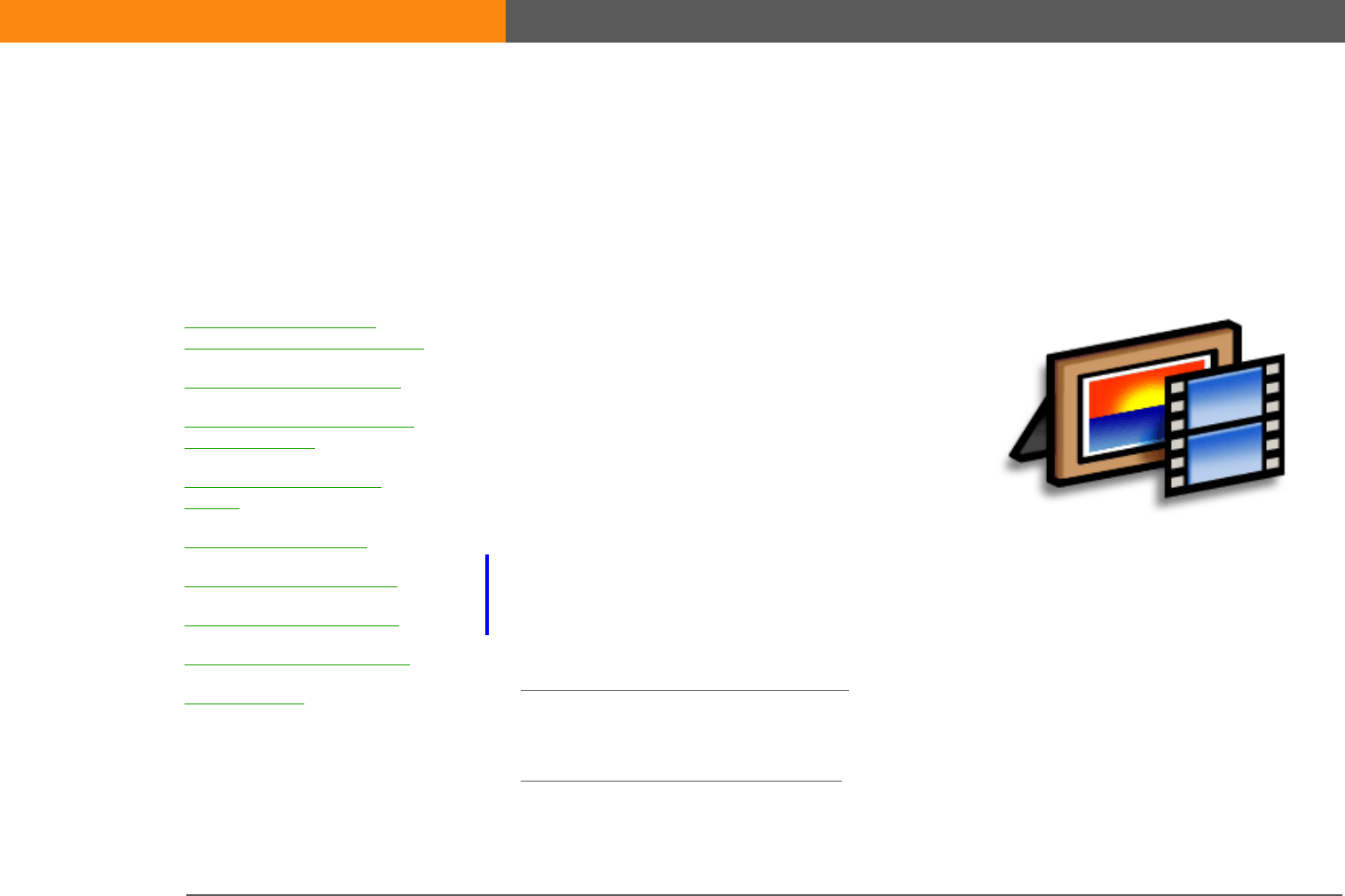
LifeDrive from palmOne 191
CHAPTER 9
Viewing Your Photos and Videos
A picture may be worth a thousand
words, but what happens when you
have lots of pictures—or videos—that
you are trying to keep organized? Or
maybe just a few that are so
meaningful that you want to have
instant access to them at any time?
Solve both problems with palmOne™
Media. Easy viewing and organization
of still photos and videos are all
features of Media. You can keep your
favorite photos right on your device;
select photos as the background for
your Favorites and Applications views
and Agenda View in Calendar; even
add a photo to a Contacts entry.
Benefits
• Never be far from your favorite
people or places
• Simplify photo and video
organization
• Store multiple videos and hundreds
of photos
I
n t
hi
s c
h
apter
Reformatting files and
copying supported file types
Viewing photos or videos
Viewing and editing photo
or video details
Organizing photos and
videos
Personalizing a photo
Copying a photo or video
Deleting a photo or video
Sharing photos and videos
Related topics
SECOND DRAFT palmOne, Inc. Confidential

LifeDrive from palmOne 192
CHAPTER 9 Viewing Your Photos and Videos
Reformatting files and copying supported file types
You can view photos in popular formats such as JPG, BMP, TIFF, and GIF on your device. You can
view videos in formats such as MPEG-1, MPEG-4, MJPEG+ADPCM, and MJPEG+PCM.
When you copy a photo or video from your computer to your device using LifeDrive™ Manager
(Windows), you can choose to reformat the photo or video to a format that works best for viewing
on your device. There are numerous video formats, and not all types can be converted to a format
that’s viewable on your device.
On a Mac, you can use the Send to Handheld droplet to transfer files to your device. The files are
reformatted to a format that works best for viewing on your device.
If you choose to reformat the file, the reformatted version is renamed so that it does not overwrite
the original version on your computer when you synchronize. Only the new reformatted file is
synchronized; the original file is not synchronized.
In LifeDrive Manager, you can also choose Keep synchronized, which allows you to keep the photo
or video in its original format and update it during synchronization.
You can store your photos and videos on your device in the Photos & Videos folder. View and
access the files using the Files application on your device. You can also view the files using
LifeDrive Manager (Windows) or Drive Mode (Mac and Windows) on your computer. You can
manage items on the hard drive in various ways: copying, moving, deleting, renaming, and so on,
using LifeDrive Manager (Windows) or Drive Mode (Mac and Windows), or Files on your device.
Did You Know?
You can carry a video or
photo on your device in
its native format with no
conversion, so you can
view it on the computer in
the format you prefer. On
your computer, use
LifeDrive Manager
(Windows); do not select
the Format for device
option. You can also use
Drive Mode (Mac and
Windows) on your
computer.
SECOND DRAFT palmOne, Inc. Confidential
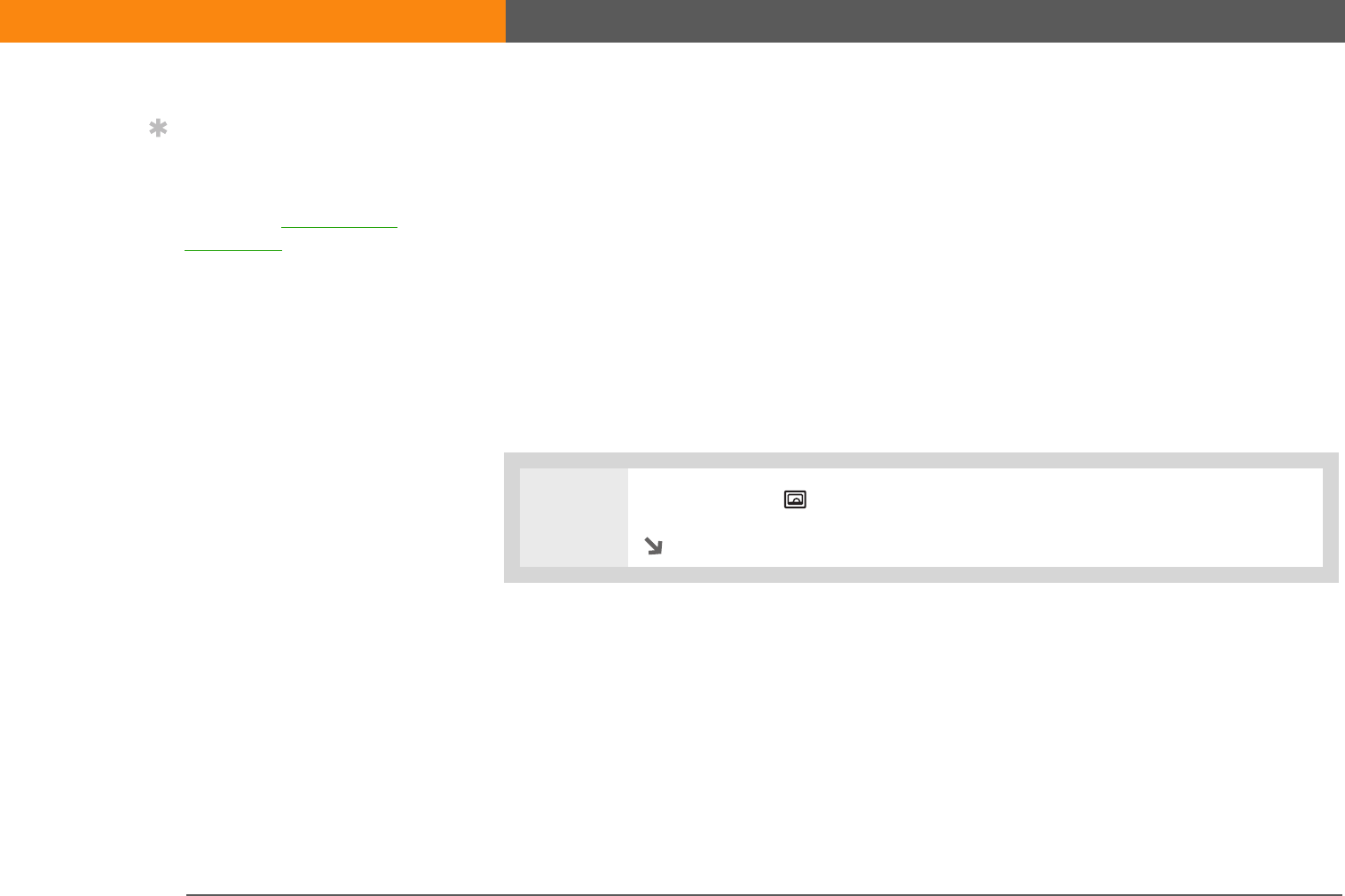
LifeDrive from palmOne 193
CHAPTER 9 Viewing Your Photos and Videos
Viewing photos or videos
You can view photos and videos in the following ways:
Thumbnail View miniature preview versions of your photos and videos.
List View names and dates of photos and videos on your device or an expansion card.
Slide show View all photos and videos in an album, automatically one after another.
You can easily see a full-screen view of a photo or play a video by selecting the photo or video
from the Thumbnail or List View. You can also rotate the orientation of the photo, zoom in to view
a magnified portion of a photo, and view or edit detailed information about a photo or video.
Viewing a photo or video in the Thumbnail View
0
1Press the Media button.
Continued
Tip
Use your camera’s editing
software to edit or
enhance your photos or
videos and copy them to
your device for viewing.
SECOND DRAFT palmOne, Inc. Confidential
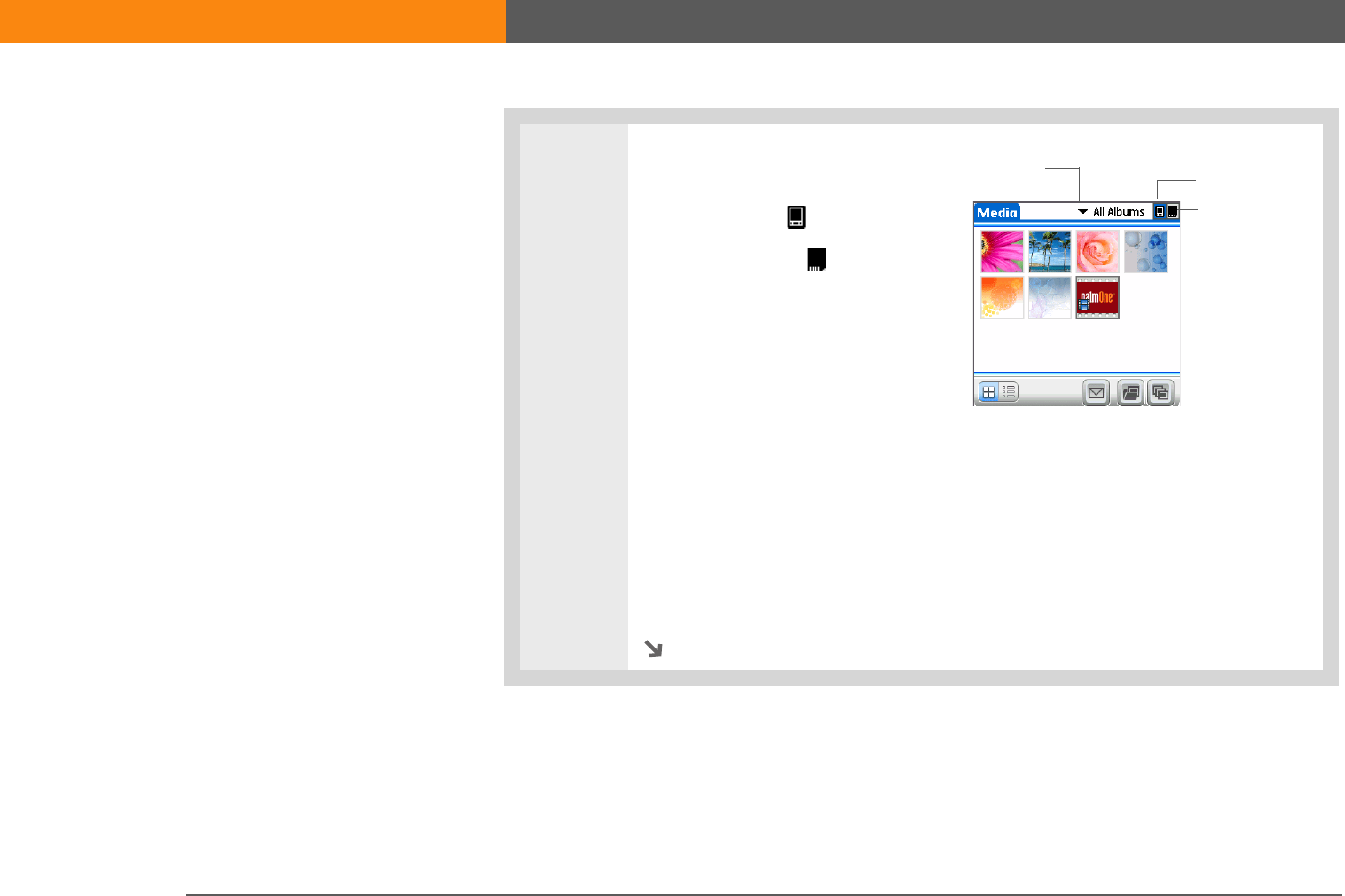
LifeDrive from palmOne 194
CHAPTER 9 Viewing Your Photos and Videos
2Go to the folder or album where
the photo or video is located:
a. Select Device or
Expansion Card .
b. Tap Location pick list in the
upper-right corner and select
the location of the photo or
video you want to view:
• If the photo or video is in the
Photos & Videos folder on your
device’s hard drive or on an
expansion card, select the
correct location from the list.
• If the photo or video is located
elsewhere on your device’s
hard drive, select Browse, and
then browse to the item.
Continued
Expansion card
Device
Location
pick list
SECOND DRAFT palmOne, Inc. Confidential

LifeDrive from palmOne 195
CHAPTER 9 Viewing Your Photos and Videos
3Select a photo or video:
a. If the Thumbnail View is not displayed, select Thumbnails in the lower-
left.
b. Select the photo or video you want to view. A video automatically starts
playing when you select it.
Continued
Select a photo or
video to view
SECOND DRAFT palmOne, Inc. Confidential
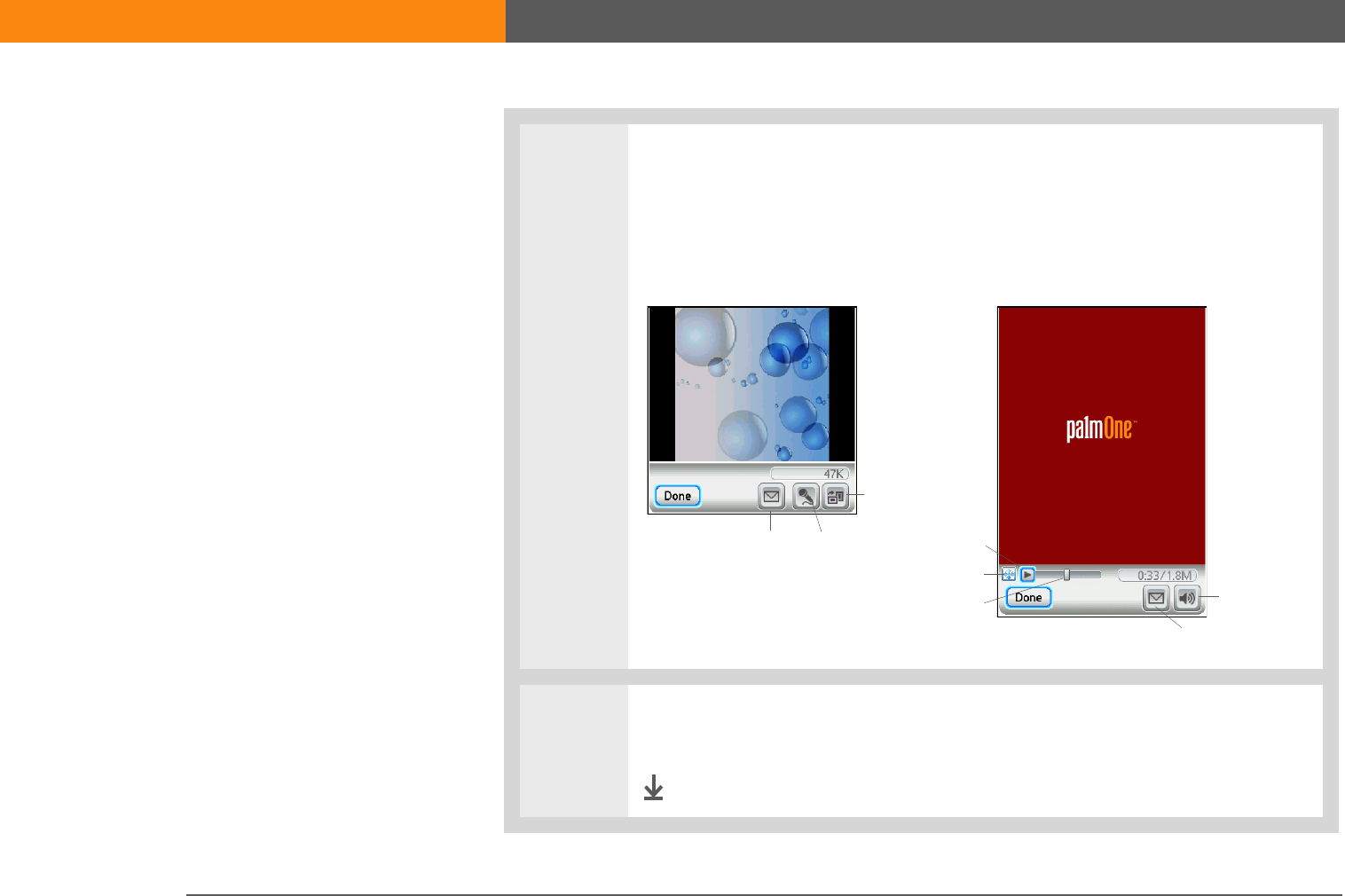
LifeDrive from palmOne 196
CHAPTER 9 Viewing Your Photos and Videos
4[ & ] OPTIONAL Access controls:
• For photos, press Up on the 5-way navigator to zoom in. Press Down to
access the photo controls.
• For videos, press Center to access video controls.
5Press Center or tap anywhere in the photo or video to return to the Thumbnail
View screen.
Done
Photo Video
Volume
Play or Pause
Rotate
Add audio
Progress indicator
Full-screen view
Send
Send
SECOND DRAFT palmOne, Inc. Confidential

LifeDrive from palmOne 197
CHAPTER 9 Viewing Your Photos and Videos
Viewing a photo or video in the List View
0
1Press the Media button.
2Go to the folder or album where
the photo or video is located:
a. Select Device or
Expansion Card .
b. Tap Location pick list in the
upper-right corner and select
the location of the photo or
video you want to view:
• If the photo or video is in the
Photos & Videos folder on your
device’s hard drive or on an
expansion card, select the
correct location from the list.
• If the photo or video is located
elsewhere on your device’s
hard drive, select Browse, and
then browse to the item.
Continued
Expansion card
Device
Location
pick list
SECOND DRAFT palmOne, Inc. Confidential
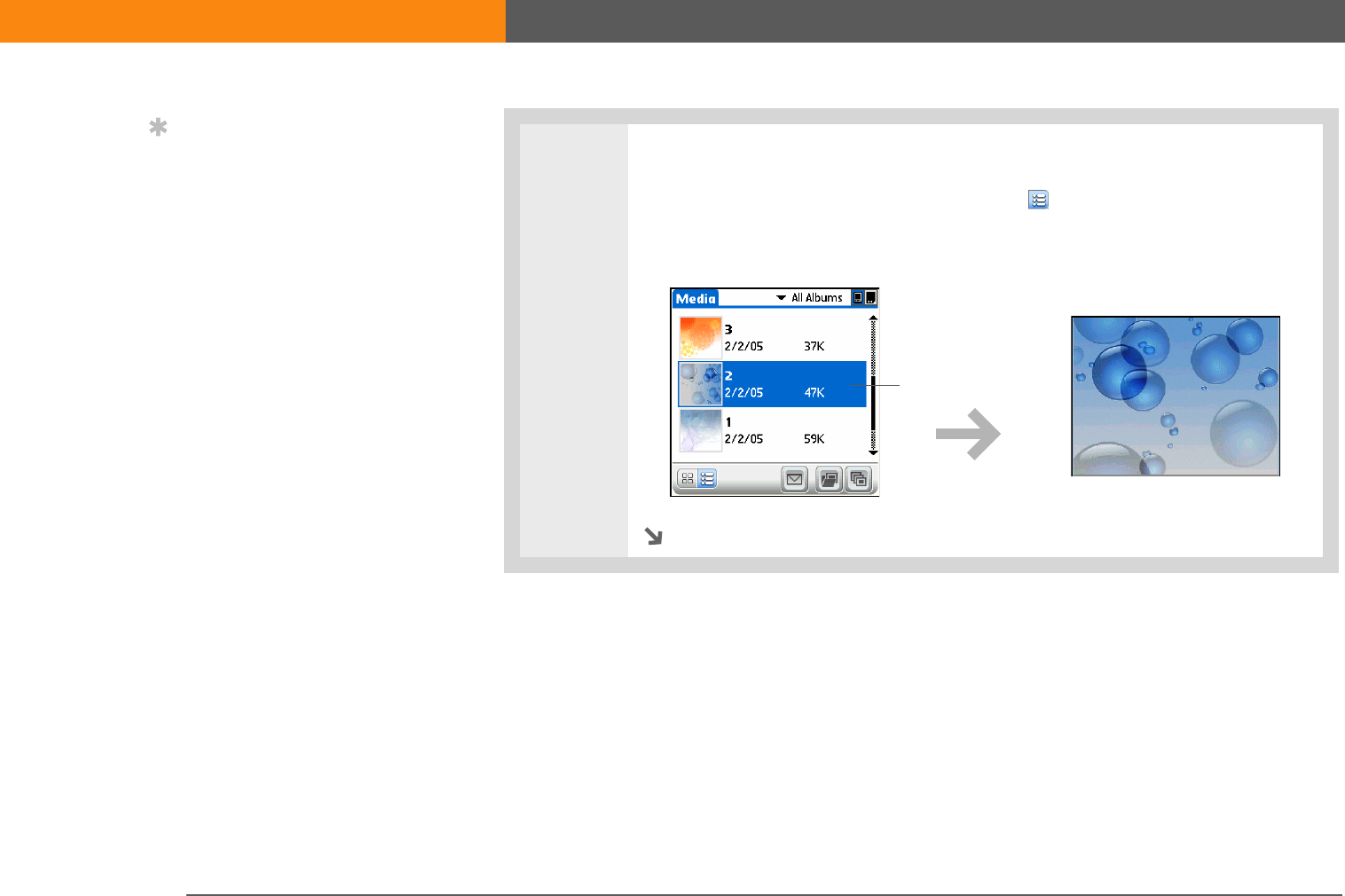
LifeDrive from palmOne 198
CHAPTER 9 Viewing Your Photos and Videos
3Select a photo or video:
a. If the List View is not displayed, select List in the lower-left corner.
b. Select the photo or video you want to view. A video automatically starts
playing when you select it.
Continued
Tip
If a photo is larger than
your device’s screen—
either because of its
original size or because
you have zoomed in—tap
and drag with the stylus
to view different parts of
the photo.
Select a photo or
video to view
SECOND DRAFT palmOne, Inc. Confidential
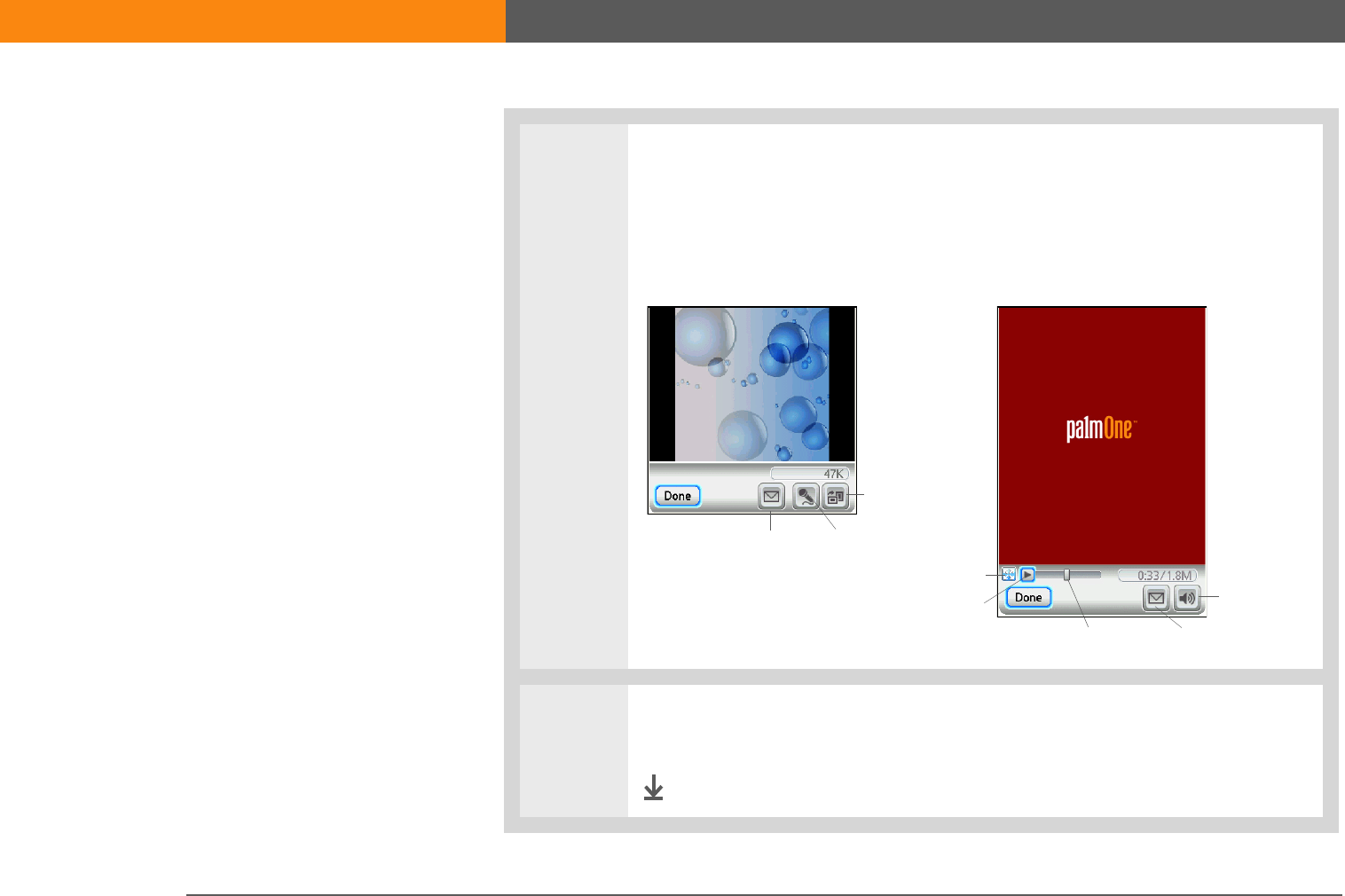
LifeDrive from palmOne 199
CHAPTER 9 Viewing Your Photos and Videos
4[ & ] OPTIONAL Access controls:
• For photos, press Up on the 5-way navigator to zoom in. Press Down to
access the photo controls.
• For videos, press Center to access video controls.
5Press Center or tap anywhere in the photo or video to return to the List View
screen.
Done
Photo Video
Volume
Play or Pause
Rotate
Add audio
Progress indicator
Full-screen view
Send
Send
SECOND DRAFT palmOne, Inc. Confidential
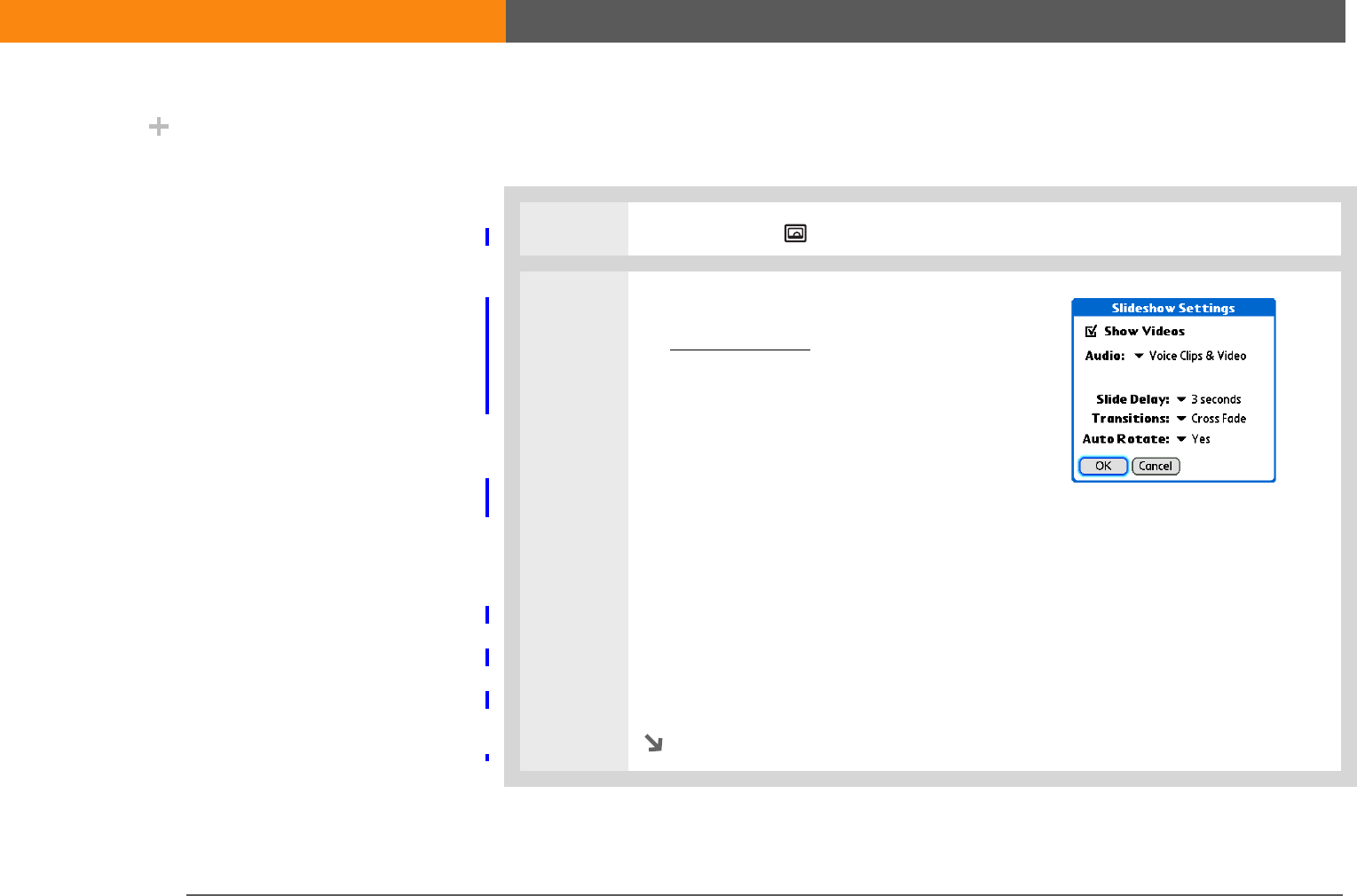
LifeDrive from palmOne 200
CHAPTER 9 Viewing Your Photos and Videos
Viewing a slide show
By default, both photos and videos in an album are displayed during a slide show.
0
1Press the Media button.
2[ & ] OPTIONAL Set the slide show settings:
a. Open the menus.
b. Select Options and then select
Slideshow.
c. Adjust the settings:
Show Videos Show videos during the
slide show.
Audio Add or remove audio. Play the photo voice clips and video sound or
background music.
Slide Delay Select the time each photo displays.
Transitions Select the type of transition between slides.
Auto Rotate Automatically rotate the photo or video for optimal viewing.
Continued
Did You Know?
In a slide show, videos
play through in their
entirety before the next
item appears.
SECOND DRAFT palmOne, Inc. Confidential
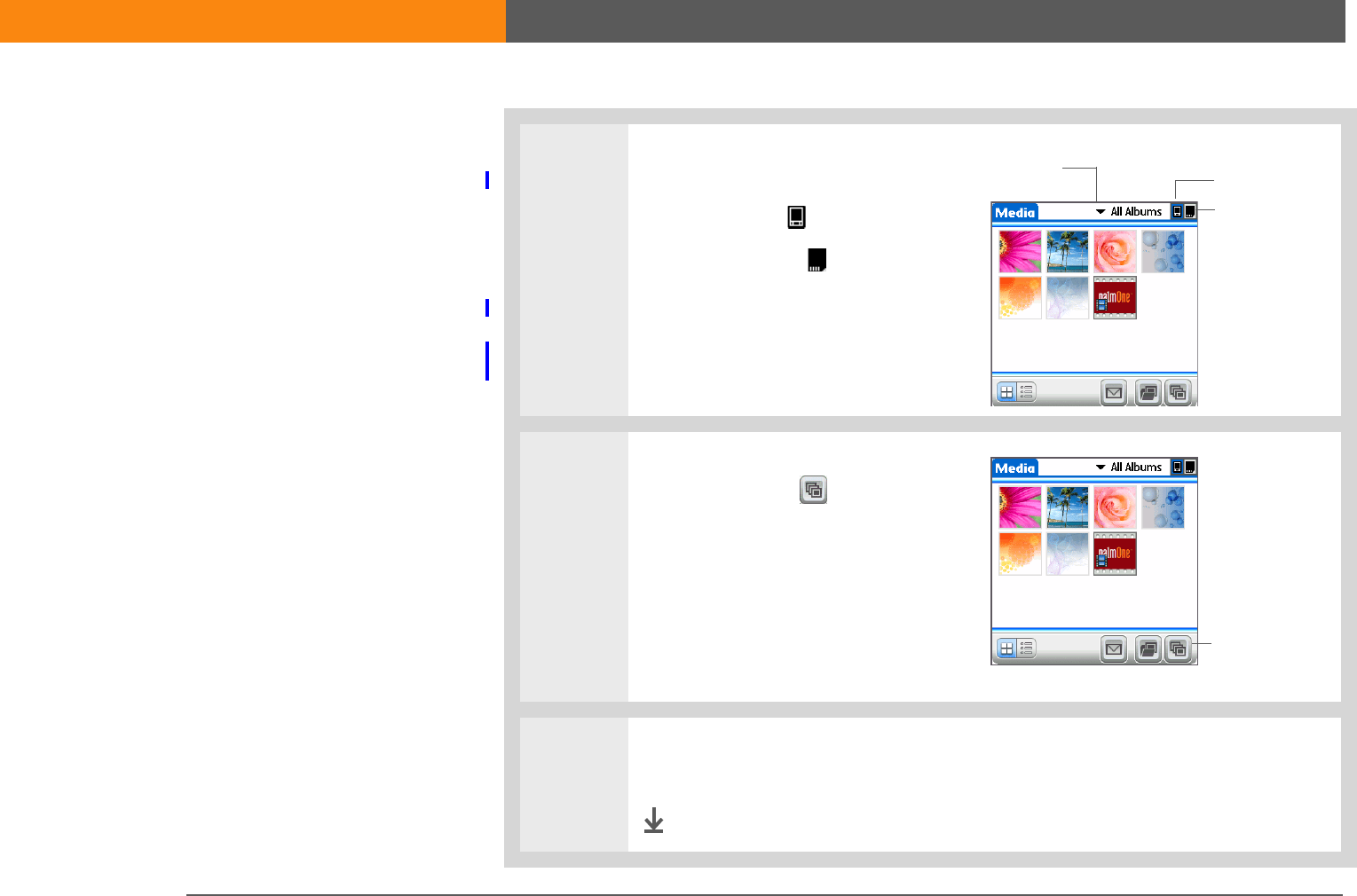
LifeDrive from palmOne 201
CHAPTER 9 Viewing Your Photos and Videos
3Go to the folder or album where
the photos or videos are located:
a. Select Device or
Expansion Card .
b. Select the Location pick list in
the upper-right corner and
select the location of the photos
or videos you want to view.
4In the Thumbnail or List View,
select Slide Show .
5Press Center or tap a photo or video to stop the slide show and return to the
Thumbnail or List View.
Done
Expansion card
Device
Location
pick list
Slide Show
SECOND DRAFT palmOne, Inc. Confidential
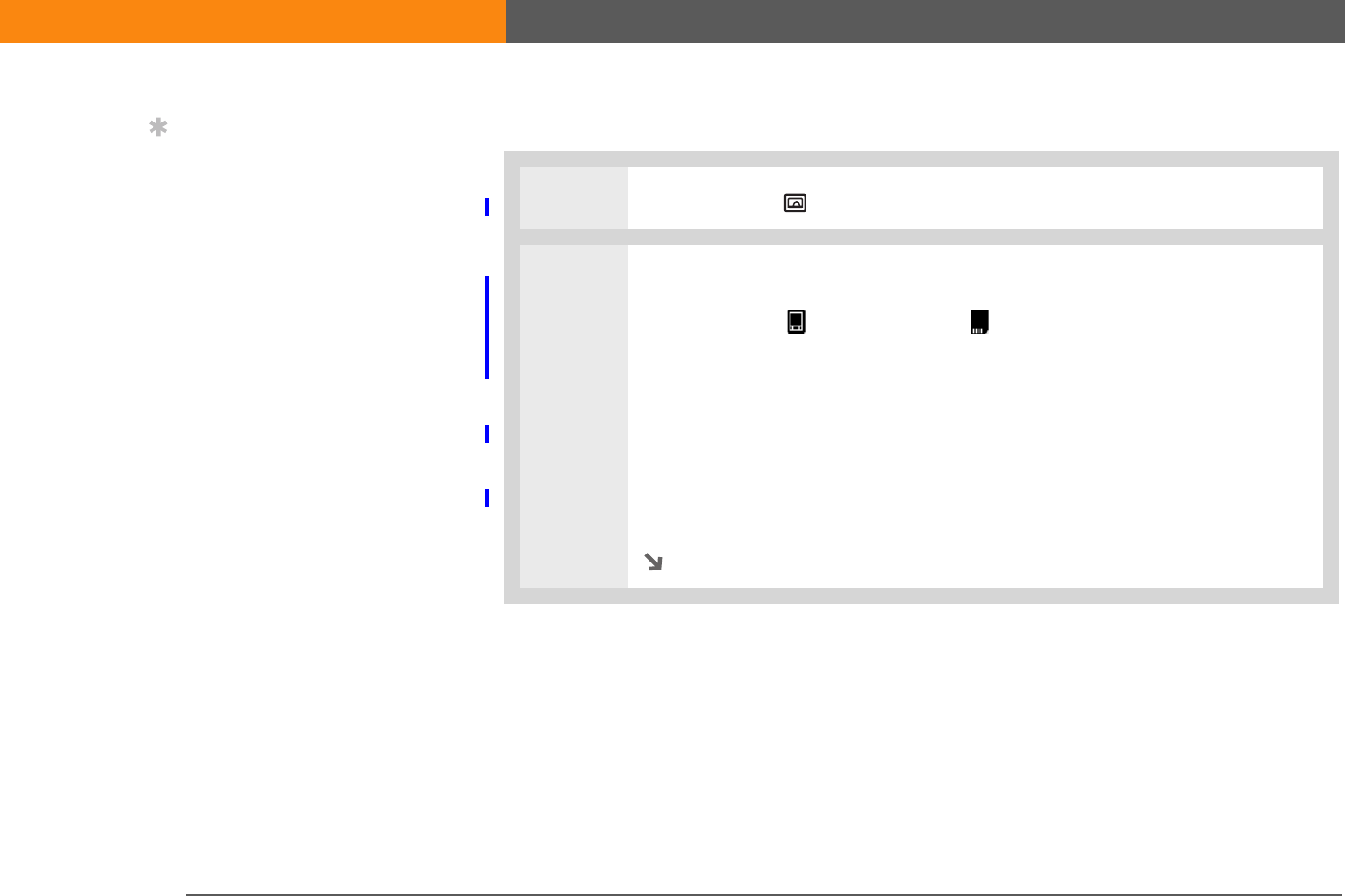
LifeDrive from palmOne 202
CHAPTER 9 Viewing Your Photos and Videos
Rotating a photo
0
0
1Press the Media button.
2Go to the folder or album where the photo is located:
a. Select Device or Expansion Card .
b. Select the Location pick list in the upper-right corner and select the location
of the photo or video you want to view:
• If the photo is in the Photos & Videos folder on your device’s hard drive or on
an expansion card, select the correct location from the list.
• If the photo is located elsewhere on your device’s hard drive, select Browse,
and then browse to the item.
Continued
Tip
You can also rotate a
photo by pressing Down
on the 5-way to zoom the
photo out and then
selecting Rotate at the
bottom of the screen.
SECOND DRAFT palmOne, Inc. Confidential
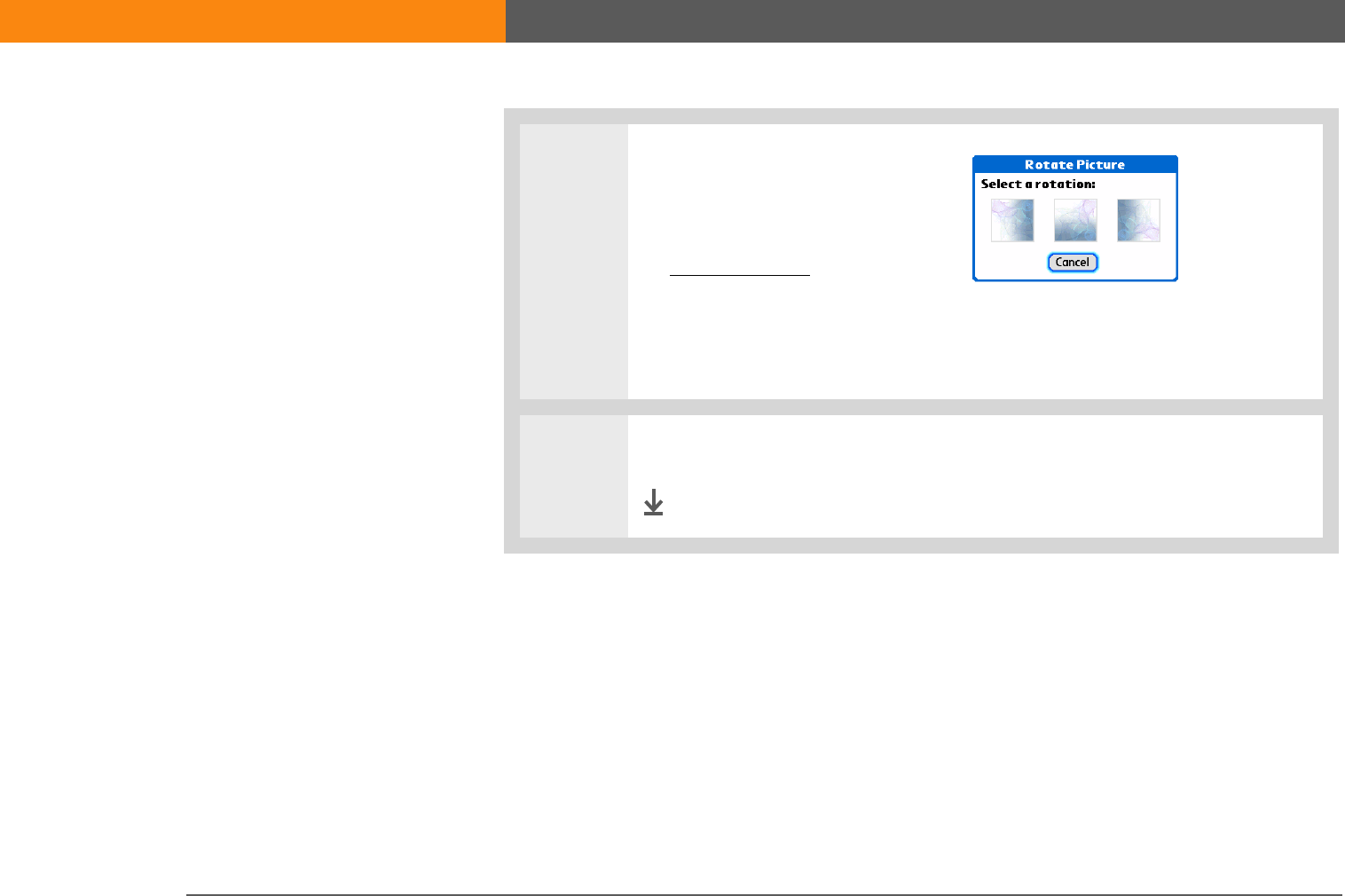
LifeDrive from palmOne 203
CHAPTER 9 Viewing Your Photos and Videos
3Rotate the photo:
a. Select the photo you want in
the Thumbnail or List View.
b. Open the menus.
c. Select Rotate Picture from the
Media menu.
d. Select the rotation you want.
4Tap anywhere in the photo to return to the Thumbnail or List View.
Done
SECOND DRAFT palmOne, Inc. Confidential
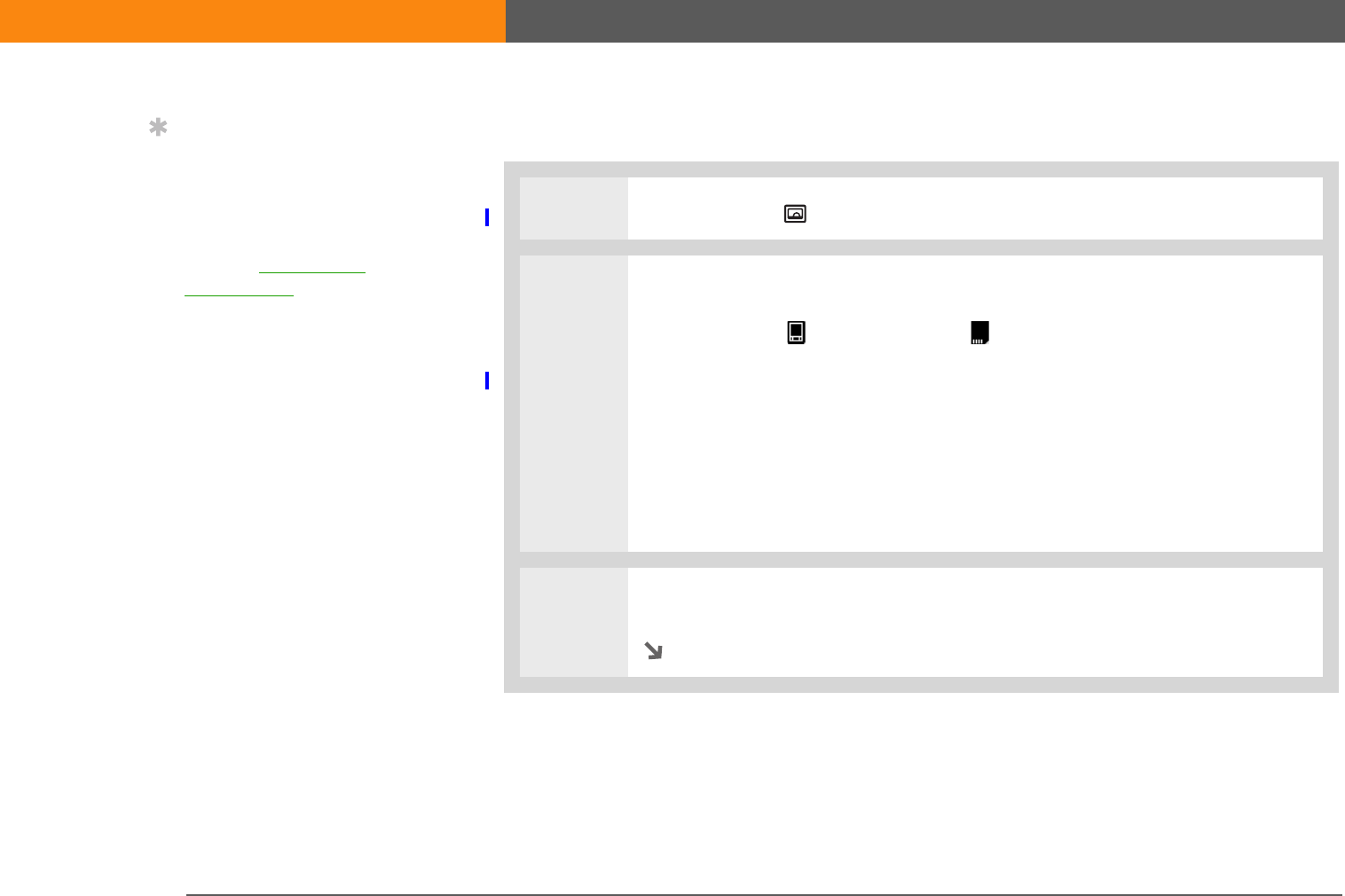
LifeDrive from palmOne 204
CHAPTER 9 Viewing Your Photos and Videos
Viewing and editing photo or video details
0
0
1Press the Media button.
2Go to the folder or album where the photo or video is located:
a. Select Device or Expansion Card .
b. Select the Location pick list in the upper-right corner and select the location
of the photo or video you want to view:
• If the photo or video is in the Photos & Videos folder on your device’s hard
drive or on an expansion card, select the correct location from the list.
• If the photo or video is located elsewhere on your device’s hard drive, select
Browse, and then browse to the item.
3Select the photo or video whose details you want to view.
Continued
Tip
You can also view details
for an entire album—
including last date
changed, number of
items in the album, and
size—by opening the
Album menu and
selecting Album Details.
SECOND DRAFT palmOne, Inc. Confidential
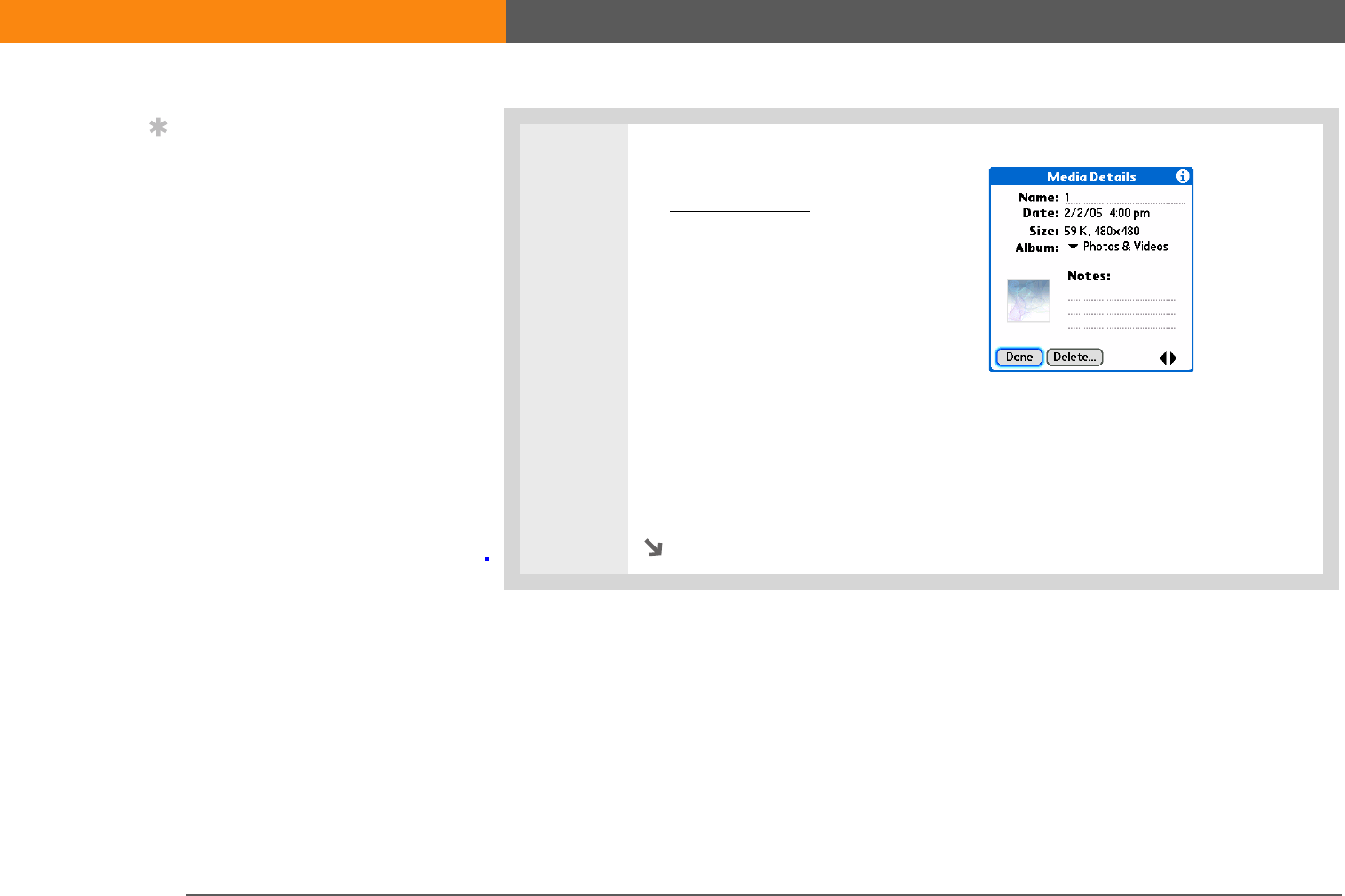
LifeDrive from palmOne 205
CHAPTER 9 Viewing Your Photos and Videos
4View photo or video details:
a. Open the menus.
b. Select Edit Details from the
Media menu.
c. In addition to viewing photo or
video details, you can do the
following:
Change name Select the photo or video name and enter a new name.
Move to different album Select the Album pick list and select a new album
location for the photo or video.
Add notes Select the Notes field and enter a note for the photo or video.
Continued
Tip
Select the scroll arrows at
the bottom of the Media
Details screen to view
other photos in the
album.
»
Key Term
EXIF Exchangeable
Image File Format is a
standard for storing
interchange information
in image files. Most
digital cameras use the
EXIF format.
SECOND DRAFT palmOne, Inc. Confidential
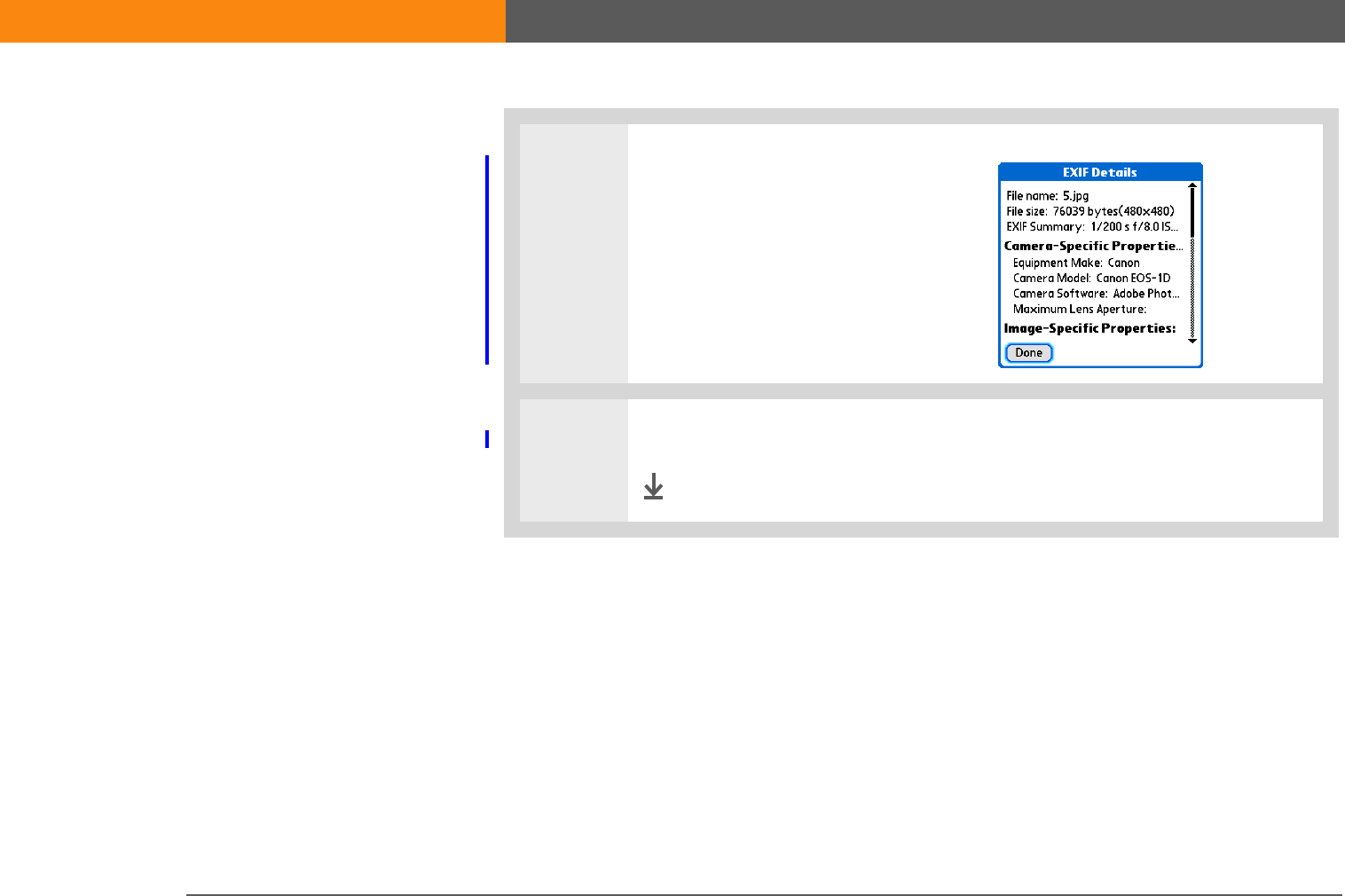
LifeDrive from palmOne 206
CHAPTER 9 Viewing Your Photos and Videos
5[ & ] OPTIONAL If the photo
was taken from a digital camera
that uses the EXIF format, you
can view the EXIF information
about the photo:
a. Select EXIF.
b. Select Done when finished
viewing the EXIF details.
6When finished editing and viewing details, select Done.
Done
SECOND DRAFT palmOne, Inc. Confidential
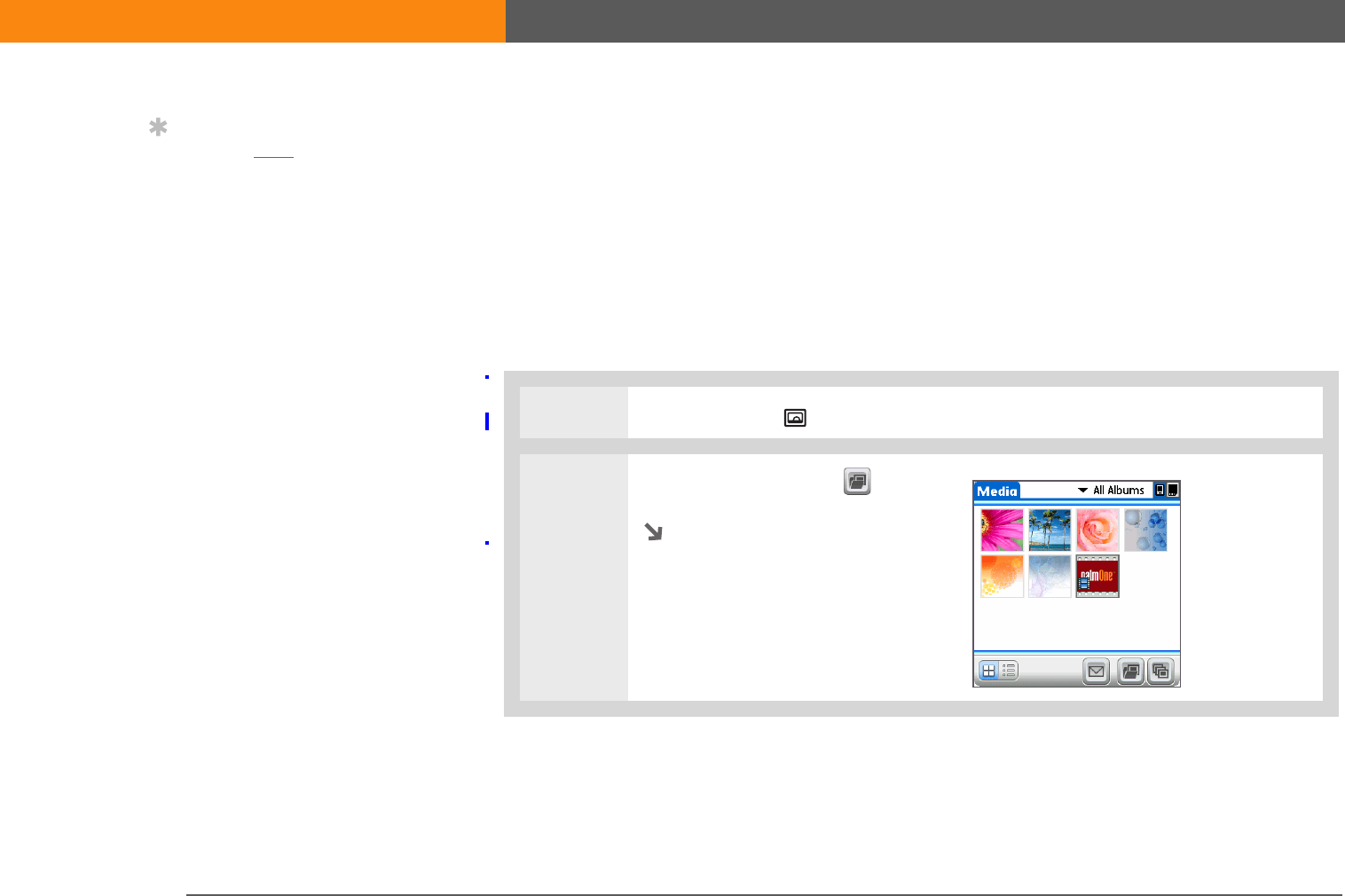
LifeDrive from palmOne 207
CHAPTER 9 Viewing Your Photos and Videos
Organizing photos and videos
You can organize your photos and videos in the following ways:
• Create albums and place your photos and videos in those albums.
• Move photos and videos within or between albums.
• Sort photos and videos in the List View.
Organizing photos or videos into albums
0
1Press the Media button.
2Select Manage Albums .
Continued
Tip
Use the copy feature to
move a photo from your
device to a card and vice
versa. If a photo is stored
on your device, you can
add it only to an album
located on the device.
Likewise, if a photo is
stored on an expansion
card, you can add it only
to an album that is on the
same card.
SECOND DRAFT palmOne, Inc. Confidential
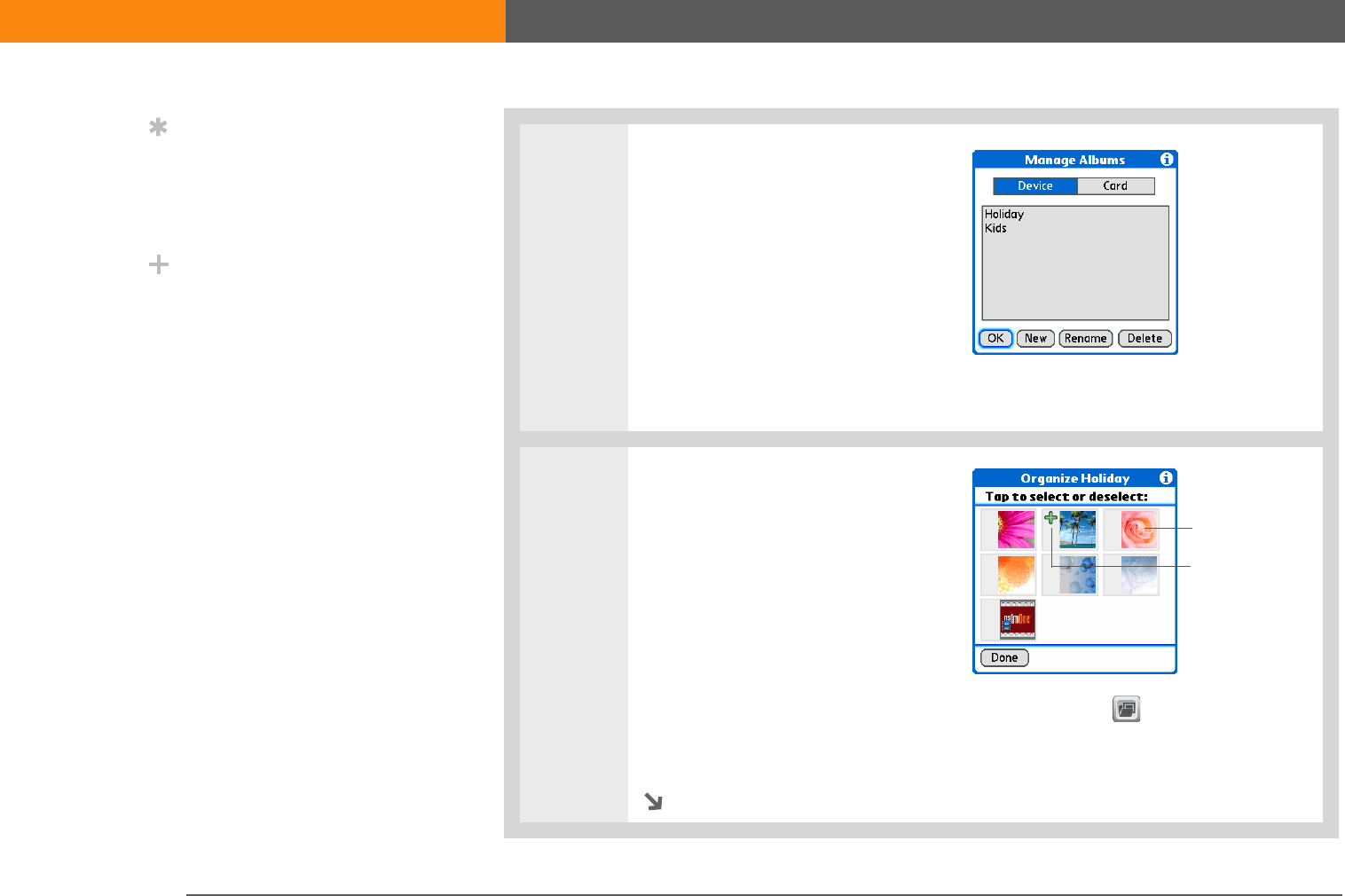
LifeDrive from palmOne 208
CHAPTER 9 Viewing Your Photos and Videos
3[ & ] OPTIONAL Create an
album:
a. Select whether to create the
album on your device or on
an expansion card inserted
into the expansion slot.
b. Select New, enter the name of
the new album, and select OK.
c. Select OK on the Manage
Albums screen.
4Do one of the following:
To add photos or videos to a new
album Select the photos or videos
you want on the Organize Album
screen.
To add or remove photos or videos
from an existing album From the
Thumbnail or List View, select the
album you want from the pick list in
the upper-right corner, and then select Manage Albums . Select a photo or
video without a plus sign to add it to the album; select a photo or video with a
plus sign to remove it from the album.
Continued
Tip
Drag the stylus across
multiple photos and/or
videos to add or remove
them all at once.
Did You Know?
If you remove a photo or
video from an album, it is
moved to the Unfiled
category. The photo or
video is not deleted from
your device or the
expansion card.
Select to add
Select + to
remove
SECOND DRAFT palmOne, Inc. Confidential
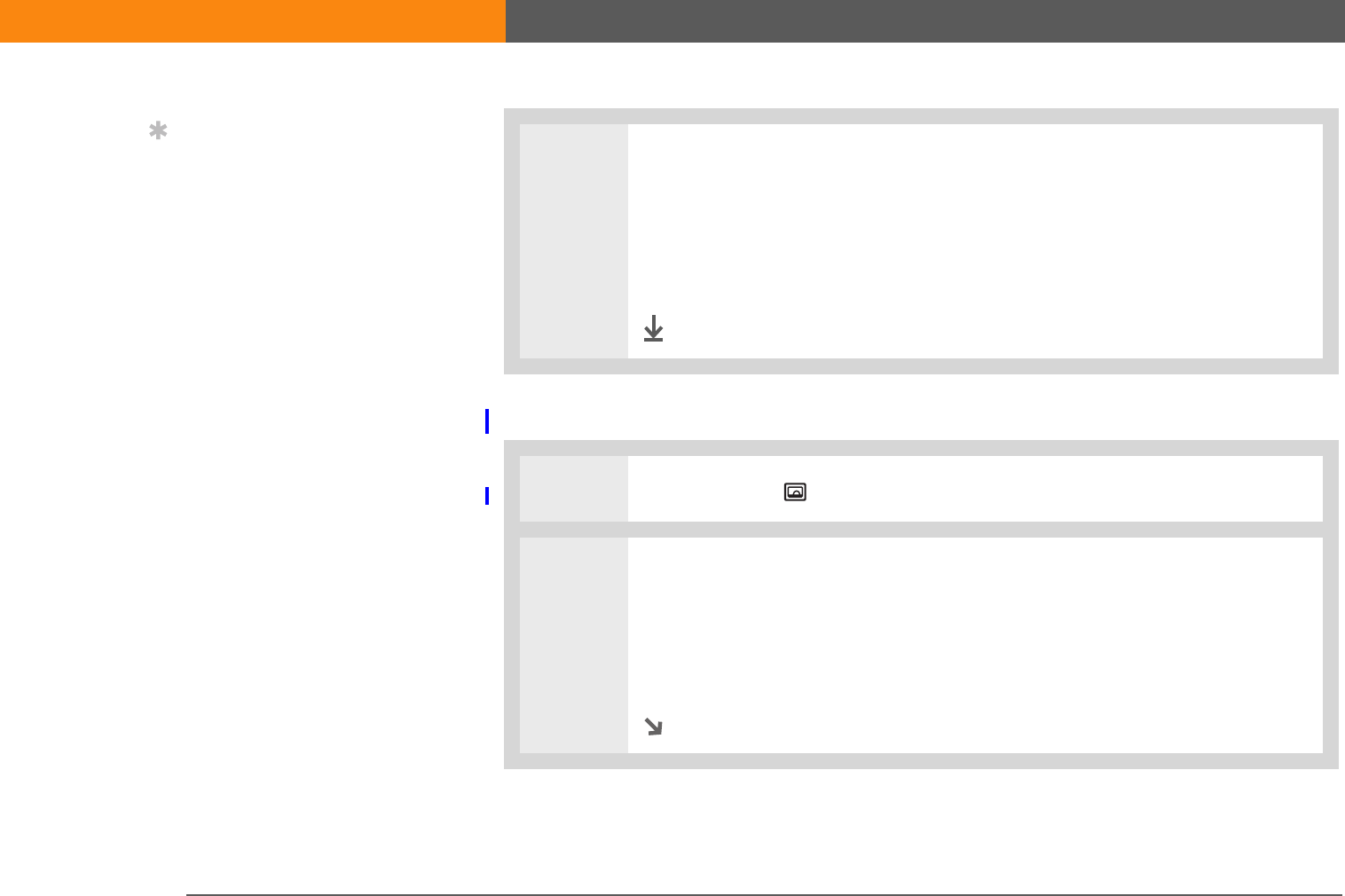
LifeDrive from palmOne 209
CHAPTER 9 Viewing Your Photos and Videos
Moving a photo or video within and between albums
0
5Move photos or videos within albums:
a. Tap the pick list in the upper-right corner and select the album in which you
want to move photos or videos.
b. Select the photo you want to move, and drag the stylus to move the photo or
video to the desired location.
Done
1Press the Media button.
2Move a photo or video within an album:
a. Select the pick list in the upper-right corner and select the album containing
the photo or video you want to move.
b. Use the stylus to drag the photo or video you want to its new position.
Continued
Tip
Move photos within
albums to easily put the
slide show of your child’s
birthday party in the
sequence you want.
SECOND DRAFT palmOne, Inc. Confidential
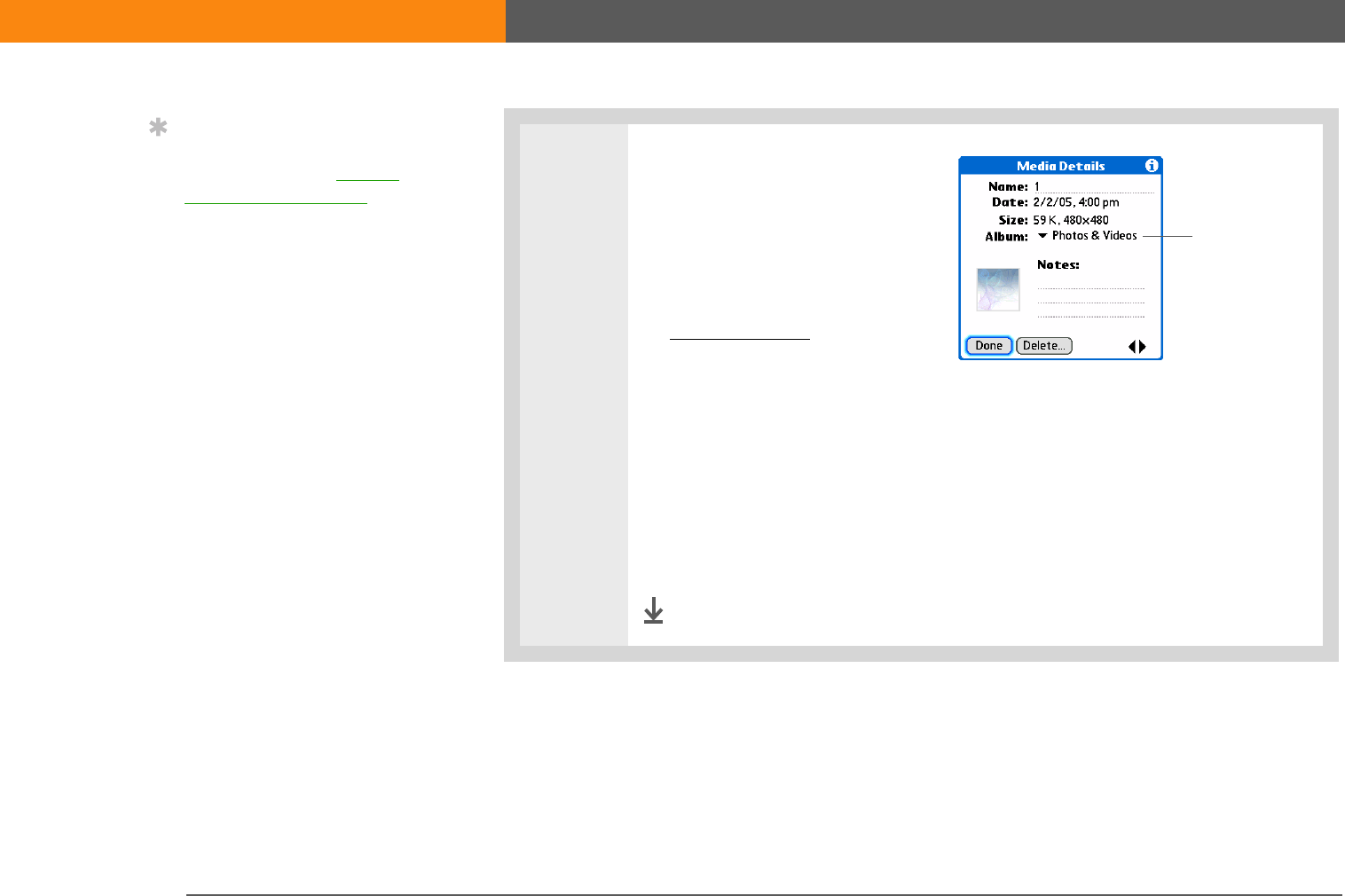
LifeDrive from palmOne 210
CHAPTER 9 Viewing Your Photos and Videos
3Move a photo or video between
albums:
a. Select the pick list in the upper-
right corner and select the
album containing the photo or
video you want to move.
b. Open the menus.
c. Select Edit Details from the
Media menu, and then select the
photo or video you want to
move.
d. Select the Album pick list, and
then select the new album for
the photo.
e. Select Done.
Done
Tip
You can also move a
photo or video by adding
it to a different album.
The item is removed from
the original album. Select to
move photo
or video
SECOND DRAFT palmOne, Inc. Confidential
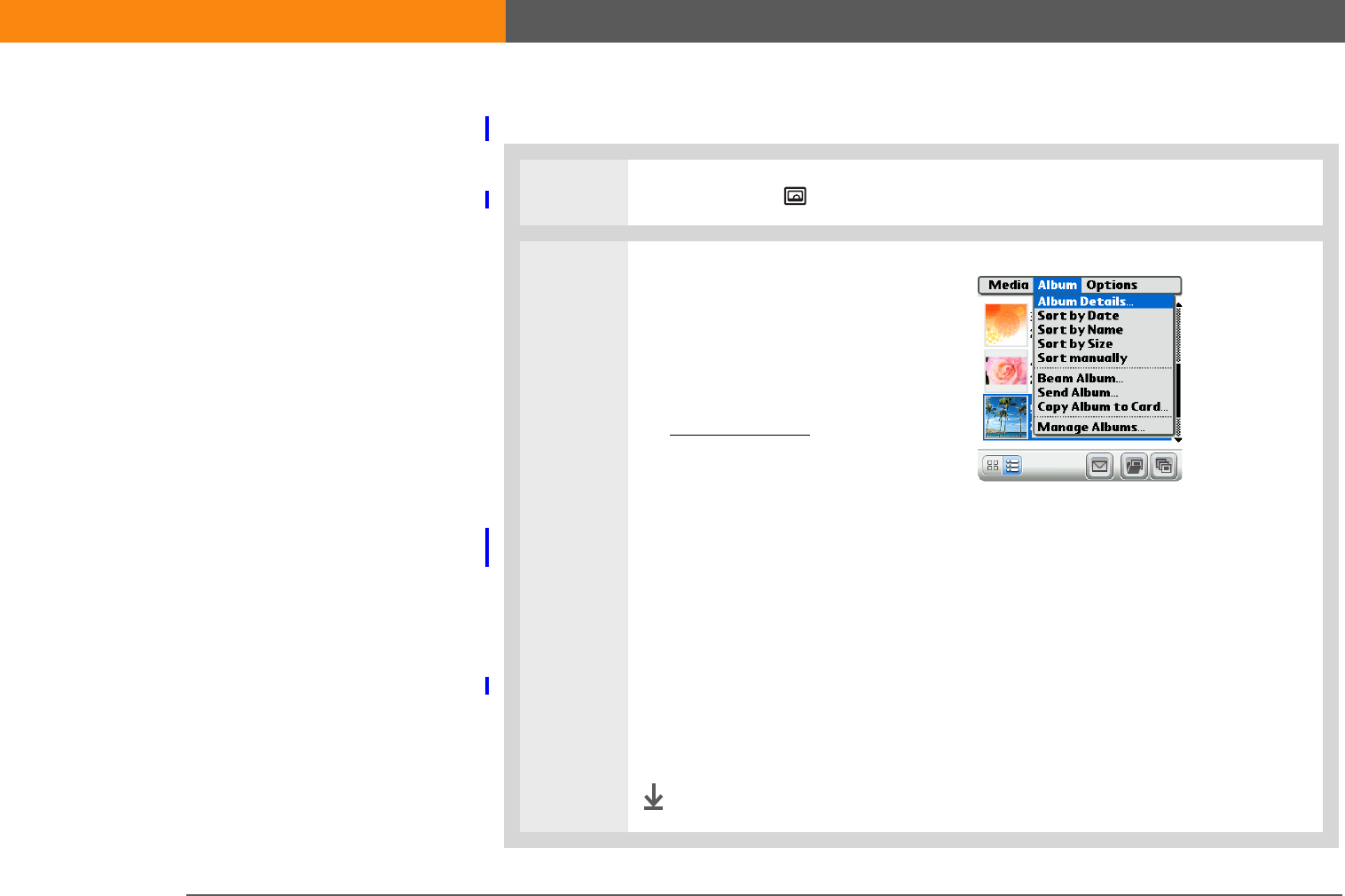
LifeDrive from palmOne 211
CHAPTER 9 Viewing Your Photos and Videos
Sorting photos and videos
0
1Press the Media button.
2Sort photos and videos:
a. Select the pick list in the upper-
right corner and select the
album containing the photos
and/or videos you want to sort.
b. Open the menus.
c. Select Album, and then select
one of the following:
Sort by Date Lists photos and videos from the earliest to the most recent date.
Select Sort by Date again to list items from the most recent to the earliest date.
Sort by Name Lists photos and videos by name in ascending (A–Z) order.
Select Sort by Name again to list items by name in descending (Z–A) order.
Sort by Size Lists photos and videos from smallest to largest file size. Select
Sort by Size again to list items from largest to smallest file size.
Sort manually Lets you tap a photo or video and drag the stylus to where you
want the item to appear. A dotted black line indicates the position of the item.
Done
Before You Begin
[!]
You must be in an album
to sort manually. You
cannot sort when All
Albums is selected from
the pick list.
SECOND DRAFT palmOne, Inc. Confidential
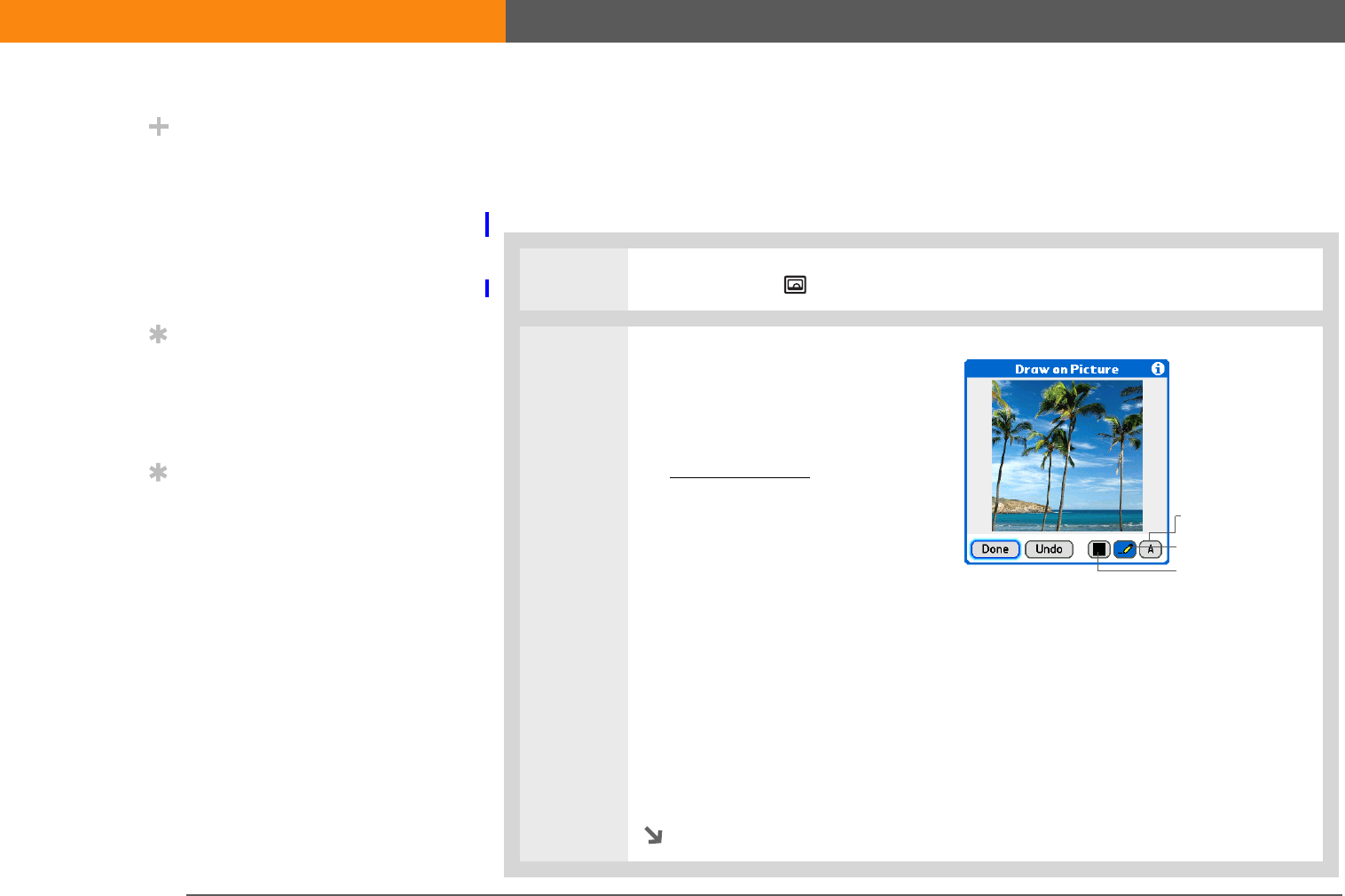
LifeDrive from palmOne 212
CHAPTER 9 Viewing Your Photos and Videos
Personalizing a photo
To add a personal touch to a photo, use the drawing tool or add a voice clip.
Drawing on a photo
1Press the Media button.
2Draw on a photo:
a. In the Thumbnail or List View,
select the photo you want.
b. Open the menus.
c. Select Draw on Picture from the
Media menu.
d. Draw on the photo using the
following tools:
Drawing tool Draw anywhere on the photo using the stylus.
Text tool Enter text in the field. Tap anywhere on the screen to open a text field
in a new location.
Color button Select a drawing color.
e. Select Done.
Continued
Did You Know?
Create multicolored art:
Select a color and draw
on a photo, and then
select a different color
and draw some more.
Each drawing keeps its
original color.
Tip
Select the drawing tool
button to change line size.
Select the text tool button
to change font size.
Tip
Use the eraser selection
on the drawing tool to
erase drawings only;
select Undo to delete text.
You can use Undo only
once to delete text for a
given photo. If you need
to delete text after using
Undo, select Done and do
not save the photo, and
then open the photo and
try again.
Text tool
Color button
Drawing tool
SECOND DRAFT palmOne, Inc. Confidential
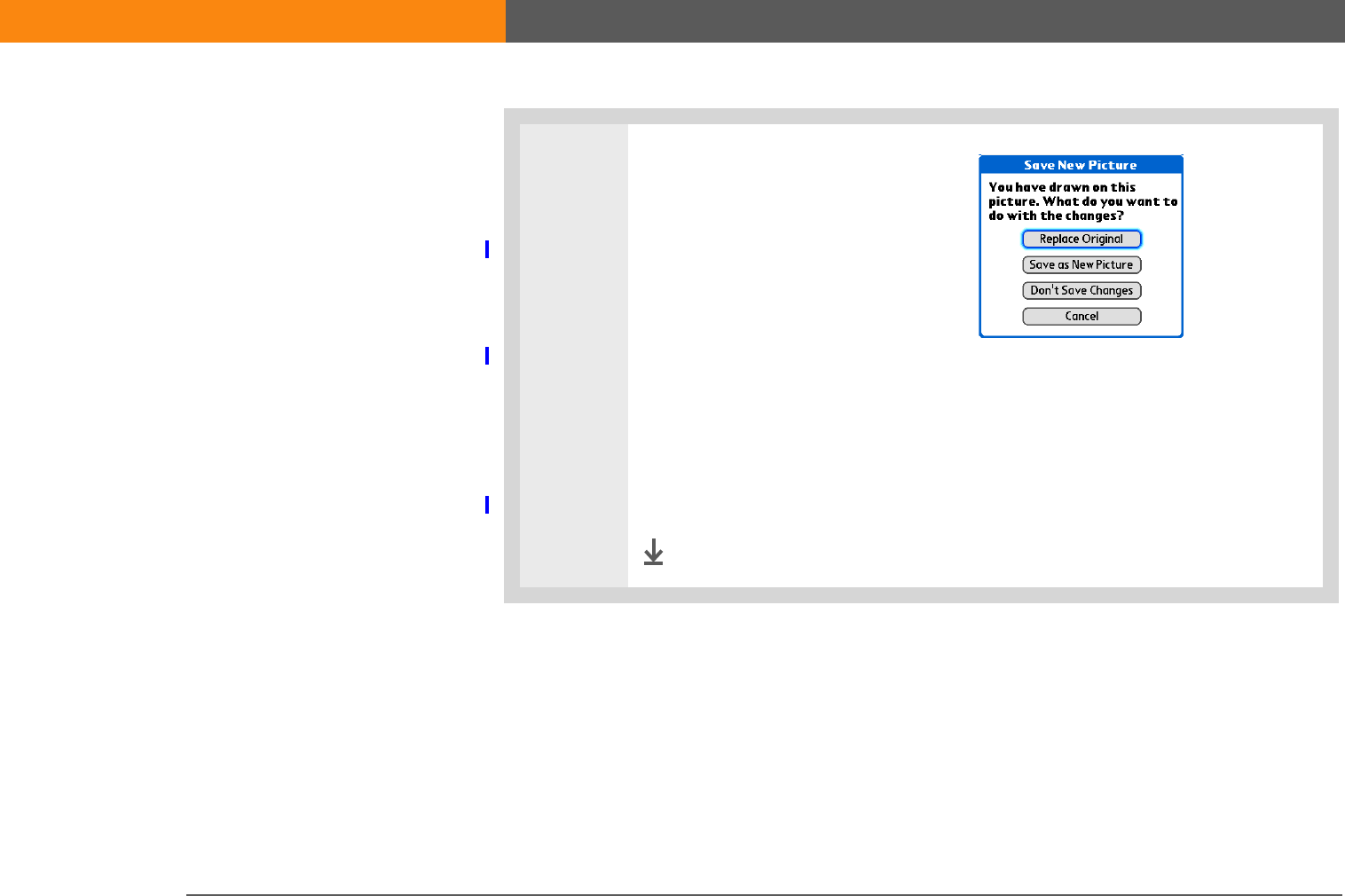
LifeDrive from palmOne 213
CHAPTER 9 Viewing Your Photos and Videos
3Select one of the following to save
or reject changes:
Replace Original Saves the photo
with the drawing in place of the
original photo with no drawing; the
original photo is lost.
Save as New Picture Saves both
the photo with the drawing and the
original photo with no drawing. You can enter a name for the new photo.
You can also select the pick list to save the updated photo to a different
album.
Don’t Save Changes Saves only the original photo with no drawing.
Cancel Returns to the Draw on Photo screen.
Done
SECOND DRAFT palmOne, Inc. Confidential
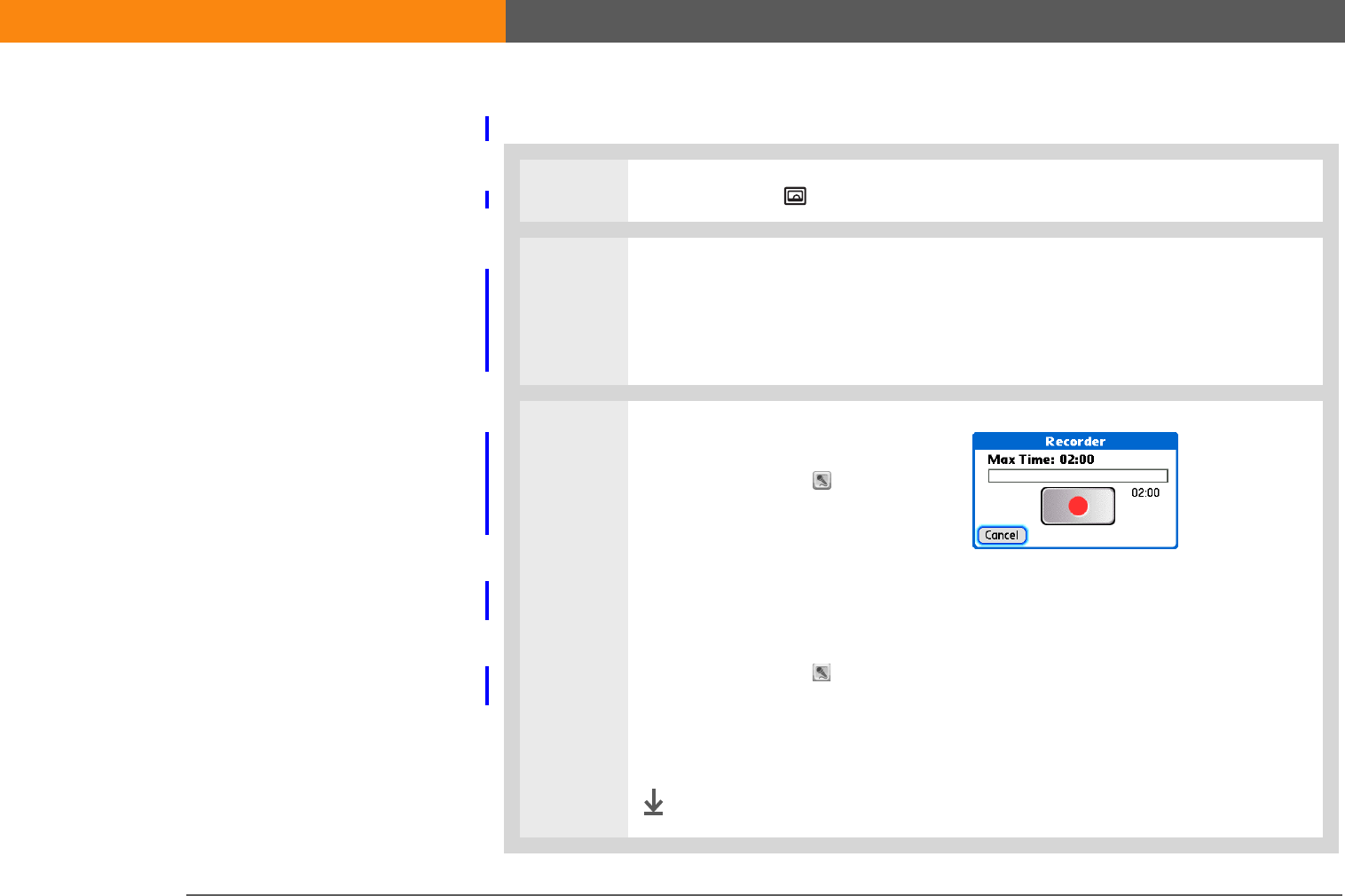
LifeDrive from palmOne 214
CHAPTER 9 Viewing Your Photos and Videos
Adding audio to a photo
1Press the Media button.
2Access the photo controls:
a. In the Thumbnail or List View, select the photo you want.
b. Press Down to access the photo controls.
3Add sound to a photo:
a. Select the Audio button.
b. Select the Record button to
begin recording.
c. Select the Stop Recording
button to stop and close the
Record dialog box.
d. Select the Audio button
and select the Play button to
listen to the audio clip.
e. Select Done.
Done
SECOND DRAFT palmOne, Inc. Confidential
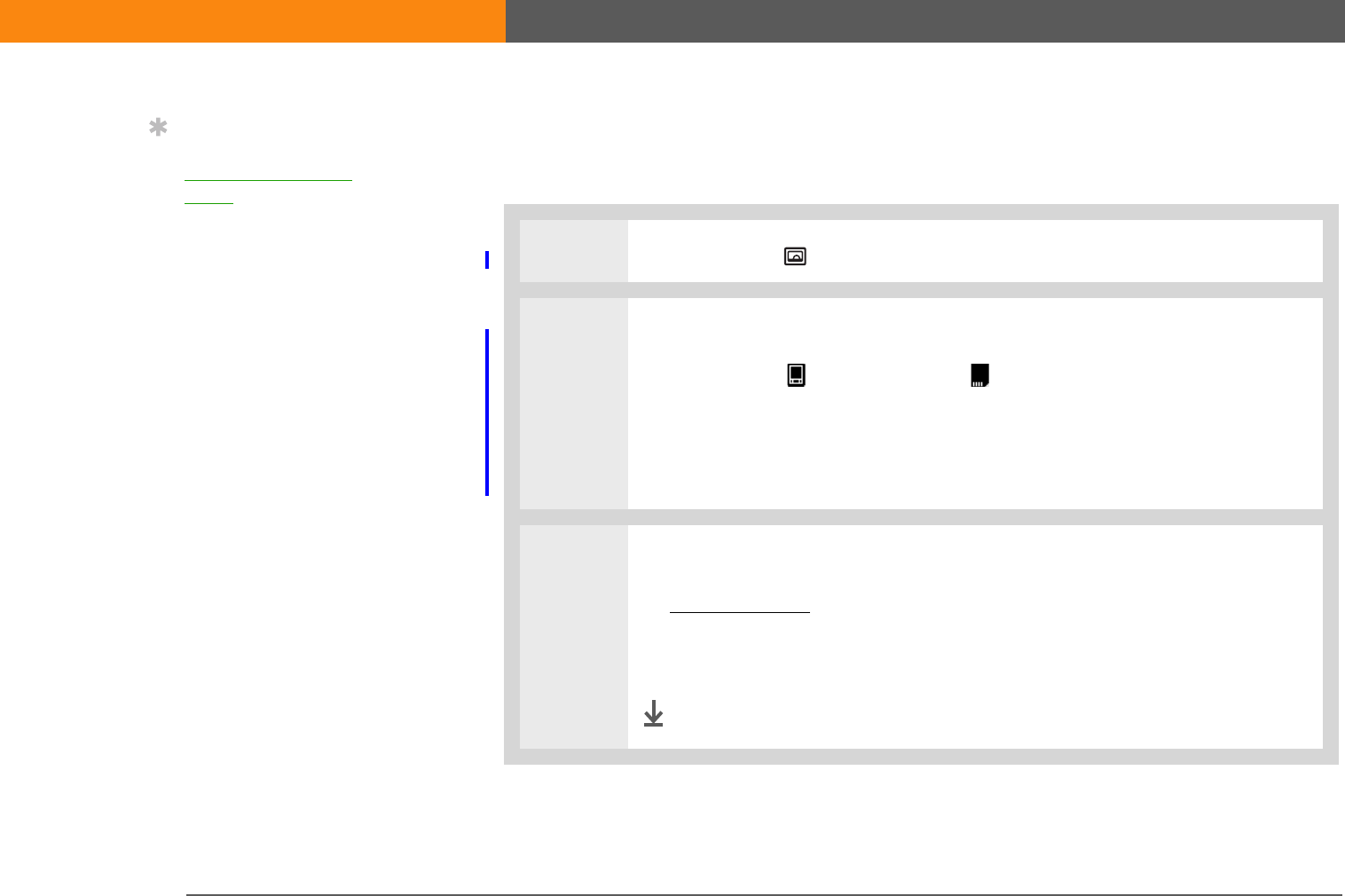
LifeDrive from palmOne 215
CHAPTER 9 Viewing Your Photos and Videos
Copying a photo or video
You can copy photos and videos from your device to an expansion card, and vice versa.
0
1Press the Media button.
2Select a photo or video to copy:
a. Select Device or Expansion Card .
b. Select the Location pick list in the upper-right corner and select the location
of the photos or videos you want to copy.
c. Select the photo or video.
3Copy the photo:
a. Open the menus.
b. Select Copy to Card (for photos or videos on your device) or Copy to Device
(for photos or videos on an expansion card) from the Media menu.
Done
Tip
Copy an entire album by
opening the Album
menu, selecting Album,
and then selecting Copy
Album to Card or Copy
Album to Device. Select
the album you want, and
then select Done when
copying is complete.
SECOND DRAFT palmOne, Inc. Confidential
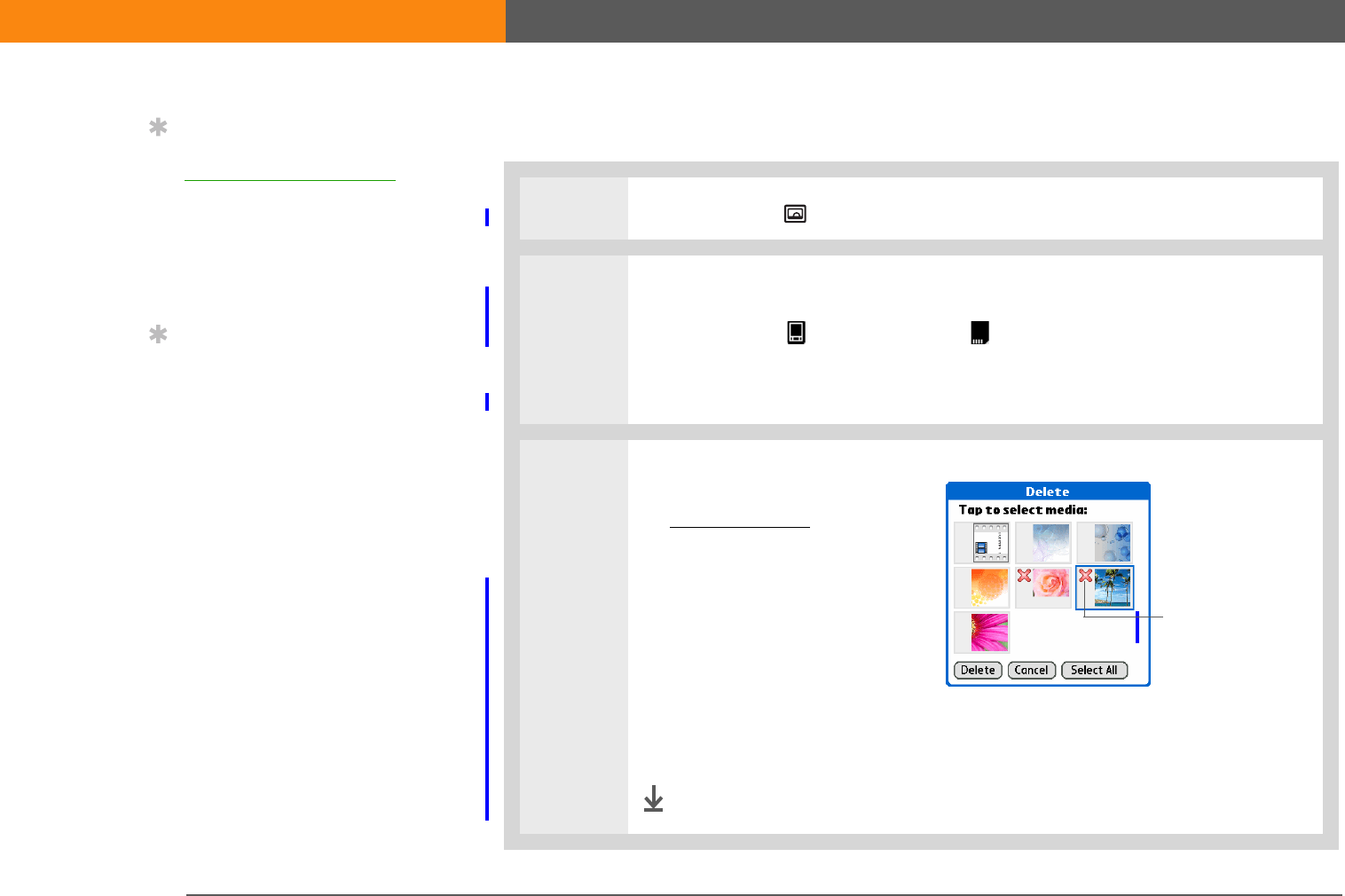
LifeDrive from palmOne 216
CHAPTER 9 Viewing Your Photos and Videos
Deleting a photo or video
0
1Press the Media button.
2Go to the folder or album where the photos or videos are located:
a. Select Device or Expansion Card .
b. Tap Location pick list in the upper-right corner and select the location of the
photos or videos you want to delete.
3Delete the photo or video:
a. Open the menus.
b. Select Delete from the Media
menu.
c. Select the photos or videos
you want to delete.
d. Select Delete.
e. Select Delete in the Delete
Media dialog box.
Done
Tip
Delete an entire album by
opening the Album menu
and selecting Album
Details. Select the album
you want, and then select
Delete on the Album
Details screen.
Tip
You can also delete a
photo or video from the
Media Details screen by
selecting Delete on that
screen.
Marked for
deletion
SECOND DRAFT palmOne, Inc. Confidential

LifeDrive from palmOne 217
CHAPTER 9 Viewing Your Photos and Videos
Sharing photos and videos
You can easily share photos and videos with family and friends. Use your device’s built-in
Bluetooth® wireless technology to wirelessly send photos and videos to other Bluetooth devices
within range.
You can also share photos and videos using any of the following methods:
•Attach a photo or video to an email message.
•Beam a photo or video to other Palm Powered™ devices.
• Copy a photo or video from your device to your desktop computer, or from computer to device,
by using LifeDrive Manager (Windows). You can also copy a photo or video from your Mac to
your device using the Send to Handheld droplet.
Sending a large number of photos or videos using Bluetooth technology or beaming
can take a long time.
Tip
You can also beam or
send an entire album by
opening the Album menu
and selecting Beam
Album or Send Album.
NOTE
SECOND DRAFT palmOne, Inc. Confidential

LifeDrive from palmOne 218
CHAPTER 9 Viewing Your Photos and Videos
Related topics
Click a link below to learn about these related topics:
Camera
Companion
• Copying photos and videos from your camera card
• Viewing photos and videos on your camera card
• Deleting all photos and videos on your camera card
Sharing Sending information using wireless technology on your device
Email Sending photos and videos as attachments to email messages
Tips & Tricks
Make your device uniquely
yours. For great tips,
software, accessories, and
more, visit
www.palmOne.com/
mylifedrive.
Support
If you’re having problems
with Media or with anything
else on your device, go to
www.palmOne.com/
support.
SECOND DRAFT palmOne, Inc. Confidential
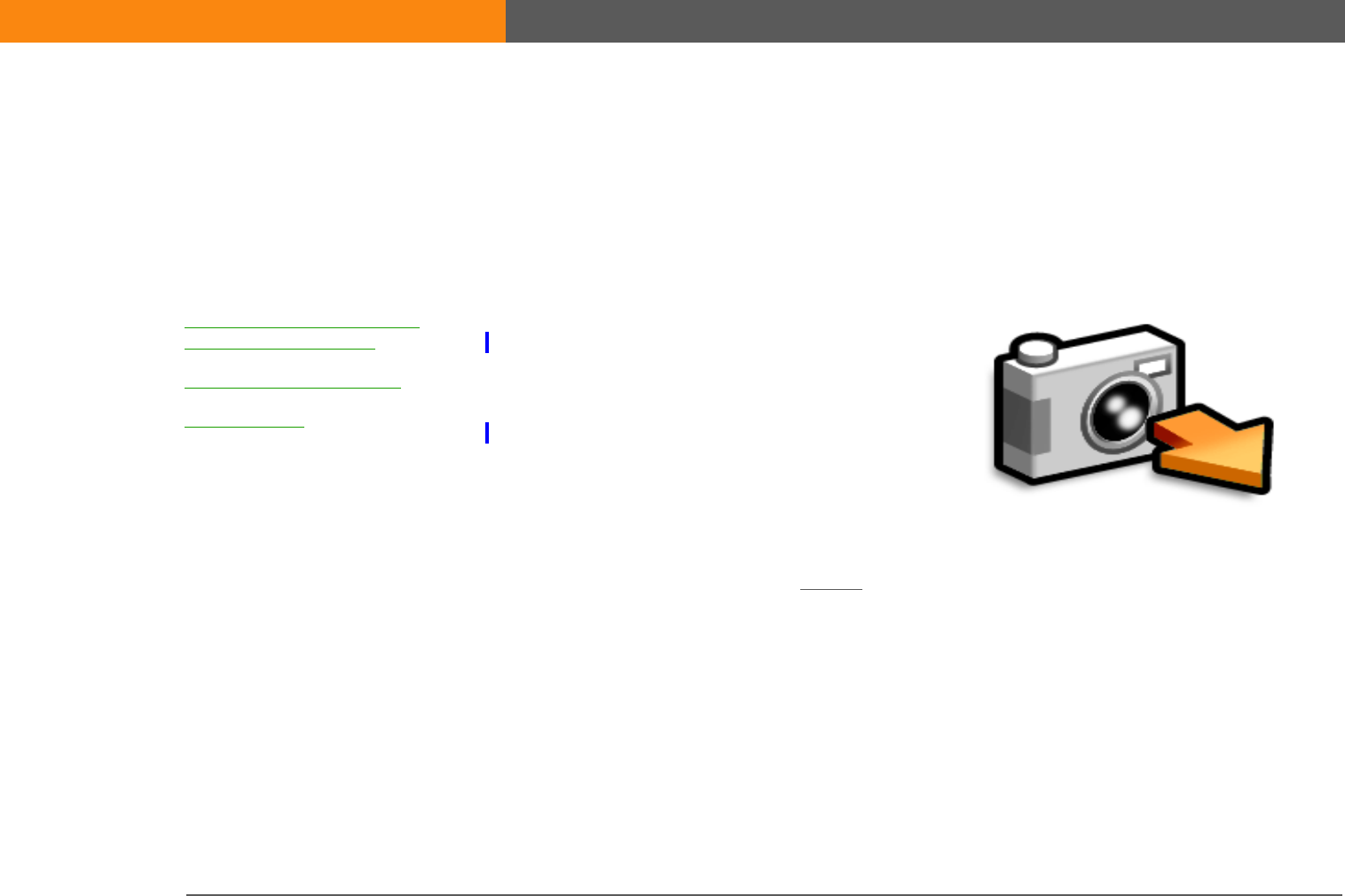
LifeDrive from palmOne 219
CHAPTER 10
Managing Your Camera Card Media
Maybe you have just filled your digital
camera card and you want to keep
taking pictures. Do you want to review
your pictures on a larger screen? You
can do this and more with palmOne™
Camera Companion. You can quickly
transfer your digital camera card
contents to your device or computer so
that you can keep taking pictures. You
can also easily organize your photos
and videos with palmOne™Media.Benefits
• Transfer your camera card contents
to your device
• Store multiple videos and hundreds
of photos
• View camera card contents
I
n t
hi
s c
h
apter
Copying photos and videos
from your camera card
Viewing photos or videos
Related topics
SECOND DRAFT palmOne, Inc. Confidential
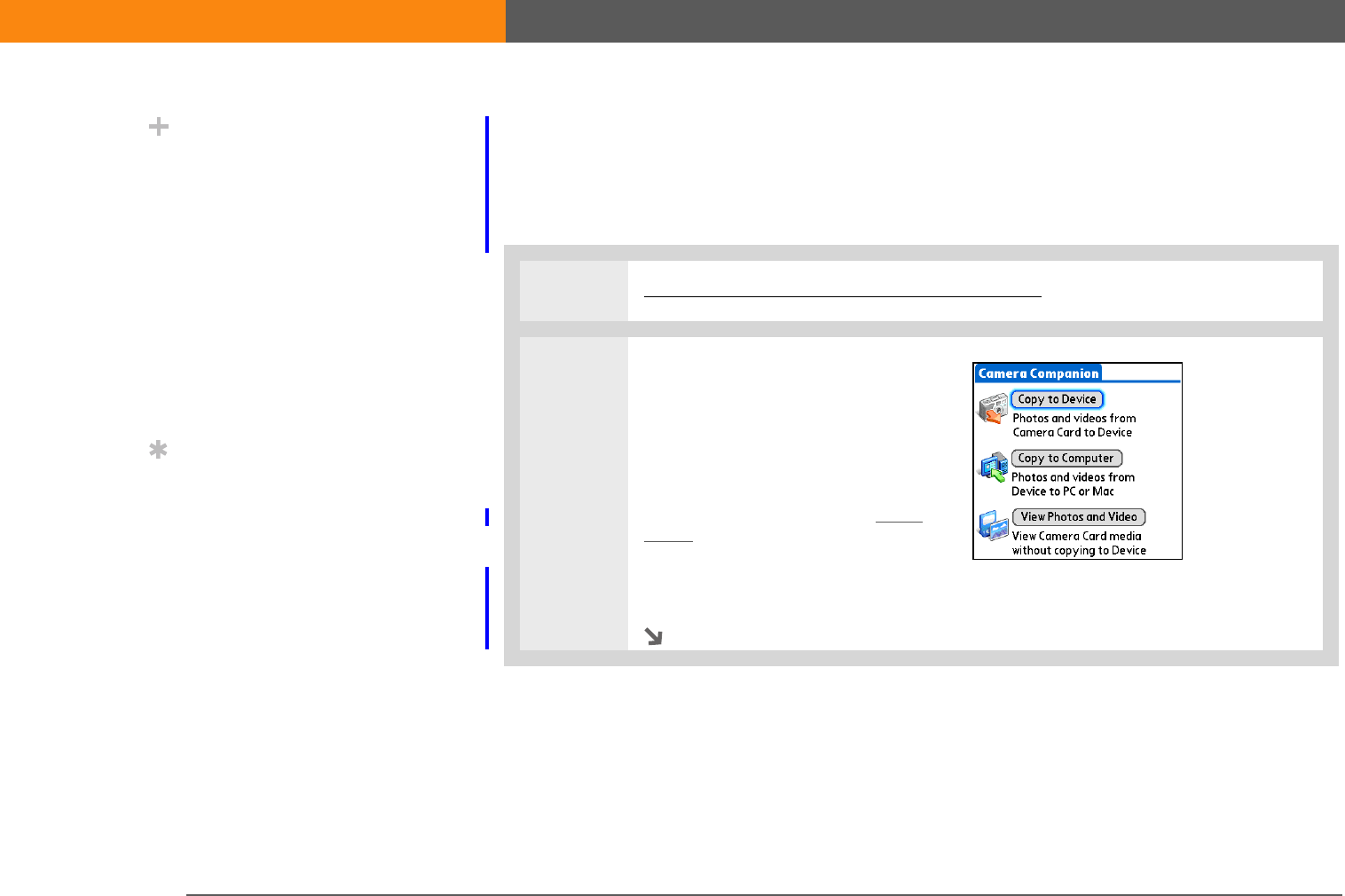
LifeDrive from palmOne 220
CHAPTER 10 Managing Your Camera Card Media
Copying photos and videos from your camera card
To extend your battery life, connect your device to a power source when copying
media from your camera card.
0.
1Insert your digital camera card into your device. The Camera Companion
application automatically opens.
2Select the copy location:
Copy to Device Copies the
photos and videos from the
DCIM directory on your camera
card to the DCIM directory on
your hard drive.
Copy to Computer Opens Drive
Mode on your device and allows
you to copy files to your
computer. Your device must be
connected to your computer.
Continued
Did You Know?
When you use Copy to
Device, the program
checks for files with the
same file name and
content. If found, those
files are not copied. Also,
files with the same file
name but different
contents are
automatically renamed
before copying onto the
device.
Tip
(Windows only) When
copying files to your
computer using Drive
Mode, you can click the
Windows dialog box
selection Copy picture to
a folder on my computer
using Microsoft Scanner
and Camera Wizard to
automatically copy files
to the computer.
IMPORTANT
[!]
SECOND DRAFT palmOne, Inc. Confidential
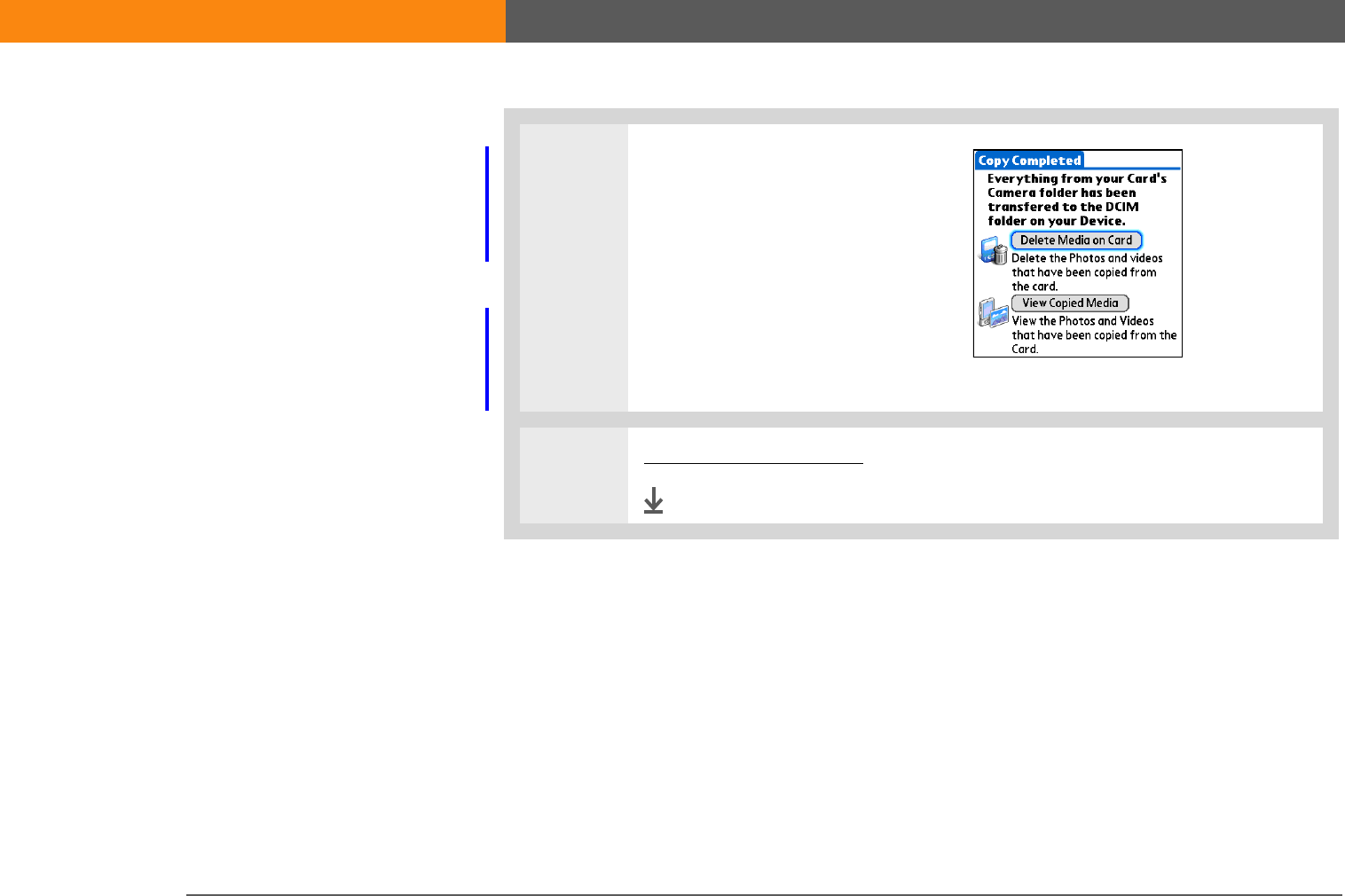
LifeDrive from palmOne 221
CHAPTER 10 Managing Your Camera Card Media
3[ & ] OPTIONAL If you selected
Copy to Device, you can select
the following:
Delete Media on Card Deletes
the contents of your camera card
so that your card is immediately
available for more photos or
videos.
View Copied Media View the
photos and videos that you
copied to your device.
4Remove your camera card.
Done
SECOND DRAFT palmOne, Inc. Confidential
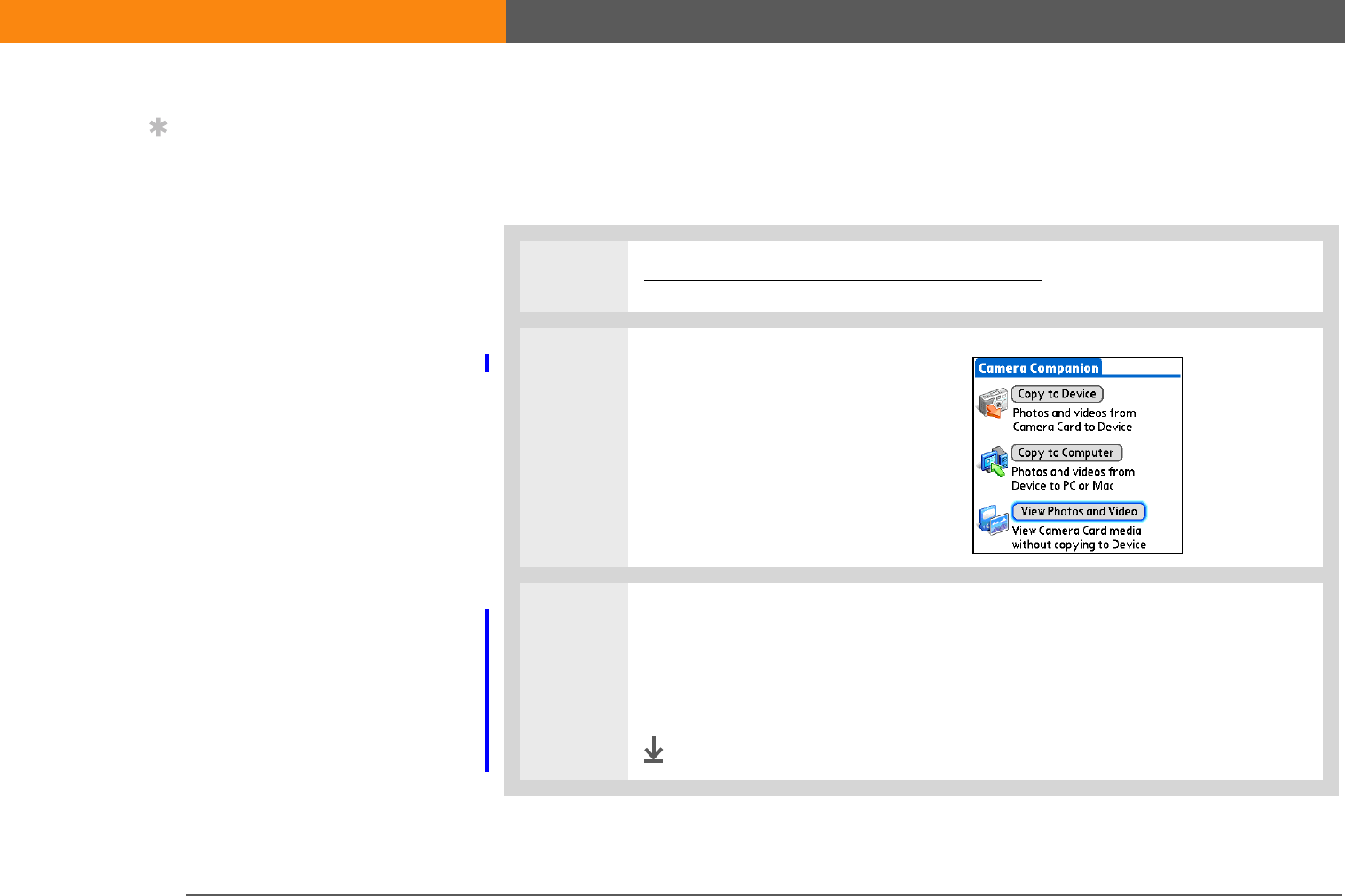
LifeDrive from palmOne 222
CHAPTER 10 Managing Your Camera Card Media
Viewing photos or videos
Use your device’s large display as a picture viewer. You can view the contents of your camera
memory card without transferring the photos or videos to your device.
0
1Insert your digital camera card into your device. The Camera Companion
application automatically opens.
2Select View Photos and Video.
3View your media:
a. Select the folder where the photos and videos are located.
b. View the photos and videos.
Done
Tip
Use your camera’s editing
software to edit or
enhance your photos or
videos and copy them to
your device for viewing.
SECOND DRAFT palmOne, Inc. Confidential

LifeDrive from palmOne 223
CHAPTER 10 Managing Your Camera Card Media
Related topics
Click a link below to learn about these related topics:
Media • Viewing photos and videos as thumbnails, lists, albums, and slide shows
• Copying photos and videos to other applications or expansion cards
• Deleting photos and videos
Sharing Sending information using wireless technology on your device
Email Sending photos and videos as attachments to email messages
Tips & Tricks
Make your device uniquely
yours. For great tips,
software, accessories, and
more, visit
www.palmOne.com/
mylifedrive.
Support
If you’re having problems
with Media or with anything
else on your device, go to
www.palmOne.com/
support.
SECOND DRAFT palmOne, Inc. Confidential
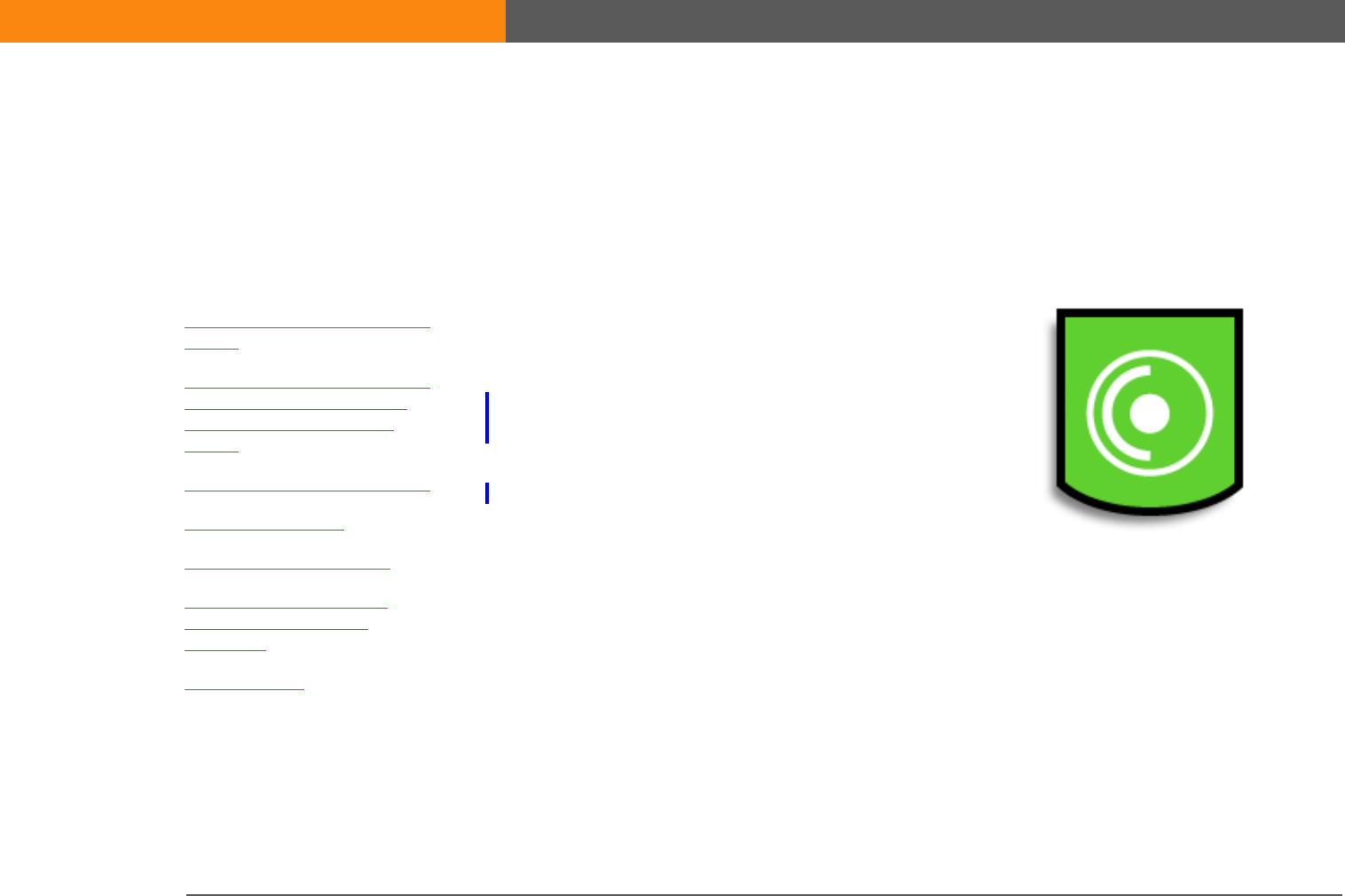
LifeDrive from palmOne 224
CHAPTER 11
Listening to Music
Are you tired of listening to small talk
during that long commute on the bus
or train? Do you need something
smaller than a CD player when you’re
out for a walk or at the gym? There is
no need to buy an expensive MP3
player. Your device can carry
thousands of songs, and Pocket
TunesTM lets you play the music on
your device. Simply transfer songs
onto your device or an expansion card
and then listen through the built-in
speaker or stereo headphones (sold
separately).
Benefits
• Carry and listen to thousands of
songs in the popular MP3 format
• No separate MP3, CD, or mini-disc
player required
• Be your own DJ
I
n t
hi
s c
h
apter
Transferring MP3 files to your
device
Transferring music from a CD
to your deviceTransferring
music from a CD to your
device
Playing music on your device
Managing playlists
Customizing your player
Working with Windows
Media Player on your
computer
Related topics
SECOND DRAFT palmOne, Inc. Confidential
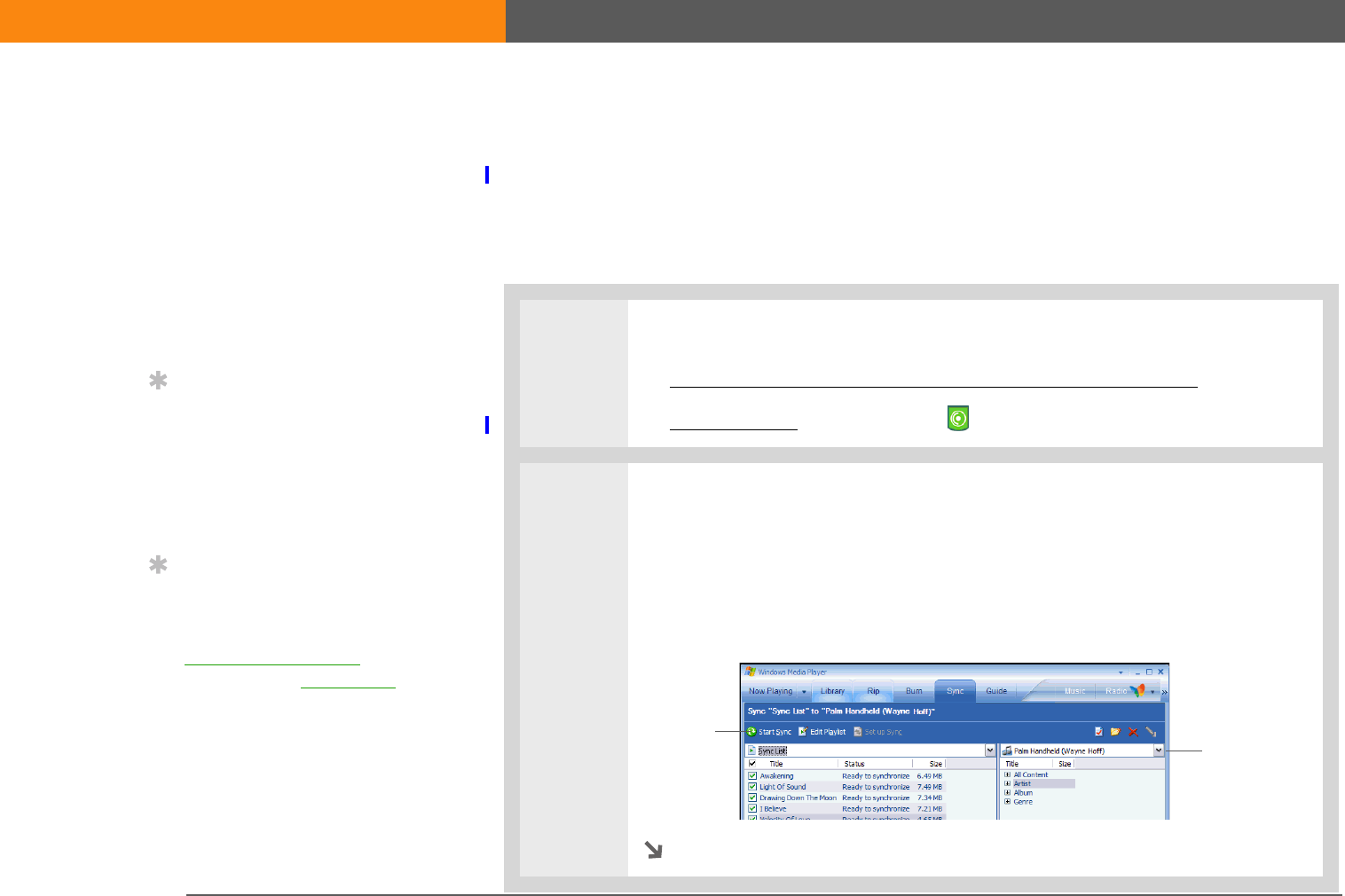
CHAPTER 11 Listening to Music
LifeDrive from palmOne 225
Transferring MP3 files to your device
The Pocket Tunes software that comes with your device is compatible with the popular MP3 audio
file format. If your MP3 files are already on your computer’s hard drive, you need to transfer them
to your device’s hard drive to listen to them on your device.
WINDOWS ONLY
0
1Prepare your computer and your device:
a. Connect your device and your computer to the USB sync cable.
b. Go to Favorites and select Music .
2Prepare Windows Media Player on your computer:
a. Open the Windows Media Player application.
b. Select the Sync tab.
c. Select Palm Device from the device drop-down list.
Continued
Before You Begin
[!]
(Windows only) Install
Windows Media Player
and the Pocket Tunes
plug-in on your
computer. Insert the
software installation CD
and follow the onscreen
instructions for installing
extra software.
Tip
The Star button is
assigned to open Pocket
Tunes. You can also
reassign the Star button
to open any of your
favorite applications.
Tip
You can also transfer MP3
files to the Music folder
on your device using
LifeDrive™ Manager
(Windows) or Drive Mode
(Mac and Windows) on
your computer. Select Palm
Device
Start
Sync
SECOND DRAFT palmOne, Inc. Confidential
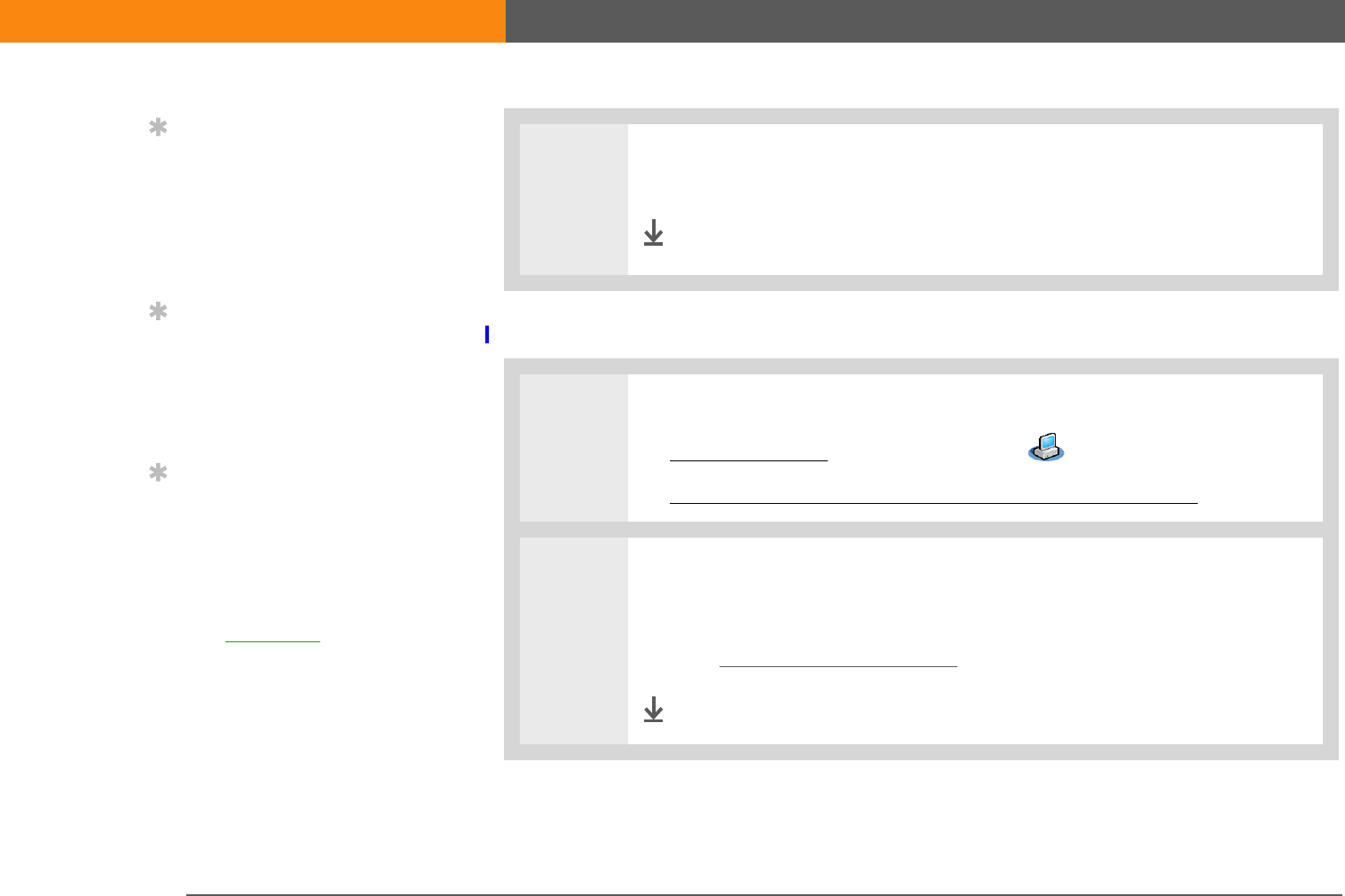
LifeDrive from palmOne 226
CHAPTER 11 Listening to Music
MAC ONLY
0
3Select Start Sync. The files are transferred to the Music folder on your device’s
hard drive.
Done
1Prepare your computer and your device:
a. Go to Applications and select Drive Mode .
b. Connect your device and your computer to the USB sync cable.
2Open Finder, and then drag the music files you want onto the Music folder
under the device icon, which appears as an external drive on your desktop.
When you have finished transferring music files, be sure to
properly disconnect from Drive Mode.
Done
Tip
You can also use a card
reader accessory (sold
separately) to transfer
MP3 files from your
computer to your
expansion card.
Tip
You can also use a card
reader accessory (sold
separately) to transfer MP3
files from your computer to
your expansion card.
Tip
You can also transfer MP3
files on a Mac computer by
dragging the music file to
the Send To Handheld
droplet. Select the
destination for the file, and
then
synchronize
to
transfer it.
IMPORTANT
[!]
SECOND DRAFT palmOne, Inc. Confidential
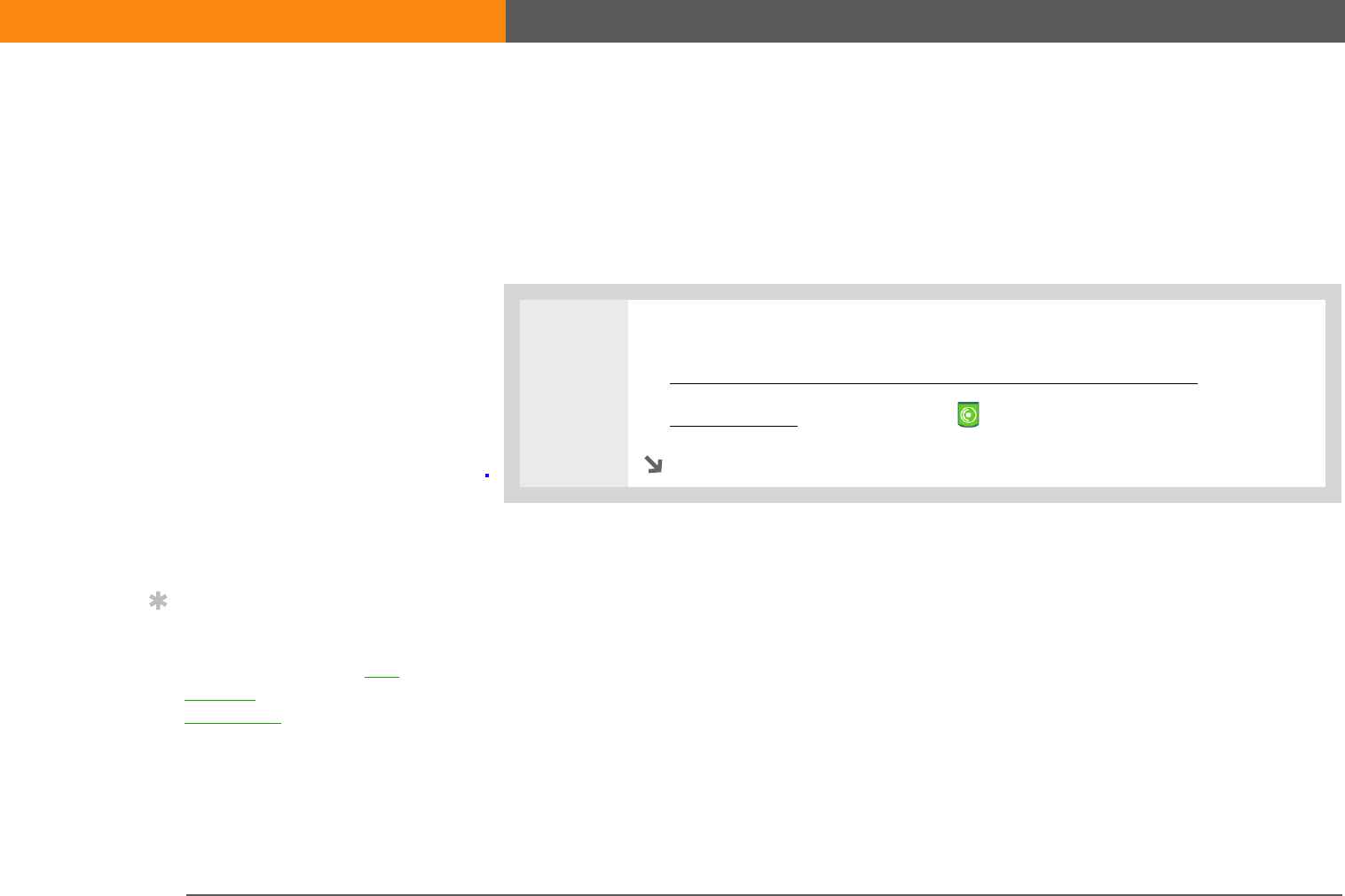
CHAPTER 11 Listening to Music
LifeDrive from palmOne 227
Transferring MP3 files to your device
The PocketTunes software that comes with your device is compatible with the popular MP3 audio
file format. If your MP3 files are already on your computer’s hard drive, you need to transfer them
to your device’s hard drive to listen to them on your device.
WINDOWS ONLY
0
1Prepare your computer and your device:
a. Connect your device and your computer to the USB sync cable.
b. Go to Favorites and select pTunes .
Continued
Before You Begin
[!]
(Windows only) Install
Real Rhapsody desktop
application on your
computer. Insert the
software installation CD
and follow the onscreen
instructions for installing
extra software.
You must install this
software, even if you
already have a version of
RealPlayer installed on
your computer. The
version on the CD
contains all of the
components needed to
transfer music files to
your device.
Tip
You can also transfer MP3
files to the Audio folder
on your device using File
Transfer (Windows) or
Drive Mode (Mac and
Windows) on your
computer.
SECOND DRAFT palmOne, Inc. Confidential
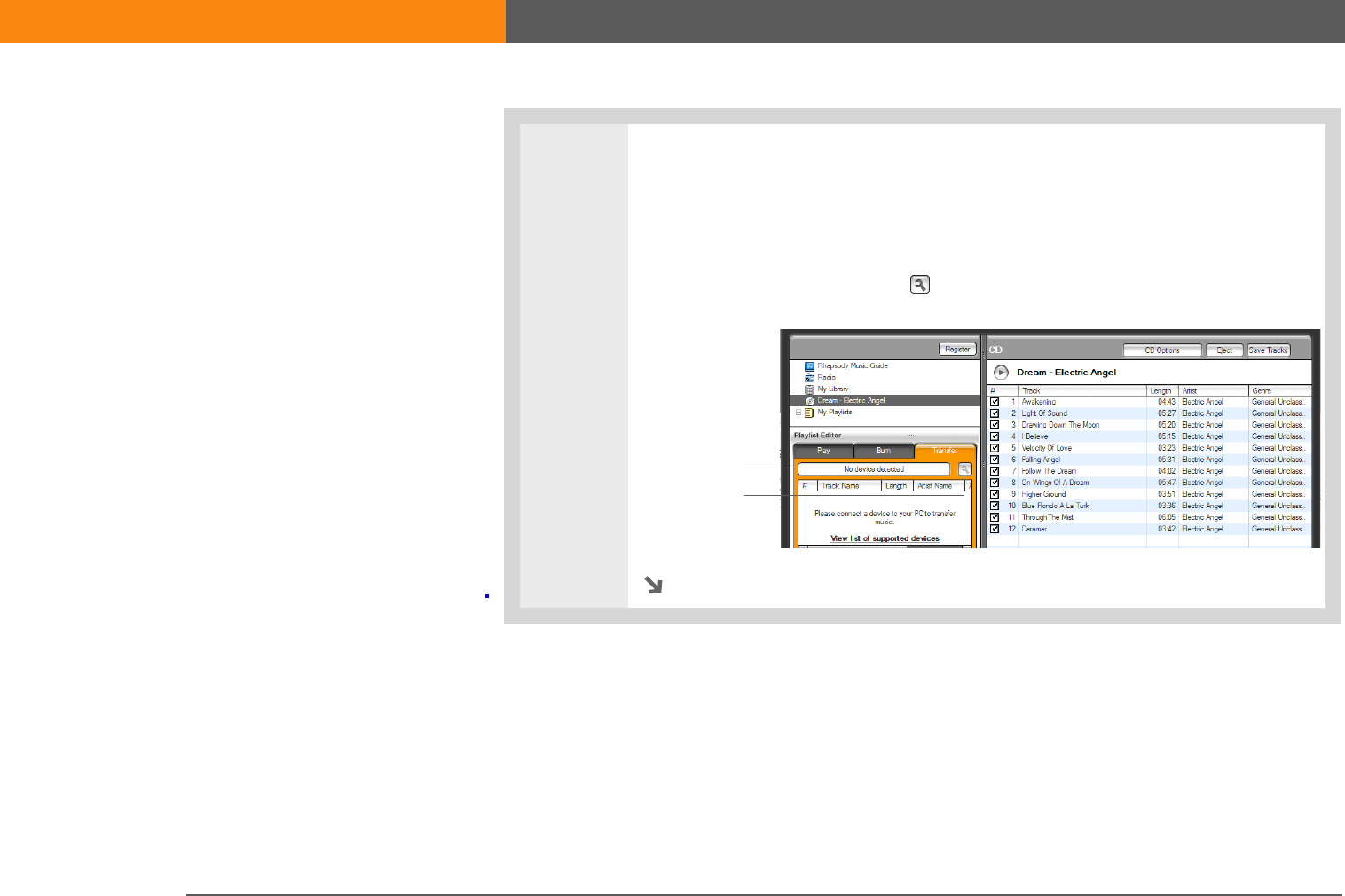
LifeDrive from palmOne 228
CHAPTER 11 Listening to Music
2Prepare Real Rhapsody on your computer:
a. Open the Real Rhapsody application.
b. Click the Transfer tab.
c. Click the Device Preferences button and select palmOne Handheld from
the pick list.
Continued
Device
Preference
button
Select
palmOne
Handheld
FPO
SECOND DRAFT palmOne, Inc. Confidential
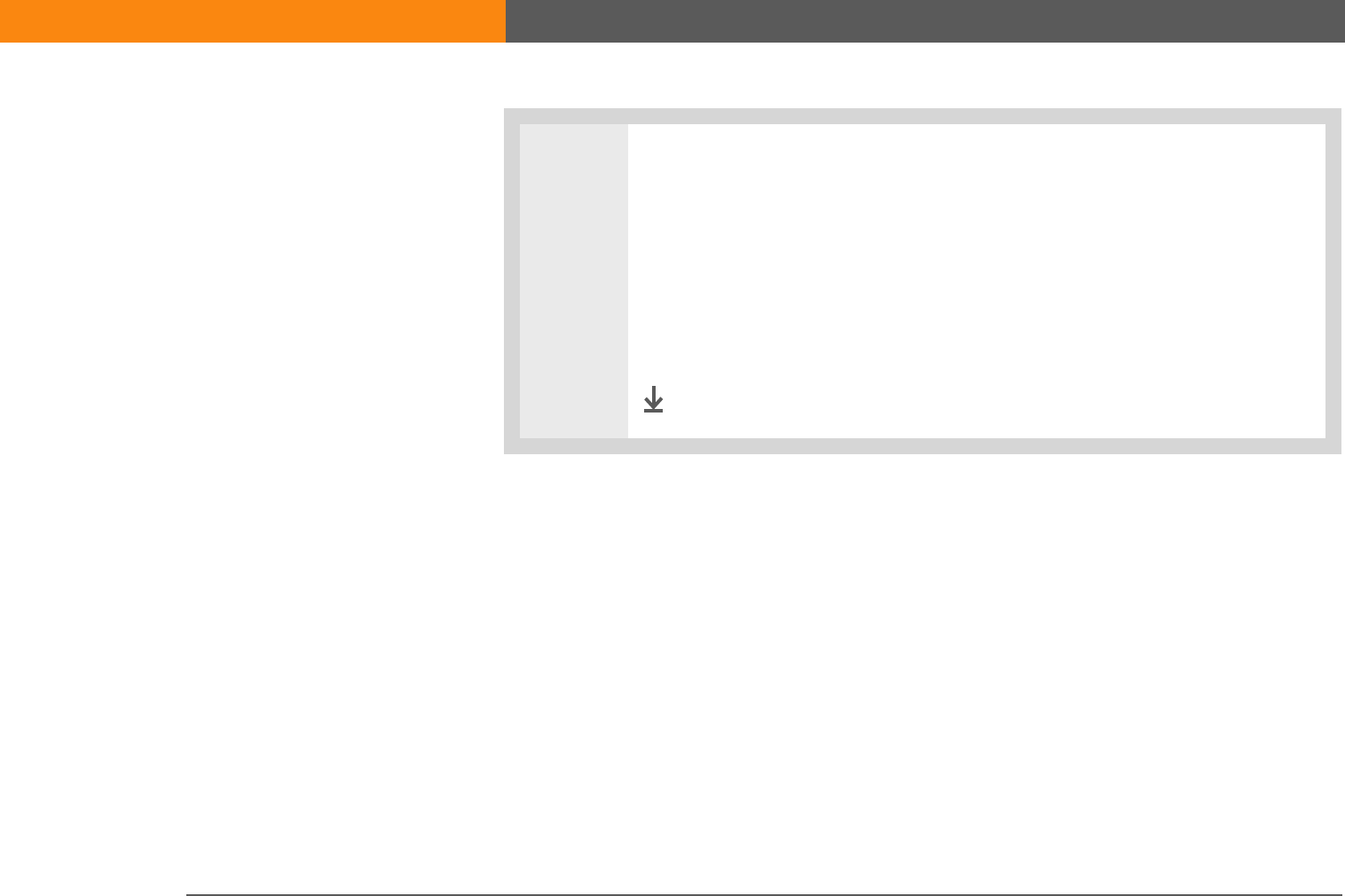
LifeDrive from palmOne 229
CHAPTER 11 Listening to Music
3Transfer the files to your device:
a. Drag the song files you want from the My Library window into the Transfer
window.
b. Click Transfer. The files are transferred to the Music folder on your device’s
internal drive.
Do not press the HotSync button on your cable. Real
Rhapsody is transferring the files, so there’s no need to do anything.
Done
IMPORTANT
[!]
SECOND DRAFT palmOne, Inc. Confidential
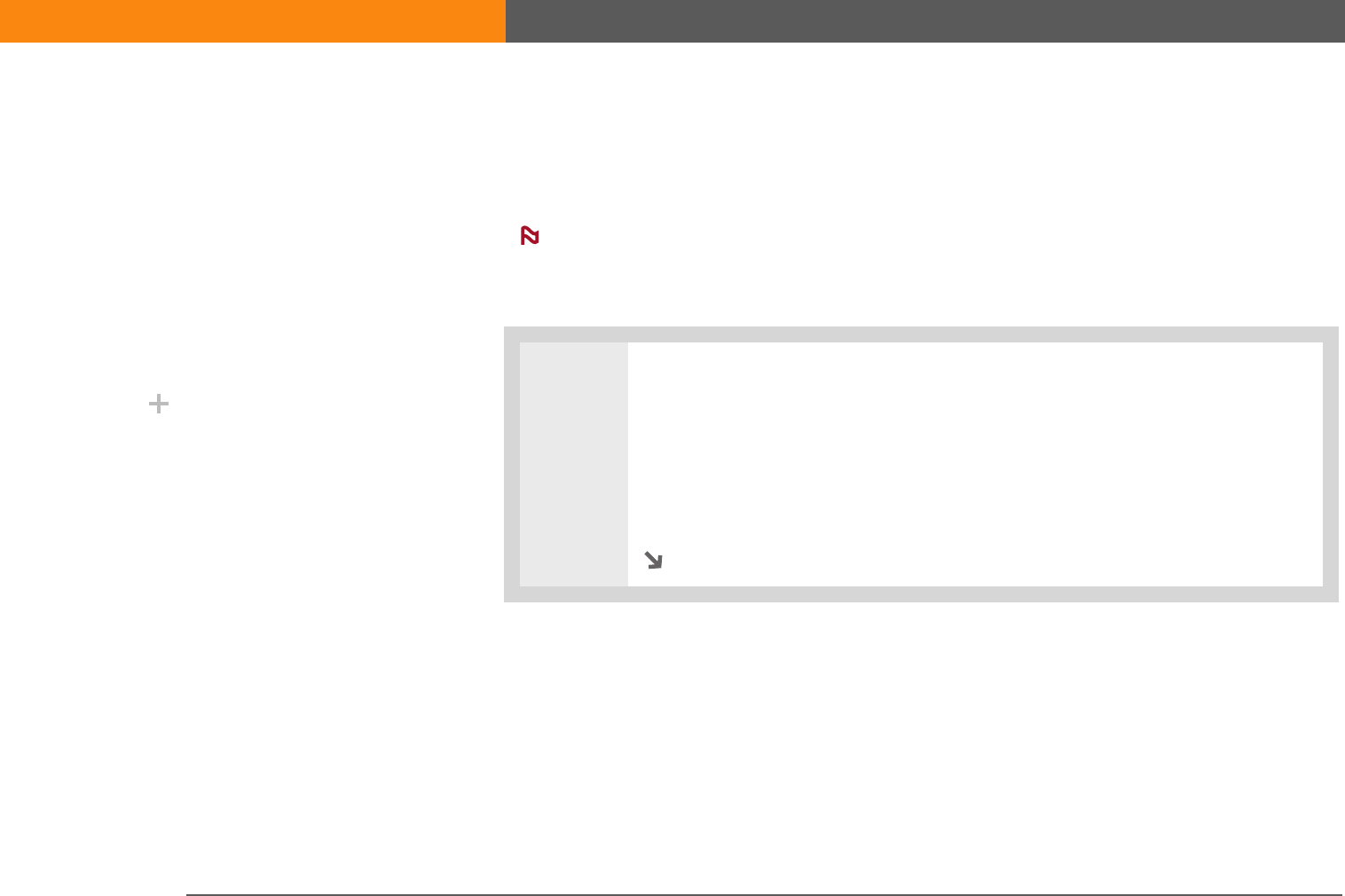
LifeDrive from palmOne 230
CHAPTER 11 Listening to Music
Transferring music from a CD to your device
If your songs are on a CD and you want to listen to them on your device, you need to use Windows
Media Player on your computer to convert and transfer the files.
Mac users can use iTunes, included with OS X, to transfer music from a CD to their
device. Music files should be imported in MP3 format.
WINDOWS ONLY
0
1Access the music CD from Windows Media Player on your computer:
a. Open the Windows Media Player application.
b. Insert the CD into your computer’s CD drive.
c. Select the Rip tab.
Continued
NOTE
Before You Begin
[!]
Set the Windows Media
Player Rip Music format
setting for mp3. Right-
click on the Windows
Media Player screen and
select Tools, and then
select Options. Select the
Rip Music tab and then
select mp3 from the
Format pick list.
Did You Know?
An interactive tutorial on
the software installation
CD guides you through
adding music. Insert the
CD, go to the My Music
section of the tutorial and
select Add music from a
CD.
SECOND DRAFT palmOne, Inc. Confidential
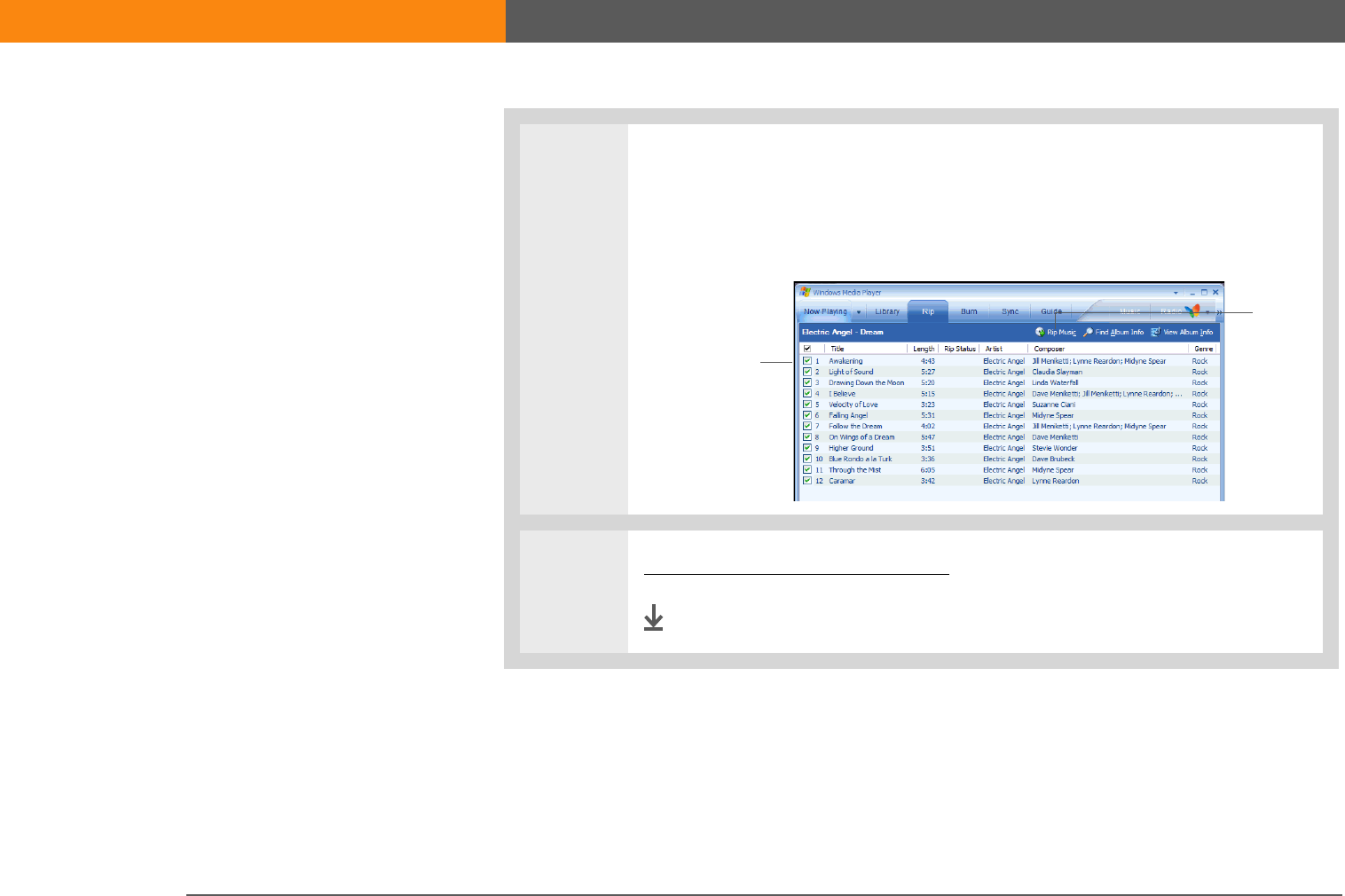
CHAPTER 11 Listening to Music
LifeDrive from palmOne 231
2Rip the songs you want to add to your library:
a. Select the titles you want to rip from the CD.
b. Select Rip Music.
3Transfer the MP3 files to your device.
Done
Save titles
Rip
Music
SECOND DRAFT palmOne, Inc. Confidential
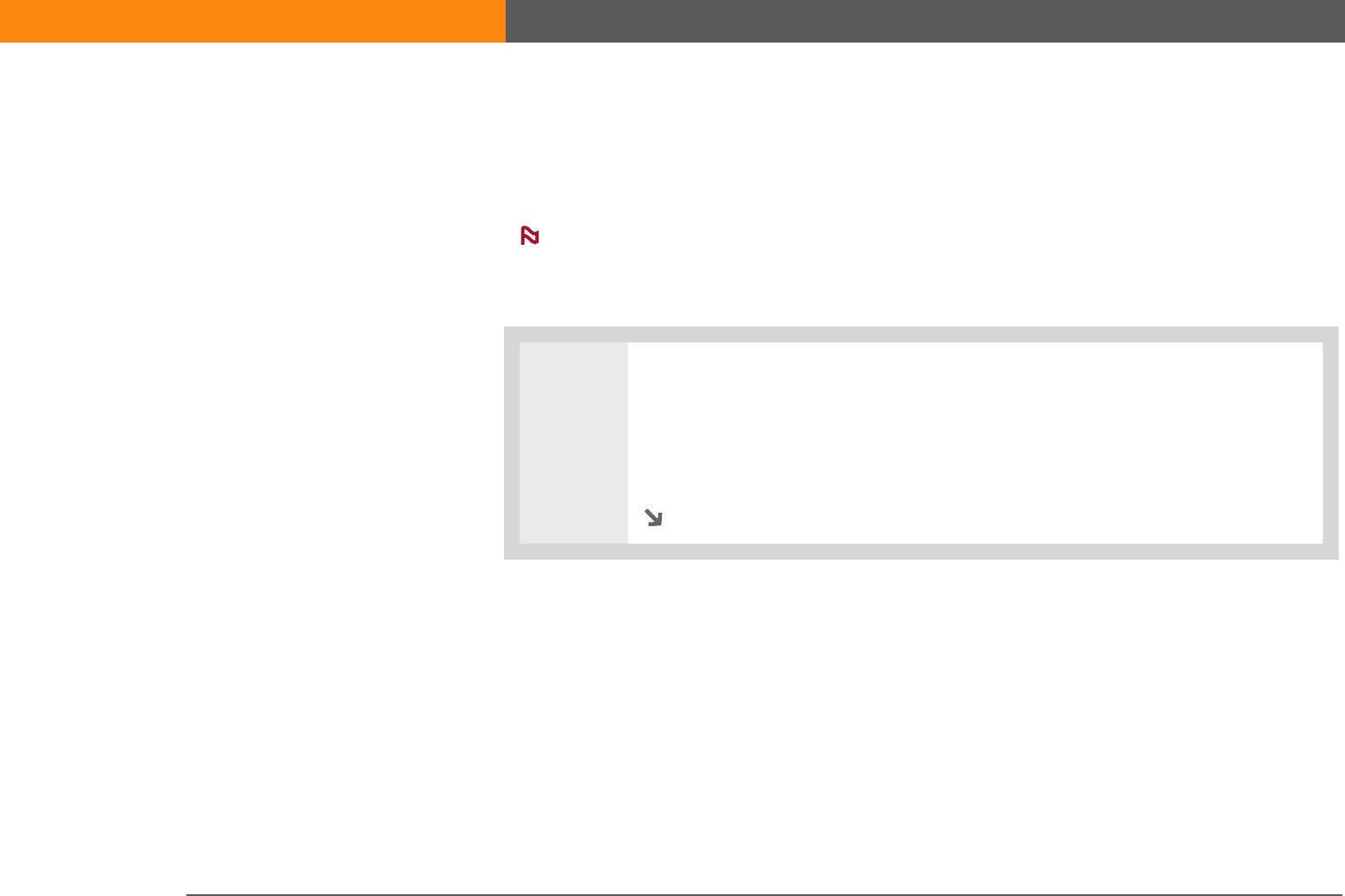
LifeDrive from palmOne 232
CHAPTER 11 Listening to Music
Transferring music from a CD to your device
If your songs are on a CD and you want to listen to them on your device, use the Real Rhapsody
desktop application on your computer to convert and transfer the files.
Mac users can use iTunes, included with OS X, to transfer music from a CD to their
device. Music files should be imported in MP3 format.
WINDOWS ONLY
0
1Access the music CD from Real Rhapsody on your computer:
a. Open the Real Rhapsody application.
b. Insert the CD into your computer’s CD drive.
Continued
NOTE
Before You Begin
[!]
(Windows only) Install
Real Rhapsody desktop
application on your
computer. Insert the
software installation CD
and follow the onscreen
instructions for installing
extra software.
You must install this
software, even if you
already have a version of
RealPlayer installed on
your computer. The
version on the CD
contains all of the
components needed to
transfer music files to
your device.
SECOND DRAFT palmOne, Inc. Confidential
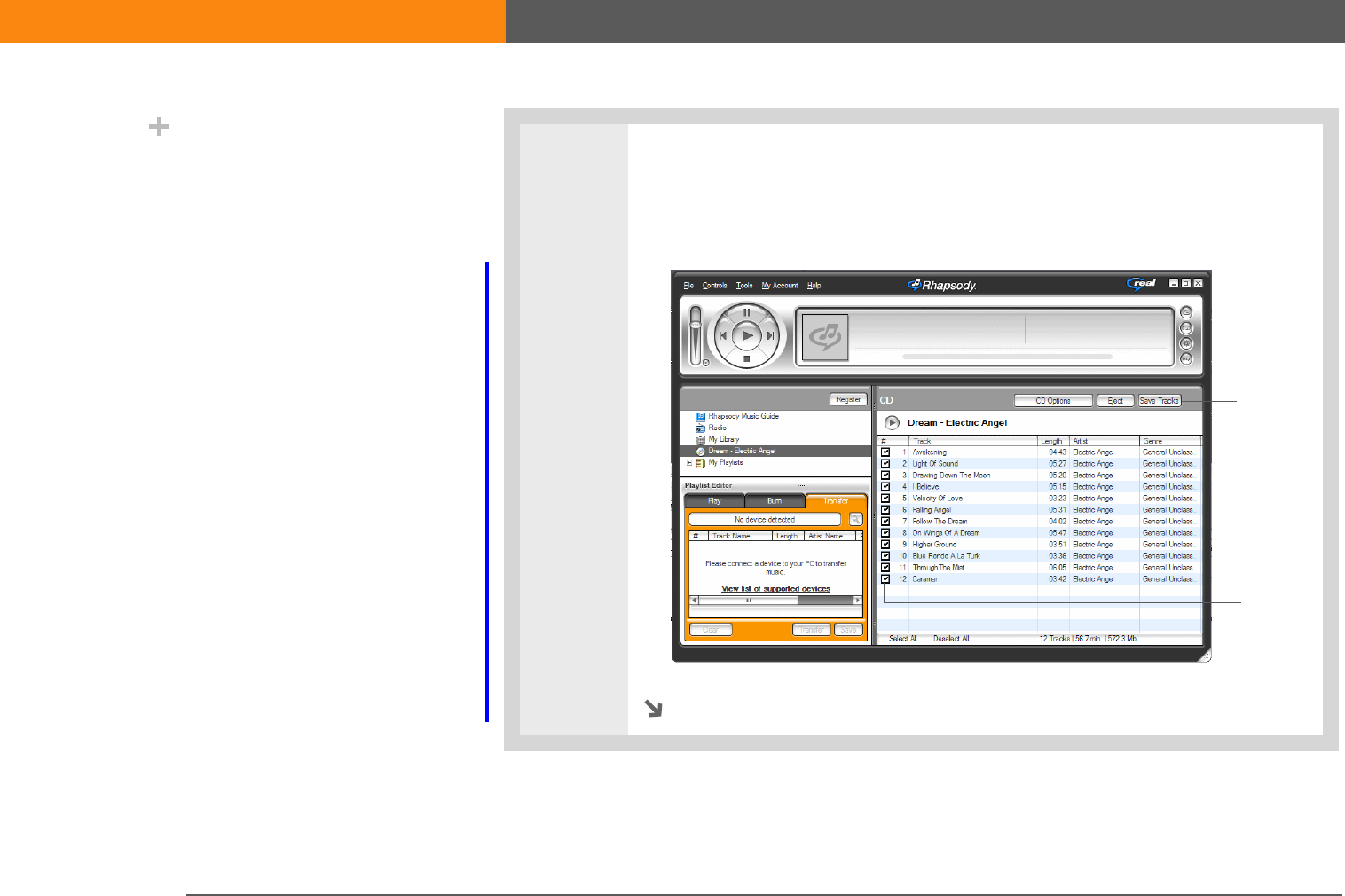
LifeDrive from palmOne 233
CHAPTER 11 Listening to Music
2Transfer the songs you want to add to your library:
a. Select the titles you want to transfer from the CD.
b. Click Save Tracks.
Continued
Did You Know?
An interactive tutorial on
the LifeDrive™ software
installation CD guides
you through adding
music. Insert the CD and
go to the My Music
section of the tutorial and
select Add music from a
CD.
Save
Tracks
Select
titles
FPO
SECOND DRAFT palmOne, Inc. Confidential
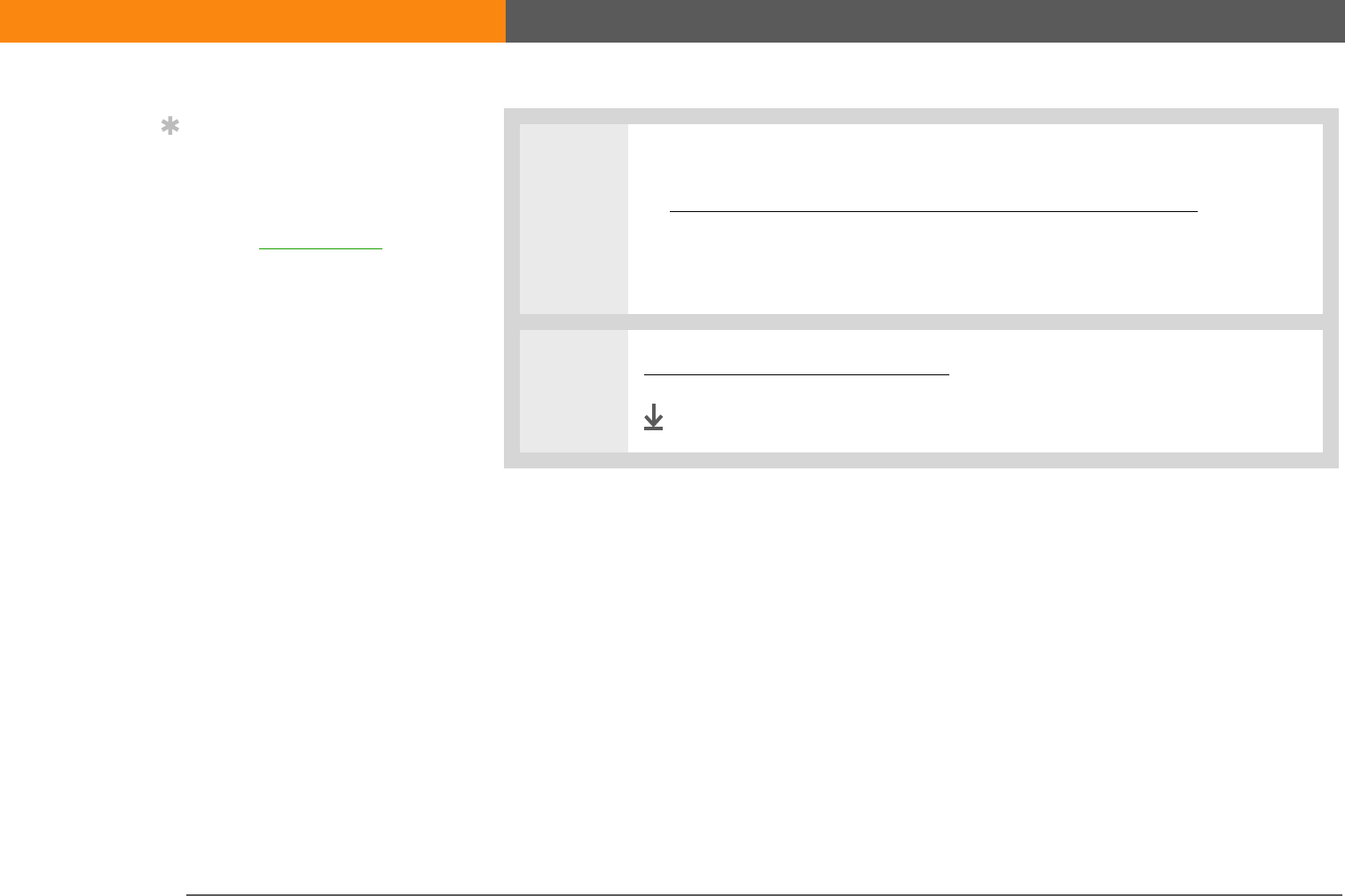
LifeDrive from palmOne 234
CHAPTER 11 Listening to Music
3Prepare your device:
a. Connect your device and your computer to the USB sync cable.
b. Turn on your device.
Do not press the HotSync button on your cable.
4Transfer the MP3 files to your device.
Done
Tip
For tips on using Real
Rhapsody on your
computer, go to the Help
menu in Real Rhapsody
or visit www.real.com.
IMPORTANT
[!]
SECOND DRAFT palmOne, Inc. Confidential
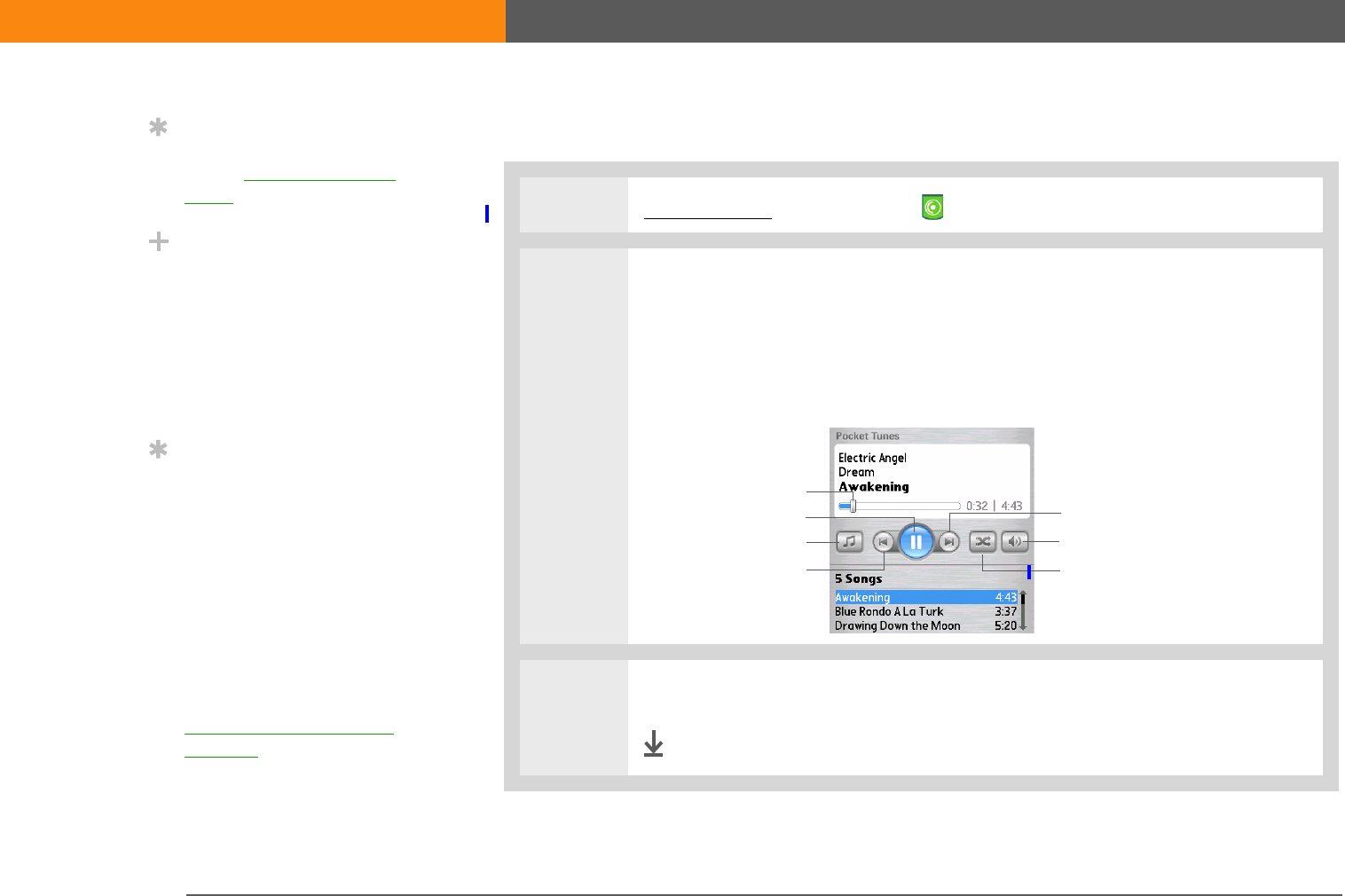
LifeDrive from palmOne 235
CHAPTER 11 Listening to Music
Playing music on your device
0
1Go to Favorites and select Music .
2Select a song to play:
• To play the current song, tap the Play button.
• To play a different song, tap the Choose Song button and select a song from
the list.
3When you’ve finished listening, tap the Stop button.
Done
Tip
For tips on using Pocket
Tunes, open the Options
menu and select Help.
Did You Know?
Pocket Tunes continues
playing the songs in your
list until it reaches the end
of your list or until you
tap the Stop button, even
if your device screen is
off.
Tip
You can upgrade Pocket
Tunes to a version that
supports additional
music file formats, such
as WMA supports
streaming MP3, and
includes additional
features such as graphic
equalizers and
bookmarks. For more
information, visit
www.pocket-tunes.com/
palmone.
Progress indicator
Play/Pause
Previous song
Next song
Volume
Choose song
Shuffle playlist
SECOND DRAFT palmOne, Inc. Confidential
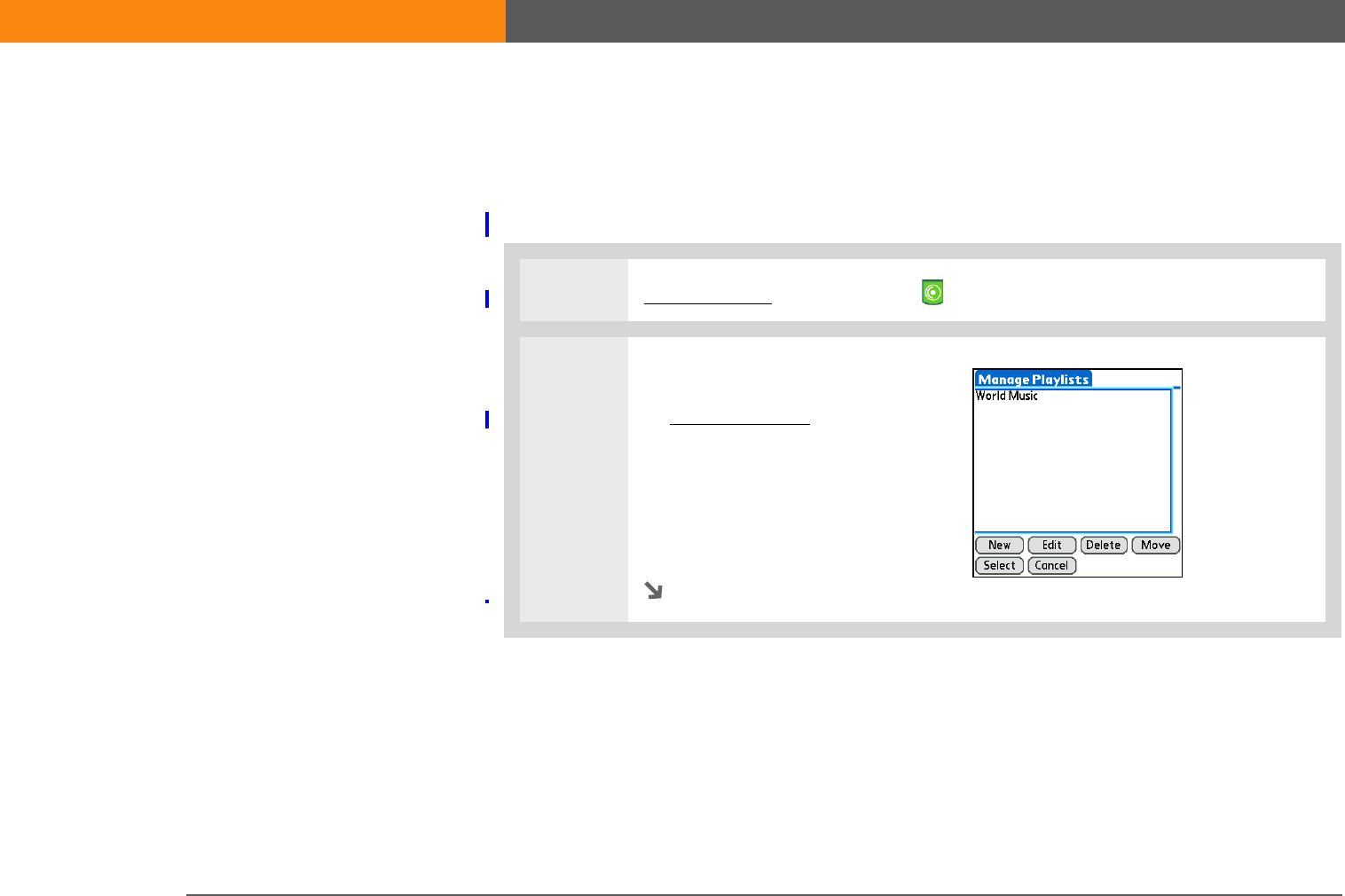
LifeDrive from palmOne 236
CHAPTER 11 Listening to Music
Managing playlists
You can create dozens of playlists with your favorite songs.
Creating a playlist
0
1Go to Favorites and select Music .
2Open the Edit Playlist screen:
a. Open the menus.
b. Select Actions menu.
c. Select Manage Playlists.
d. Select New.
Continued
SECOND DRAFT palmOne, Inc. Confidential
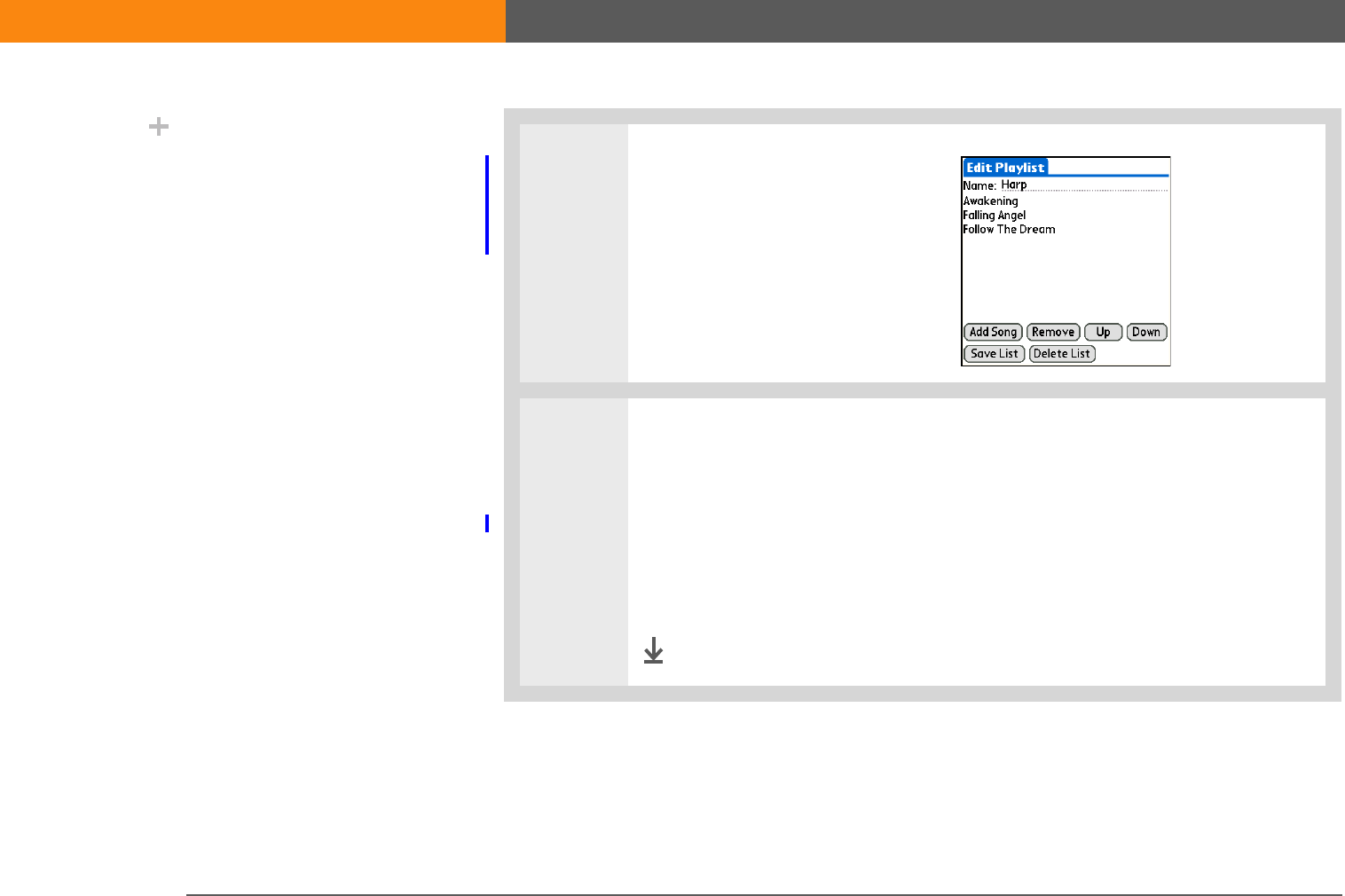
LifeDrive from palmOne 237
CHAPTER 11 Listening to Music
3Create a playlist:
a. Enter a name for the playlist.
b. Select Add Song.
c. Select the songs you want to
include on the playlist.
d. Select OK.
4Put the songs in the order you want to hear them:
a. Select a song you want to move.
b. Select Up or Down to move the song up or down one slot.
c. Repeat this process until the songs are in the right order.
d. Select Save List.
Done
Did You Know?
The Add Songs to Playlist
screen displays all songs
on your device’s internal
drive and on your
expansion card.
SECOND DRAFT palmOne, Inc. Confidential
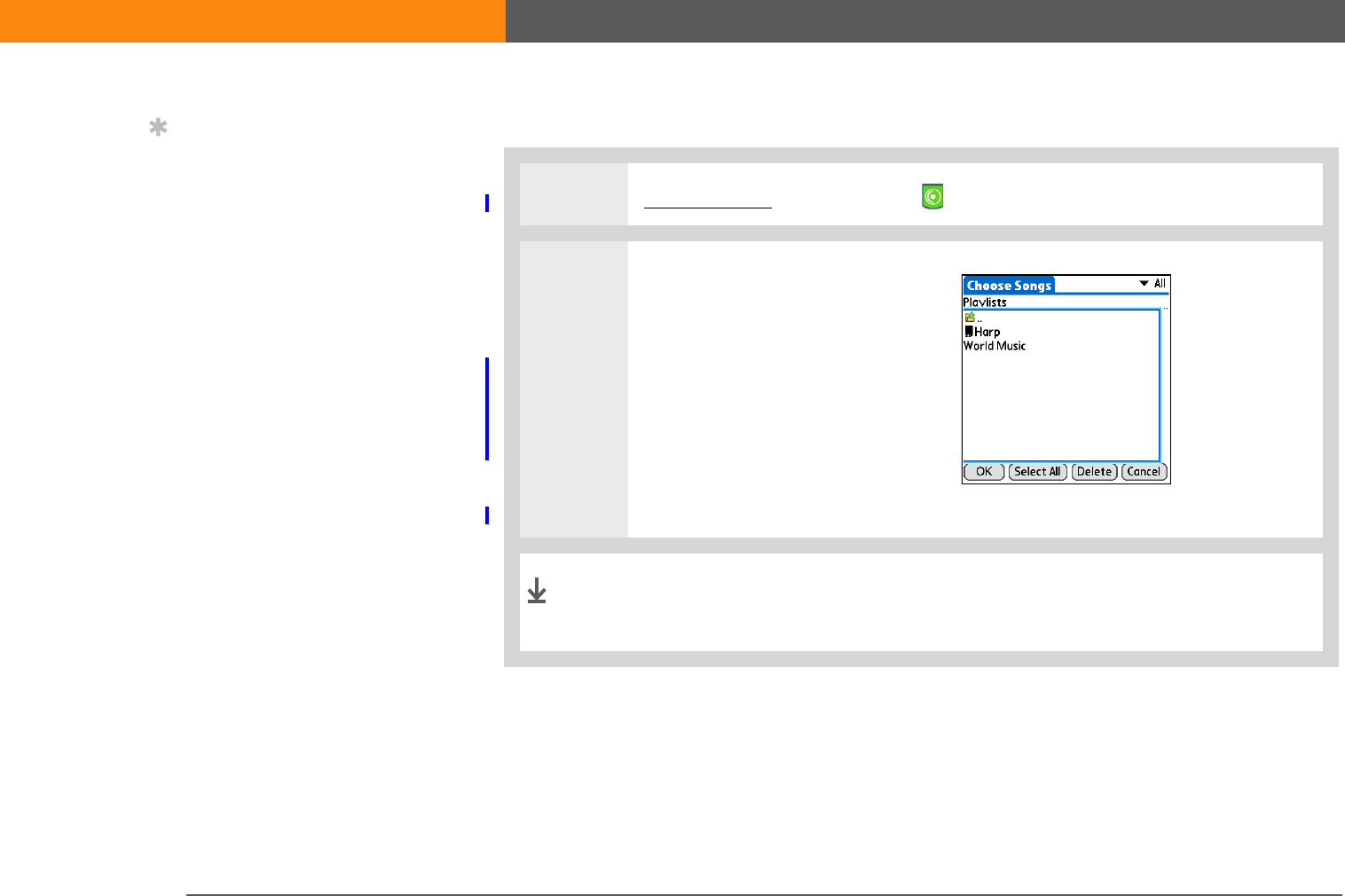
LifeDrive from palmOne 238
CHAPTER 11 Listening to Music
Playing songs from a playlist
0
1Go to Favorites and select Music .
2Select a song from a playlist:
a. Tap Choose Songs button.
b. Select the Files icon.
c. Select Playlists.
d. Select the playlist you want to
play.
e. Tap the Select All button.
Your device plays the songs in the playlist beginning with the song
you selected. After it plays the last song in the list, it stops.
Tip
To quickly select all the
songs in the list, select
Select All. To quickly
deselect all the songs,
select Select None.
Done
SECOND DRAFT palmOne, Inc. Confidential
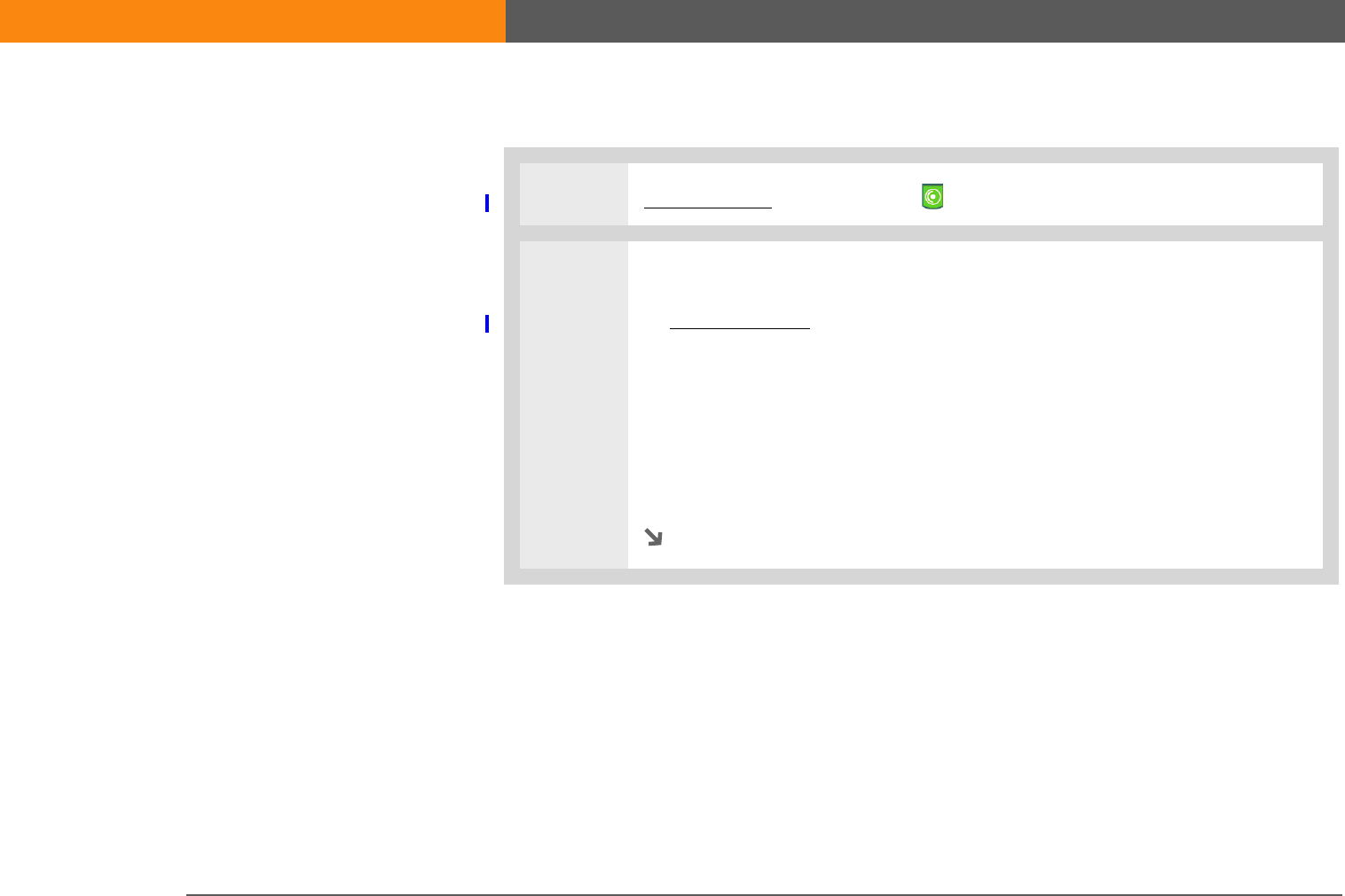
LifeDrive from palmOne 239
CHAPTER 11 Listening to Music
Editing a playlist
0
1Go to Favorites and select Music .
2Open the playlist you want to edit:
a. Open the menus.
b. Select Actions menu.
c. Select Manage Playlists.
d. Highlight a playlist.
e. Select Edit.
Continued
SECOND DRAFT palmOne, Inc. Confidential
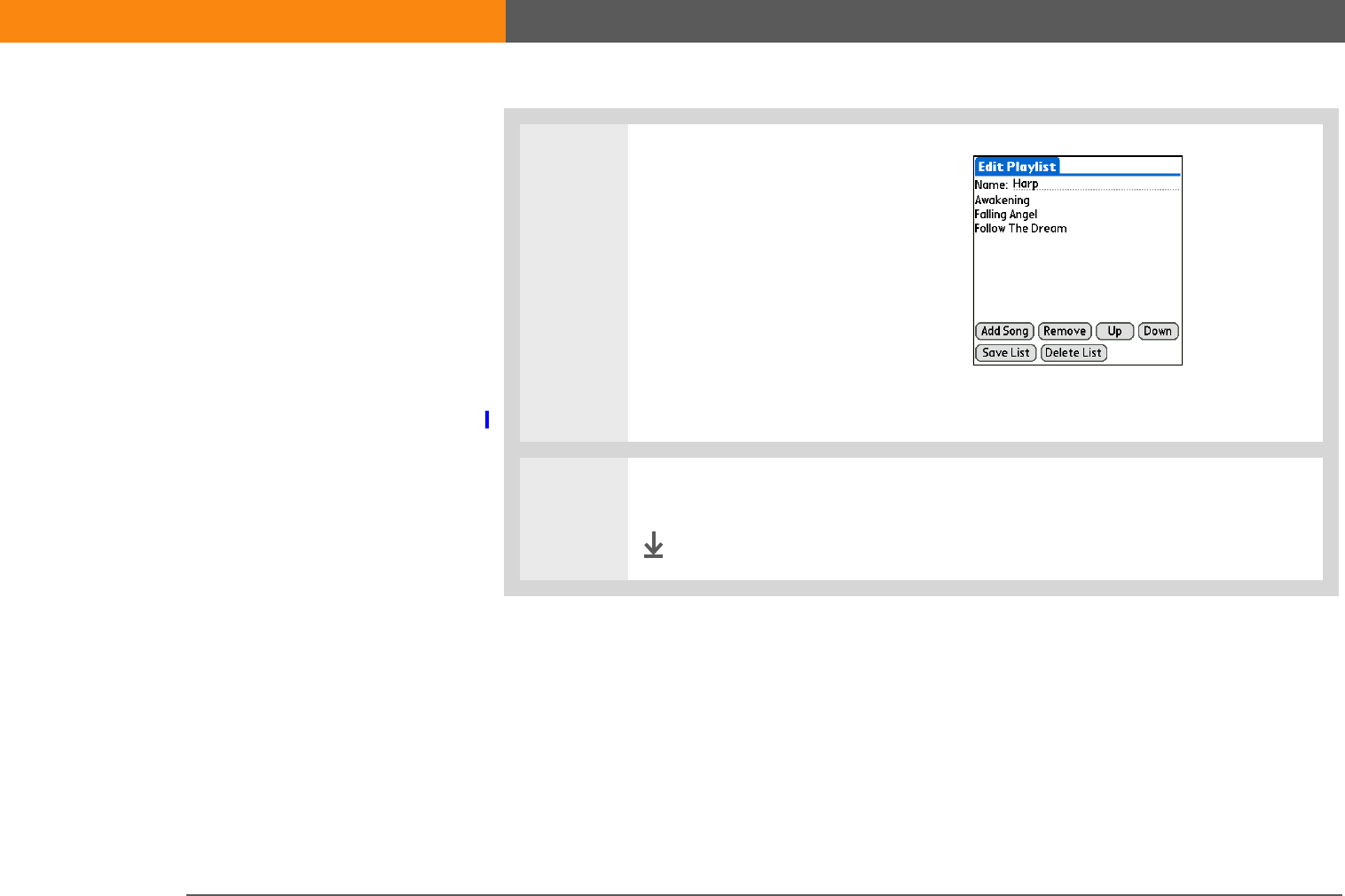
LifeDrive from palmOne 240
CHAPTER 11 Listening to Music
3Select Edit and do any of the
following:
Remove Select a song and tap
Remove to delete the song from
the playlist.
Add Song Tap Add, check a
song’s box, and then tap Done.
Up or Down Select a song and
select Up or Down to move the
song up or down one slot.
4Select Save List.
Done
SECOND DRAFT palmOne, Inc. Confidential
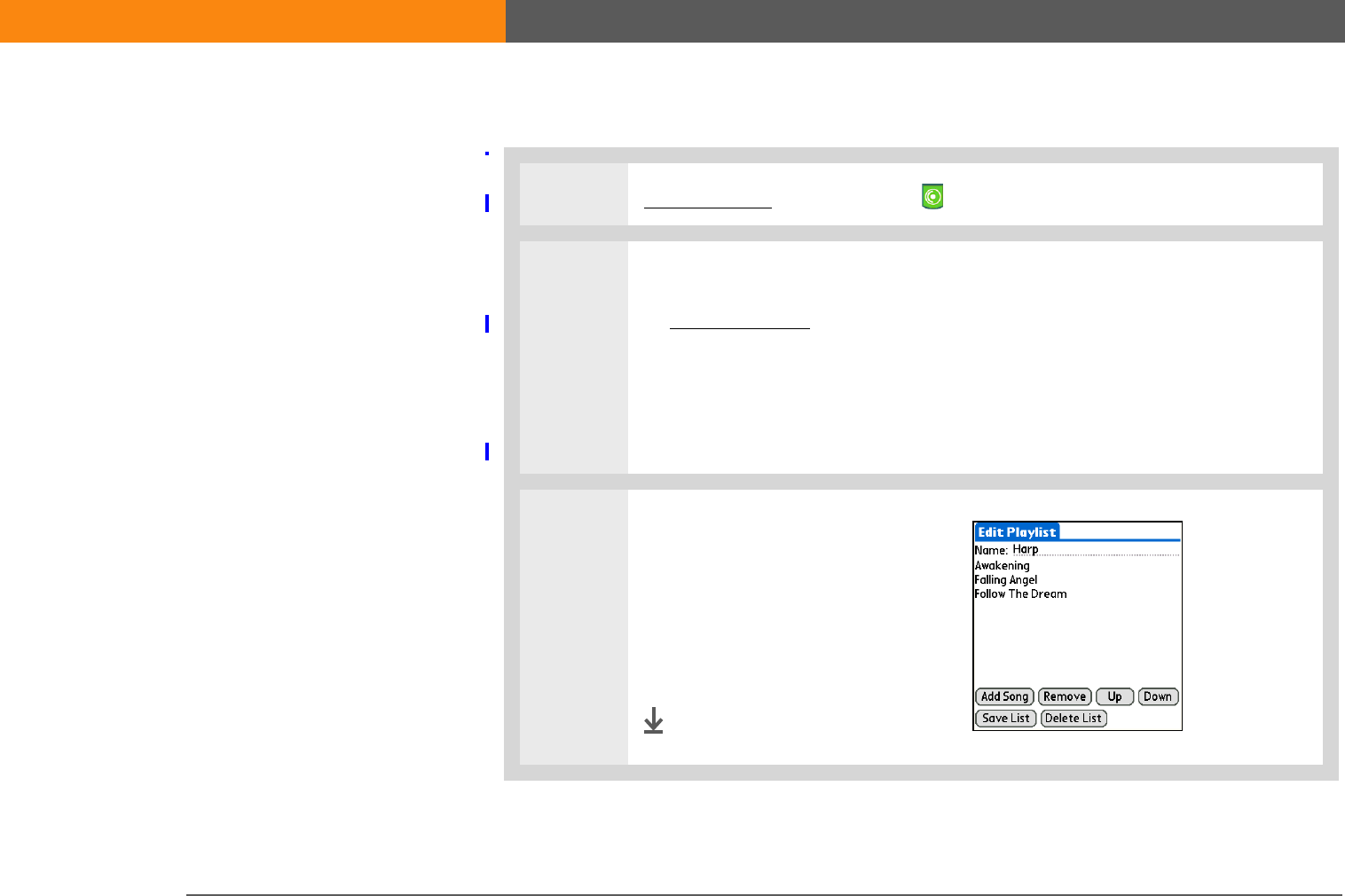
LifeDrive from palmOne 241
CHAPTER 11 Listening to Music
Deleting a playlist
0
1Go to Favorites and select Music .
2Open the playlist you want to delete:
a. Open the menus.
b. Select Actions menu.
c. Select Manage Playlists.
d. Select Edit.
3Delete the list:
a. Select Delete List.
b. Select Yes in the confirmation
dialog box.
c. Select Done.
Done
SECOND DRAFT palmOne, Inc. Confidential
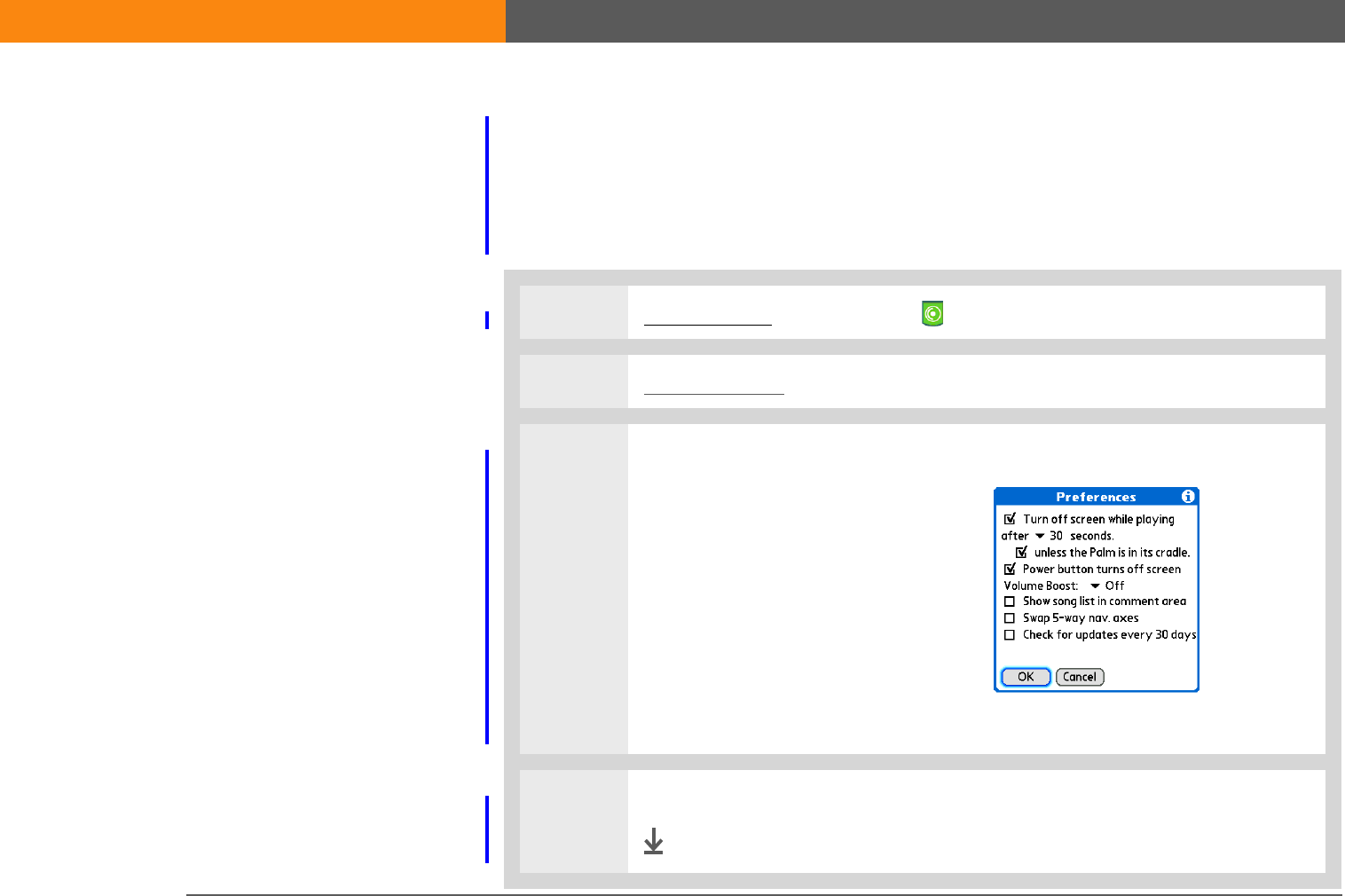
LifeDrive from palmOne 242
CHAPTER 11 Listening to Music
Customizing your player
You can customize your MP3 player by setting preferences.
Tu rn i n g o f f t h e s c re e n
Turning off the screen while playing music saves battery power.
0
1Go to Favorites and select Music .
2Open the menus.
3Select General Preferences and set screen preferences:
Turn off screen while playing after
x seconds When you are playing
music and not using any of the other
device applications, you can set the
time period after which the screen
turns off.
unless the Palm is in its cradle The
screen will always remain on when the
device power cable is plugged in.
Power button turns off screen Pushing the power button turns off the screen
but the music keeps playing.
4Select OK.
Done
SECOND DRAFT palmOne, Inc. Confidential
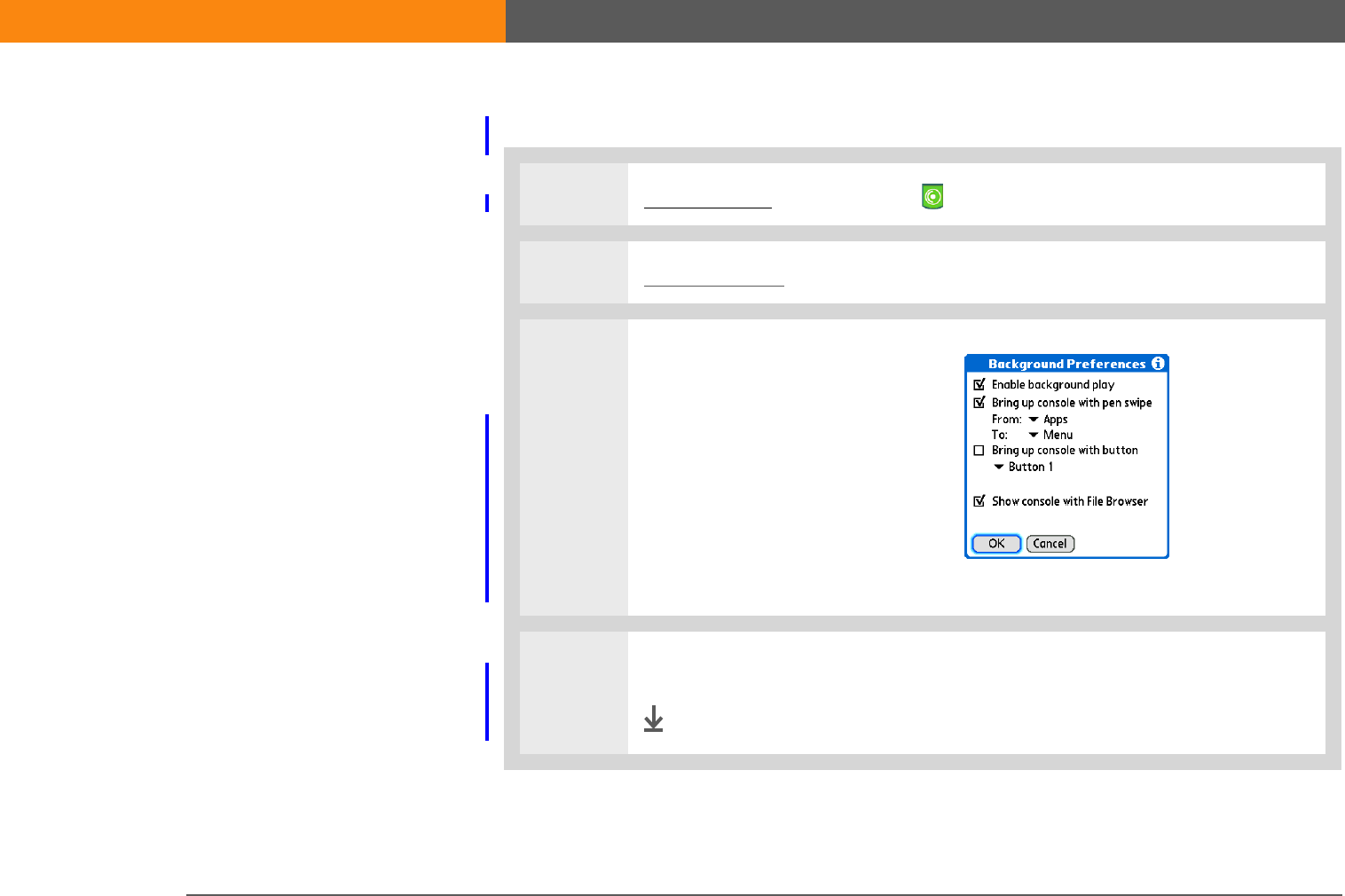
LifeDrive from palmOne 243
CHAPTER 11 Listening to Music
Setting background preferences
0
1Go to Favorites and select Music .
2Open the menus.
3Select Background Prefs and set
screen preferences:
Enable background play When
you are playing music, you can
continue using any of the other
device applications.
Bring up console with pen
swipe A pen swipe between the
selected icons in the input area
brings up the pTunes console.
4Select OK.
Done
FPO
SECOND DRAFT palmOne, Inc. Confidential
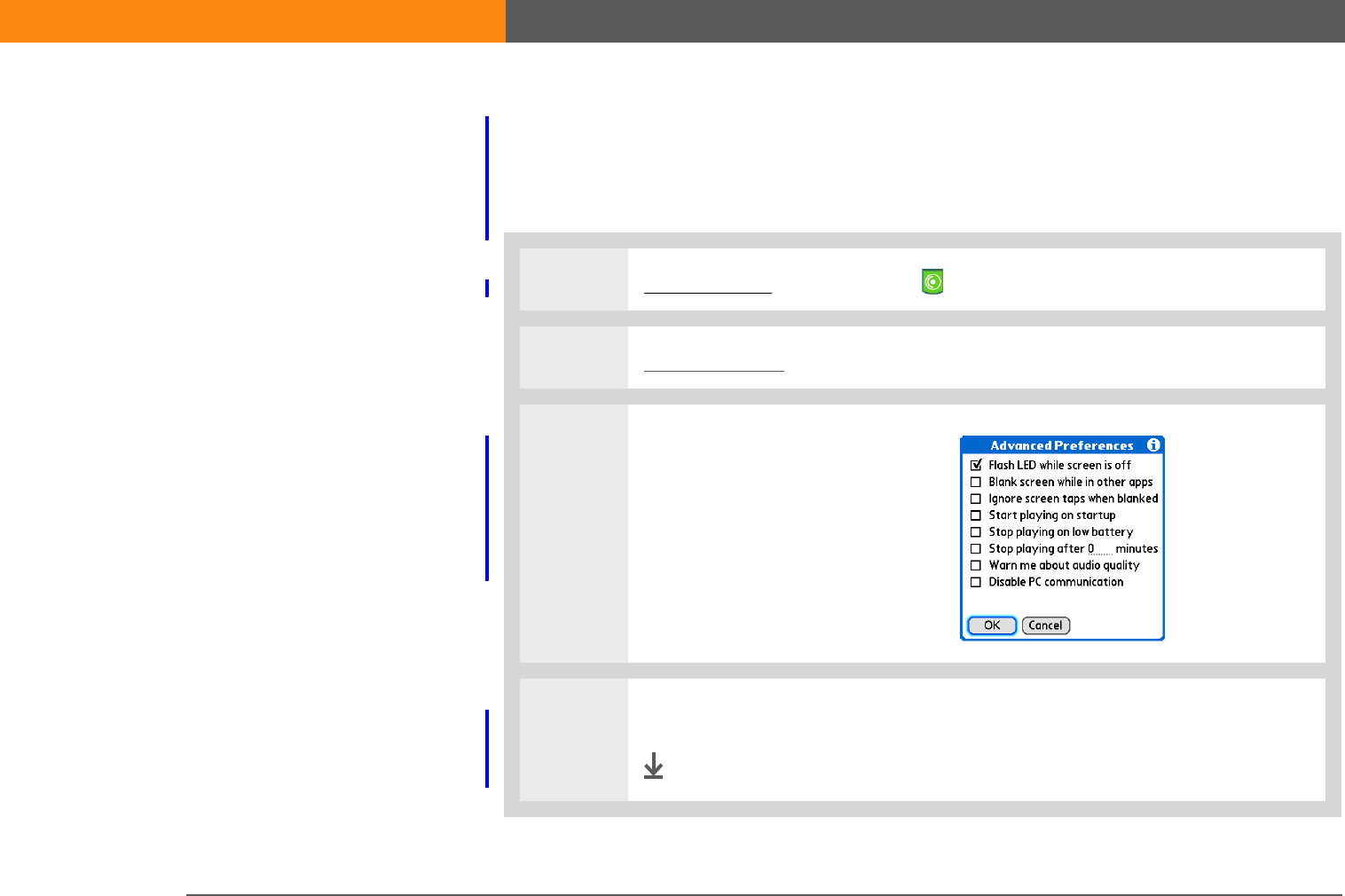
LifeDrive from palmOne 244
CHAPTER 11 Listening to Music
Flashing the LED when the pTunes console is turned off
When you are playing music while the pTunes console is turned off, you can set the LED to flash to
remind you that pTunes is still on and is playing music. This can be a helpful reminder to extend
the devices’s battery life when you are not listening to music.
0
1Go to Favorites and select Music .
2Open the menus.
3Set the preference:
a. Select Copy From PC Prefs
b. Check the box to the
preference Flash LED while
screen is off.
4Select OK.
Done
SECOND DRAFT palmOne, Inc. Confidential

LifeDrive from palmOne 245
CHAPTER 11 Listening to Music
Working with Windows Media Player on your
computer
WINDOWS ONLY
Use Windows Media Player on your computer to play and manage your songs. Learn how to use
WMP on your computer by using the online Help in WMP. The online Help includes info about the
following topics:
• Learning about the parts of the WMP window
• Finding media
• Playing media
• Saving and burning media
• WMP premium services
•Preferences
• Troubleshooting
SECOND DRAFT palmOne, Inc. Confidential

LifeDrive from palmOne 246
CHAPTER 11 Listening to Music
Related topics
Click the link below to learn about these related topics:
Expansion
Cards
• Inserting and removing expansion cards
• Naming expansion cards
• Viewing the contents of a card
Managing
Info
• Installing the Windows Media Player software and plug-in on your device
and computer
• Using palmOne™ Quick Install and the Send To Handheld droplet
Common
Questions
Answers to frequently asked questions about Windows Media Player
Tips & Tricks
Make your device uniquely
yours. For great tips,
software, accessories, and
more, visit
www.palmOne.com/
mylifedrive.
Tip
Support
If you’re having problems
with Pocket Tunes, go to
www.pocket-tunes.com.
SECOND DRAFT palmOne, Inc. Confidential

LifeDrive from palmOne 247
CHAPTER 12
Managing Your Tasks
Some of the most successful people in
the world are also the busiest. When
asked how they manage to do it all,
busy people usually say, “I make lists.”
The Tasks application on your device is
the perfect place to make a list of the
things you need to do.
Benefits of Tasks
• Set priorities
• Track deadlines
• Stay focused
I
n t
hi
s c
h
apter
Creating a task
Organizing your tasks
Marking a task complete
Deleting tasks
Customizing your Tasks list
Working with Tasks on your
computer
Related topics
SECOND DRAFT palmOne, Inc. Confidential
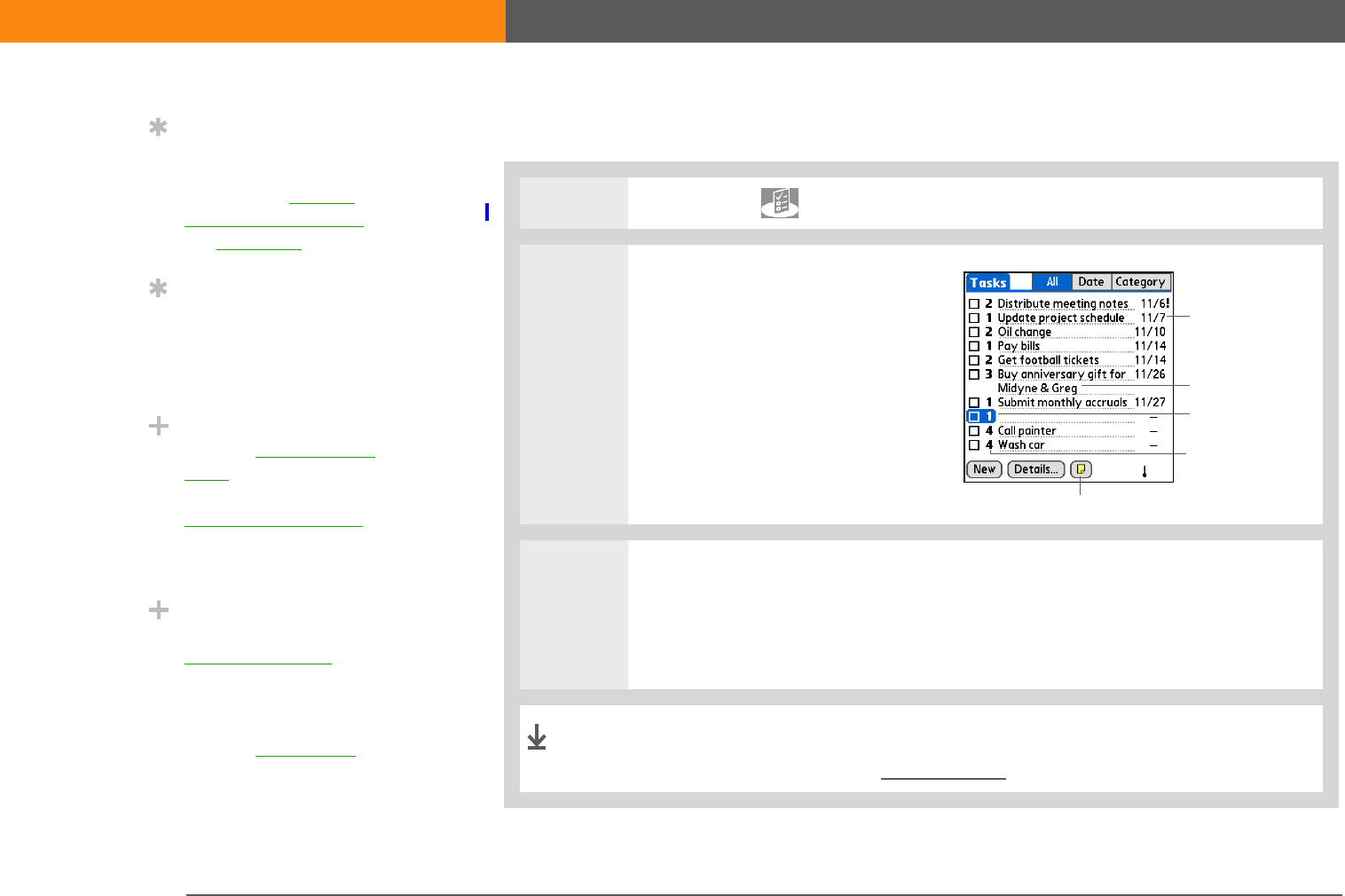
LifeDrive from palmOne 248
CHAPTER 12 Managing Your Tasks
Creating a task
0
1Tap the Tasks icon in the input area.
2Create a task:
a. Select New.
b. Enter a description of the task.
3[ & ] OPTIONAL Assign a priority and due date:
a. Tap the priority number and select a number (1 is the most important).
b. Tap the due date and select a date from the list, or select Choose Date to
select a date from the calendar.
That’s it. Your device automatically saves the task. Make sure you
have a current backup. Synchronize often.
Tip
If no task is currently
selected, you can create a
new task by writing
Graffiti® 2 characters in
the input area.
Tip
Add a note to a task.
Select the Note button,
enter the note text, and
then select Done.
Did You Know?
You can organize your
tasks by filing them into
categories. You can also
mark tasks as private to
hide them from prying
eyes.
Did You Know?
Tasks info is stored in
program memory. This
means that you can view
the info only by looking at
it in the application and
you can synchronize the
information by pressing
the sync button on the
USB cable.
New task
Priority number
Due date
Long description
Note button
Done
SECOND DRAFT palmOne, Inc. Confidential
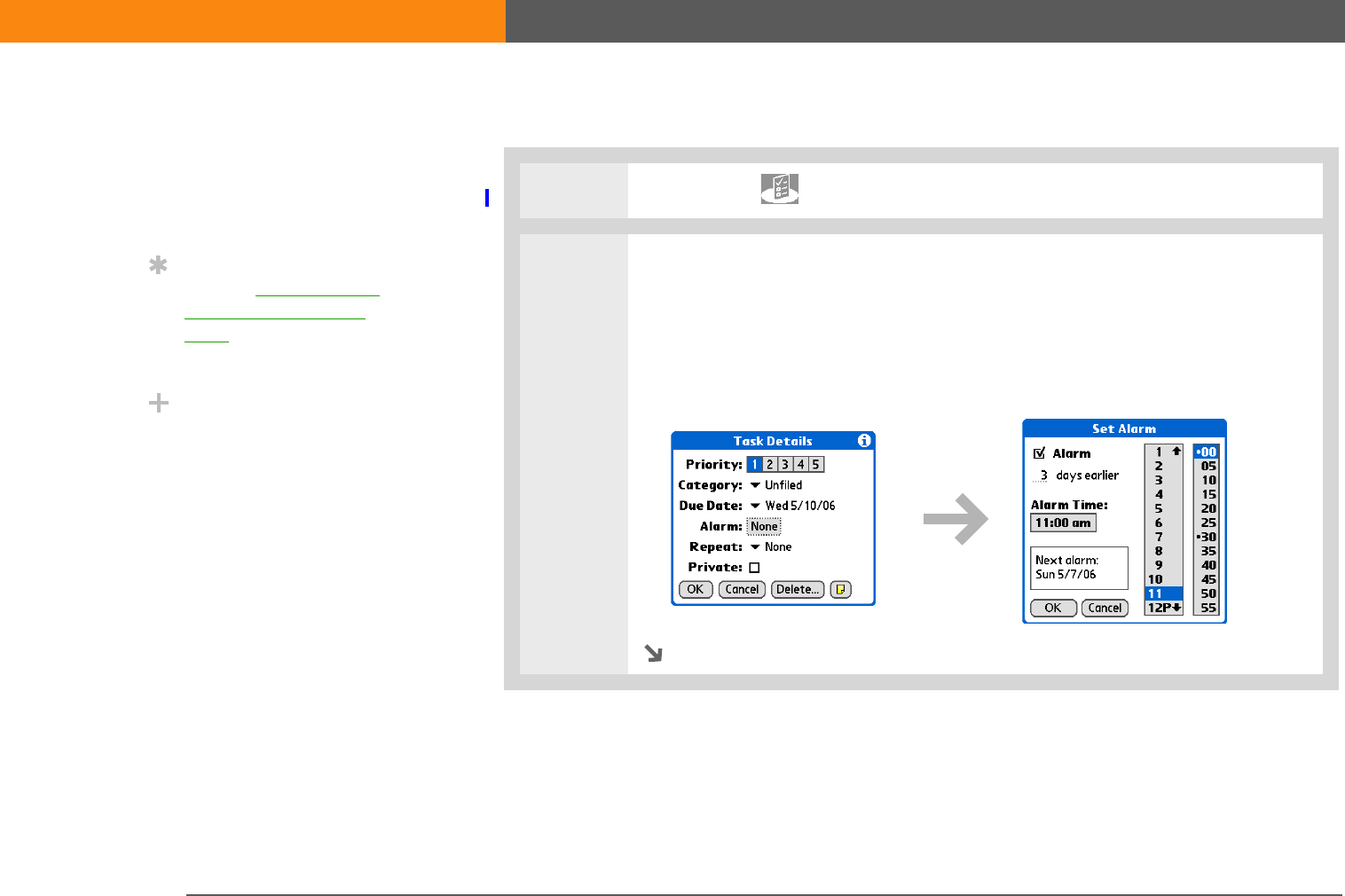
LifeDrive from palmOne 249
CHAPTER 12 Managing Your Tasks
Setting an alarm
0
1Tap the Tasks icon in the input area.
2Open the Set Alarm dialog box:
a. Select the task you want to assign an alarm to.
b. Select Details.
c. Select the Alarm box.
Continued
Before You Begin
[!]
Create a task and assign it
a due date. A task must
have a due date before
you can set an alarm.
Tip
You can customize the
alarm sound for your
tasks in the Task
Preferences dialog box.
Did You Know?
When you set an alarm, a
little alarm clock appears
to the right of the task
description.
SECOND DRAFT palmOne, Inc. Confidential
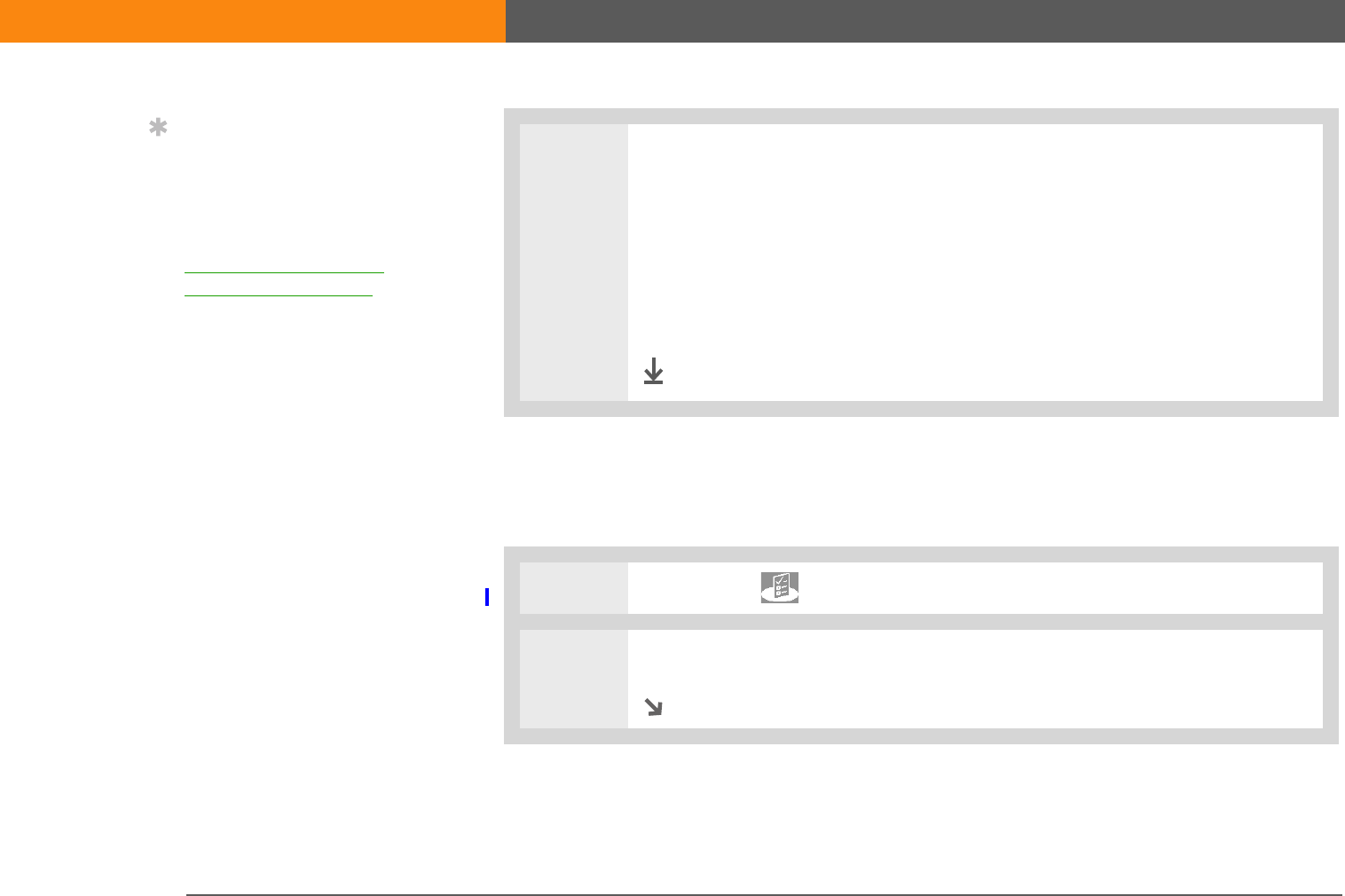
LifeDrive from palmOne 250
CHAPTER 12 Managing Your Tasks
Scheduling a repeating task—standard interval
Repeating tasks are a great way to add tasks that happen over and over again, like taking out the
trash every Thursday night or making monthly mortgage or rent payments.
0
3Set the alarm:
a. Check the Alarm box.
b. Enter how many days before the due date you want the alarm to sound.
c. Select the time columns to set the time the alarm sounds.
d. Select OK, and then select OK again.
Done
1Tap the Tasks icon in the input area.
2Enter the task you want to repeat and assign it a due date.
Continued
Tip
To select intervals such as
the 2nd Tuesday of every
month or the 3rd
Thursday in November of
every year, see
Scheduling a repeating
task—unusual interval.
SECOND DRAFT palmOne, Inc. Confidential
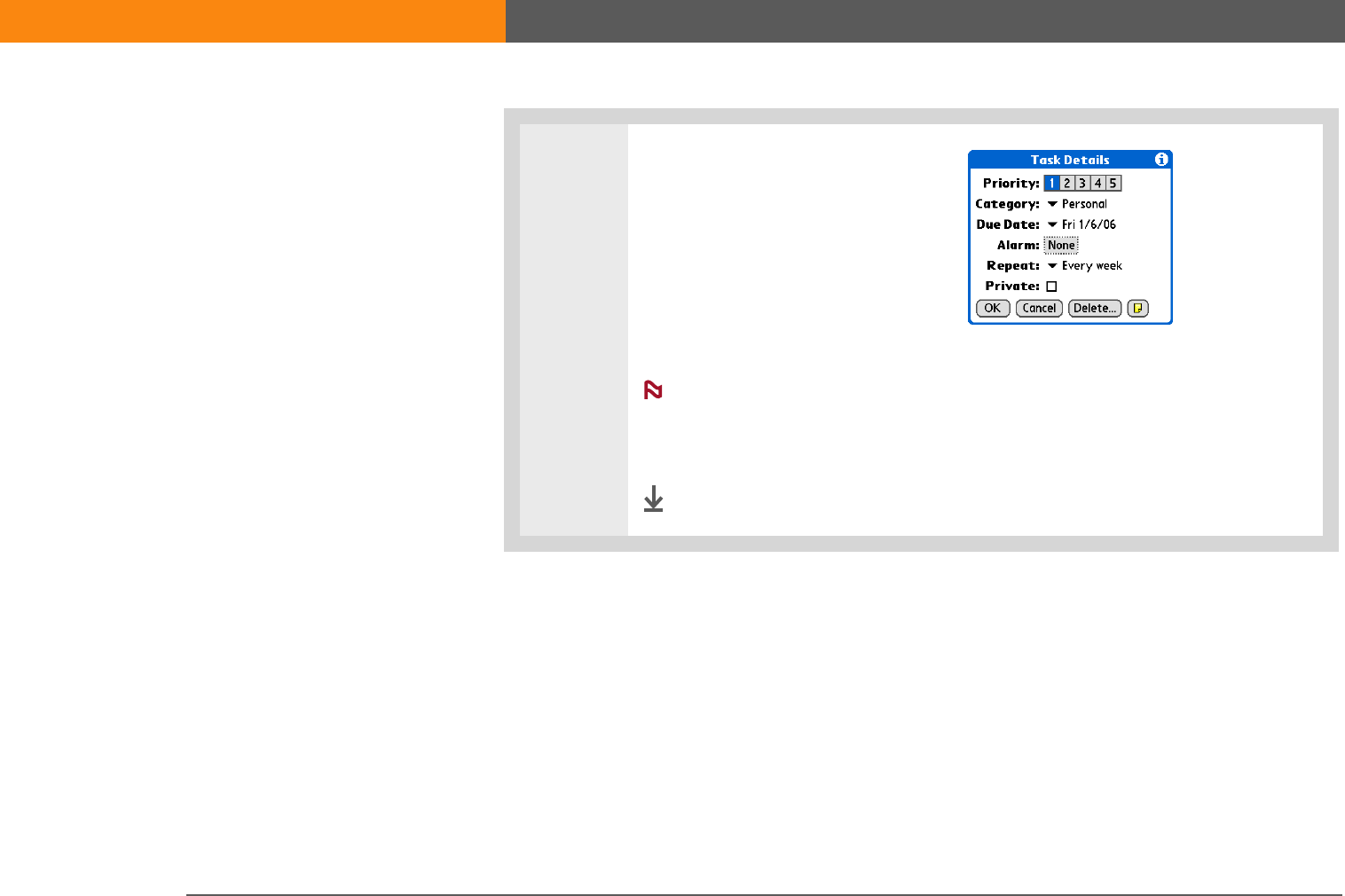
LifeDrive from palmOne 251
CHAPTER 12 Managing Your Tasks
3Set the repeat interval:
a. Select the task description, and
then select Details.
b. Select the Repeat pick list and
select how often the task
repeats: Daily until, Every week,
Every other week, Every month,
or Every year.
If you select Daily, a dialog box appears for you to select the end
date.
c. Select OK.
Done
NOTE
SECOND DRAFT palmOne, Inc. Confidential
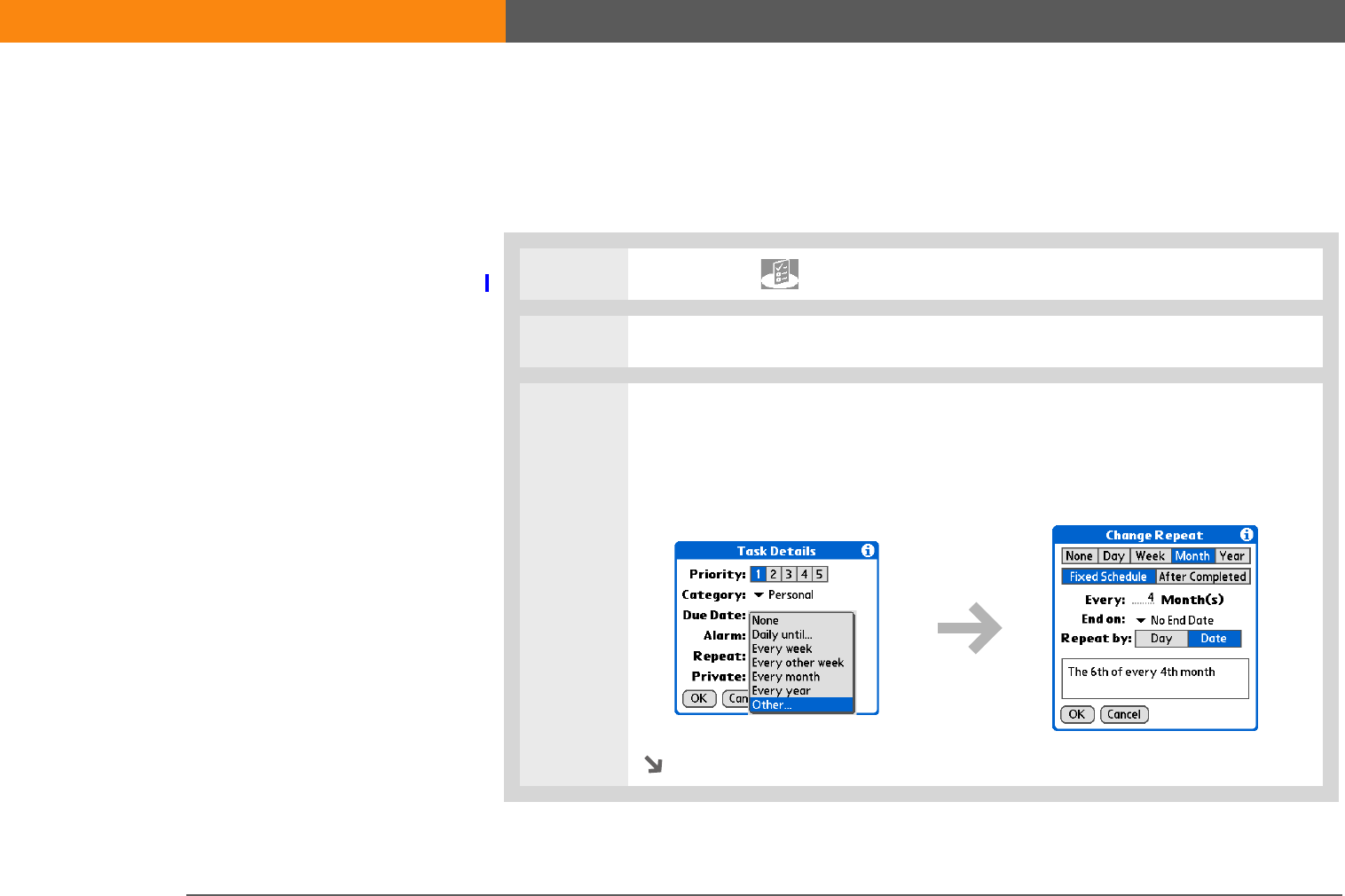
LifeDrive from palmOne 252
CHAPTER 12 Managing Your Tasks
Scheduling a repeating task—unusual interval
For tasks that don’t fit neatly into the preset repeat intervals, you can set up your own repeat
intervals. For example, enter tasks for paying a quarterly insurance bill or a credit card bill that is
due every 28 days, or changing your smoke detector battery every six months.
0
1Tap the Tasks icon in the input area.
2Enter the task you want to repeat and assign it a due date.
3Open the Change Repeat dialog box:
a. Select Details.
b. Select the Repeat pick list and select Other.
Continued
SECOND DRAFT palmOne, Inc. Confidential

LifeDrive from palmOne 253
CHAPTER 12 Managing Your Tasks
4Set the repeat interval:
a. Select Day, Week, Month, or Year as the repeat unit.
b. Select Fixed Schedule to base the due date on the due date of the current
task, or select After Completed to base the due date on the date you
complete this task. With this option if you complete this task early or late, the
due date for the next task adjusts accordingly.
c. Select the Every line and enter the frequency at which the task repeats.
d. Select the End on pick list and select an end date, if needed.
e. If you selected Fixed Schedule in step b and Week in step a, select the day of
the week the task repeats. If you selected Fixed Schedule in step b and
Month in step a, select Day to select the week within the month, such as the
4th Thursday, or select Date to select the same date within the month, such
as the 15th.
f. Select OK.
Done
Tip
To schedule an annual
task, such as decorating
for a holiday on the first
Sunday of a particular
month, select Month as
the repeat unit, enter 12
on the Every line, and
then select Day as the
Repeat By setting.
SECOND DRAFT palmOne, Inc. Confidential
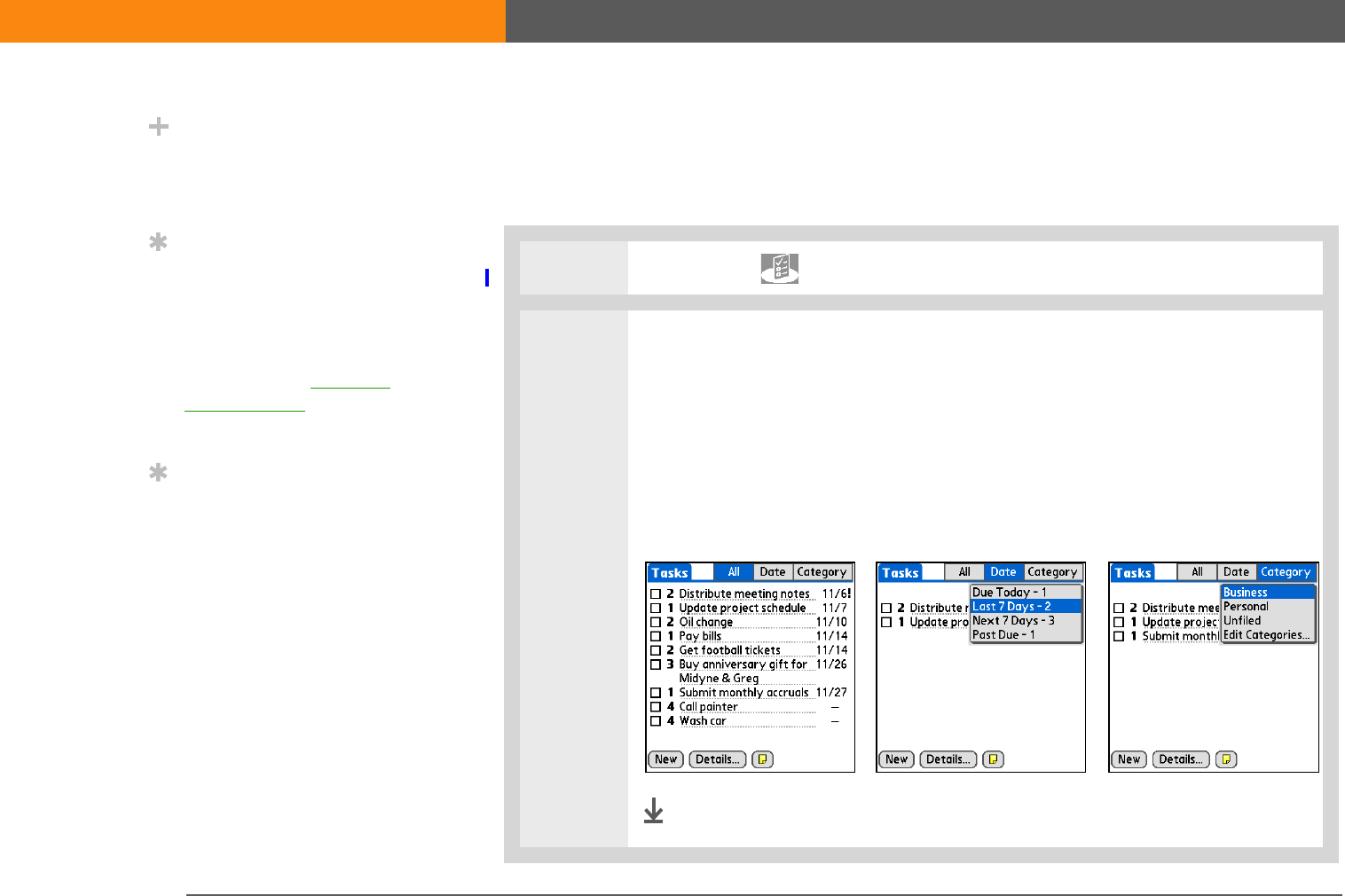
LifeDrive from palmOne 254
CHAPTER 12 Managing Your Tasks
Organizing your tasks
Sometimes you want to look at all the things you need to do, while at other times you want to see
only certain types of tasks.
0
1Tap the Tasks icon in the input area.
2In the Tasks list, select one of these options:
All Displays all your tasks.
Date Displays tasks that are due in a specific time frame. Select the pick list in
the upper-right to select Due Today, Last 7 Days, Next 7 Days, or Past Due.
Category Displays tasks that are assigned to the selected category. Select the
pick list in the upper-right to select a different category.
Done
Did You Know?
Overdue tasks have an
exclamation point (!) next
to the due date.
Tip
Your Task Preferences
settings control which
tasks appear in the Tasks
list, such as completed or
due tasks. To change
these settings, open the
Options menu and select
Preferences.
Tip
Create a new category for
tasks by selecting Edit
Categories in the
Category pick list.
SECOND DRAFT palmOne, Inc. Confidential
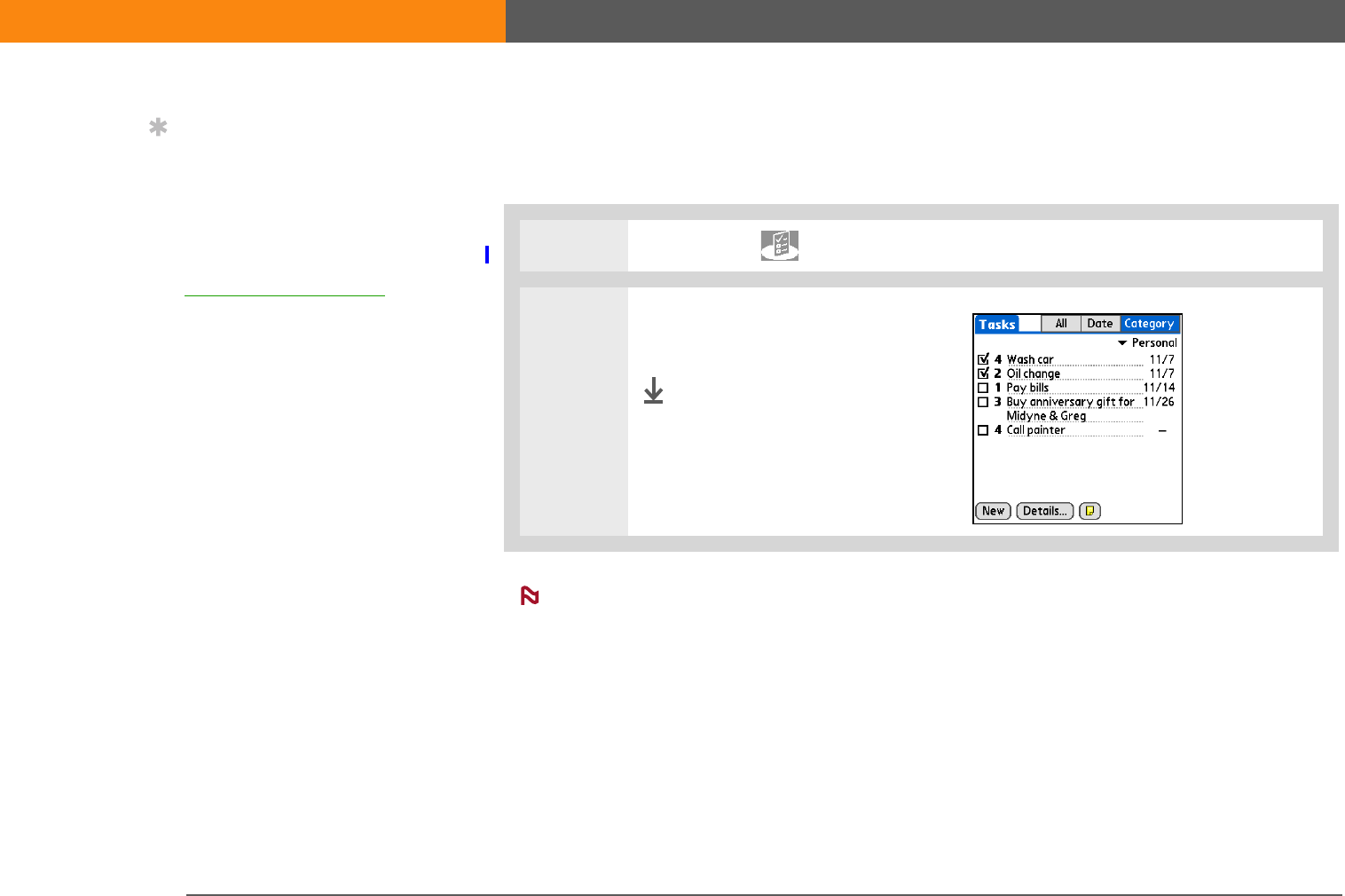
LifeDrive from palmOne 255
CHAPTER 12 Managing Your Tasks
Marking a task complete
You can check off a task to indicate that you’ve completed it.
0
Palm®Desktop software and Microsoft Outlook handle completed repeating tasks
differently. Palm Desktop software checks off all overdue instances of the task, and Microsoft
Outlook checks off only the oldest instance of the task.
1Tap the Tasks icon in the input area.
2Check the box on the left side of
the task.
Done
Tip
You can set Task
Preferences to record the
date that you finish your
tasks, and you can show
or hide finished tasks. To
change these settings,
open the Options menu
and select Preferences.
NOTE
SECOND DRAFT palmOne, Inc. Confidential
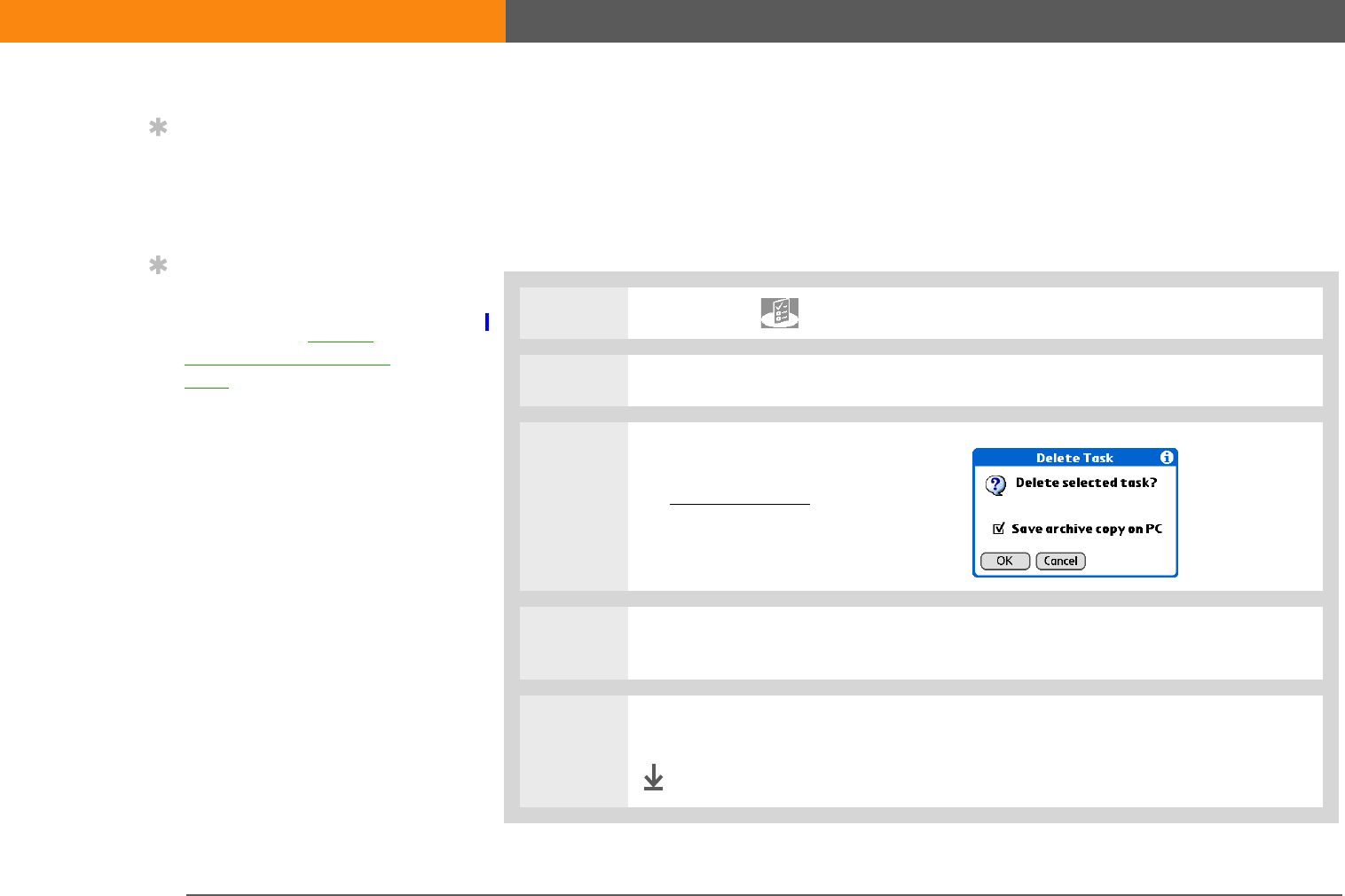
LifeDrive from palmOne 256
CHAPTER 12 Managing Your Tasks
Deleting tasks
If a task is cancelled, you can delete it from your Tasks list. When you delete a repeating task, you
delete all other instances of the task. You can also delete all your completed tasks.
Deleting a specific task
0
1Tap the Tasks icon in the input area.
2Select the task you want to delete.
3Open the Delete Task dialog box:
a. Open the menus.
b. Select Delete Task on the
Record menu.
4[ & ] OPTIONAL Check the box to save an archive copy of the task on your
computer.
5Select OK.
Done
Tip
You can also delete a
specific task by selecting
the task, selecting Details,
and then selecting Delete.
Tip
If you save an archive
copy of your deleted
tasks, you can refer to
them later by importing
them.
SECOND DRAFT palmOne, Inc. Confidential
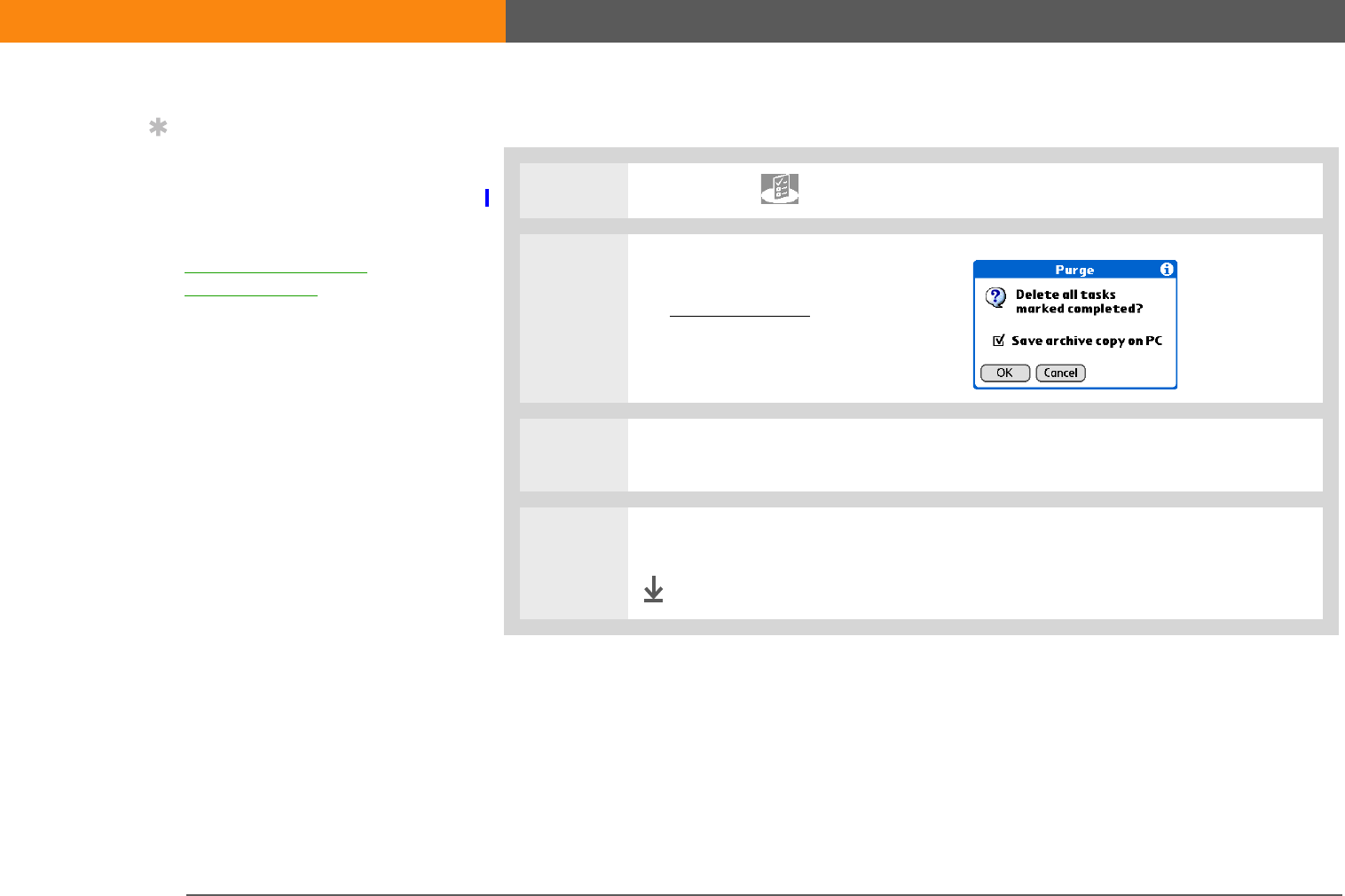
LifeDrive from palmOne 257
CHAPTER 12 Managing Your Tasks
Deleting all your completed tasks
0
1Tap the Tasks icon in the input area.
2Open the Purge dialog box:
a. Open the menus.
b. Select Purge on the Record
menu.
3[ & ] OPTIONAL Check the box to save an archive copy of your completed
tasks on your computer.
4Select OK.
Done
Tip
Many people find it useful
to refer to old tasks for tax
purposes. If you save an
archive copy of your
deleted tasks, you can
refer to them later by
importing them.
SECOND DRAFT palmOne, Inc. Confidential
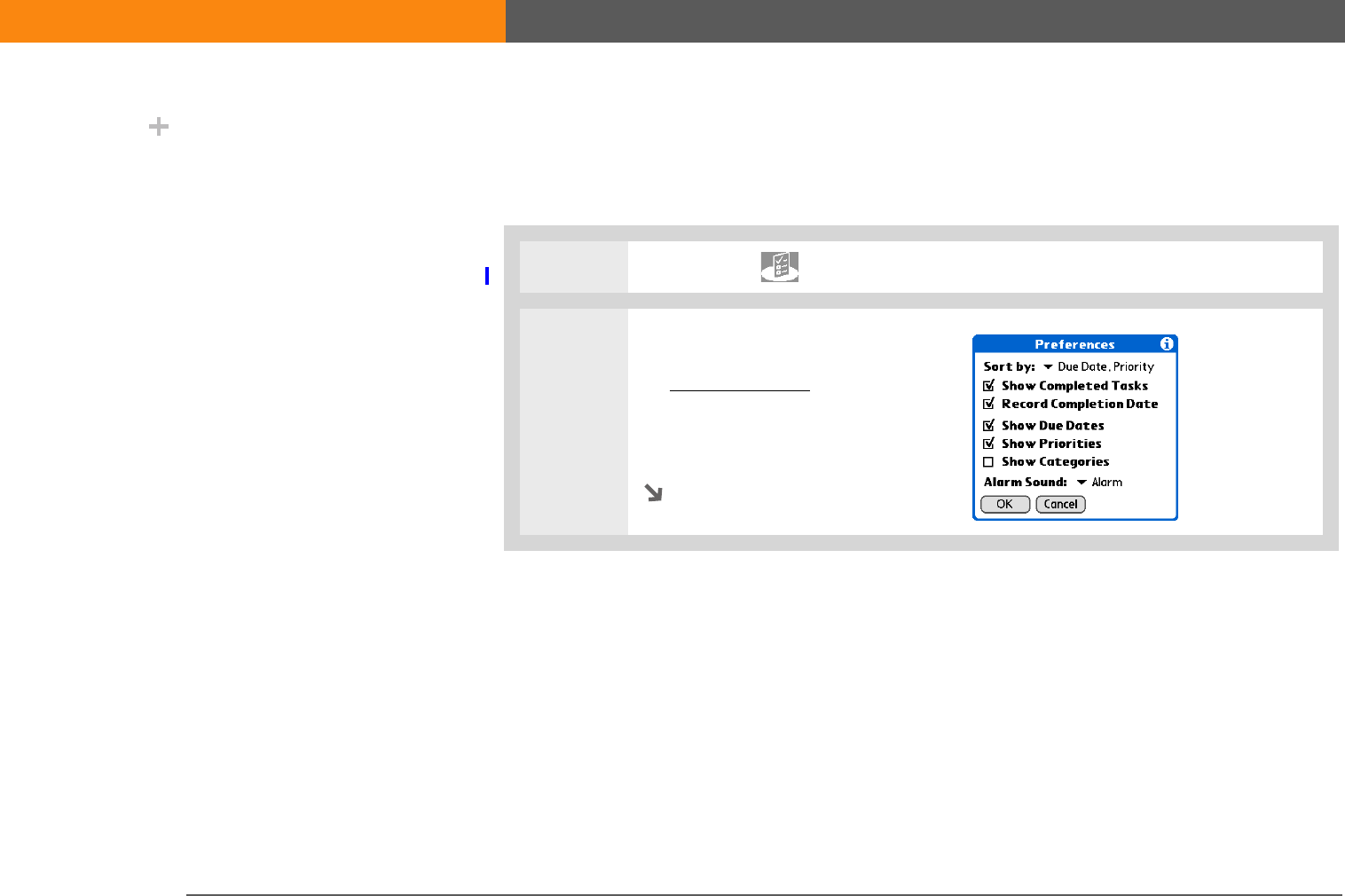
LifeDrive from palmOne 258
CHAPTER 12 Managing Your Tasks
Customizing your Tasks list
Control which tasks show up in the Tasks list and how they are sorted. These settings also affect
tasks in Calendar’s Agenda View. You can also choose the alarm sound for your tasks.
0
1Tap the Tasks icon in the input area.
2Open the Preferences dialog box:
a. Open the menus.
b. Select Options, and then
select Preferences.
Continued
Did You Know?
Calendar’s Agenda View
also displays your tasks.
SECOND DRAFT palmOne, Inc. Confidential

LifeDrive from palmOne 259
CHAPTER 12 Managing Your Tasks
3Change any of the following settings, and then select OK:
Sort by Select the order in which the tasks appear in the Tasks list.
Show Completed Tasks Display your finished tasks in the Tasks list. If you turn
off this setting, your finished tasks disappear from the list when you check them
off, but they stay in your device’s memory until you purge them.
Record Completion Date Replace the due date you assign to a task with the
date you really complete and check off the task. If you don’t assign a due date to
a task, the completion date still records when you complete the task.
Show Due Dates Display each task’s due date in the list (if you assigned one),
and display an exclamation point next to each task that is overdue.
Show Priorities Show the priority setting for each task in the list.
Show Categories Show the category for each task in the list.
Alarm Sound Select a sound for the alarms you assign to your tasks.
Done
SECOND DRAFT palmOne, Inc. Confidential

LifeDrive from palmOne 260
CHAPTER 12 Managing Your Tasks
Working with Tasks on your computer
Use Tasks on your computer to view and manage your tasks. Check out the online Help in
Palm Desktop software to learn how to use Tasks on your computer. The online Help includes info
about the following topics:
• Learning about the parts of the Tasks window
• Entering, editing, and deleting tasks
• Creating repeating tasks
• Marking tasks private
• Showing, masking, and hiding private tasks
• Assigning tasks to categories
• Printing your task list
• Selecting how to view tasks
• Sorting tasks by due date, priority level, or categories
WINDOWS ONLY
To open Tasks on your computer, double-click the Palm Desktop icon on the Windows desktop,
and then click Tasks on the Launch bar.
MAC ONLY
To open Tasks on your computer, double-click the Palm Desktop icon in the Palm folder, and then
click To Dos.
SECOND DRAFT palmOne, Inc. Confidential

LifeDrive from palmOne 261
CHAPTER 12 Managing Your Tasks
Related topics
Click a link below to learn about these related topics:
VersaMail Sending tasks as attachments to email messages
Sharing • Beaming tasks to other Palm Powered™ devices
• Sending tasks to other Bluetooth® devices by using Bluetooth wireless
technology on your device
• Synchronizing with Palm Desktop software and Outlook
Privacy Keeping tasks private by turning on security options
Categories Organizing tasks by type
Common
Questions
Answers to frequently asked questions about Tasks
Tips & Tricks
Make your device uniquely
yours. For great tips,
software, accessories, and
more, visit
www.palmOne.com/
mylifedrive.
Support
If you’re having problems
with Tasks or with anything
else on your device, go to
www.palmOne.com/
support.
SECOND DRAFT palmOne, Inc. Confidential

LifeDrive from palmOne 262
CHAPTER 13
Writing Memos
Your device contains applications for
storing the most common types of
information: contact names and
numbers, appointments, and so on.
Memos is the tool to use for capturing
information that is meaningful to you
but does not fall into one of these
categories. From meeting notes to
recipes and favorite quotations,
Memos provides a quick and easy way
to enter, store, and share your
important information. Benefits of Memos
• Store essential but hard-to-remember
information
• Send memos to colleagues wirelessly
• Synchronize your information to back
it up on your computer
I
n t
hi
s c
h
apter
Creating a memo
Viewing and editing a memo
Moving memos in your
memos list
Deleting a memo
Working with Memos on
your computer
Related topics
SECOND DRAFT palmOne, Inc. Confidential
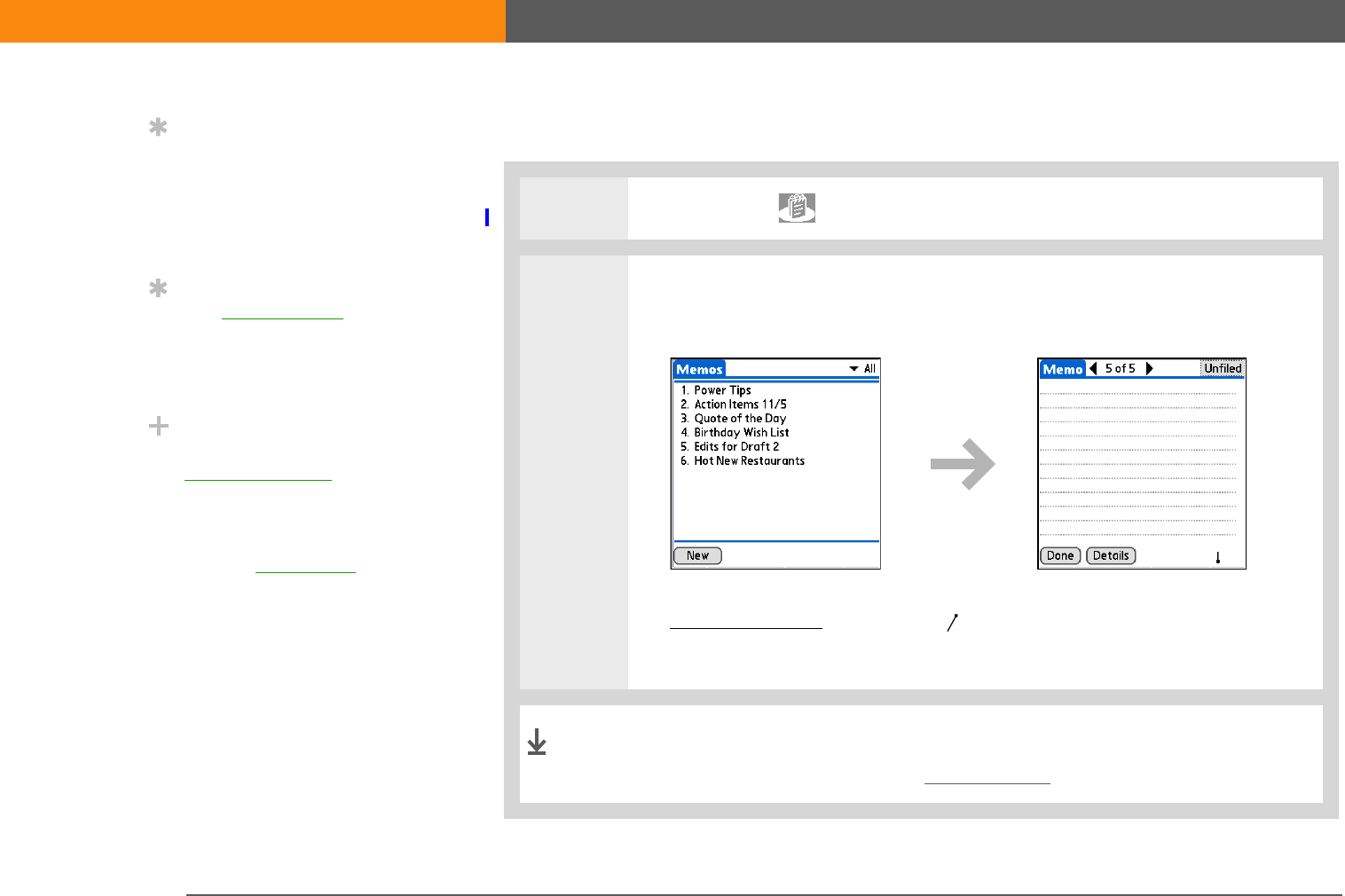
LifeDrive from palmOne 263
CHAPTER 13 Writing Memos
Creating a memo
0
1Tap the Memos icon in the input area.
2Create a memo:
a. Select New.
b. Enter your memo. Tap Enter on the onscreen keyboard or draw the
Graffiti® 2 writing Return stroke to move to a new line in the memo.
c. Select Done.
That's it. Your device automatically saves the memo. Make sure
you have a current backup. Synchronize often.
Tip
In the Memos list, you
can also just start writing
to create a new memo.
The first letter is
automatically capitalized.
Tip
Use Phone Lookup to
quickly add a name and
phone number to a
memo.
Did You Know?
Memos info is stored in
program memory. This
means that you can view
the info only by looking at
it in the application and
you can synchronize the
information by pressing
the sync button on the
USB cable. Info in Memos
can be synchronized with
info in either
Palm®Desktop software
or Outlook. Done
SECOND DRAFT palmOne, Inc. Confidential

LifeDrive from palmOne 264
CHAPTER 13 Writing Memos
Viewing and editing a memo
0
1Tap the Memos icon in the input area.
2View or edit the memo:
a. In the Memos list, select the memo you want.
b. Read or edit the memo, and then select Done.
Done
Tip
The Memos list shows
the first line of each
memo, so make sure that
first line is something you
will recognize.
Did You Know?
You can connect your
device to a portable
keyboard and type your
memos on the go without
carrying around a heavy
laptop. You can purchase
a variety of portable
keyboards. Visit
www.palmOne.com/
mylifedrive and click the
Accessories link.
Tip
You can change the size
of the text in Memos to
enhance readability.
SECOND DRAFT palmOne, Inc. Confidential
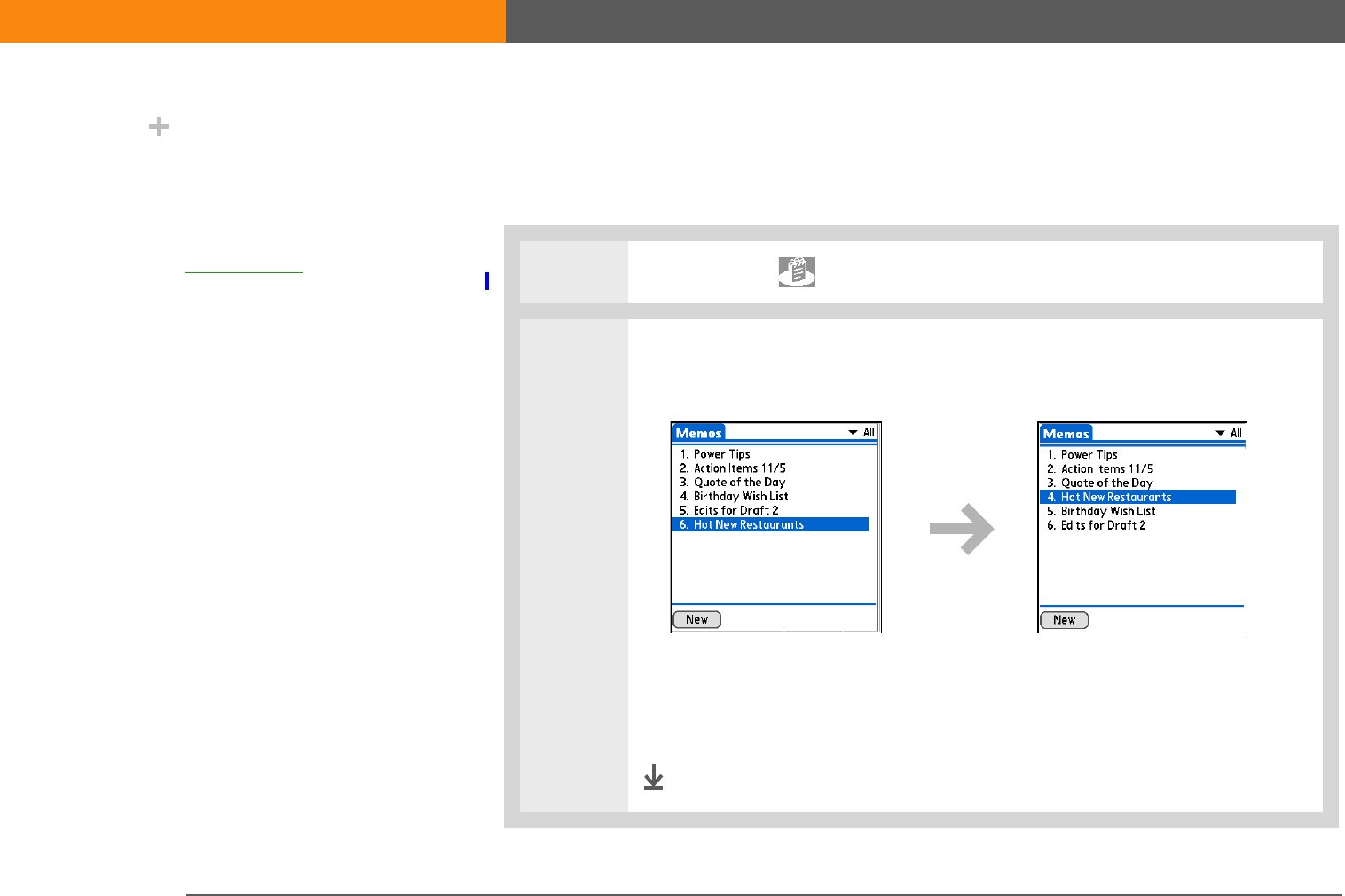
LifeDrive from palmOne 265
CHAPTER 13 Writing Memos
Moving memos in your memos list
You can move memos up or down in your memos list. For example, you might want to keep all
memos on a certain topic grouped together.
0
1Tap the Memos icon in the input area.
2Move a memo:
a. Locate the memo you want.
b. Move the memo up or down by dragging the stylus across the screen.
A black dotted line appears to represent the memo you are moving.
c. When the line is in the location you want for your memo, lift the stylus.
Done
Did You Know?
If you use Palm Desktop
software for
synchronizing, you can
send a memo to your
computer by
synchronizing, and then
open the memo on your
computer in an
application such as
Microsoft Word for
further editing,
formatting, and so on.
Right-click the memo on
your computer, click Send
To, and then select the
application to which you
want to send the memo.
SECOND DRAFT palmOne, Inc. Confidential
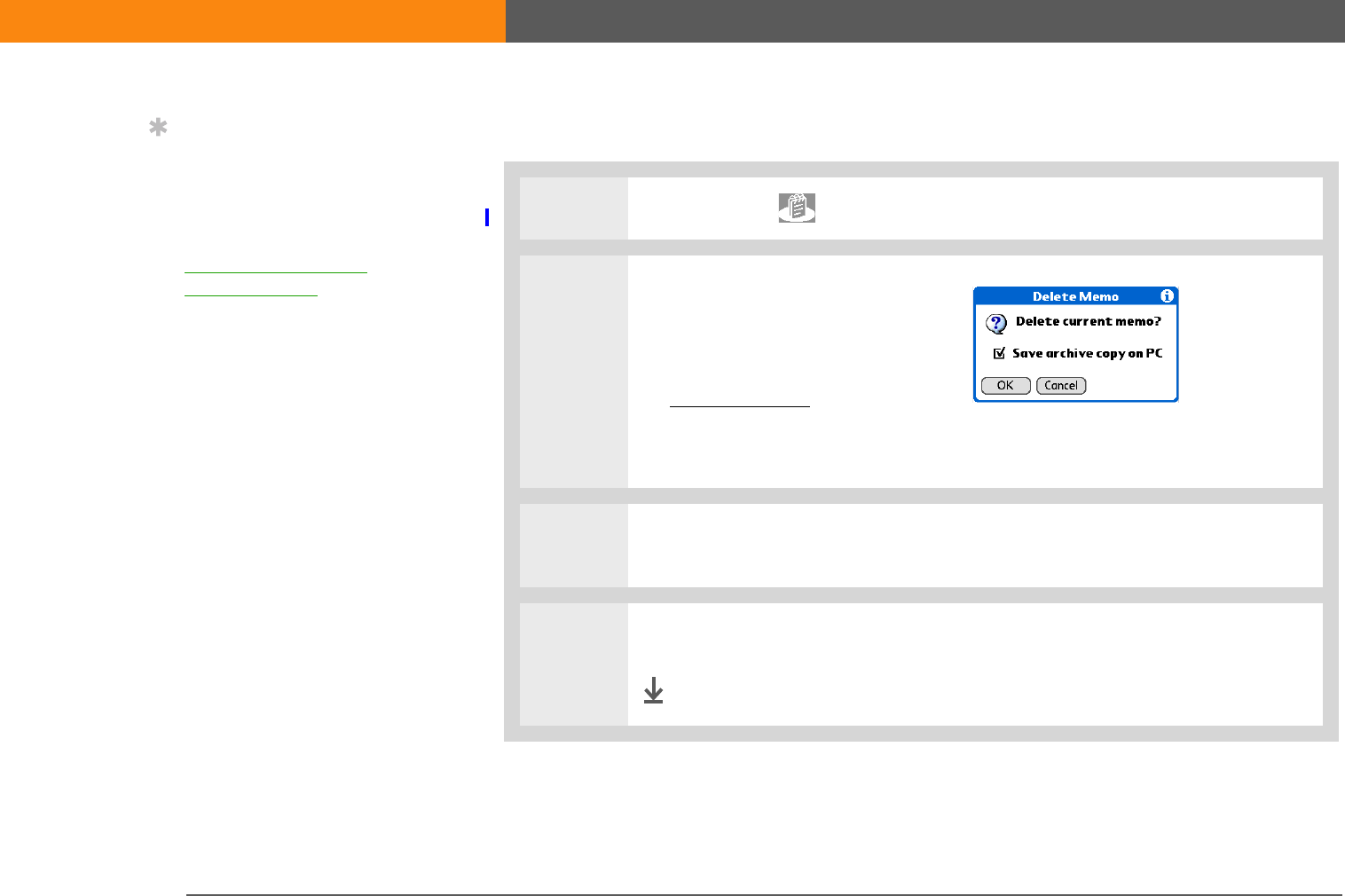
LifeDrive from palmOne 266
CHAPTER 13 Writing Memos
Deleting a memo
0
1Tap the Memos icon in the input area.
2Open the Delete Memo dialog
box:
a. Locate the memo you want.
b. Open the menus.
c. Select Delete Memo on the
Record menu.
3[ & ] OPTIONAL Check the box to save an archive copy of the memo on your
computer.
4Select OK.
Done
Tip
Need to retrieve that
holiday recipe you
stored? If you save an
archive copy of your
deleted memos, you can
refer to them later by
importing them.
SECOND DRAFT palmOne, Inc. Confidential

LifeDrive from palmOne 267
CHAPTER 13 Writing Memos
Working with Memos on your computer
Use Memos on your computer to view and manage the memos you create on your device. Check
out the online Help in Palm®Desktop software to learn how to use Memos on your computer. The
online Help includes info about the following topics:
• Viewing, copying, and deleting memos
• Editing memo details
• Marking memos private
• Showing, masking, and hiding private memos
• Printing memos
• Changing between the list and single memo views
• Adding a date and time stamp to a memo
• Organizing memos into categories
• Sorting memos
•Sharing memos
WINDOWS ONLY
To open Memos on your computer, double-click the Palm Desktop icon on the Windows desktop,
and then click Memos on the Launch bar.
MAC ONLY
To open Memos on your computer, launch Palm Desktop software from the Palm folder, and then
select Memos.
Tip
You can copy the text of a
memo and paste it into a
new Word file in
Documents on your
device. Edit the text in
Documents, save it as a
Microsoft Word file, and
then send the file to your
computer by
synchronizing so you can
view and edit it in Word.
SECOND DRAFT palmOne, Inc. Confidential

LifeDrive from palmOne 268
CHAPTER 13 Writing Memos
Related topics
Click a link below to learn about these related topics:
Moving
Around
• Opening applications
• Using menus
Entering
Information
Adding a phone number or other contact information to a memo using Phone
Lookup
Categories Organizing memos by arranging them into categories and sorting them
Privacy Keeping memos private by turning on security options
Sharing • Beaming memos to other Palm Powered™ devices
• Sending memos to other Bluetooth® devices using the Bluetooth wireless
technology on your device
• Synchronizing with Palm Desktop software and Outlook
VersaMail Sending memos as attachments to email messages
SMS Sending memos as part of a text message
Common
Questions
Answers to frequently asked questions about Memos
Tips & Tricks
Make your device uniquely
yours. For great tips,
software, accessories, and
more, visit
www.palmOne.com/
mylifedrive.
Support
If you’re having problems
with Memos or with anything
else on your device, go to
www.palmOne.com/
lifedrive-userguide.
SECOND DRAFT palmOne, Inc. Confidential

LifeDrive from palmOne 269
CHAPTER 14
Writing Notes in Note Pad
Need to jot down a phone number or a
reminder to yourself? Avoid fumbling
for scraps of paper, and write
important reminders in Note Pad. You
can use Note Pad to do everything you
might do with a piece of paper and a
pencil, such as drawing a quick sketch.
Note Pad gives you a place to draw
freehand and take notes in your
personal handwriting, which is even
faster and more flexible than creating a
memo on your device.
Benefits of Note Pad
• Capture information in the moment
• A picture is worth a thousand words
• See reminders when you set alarms
• Send notes to colleagues wirelessly
I
n t
hi
s c
h
apter
Creating a note
Viewing and editing a note
Deleting a note
Working with Note Pad on
your computer
Related topics
SECOND DRAFT palmOne, Inc. Confidential
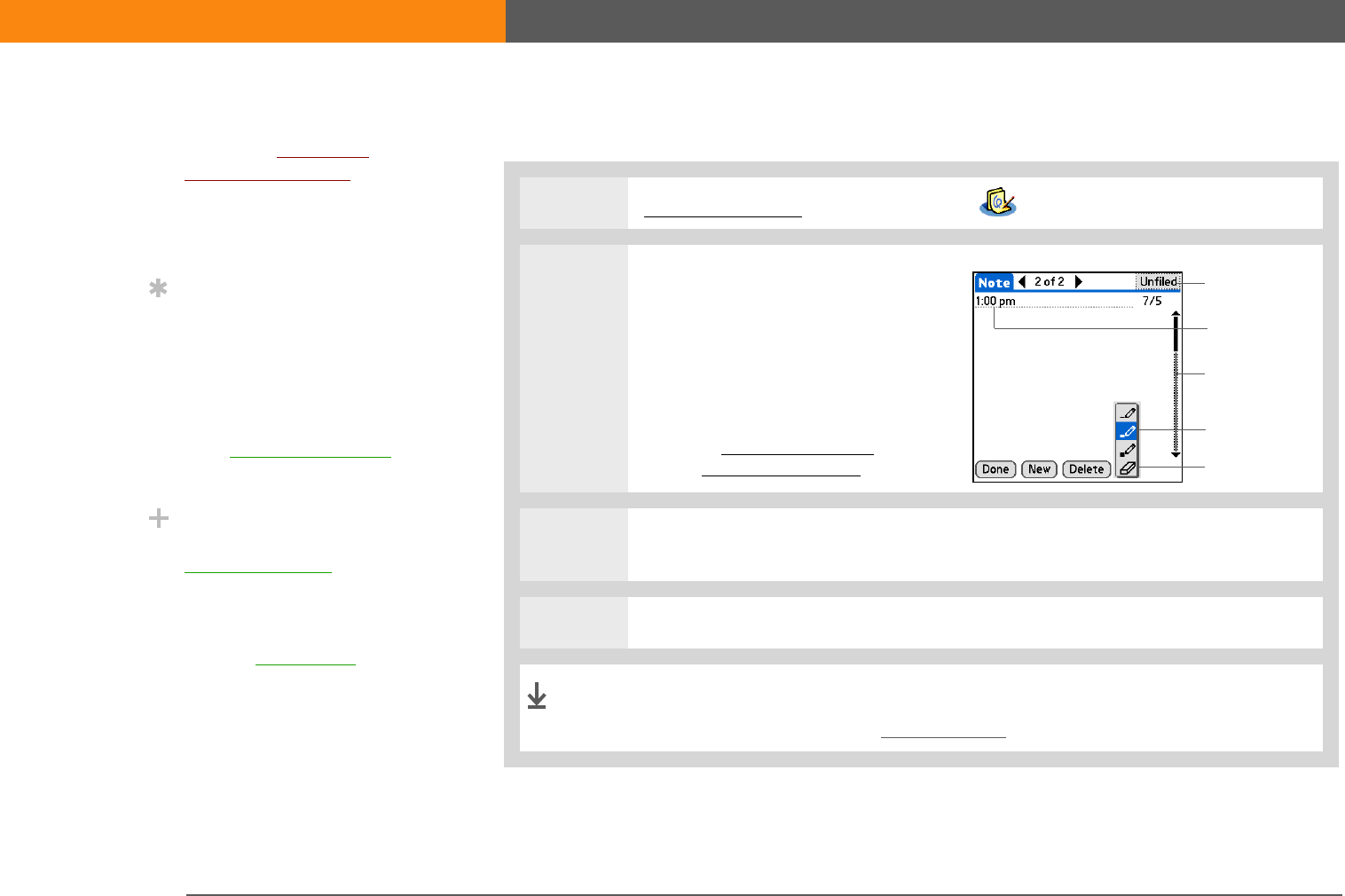
LifeDrive from palmOne 270
CHAPTER 14 Writing Notes in Note Pad
Creating a note
0
1Go to Applications and select Note Pad .
2Create a note:
a. Use the stylus to write your
note directly on the device
screen.
b. Select the time at the top of
the screen and enter a title
using Graffiti® 2 writing or
the onscreen keyboard.
3[ & ] OPTIONAL Assign the note to a category by selecting the Category box
in the upper-right corner, and then selecting a category.
4Select Done.
That’s it. Your device automatically saves the note. Make sure you
have a current backup. Synchronize often.
Before You Begin
[!]
Make sure full-screen
writing is turned off. You
cannot create or edit
notes in Note Pad when
full-screen writing is on.
Tip
Select the pen selector to
change the pen width or
to select the eraser. To
clear the screen
completely, select the
note (anywhere but the
title), open the Edit menu,
and select Clear Note.
Did You Know?
Note Pad info is stored in
program memory. This
means that you can view
the info only by looking at
it in the application and
you can synchronize the
information by pressing
the sync button on the
USB cable.
Pen selector
Scroll bar
Time or title
Eraser
Category box
Done
SECOND DRAFT palmOne, Inc. Confidential
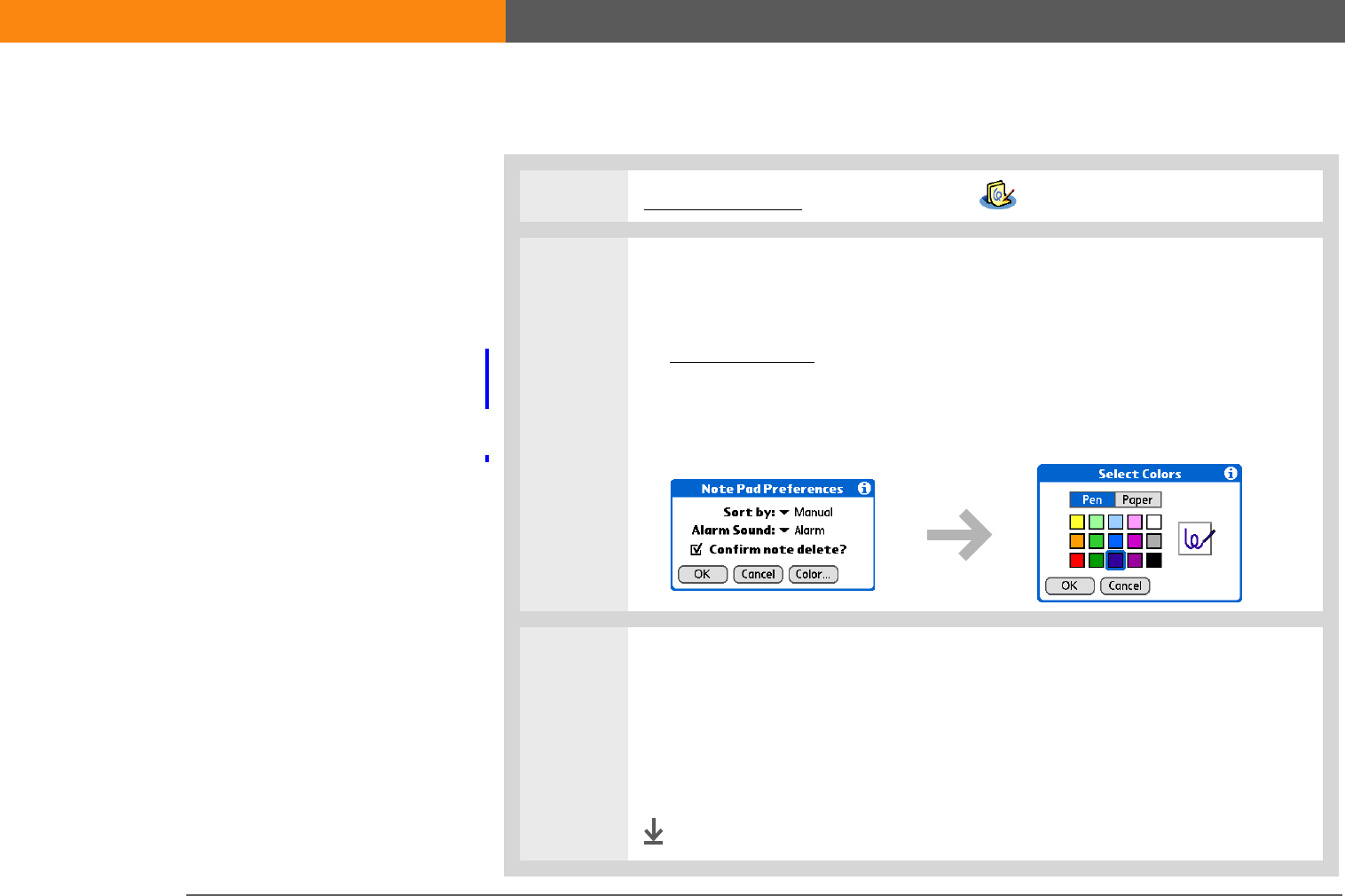
LifeDrive from palmOne 271
CHAPTER 14 Writing Notes in Note Pad
Choosing the pen and paper (background) colors
0
0
1Go to Applications and select Note Pad .
2Open the Select Colors dialog box:
a. Select Done to display the Note Pad list.
b. Open the menus.
c. Select Options, and then select Preferences.
d. Select Color.
3Select the pen and paper colors:
a. Select Pen, and then select the ink color you want to use.
b. Select Paper, and then select the background color you want to use.
c. Select OK, and then select OK again.
Done
SECOND DRAFT palmOne, Inc. Confidential
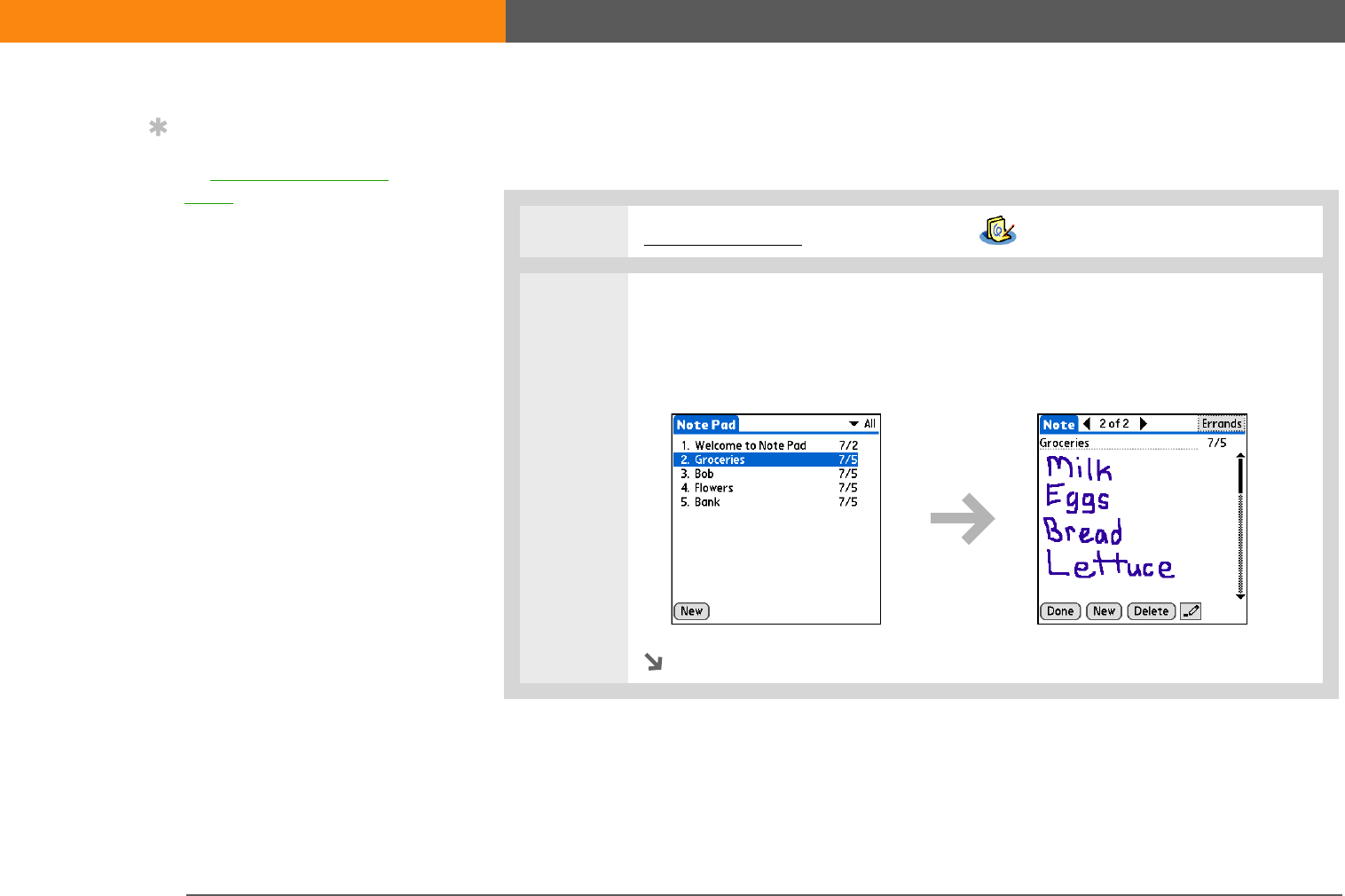
LifeDrive from palmOne 272
CHAPTER 14 Writing Notes in Note Pad
Setting an alarm
To use a note as a reminder, set an alarm for that note.
0
1Go to Applications and select Note Pad .
2Open the note:
a. Select Done to display the Note Pad list.
b. Select the note you want to set an alarm for.
Continued
Tip
Change the alarm sound
by opening the Options
menu, selecting
Preferences, and then
selecting a sound from
the Alarm Sound pick list.
SECOND DRAFT palmOne, Inc. Confidential
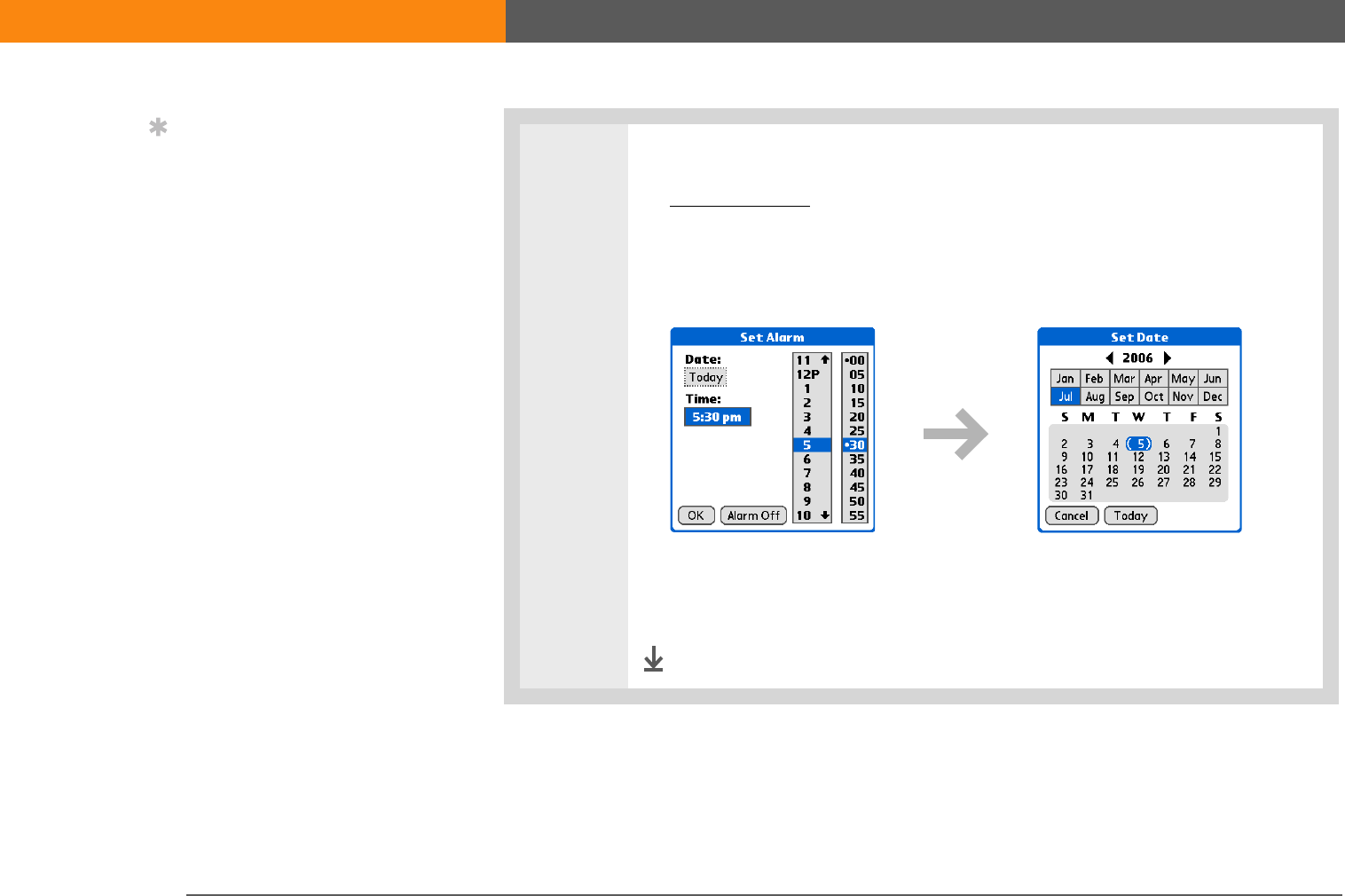
LifeDrive from palmOne 273
CHAPTER 14 Writing Notes in Note Pad
3Set the alarm:
a. Open the menus.
b. Select Options, and then select Alarm.
c. Select the Date box, and then select the year, month, and date you want the
alarm to sound.
d. Select the time you want the alarm to sound.
e. Select OK.
Done
Tip
You can also open the Set
Alarm dialog box by
selecting a note and
tapping the right edge of
the screen next to the
note title.
SECOND DRAFT palmOne, Inc. Confidential
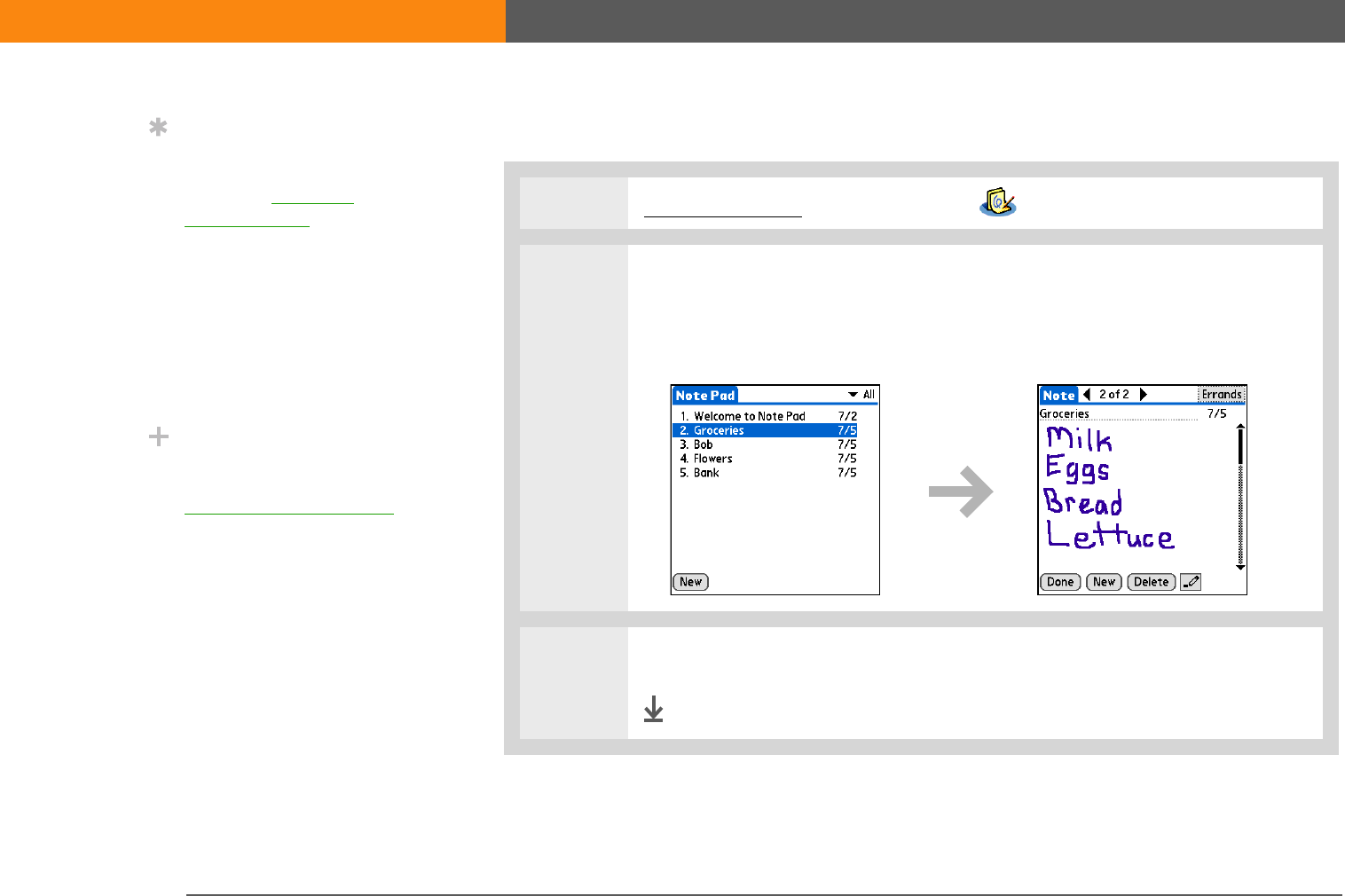
LifeDrive from palmOne 274
CHAPTER 14 Writing Notes in Note Pad
Viewing and editing a note
0
1Go to Applications and select Note Pad .
2Open the note:
a. Select Done to display the Note Pad list.
b. Select the note you want to view or edit.
3Read or edit the note, and then select Done.
Done
Tip
Sort the Note Pad list
alphabetically, by date, or
manually. Open the
Options menu, select
Preferences, and then
select the Sort by pick list.
If you sort manually, you
can rearrange the list by
dragging notes to
another position in the
list.
Did You Know?
Prevent others from
viewing your notes by
marking them as private.
SECOND DRAFT palmOne, Inc. Confidential
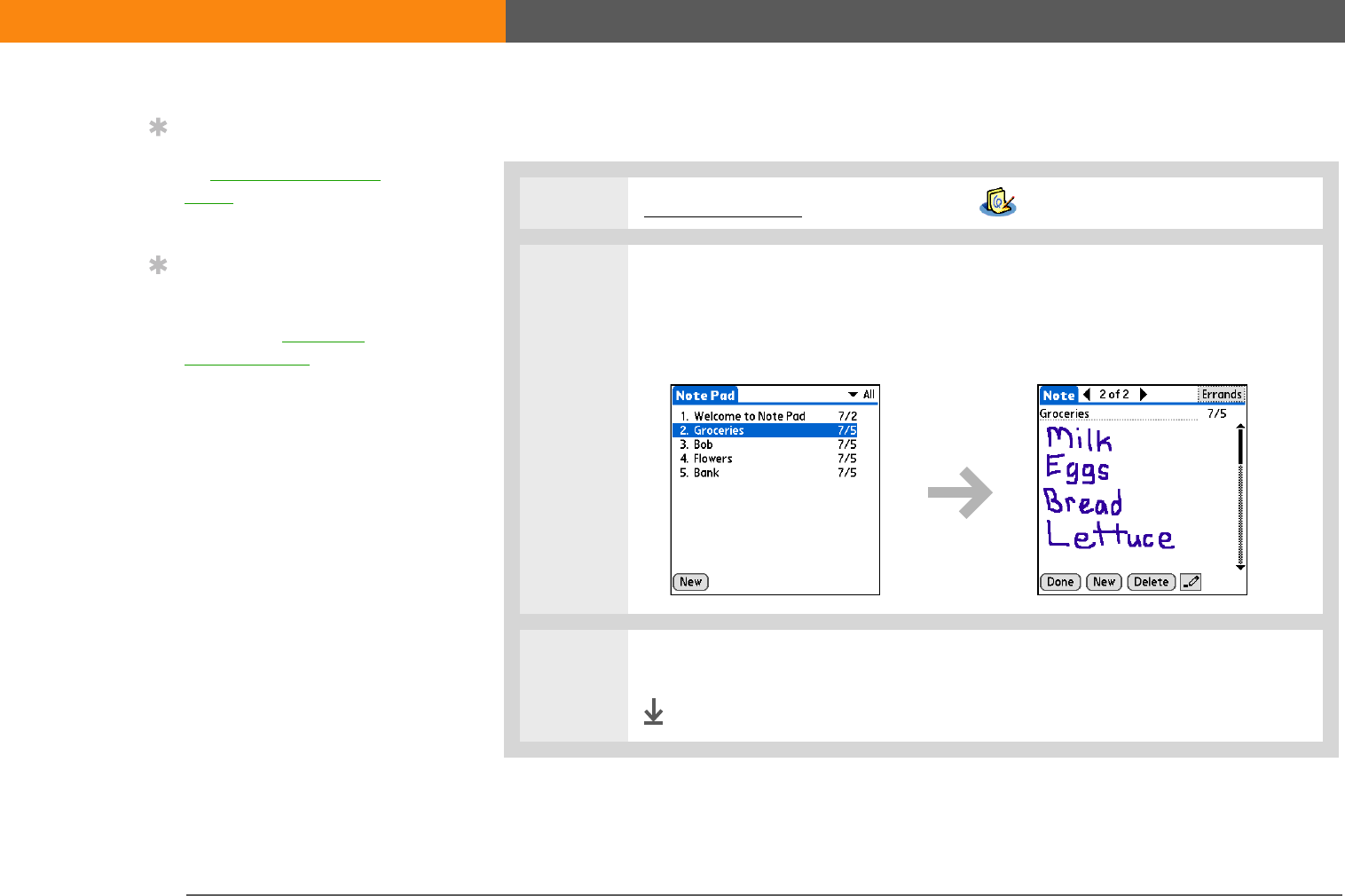
LifeDrive from palmOne 275
CHAPTER 14 Writing Notes in Note Pad
Deleting a note
0
1Go to Applications and select Note Pad .
2Open the note:
a. Select Done to display the Note Pad list.
b. Select the note you want to delete.
3Select Delete, and then select OK to confirm deletion.
Done
Tip
You can also delete a note
by opening the Record
menu and selecting
Delete Note.
Tip
Want to get rid of those
deletion confirmation
messages? Open the
Options menu, select
Preferences, and then
uncheck the Confirm note
delete box.
SECOND DRAFT palmOne, Inc. Confidential

LifeDrive from palmOne 276
CHAPTER 14 Writing Notes in Note Pad
Working with Note Pad on your computer
Use Note Pad on your computer to view and manage the handwritten notes you create on your
device. Check out the online Help in Palm®Desktop software to learn how to use Note Pad on your
computer. The online Help includes info about the following topics:
• Learning about the parts of the Note Pad window
• Viewing, copying, and deleting notes
• Editing note details and titles
• Setting an alarm for a note
• Marking notes private
• Showing, masking, and hiding private notes
• Printing notes
• Changing between the List and note Preview views
• Sorting notes
• Sharing notes
WINDOWS ONLY
To open Note Pad on your computer, double-click the Palm Desktop icon on the Windows desktop,
and then click Note Pad on the Launch bar.
MAC ONLY
To open Note Pad on your computer, double-click the Note Pad icon in the Palm folder.
SECOND DRAFT palmOne, Inc. Confidential

LifeDrive from palmOne 277
CHAPTER 14 Writing Notes in Note Pad
Related topics
Click a link below to learn about these related topics:
Moving
Around
• Opening applications
• Using menus
Sharing • Beaming notes to other Palm Powered™ devices
• Sending notes to other Bluetooth® devices by using Bluetooth wireless
technology on your device
VersaMail Sending notes as attachments to email messages
Privacy Keeping notes private by turning on security options
Categories Creating categories so you can organize notes
Common
Questions
Answers to frequently asked questions about Notes
Tips & Tricks
Make your device uniquely
yours. For great tips,
software, accessories, and
more, visit
www.palmOne.com/
mylifedrive.
Support
If you’re having problems
with Note Pad or with
anything else on your device,
go to www.palmOne.com/
support.
SECOND DRAFT palmOne, Inc. Confidential
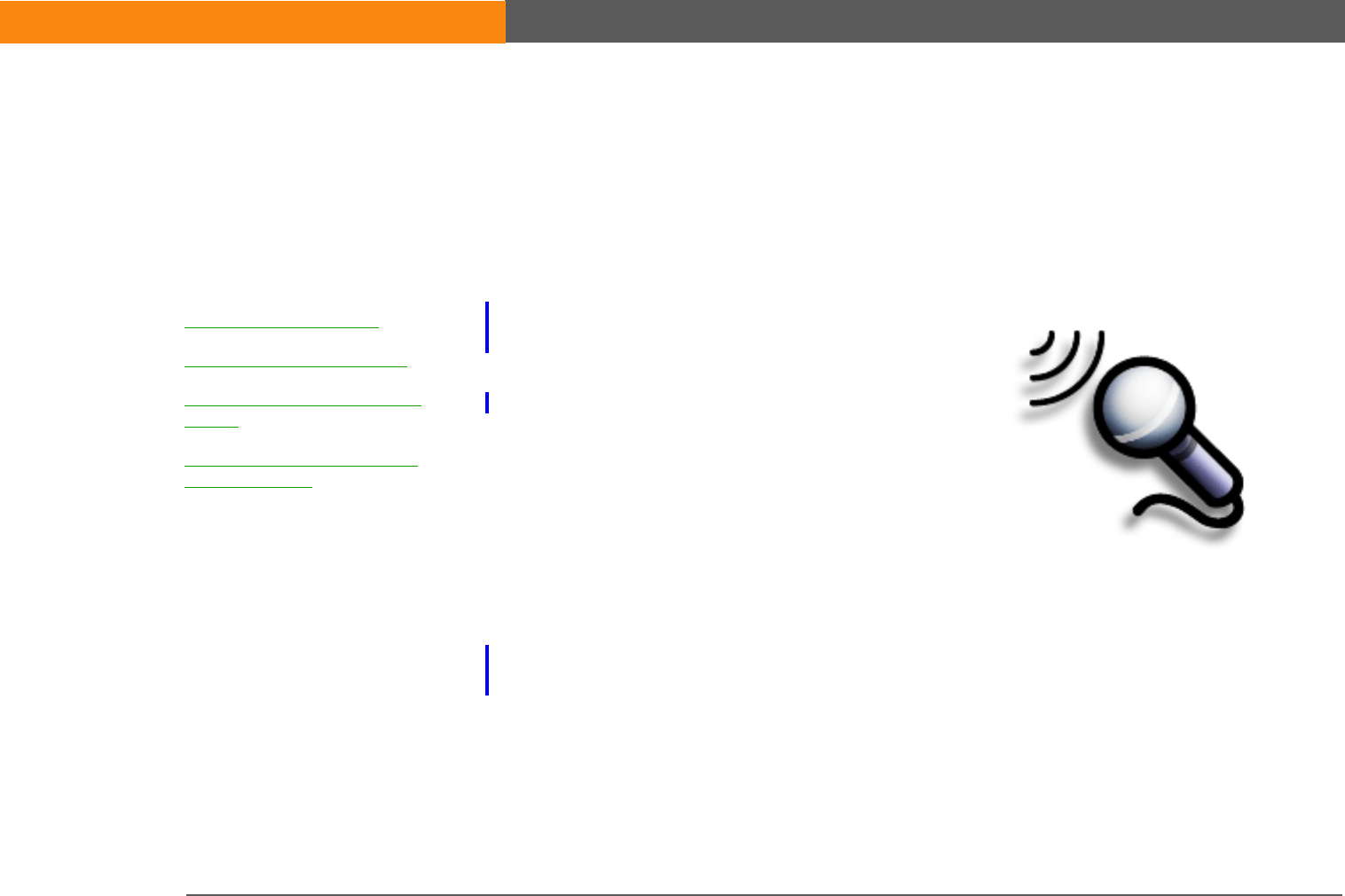
LifeDrive™Device 278
CHAPTER 15
Recording Voice Memos
An important idea pops into your head,
and you need to record it before you
forget it. If a brilliant marketing idea
hits when you’re away from your
office, Voice Memo is the tool you
need.
Voice Memo provides a place for you
to record and play back notes, agenda
items, and other important thoughts
directly on your handheld. Record
client meeting notes on the way to the
office, and then send them to your
assistant in an e-mail to transcribe
them. Or use a voice memo with an
alarm as a reminder message for that
errand you promised not to forget.
Benefits of Voice Memo
• Capture thoughts on the fly
• Send recorded memos to colleagues
• Synchronize voice memos to back
them up on your computer
I
n t
hi
s c
h
apter
Creating a voice memo
Listening to a voice memo
Setting an alarm for a voice
memo
Saving a voice memo to an
expansion card
SECOND DRAFT palmOne, Inc. Confidential
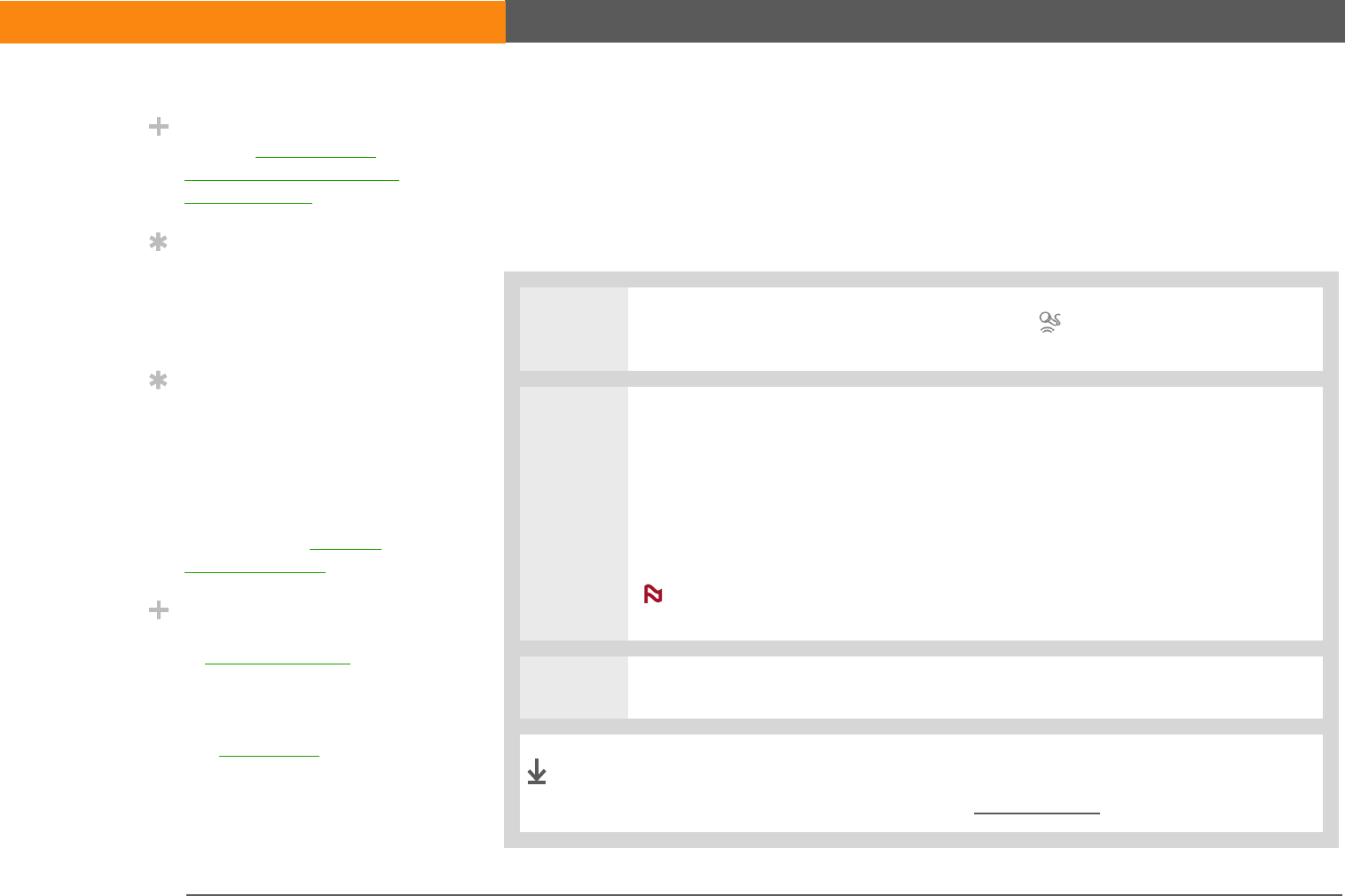
LifeDrive™Device 279
CHAPTER 15 Recording Voice Memos
Creating a voice memo
You can create a quick voice memo using the application button on the side of your device, or you
can use the pause control for a longer memo that you can pause and restart as your ideas flow.
Creating a quick voice memo using the application button
0
1Hold down the Voice Memo application button on the side of your device. A
tone indicates that recording has started.
2Record your voice memo:
a. Face your device and begin speaking. Continue holding the Voice Memo
button while recording.
b. When you have finished recording, release the Voice Memo button. A tone
indicates that recording has stopped and the memo is finished.
Pressing the Voice Memo application button again starts a new
memo.
3Select Done.
That's it. Your device automatically saves the voice memo. Make
sure you have a current backup. Synchronize often.
Did You Know?
You can automatically
store voice memos on an
expansion card.
Tip
For best results, hold
your device within about
one foot of your mouth
while recording.
Tip
To pause your recording,
you must keep the Voice
Memo button held down
and then tap Pause. For
longer recordings where
you want to pause
multiple times, use the
onscreen control
Did You Know?
Voice Memo info is stored
in program memory. This
means that you can view
and listen to memos only
in the application and you
can synchronize the
memos by pressing the
sync button on the USB
cable.
NOTE
Done
SECOND DRAFT palmOne, Inc. Confidential
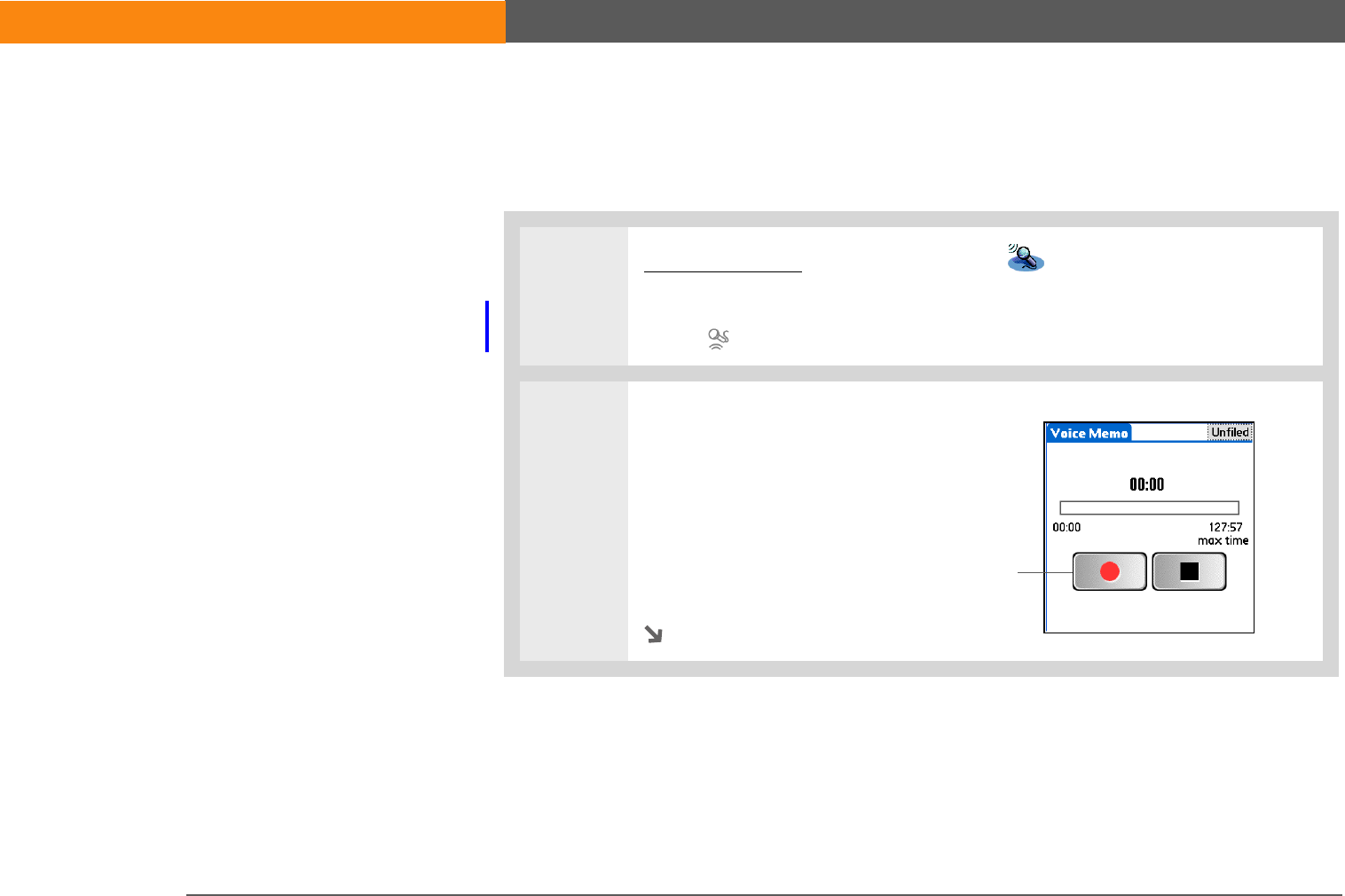
LifeDrive™Device 280
CHAPTER 15 Recording Voice Memos
Creating a longer voice memo using the pause control
Pause and resume recording as many times as you want to make sure you capture all of your
thoughts.
0
1Go to Applications and select Voice Memo .
Alternately, you can press and quickly release the Voice Memo application
button .
2Record your voice memo:
a. Tap New.
b. Tap Record. A tone indicates
that recording has started.
c. Face your device and begin
speaking.
Continued
Record
SECOND DRAFT palmOne, Inc. Confidential
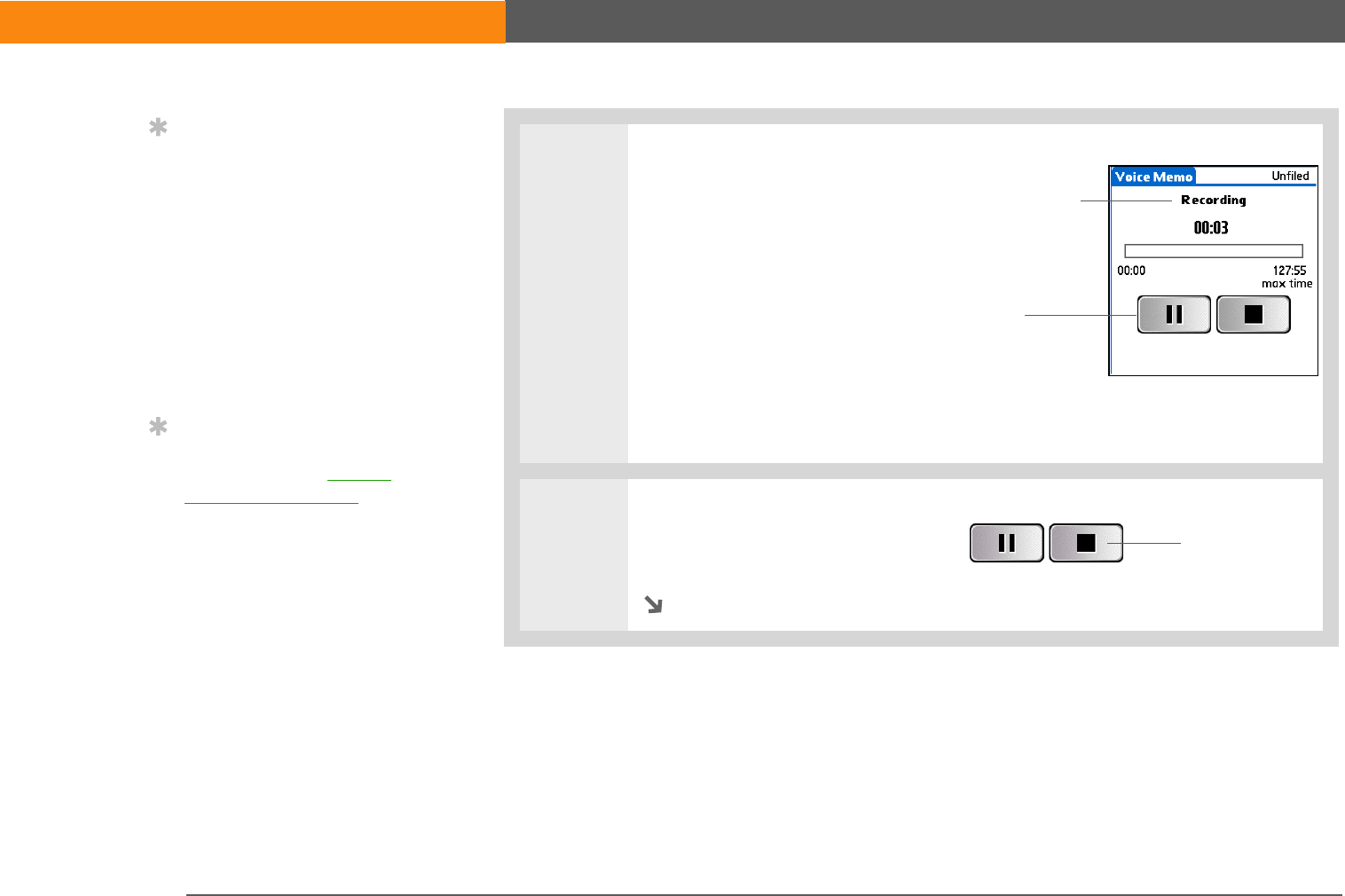
LifeDrive™Device 281
CHAPTER 15 Recording Voice Memos
3Pause and restart recording:
a. Tap Pause to stop recording.
A tone indicates that
recording has paused.
b. Tap Record. A tone indicates
that recording has restarted.
c. Pause and restart recording as
many times as you want. You
can use other applications
while the voice memo is
paused.
4Tap Stop. A tone sounds to
indicate that recording has
stopped.
Continued
Tip
Once you pause your
recording, you can use
other applications and
come back later to
resume recording. To
resume recording, just
tap the Voice Memo icon
or press and release the
Voice Memo application
button, and then tap
Record.
Tip
You can organize your
voice memos by storing
them into categories,
such as personal or
marketing ideas.
Pause
Recording status
Stop
SECOND DRAFT palmOne, Inc. Confidential
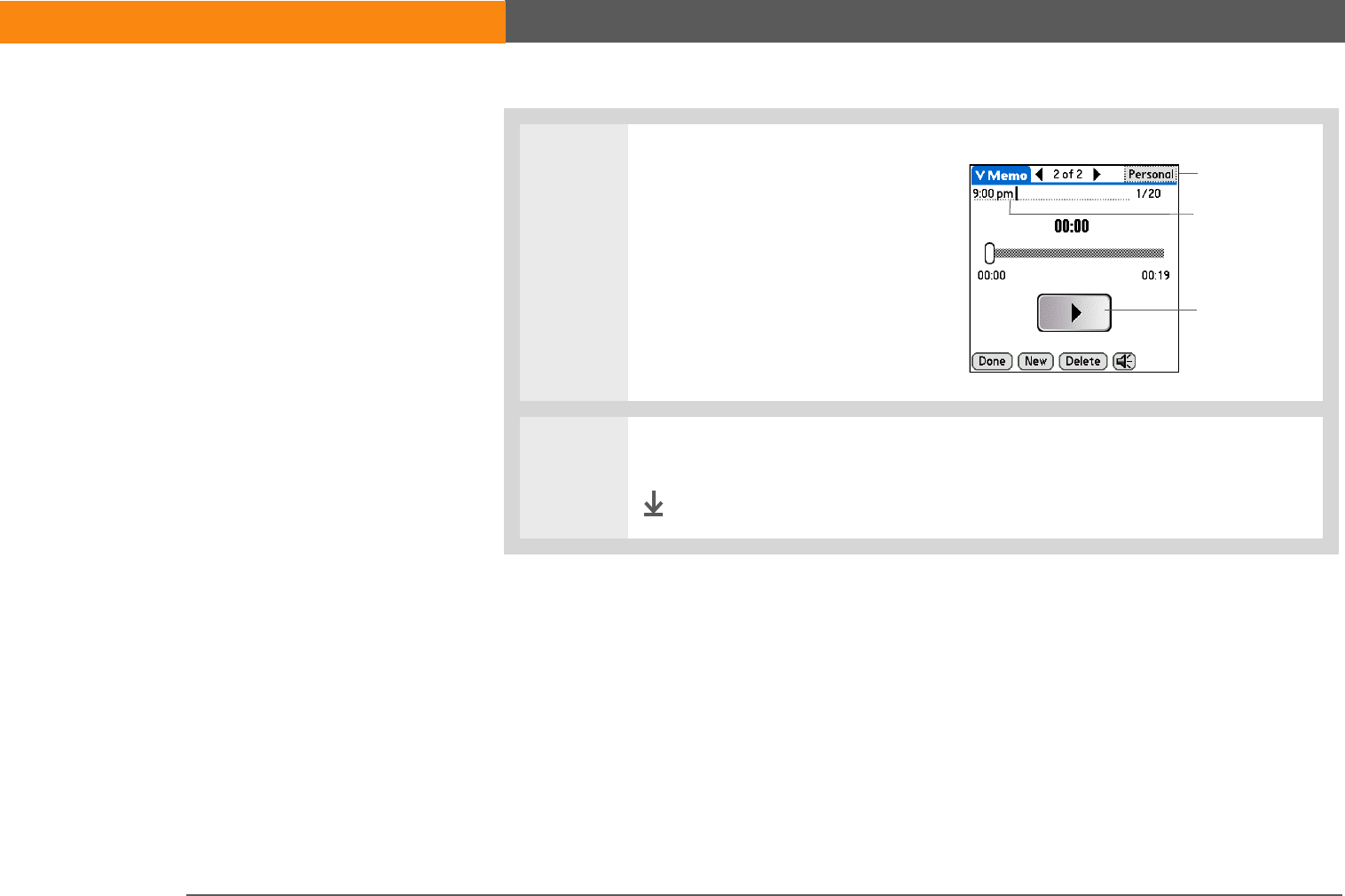
LifeDrive™Device 282
CHAPTER 15 Recording Voice Memos
5[ & ] OPTIONAL Tap on the title
line and enter a title for your
memo. You can choose to leave
the time as part of the title or
remove it. You can also select a
category to store your memo. If
you want to listen to your memo,
tap the Play button.
6Select Done
Done
Tap to select a
category
Tap the title line
and enter a name
Play
SECOND DRAFT palmOne, Inc. Confidential
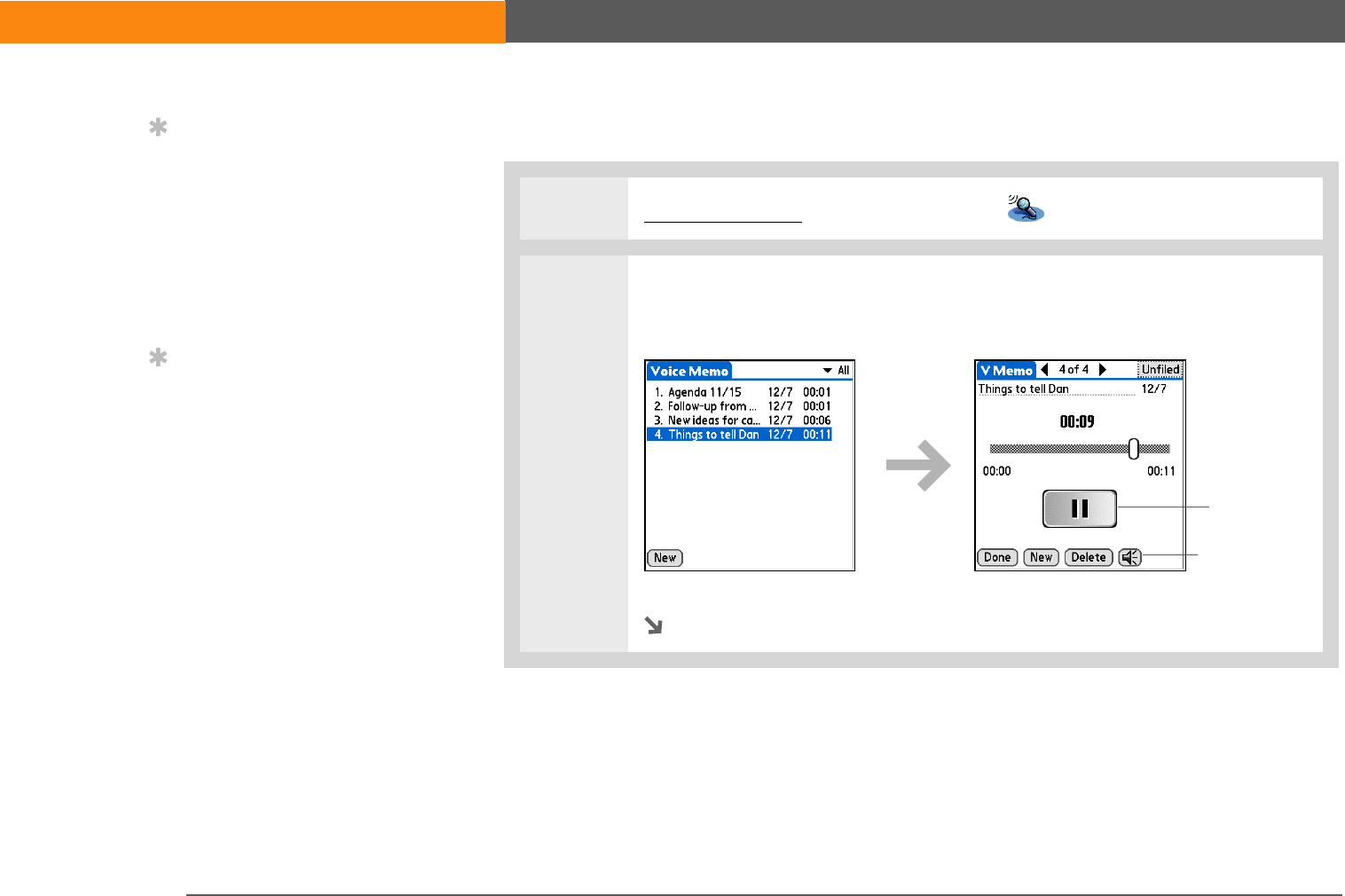
LifeDrive™Device 283
CHAPTER 15 Recording Voice Memos
Listening to a voice memo
0
1Go to Applications and select Voice Memo .
2In the Voice Memo list, select the voice memo title. The voice memo begins to
play after a few seconds.
Continued
Tip
You can sort the Voice
Memo list by date,
alphabetically, by length
of memo, or manually.
Go to the Preferences
menu and tap the Sort by
pick list to select a sorting
scheme.
Tip
Press Right or Left on the
navigator to listen to the
next or previous voice
memo.
Speaker
icon
Pause
SECOND DRAFT palmOne, Inc. Confidential
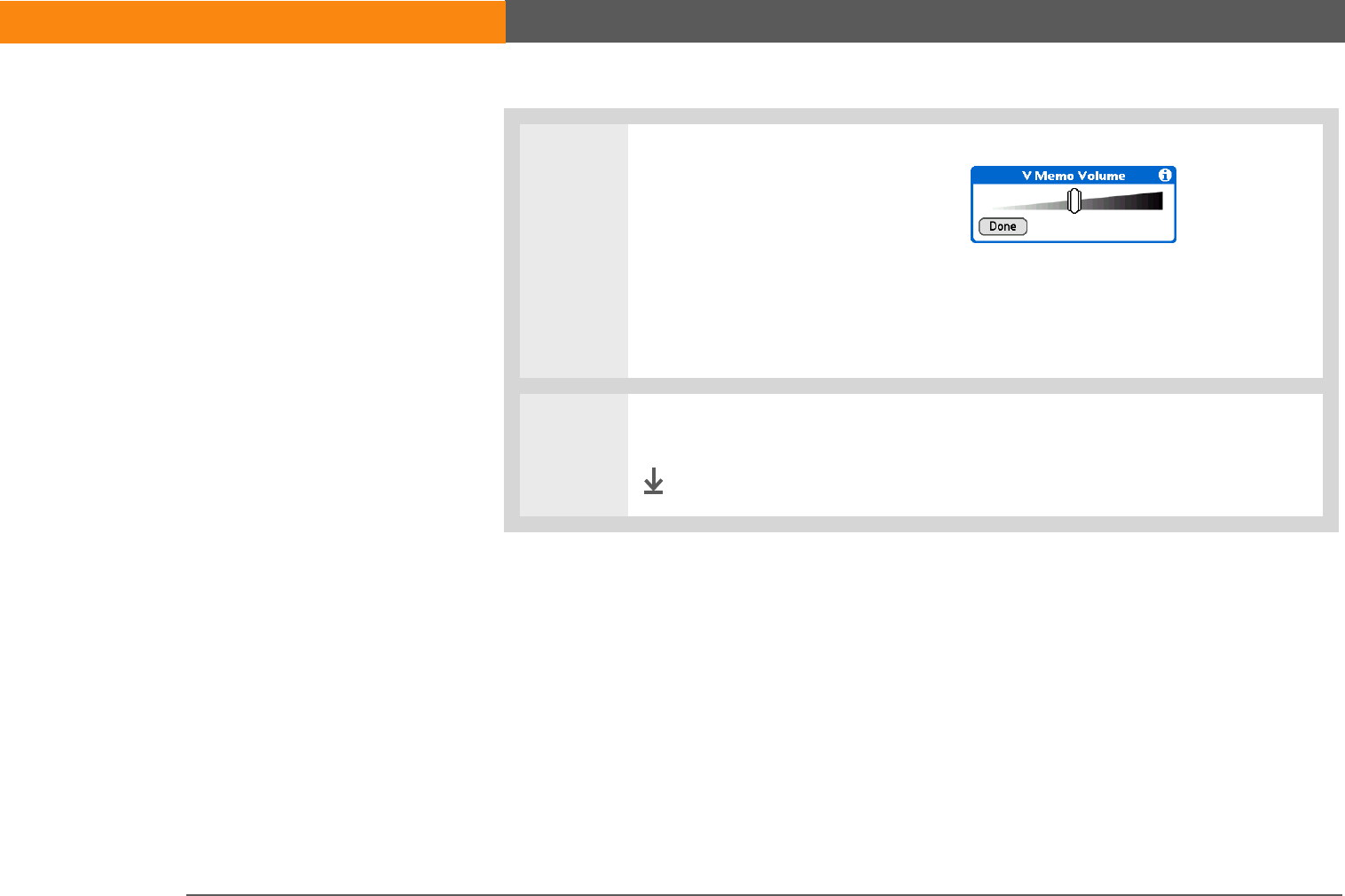
LifeDrive™Device 284
CHAPTER 15 Recording Voice Memos
3[ & ] OPTIONAL Set the volume
level:
a. Select the Speaker icon.
b. Press Up or Down on the
navigator to adjust the
volume.
c. Press Done.
4Select Done.
Done
SECOND DRAFT palmOne, Inc. Confidential
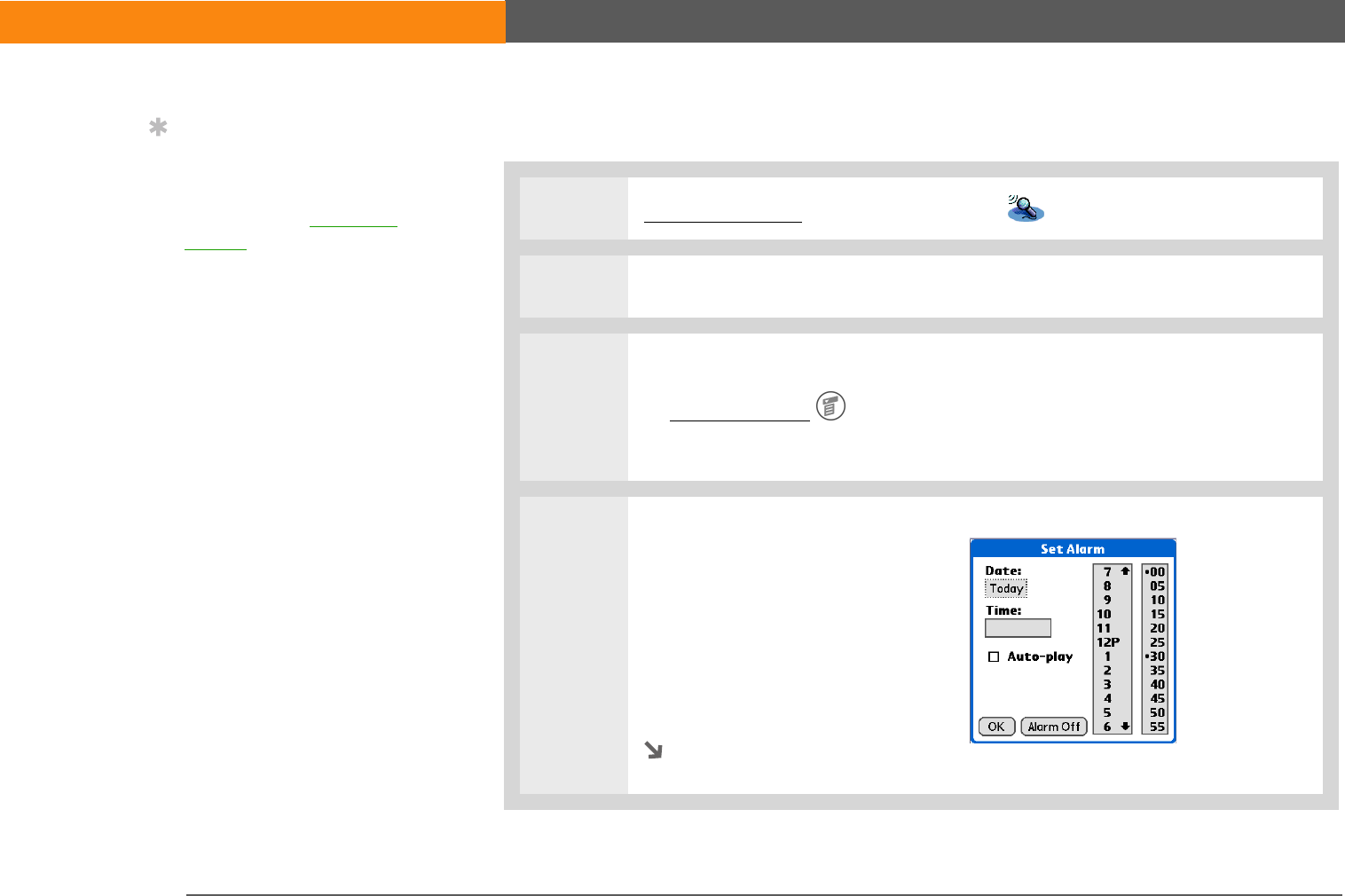
LifeDrive™Device 285
CHAPTER 15 Recording Voice Memos
Setting an alarm for a voice memo
0
1Go to Applications and select Voice Memo .
2Select the voice memo to which you want to assign an alarm.
3Open the Alarm dialog box:
a. Open the menus .
b. Select Options, and then select Alarm.
4Set the alarm:
a. Tap the Date box and select
the year, month, and date you
want the alarm to sound.
b. Tap the Time box and select
the hour and minute you want
the alarm to sound.
Continued
Tip
You can use a concerto or
a bird chirp or to a
number of other sounds
for your alarm. Open the
menus, select Options,
and then select
Preferences. Tap the
Alarm pick list to select a
sound.
SECOND DRAFT palmOne, Inc. Confidential
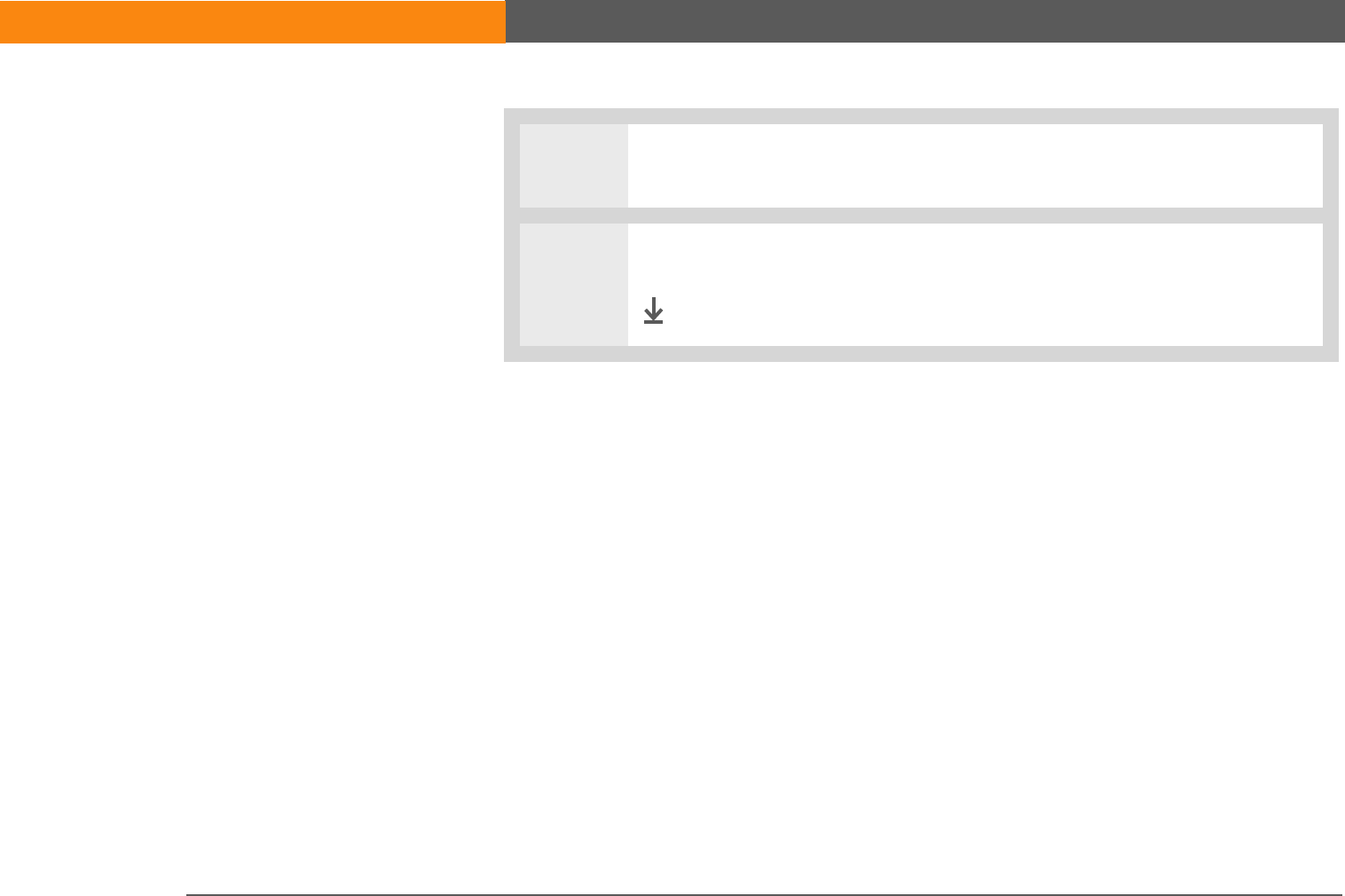
LifeDrive™Device 286
CHAPTER 15 Recording Voice Memos
5[ & ] OPTIONAL Select the Auto-play check box to automatically play the voice
memo when the alarm goes off.
6Select OK.
Done
SECOND DRAFT palmOne, Inc. Confidential
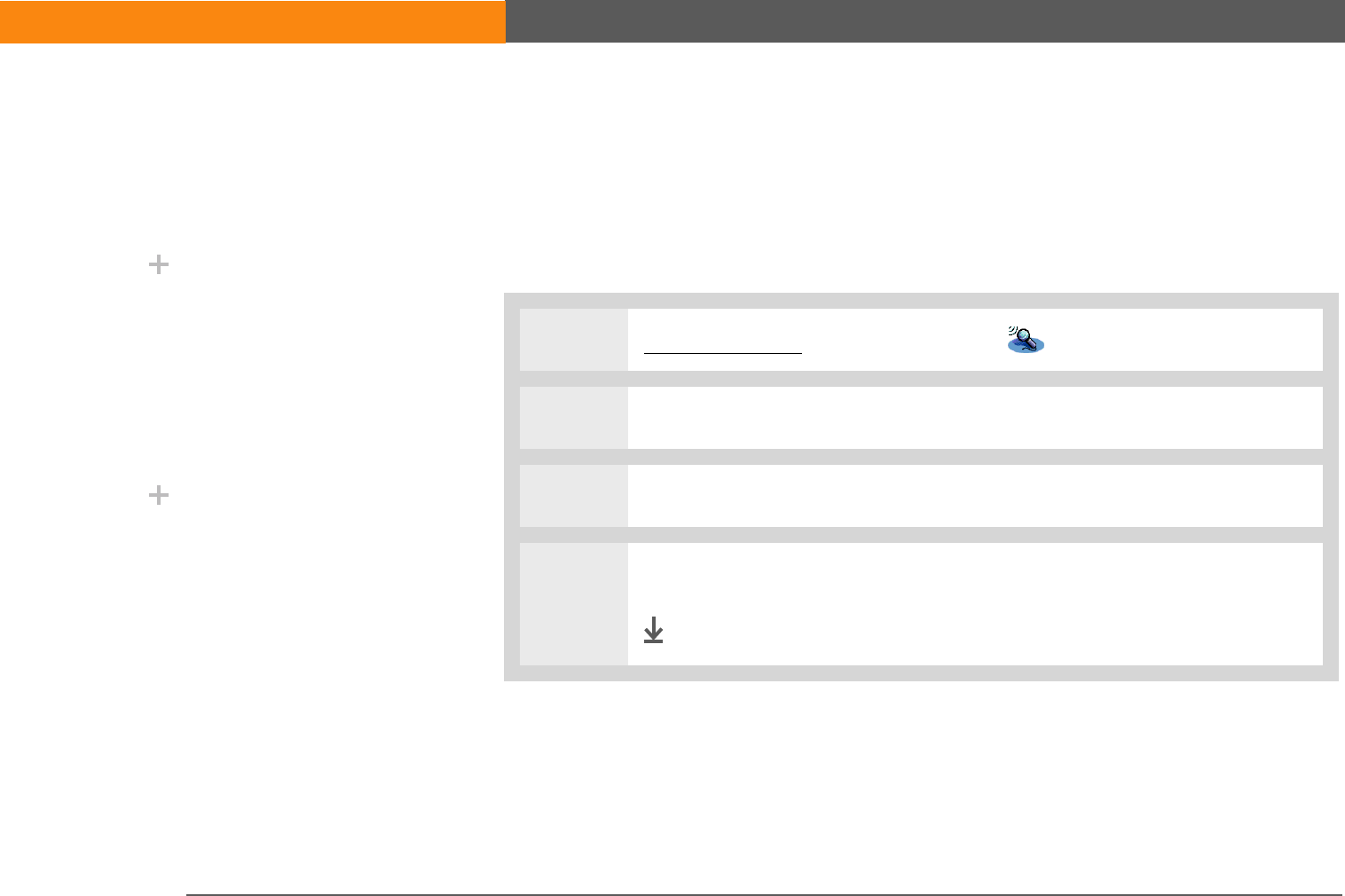
LifeDrive™Device 287
CHAPTER 15 Recording Voice Memos
Saving a voice memo to an expansion card
You can create voice memos for others by storing your voice memos on an expansion card. Voice
Memo enables you to store specific voice memos on an expansion card, or to configure your
device to always store voice memos on an expansion card when one is present.
Saving a specific memo to an expansion card
0
1Go to Applications and select Voice Memo .
2Open a voice memo.
3Tap the category pick list in the upper-right corner and select Card.
4Select Done.
Done
Before You Begin
[!]
You must have an
expansion card inserted
in your device’s
expansion card slot.
Did You Know?
When you store voice
memos on an expansion
card, they do not appear
in the Voice Memo
portion of Palm®Desktop
software after a HotSync®
operation and are not
backed up.
Did You Know?
You cannot mark voice
memos private or attach
alarms to voice memos
that are stored on an
expansion card.
SECOND DRAFT palmOne, Inc. Confidential
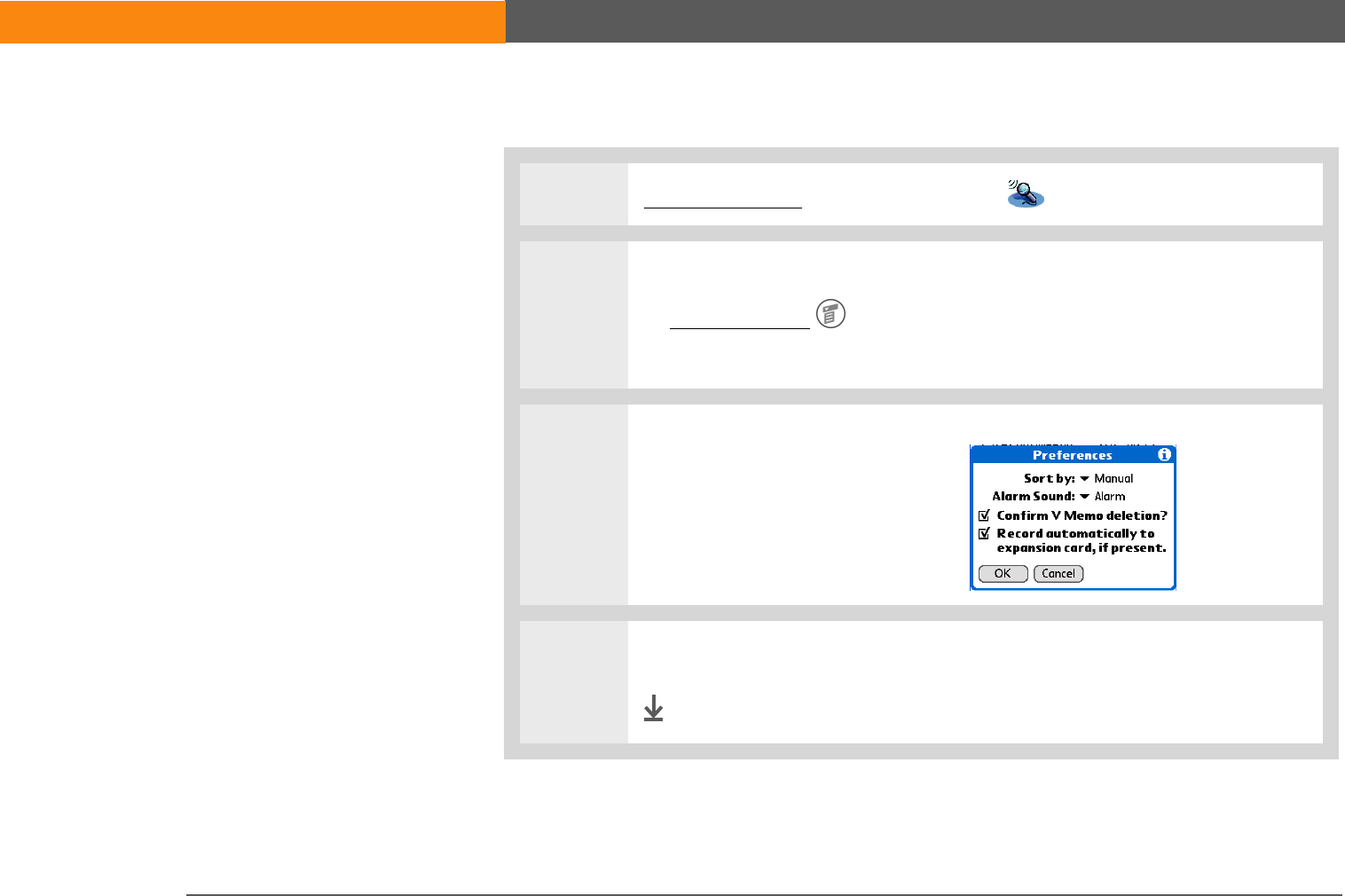
LifeDrive™Device 288
CHAPTER 15 Recording Voice Memos
Automatically storing all voice memos on an expansion card
0
1Go to Applications and select Voice Memo .
2Open the Alarm dialog box:
a. Open the menus .
b. Select Options, and then select Preferences.
3Select the check box Record
automatically to expansion card,
if present.
4Tap OK .
Done
SECOND DRAFT palmOne, Inc. Confidential

LifeDrive™Device 289
CHAPTER 15 Recording Voice Memos
Related topics
Click a link below to learn about these related topics:
Moving
Around
• Opening applications
• Using menus
Categories Organizing voice memos by arranging them into categories and sorting them
Privacy Keeping voice memos private by turning on security options
Sharing • Exchanging voice memos with other palmOne™ device users by beaming
them
• Sending voice memos to other palmOne Bluetooth® devices by using
Bluetooth technology on your device
E-mail Sending voice memos as attachments to e-mail messages
Common
Questions
Answers to frequently asked questions about Voice Memo
My Handheld
Make your device uniquely
yours. For great tips,
software, accessories, and
more, visit
www.palmOne.com/
mylifedrive.
Support
If you’re having problems
with Voice Memo or with
anything else on your device,
go to www.palmOne.com/
support.
SECOND DRAFT palmOne, Inc. Confidential
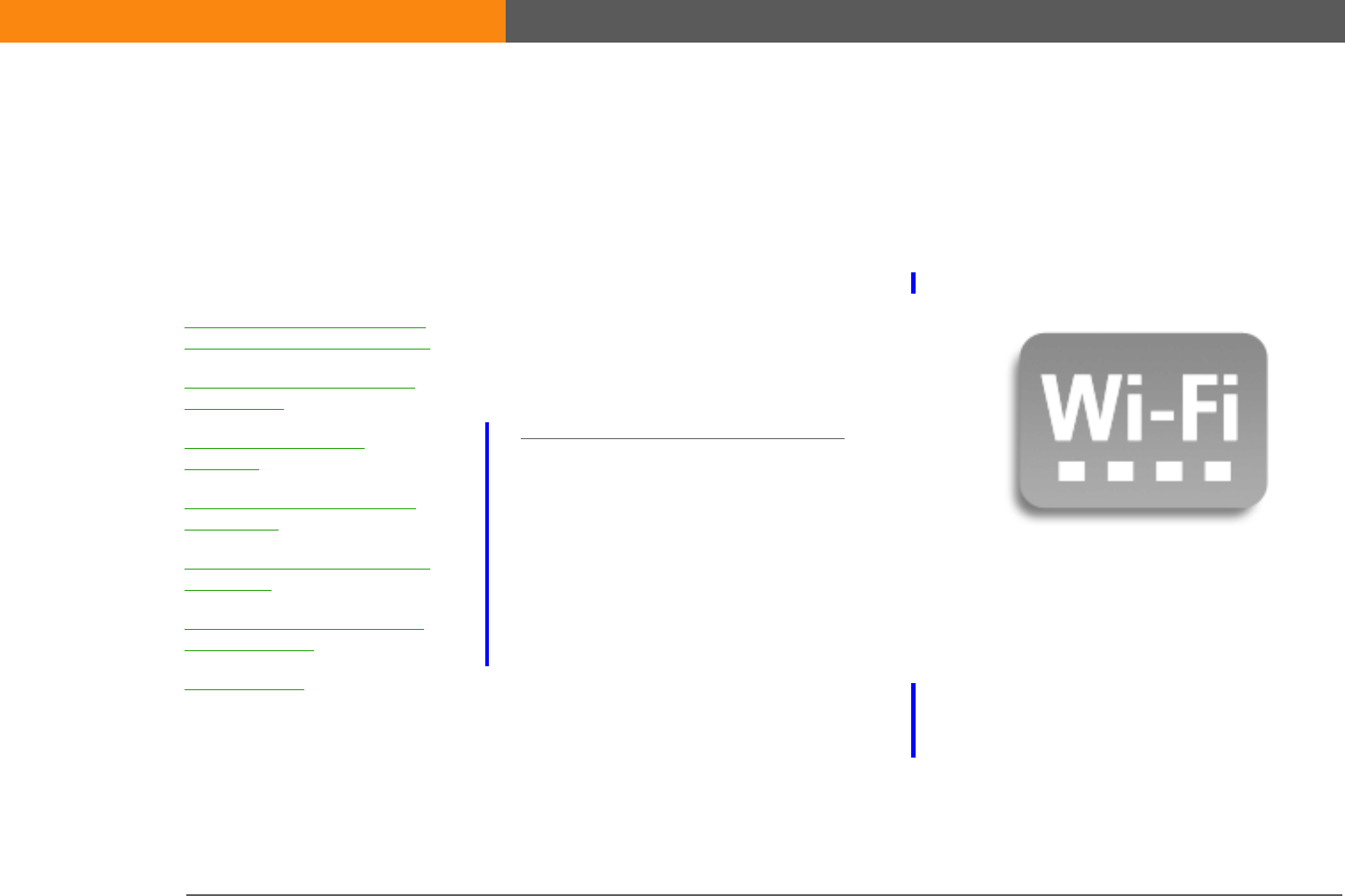
LifeDrive™Device 290
CHAPTER 16
Making Wi-Fi Wireless Connections
Staying connected means you have
the latest wireless technology at your
fingertips at all times. Now your device
can actually connect you to the
wireless world using either Wi-Fi® or
Bluetooth® wireless technology.
During the day, you need Wi-Fi to
access your corporate network. During
the evening, connect to the Wi-Fi
wireless network at your home or the
local coffee shop to access your
personal email or browse the Internet.
Benefits
• Connect to your corporate network
wirelessly
• Stay up-to-date by connecting
wirelessly anywhere
• Transfer documents wirelessly
I
n t
hi
s c
h
apter
What can I do with the built-
in Wi-Fi wireless technology?
What types of connections
can I make?
Wi-Fi signal strength
indicator
Setting up a Wi-Fi network
connection
Accessing email and the web
with Wi-Fi
Setting up a Wi-Fi device-to-
device network
Related topics
SECOND DRAFT palmOne, Inc. Confidential

LifeDrive™Device 291
CHAPTER 16 Making Wi-Fi Wireless Connections
What can I do with the built-in Wi-Fi wireless
technology?
Access your corporate network. Whether you are attending a meeting or roaming the hallway,
you can stay connected to the information you need.
Send email messages. Whether you send email messages once a week or constantly throughout
the day, wireless connectivity means that you can share information.
Access the web. Connect to the Internet for news and information in a café or in a meeting.
Reduce cable clutter by synchronizing wirelessly. Imagine your desk and workstation without
cable clutter. Wireless technology on your device replaces many of the connecting cables with a
wireless connection for tasks such as synchronizing.
Connect to other devices to share files wirelessly. Transfer a document wirelessly from your
desktop computer to your handheld for review when you are away from your desk.
What types of connections can I make?
With built-in Wi-Fi wireless technology, you can make connections at the following times:
• When you are in range of Wi-Fi access points for public networks, such as wireless cafés and city
networks. You can use the networks to browse the Internet or to send and receive email. Some
public networks require a subscription fee. Check with the public network provider for details.
• When you are in range of WI-Fi access points for private networks in a corporation or home. If
these networks are secure, you must have the necessary keys to access the network. Once you
are on the network, you can browse the Internet, send and receive email, or even access network
devices such as your computer.
• When you in range of other Wi-Fi devices, such as printers or projectors. Create a device-to-
device network between your handheld and the other device. Also, check the user guide for the
other Wi-Fi device to enable device-to-device networking.
»
Key Term
Wi-Fi Wireless
technology that enables
networks with access
points to allow devices
such as handhelds,
printers, and computers
to connect wirelessly to
the Internet and
corporate networks.
Did You Know?
If you are out of range of
a Wi-Fi access point, you
can remain connected
using Bluetooth wireless
technology.
SECOND DRAFT palmOne, Inc. Confidential
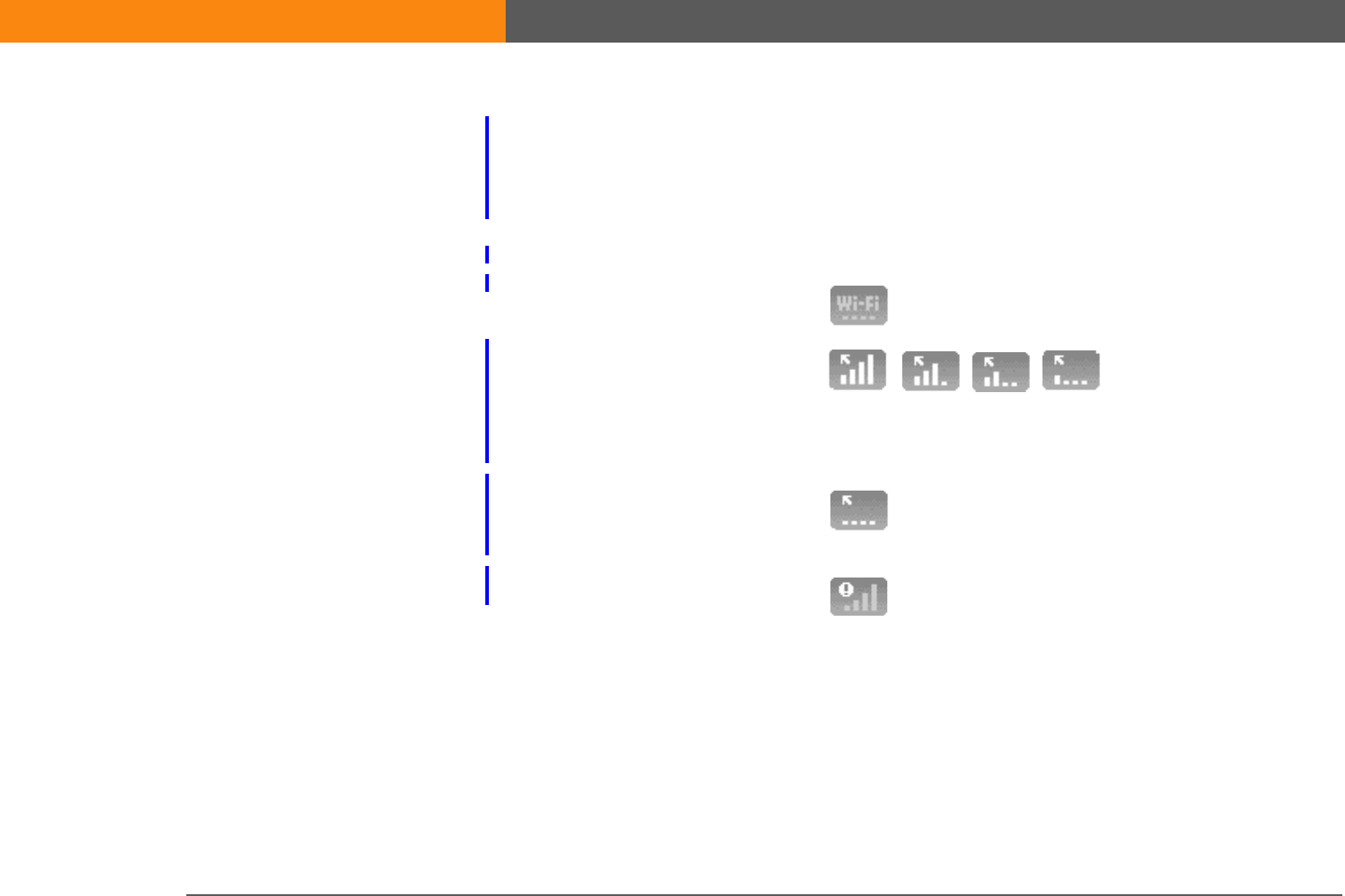
LifeDrive™Device 292
CHAPTER 16 Making Wi-Fi Wireless Connections
Wi-Fi signal strength indicator
You can easily check Wi-Fi status and signal strength any time by viewing the Wi-Fi icon on the
status bar. You can tap the Wi-Fi icon and open the Preferences screen to also view status, signal
strength, and other Wi-Fi information.
Status ...Icons
Wi-Fi off
Wi-Fi on
Connected to a network
Signal strength:
Full strength decreasing to
minimum signal
Wi-Fi on
Connected to a network
No signal
Wi-Fi on
Not connected to a network
SECOND DRAFT palmOne, Inc. Confidential
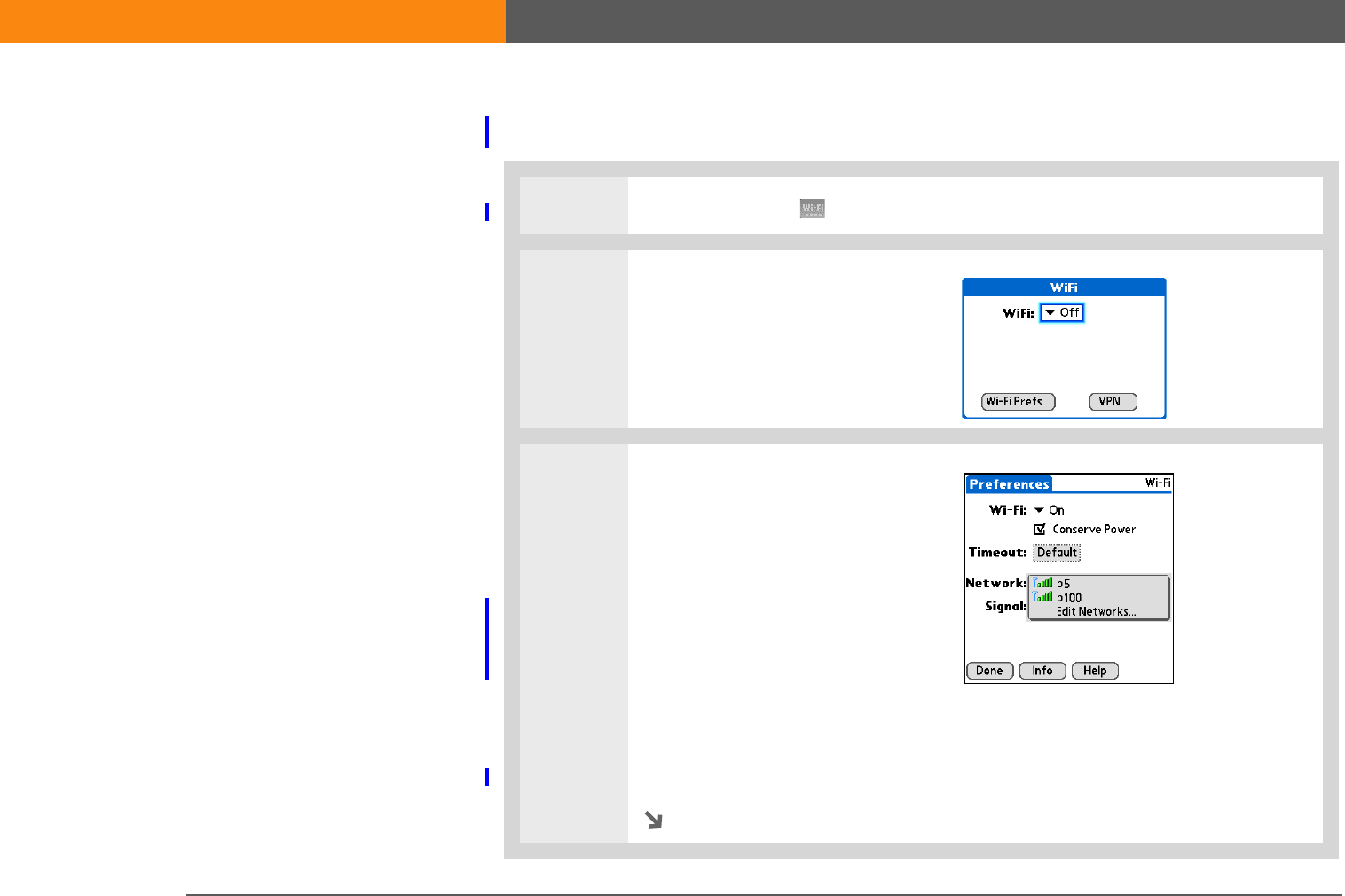
LifeDrive™Device 293
CHAPTER 16 Making Wi-Fi Wireless Connections
Setting up a Wi-Fi network connection
0O
1Tap Wi-Fi controls on the status bar.
2Select On from the Wi-Fi pick list
and then select Wi-Fi Prefs.
3Select the Network pick list, and
then do one of the following:
• If the network is listed and
does not require an encryption
key, select the network. Wait
for the connection to finish,
and then select Done. You are
now connected and this
procedure is done.
• If the network is not listed or if
the network requires an
encryption key, select Edit
Networks and go to step 4.
Continued
Before You Begin
[!]
Contact the network
administrator to get the
name of the network, also
known as an SSID, and
the security information,
such as WEP or WPA-PSK
keys.
»
Key Term
Encryption key
A series of letters and
numbers that enables
data to be encrypted and
then decrypted so it can
be safely shared within a
network. Your handheld
supports two encryption
systems: WEP and
WPA-PSK.
SECOND DRAFT palmOne, Inc. Confidential
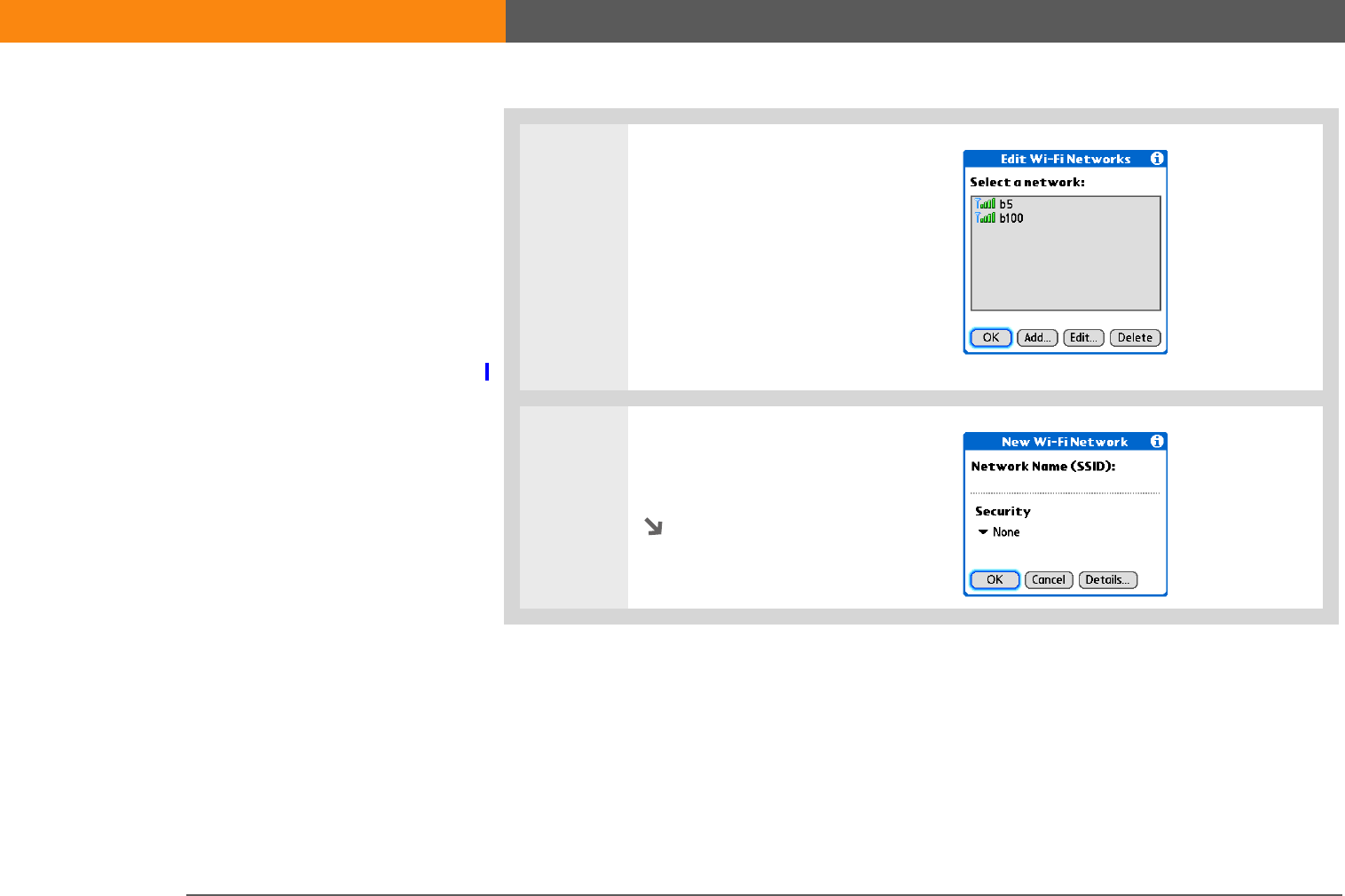
LifeDrive™Device 294
CHAPTER 16 Making Wi-Fi Wireless Connections
4Add or edit a network:
• If the network appears on the
list, select the network and
then select Edit to add
encryption key information.
• If the network does not appear
on the list, select Add. The
network may be hidden for
security purposes.
5Add the network name or SSID if
it does not appear. An SSID is
required for hidden networks.
Continued
SECOND DRAFT palmOne, Inc. Confidential
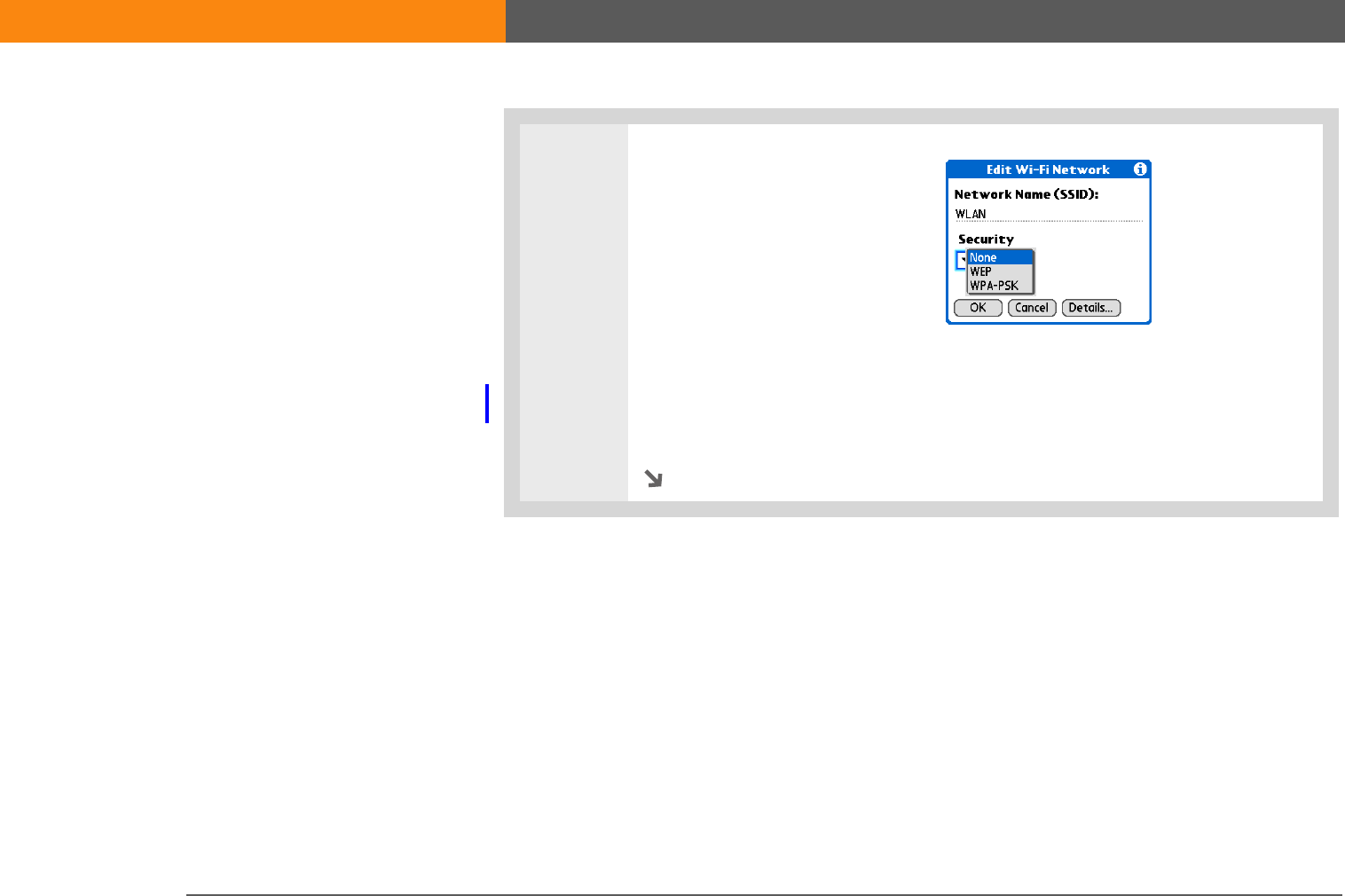
LifeDrive™Device 295
CHAPTER 16 Making Wi-Fi Wireless Connections
6Select a security option:
• If your network does not
require any encryption
settings, select None and go to
step 9.
• If your network requires WEP
encryption, select WEP and go
to step 7.
• If your network requires
WPA-PSK encryption, select
WPA-PSK and go to step 8.
Continued
SECOND DRAFT palmOne, Inc. Confidential
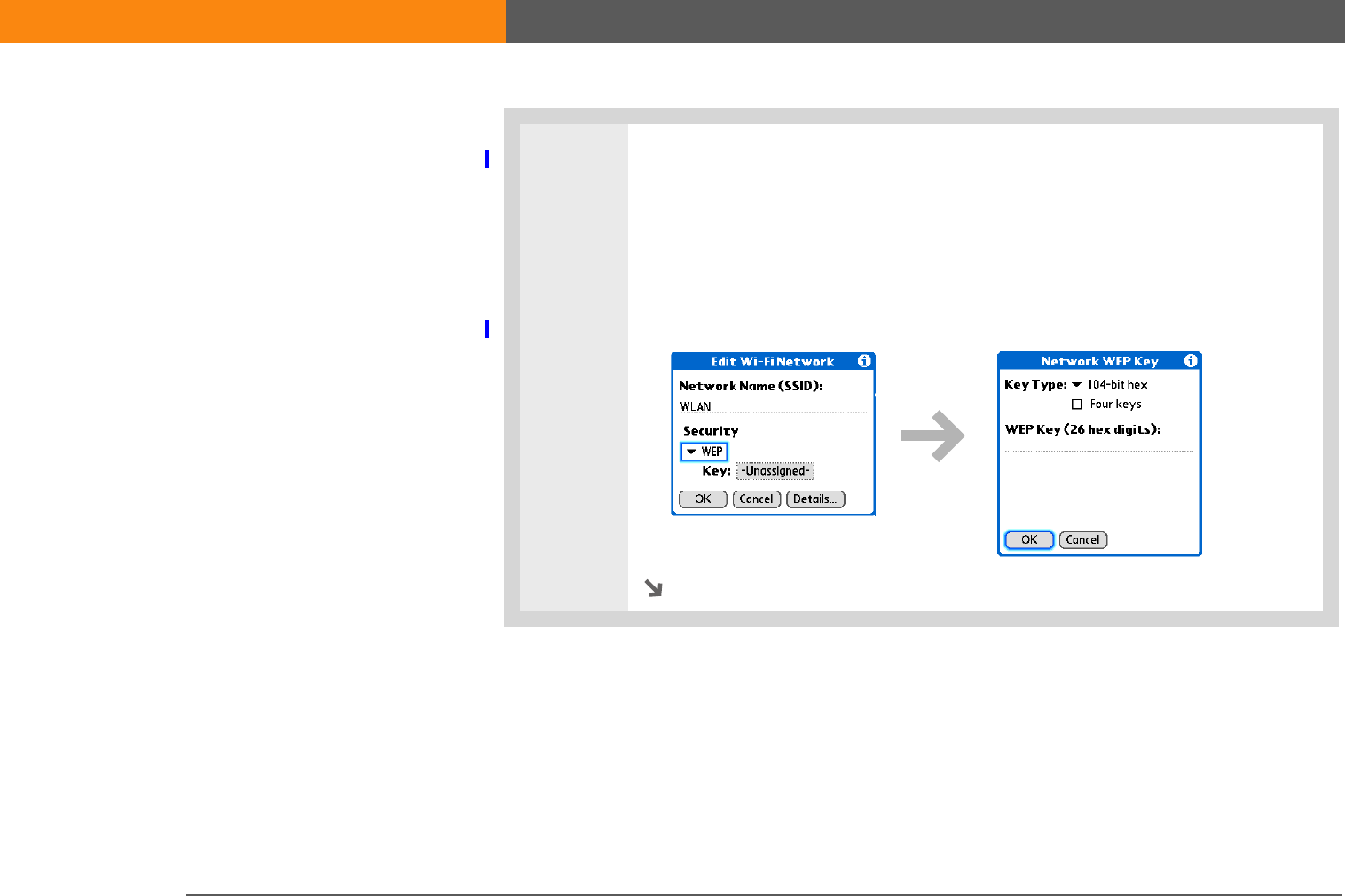
LifeDrive™Device 296
CHAPTER 16 Making Wi-Fi Wireless Connections
7If you selected WEP in step 6:
a. Tap the WEP Key box.
b. Enter the WEP encryption information.
c. Select OK.
d. Go to step 9.
Continued
SECOND DRAFT palmOne, Inc. Confidential
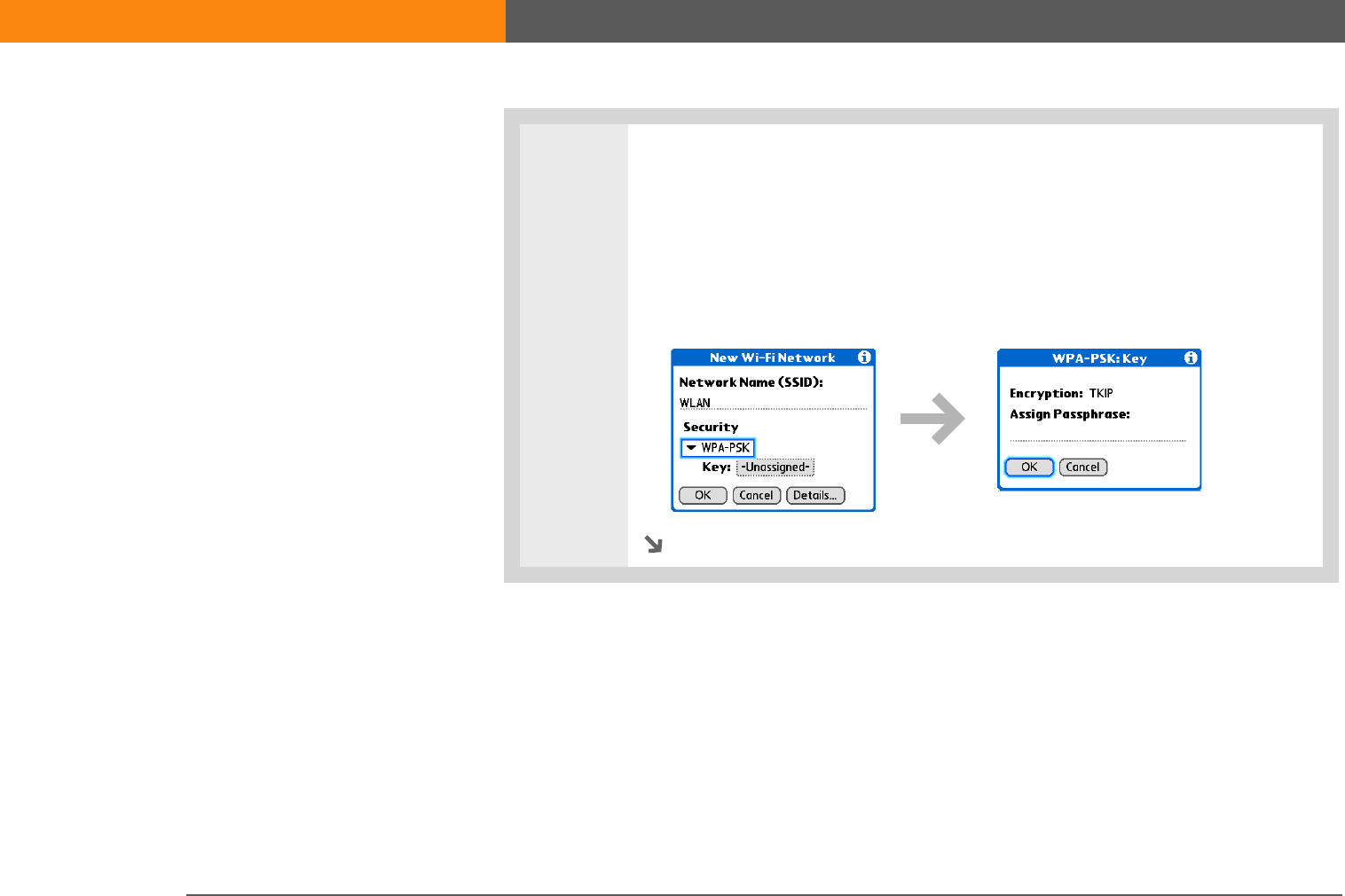
LifeDrive™Device 297
CHAPTER 16 Making Wi-Fi Wireless Connections
8If you selected WPA-PSK in step 6:
a. Check the WPA-PSK box.
b. Tap the Key box.
c. Assign a passphrase.
d. Select OK.
Continued
SECOND DRAFT palmOne, Inc. Confidential
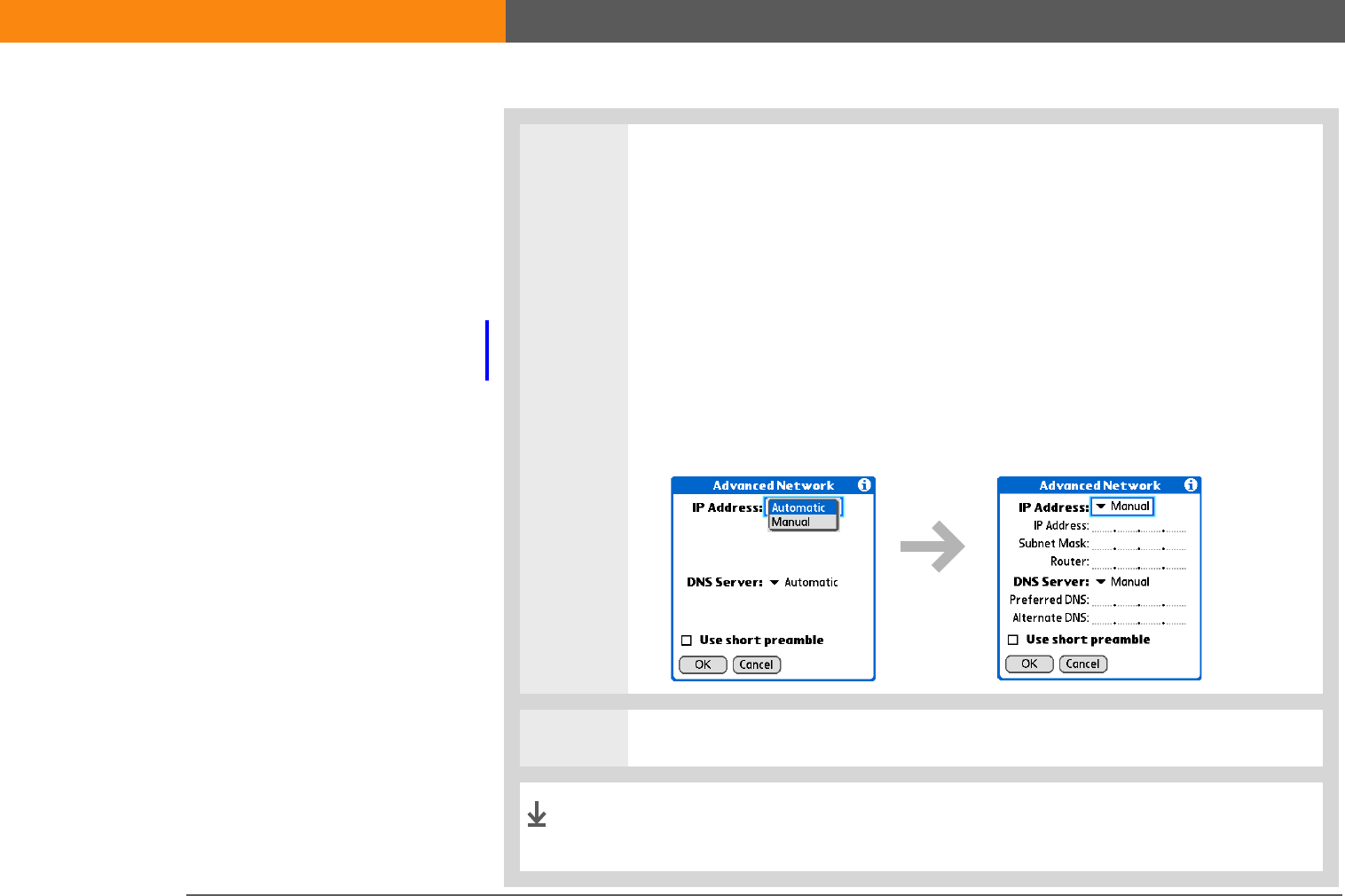
LifeDrive™Device 298
CHAPTER 16 Making Wi-Fi Wireless Connections
9[ & ] OPTIONAL Manually set your IP or DNS addresses:
a. Tap Details.
b. Select Access Point (infrastructure) from the Connect to pick list.
c. Select Advanced.
d. Select Manual from the IP Address or DNS Server pick list.
e. Enter the IP address or DNS server information.
f. If you want to use a preamble, check the Use short preamble box.
g. Select OK.
10 Select OK and then select Done.
You can now connect to the network any time you are within
range of the access point.
Done
SECOND DRAFT palmOne, Inc. Confidential
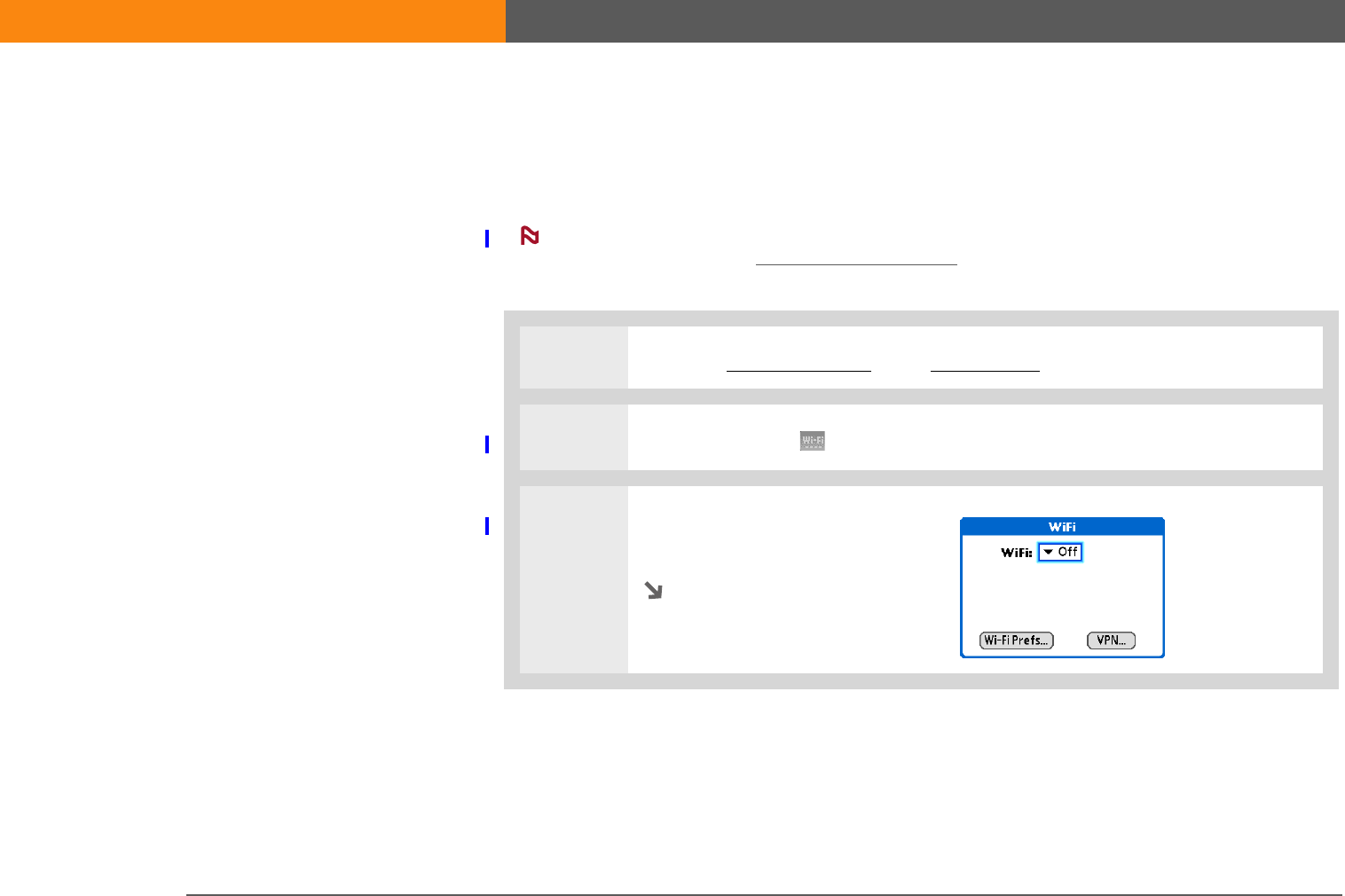
LifeDrive™Device 299
CHAPTER 16 Making Wi-Fi Wireless Connections
Accessing email and the web with Wi-Fi
After you set up a connection with a Wi-Fi network, you can send and receive email or browse the
web wirelessly using this connection.
Wi-Fi functionality must be turned on before you can use it to make wireless
connections. You must also set up an email account on your device before you can send or
receive email messages.
0
1Open the email application or the web browser.
2Tap Wi-Fi controls on the status bar.
3Select On from the Wi-Fi pick list,
and then select Wi-Fi Prefs.
Continued
NOTE
SECOND DRAFT palmOne, Inc. Confidential
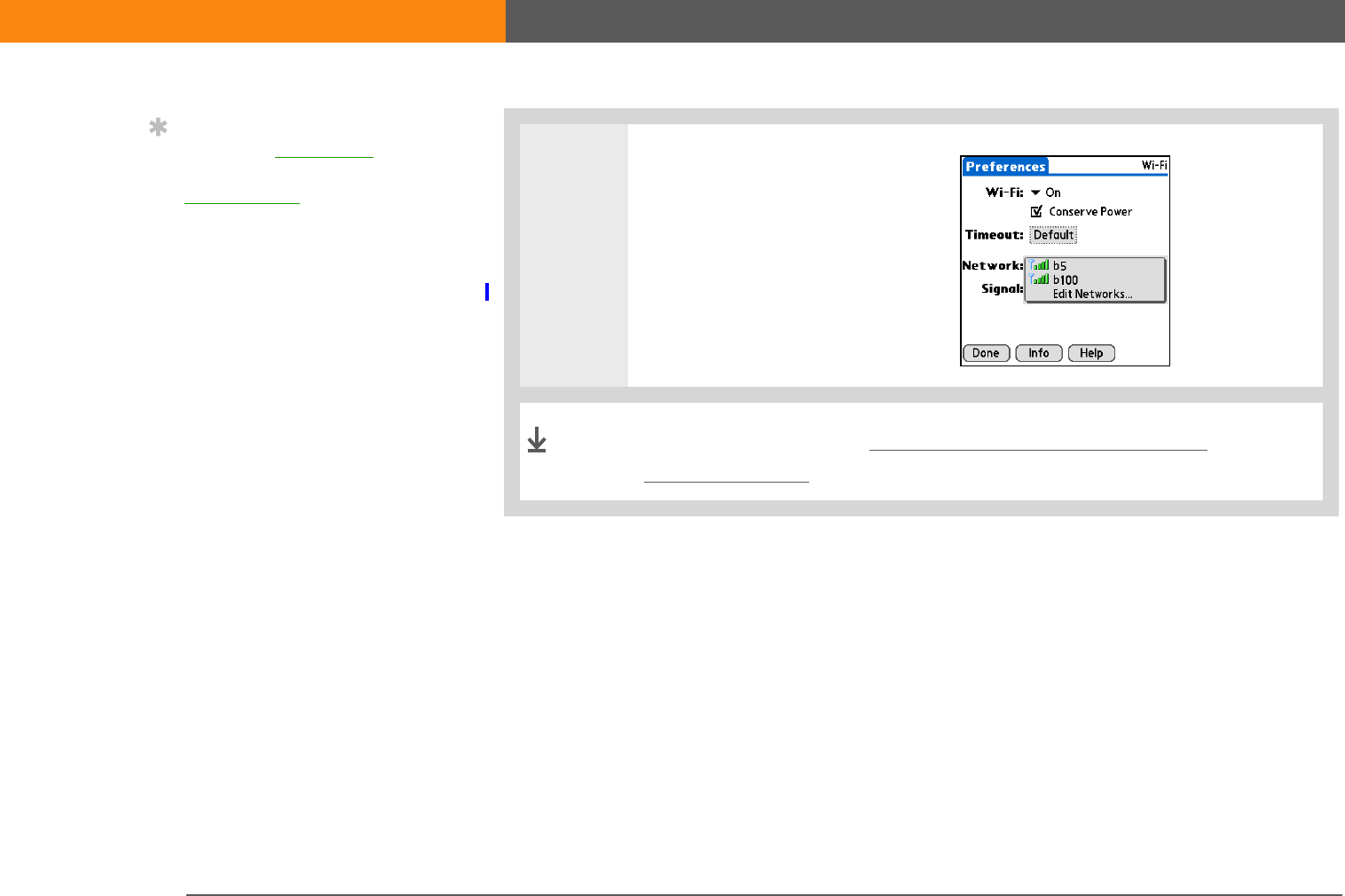
LifeDrive™Device 300
CHAPTER 16 Making Wi-Fi Wireless Connections
4Connect to the Wi-Fi network:
a. Select a Network from the
Network pick list.
b. Wait for the connection to
finish, and then select Done.
You are now ready to send and receive email messages or to
browse the web.
Tip
When you enter a URL in
the web browser or select
Get and Send in the
VersaMail® application,
a connection is
automatically initiated
with the last used service.
Done
SECOND DRAFT palmOne, Inc. Confidential
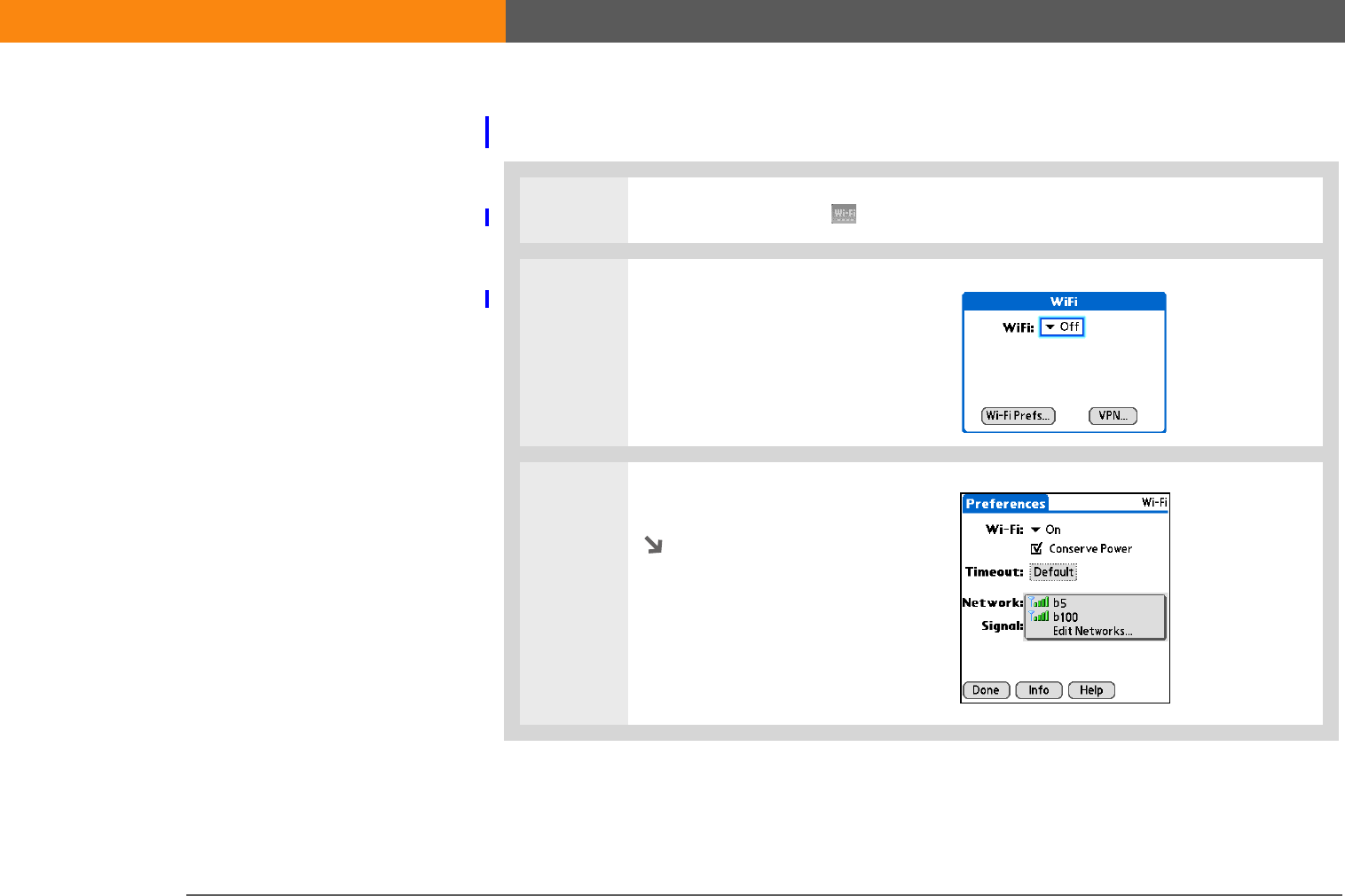
LifeDrive™Device 301
CHAPTER 16 Making Wi-Fi Wireless Connections
Setting up a Wi-Fi device-to-device network
0O
1Tap the Wi-Fi controls on the status bar.
2Select On from the Wi-Fi pick list,
and then select Wi-Fi Prefs.
3Select Edit Networks.
Continued
Before You Begin
[!]
You need to know the
following information:
• Name of the network,
also known as an SSID
• Security information,
such as WEP or WPA-PSK
keys
• Channel number
You may also need to
know the IP address and
DNS server information.
»
Key Term
Encryption key
A series of letters and
numbers that enables
data to be encrypted and
then decrypted so it can
be safely shared within a
network. Your handheld
supports two encryption
systems: WEP and
WPA-PSK.
SECOND DRAFT palmOne, Inc. Confidential
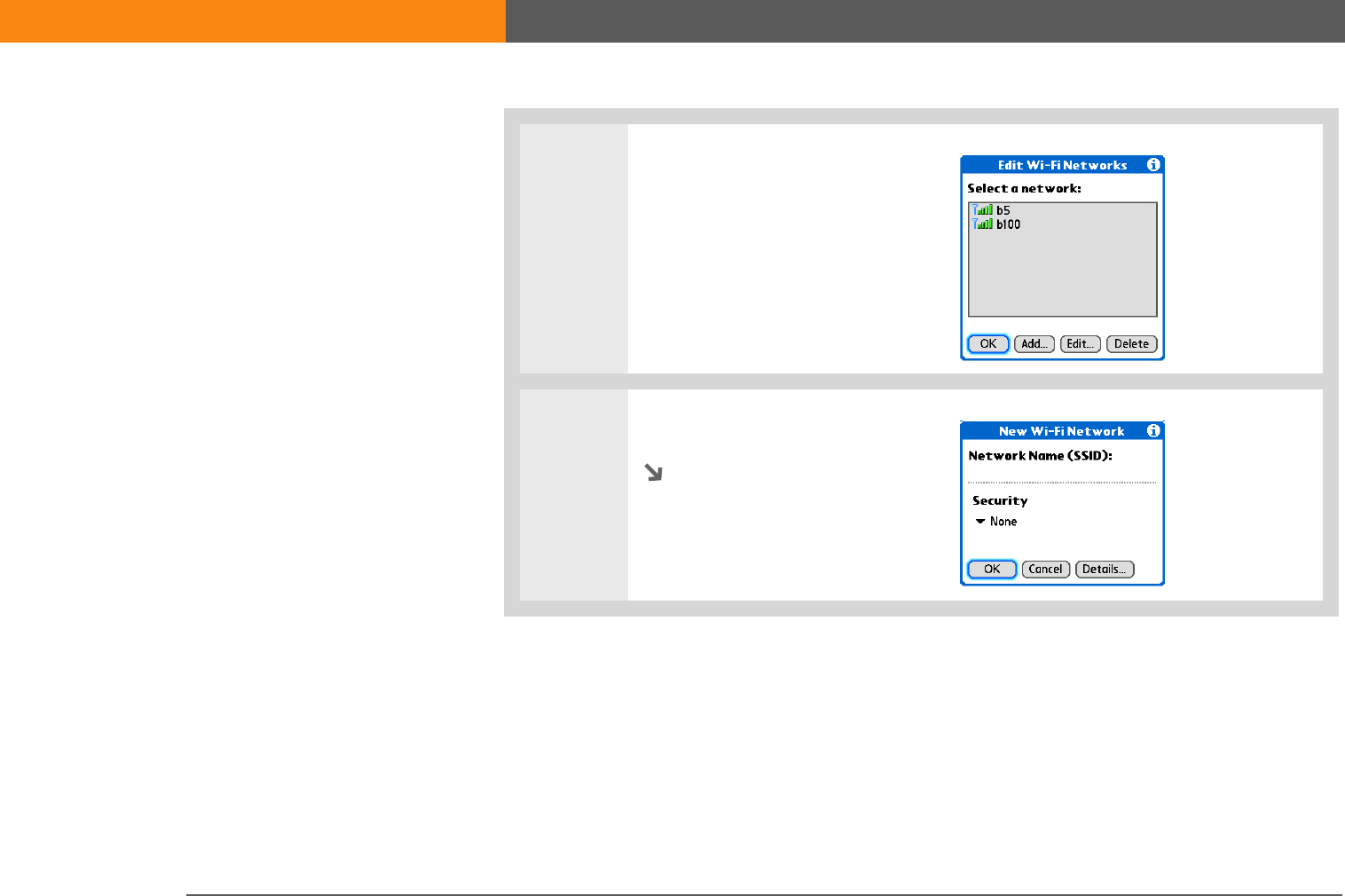
LifeDrive™Device 302
CHAPTER 16 Making Wi-Fi Wireless Connections
4Select Add.
5Add the network name or SSID.
Continued
SECOND DRAFT palmOne, Inc. Confidential
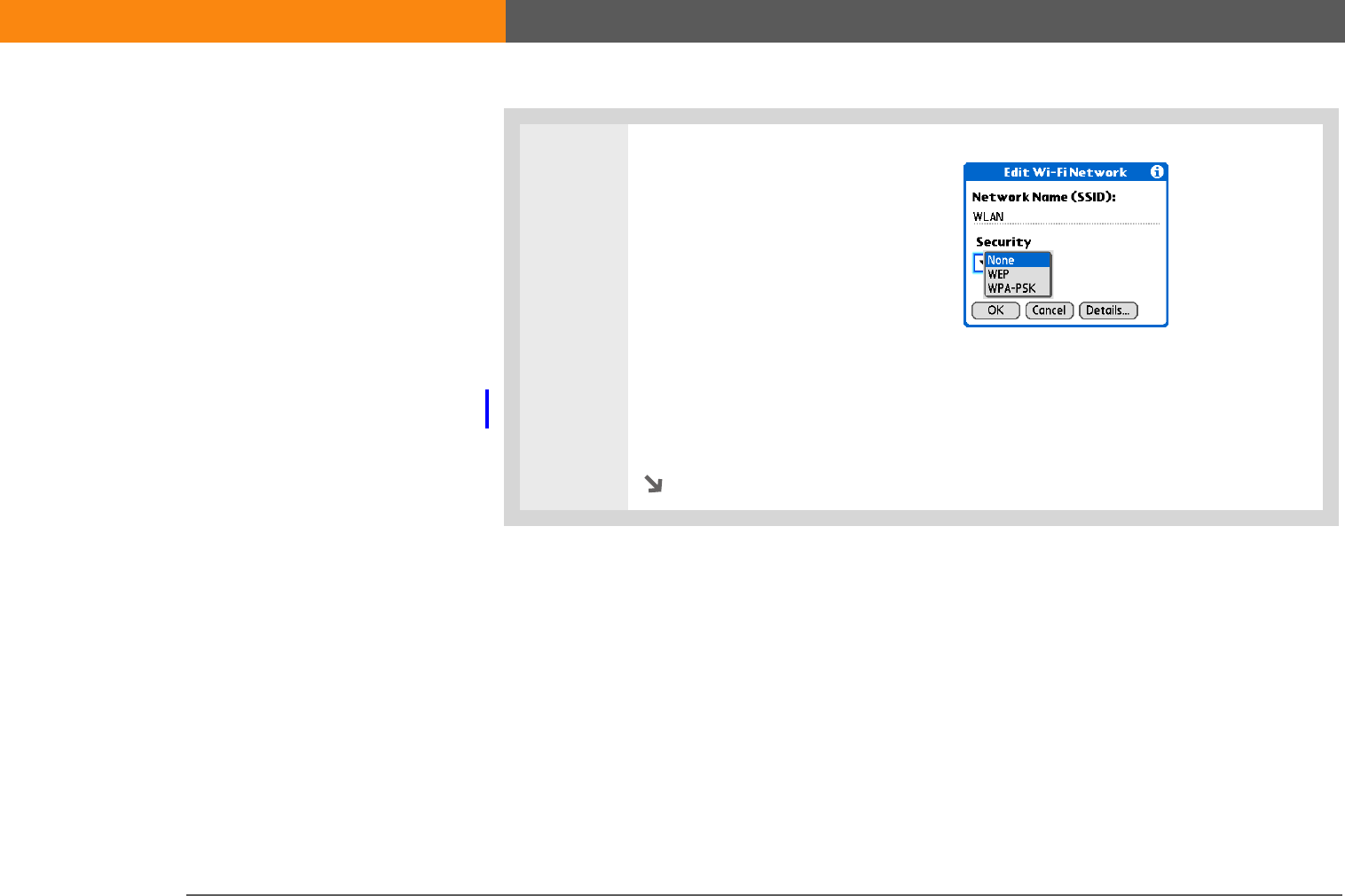
LifeDrive™Device 303
CHAPTER 16 Making Wi-Fi Wireless Connections
6Select a security option:
• If your network does not
require any encryption
settings, select None and go to
step 9.
• If your network requires WEP
encryption, select WEP and go
to step 7.
• If your network requires
WPA-PSK encryption, select
WPA-PSK and go to step 8.
Continued
SECOND DRAFT palmOne, Inc. Confidential
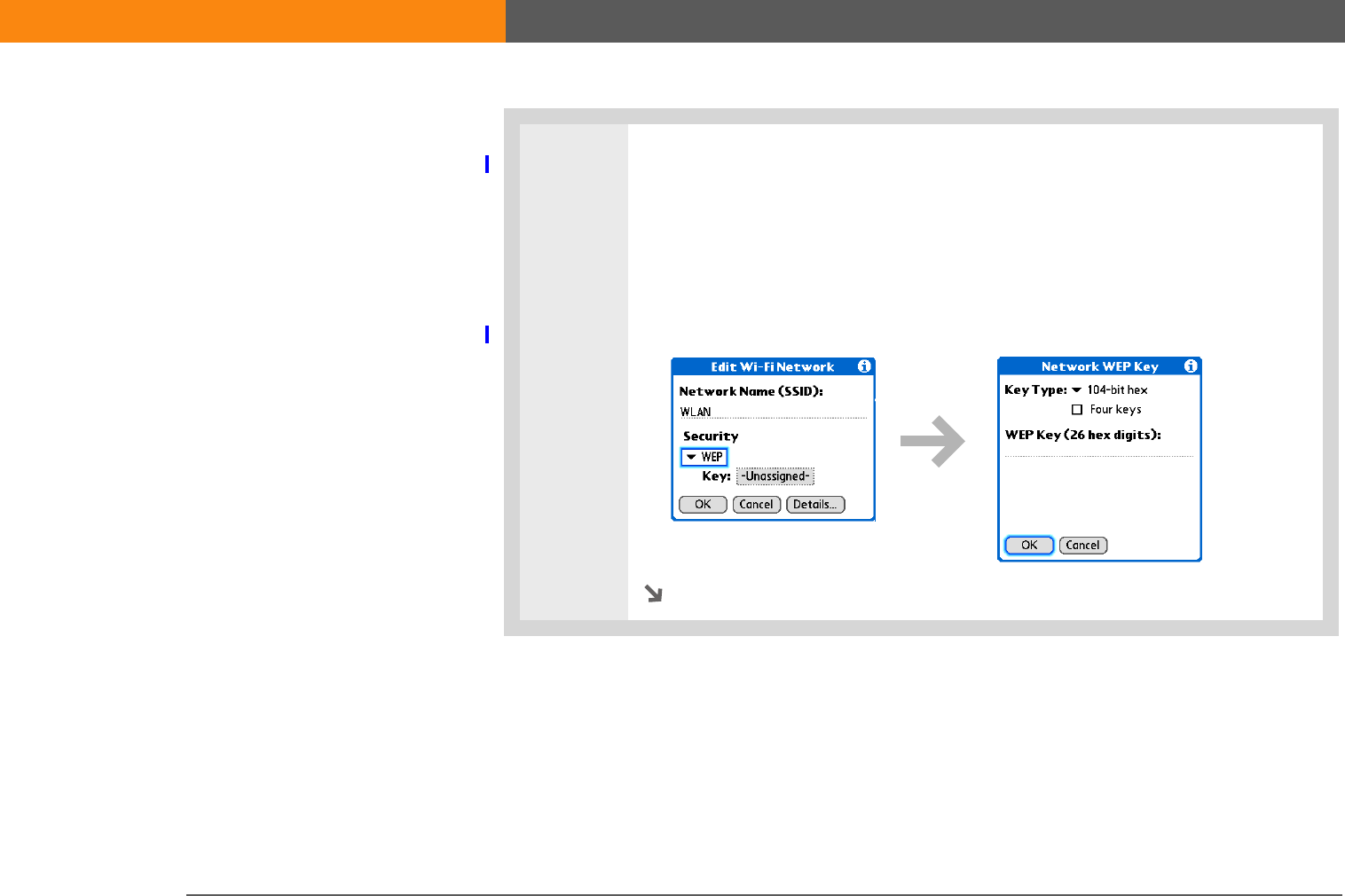
LifeDrive™Device 304
CHAPTER 16 Making Wi-Fi Wireless Connections
7If you selected WEP in step 6:
a. Tap the WEP Key box.
b. Enter the WEP encryption information.
c. Select OK.
d. Go to step 9.
Continued
SECOND DRAFT palmOne, Inc. Confidential
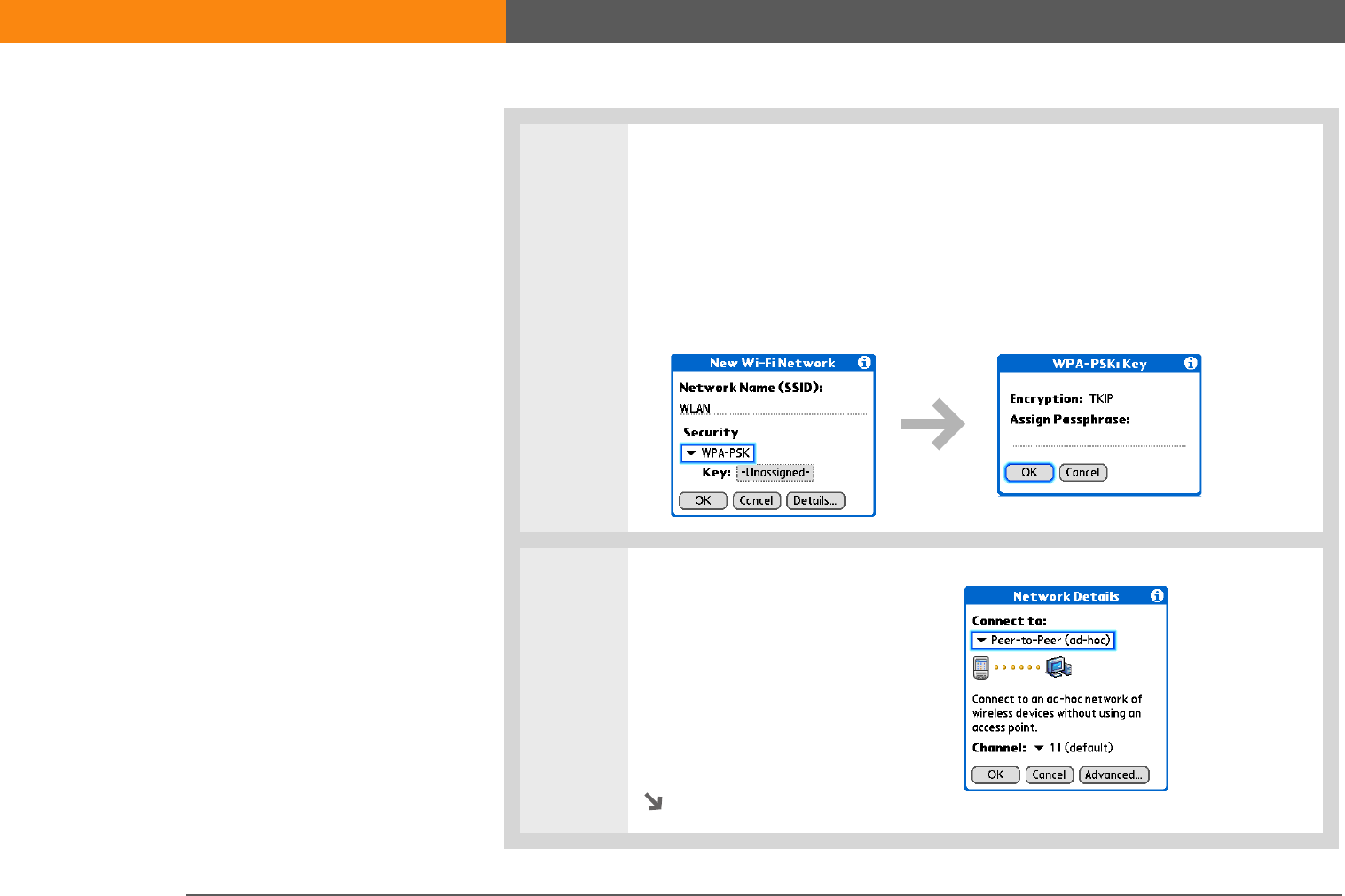
LifeDrive™Device 305
CHAPTER 16 Making Wi-Fi Wireless Connections
8If you selected WPA-PSK in step 6:
a. Check the WPA-PSK box.
b. Tap the Key box.
c. Assign a passphrase.
d. Select OK.
9Set the connection:
a. Tap Details.
b. Select Peer-to-Peer (ad hoc)
from the Connect to pick list.
c. Select the channel number
from the Channel pick list.
Continued
SECOND DRAFT palmOne, Inc. Confidential
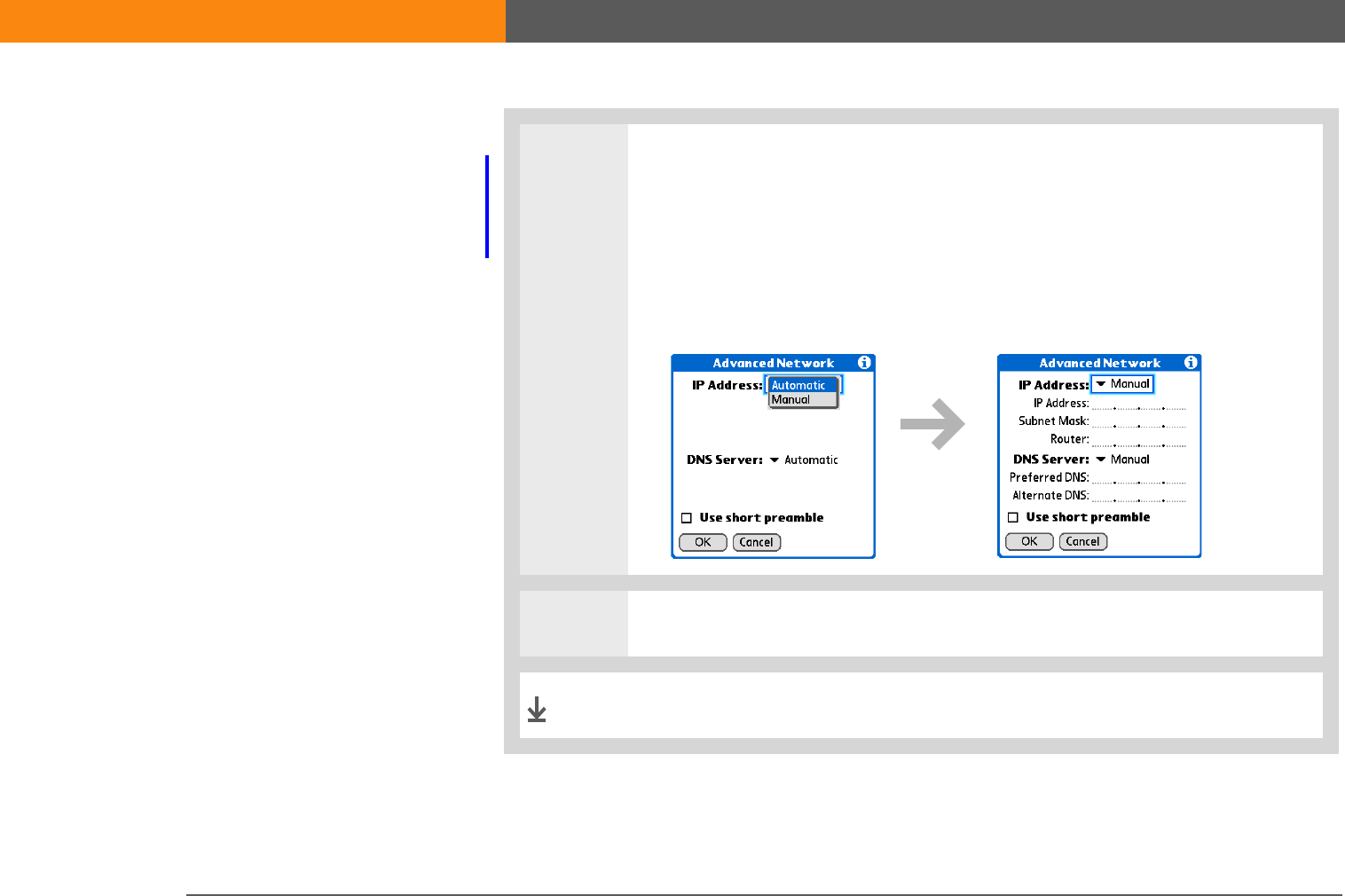
LifeDrive™Device 306
CHAPTER 16 Making Wi-Fi Wireless Connections
10 [ & ] OPTIONAL Manually set your IP or DNS address:
a. Select Manual from the IP Address or DNS Server pick list.
b. Enter the IP address or DNS server information.
c. If you want to use a preamble, check the Use short preamble box.
d. Select OK.
11 Select OK three times and then select Done.
You can now connect to the device any time you are within range.
Done
SECOND DRAFT palmOne, Inc. Confidential

LifeDrive™Device 307
CHAPTER 16 Making Wi-Fi Wireless Connections
Related topics
Click a link below to learn about these related topics:
Moving
Around
• Opening applications
• Using menus
Synchronizing Synchronizing your device with your desktop PC
Contacts Connecting to telephone numbers in your list of contacts
VersaMail Sending and receiving email messages wirelessly using your device’s Wi-Fi
technology
Bluetooth Using your device’s Bluetooth wireless technology
Common
Questions
Answers to frequently asked questions about Wi-Fi wireless technology
Tips & Tricks
Make your device uniquely
yours. For great tips,
software, accessories, and
more, visit
www.palmOne.com/
mylifedrive.
Support
If you’re having problems
with your device’s wireless
capabilities or with anything
else on your device, go to
www.palmOne.com/
support.
SECOND DRAFT palmOne, Inc. Confidential

LifeDrive from palmOne 308
CHAPTER 17
Making Bluetooth Wireless Connections
During the day, you need Wi-Fi® to
access your corporate network. During
the evening when you are with your
friends, you need Bluetooth® wireless
technology to share your contacts or
your favorite photos.
Staying connected in the world means
you have the latest wireless technology
at your fingertips at all times. Now
your device can actually connect you to
the wireless world using either Wi-Fi or
Bluetooth wireless technology. Your
device’s built-in Bluetooth functionality
helps you easily set up wireless
connections to a number of devices so
you can enjoy the convenience of
cable-free connectivity.
Benefits of your device’s
Bluetooth technology
• Connect to your Bluetooth phone to
send text or email messages or to
access the web
• Reduce cable clutter by synchronizing
wirelessly
• Connect to other devices, such as
cameras, to share files wirelessly
I
n t
hi
s c
h
apter
What can I do with the built-
in Bluetooth wireless
technology?
Entering basic Bluetooth
settings
Setting up a Bluetooth
phone connection
Accessing email and the web
with Bluetooth
Setting up a connection for
Bluetooth synchronization
Setting up a connection to a
network
Creating trusted devices
Setting advanced Bluetooth
features
Related topics
SECOND DRAFT palmOne, Inc. Confidential

LifeDrive from palmOne 309
CHAPTER 17 Making Bluetooth Wireless Connections
What can I do with the built-in Bluetooth wireless
technology?
Connect to your Bluetooth phone to send text or email messages or to access the web.
Whether you access the Internet or send text or email messages once a week or constantly
throughout the day, wireless connectivity means that you can go online anytime by connecting by
means of your mobile phone or your laptop connected to the Internet.
Reduce cable clutter by synchronizing wirelessly. Imagine your desk and workstation without
cable clutter. Bluetooth wireless technology on your device replaces many of the connecting
cables with a wireless connection for tasks such as synchronizing.
Connect to other devices to share files wirelessly. Wouldn’t it be great if you could send files
such as photos wirelessly or print wirelessly on a Bluetooth printer? Use the built-in Bluetooth
wireless technology to set up connections to devices within approximately 30 feet of your device.
What types of connections can I make?
With Bluetooth wireless technology, you can make connections using the following types of
devices:
• To browse the Internet or access your email account, link through your desktop computer’s
network connection or establish a connection to a Bluetooth LAN Access Point.
• To access the Internet or an email account, connect to your mobile phone. To use a mobile
phone, you must dial your ISP or sign up for an account with a high-speed wireless carrier.
• To send and receive text messages, connect to your mobile phone.
• To synchronize your device with your computer wirelessly, connect to your computer.
• To share files with another Bluetooth device such as a handheld or printer, form a trusted pair
with that device.
»
Key Term
Bluetooth Technology
that enables devices such
as handhelds, mobile
phones, and computers
to connect wirelessly to
each other.
Before You Begin
[!]
Any device you connect
to must also be a
Bluetooth device with
Bluetooth features
enabled. Check the user
guide that came with the
device for information on
how to enable the
Bluetooth features.
SECOND DRAFT palmOne, Inc. Confidential

LifeDrive from palmOne 310
CHAPTER 17 Making Bluetooth Wireless Connections
What is device discovery?
Discovery is the process in which your device searches for other Bluetooth devices within its range
(approximately thirty feet). As each device is discovered, it shows up in your Discovery Results.
After you find the devices you are looking for, you can select the devices with which you want to
connect.
The Bluetooth application on your device can be turned on and off, and the application has a
Discoverable setting that can also be turned on and off. The following is a description of setting
combinations and the resulting discovery states:
Bluetooth Off When the Bluetooth setting is off, other users cannot discover your device. This is
similar to locking your door with a dead bolt and a security chain, and disabling the doorbell.
When Bluetooth is off, you cannot access the Discoverable setting.
Bluetooth On and Discoverable No When your device and Bluetooth are on and the Discoverable
setting is set to No, you can receive connections only from devices with which you have
previously formed a trusted pair. This is similar to locking your door with a dead bolt and disabling
the doorbell, but any friends who already have the key can enter. By default, the Discoverable
setting is enabled when Bluetooth is on.
Bluetooth On and Discoverable Yes When your device is on, Bluetooth is on, and the
Discoverable setting is set to Yes, you can receive connections from any Bluetooth device. You are
automatically connected with devices with which you have previously communicated, but you can
refuse invitations to connect with unrecognized devices. This is similar to locking your front door
with a dead bolt and enabling the doorbell. Friends who already have the key can enter freely, and
if someone without a key rings the bell to request a connection, you can choose to open the door
or ignore the request.
SECOND DRAFT palmOne, Inc. Confidential
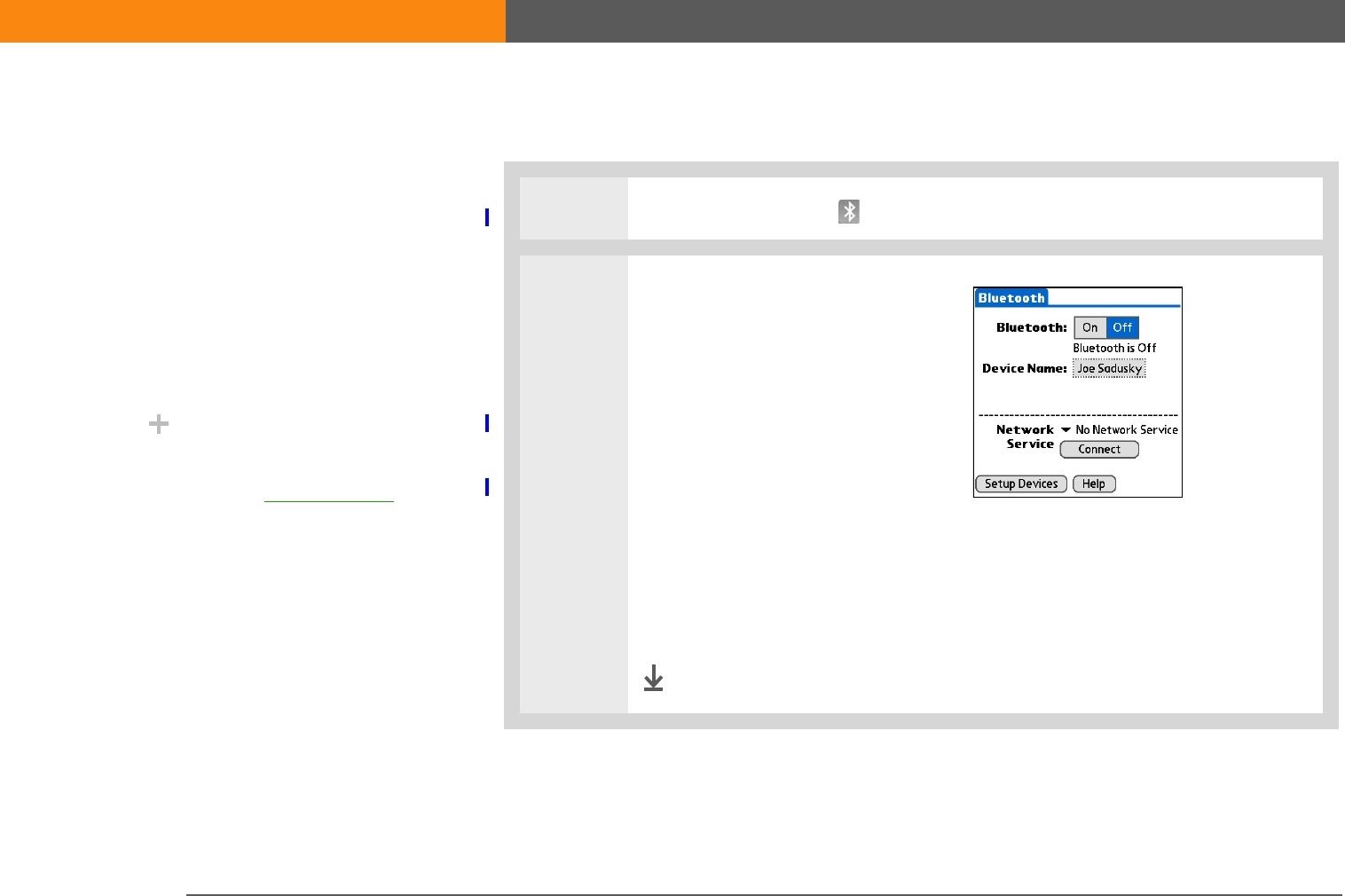
LifeDrive from palmOne 311
CHAPTER 17 Making Bluetooth Wireless Connections
Entering basic Bluetooth settings
0
1Tap Bluetooth controls on the status bar.
2Enter the basic Bluetooth
settings:
a. Select On.
b. Tap the Device Name field and
enter a name for your device.
This is the name that other
Bluetooth devices see when
they connect to your device.
By default it is the username
you use during
synchronization, but you can
change it.
c. Select the Discoverable pick
list and select Yes or No.
Done
»
Key Term
Discoverable Setting
that allows other devices
to find and connect with
your device using
Bluetooth wireless
technology. If your device
is not discoverable, other
devices cannot find it to
make a connection. Your
device must be on in
order to be discoverable.
Did You Know?
When your Bluetooth
icon on the status bar is
dimmed, Bluetooth is off
and your device is not
discoverable.
SECOND DRAFT palmOne, Inc. Confidential
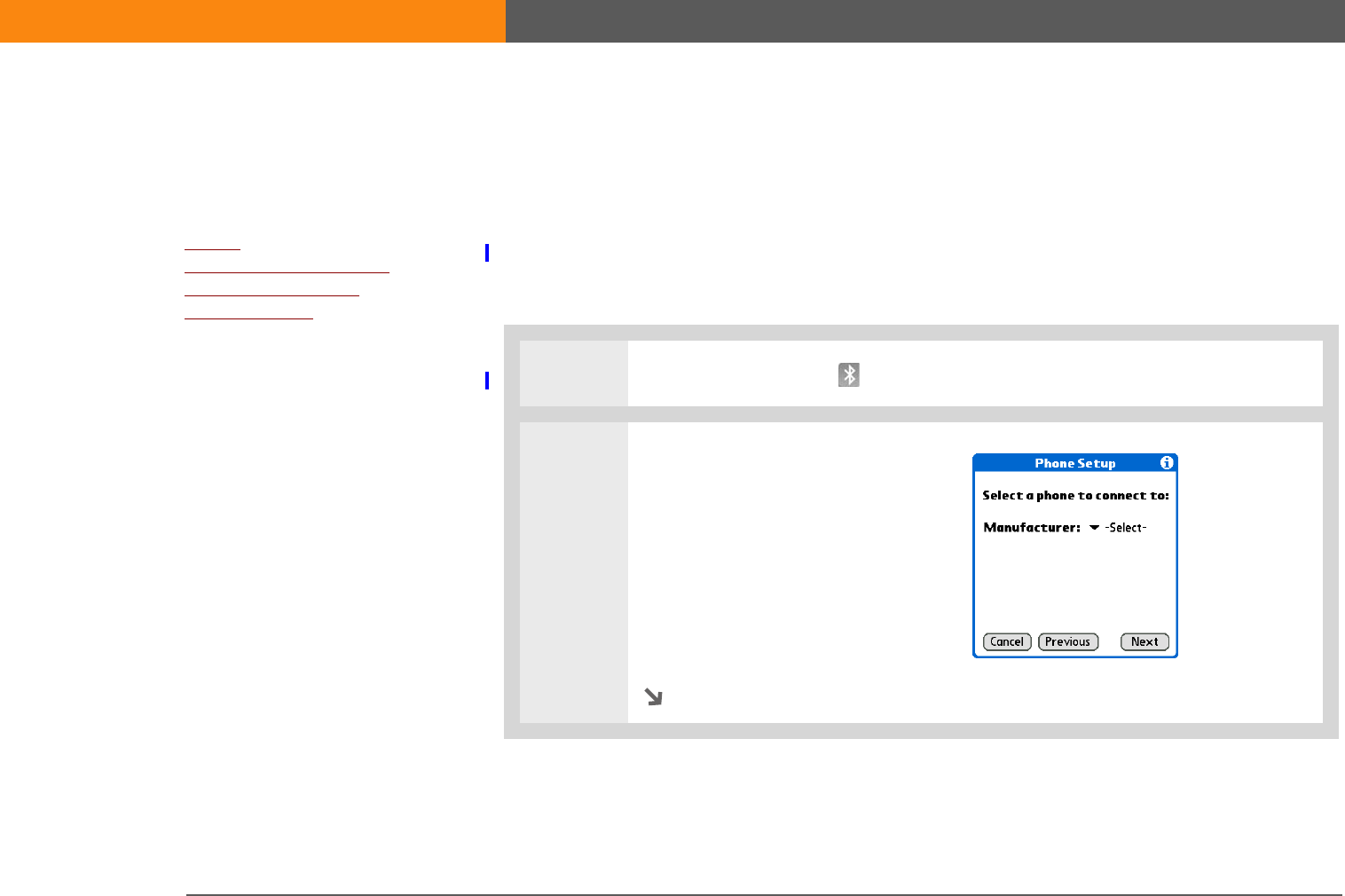
LifeDrive from palmOne 312
CHAPTER 17 Making Bluetooth Wireless Connections
Setting up a Bluetooth phone connection
To set up a phone connection, you must have a GSM or GPRS mobile phone
enabled with data services.
You can form a trusted pair between your device and your mobile phone. Once you have set up
the trusted pair connection, you automatically connect to your phone when you want a Bluetooth
connection.
0O
1Tap Bluetooth controls on the status bar.
2Open the Phone Setup dialog
box.
a. Select Setup Devices.
b. Select Phone Setup.
c. Select Phone Connection.
d. Select Next.
Continued
Before You Begin
[!]
If you have an IR phone,
you must download the
Phone Link application
from the web. Go to
http://
www.palmOne.com/us/
support/downloads/
phonelink.html to
download the software.
»
Key Term
Trusted pair Two
devices—for example,
your device and your
mobile phone—that can
connect to each other
because each device can
find the same passkey on
the other device. Once
you form a trusted pair
with a device, you do not
need to enter a passkey to
connect with that device
again.
IMPORTANT
[!]
SECOND DRAFT palmOne, Inc. Confidential
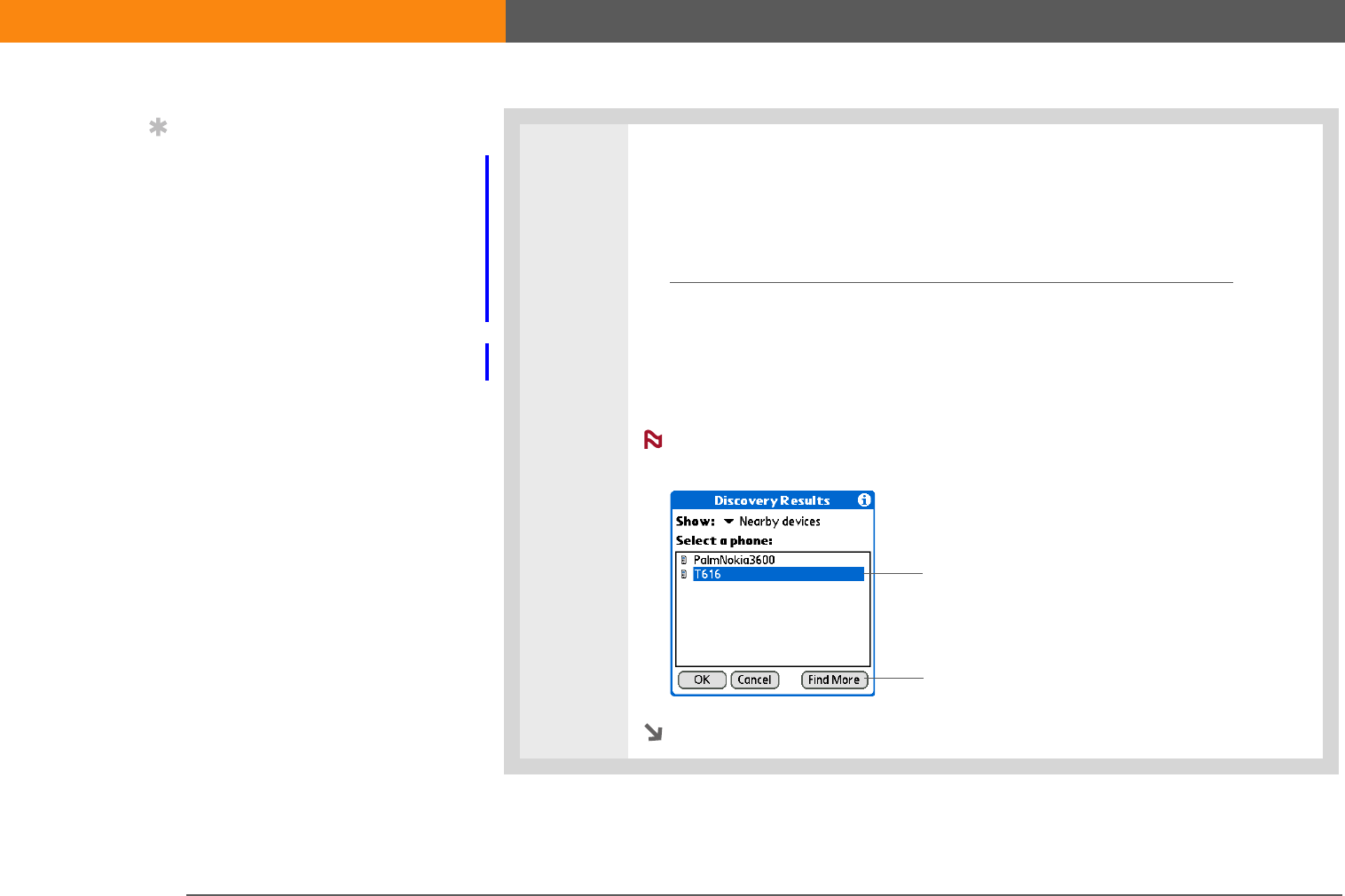
LifeDrive from palmOne 313
CHAPTER 17 Making Bluetooth Wireless Connections
3Select the phone you want to connect to:
a. Select the Manufacturer and Model pick lists, select the correct entries for
your phone, and then select Next.
If the phone does not appear on the list, check for phone compatibility at
http://www.palmOne.com/us/support/downloads/phonelink.html.
b. The Connection Setup screen displays all Bluetooth phones within range.
If your phone is not listed in the discovery results, check whether your phone
is Bluetooth discoverable. Select Find More to search again.
c. Select the phone you want, select OK, and then select Next again.
Not all features are available if your specific phone model is not in
the pick list.
Continued
Tip
If you receive a message
that your phone is not
ready to accept a
connection, check to
make sure that your
phone is prepared to
make a Bluetooth
connection. See the
instructions included with
your phone.
NOTE
Select phone
Select if your phone
does not appear
SECOND DRAFT palmOne, Inc. Confidential
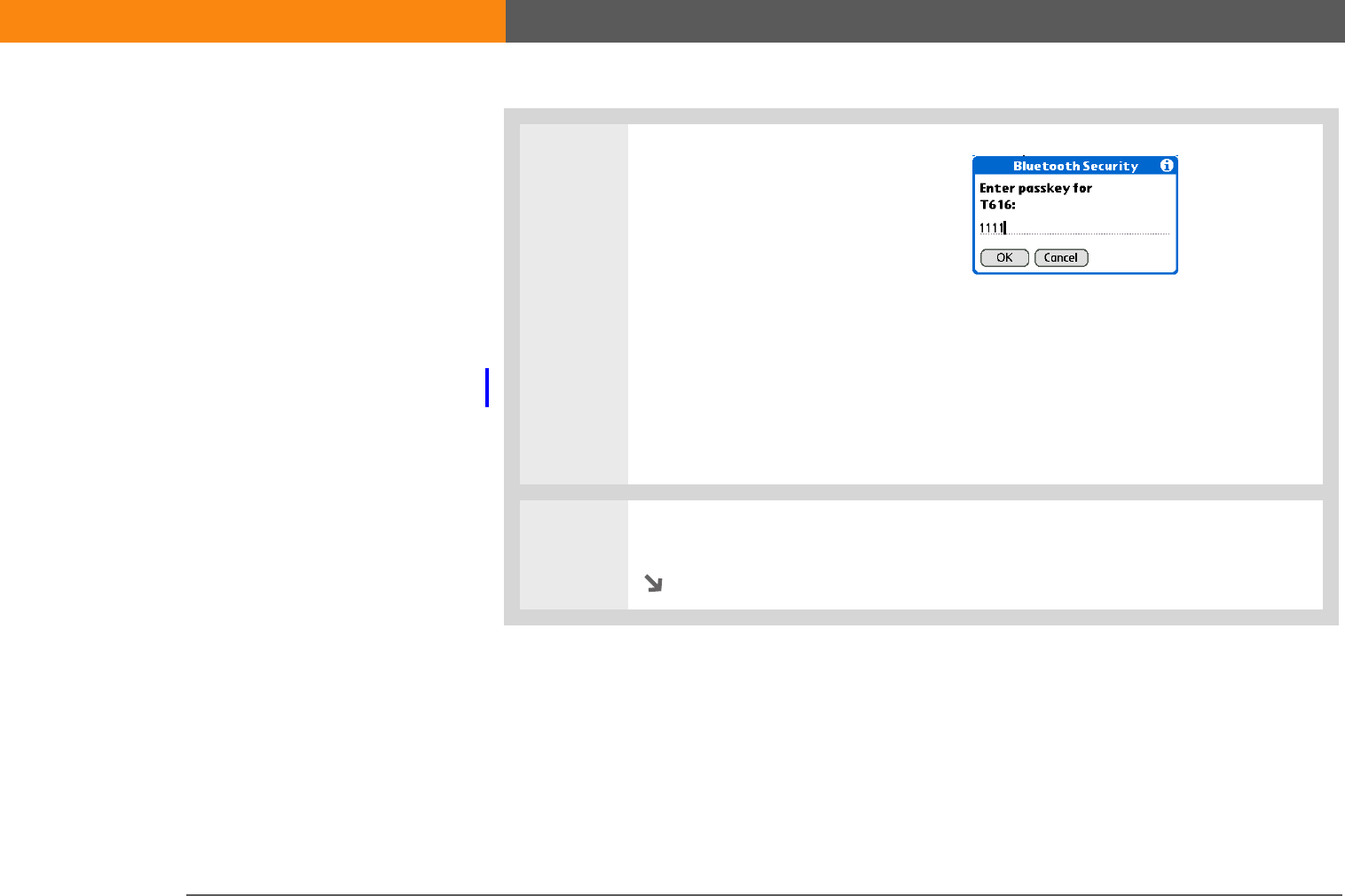
LifeDrive from palmOne 314
CHAPTER 17 Making Bluetooth Wireless Connections
4Enter a passkey:
a. Enter a passkey number. This
can be any number you
choose; it does not, for
example, have to be a
password you use to access a
network or an email account.
You must enter
the same passkey on your device
and your mobile phone in order
to connect to your phone.
b. Select OK.
5Select Done to finish phone connection setup.
Continued
»
Key Term
Passkey Like a
password, the passkey is
a security measure.
Connections can happen
only between your device
and a device that has the
same passkey. For
example, to connect to
your mobile phone, you
need to enter the same
passkey on your device
and on your phone.
IMPORTANT
[!]
SECOND DRAFT palmOne, Inc. Confidential
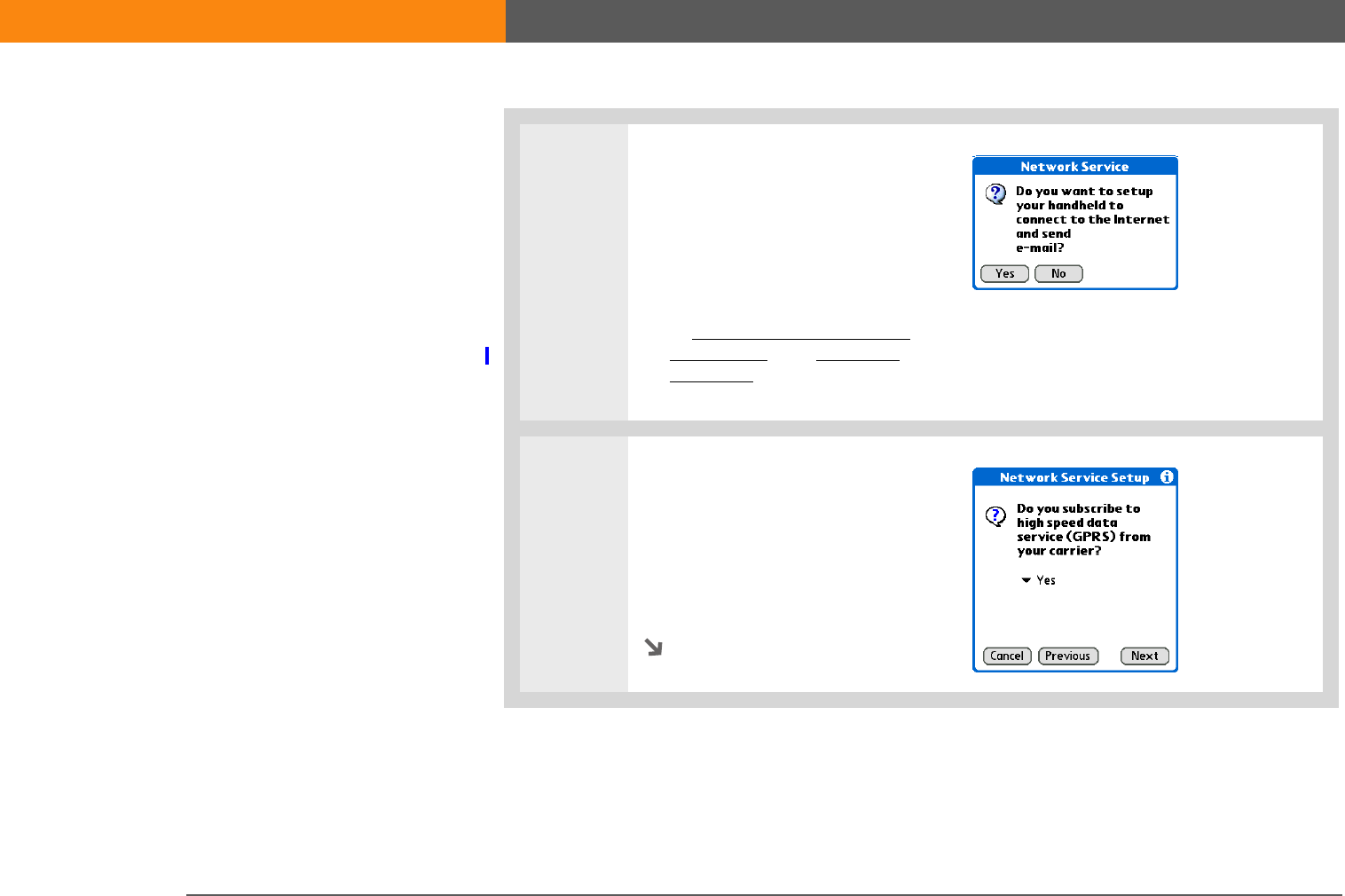
LifeDrive from palmOne 315
CHAPTER 17 Making Bluetooth Wireless Connections
6Determine if you want to be set
up with a network:
a. Select Yes to begin network
setup. Go to step 7.
b. Select No if you want to use
your phone connection only
to dial phone numbers from
your device or to send text
messages. You have finished
setup.
7Begin network setup:
a. If you select Yes, go to step 8.
b. If you select No, go to step 9.
c. Select Next.
Continued
SECOND DRAFT palmOne, Inc. Confidential
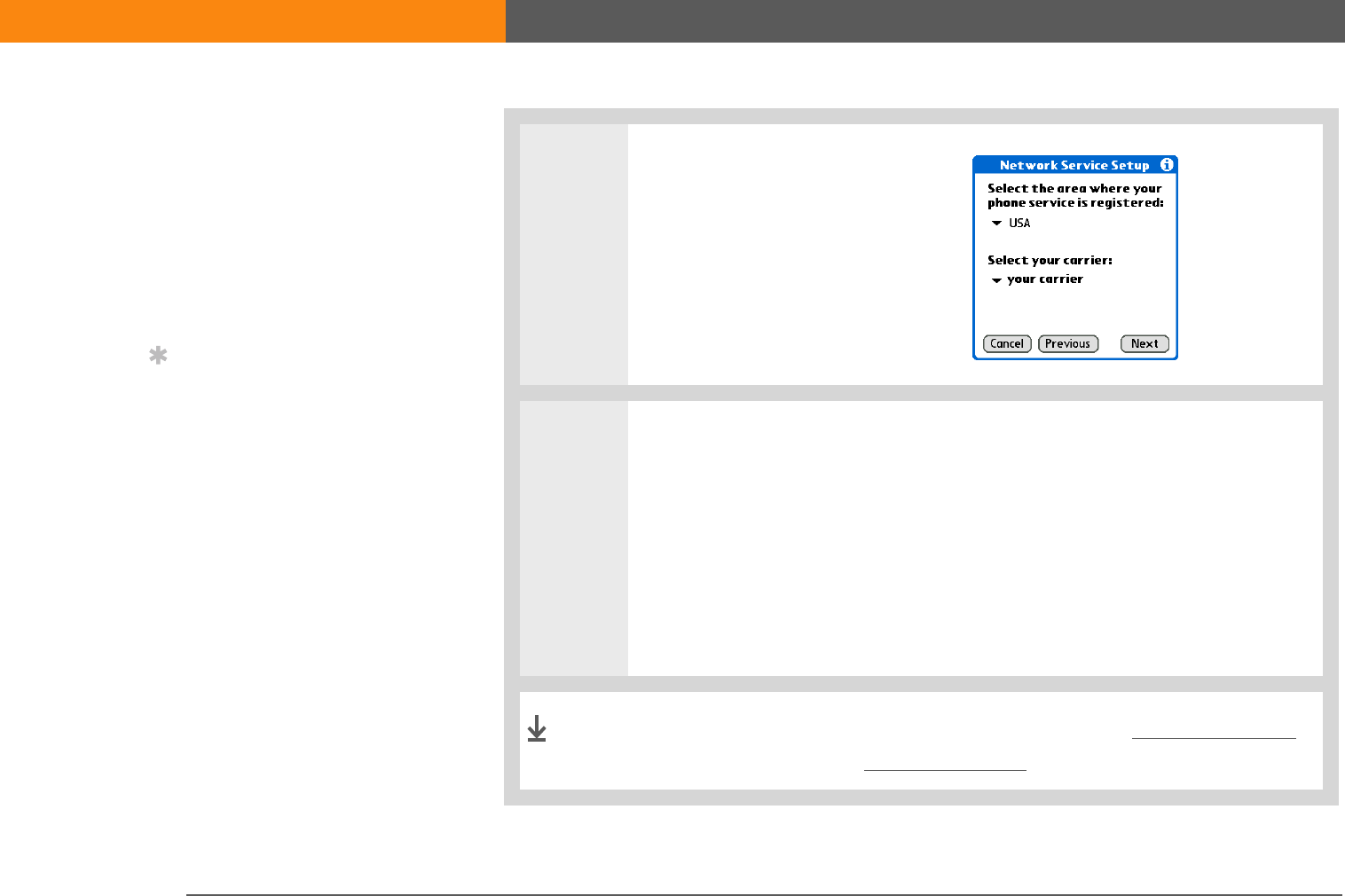
LifeDrive from palmOne 316
CHAPTER 17 Making Bluetooth Wireless Connections
8If you selected Yes in step 7:
a. Select the pick lists and select
the correct information for
your cellular carrier.
b. Select Next, and then select
Done.
9If you selected No in step 7:
a. Select Next.
b. Enter the phone number you use to dial in to your ISP and the username for
your dial-up account.
c. Select the Password box, enter your account password, and select OK. This
is the password you use to access your dial-up account.
d. Select Next, and then select Done.
You now have set up your phone connection to browse the web
and send and receive email messages.
»
Key Term
GPRS Acronym for
General Packet Radio
Service, a method of
sending information
wirelessly at high speeds.
Select Yes in step 6 only if
you have a GPRS account
for your mobile phone.
Tip
Contact your ISP (for
example, AOL or
Earthlink) if you are not
sure about one or more of
the items to enter in
step 8.
Done
SECOND DRAFT palmOne, Inc. Confidential
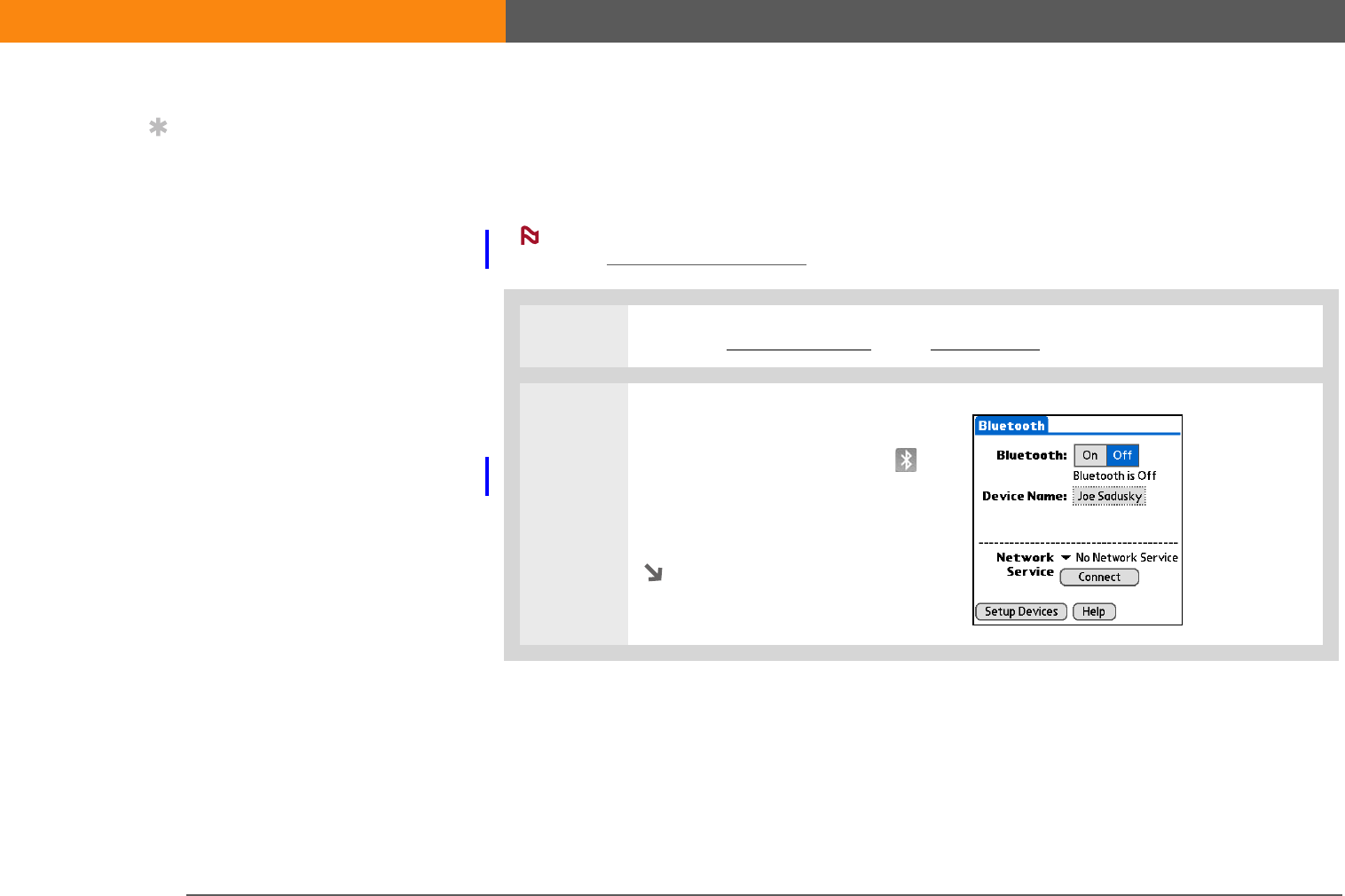
LifeDrive from palmOne 317
CHAPTER 17 Making Bluetooth Wireless Connections
Accessing email and the web with Bluetooth
After you set up a connection with a mobile phone, you can send and receive email or browse the
web wirelessly using this connection.
Bluetooth functionality must be turned on if you want to use wireless features. You
must also set up an email account on your device before you can send or receive email messages.
0
1Open the email application or the web browser.
2Verify Bluetooth status:
a. Tap the Bluetooth controls
on the status bar.
b. Make sure On is selected.
Continued
NOTE
Tip
You can select Bluetooth
controls on the status bar
to quickly check Bluetooth
status and make a
connection from any
application on your
device.
SECOND DRAFT palmOne, Inc. Confidential

LifeDrive from palmOne 318
CHAPTER 17 Making Bluetooth Wireless Connections
3Connect to your phone:
a. Select Prefs from the Bluetooth status screen.
b. On the Bluetooth preferences screen, select the Network Service pick list and
select the service that you want to use to connect to the Internet. If you set
up a phone connection, the name of the service you configured is listed.
c. Select Connect.
You are now ready to send and receive email messages or to
browse the web.
»
Key Term
Service Way of
connecting to a mobile
phone to send
information wirelessly,
for example, through a
high-speed (GPRS)
carrier or a dial-up
account with an Internet
service provider (ISP).
Tip
When you enter a URL in
the web browser or select
Get and Send in the
VersaMail® personal
email application,
a connection is
automatically initiated
with the last used service.
Done
SECOND DRAFT palmOne, Inc. Confidential
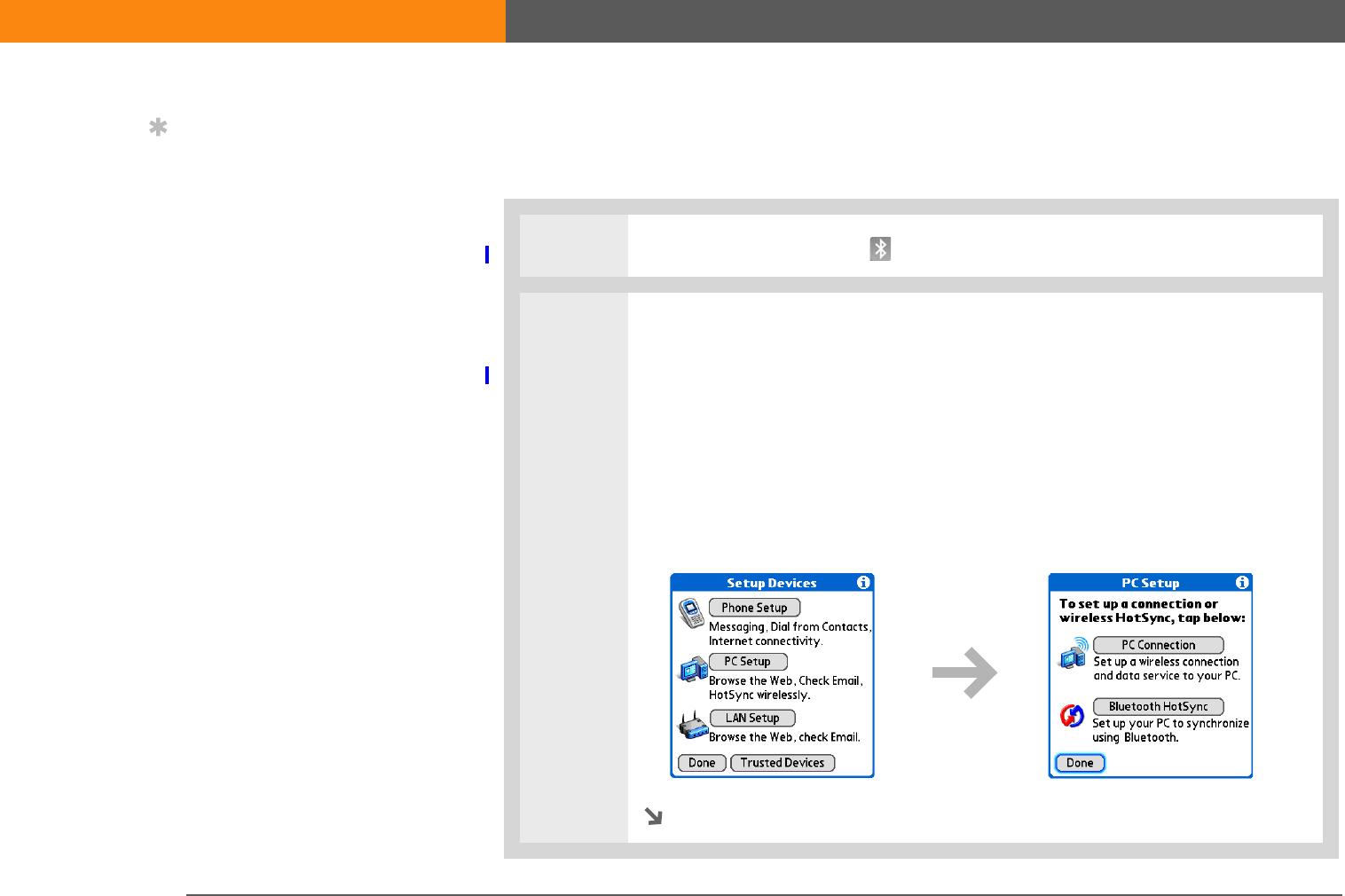
LifeDrive from palmOne 319
CHAPTER 17 Making Bluetooth Wireless Connections
Setting up a connection for Bluetooth synchronization
WINDOWS ONLY
0
1Tap the Bluetooth controls on the status bar.
2Open the PC Setup dialog box:
a. Select Prefs.
b. Select Setup Devices.
c. Select PC Setup.
d. Select Bluetooth HotSync.
e. Select Next.
.
Continued
Tip
After the first time you set
up a connection and
wirelessly synchronize
your device with a
computer, you can
synchronize with that
computer at any time by
choosing its device name
from the Service pick list
and tapping Connect.
SECOND DRAFT palmOne, Inc. Confidential
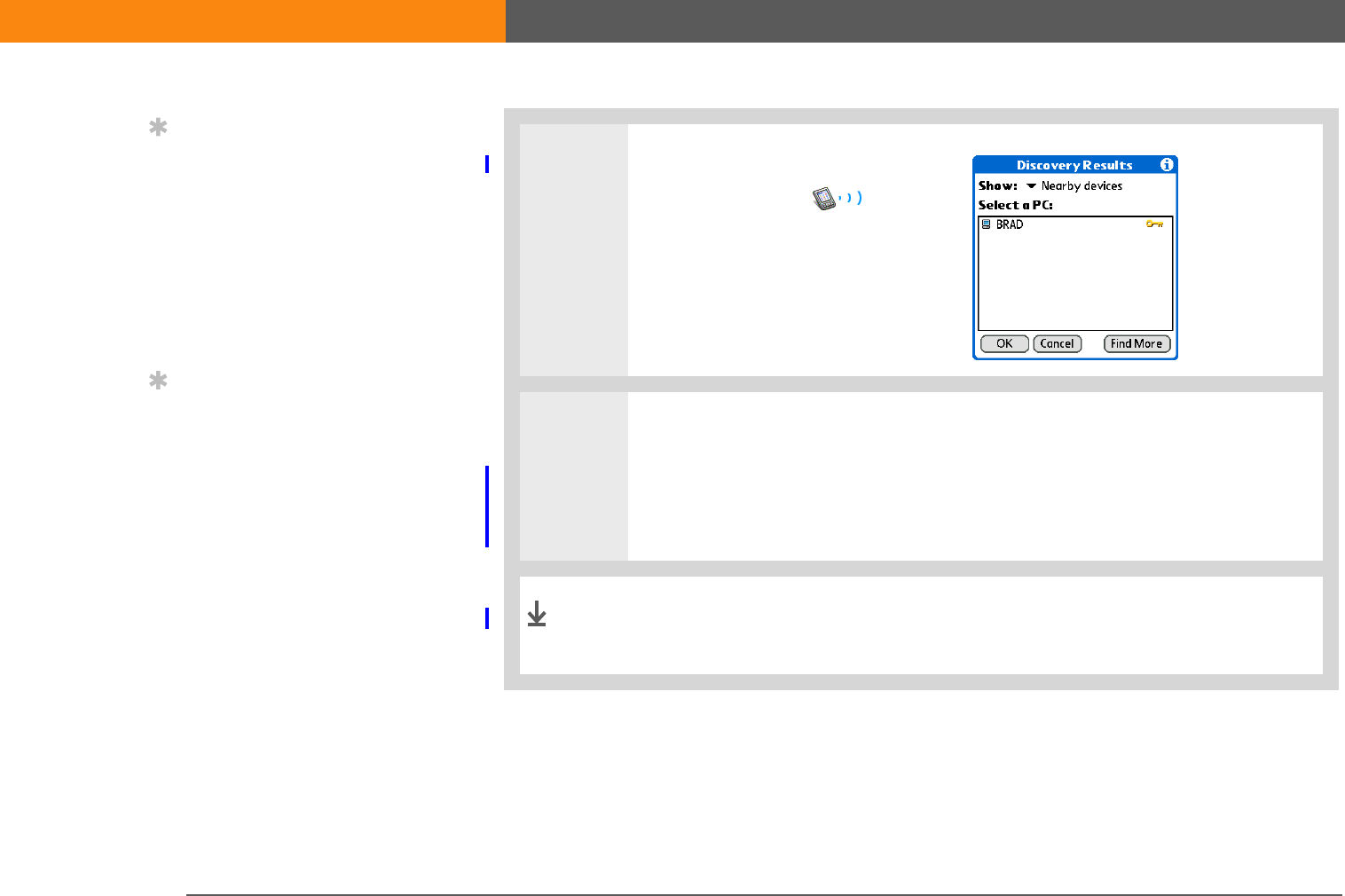
LifeDrive from palmOne 320
CHAPTER 17 Making Bluetooth Wireless Connections
3Select a computer and select OK.
The Discovery icon
appears to indicate that the
discovery process is active.
If your computer did not show up
on the discovery results, select
Find More to search again.
4Set up a connection for wireless synchronization:
a. Follow the instructions for steps 1 through 3 that appear onscreen, selecting
Next after each screen.
b. Select Launch HotSync in step 4.
Now you can easily synchronize your device with your computer
wirelessly.
Tip
To open HotSync®
Manager on your
computer in the onscreen
instructions (see step 4 in
this procedure), click the
HotSync Manager icon on
the taskbar in the lower-
right corner of your
computer screen.
Tip
Remember that Bluetooth
devices generally must be
within 30 feet of each
other to communicate.
Done
SECOND DRAFT palmOne, Inc. Confidential
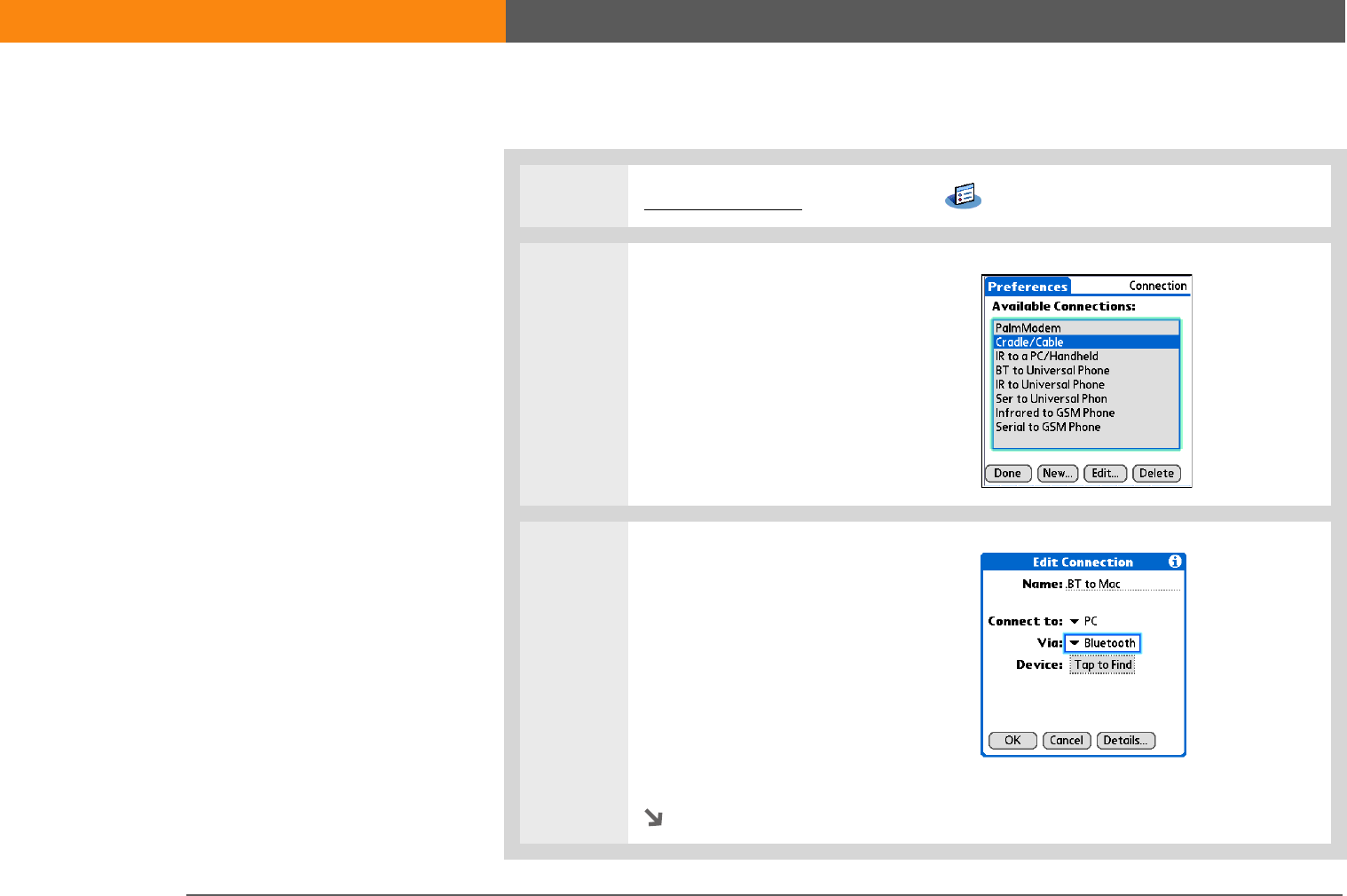
LifeDrive from palmOne 321
CHAPTER 17 Making Bluetooth Wireless Connections
MAC ONLY
0
1Go to Applications and select Prefs .
2Open the Edit Connection screen:
a. From the Communications
Preferences list, select
Connection.
b. Tap New.
3Set up the connection to your
computer:
a. Enter a name for the
connection, such as BT to Mac.
b. Select the Connect to pick list
and select PC.
c. Select the Via pick list and
select Bluetooth.
Continued
SECOND DRAFT palmOne, Inc. Confidential
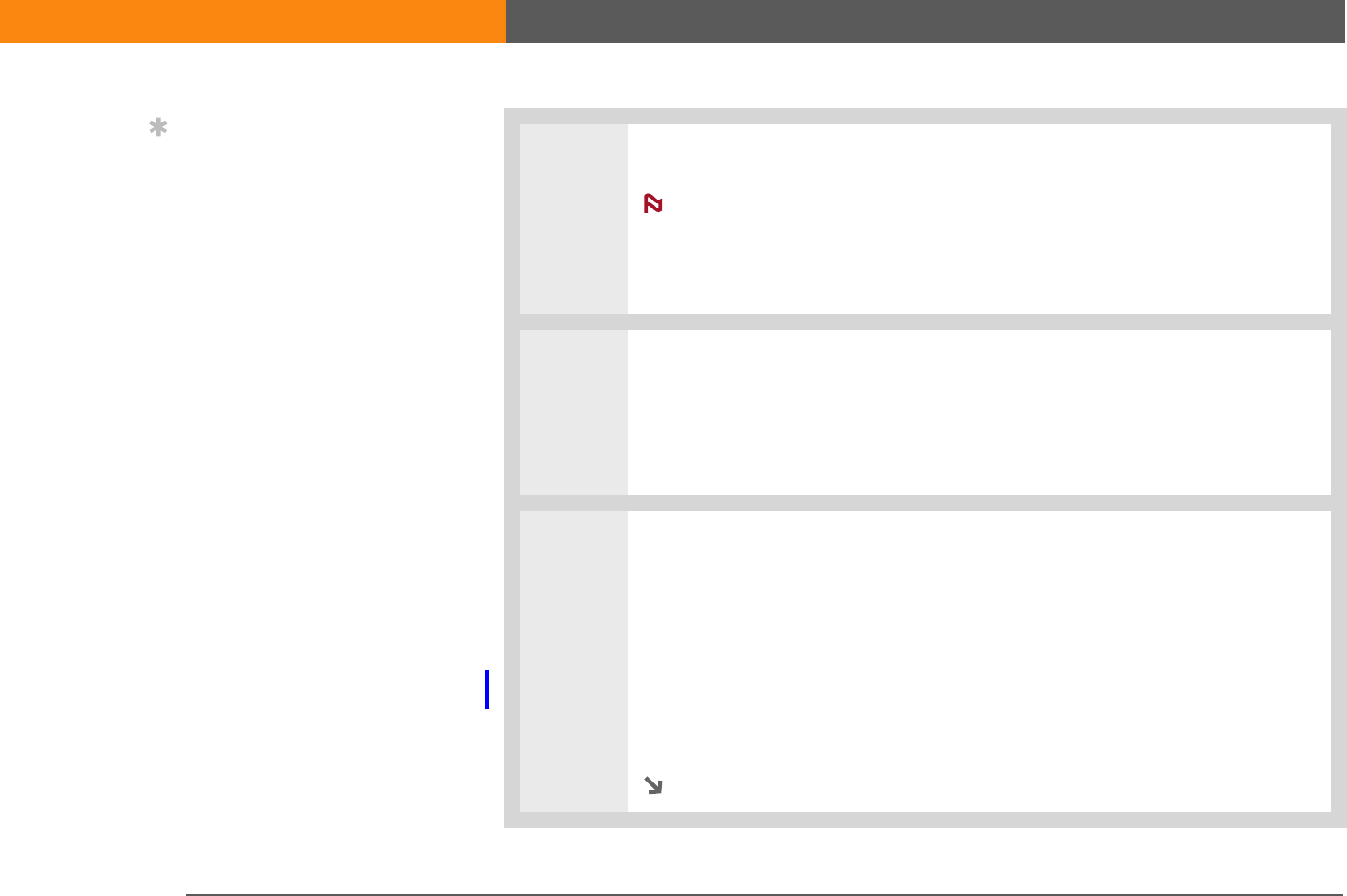
LifeDrive from palmOne 322
CHAPTER 17 Making Bluetooth Wireless Connections
Cont’d.
d. Make sure the computer is ready to accept a Bluetooth connection.
See the documentation included with the computer for information on
how to prepare it to accept a Bluetooth connection. The documentation might
refer to a Bluetooth connection as a Bluetooth pairing or a Bluetooth link.
e. Check the Device box.
4Select the computer:
a. When the Discovery Results screen appears, select your computer. If your
computer does not appear on the list, select Find More.
b. Select OK.
5[ & ] OPTIONAL If prompted, enter a passkey:
a. Enter a passkey number. This can be any number you choose; it does not
have to be, for example, a password you use to access a network or an email
account.
You must enter the same passkey on your device and your
computer in order to wirelessly synchronize your device with your computer.
b. Select OK.
Continued
Tip
Just as it is safer to use
different personal
identification numbers
(PINs) for different bank
accounts, your passkeys
are more secure if you use
a different passkey for
each device with which
you want to connect—one
passkey for a connection
to a phone, a different one
for a connection to a
computer, and so on. Just
remember that you must
enter the same passkey
on your device and on the
device with which you
want to connect.
NOTE
IMPORTANT
[!]
SECOND DRAFT palmOne, Inc. Confidential
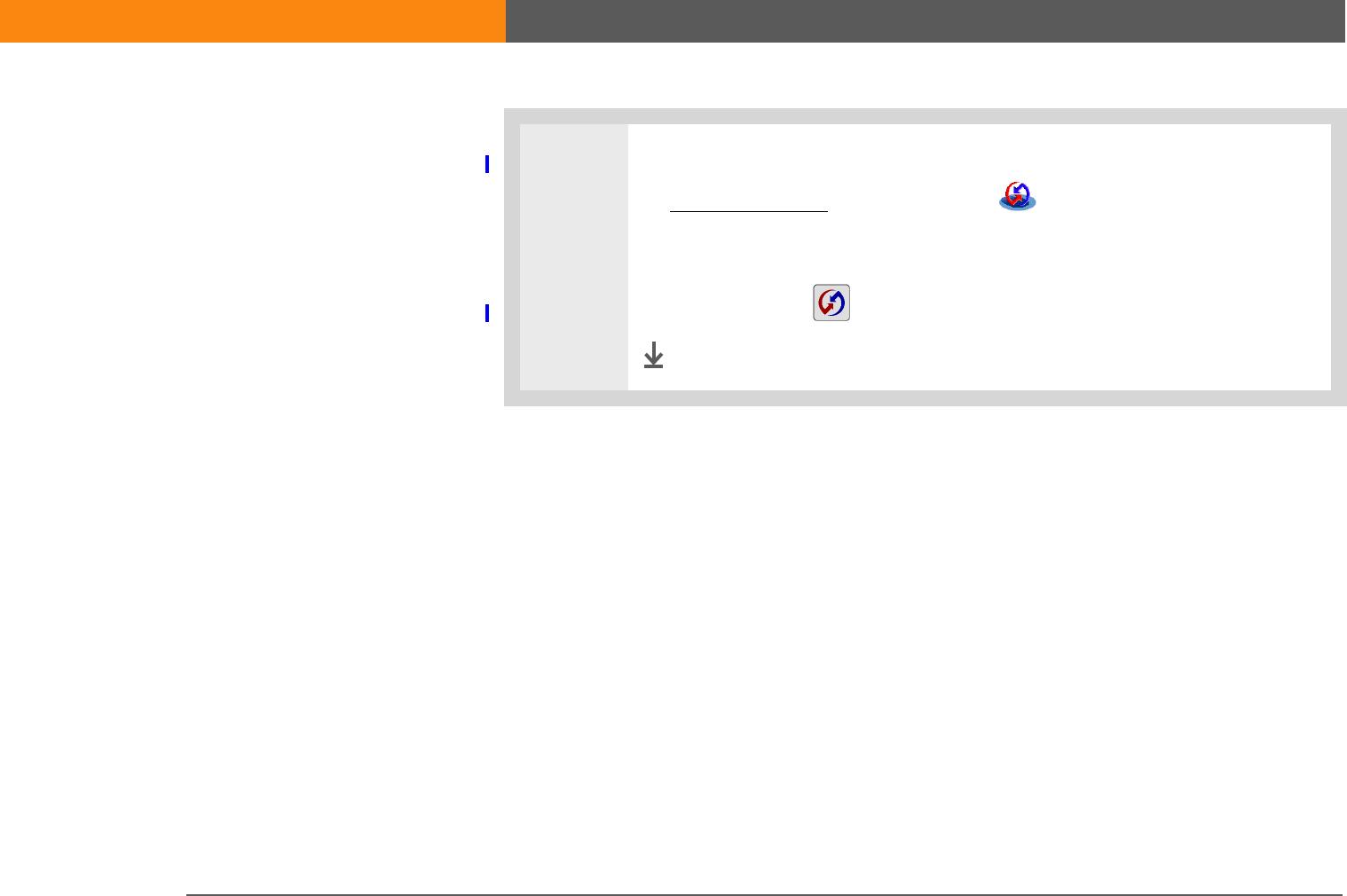
LifeDrive from palmOne 323
CHAPTER 17 Making Bluetooth Wireless Connections
6Synchronize your device with your computer:
a. Go to Applications and select HotSync .
b. Make sure that Local is selected, and select the connection you created in
step 3 from the pick list.
c. Tap the HotSync icon.
Done
SECOND DRAFT palmOne, Inc. Confidential
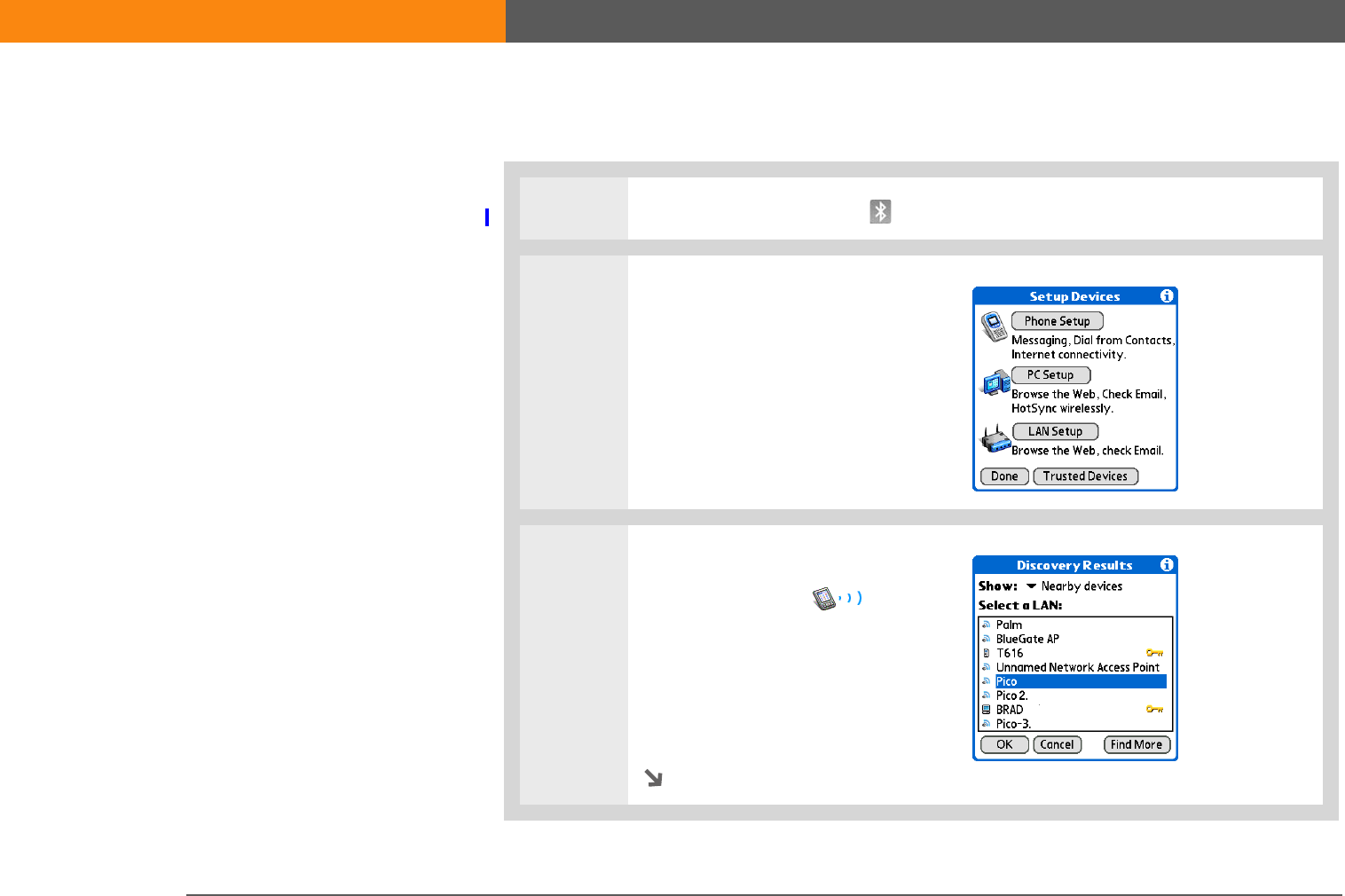
LifeDrive from palmOne 324
CHAPTER 17 Making Bluetooth Wireless Connections
Setting up a connection to a network
0
1Tap the Bluetooth controls on the status bar.
2Open the PC Setup dialog box:
a. Select Setup Devices.
b. Select LAN Setup.
c. Select Next.
3Select a LAN and select OK.
The Discovery icon
appears to indicate that the
discovery process is active.
If the LAN did not show up on
the discovery results, select Find
More to search again.
Continued
Before You Begin
[!]
You must get the passkey,
username, and password
for the LAN from the
system administrator.
»
Key Term
LAN Acronym for local
area network. LAN refers
to a local network that
connects computers
located in your home or
business.
SECOND DRAFT palmOne, Inc. Confidential
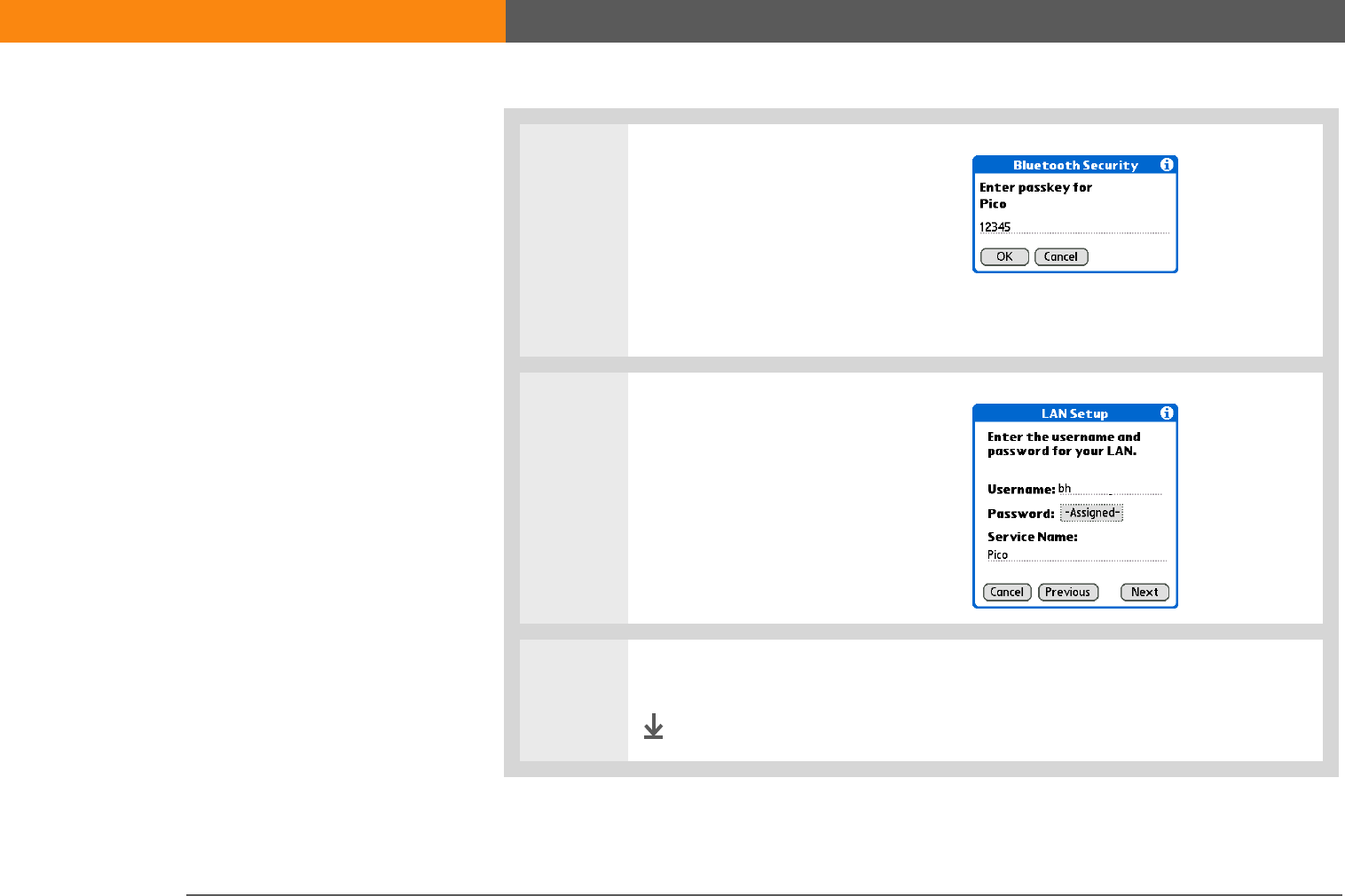
LifeDrive from palmOne 325
CHAPTER 17 Making Bluetooth Wireless Connections
4Create a trusted connection.
a. Select Yes to add the LAN as a
trusted device.
b. Select Next.
c. Enter the passkey number for
the LAN and select OK.
5Enter the username and
password for the LAN and select
Next.
6Select Done.
Done
SECOND DRAFT palmOne, Inc. Confidential
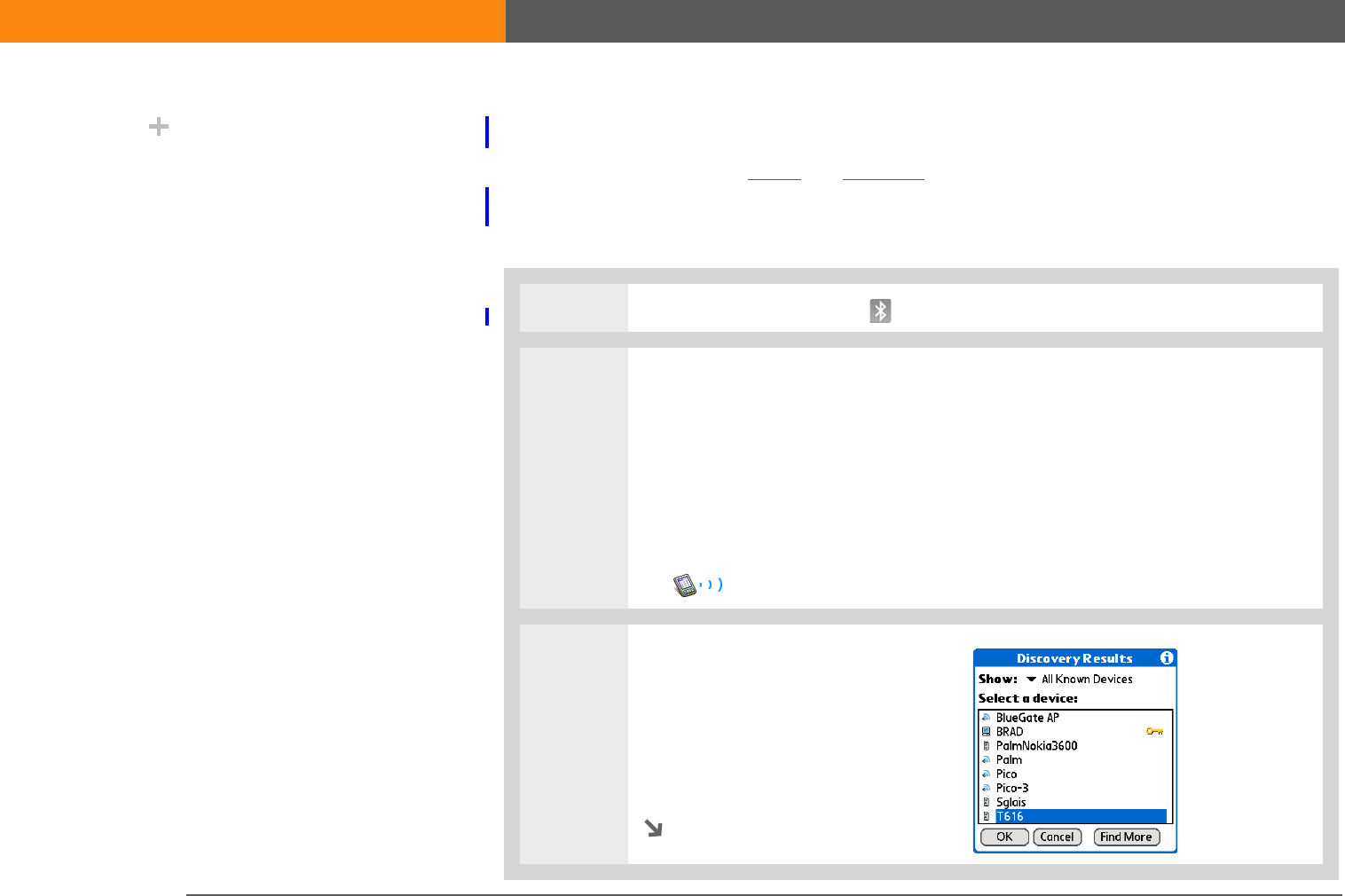
LifeDrive from palmOne 326
CHAPTER 17 Making Bluetooth Wireless Connections
Creating trusted devices
After you have set up your phone and computer as trusted devices, you may want to set up other
trusted devices, such as a friend’s device. When your device recognizes a trusted device, your
device automatically accepts communication, bypassing the discovery and authentication
process.
0
1Tap the Bluetooth controls on the status bar.
2Begin the discovery process:
a. Select Setup Devices.
b. Select Trusted Devices.
c. Select Add Device.
d. Select Trusted Devices to begin the discovery process. The Discovery icon
appears to indicate that the discovery process is active.
3Select the device you want to
add as a trusted device.
If the device you want to add
does not appear on the discovery
results list, select Find More to
search again.
Continued
Did You Know?
When your device and
Bluetooth are on and the
Discoverable setting is set
to No, you can receive
connections only from
devices with which you
have previously
communicated.
SECOND DRAFT palmOne, Inc. Confidential
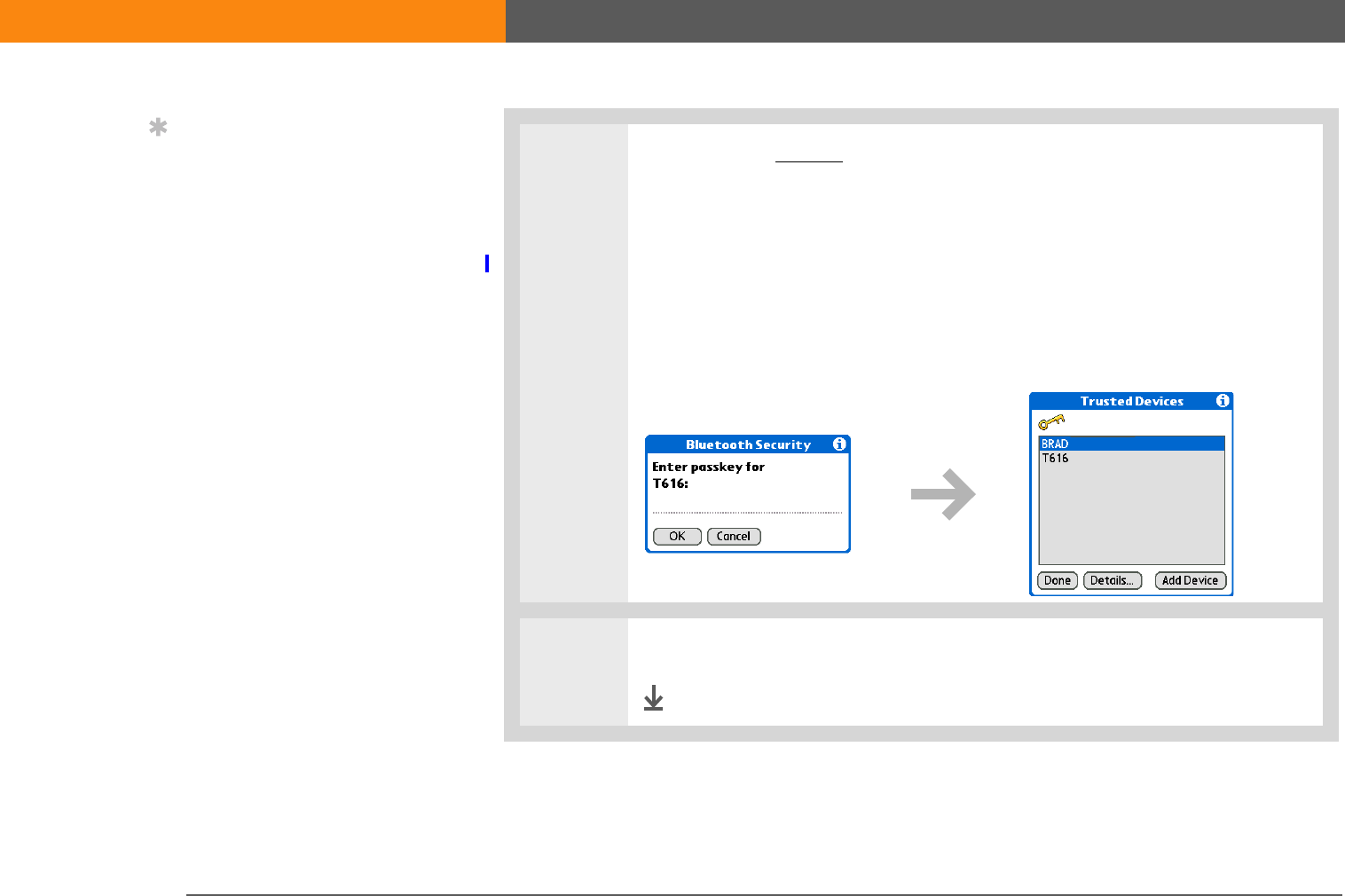
LifeDrive from palmOne 327
CHAPTER 17 Making Bluetooth Wireless Connections
4Enter the same passkey on your device and the other device and select OK.
Some Bluetooth devices have a built-in passkey; others
enable you to choose the passkey; see the documentation included with your
Bluetooth device for information. In either case you must use the same passkey
on both the device and your device.
Many phones also require you to put the phone into a mode where it can
accept a key exchange for bonding in a trusted pair. See the documentation
included with your phone for information.
5Select Done.
Done
Tip
You can delete a trusted
device or view the details
about a trusted device,
such as the device
address and your most
recent connection. In
Bluetooth Manager, select
Setup Devices, and then
select Trusted Devices.
Select the appropriate
device and select Details.
IMPORTANT
[!]
SECOND DRAFT palmOne, Inc. Confidential
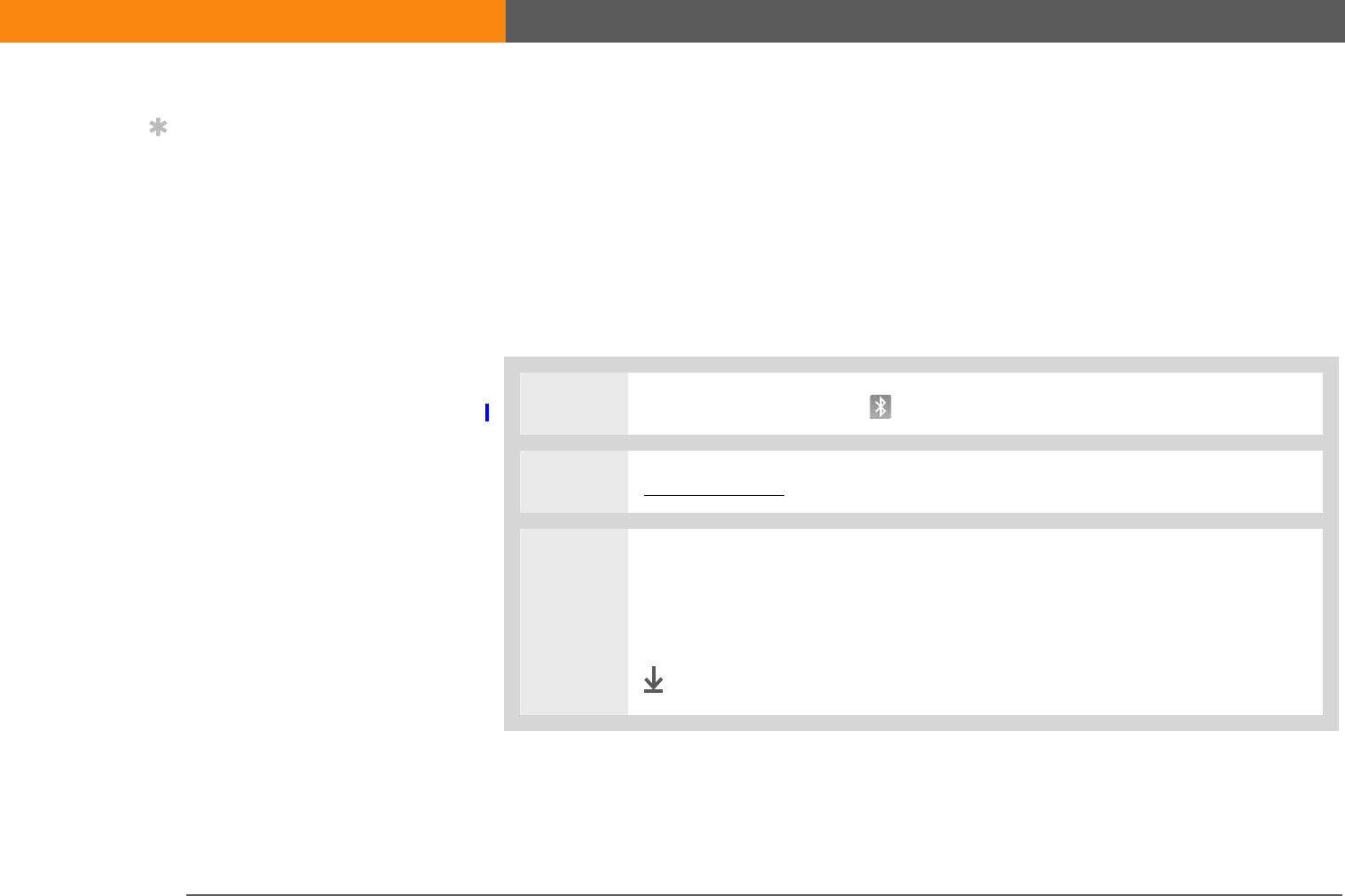
LifeDrive from palmOne 328
CHAPTER 17 Making Bluetooth Wireless Connections
Setting advanced Bluetooth features
These advanced settings are used in special circumstances.
Storing recently found device names
When you enable or disable the device name cache you control whether or not your device
retrieves the names of remote devices each time the discovery process takes place. By default, the
device name cache is enabled, which means the names of devices that are found are stored in
cache. The next time the device is discovered, the name appears very quickly.
0
1Tap the Bluetooth controls on the status bar.
2Open the menus.
3Select Options, and then select Disable device name cache.
The selection on the Option menu toggles to Enable device name cache. This
indicates that the cache is disabled.
Done
Tip
If the remote device name
has changed, disabling
and then enabling the
device name cache forces
your device to retrieve the
new device name.
SECOND DRAFT palmOne, Inc. Confidential
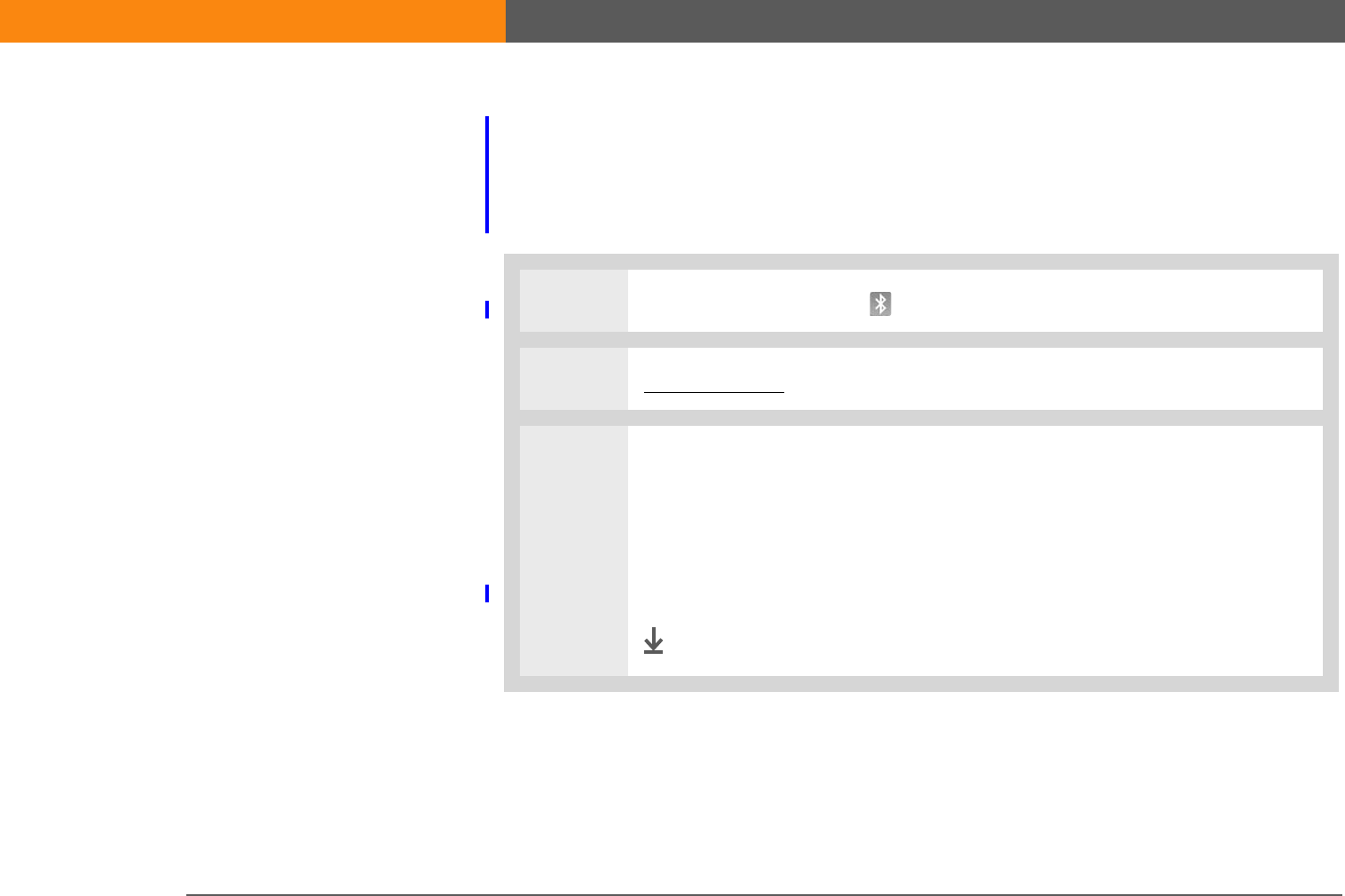
LifeDrive from palmOne 329
CHAPTER 17 Making Bluetooth Wireless Connections
Allowing your device to wake up when it is turned off
You can set your device to receive information through Bluetooth connections when your device is
turned off. The radio remains on, but your device is not discoverable. For another Bluetooth device
or application to wake up your device, it must know your device name. This limits the connections
to devices that are trusted or that have connected with you before.
0
1Tap the Bluetooth controls on the status bar.
2Open the menus.
3Select Options, and then select Allow wakeup.
The selection on the Option menu toggles to Do not allow wakeup indicating
that Allow Wakeup is enabled.
Enabling the Allow Wakeup setting uses battery power even
when your device is turned off. Be sure to monitor your battery level.
Done
IMPORTANT
[!]
SECOND DRAFT palmOne, Inc. Confidential

LifeDrive from palmOne 330
CHAPTER 17 Making Bluetooth Wireless Connections
Related topics
Click a link below to learn about these related topics:
Moving
Around
• Opening applications
• Using menus
Synchronizing Synchronizing your device with your desktop PC
Contacts Connecting to telephone numbers in your list of contacts
VersaMail Sending and receiving email messages wirelessly using your device’s
Bluetooth technology
SMS Sending and receiving text messages wirelessly using your device’s
Bluetooth technology
Wi-Fi Using your device’s Wi-Fi wireless technology
Common
Questions
Answers to frequently asked questions about Bluetooth wireless
technology
Tips & Tricks
Make your device uniquely
yours. For great tips,
software, accessories, and
more, visit
www.palmOne.com/
mylifedrive.
Support
If you’re having problems
with your device’s wireless
capabilities or with anything
else on your device, go to
www.palmOne.com/
support.
SECOND DRAFT palmOne, Inc. Confidential

LifeDrive from palmOne 331
CHAPTER 18
Sending and Receiving Email Messages
You already know how efficient email
is for staying in touch with personal
and business contacts. Now the
VersaMail® application brings you a
new level of convenience: email on the
go. Enjoy the ease and speed of
communicating with friends, family,
and colleagues anywhere you can
make an Internet connection.
You can email photos to your friends
and family. Or use Documents on your
device to create Microsoft Word or
Excel files and send them to your
colleagues. You can also receive any of
these file types as attachments to view
and edit at your convenience.
Benefits
• Access email on the go
• Send and receive photos, sound files,
Word and Excel files, and more
• Save messages from your computer
to view at a convenient time
I
n t
hi
s c
h
apter
Upgrading an existing email
account
About email accounts
Creating an account
Getting and reading
messages
Sending an email message
Working with email folders
Working with email
messages
Working with attachments
Advanced VersaMail
application features
Working with Microsoft
Exchange ActiveSync®
Related topics
SECOND DRAFT palmOne, Inc. Confidential
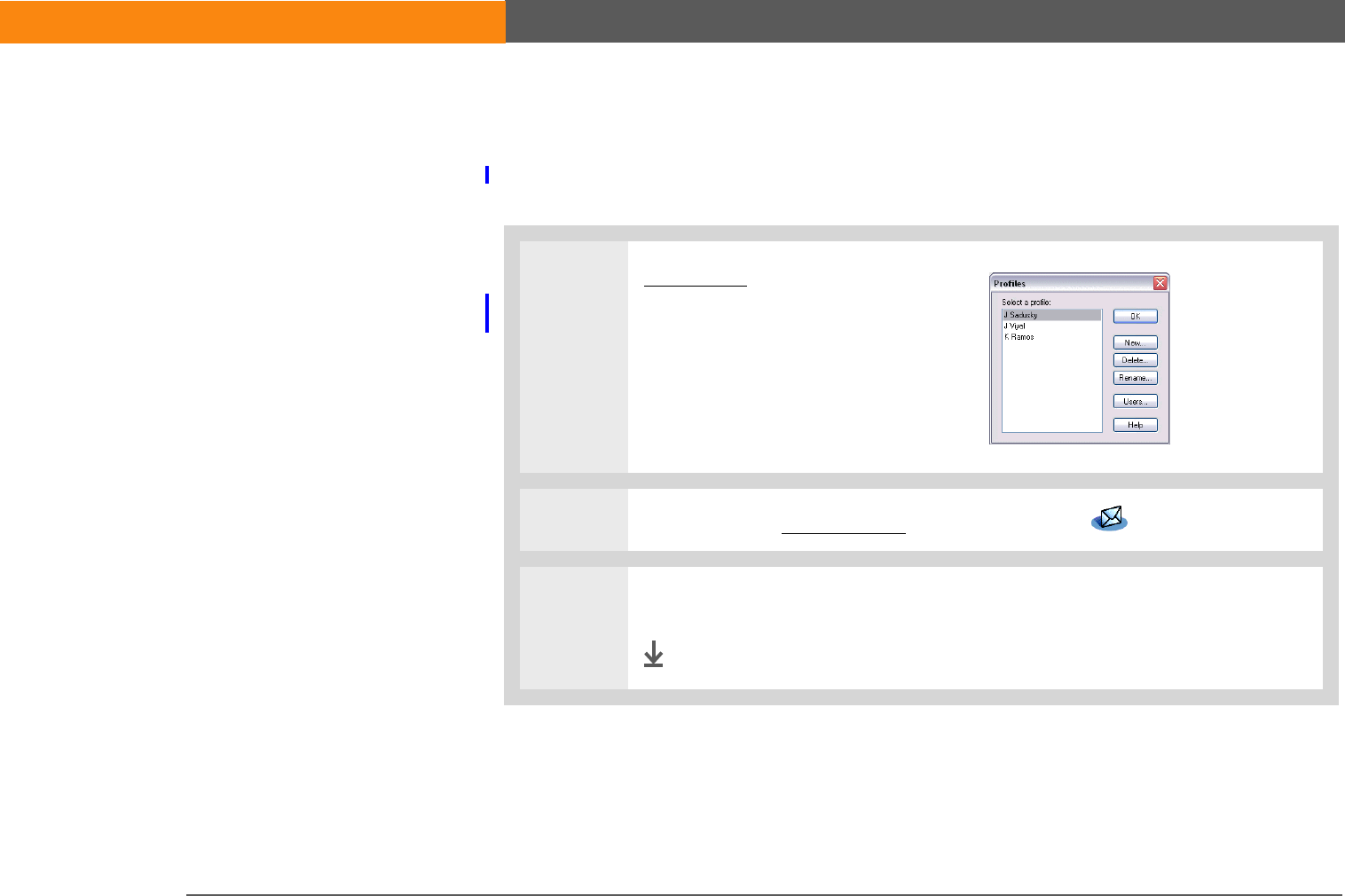
LifeDrive from palmOne 332
CHAPTER 18 Sending and Receiving Email Messages
Upgrading an existing email account
If you already use the VersaMail application on a different device and want to keep your username,
you can upgrade your existing email account for use on your new device.
0
1Synchronize your new device
with your computer. When
prompted, select the username
associated with your old device;
this contains your existing
account information.
2On your device, go to Favorites and select VersaMail .
3Select Yes to accept the upgrade.
Done
SECOND DRAFT palmOne, Inc. Confidential
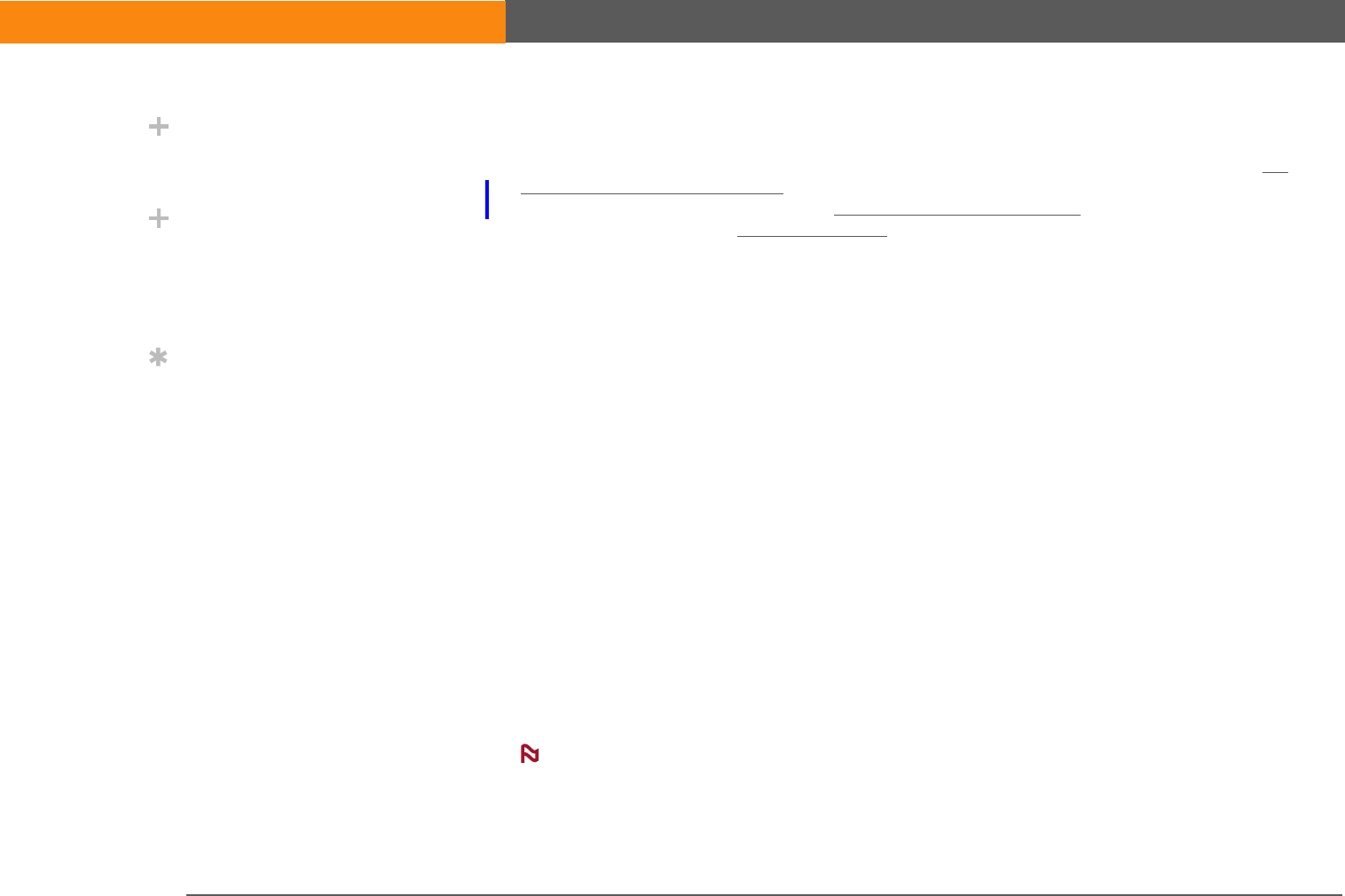
LifeDrive from palmOne 333
CHAPTER 18 Sending and Receiving Email Messages
About email accounts
The VersaMail application is software that lets you use your device to access email from an
account with an email provider (either an Internet service provider, or ISP, such as Earthlink or
Yahoo!, or a wireless carrier) or from your corporate email account. For each email account you
want to access, you must set up an account in VersaMail. For example, if you have an Earthlink
account and a corporate account, set up one account for each in VersaMail.
After you set up an account, you can send and receive email directly to and from your device
wirelessly. Or you can download new messages from your computer to your device—and upload
messages from your device to be sent from your computer’s email program—when you
synchronize.
You must have an account with an email provider or a corporate account.
VersaMail works with these accounts to transfer messages to and from your device. The
application is not an email service provider.
Using an email provider
If you are setting up a new email account and have a well-known email provider (ISP or wireless
carrier) such as Earthlink or Yahoo!, many of the settings you need during account setup are
automatically filled in.
For other ISPs, you need the following information:
• Your email address and password
• The protocol used for incoming mail, such as Post Office Protocol (POP) or Internet Message
Access Protocol (IMAP)
Some free web-based email providers such as Hotmail do not support either the POP or
the IMAP protocol. You cannot use VersaMail to download messages to your device from an
account with one of these providers.
• The name of the incoming mail server
Did You Know?
You can create up to eight
email accounts.
Did You Know?
The VersaMail application
provides strong 128-bit
AES encryption for your
password.
Tip
Go to your email
provider’s website or
contact their customer
support to obtain the
setup information you
need.
IMPORTANT
[!]
NOTE
SECOND DRAFT palmOne, Inc. Confidential
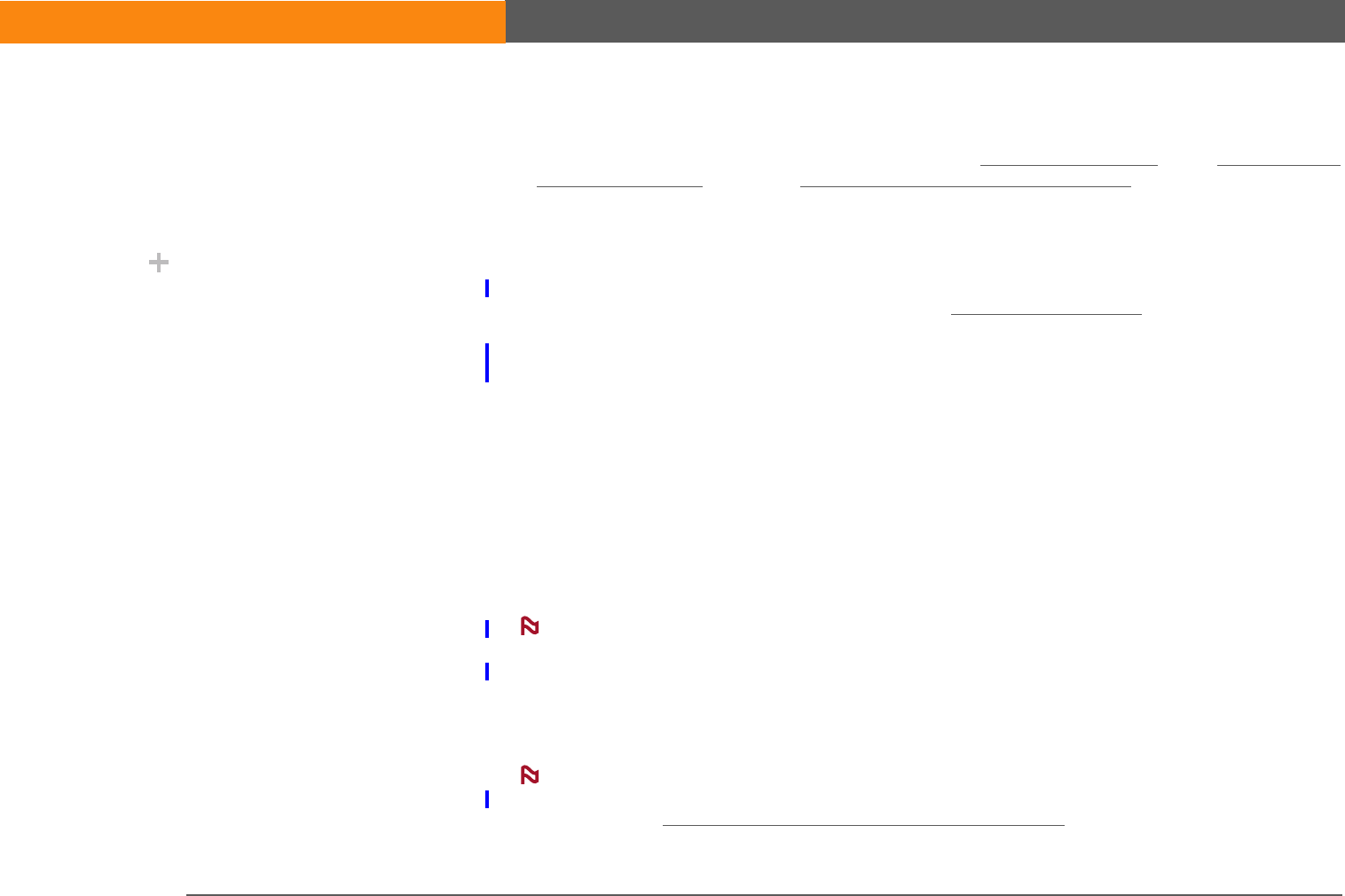
LifeDrive from palmOne 334
CHAPTER 18 Sending and Receiving Email Messages
• The name of the outgoing mail (Simple Mail Transfer Protocol, or SMTP) server
• Your account’s security feature (if it has one), such as Secure Sockets Layer (SSL), Authenticated
Post Office Protocol (APOP), or Extended Simple Mail Transfer Protocol (ESMTP)
Using a corporate email account
If you want to access email on your device using your corporate email account, you create this
account in exactly the same way that you would with any other account, with one exception: For a
corporate email account, you may need to set up a virtual private network (VPN).
If your company has a Wi-Fi® wireless technology network or a Bluetooth® wireless technology
access point located behind the corporate firewall, you may not need to set up a VPN to access
your corporate email account. See the next section for details.
To set up a corporate email account, you need certain information. Check with your company’s
server administrator to obtain the following:
Username and password This might be your Windows username and password, your Lotus
Notes ID username and password, or something else.
Protocol Most corporate mail servers use the IMAP protocol for retrieving mail. In rare cases,
your company server may use the POP protocol.
Some corporate mail servers do not use either protocol. In this case, you cannot send
and receive email wirelessly using VersaMail. You can, however, synchronize email on your device
with email in Outlook or Lotus Notes on your computer (Windows only).
Incoming and outgoing mail server settings Check with your company’s server administrator to
obtain these settings.
If your corporate mail system uses Microsoft Exchange Server 2003, you may be able to
set up an account that uses Microsoft Exchange ActiveSync® on your device. For more
information, see Working with Microsoft Exchange ActiveSync®.
»
Key Term
Firewall A system set up
to protect against
unauthorized access into
a private network.
Did You Know?
With a corporate email
account, you may be able
to access Microsoft
Exchange, IBM Lotus
Domino, or Sun iPlanet
mail servers, among
others.
NOTE
NOTE
SECOND DRAFT palmOne, Inc. Confidential

LifeDrive from palmOne 335
CHAPTER 18 Sending and Receiving Email Messages
VPNs
If you want to access email on your device using your corporate email account, you may need to
set up a virtual private network (VPN) on your device. A VPN enables you to log in to your
corporate mail server through the company’s firewall (security layer). Without a VPN, you cannot
pass through the firewall to gain access to the mail server.
You need to set up a VPN to access corporate email in either of the following situations:
• Your company’s wireless local area network (LAN) is located outside the firewall.
• Your company’s wireless LAN is located inside the firewall, but you are trying to access the
network from outside the firewall (for example, from a public location or at home).
Check with your company’s server administrator to see if a VPN is required for you to access the
corporate network.
Your device software installation CD contains a link to purchase and download VPN software for
the device. Once you purchase and download the software, you set up a VPN connection in
Preferences on your device. If you are using a VPN connection, make sure the connection is on in
VersaMail. In the message list, open the Options menu, and then select Turn VPN On.
The Auto Sync feature in VersaMail may not work with a VPN connection. Also, you
cannot use scheduled sending retry of email with accounts that use a VPN connection.
NOTE
SECOND DRAFT palmOne, Inc. Confidential
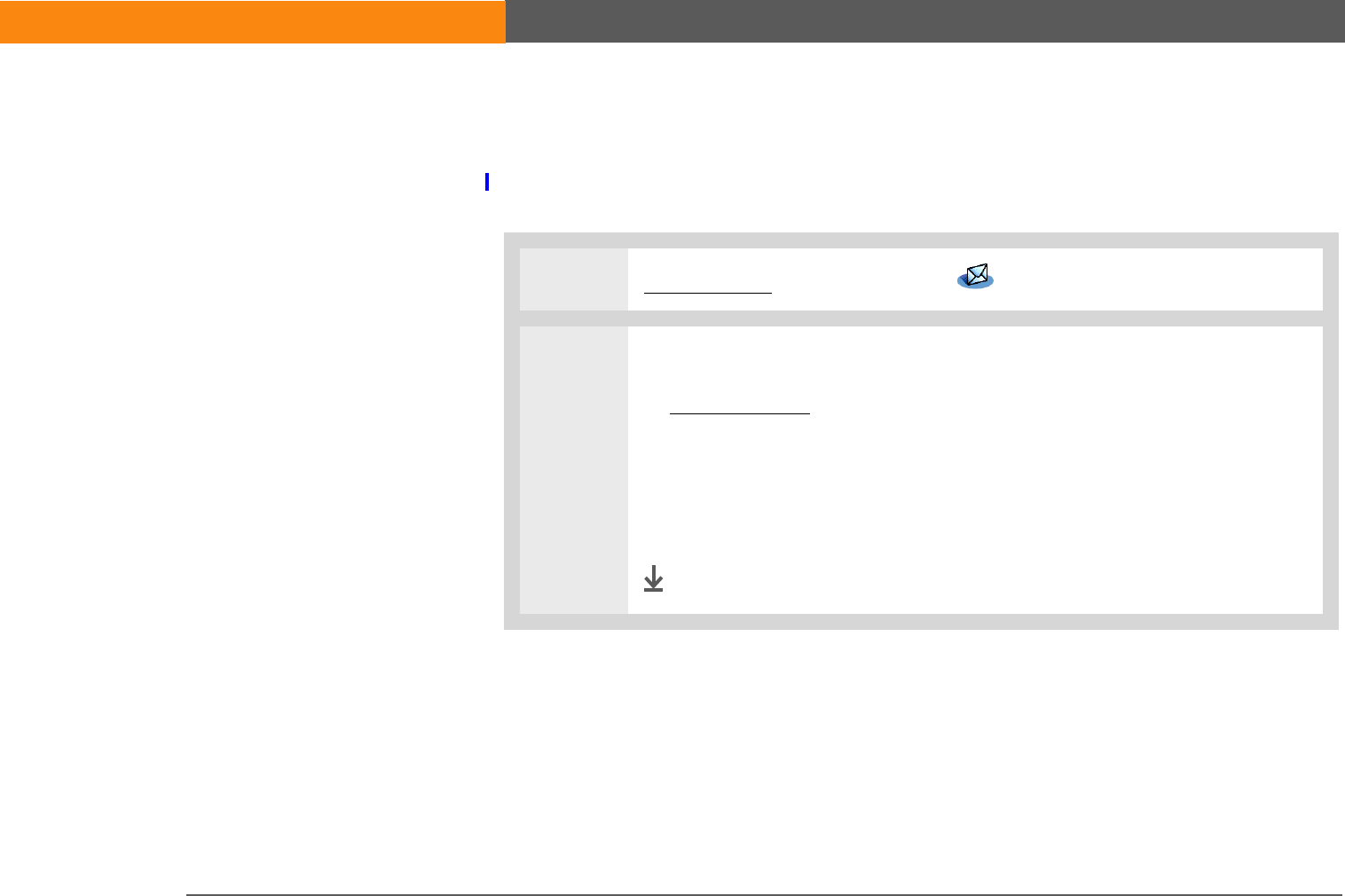
LifeDrive from palmOne 336
CHAPTER 18 Sending and Receiving Email Messages
Connecting to a VPN
After you set up a VPN, you need to connect to it in order to retrieve email messages from your
corporate mail server. You may need to connect to the VPN each time you open VersaMail to
retrieve messages from the server.
0
1Go to Favorites and select VersaMail .
2Connect to your VPN:
a. Open the menus.
b. Select Options, and then select Connect VPN.
c. Enter the username and password you use to log in to the VPN.
d. Select OK.
Done
SECOND DRAFT palmOne, Inc. Confidential

LifeDrive from palmOne 337
CHAPTER 18 Sending and Receiving Email Messages
Creating an account
Before you can use the VersaMail application with a given email account, you need to set up the
account in VersaMail. If you have multiple email accounts, you must set up a VersaMail account
for each one. You have three setup options:
• On a Windows computer, if the email account is already set up on your computer—for example,
if you use Outlook Express on your computer to access your Earthlink account—you can transfer
the account settings to your device in just a few steps.
• On a Windows computer, if this is a new account, you can quickly set up the account on your
computer and synchronize the information to your device. The steps for setting up an account
on your computer depend on whether you are using a common email provider such as Earthlink
or Yahoo! or whether you are using a less common provider.
• For either a new or an existing account, you can set up the account directly on your device.
If you are setting up a Microsoft Exchange ActiveSync® account to synchronize email and Calendar
information with info in Microsoft Exchange Server 2003, see Working with Microsoft Exchange
ActiveSync® for setup instructions.
You can open VersaMail account setup in one of two ways:
• During software CD installation, select the option to set up your email software on the final
installation screen.
• From the Start menu, select Programs, navigate to the palmOne program group, and then select
VersaMail Setup.
If you plan to synchronize your new device using an existing username from
another device, you must do so before you enter your email account information in VersaMail. If
you enter the email account information first and then synchronize your device with your
computer using an existing username, the email account information you entered is overwritten.
IMPORTANT
[!]
SECOND DRAFT palmOne, Inc. Confidential
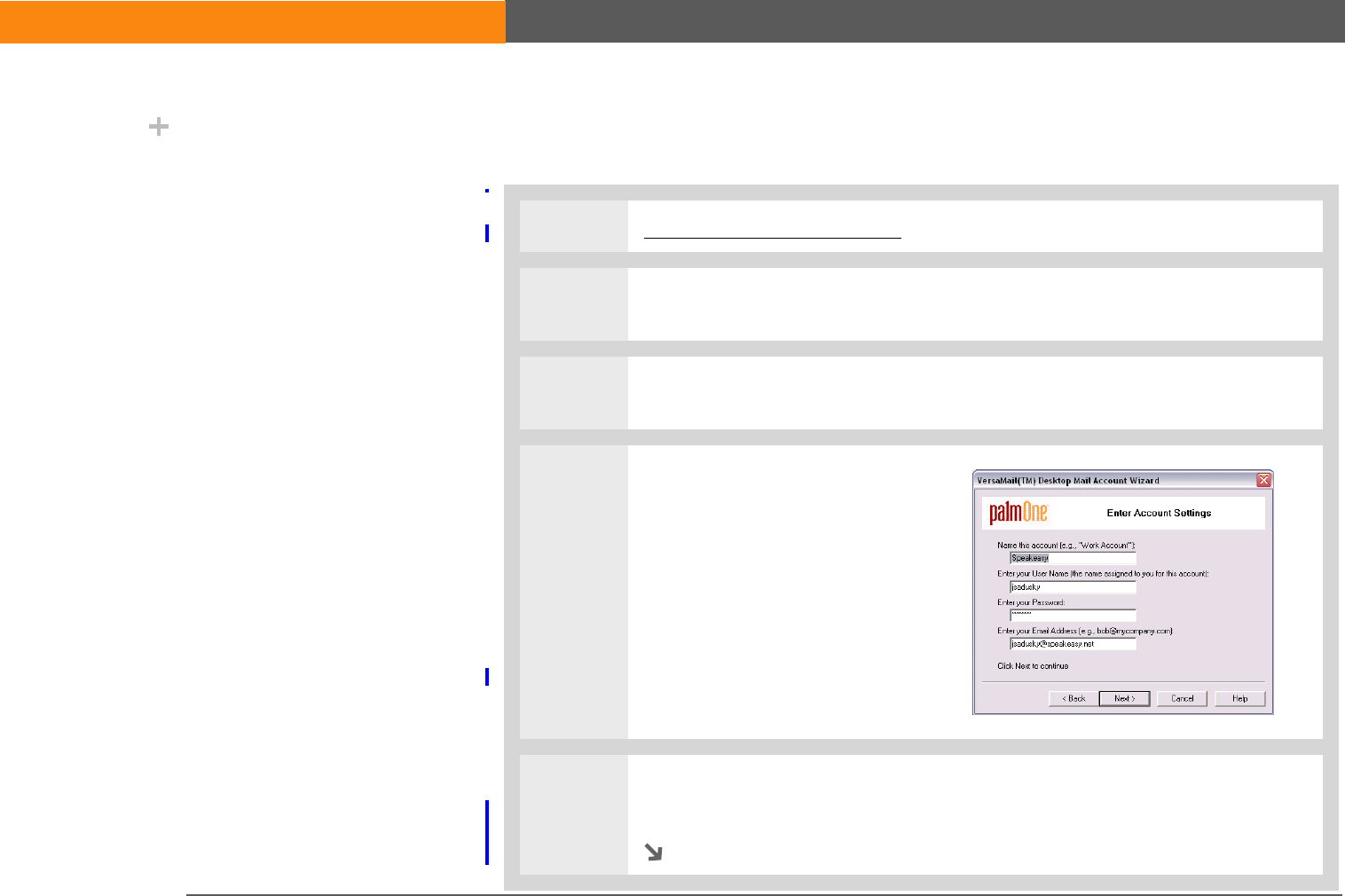
LifeDrive from palmOne 338
CHAPTER 18 Sending and Receiving Email Messages
Transferring settings from an existing account
WINDOWS ONLY
0
1Open VersaMail account setup.
2Select your username from the drop-down list at the top of the screen, and then
select the option to create a new VersaMail email account. Click Next.
3Select the option to synchronize with an email account detected on your PC,
and then select the account from the list. Click Next.
4Enter the basic account
information:
a. In the Name this account field,
enter a descriptive name or
use the one shown.
b. In the Enter your Password
field, enter your email
account password.
c. Click Next.
5Click Next on the mail servers screen. This information is already filled in based
on the account whose settings you are transferring to your device.
Continued
Did You Know?
Your username and email
address are already
entered on the Account
Settings screen based on
the account settings that
VersaMail finds on your
computer.
SECOND DRAFT palmOne, Inc. Confidential
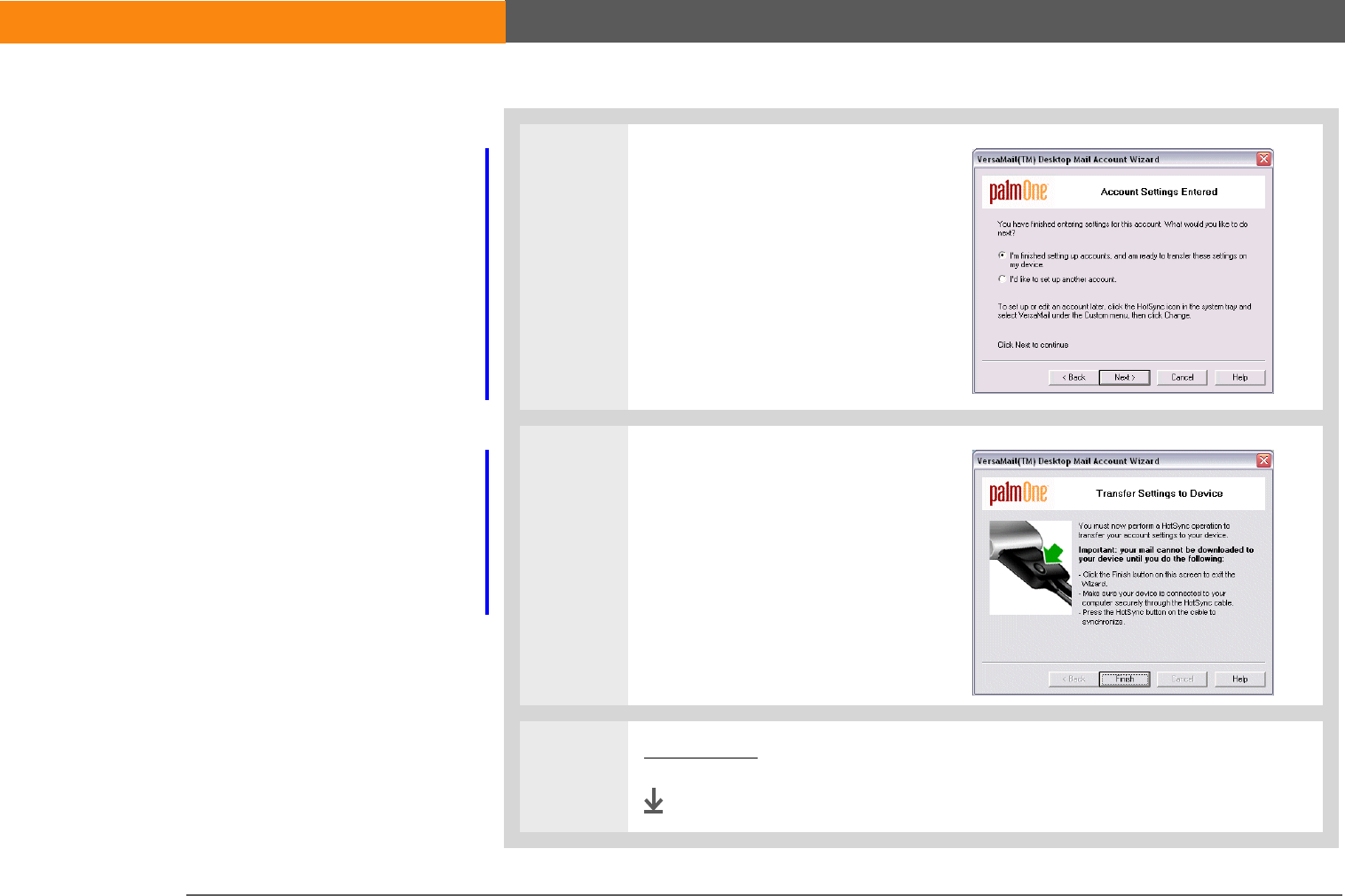
LifeDrive from palmOne 339
CHAPTER 18 Sending and Receiving Email Messages
6[ & ] OPTIONAL Set up other
accounts:
a. Select the option to set up
another account, and then
click Next.
b. Repeat steps 2 through 5 for
each account you want to set
up. When you have set up the
last account, go to the next
step.
7Finish setting up accounts:
a. Select the option to
synchronize information for
this account, and then click
Next.
b. Click Finish.
8Do a full sync to transfer all account information to your device.
Done
SECOND DRAFT palmOne, Inc. Confidential
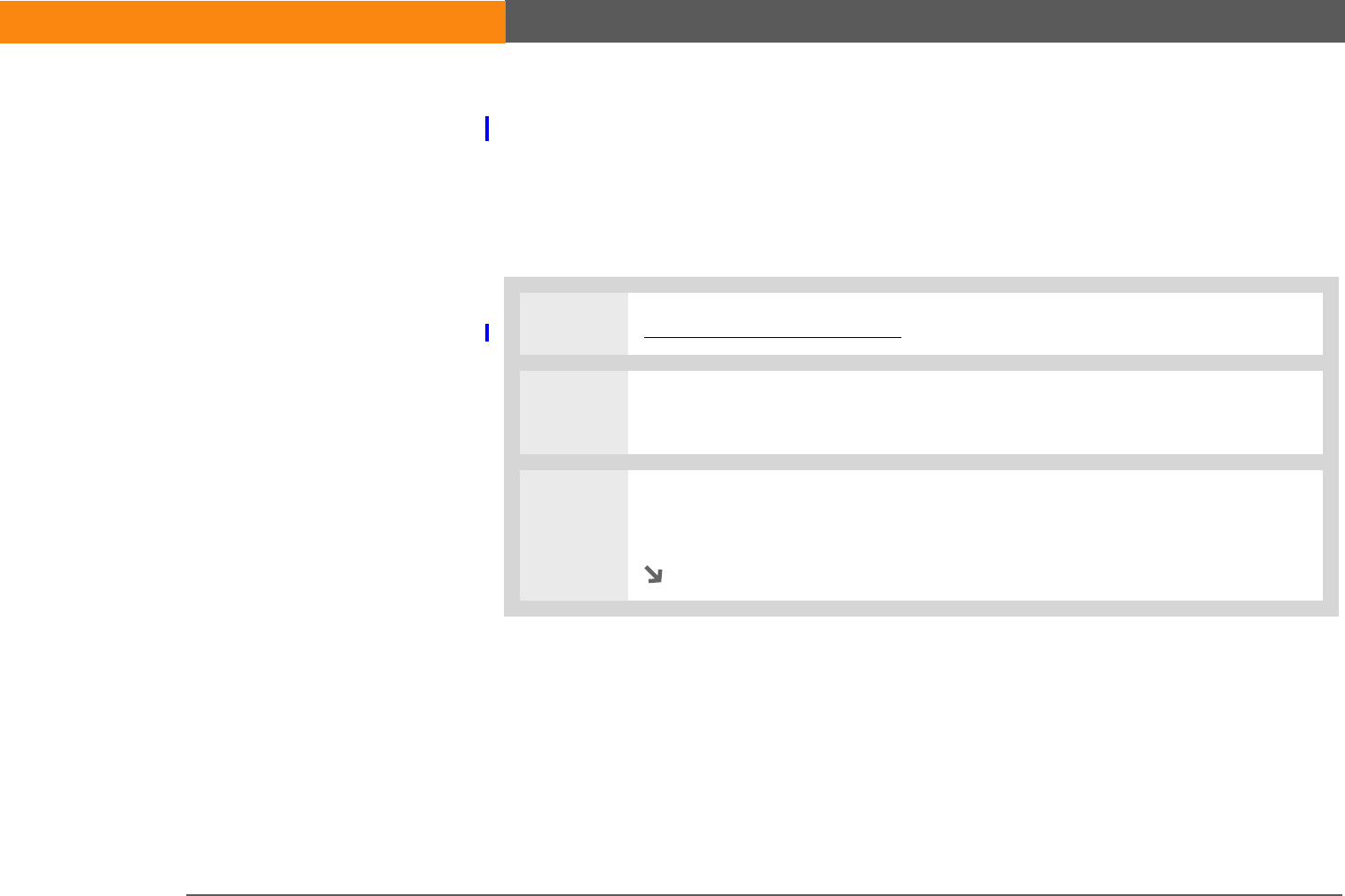
LifeDrive from palmOne 340
CHAPTER 18 Sending and Receiving Email Messages
Setting up an account on your computer: Common providers
WINDOWS ONLY
The settings for many common providers are already included in VersaMail. If you have an
account with one of these providers, you just need to enter your username and password during
account setup.
0
0
1Open VersaMail account setup.
2Select your username from the drop-down list at the top of the screen, and then
select the option to create a new VersaMail email account. Click Next.
3Select the option to synchronize with a mail service from this list, and then
select your mail service from the list. Click Next.
Continued
SECOND DRAFT palmOne, Inc. Confidential
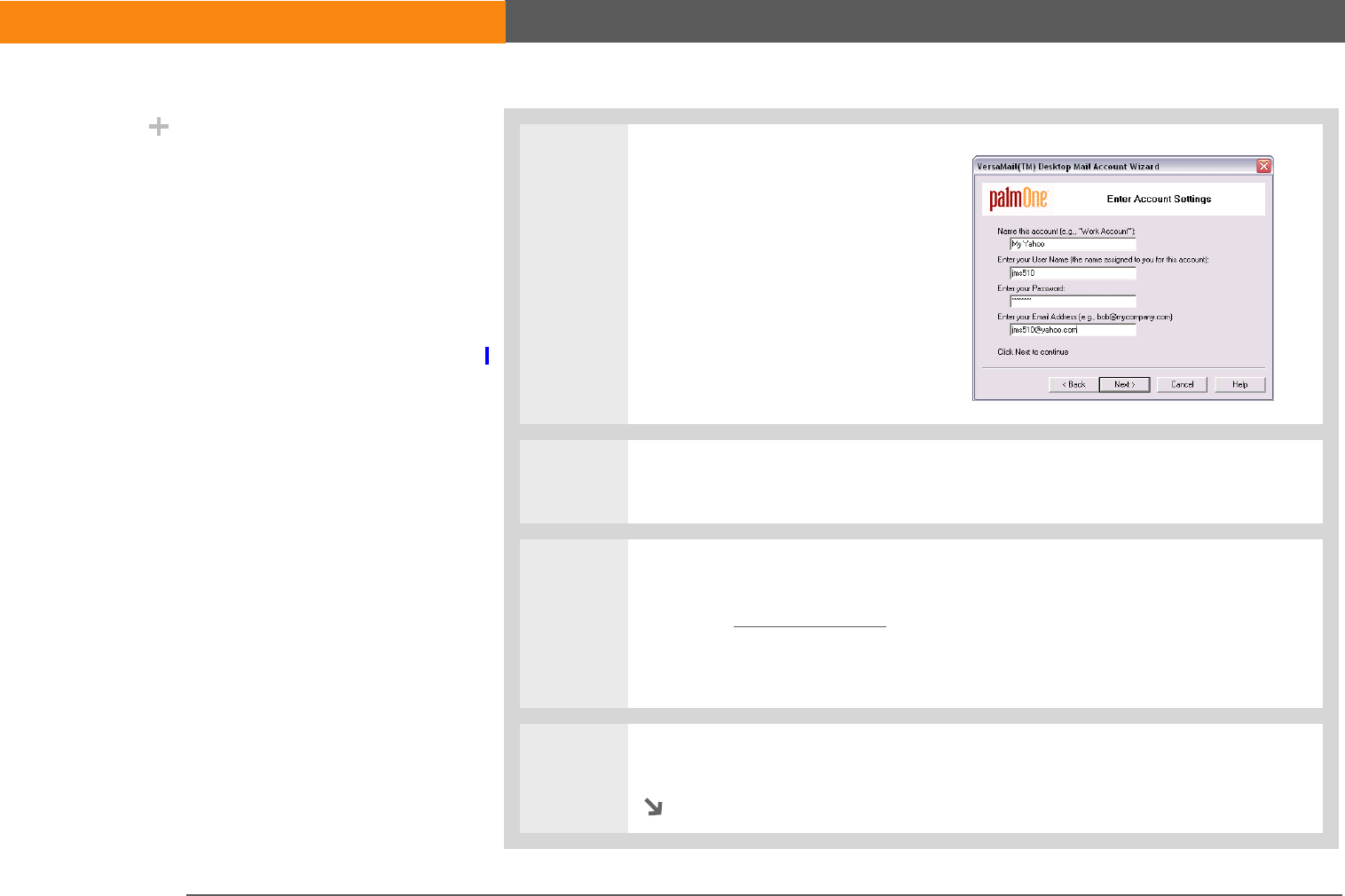
LifeDrive from palmOne 341
CHAPTER 18 Sending and Receiving Email Messages
4Enter the basic account
information:
a. Enter a descriptive name for
the account or use the one
shown.
b. Enter your account username
and password. Your email
address is entered
automatically based on the
username you enter.
5Click Next on the mail servers screen. This information is already filled in based
on the mail service you selected.
6[ & ] OPTIONAL Do one of the following:
•To enter advanced settings for this account, click Advanced Settings.
• To test the account settings you have entered, click Test My Settings. Click OK
after settings have been tested.
7Click Next.
Continued
Did You Know?
Your incoming and
outgoing server settings
and whether the account
needs ESMTP
authentication are
already entered based on
the account type you
select.
SECOND DRAFT palmOne, Inc. Confidential
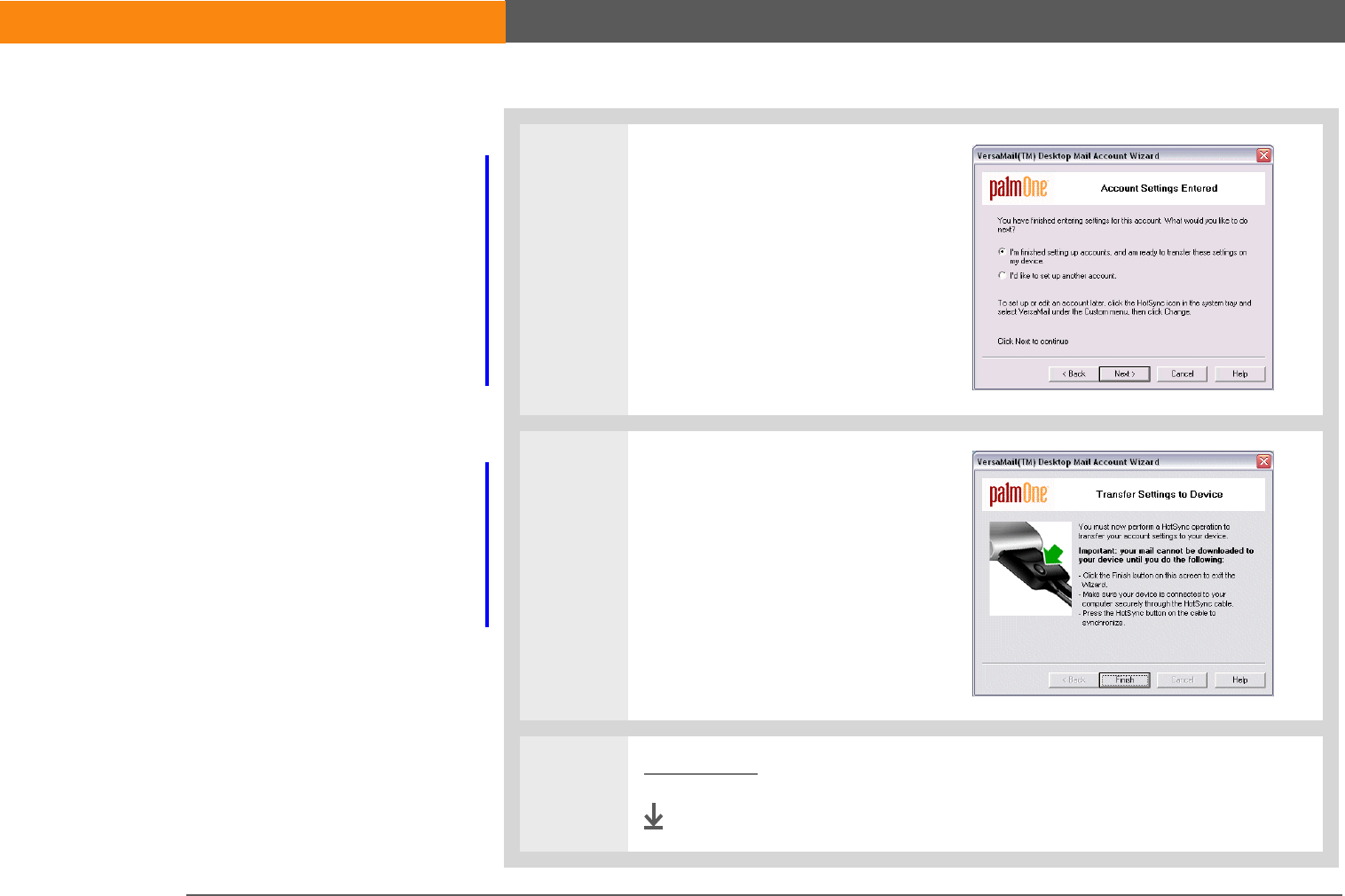
LifeDrive from palmOne 342
CHAPTER 18 Sending and Receiving Email Messages
8[ & ] OPTIONAL Set up other
accounts:
a. Select the option to set up
another account, and then
click Next.
b. Repeat steps 2 through 5 for
each account you want to set
up. When you have set up the
last account, go to step 9.
9Finish setting up accounts:
a. Select the option to
synchronize information for
this account, and then click
Next.
b. Click Finish.
10 Do a full sync to transfer all account information to your device.
Done
SECOND DRAFT palmOne, Inc. Confidential
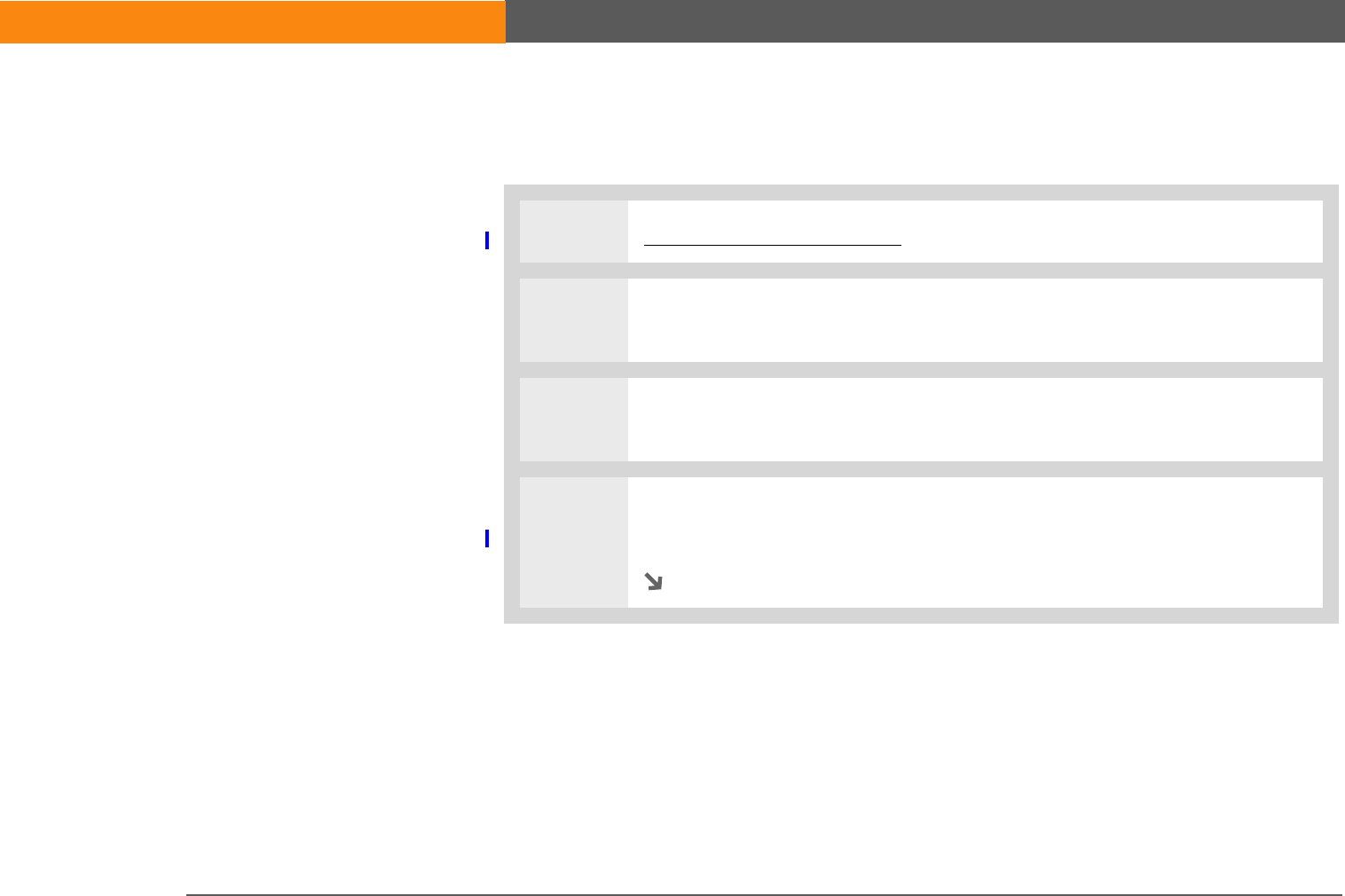
LifeDrive from palmOne 343
CHAPTER 18 Sending and Receiving Email Messages
Setting up an account on your computer: Other providers
WINDOWS ONLY
0
1Open VersaMail account setup.
2Select your username from the drop-down list at the top of the screen, and then
select the option to create a new VersaMail email account. Click Next.
3Select the option to synchronize with a mail service from this list, and then
select Other. Click Next.
4Select the protocol for this account. Check with your system administrator if
you do not know which protocol is used.
Continued
»
Key Term
Protocol Settings your
email provider uses to
receive email messages.
Most providers use the
Post Office Protocol
(POP); a few use the
Internet Message Access
Protocol (IMAP).
SECOND DRAFT palmOne, Inc. Confidential
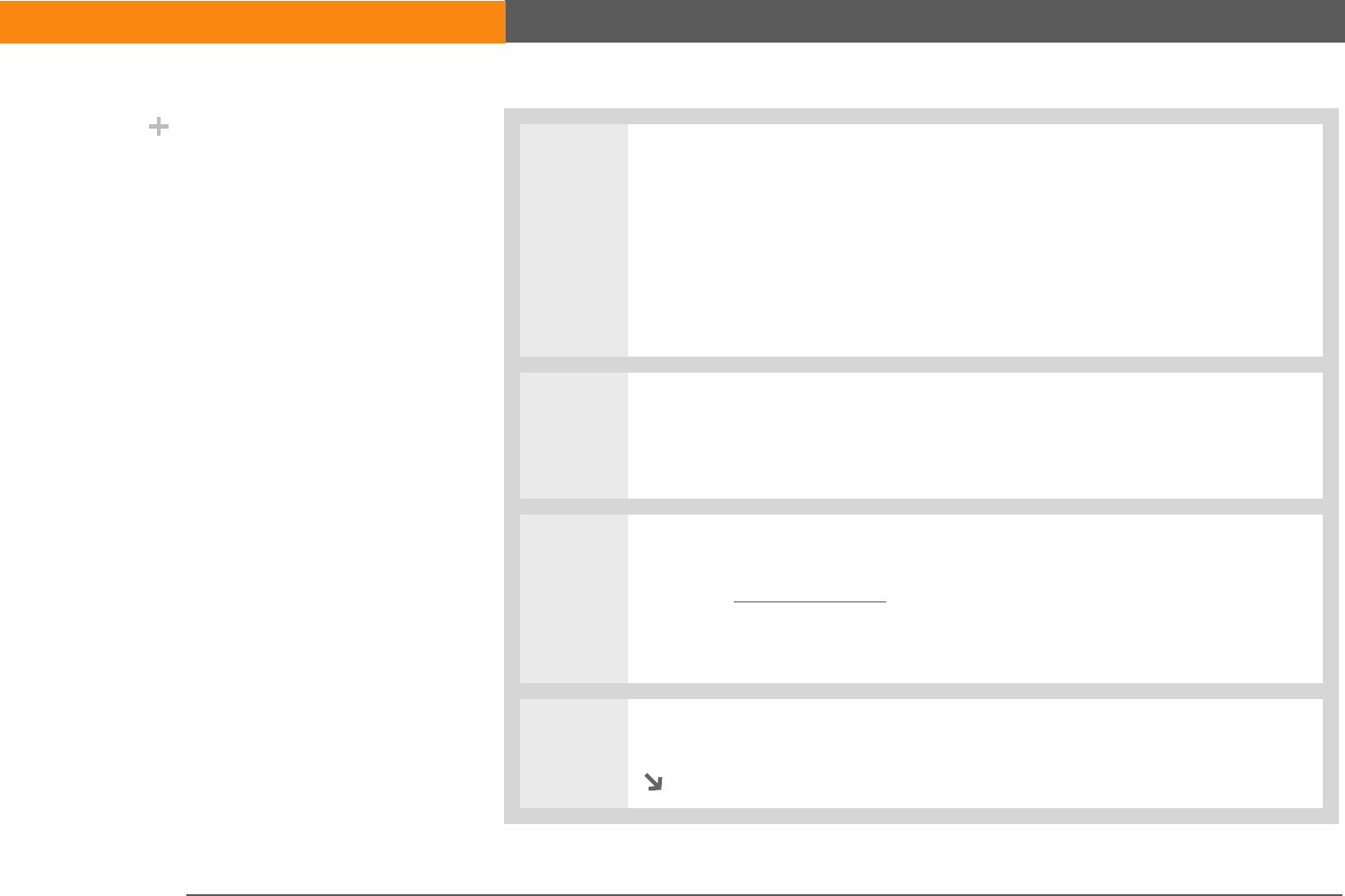
LifeDrive from palmOne 344
CHAPTER 18 Sending and Receiving Email Messages
5Enter the basic account information:
a. Enter a descriptive name for the account.
b. Enter your account username and password.
c. Enter your email address for this account.
d. Click Next.
6Enter the names of the incoming and outgoing mail servers for this account,
whether the account requires Extended Simple Mail Transfer Protocol (ESMTP),
and, if so, the username and password required for ESMTP. Check with your
email service provider for this information.
7[ & ] OPTIONAL Do one of the following:
•To enter advanced settings for this account, click Advanced Settings.
• To test the account settings you have entered, click Test My Settings. Click OK
after settings have been tested.
8Click Next.
Continued
Did You Know?
Your incoming mail
server is also called your
POP or IMAP server; your
outgoing mail server is
also called your SMTP
server.
SECOND DRAFT palmOne, Inc. Confidential
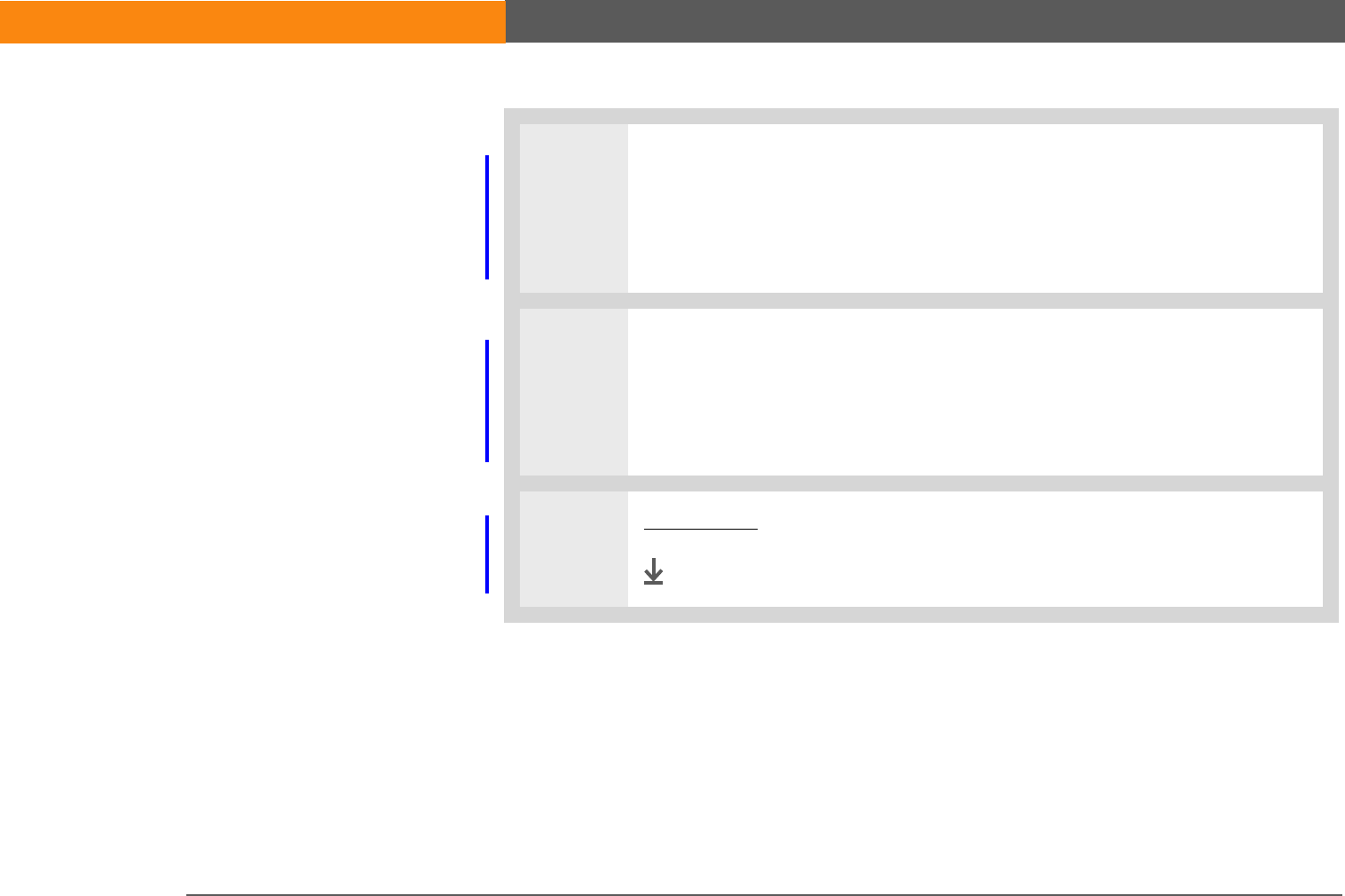
LifeDrive from palmOne 345
CHAPTER 18 Sending and Receiving Email Messages
9[ & ] OPTIONAL Set up other accounts:
a. Select the option to set up another account, and then click Next.
b. Repeat steps 2 through 5 for each account you want to set up. When you
have set up the last account, go to step 10.
10 Finish setting up accounts:
a. Select the option to synchronize information for this account, and then click
Next.
b. Click Finish.
11 Do a full sync to transfer all account information to your device.
Done
SECOND DRAFT palmOne, Inc. Confidential
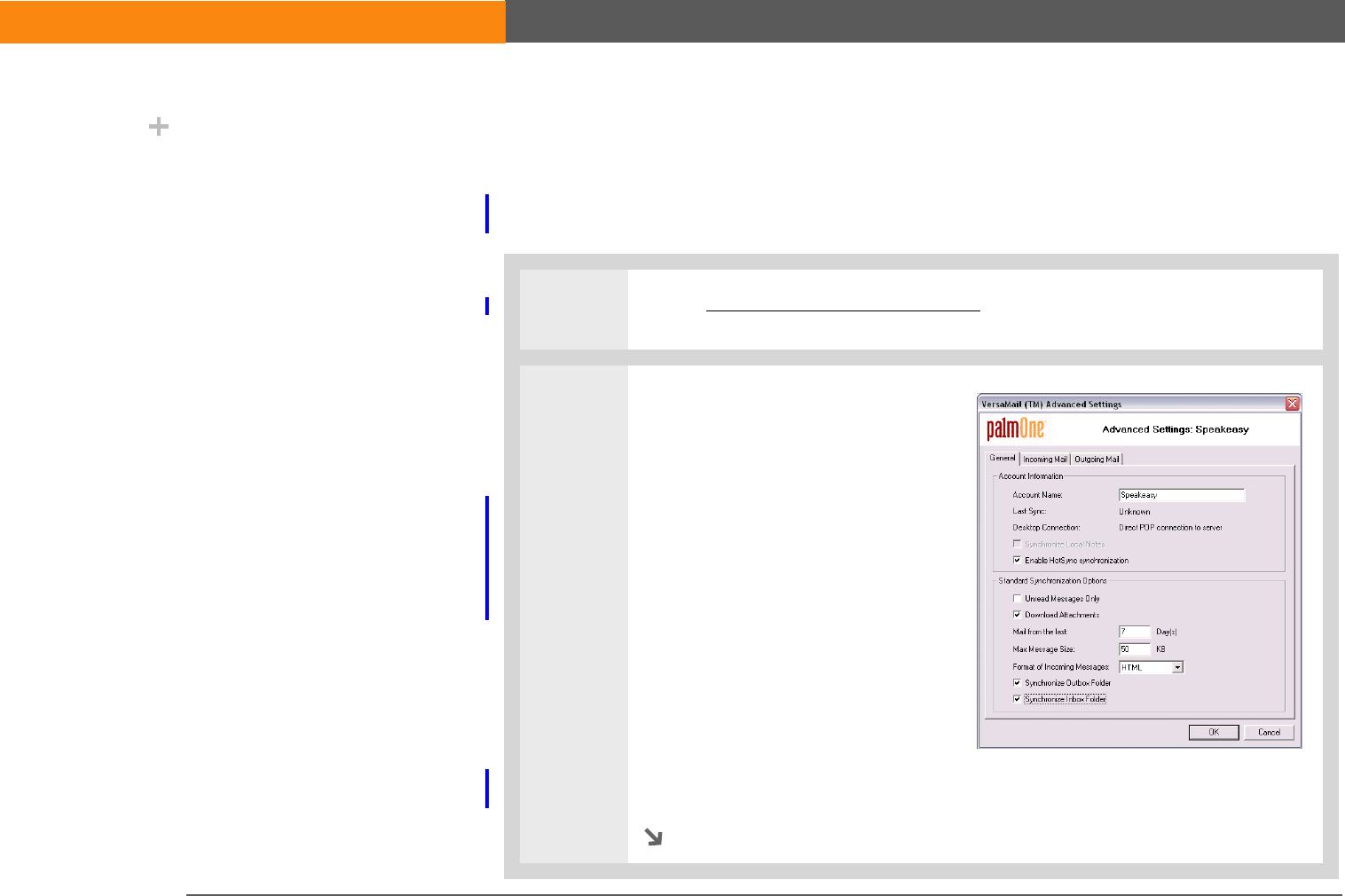
LifeDrive from palmOne 346
CHAPTER 18 Sending and Receiving Email Messages
Entering advanced account settings on your computer
When you set up an account, VersaMail automatically enters advanced settings such as incoming
and outgoing server names, any authentication required, maximum message size, and so on. You
can check the advanced settings either to verify that VersaMail entered the information you want
or to change a default entry—for example, to change the maximum message size.
0
1During account setup on your computer, click Advanced Settings on the
Account Information screen.
2Click the General tab and verify
or edit any of the following settings:
Synchronize Local Notes (Lotus
Notes accounts only) Check the box
to synchronize email on your device
with email in the local copy of Notes
on your computer. You are prompted
to enter your Lotus Notes ID and
password. Click Browse if you need
to locate your Notes ID.
Enable HotSync synchronization
By default, this box is checked,
meaning you can both send and
receive email wirelessly and
transfer messages to your device
from your computer when you
synchronize. If you uncheck the box, you can send and receive email
wirelessly only.
Continued
Did You Know?
The Desktop Connection
field displays the mail
client you use to
download messages to
your computer—for
example, Microsoft
Outlook or Lotus Notes—
based on the settings
VersaMail detects. If no
client is detected,
VersaMail displays Direct
POP or Direct IMAP
connection to server,
depending on your
account protocol.
SECOND DRAFT palmOne, Inc. Confidential
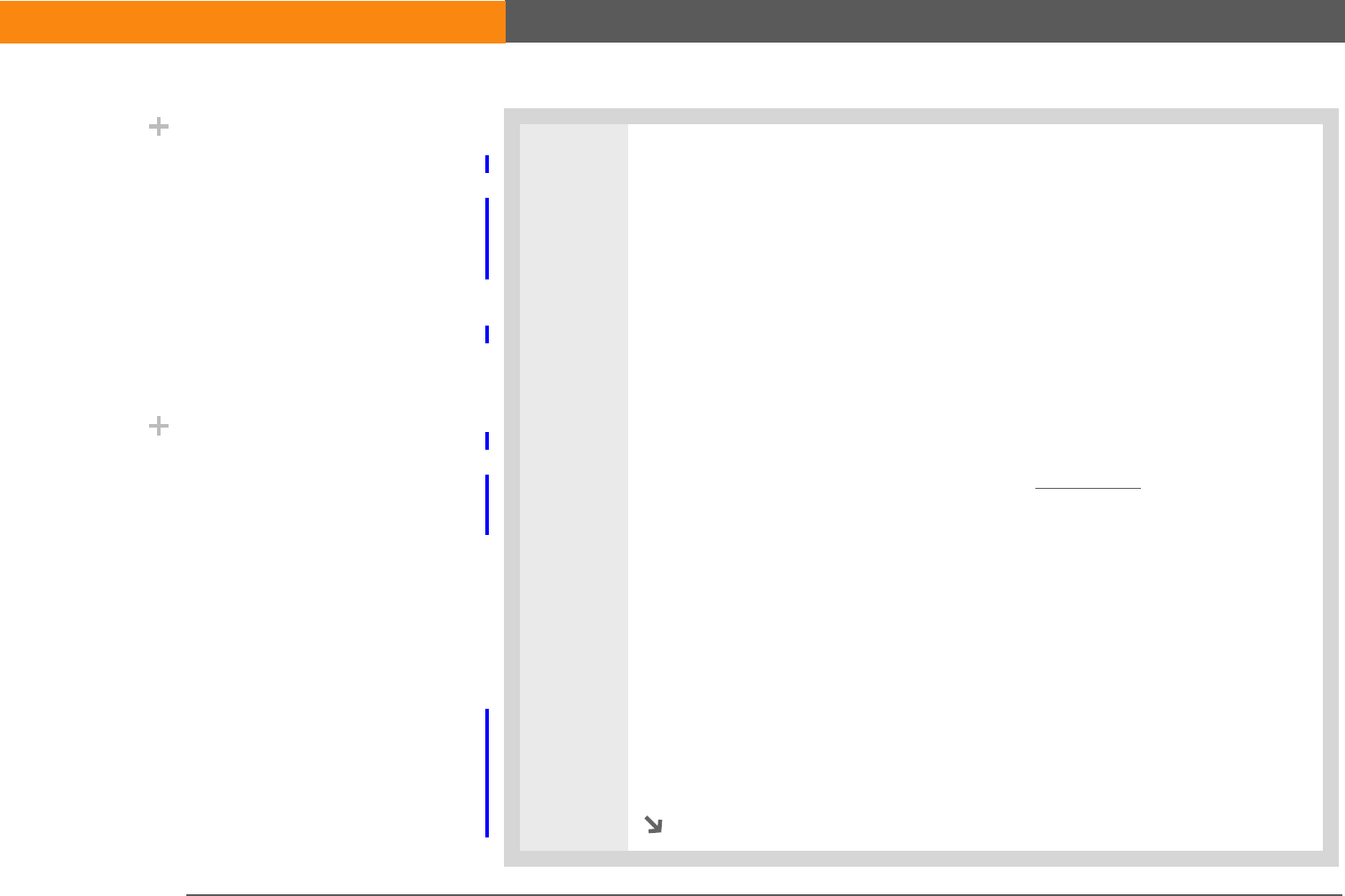
LifeDrive from palmOne 347
CHAPTER 18 Sending and Receiving Email Messages
Cont’d
Unread Messages Only For IMAP accounts only, select whether to download
all messages to your device, or unread messages only. By default, the box is
unchecked, meaning that all messages are downloaded. For POP accounts, this
box does not appear on the screen.
Download Attachments Select whether to download attachments when you
retrieve new messages. By default, the box is checked; if you uncheck it, only
the body text of any message containing an attachment is downloaded to your
device.
Mail from the last X Days Set how many days’ worth of email should be
downloaded.
Max Message Size (KB) Enter the maximum message size that can be
downloaded to your device—from 1 to 5000KB. The smaller the maximum size,
the faster the download, but you must use the More button to download any
messages over that size. On the other hand, choosing a larger size means that
more messages can be completely downloaded automatically, but
downloading takes longer.
Format of Incoming Messages Select HTML or Plain Text. If you select HTML,
any email messages sent as HTML are displayed on your device with basic
HTML formatting intact. If you select plain text, all messages are received as
plain text only, regardless of the format in which they were sent. The default is
HTML.
Synchronize Outbox Folder Check the box to synchronize messages in your
device’s Outbox with messages on your computer during the next
synchronization. If the box is unchecked, your Outbox is not included when you
synchronize, so messages in your device’s Outbox are not sent.
Continued
Did You Know?
The POP protocol does
not support retrieval of
unread mail only from the
server. If you have a POP
email account, VersaMail
downloads all messages
from the server
regardless of whether
you have read them (for
example, on your desktop
or on the web).
Did You Know?
The actual message size
you can download may
be smaller than 5000KB,
because some message
space is necessary for
transferring the message
over the Internet.
SECOND DRAFT palmOne, Inc. Confidential
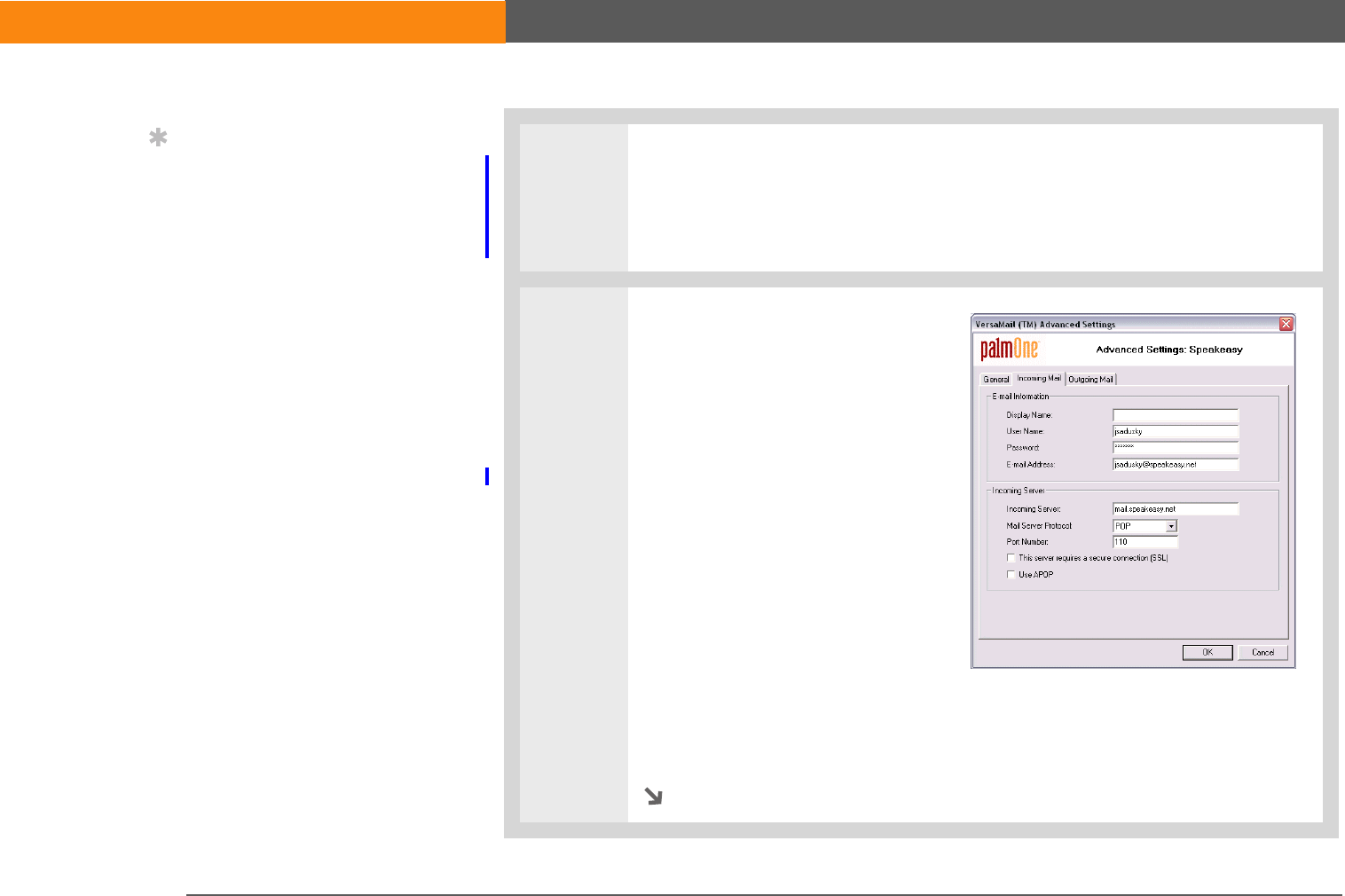
LifeDrive from palmOne 348
CHAPTER 18 Sending and Receiving Email Messages
Cont’d
Synchronize Inbox Folder Check the box to synchronize messages in your
device’s Inbox with messages on your computer during the next
synchronization. The box is checked by default; if unchecked, your Inbox is not
included when you synchronize, so new messages in your computer’s Inbox are
not downloaded to your device.
3Click the Incoming Mail tab and
verify or edit any of the following
settings:
Display Name Enter the name you
want to appear on email messages.
User Name Enter the username
you use to access email for this
account.
Password Enter your email
account password.
E-mail Enter the email address for
this account.
Incoming Server Enter the
address of your incoming mail server.
Mail Server Protocol Select the protocol for this account.
Continued
Tip
Check with your email
provider or your system
administrator for any
incoming or outgoing
mail settings you do not
know. Also check to see if
your account uses SSL,
APOP, or ESMTP; or
whether you need to
change the default port
number.
SECOND DRAFT palmOne, Inc. Confidential
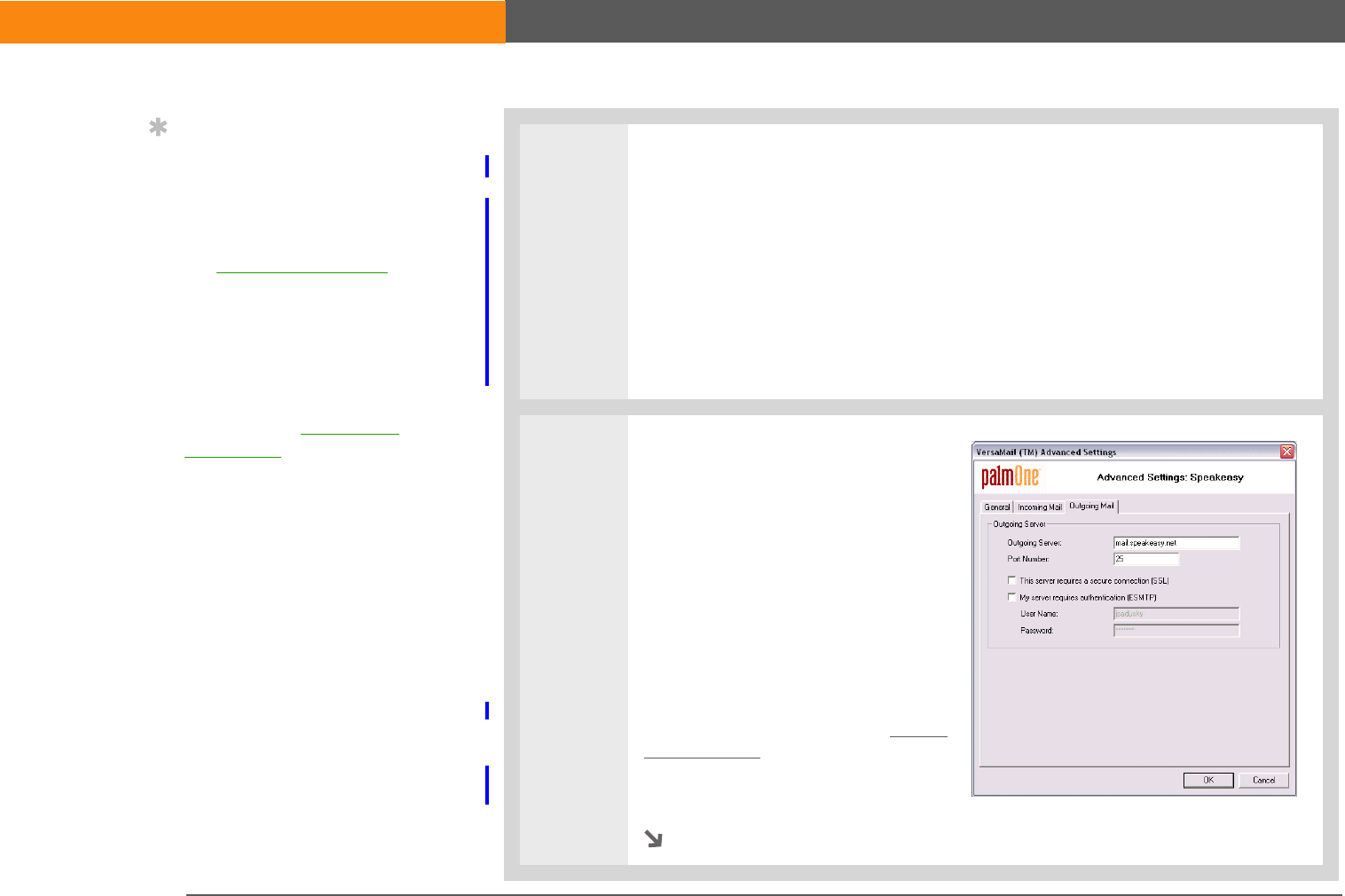
LifeDrive from palmOne 349
CHAPTER 18 Sending and Receiving Email Messages
Cont’d
Port Number By default, the port number setting is 110 for POP and 143 for
IMAP servers. You may need to change the port number if you choose to
retrieve incoming mail over a secure connection (see the next item).
Secure connection To retrieve incoming mail over a secure (Secure Sockets
Layer, or SSL) connection, check the box. The port number for incoming mail
then changes to 995.
APOP (POP accounts only) To encrypt your username and password when
they travel over the network, check this box. Some services work properly only
if APOP is used, while others do not work properly if APOP is used.
4Click the Outgoing Mail tab and
verify or edit any of the following
settings:
Outgoing Server Enter the
address of your outgoing mail
server.
Port Number The default is 25,
the port number most SMTP
servers use.
Secure connection To se nd
outgoing mail over a secure (Secure
Sockets Layer, or SSL) connection,
check the box. This server requires
a secure connection (SSL).
Continued
Tip
Do not check the Secure
connection box if
VersaMail displays Direct
POP or Direct IMAP
connection to server in
the Desktop Connection
field. If you check the box,
you cannot receive
incoming messages
correctly. To use SSL with
your account, set up the
account on your device
and check the Use Secure
Connection box on the
appropriate screen.
SECOND DRAFT palmOne, Inc. Confidential
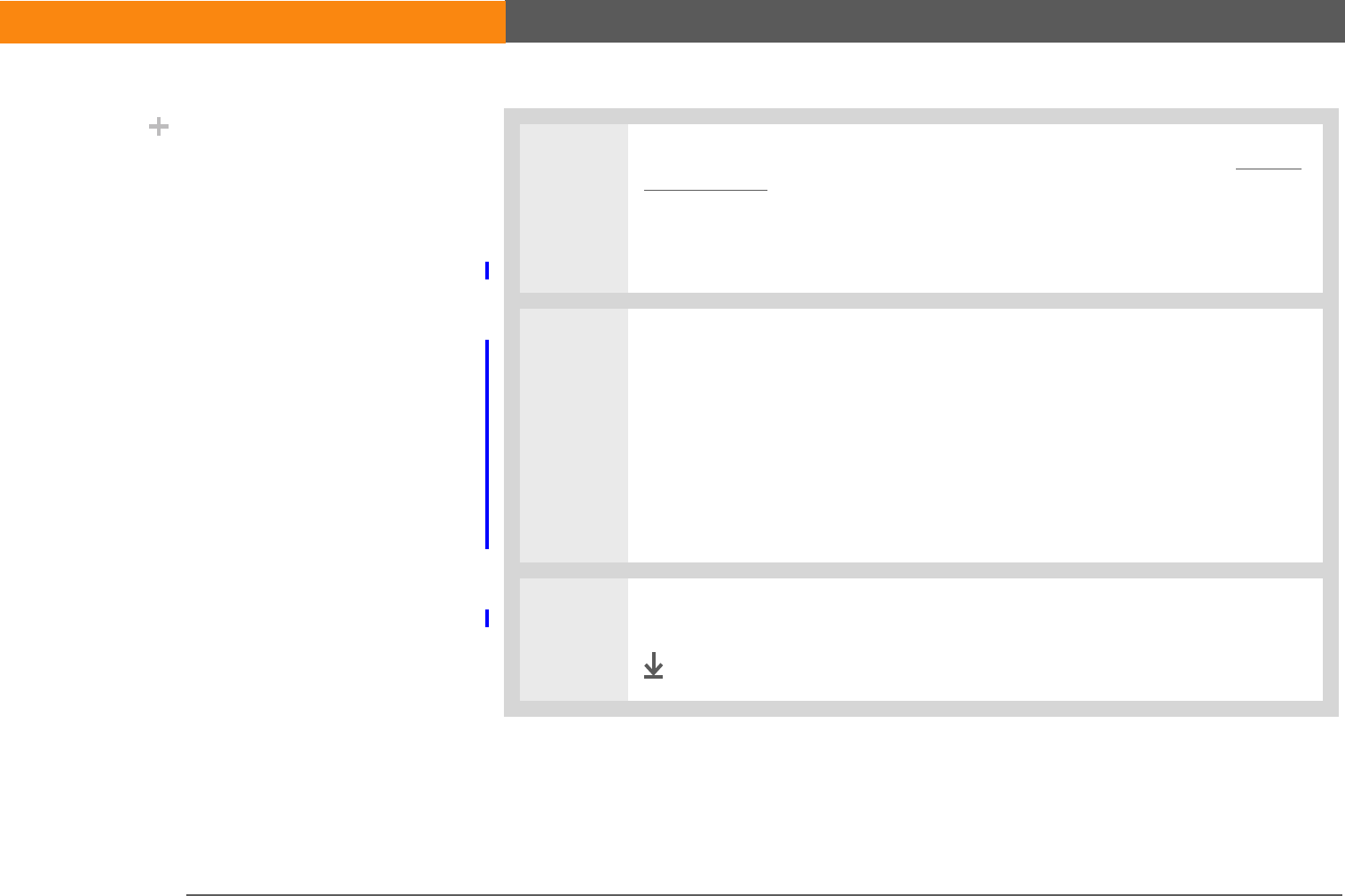
LifeDrive from palmOne 350
CHAPTER 18 Sending and Receiving Email Messages
Cont’d
Authentication Check the box if the outgoing server (SMTP) requires ESMTP
authentication. If you select this option, username and password fields appear.
These fields are already filled in based on the account information you entered.
In most cases, the information displayed is correct; however, occasionally your
authentication username and/or password is different from your account
username or password.
5(IMAP accounts only) Click the Folders tab and verify or edit any of the following
settings:
Sent Folder Shows the name of your Sent Mail folder on the server.
Tr a s h F o l d e r Stores deleted email in the folder you specify on the server.
Server Folder Synchronization To synchronize messages on your device with
messages on a server folder, click in the Synchronize column to the right of the
folder name to select Yes.
6When you have finished entering or verifying advanced settings, click OK.
Done
Did You Know?
If you synchronize a
folder, any changes you
make to a folder on your
device—for example,
moving or deleting
messages—are
automatically updated on
the mail server, and vice
versa.
SECOND DRAFT palmOne, Inc. Confidential
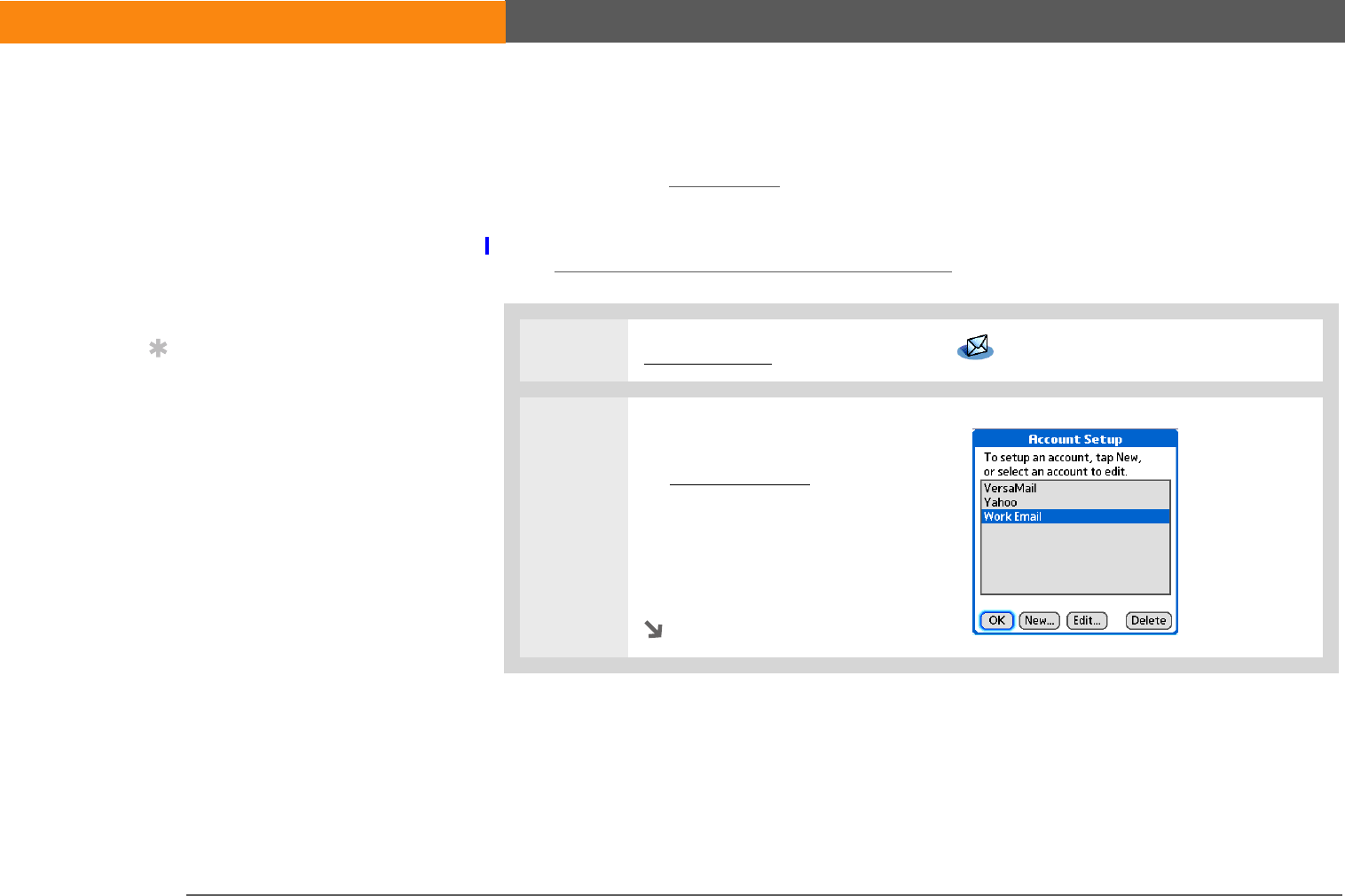
LifeDrive from palmOne 351
CHAPTER 18 Sending and Receiving Email Messages
Setting up an account on your device
If you have already set up an account on your computer, you don’t need to set up the account on
your device. Just do a full sync to transfer the account settings to your device.
If you are setting up a Microsoft Exchange ActiveSync account on your device to synchronize
email and Calendar information on your device with the info in Microsoft Exchange Server 2003,
see Working with Microsoft Exchange ActiveSync® for setup instructions.
0
0
1Go to Favorites and select VersaMail .
2Open the Account Setup screen:
a. Open the menus.
b. Select Accounts, and then
select Account Setup.
c. Select New.
Continued
»
Key Term
Protocol Settings your
email provider uses to
receive email messages.
Most providers use the
Post Office Protocol
(POP); a few use the
Internet Message Access
Protocol (IMAP).
Tip
If your email provider
appears on the Mail
Service pick list, you don’t
need to select a protocol.
The correct protocol is
automatically displayed.
SECOND DRAFT palmOne, Inc. Confidential
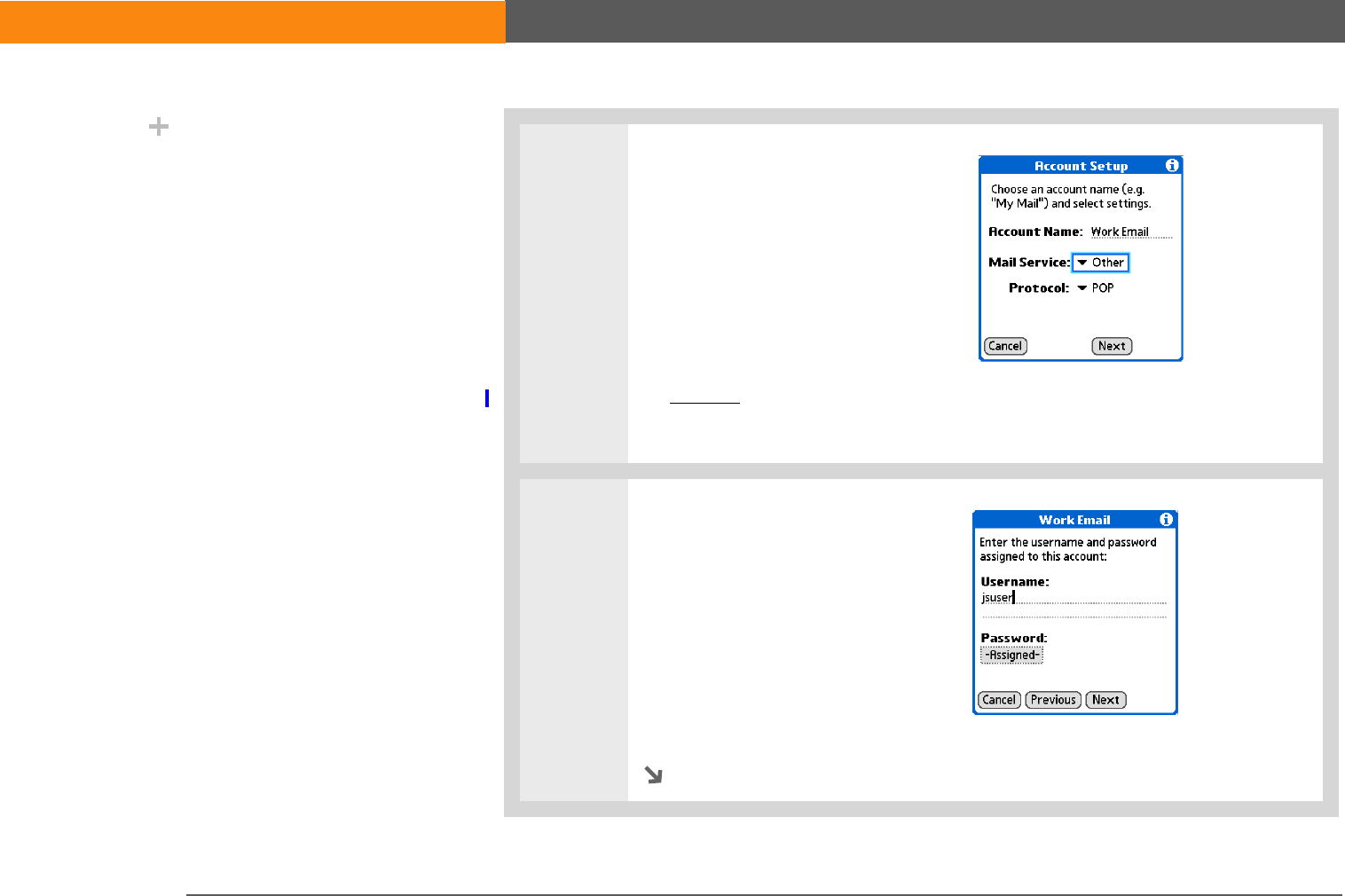
LifeDrive from palmOne 352
CHAPTER 18 Sending and Receiving Email Messages
3Enter the basic account information:
a. In the Account Name field, enter
a descriptive name.
b. Select the Mail Service pick list,
and then select your email
provider. Select Other if your
provider is not listed.
c. If you chose Other, select the
Protocol pick list, and then select POP or IMAP.
d. Select Next.
4Enter the account username and
password:
a. Enter the username you use
to access your email.
b. Select the Password box,
enter your email account
password, and then select OK.
c. Select Next.
Continued
Did You Know?
Your incoming mail
server is also called your
POP or IMAP server; your
outgoing mail server is
also called your SMTP
server.
SECOND DRAFT palmOne, Inc. Confidential
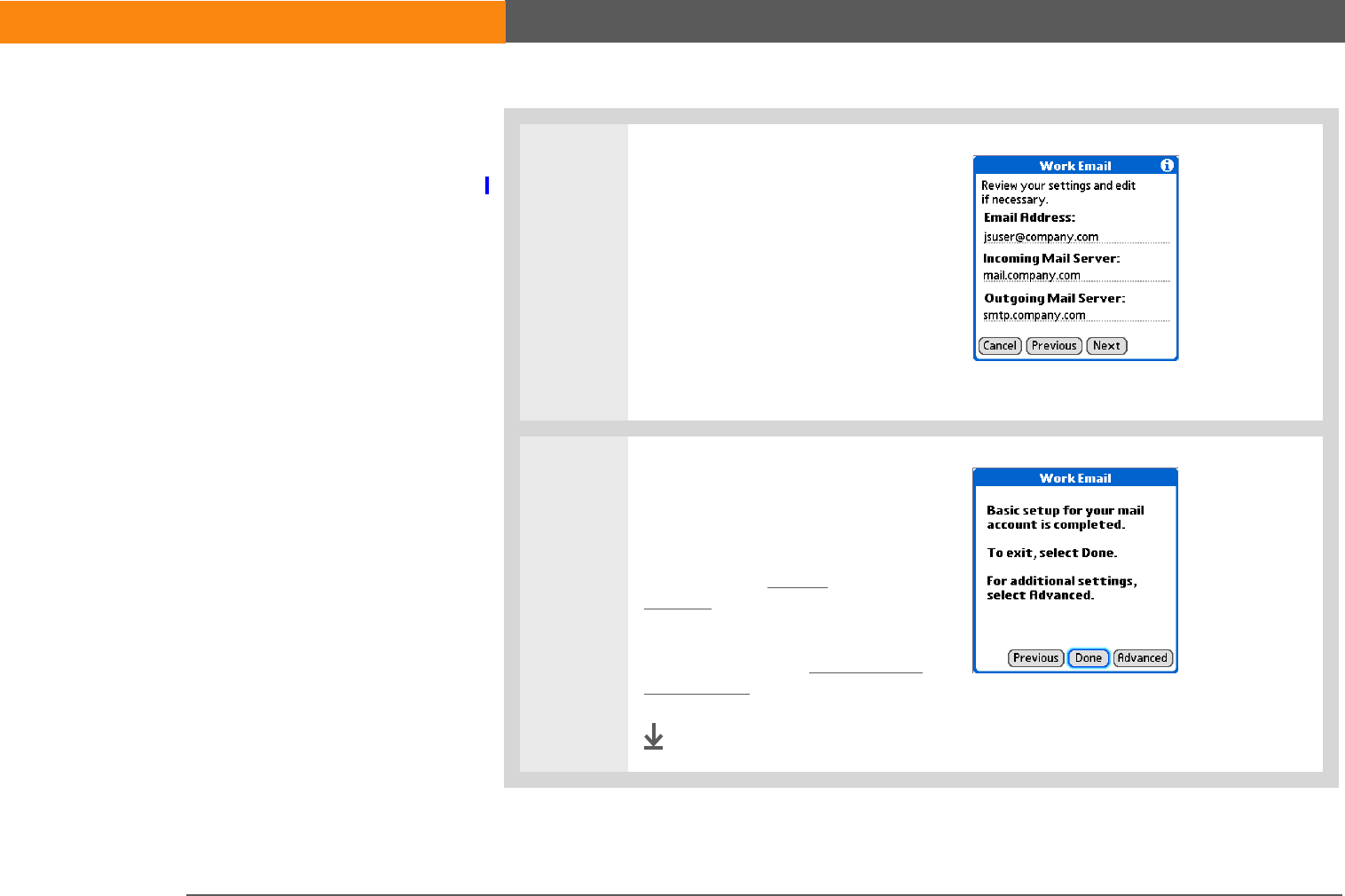
LifeDrive from palmOne 353
CHAPTER 18 Sending and Receiving Email Messages
5If you chose a common email
provider in step 3b, this screen is
already filled in. If not, enter the
names of the incoming and
outgoing mail servers:
a. Enter your email address.
b. Enter the names of your mail
servers.
c. Select Next.
6Do one of the following:
Finish setup Select Done to
finish setup and go to the Inbox
of the account you set up, where
you can begin getting and
sending email.
Set additional mail options
Select Advanced to set advanced
mail options.
Done
SECOND DRAFT palmOne, Inc. Confidential
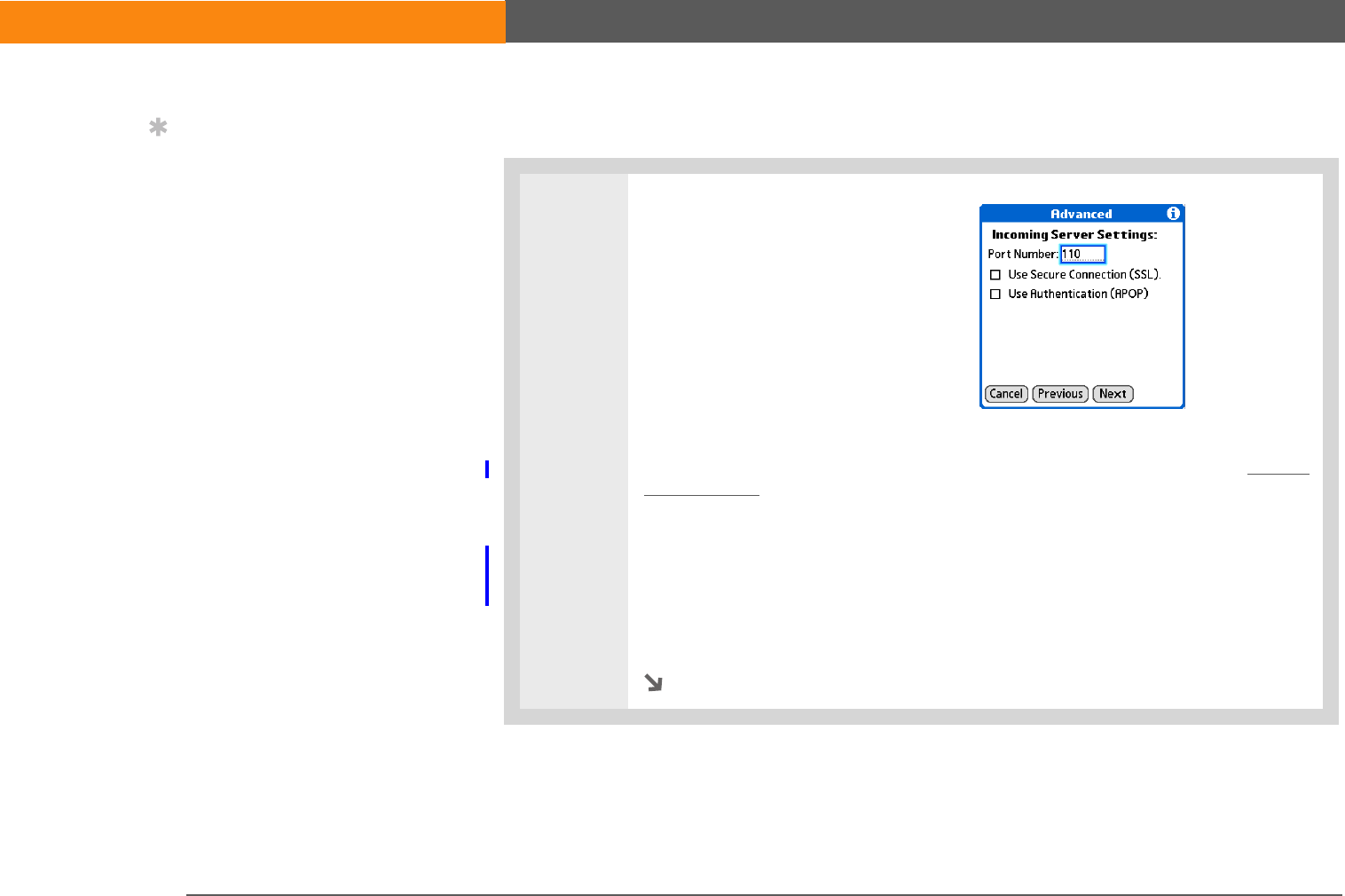
LifeDrive from palmOne 354
CHAPTER 18 Sending and Receiving Email Messages
Setting advanced mail options on your device
0
1Set incoming mail server options
for the account:
a. Select any of the following:
Port Number By default, the port
number setting is 110 for POP and
143 for IMAP servers. You may need
to change the port number if you
choose to retrieve incoming mail
over a secure connection.
Use Secure Connection (SSL) To retrieve incoming mail over a secure (Secure
Sockets Layer, or SSL) connection, check the Use Secure Connection box. If you
check the box, the port number for incoming mail changes to 995.
Use Authentication (APOP) (POP accounts only) Encrypts your username and
password when they travel over the network. Some services do not work
properly without APOP, while others do not work properly if APOP is used.
b. Select Next.
Continued
Tip
Check with your email
provider or your system
administrator for any
incoming or outgoing
mail settings you do not
know. Also check to see if
your account uses SSL,
APOP, or ESMTP, or
whether you need to
change the default port
number.
SECOND DRAFT palmOne, Inc. Confidential
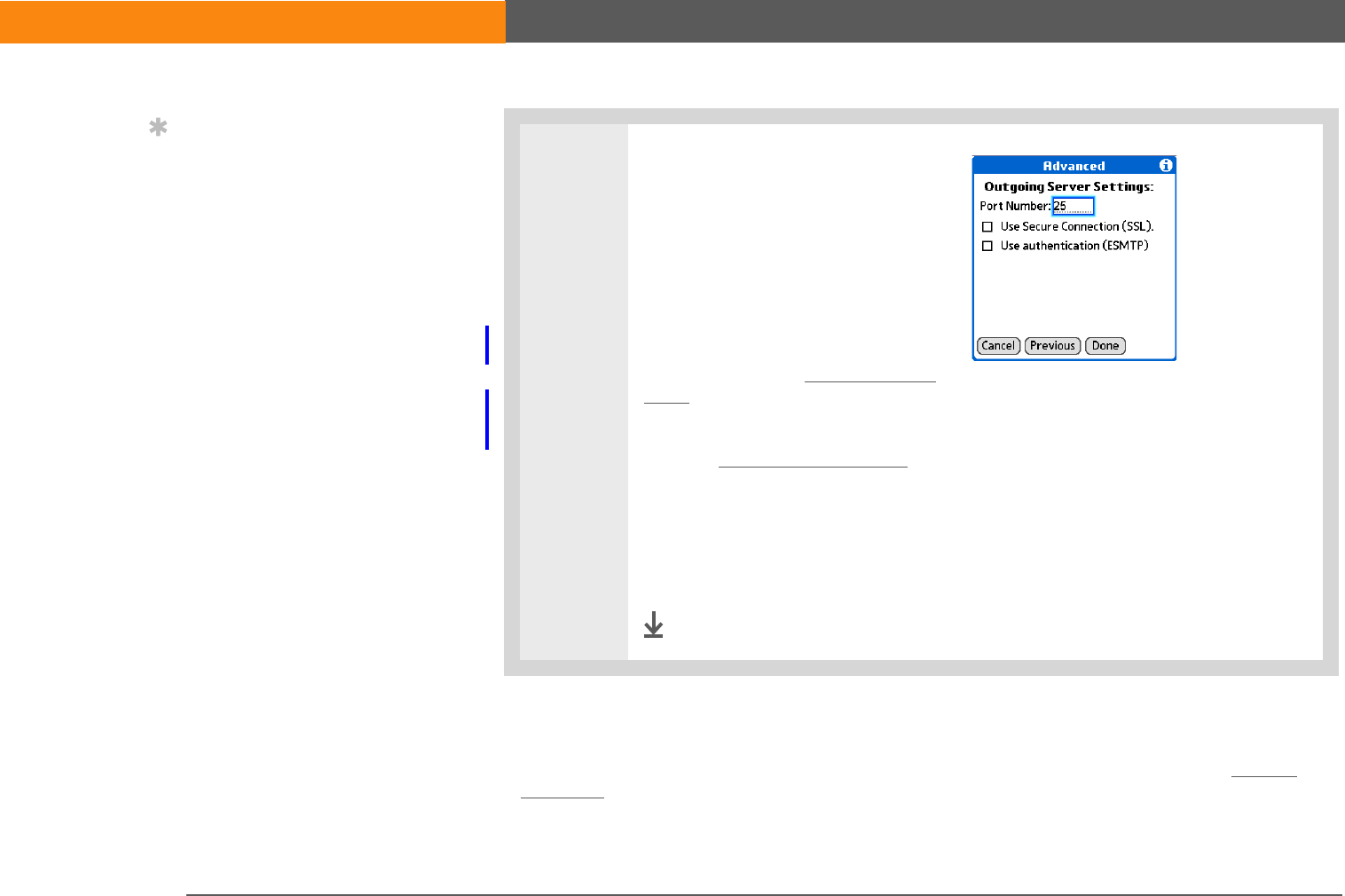
LifeDrive from palmOne 355
CHAPTER 18 Sending and Receiving Email Messages
Testing your new account
After you finish setting up a new email account, the Inbox of the account you just created is
displayed. You can test whether the email account is set up and working properly by getting
messages.
2Set outgoing mail options:
a. Select any of the following:
Port Number The default is 25,
the port number most SMTP
servers use.
Use Secure Connection (SSL)
Check the box to send outgoing
mail over a secure (Secure Sockets
Layer, or SSL) connection.
Use authentication (ESMTP) Check the box if the outgoing server (SMTP)
requires ESMTP authentication. If you select this option, username and
password fields appear. These fields are already filled in based on the account
information you entered. In most cases, the information displayed is correct;
however, occasionally your authentication username and/or password is
different from your account username or password.
b. Select Done.
Done
Tip
If you need to enter new
authentication
information, enter your
username, select the
Password box, enter a
password, and then
select OK. Check with
your email service
provider for
authentication username
and password
information.
SECOND DRAFT palmOne, Inc. Confidential

LifeDrive from palmOne 356
CHAPTER 18 Sending and Receiving Email Messages
Editing an account
As with setup, you can edit an account either on your computer or on your device.
Editing an account on your computer
WINDOWS ONLY
0
1Select the account to edit:
a. Select HotSync® Manager in the taskbar in the lower-right corner of your
computer screen.
b. Select Custom, and then select VersaMail.
c. Click Change, and then select the name of the account to edit in the pane on
the left of the screen.
2Select one of the following:
Delete Account Click the button and click to confirm the deletion.
Edit Account Click the button and edit the account settings on the following
screens.
Advanced Click the button and edit the advanced account settings on the
following screens.
Done
Tip
You can also edit an
account by selecting Start
in the lower-left corner of
your computer screen,
selecting Programs,
navigating to palmOne,
and then selecting
VersaMail Setup. Select
the username associated
with the account, click the
Edit an existing account
button, and then click
Next. Edit the information
on the account
information screens.
SECOND DRAFT palmOne, Inc. Confidential
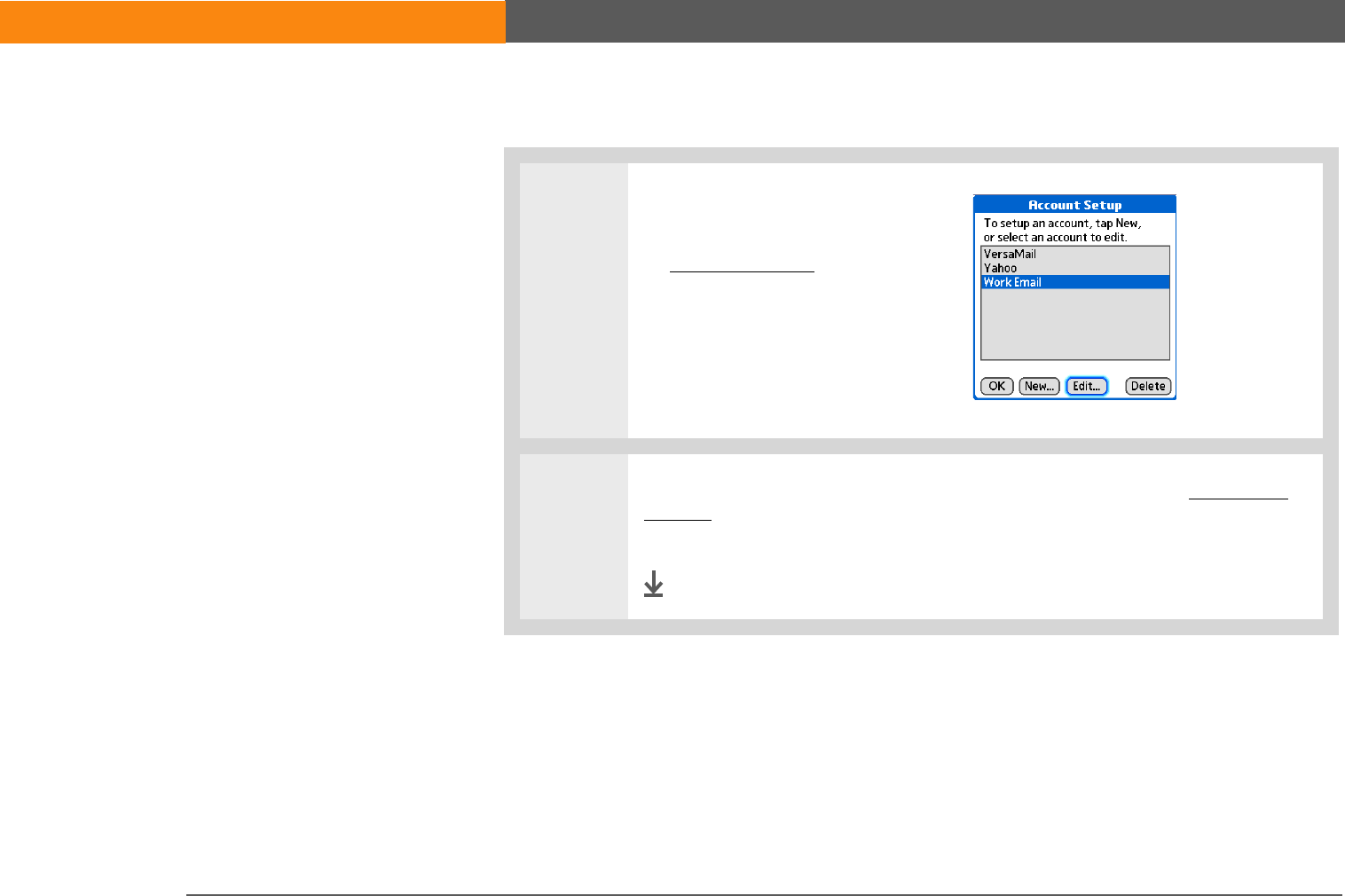
LifeDrive from palmOne 357
CHAPTER 18 Sending and Receiving Email Messages
Editing an account on your device
0
1Select the account you want to
edit:
a. Open the menus.
b. Select Accounts, and then
select Account Setup.
c. Select the name of the
account to edit, and then
select Edit.
2The same series of screens appears for editing an account as for creating an
account. Go through the screens by selecting Next, and change the entries you
want to edit on the appropriate screens.
Done
SECOND DRAFT palmOne, Inc. Confidential
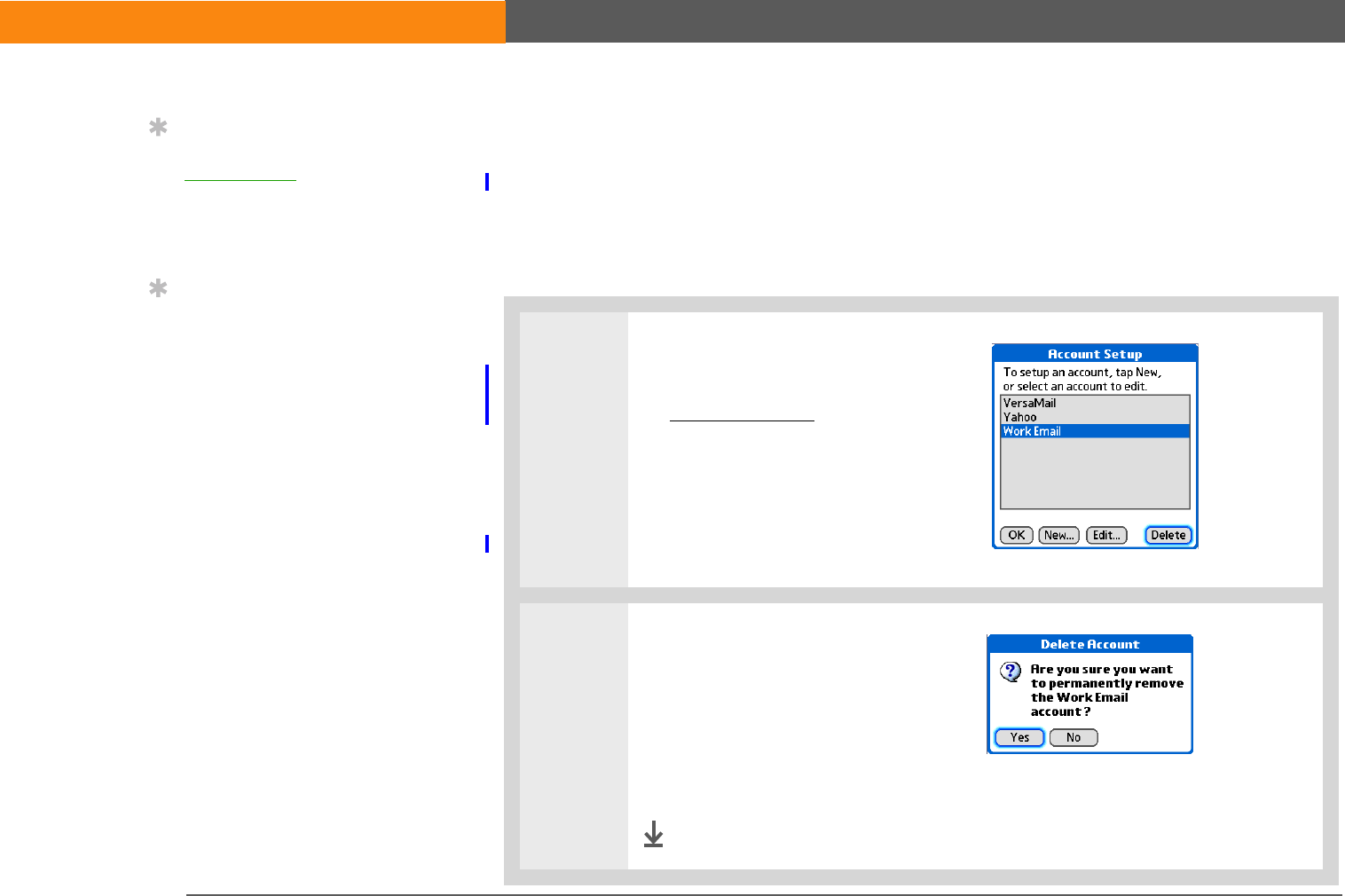
LifeDrive from palmOne 358
CHAPTER 18 Sending and Receiving Email Messages
Deleting an account
When you delete an account in the VersaMail application, the account is removed from your
device. The account still exists on the server, however. For example, deleting your Yahoo! account
from the VersaMail application deletes the account only from your device. Your email account still
exists at Yahoo.com.
You can delete all but one of your email accounts; you must have at least one account.
0
1Select the account you want to
delete:
a. Open the menus.
b. Select Accounts, and then
select Account Setup.
c. Select the name of the
account that you want to
delete, and then select Delete.
2Delete the account:
a. Select Yes in the Delete
Account dialog box to delete
the account and all associated
email messages.
b. Select OK.
Done
Tip
On a Windows computer,
do a full sync to free up
the memory associated
with an account after you
delete it.
Tip
You can also delete an
account on a Windows
computer by selecting
HotSync Manager in the
taskbar in the lower-right
corner of your computer
screen, selecting Custom,
selecting VersaMail, and
then selecting Change.
Select the account you
want, and then click
Delete Account.
SECOND DRAFT palmOne, Inc. Confidential
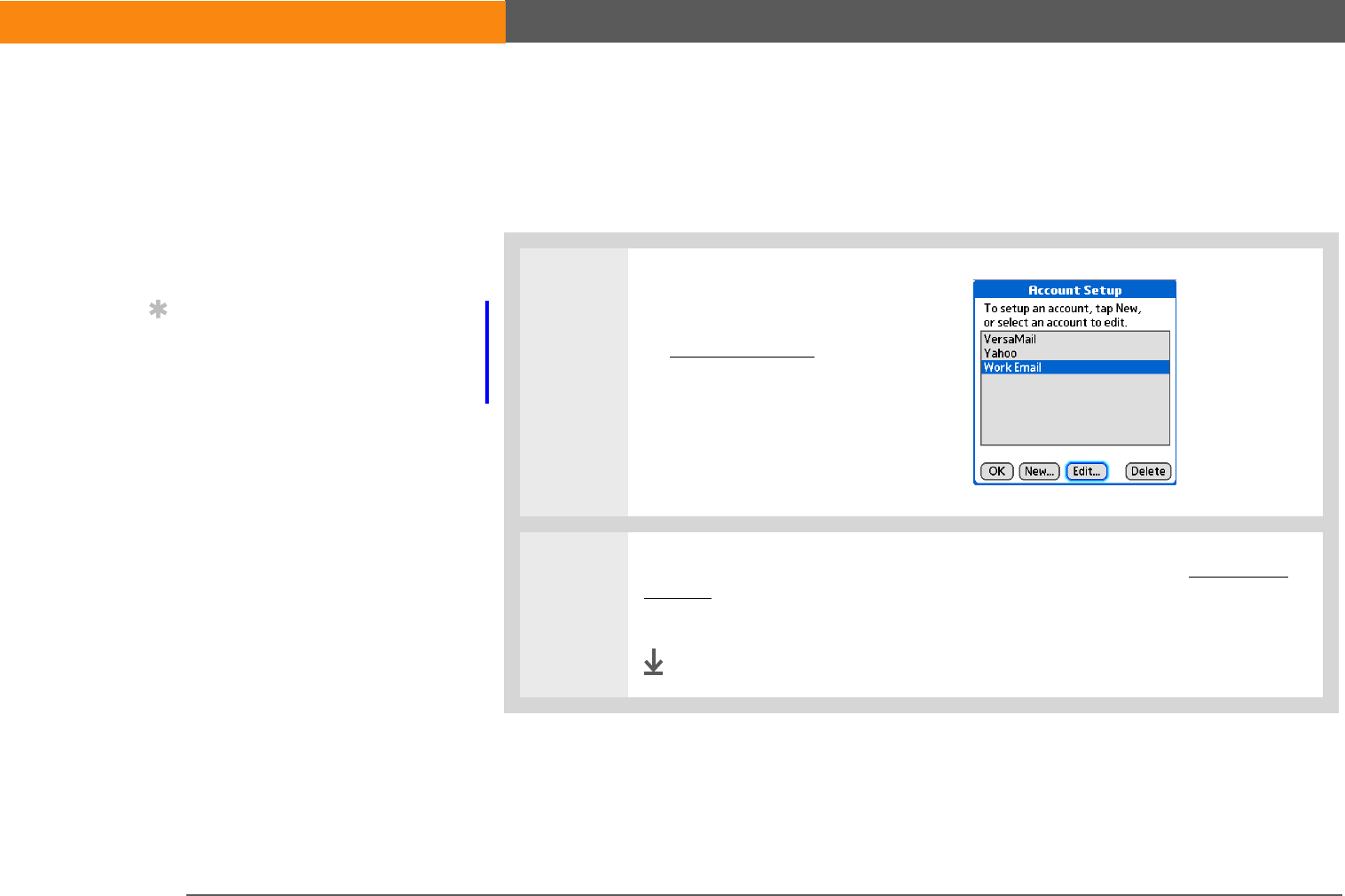
LifeDrive from palmOne 359
CHAPTER 18 Sending and Receiving Email Messages
Adding ESMTP to an account
Some services require ESMTP authentication to validate your username and password on an
SMTP server. If you aren’t sure if your ISP or web email provider supports ESMTP, check with your
email provider.
0
1Select the account to which you
want to add ESMTP:
a. Open the menus.
b. Select Accounts, and then
select Account Setup.
c. Select the name of the
account, and then select Edit.
2The same series of screens appears for editing an account as for creating an
account. Go through the screens by selecting Next, and check the
Authentication box on the advanced outgoing mail options screen.
Done
»
Key Term
ESMTP Acronym for
Extended Simple Mail
Transfer Protocol.
A method for
authenticating outgoing
email messages.
Tip
If you need to enter new
authentication
information, enter your
username, select the
Password box, enter a
password, and then
select OK. Check with
your email service
provider for
authentication username
and password
information.
SECOND DRAFT palmOne, Inc. Confidential
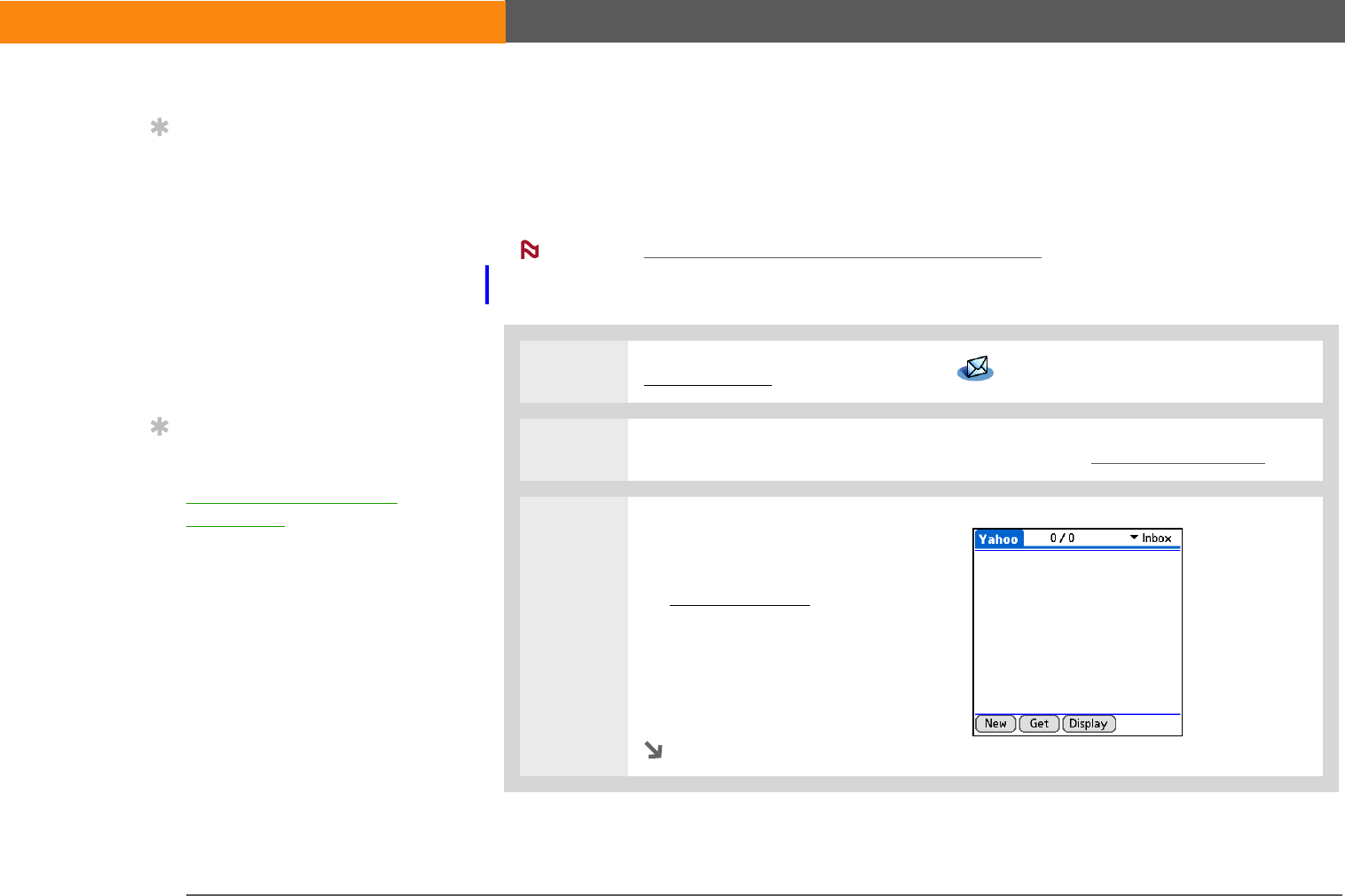
LifeDrive from palmOne 360
CHAPTER 18 Sending and Receiving Email Messages
Getting and reading messages
When you get messages, you can choose to see only the subjects of your email (which include
message size, sender, and subject), so that you can decide if you want to download the entire
message. Or you can choose to get the entire message for all of your incoming email.
See Working with Microsoft Exchange ActiveSync® for special considerations when
using a Microsoft Exchange ActiveSync account to synchronize email and Calendar information on
your device with info in Microsoft Exchange Server 2003.
0
1Go to Favorites and select VersaMail .
2[ & ] OPTIONAL If you are using a VPN connection, connect to your VPN.
3Choose whether to get message
subjects only or full messages:
a. Open the menus.
b. Select Accounts, and then
select the account you want.
c. Select Get or Get & Send.
Continued
Tip
To get and view
messages for a different
account, open the
Accounts menu and
select the account you
want. Select the folders
pick list in the upper-right
corner of the screen, and
then select Inbox to
display messages in the
Inbox.
Tip
For IMAP accounts, you
have the option of
wirelessly synchronizing
mail folders if the Get
Mail Options dialog box
is displayed.
NOTE
SECOND DRAFT palmOne, Inc. Confidential
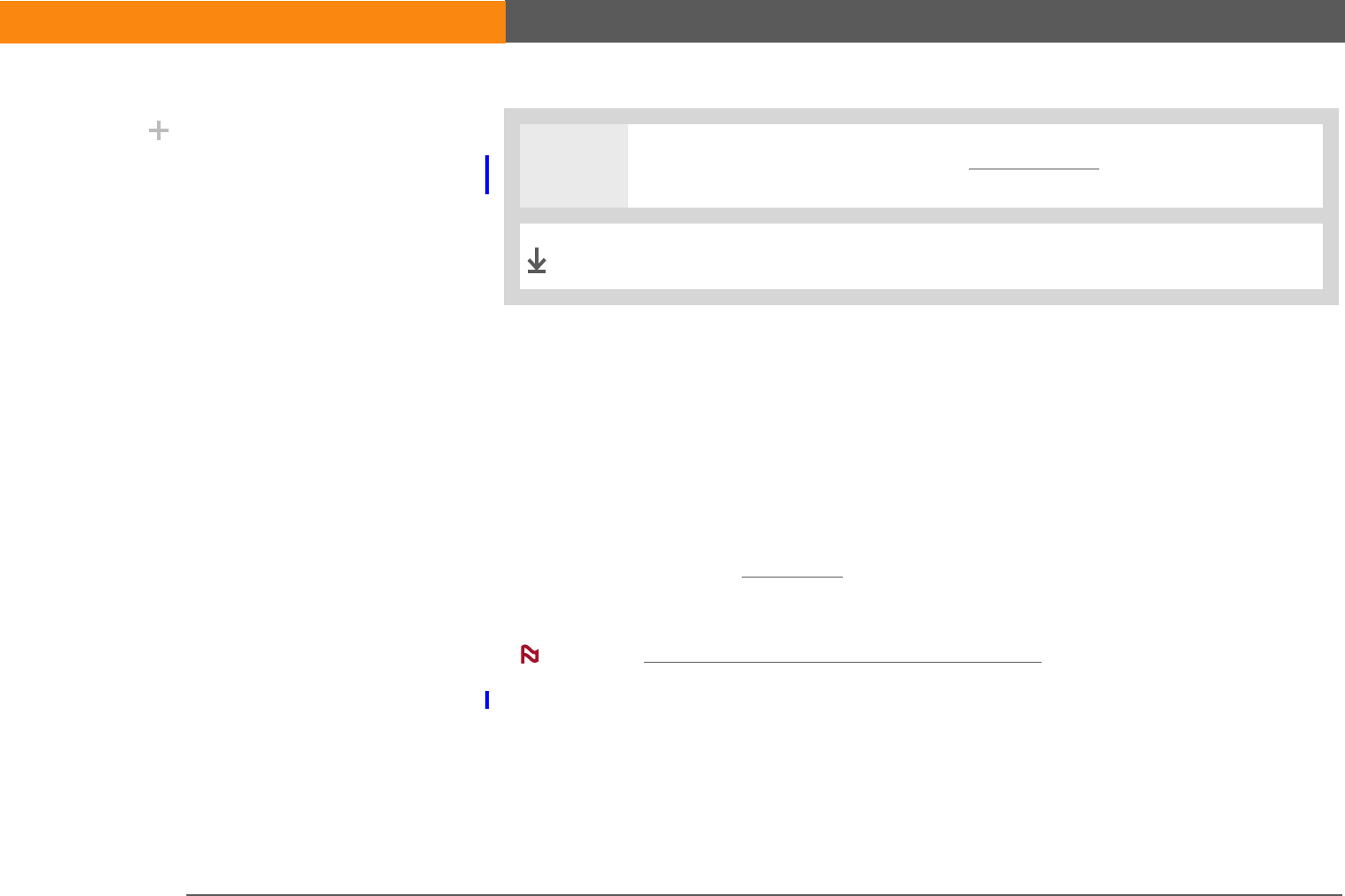
LifeDrive from palmOne 361
CHAPTER 18 Sending and Receiving Email Messages
Auto Sync with notification
You can set up VersaMail to automatically download new email messages to your device with the
Auto Sync feature.
If Auto Sync downloads any new messages, your device lets you know with a sound or vibration.
A list with the number of new messages retrieved appears on the Reminders screen.
The Auto Sync feature downloads only the first 3KB of each message. You can select the More
button on the message screen to download the entire message.
Auto Sync recognizes any filter criteria you set up for downloading messages. Messages that
don’t meet these filter criteria are not downloaded during Auto Sync. You need to turn off all filters
and manually retrieve these messages.
See Working with Microsoft Exchange ActiveSync® for special considerations when
using Auto Sync with a Microsoft Exchange ActiveSync account to synchronize email and
Calendar information with info in Microsoft Exchange Server 2003.
Scheduling Auto Sync
You can set up different schedules for each of your email accounts, but you can set up only one
schedule for each account. For example, if you set up a schedule to get mail on weekdays for your
Yahoo! account, you can’t set up a separate schedule for weekends for that account.
4[ & ] OPTIONAL If you have selected Ask Every Time in VersaMail
Preferences, select whether to download subjects only or entire messages.
A list of your messages appears in the Inbox.
Done
NOTE
Did You Know?
If more than one
scheduled Auto Sync
happens at the same time
(for example, for two
separate email accounts),
Auto Sync performs any
past-due Auto Sync first,
and then performs
current Auto Sync
retrievals according to
the order of email
accounts in the Accounts
menu list.
SECOND DRAFT palmOne, Inc. Confidential
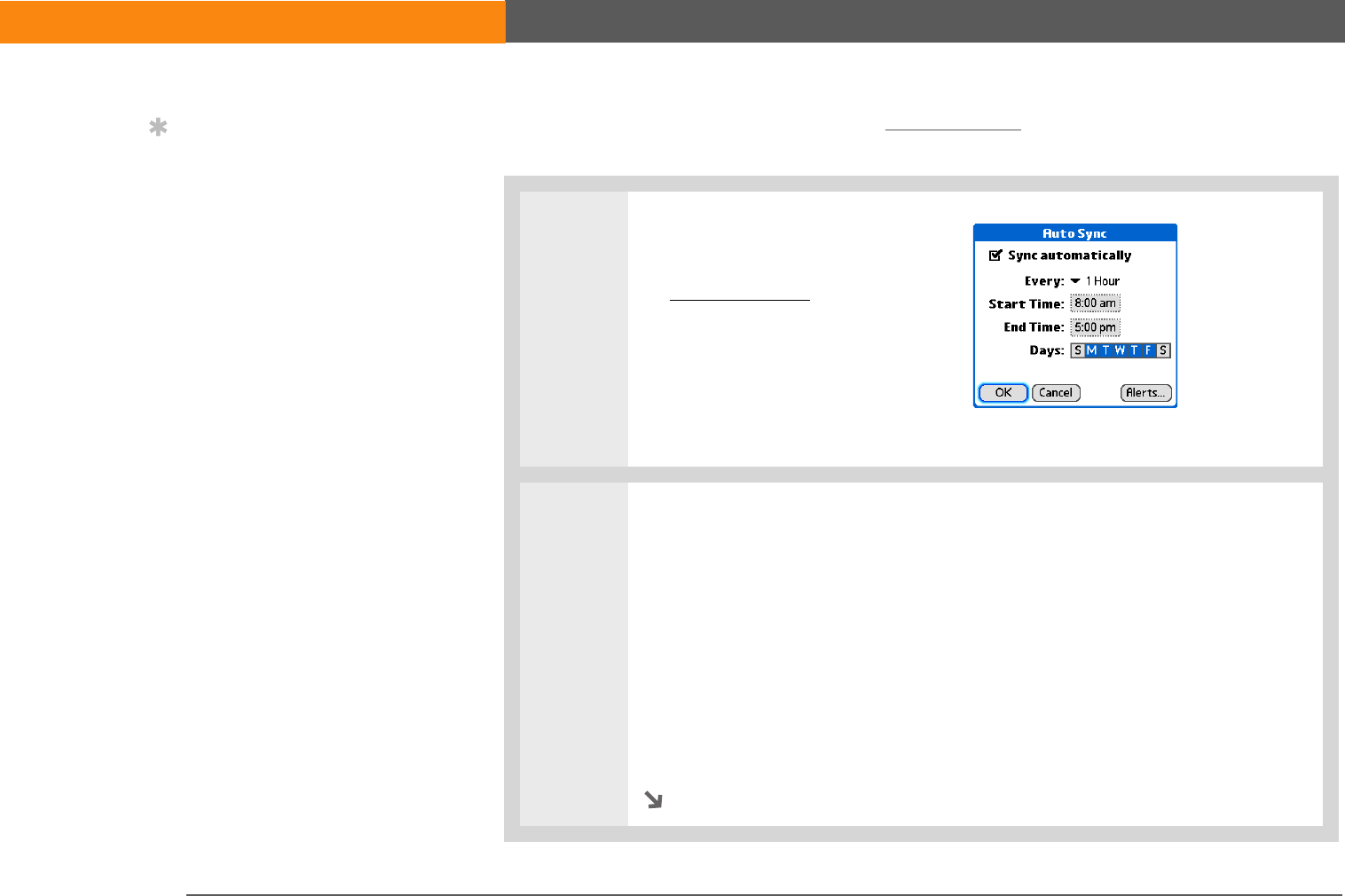
LifeDrive from palmOne 362
CHAPTER 18 Sending and Receiving Email Messages
Auto Sync may not work with your specific VPN connection. It also doesn’t work if your security
preferences include encrypting databases on the device.
0
1Select Auto Sync for a given
account:
a. Open the menus.
b. Select Options, and then
select Preferences.
c. Select Auto Sync, and then
check the Sync automatically
box.
2Set schedule options:
Interval Select the Every pick list and select the time interval, from 5 minutes
to 12 hours. Note that if you set a more frequent interval, you may need to
recharge your device’s battery more often.
Start/End Time Select the Start and End Time boxes, and then select the hour,
the minute, and AM or PM to enter the time for the first and last Auto Sync to
take place. Select OK.
Days Select the days you want the schedule to be active. You can choose any
number of days, but you can set up only one schedule for each email account.
Continued
Tip
Be sure to manually
retrieve any messages
using Get or Get & Send
after setting up a
scheduled Auto Sync.
Then only new messages
are retrieved during Auto
Sync.
SECOND DRAFT palmOne, Inc. Confidential
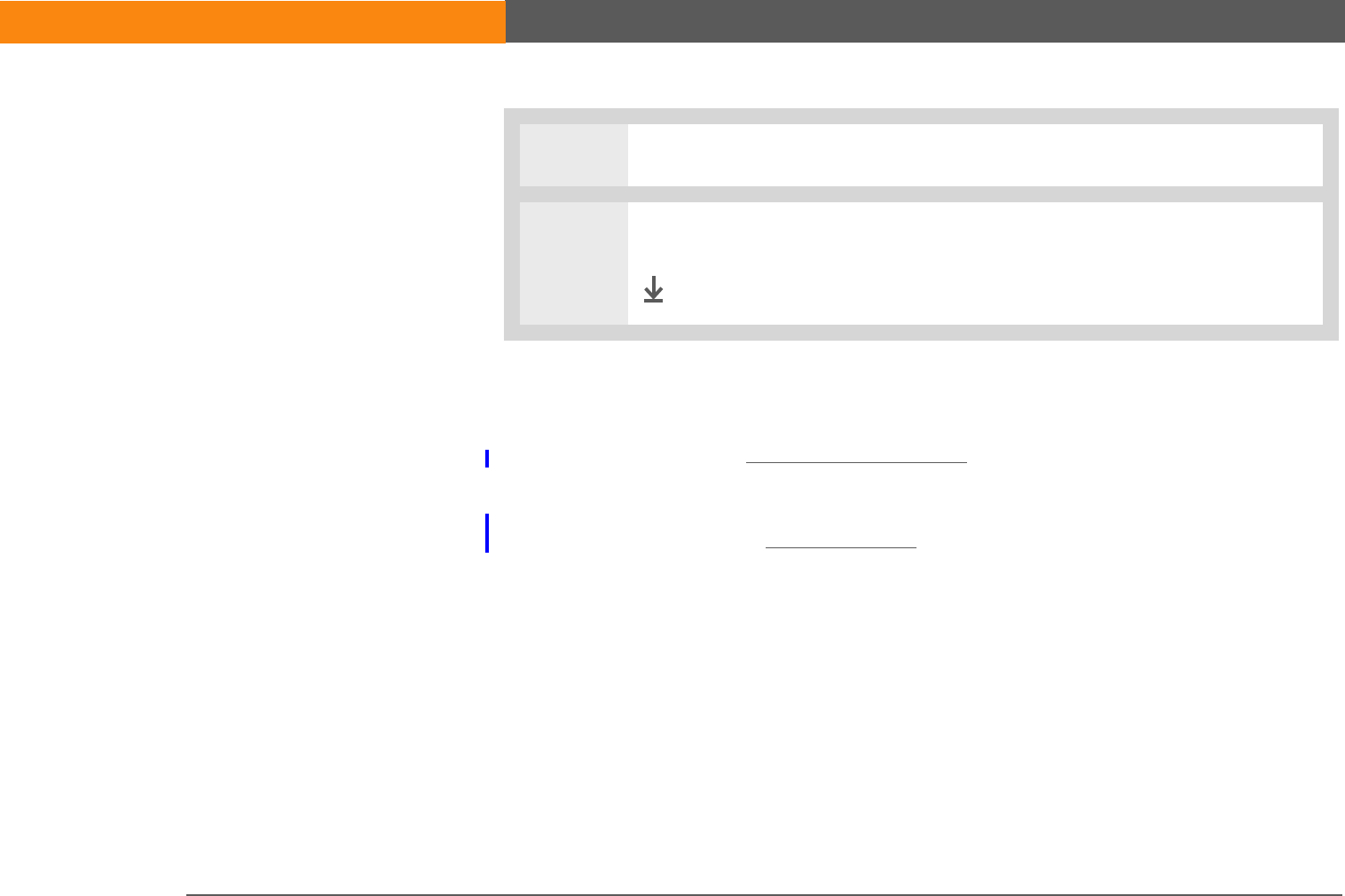
LifeDrive from palmOne 363
CHAPTER 18 Sending and Receiving Email Messages
Auto Sync notifications
The Auto Sync feature provides two types of notifications during and after it gets messages:
Alerts You can choose to have your device alert you with a beep or other sound when a new
message arrives in your account.
Reminders screen If Auto Sync discovers and downloads new messages for an email account,
a notification appears on the Reminders screen, telling you the account name and the number of
new messages. If Auto Sync is scheduled for more than one account, a separate notification
appears for each account.
3Select OK.
4[ & ] OPTIONAL Select Get or Get & Send.
Done
SECOND DRAFT palmOne, Inc. Confidential
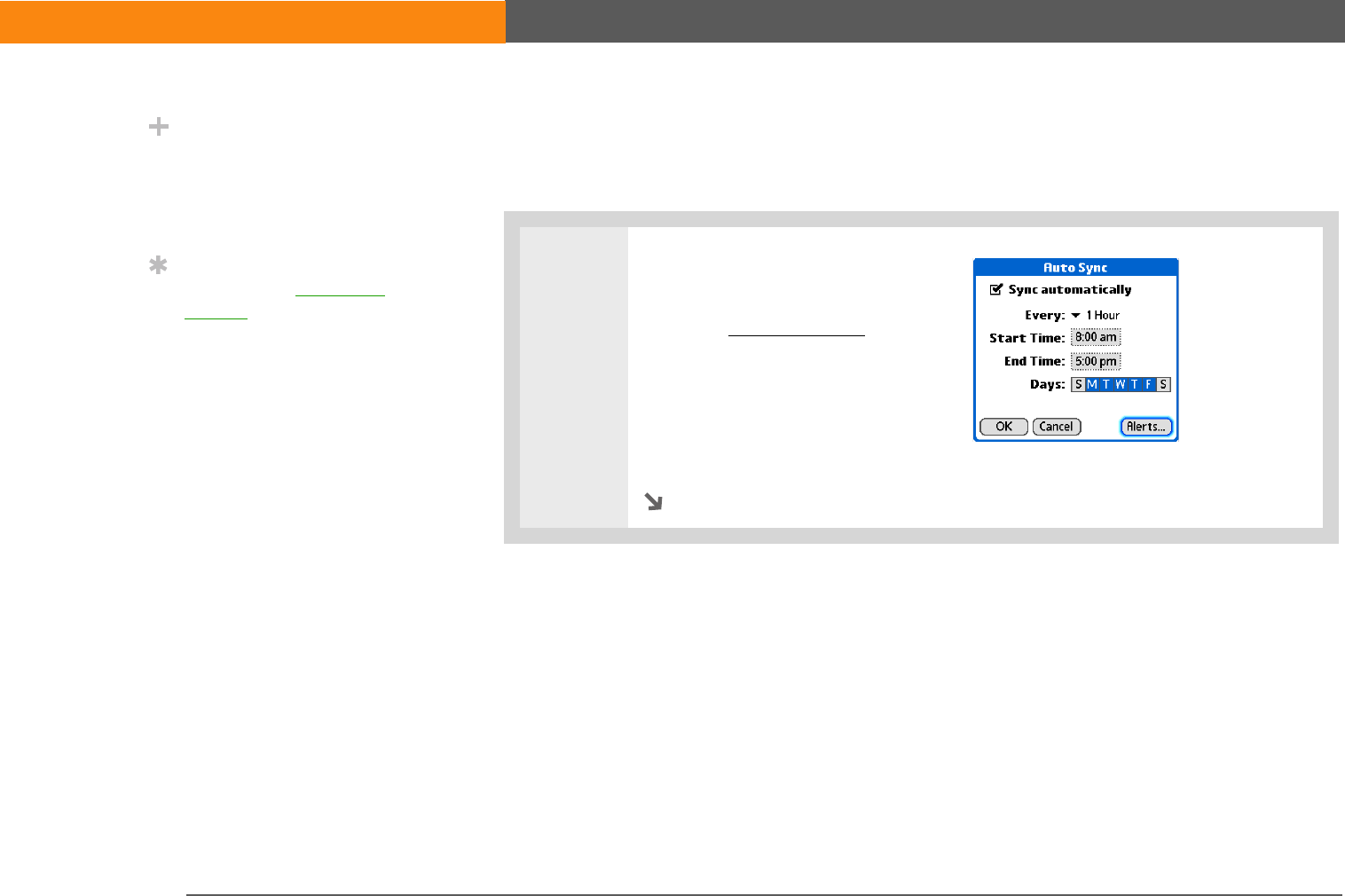
LifeDrive from palmOne 364
CHAPTER 18 Sending and Receiving Email Messages
Setting alert options
You can choose an alert—such as a bird, a phone, or an alarm—to let you know when new email
arrives.
0
1Open the Alerts screen:
a. From the Inbox or another
folder, open the menus.
b. Select Options, and then
select Preferences.
c. Select Auto Sync, and then
select Alerts.
Continued
Did You Know?
Any custom sound you
install on your device
appears on the Alert
Sound pick list.
Tip
You can also adjust the
volume of the alert
sound.
SECOND DRAFT palmOne, Inc. Confidential
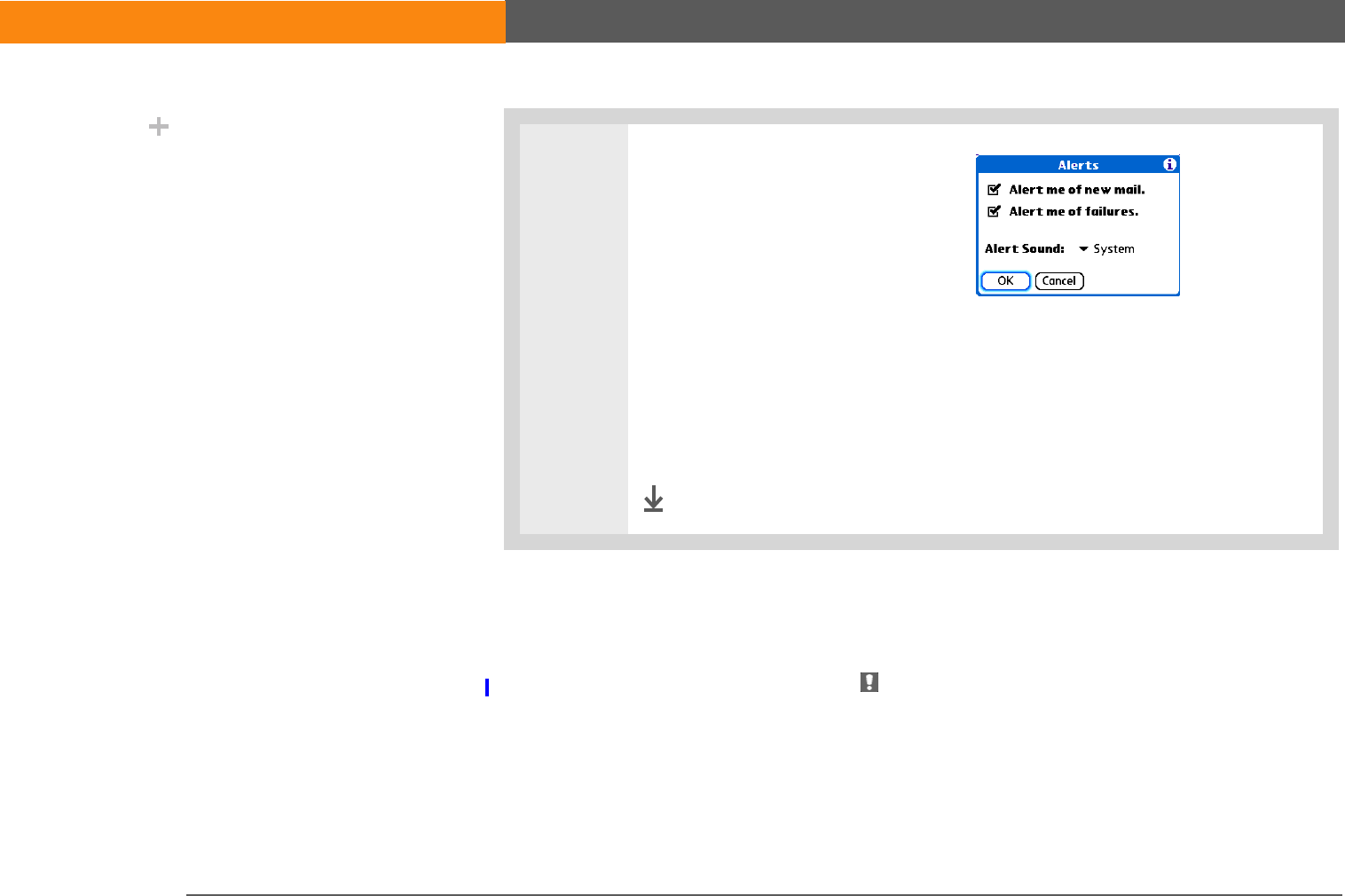
LifeDrive from palmOne 365
CHAPTER 18 Sending and Receiving Email Messages
Viewing and using the Reminders screen
The Reminders screen on your device shows info about new email messages. It also shows alerts
from other applications, such as Calendar appointments.
To view the Reminders screen, tap Alert on the status bar when it is blinking.
You can do any of the following:
• Check the box to clear a reminder from the list.
• Select the reminder (either the mail icon or the text description) to go to the Inbox of that
account or to read a detailed error message.
2Select alert options:
a. Check the Alert me of new mail
box.
b. Select the Alert Sound pick
list, and then select a sound.
The device plays a brief demo
of the sound.
c. To receive alerts of successful Auto Sync retrievals only, uncheck the Alert
me of failures box. Leave the box checked if you want to receive alerts for
both successful and failed Auto Sync retrievals.
d. Select OK.
Done
Did You Know?
If you are viewing the
Inbox and an Auto Sync
downloads new
messages, those
messages do not appear
on the Reminders screen,
because you can already
view them in the Inbox.
SECOND DRAFT palmOne, Inc. Confidential

LifeDrive from palmOne 366
CHAPTER 18 Sending and Receiving Email Messages
• Select Done to close the Reminders screen and return to whatever you were doing on your
device before the Reminders screen appeared.
• Select Clear All to delete all reminders on the Reminders screen.
When a notification appears on the Reminders screen, select it to go to the Inbox of that account,
or open the VersaMail application and go to that account. Once you open the Inbox, any new
messages are removed from the Reminders screen, even if you don’t open them. Auto Sync then
starts at the next scheduled interval, with the Reminders screen counter reset to 1.
Auto Sync retries
If the interval for a scheduled Auto Sync is set at “Every 1 hour” or less frequently, and an Auto
Sync fails for any reason, the VersaMail application tries to retrieve email every 30 minutes until
either the next scheduled Auto Sync occurs or the end time for scheduled email retrieval is
reached. If the interval is set for more frequently than “Every 1 hour,” the VersaMail application
waits until the next scheduled Auto Sync.
Resource issues with Auto Sync
The Auto Sync feature can cause the following resource constraints:
Decreased battery life If you set the Auto Sync interval for more often than once per hour, your
device’s battery charge may drain more quickly, and you may need to recharge the battery more
frequently.
Increased monthly charges Some wireless providers charge a fee for data transactions. If you
use one of these providers, using the Auto Sync feature can substantially add to your monthly
charges. This is especially true for POP accounts, because POP messages take longer to download
than IMAP messages.
Tip
If the Reminders screen
shows an Auto Sync error
message for an account,
select the message to
view more detailed
information about the
error. You can choose to
disable notifications for
Auto Sync failures.
SECOND DRAFT palmOne, Inc. Confidential
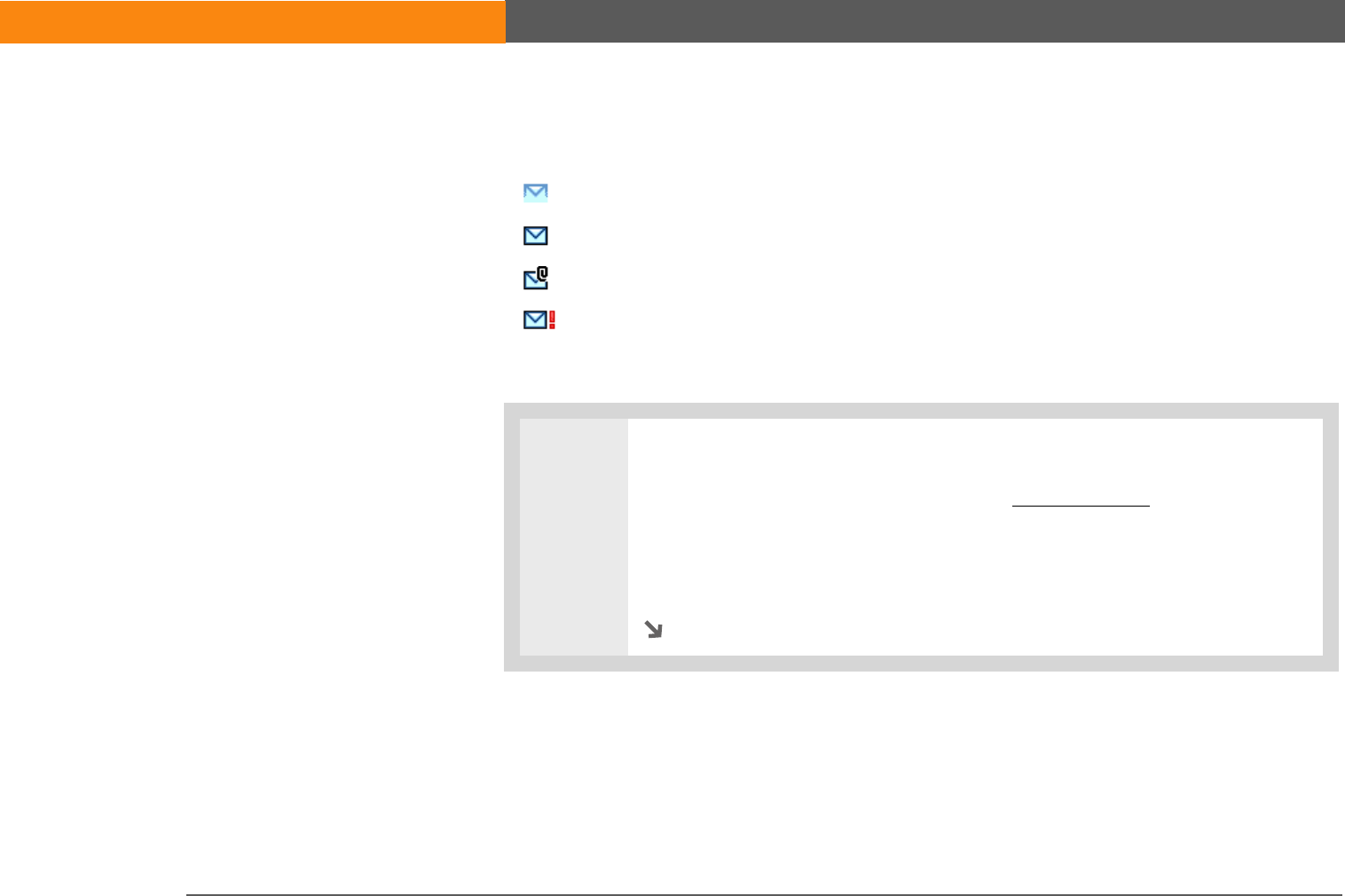
LifeDrive from palmOne 367
CHAPTER 18 Sending and Receiving Email Messages
Inbox icons in the VersaMail application
The icons to the left of a message in the Inbox tell you the message’s status.
Only the subject header information is downloaded.
Part or all of the message text is downloaded.
Part or all of the message text and attachment information is downloaded.
Downloaded message has been marked high priority by the sender.
Setting preferences for getting messages
0
1Open the Delivery Options preferences:
a. In the Inbox or on another folder screen, open the menus.
b. Select Options, and then select Preferences.
c. Select Delivery Options.
Continued
SECOND DRAFT palmOne, Inc. Confidential
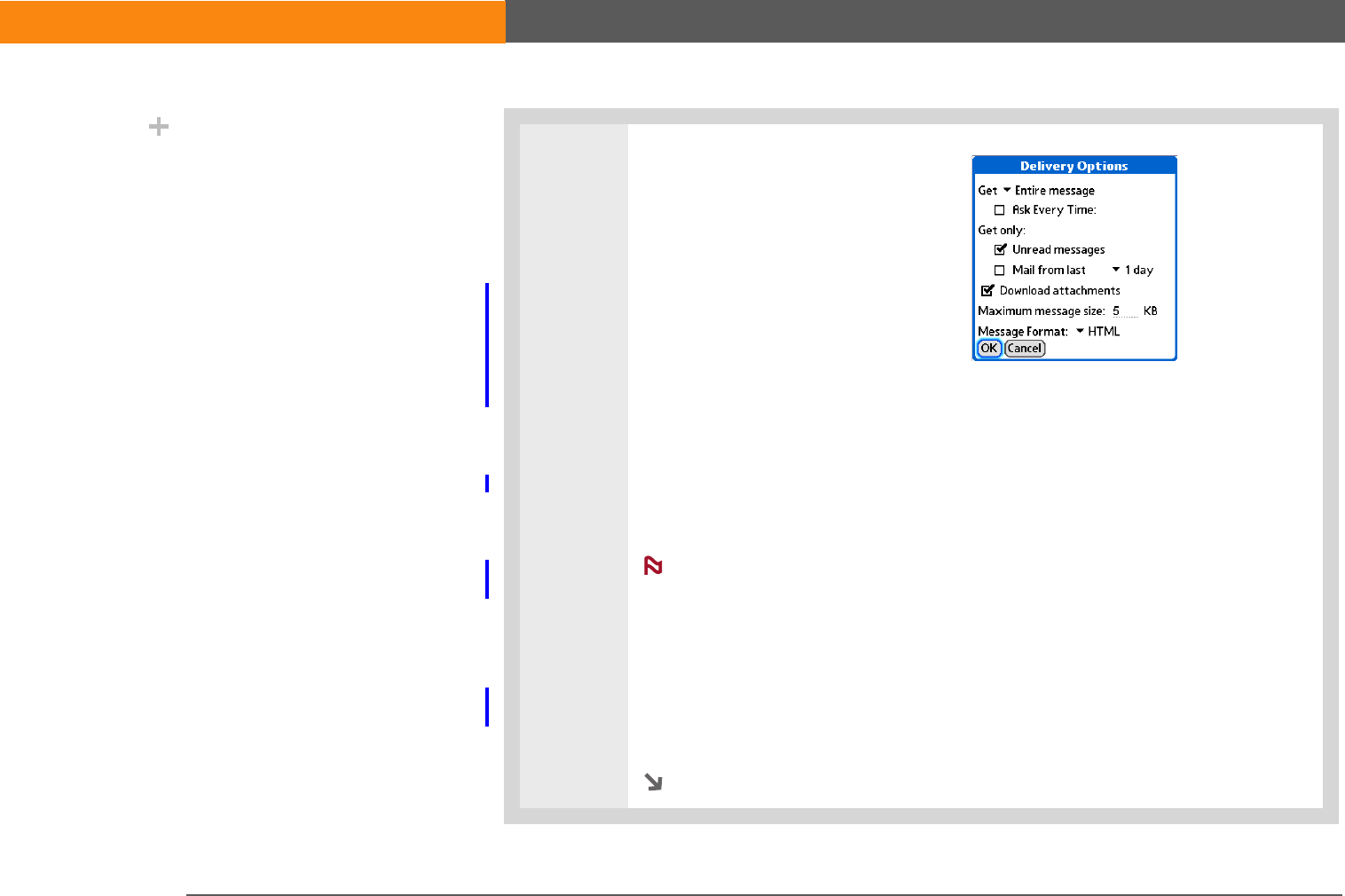
LifeDrive from palmOne 368
CHAPTER 18 Sending and Receiving Email Messages
2Select preferences:
Get Select whether to get
message subjects only or entire
messages.
Ask Every Time Check to display
a dialog box for choosing subjects
only or entire messages each time
you retrieve email. Leave
unchecked to retrieve messages
according to the option you select
in the Get pick list.
Get only Unread messages (IMAP account only) Check the box to download
only unread mail to your device. If you don’t select this option and you select
Get & Send, all of your messages on your provider’s mail server are
downloaded to your Inbox, including messages you have already read.
For POP accounts, the Unread messages box does not appear on the
Delivery Options screen.
Mail from last X days Get messages sent within the number of days you
specify (default is 7).
Download attachments Check the box to automatically download files
attached to email messages to your device. Attachments that exceed the
maximum message size cannot be downloaded.
Continued
Did You Know?
The POP protocol does
not support retrieval of
unread mail only from the
server. If you have a POP
email account, the
VersaMail application
downloads all messages
from the server
regardless of whether
you have read them (for
example, on your desktop
or on the web).
NOTE
SECOND DRAFT palmOne, Inc. Confidential
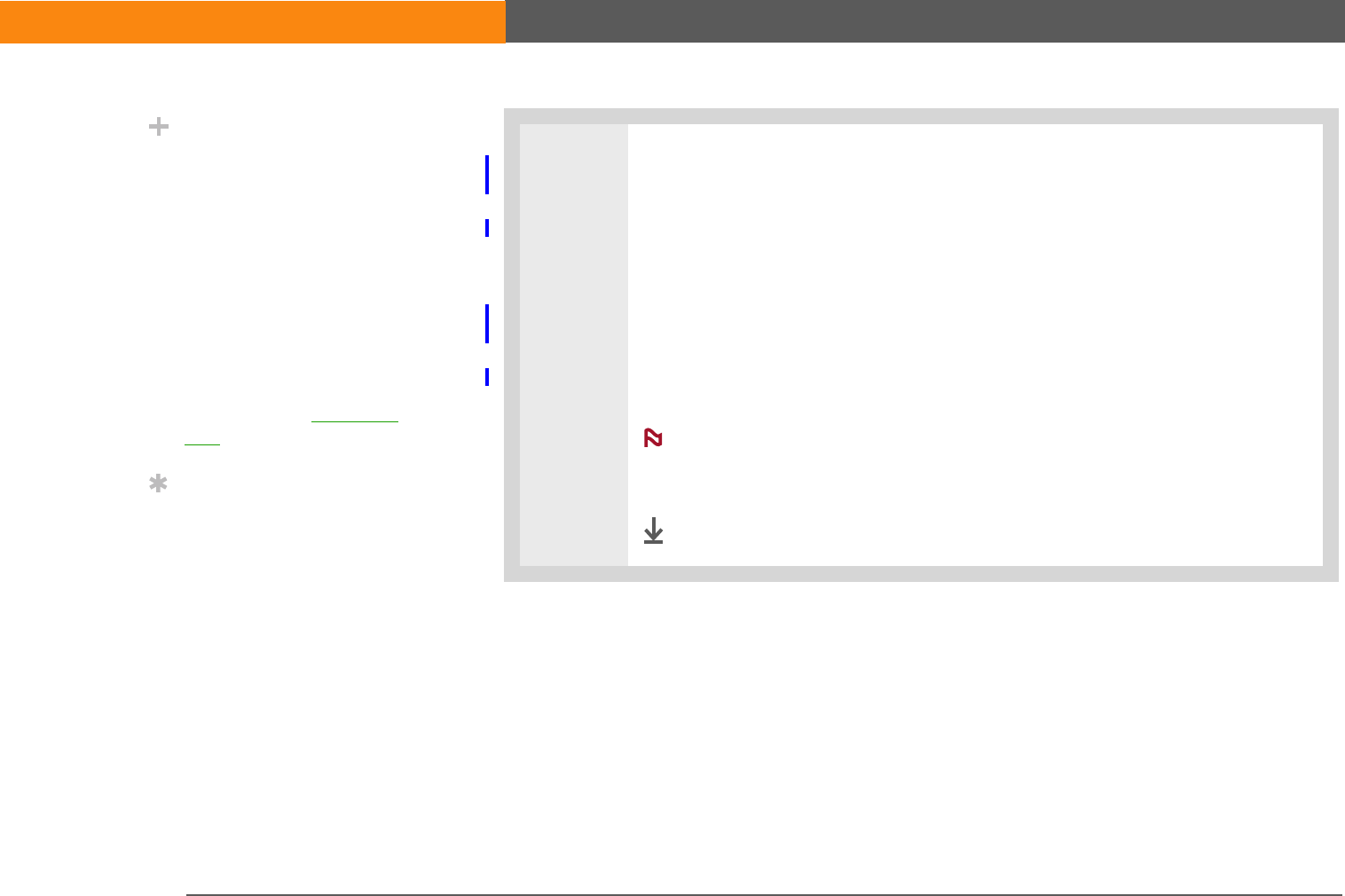
LifeDrive from palmOne 369
CHAPTER 18 Sending and Receiving Email Messages
Cont’d
Maximum message size Enter the maximum size of an incoming email
message in kilobytes (KB). The maximum size of an incoming message is 5KB
by default, but you can enter any size up to 5000KB (approximately
5 megabytes, or 5MB), including attachments. The maximum message size that
you can retrieve is 60KB for the body text and approximately 5MB of total data
for any attachments.
Message Format Select to retrieve messages in HTML or plain text format. If
you select HTML, any messages sent to you in HTML format are displayed with
basic HTML formatting intact. Other messages are displayed as plain text. If you
select Plain Text, all messages are displayed as plain text, regardless of the
format in which they were sent. The default setting is HTML.
The VersaMail application sends all messages as plain text only, with
all HTML tags stripped, even if you are forwarding or replying to a message that
was originally received as HTML.
Done
Did You Know?
Basic HTML includes
bold, italics (small font
only), colored words,
bulleted and numbered
lists, and so on.
In an HTML message,
certain types of graphics
(for example, JPEG or GIF
files) may be displayed as
a URL in the body of the
email message. In some
cases, you can select the
URL to open the graphic.
Tip
Because downloading
large messages can
consume device
resources, the VersaMail
application displays the
size of the message and
asks if you want to
continue downloading
any message that
exceeds your maximum
message size, up to a
total size of 5MB.
NOTE
SECOND DRAFT palmOne, Inc. Confidential
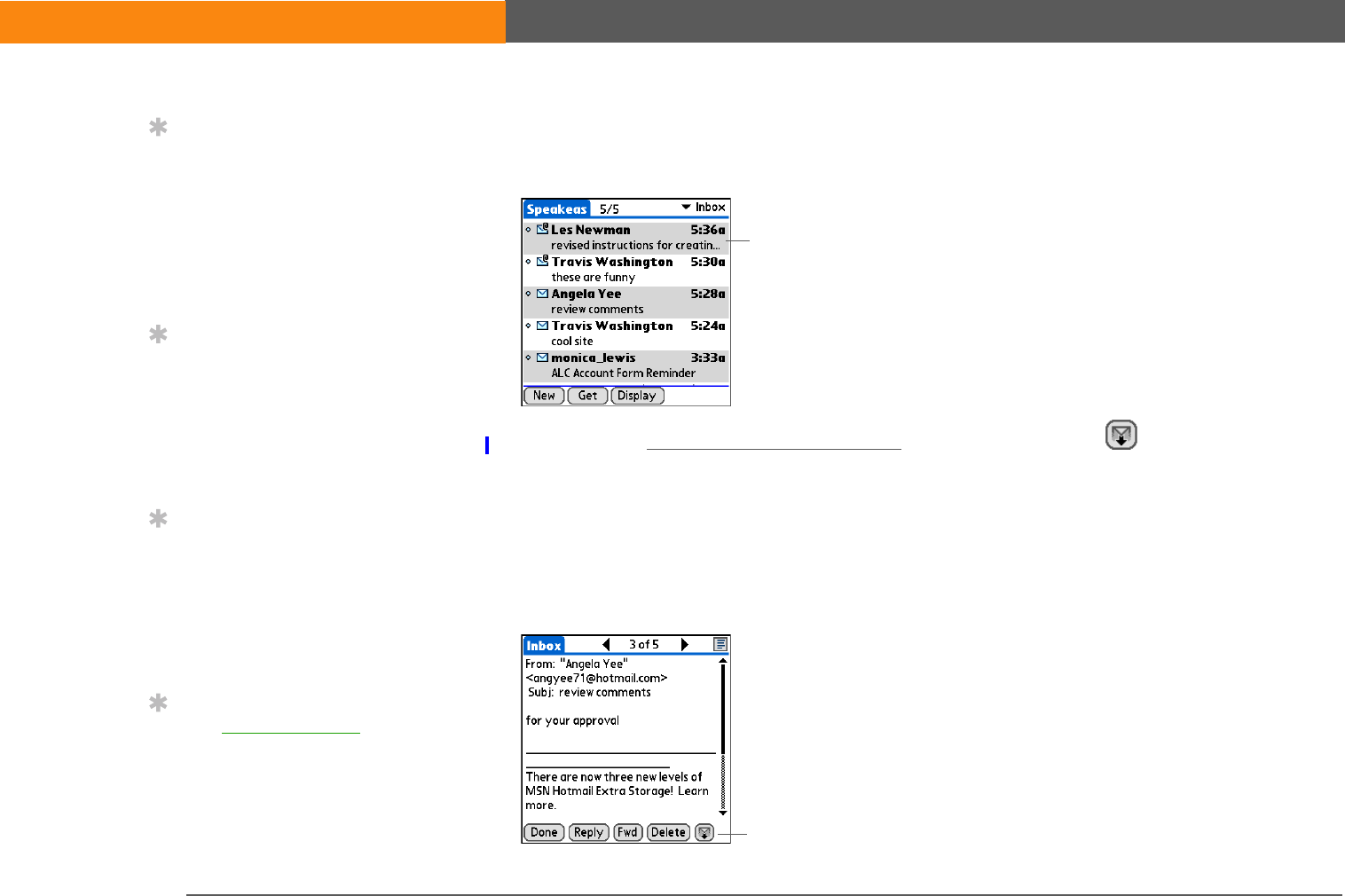
LifeDrive from palmOne 370
CHAPTER 18 Sending and Receiving Email Messages
Reading email messages
To read email, select the email message in the Inbox or the folder where the message is located.
If you chose to get messages by subjects only, select the More button on the message screen
to view the body of the email message, plus any attachments, up to the maximum message size
you select. If the downloaded message exceeds your maximum message size, only a partial
message is displayed. Select the More button to view the entire message.
If you chose to get entire messages, the body of the message is displayed. However, if the
downloaded message exceeds your maximum message size, only part of the message is
displayed. Select the More button to view the entire message.
Tip
If you use the 5-way
navigator to select and
open a message, press
Center after reading the
message to close it and
return to the folder where
you started.
Tip
Highlight a message and
press Right on the 5-way
to open a menu of
message commands such
as Forward, Reply, and
Delete.
Tip
Change the font size of a
message you are reading
by opening the Options
menu and selecting Use
smaller font or Use
standard font.
Tip
Use landscape mode to
see more of the message
on a single screen.
Select to read
Select More to view
the entire message
SECOND DRAFT palmOne, Inc. Confidential
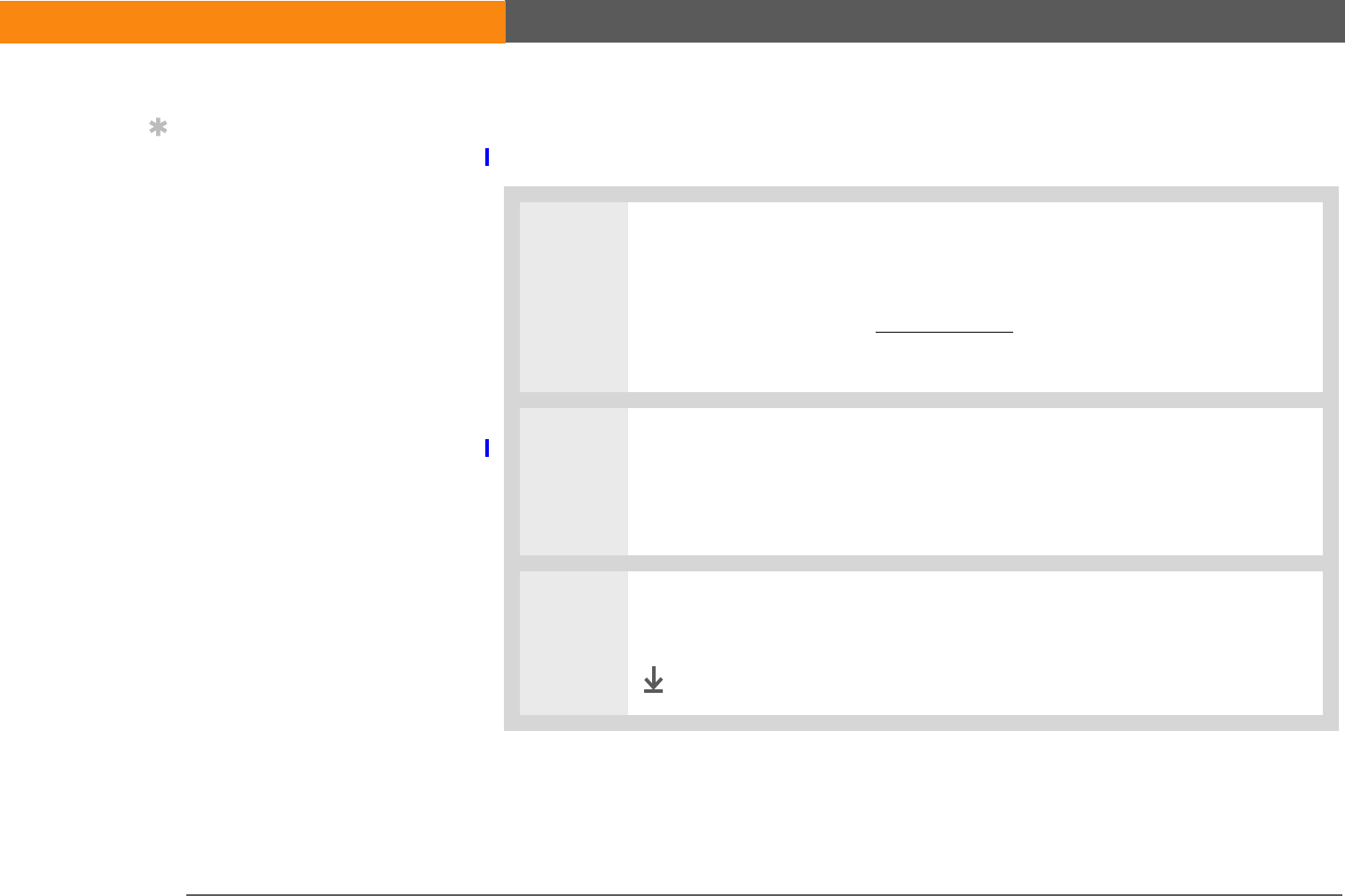
LifeDrive from palmOne 371
CHAPTER 18 Sending and Receiving Email Messages
Adding or updating a contact directly from a message
You can add an email address to Contacts directly from the body of a received email message.
0
1Open the Add Contact dialog box:
a. Open the message you want.
b. On the message screen, open the menus.
c. Select Options, and then select Add to Contacts.
2[ & ] OPTIONAL If a display name exists for this Contacts record, the dialog
box displays the name in the Last name and First name fields.
If the Last name and First name fields are blank, enter the first and last name
associated with the “From” email address.
3Select OK to add the email address to Contacts, and then select OK in the
confirmation dialog box.
Done
Tip
You can also update an
existing Contacts record
with a new email address,
or create a second
Contacts record for a
name that has an existing
record. The procedure is
the same as for adding a
new Contacts record. If
you select Add to
Contacts from an email
message and a record
already exists for the
recipient name, you are
prompted either to
update the email address
for the recipient or to
create a new record for
the recipient.
SECOND DRAFT palmOne, Inc. Confidential
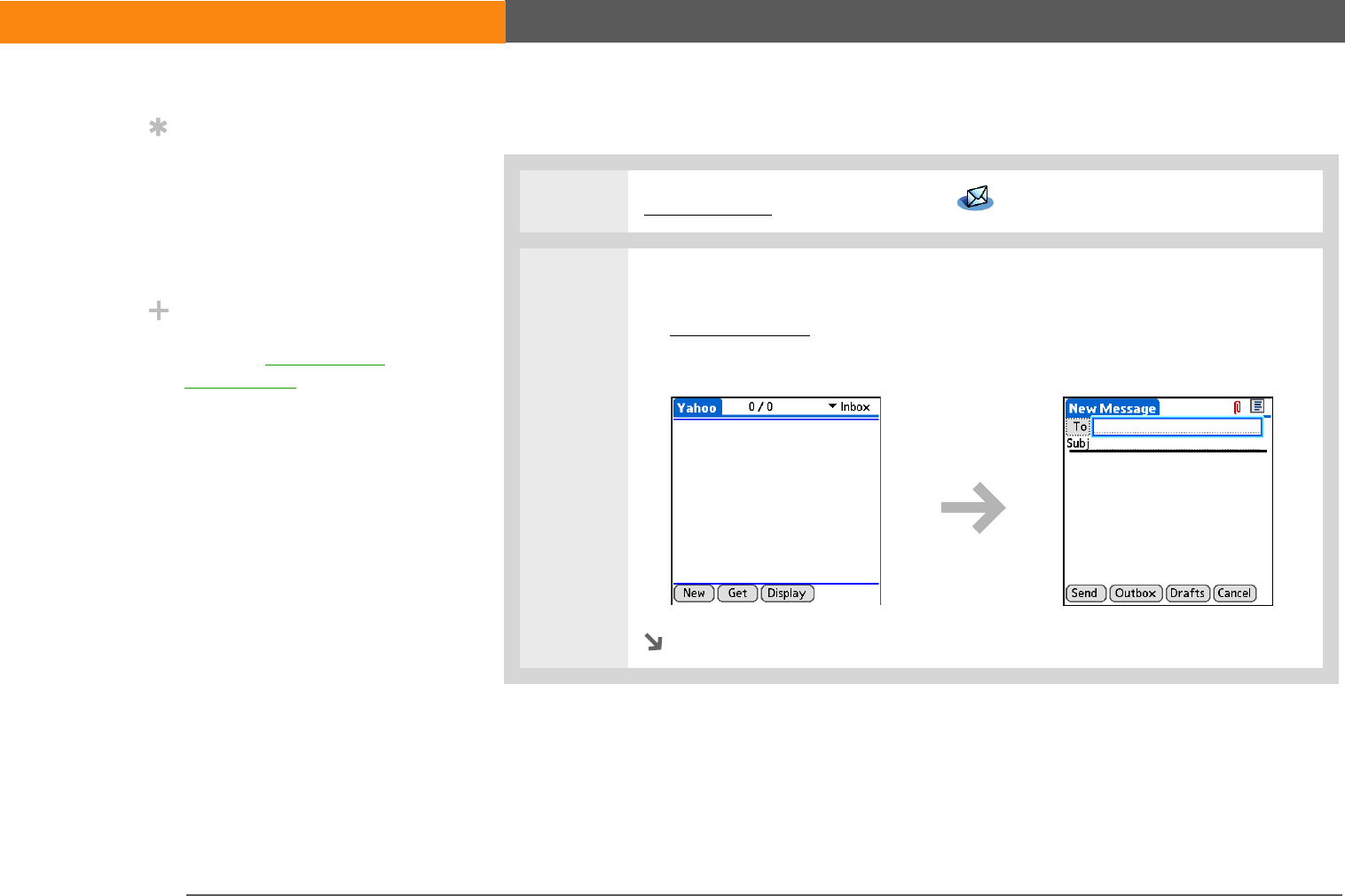
LifeDrive from palmOne 372
CHAPTER 18 Sending and Receiving Email Messages
Sending an email message
0
1Go to Favorites and select VersaMail .
2Open a new message:
a. Open the menus.
b. Select Accounts, select the account you want, and then select New.
Continued
Tip
To mark an outgoing
message as high priority,
on the message screen,
open the Options menu
and select Set Priority To
High.
Did You Know?
You can set up your
device to automatically
try resending any
messages that are not
sent correctly the first
time.
SECOND DRAFT palmOne, Inc. Confidential
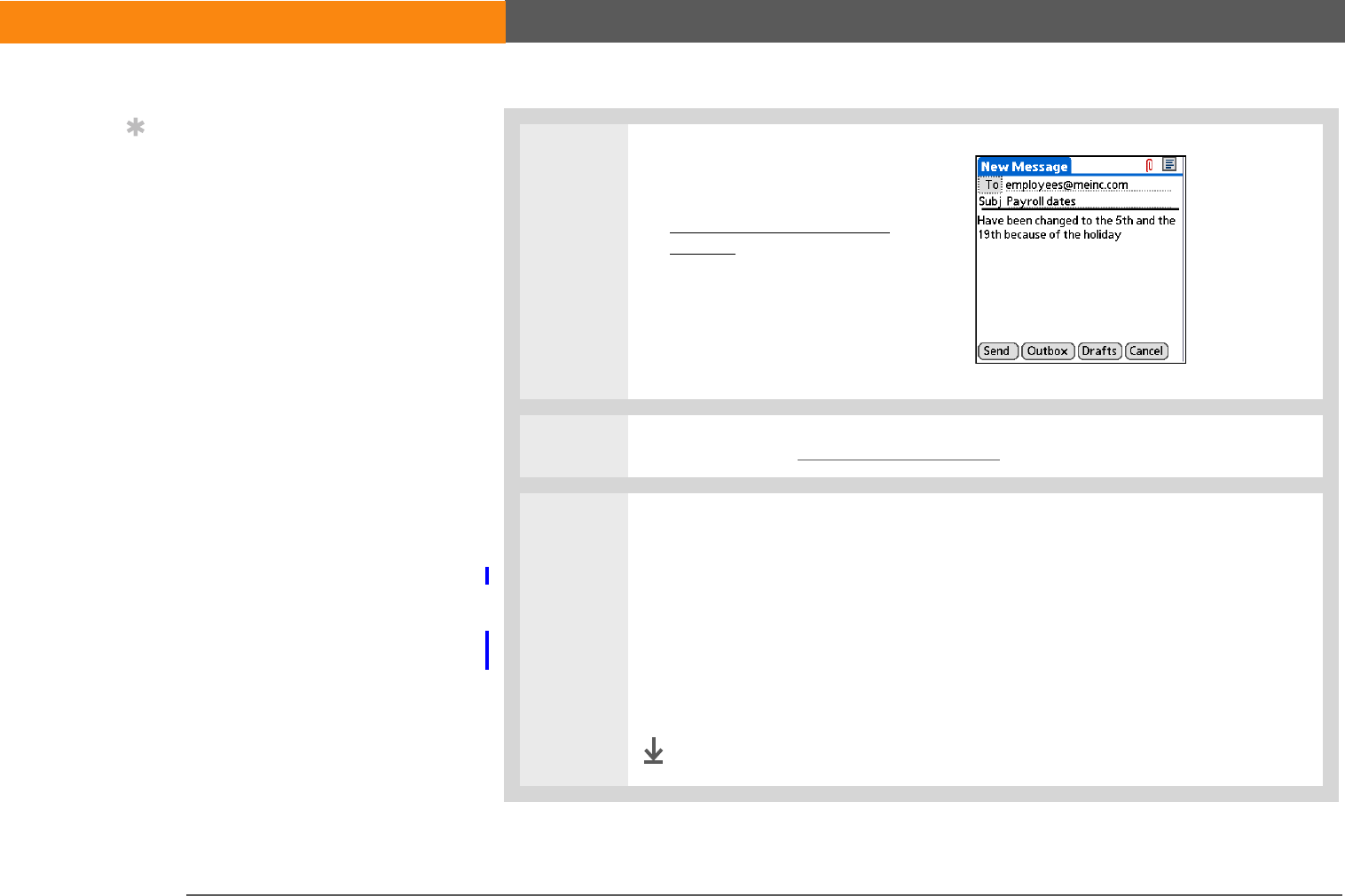
LifeDrive from palmOne 373
CHAPTER 18 Sending and Receiving Email Messages
3Address and compose your
message:
a. Enter the recipient’s email
address.
b. In the Subject field, enter the
subject of your email.
c. In the area below the Subject line,
enter the text of your email.
4[ & ] OPTIONAL Attach one or more files to send with your message.
5Select one of the following options to send your message:
Send Sends the email immediately. If the message is not sent successfully on
the first attempt, it is moved to the Outbox.
Outbox Stores email so you can compose email offline and then send it all
during one connection with the server. To send your email, select Get & Send.
Drafts Saves your message so you can work on it at another time.
Done
Tip
You can’t see the whole
list of addresses in a field
if the list is longer than
two lines. To see the
whole list, select the word
To, cc, or bcc.
SECOND DRAFT palmOne, Inc. Confidential
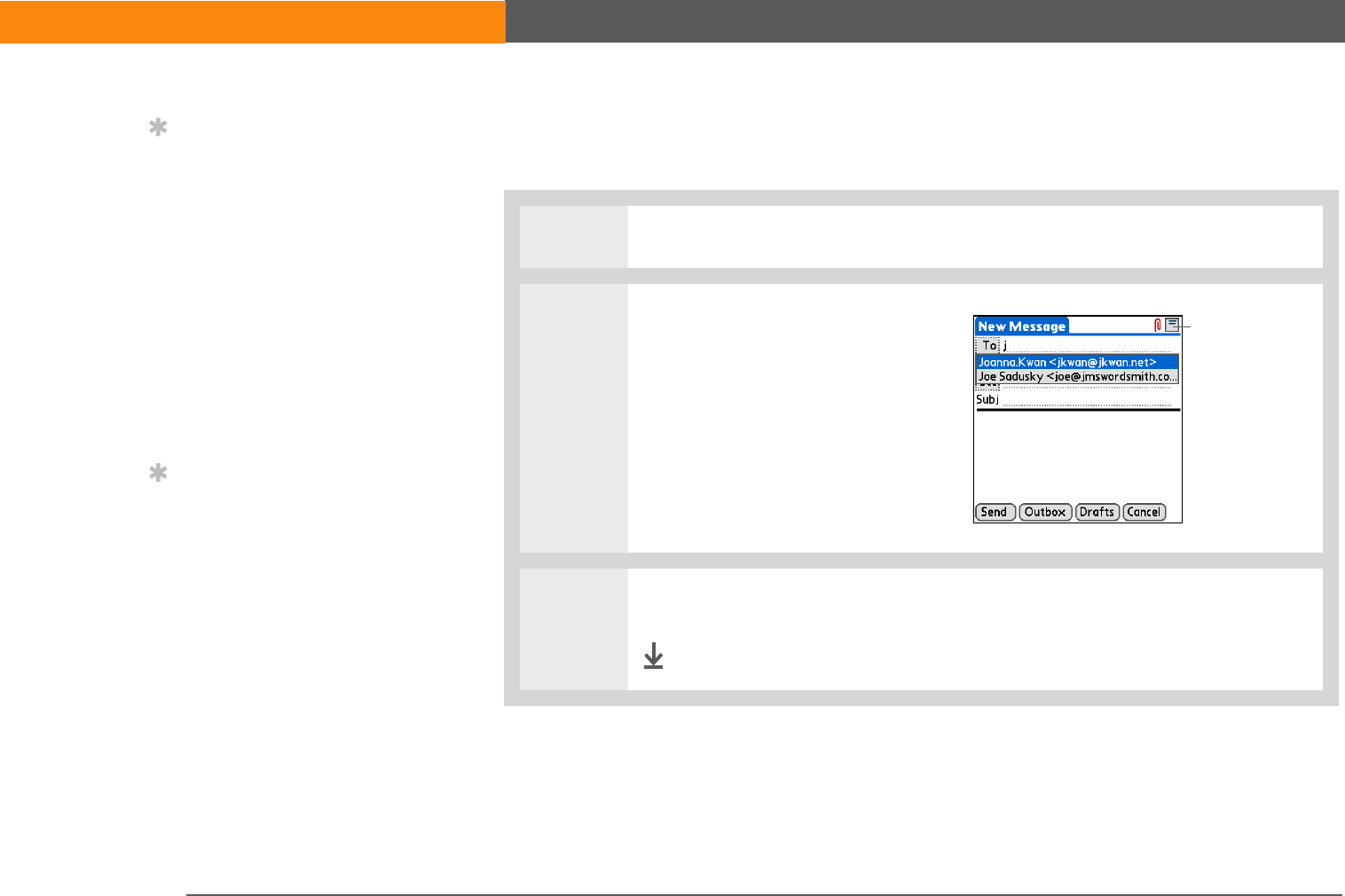
LifeDrive from palmOne 374
CHAPTER 18 Sending and Receiving Email Messages
Entering an address using Smart Addressing
Smart Addressing completes a recognized email address.
0
1On the New Message screen, navigate to or tap in the To field.
2Start entering the person’s name.
Smart Addressing displays
matching names and email
addresses from Contacts.
3When the name you want appears, select it to enter it on the To line.
Done
Tip
Continue typing until the
entry you want is
automatically entered on
the To line. For example,
if you have a Joe Smith
and a Joan Smith in
Contacts (and no other
names starting with J),
once you type “Joe,” the
entry “Joe Smith” is
entered on the To line
with the correct email
address.
Tip
Tap the email header icon
in the upper-right corner
of the screen to display
the cc: and bcc: fields.
Email header
SECOND DRAFT palmOne, Inc. Confidential
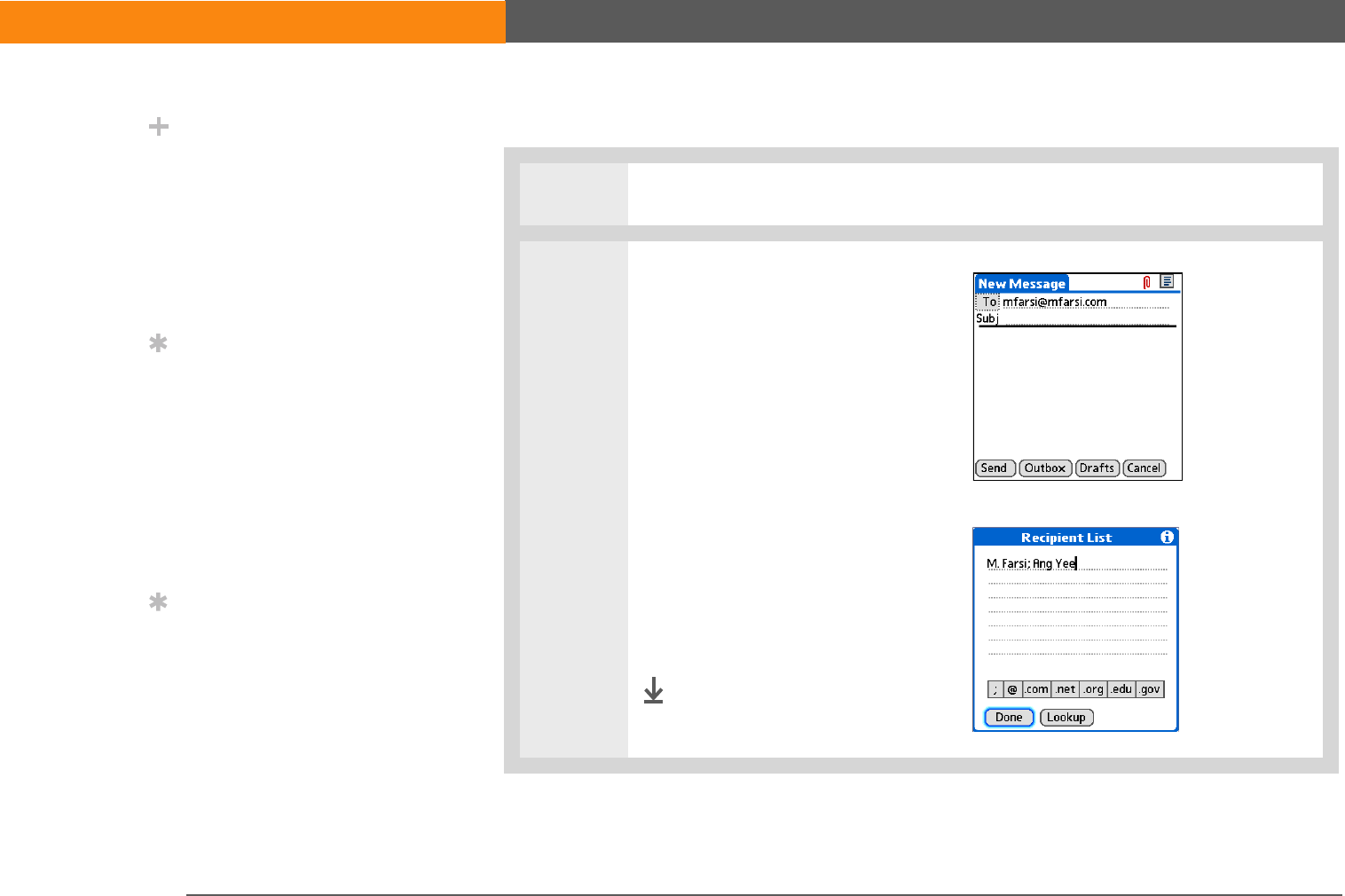
LifeDrive from palmOne 375
CHAPTER 18 Sending and Receiving Email Messages
Entering an address directly in the To field
0
1On the New Message screen, select or navigate to the To field.
2Enter an address using one of
the following methods:
To f i e l d Enter the address, and
then select Done. For multiple
addresses, enter a semicolon (;)
and then a space between
recipient names.
Recipient List Select To and
enter the name or address on the
Recipient List screen, and then
select Done. Use the shortcut
buttons at the bottom of the
screen for quick address entry.
For multiple recipients, enter a
semicolon (;) and then a space
between recipient names.
Done
Did You Know?
When you put addresses
in the copies (cc:) field,
they are visible to all
other recipients.
Addresses in the blind
copies (bcc:) field are
hidden from all other
recipients.
Tip
As with Smart
Addressing, when you
begin to enter a name or
address on the Recipient
List screen, VersaMail
displays any matching
entries from Contacts.
Select a match to
automatically enter it in
the Recipient List.
Tip
It’s OK to enter commas
instead of semicolons
between addresses,
because they’re changed
to semicolons. But you
can’t use other
punctuation or no
punctuation between
addresses.
SECOND DRAFT palmOne, Inc. Confidential
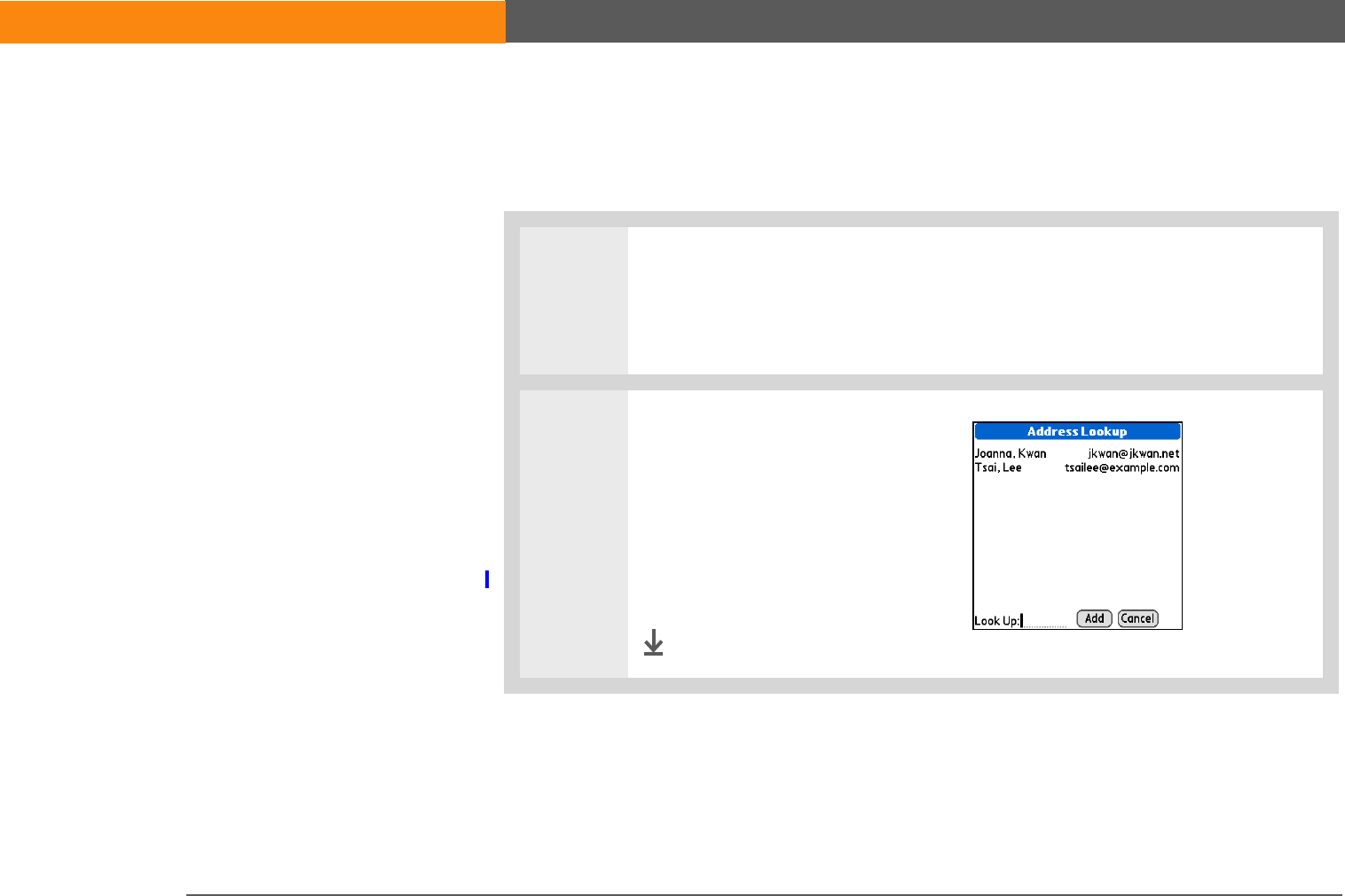
LifeDrive from palmOne 376
CHAPTER 18 Sending and Receiving Email Messages
Entering an address using Contacts
You can enter a recipient’s address by using the Lookup screen to select the address. The names
and addresses on the Lookup screen come from Contacts.
0
1Open the Lookup screen:
a. On the New Message screen, select the word To.
b. On the Recipient List screen, select Lookup.
2Enter the address:
a. On the Address Lookup
screen, select the address you
want, and then select Add.
b. Select Lookup and repeat step
“a” for each address you want
to add.
Done
SECOND DRAFT palmOne, Inc. Confidential
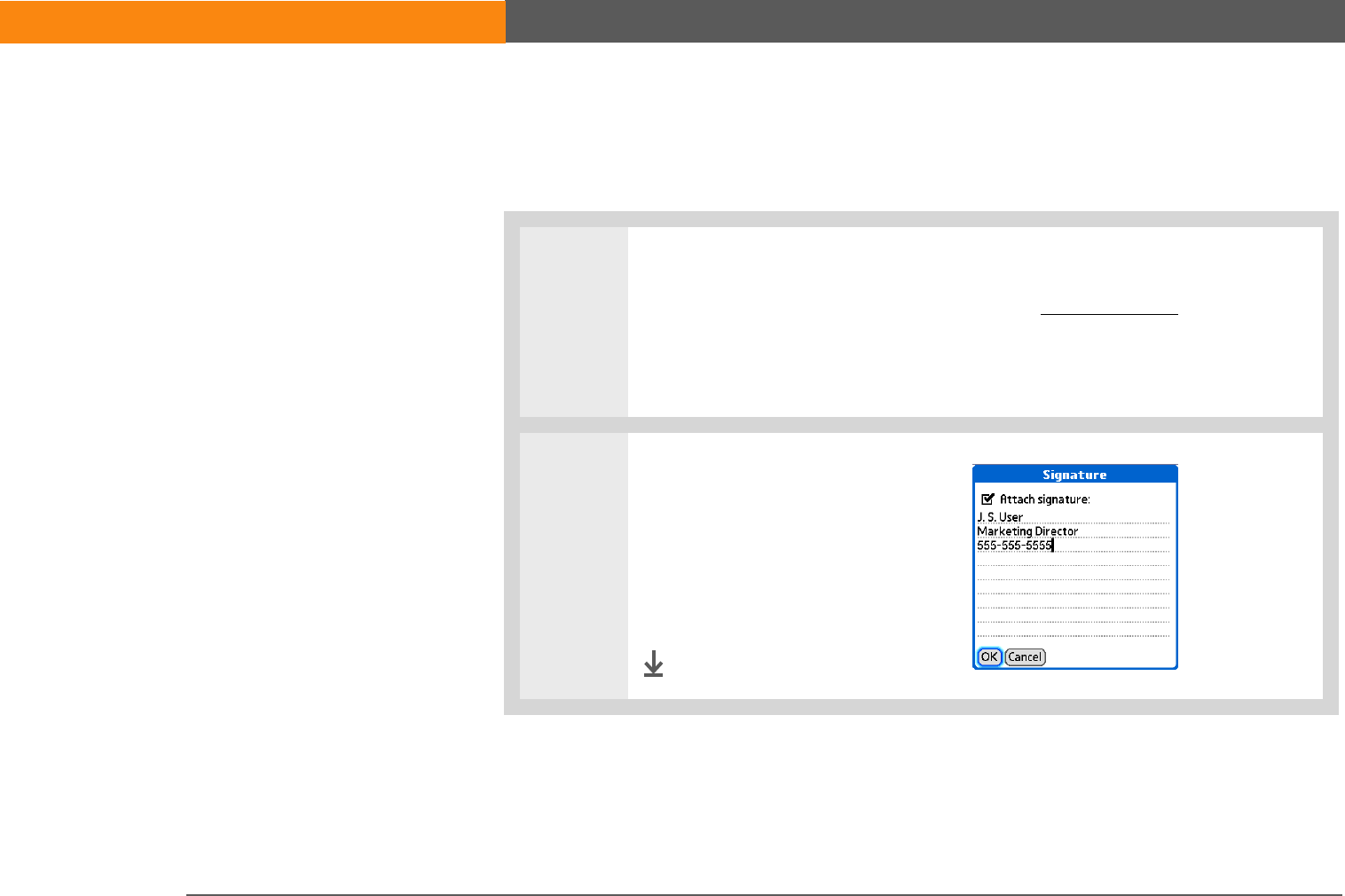
LifeDrive from palmOne 377
CHAPTER 18 Sending and Receiving Email Messages
Attaching a personal signature
You can attach a personal signature, with info like your company's address and telephone number,
to the bottom of all messages you send.
0
1Open the VersaMail Preferences:
a. From the Inbox or on another folder screen, open the menus.
b. Select Options, and then select Preferences.
c. Select Signature.
2Add a signature:
a. Check the Attach Signature
box.
b. Enter your signature
information, and then select
OK.
Done
SECOND DRAFT palmOne, Inc. Confidential